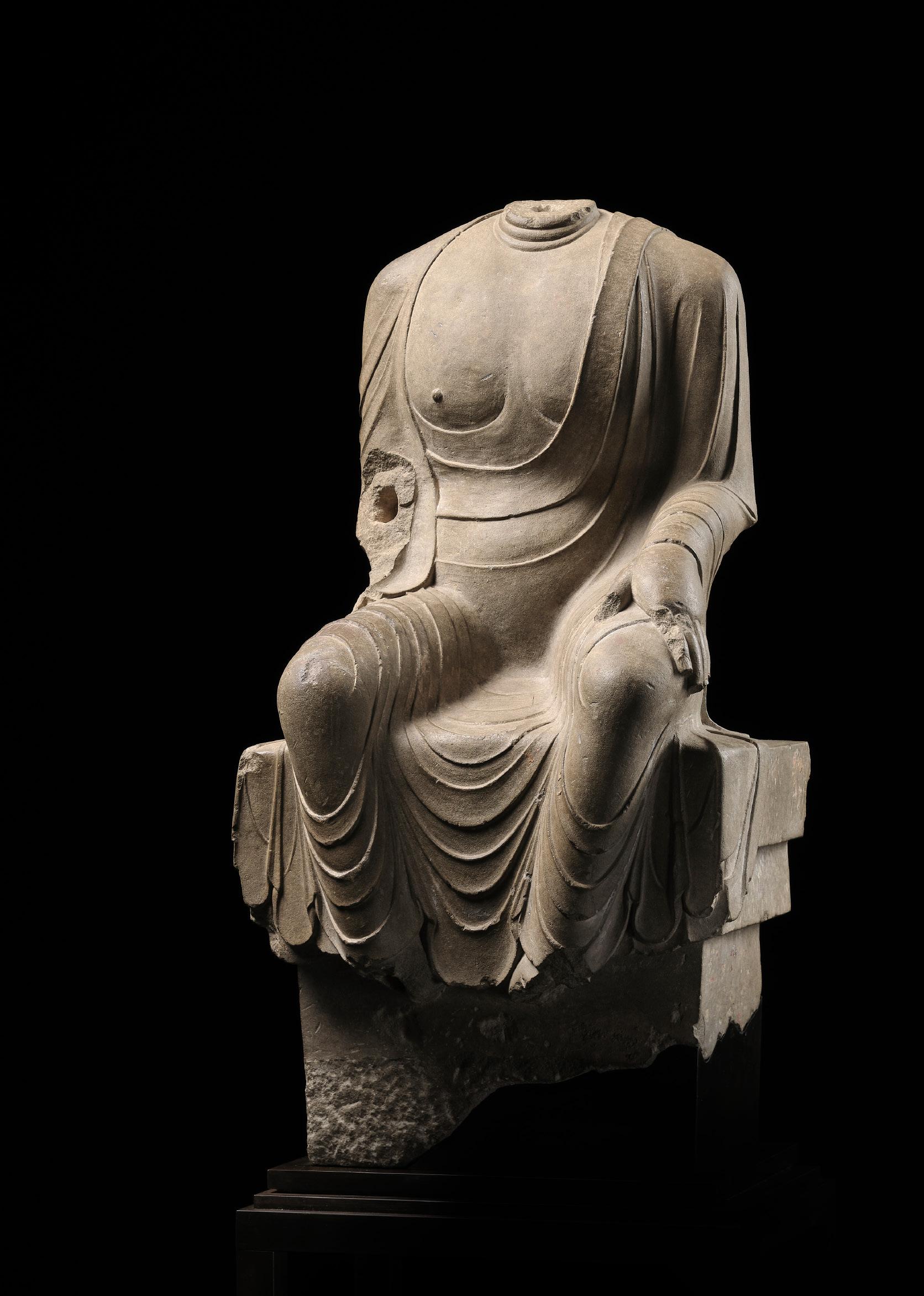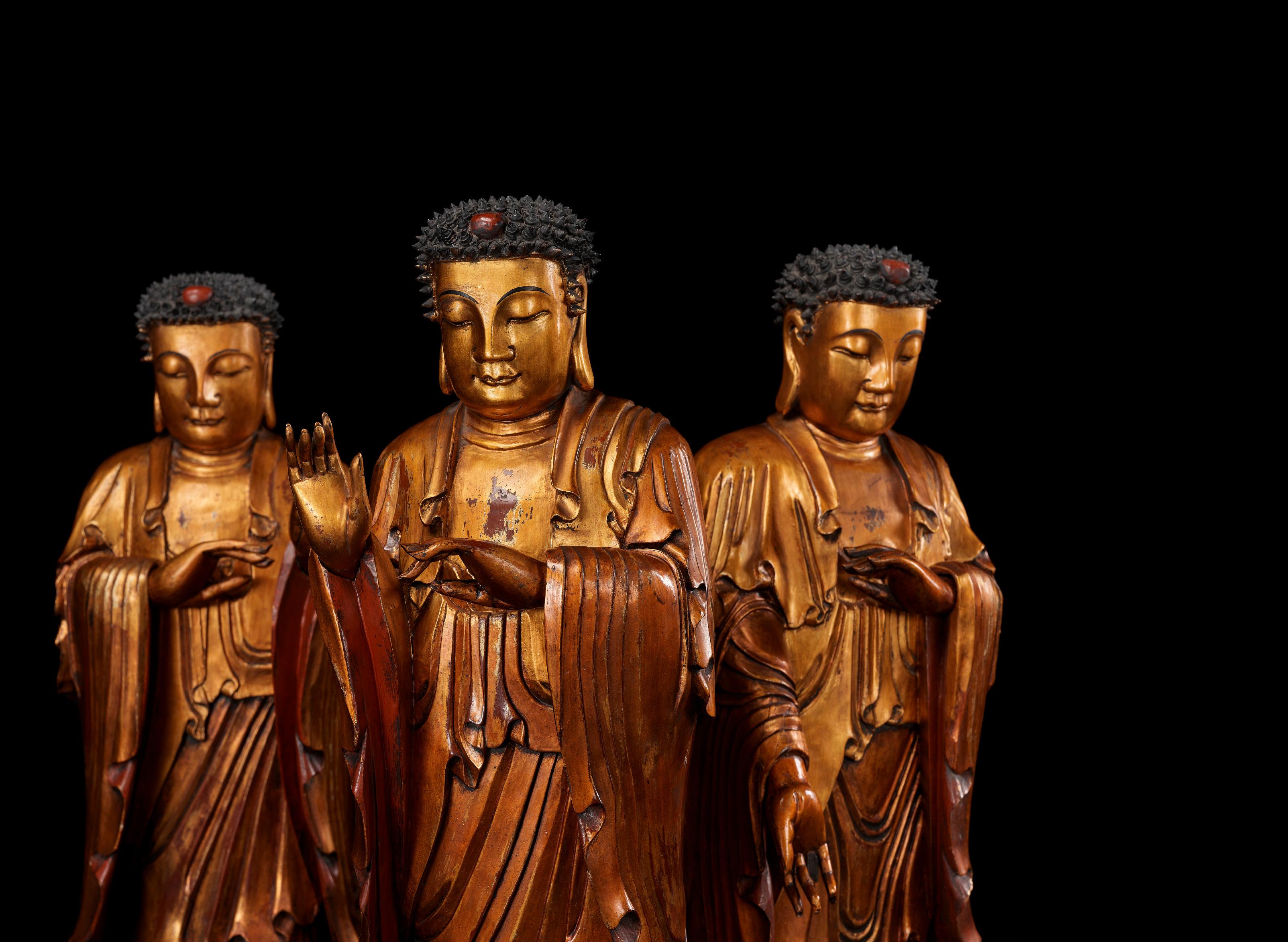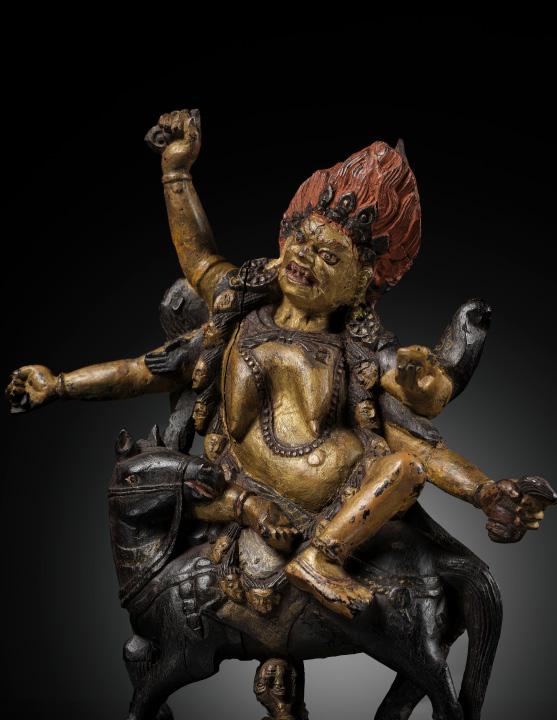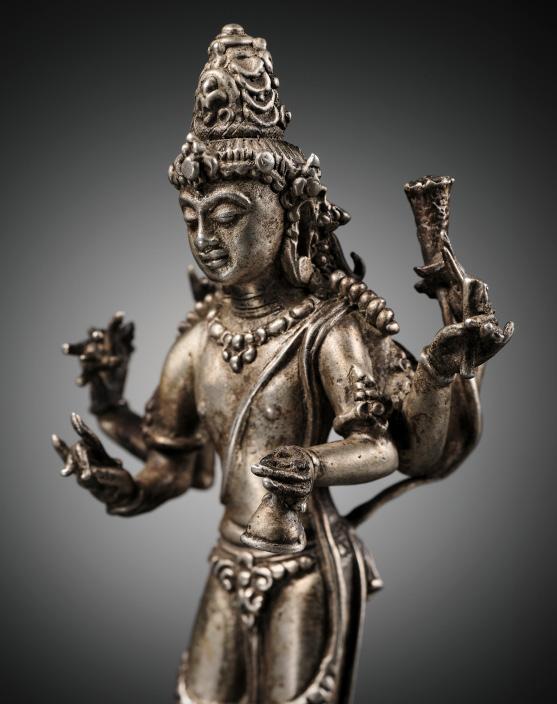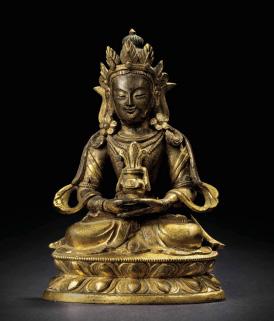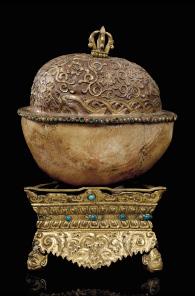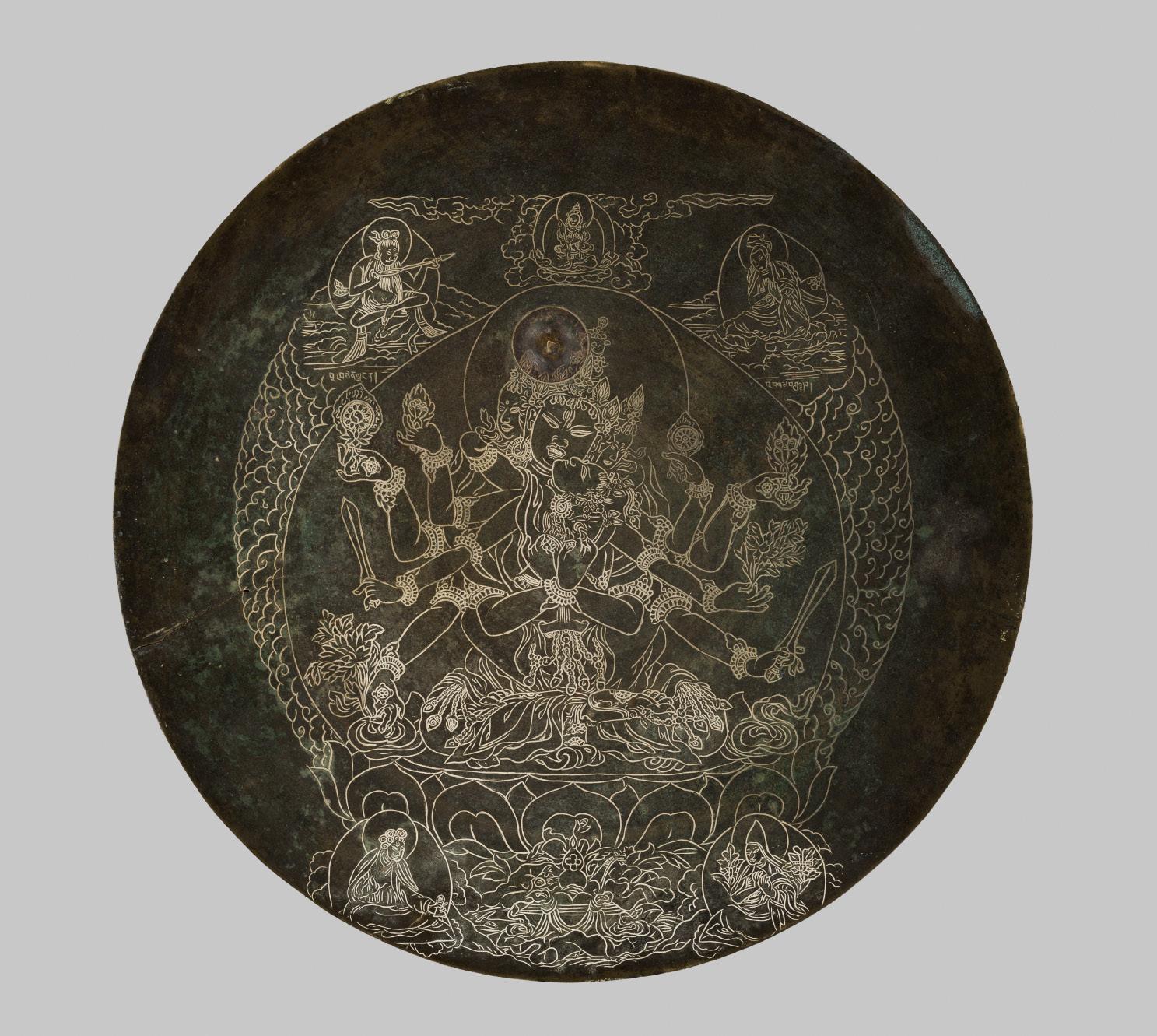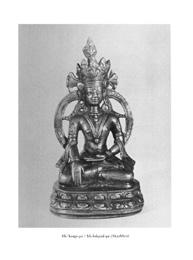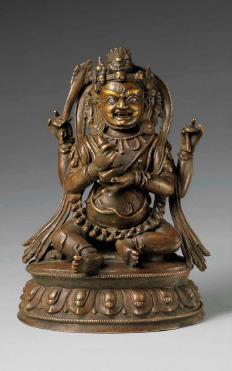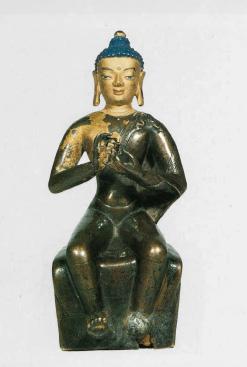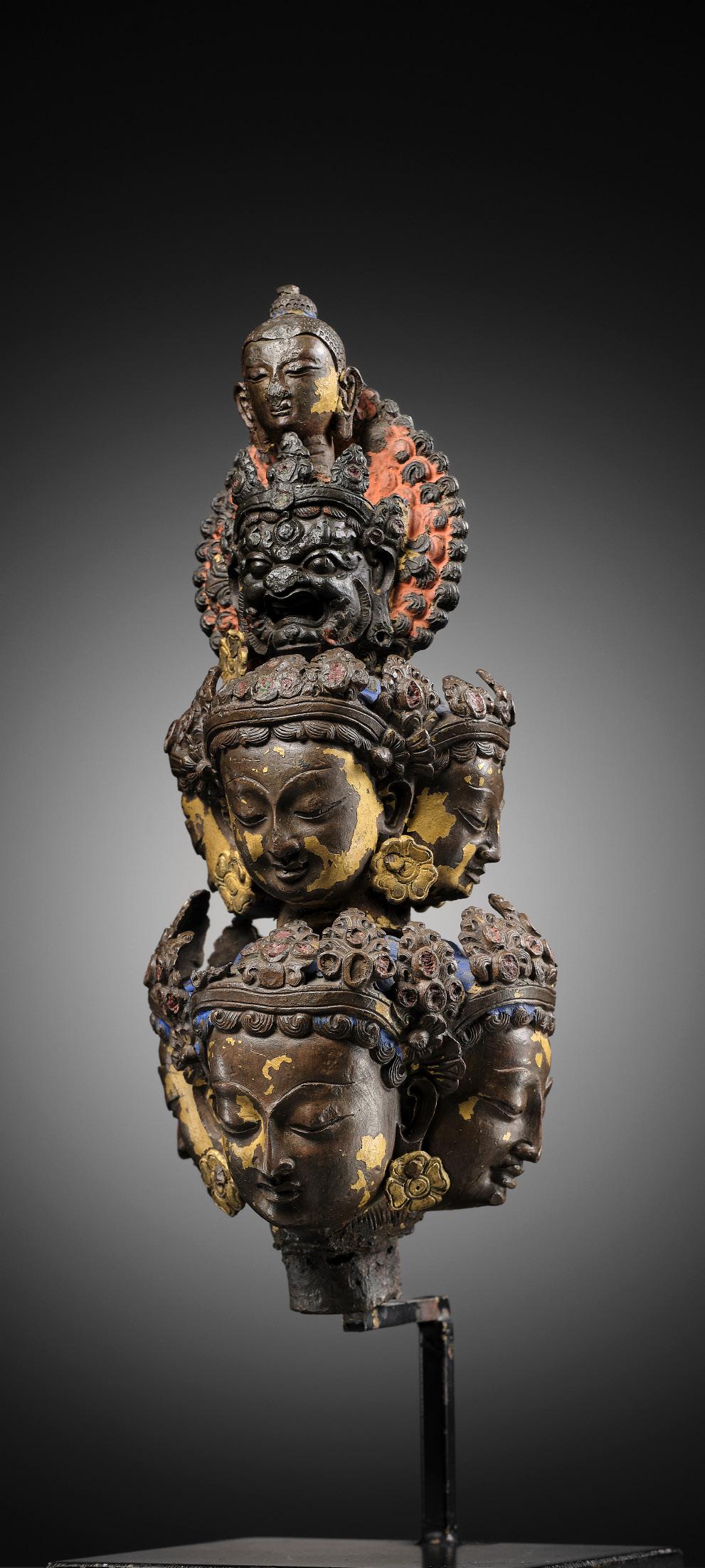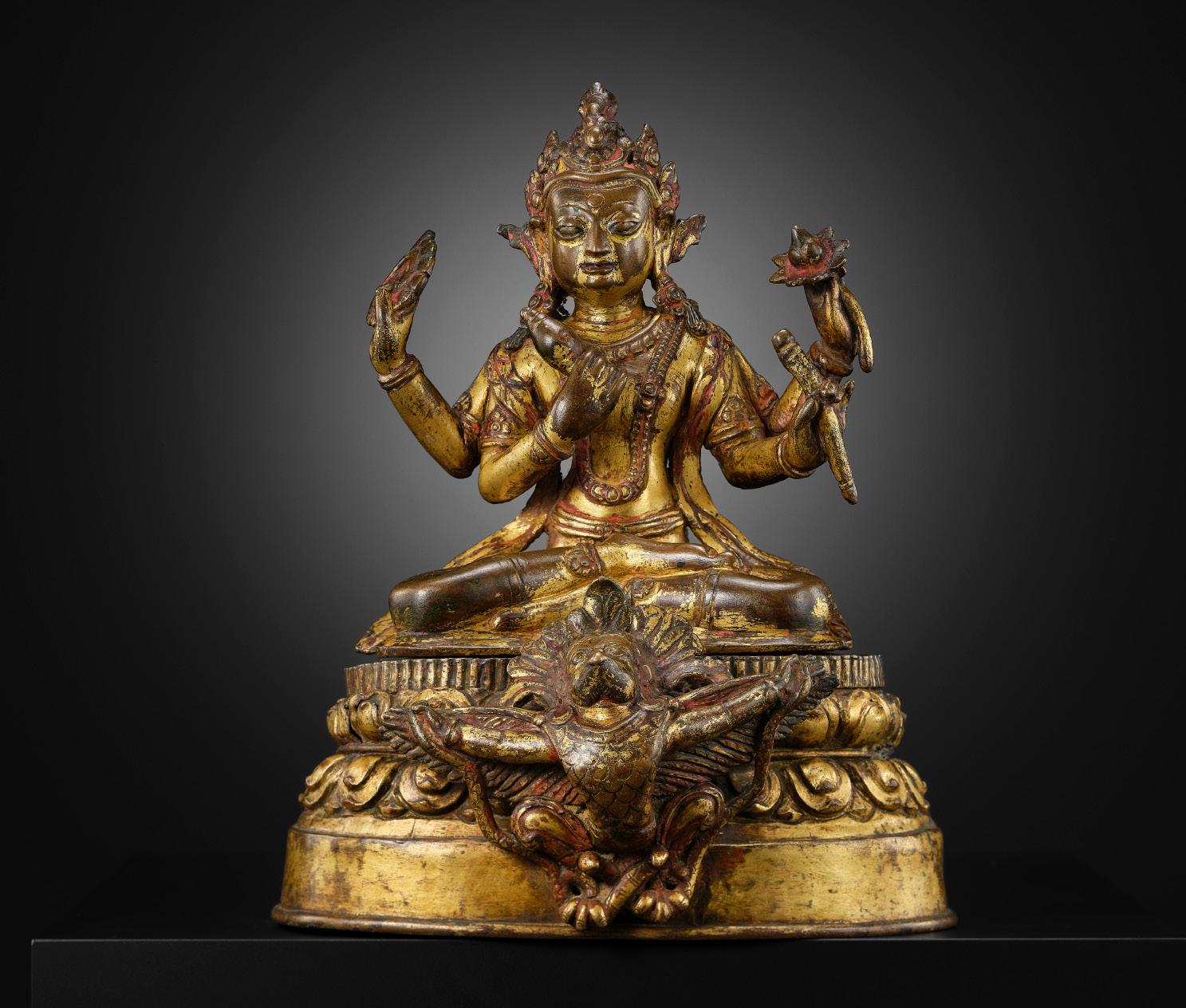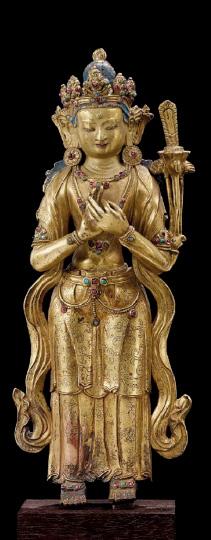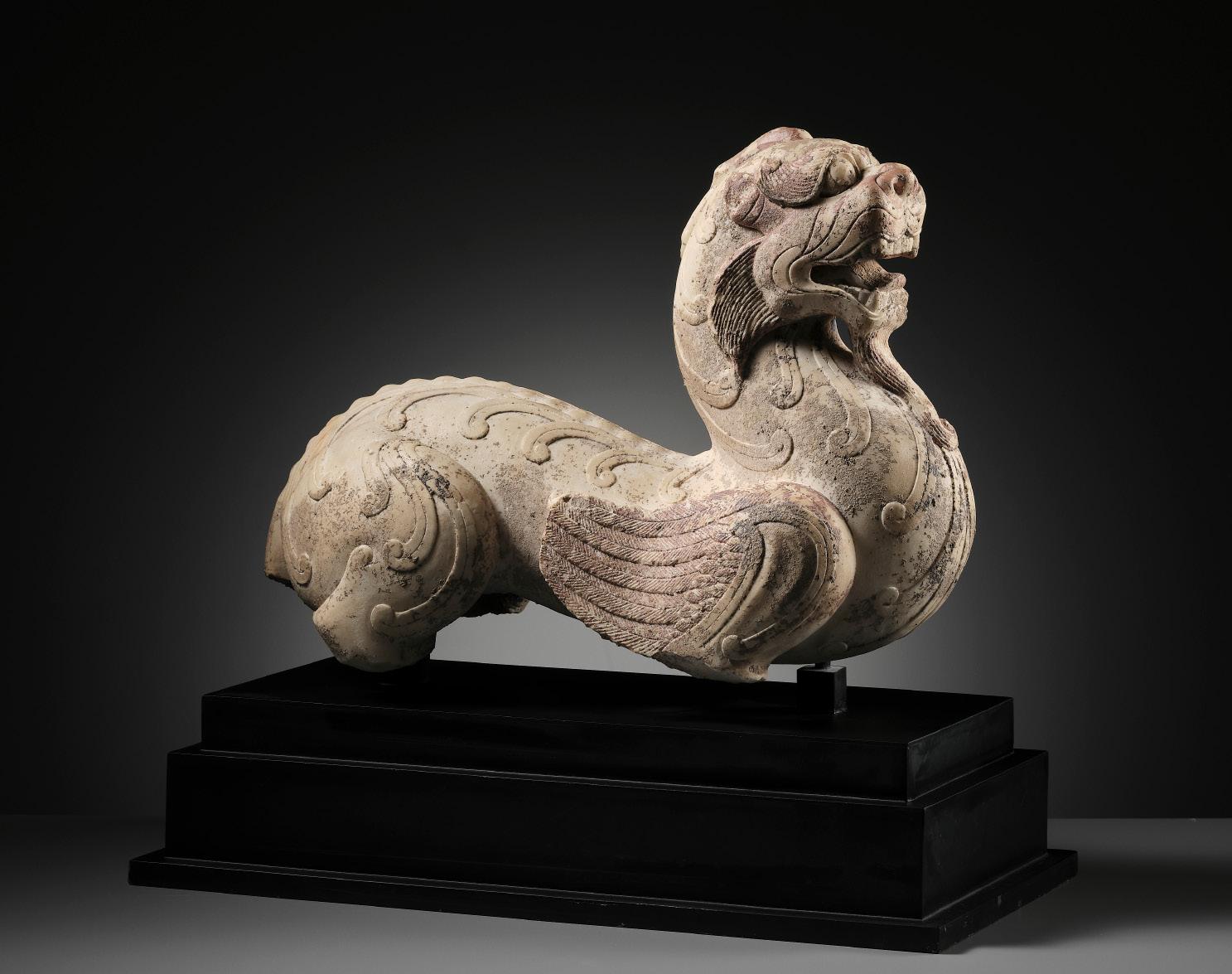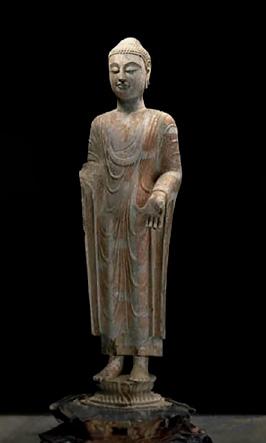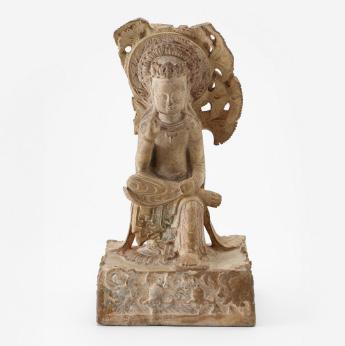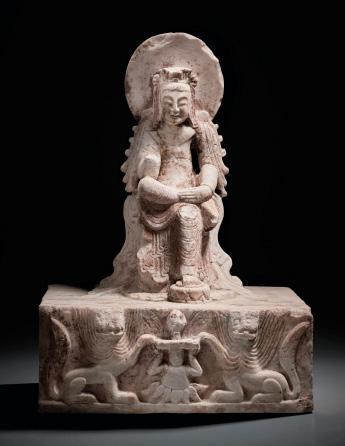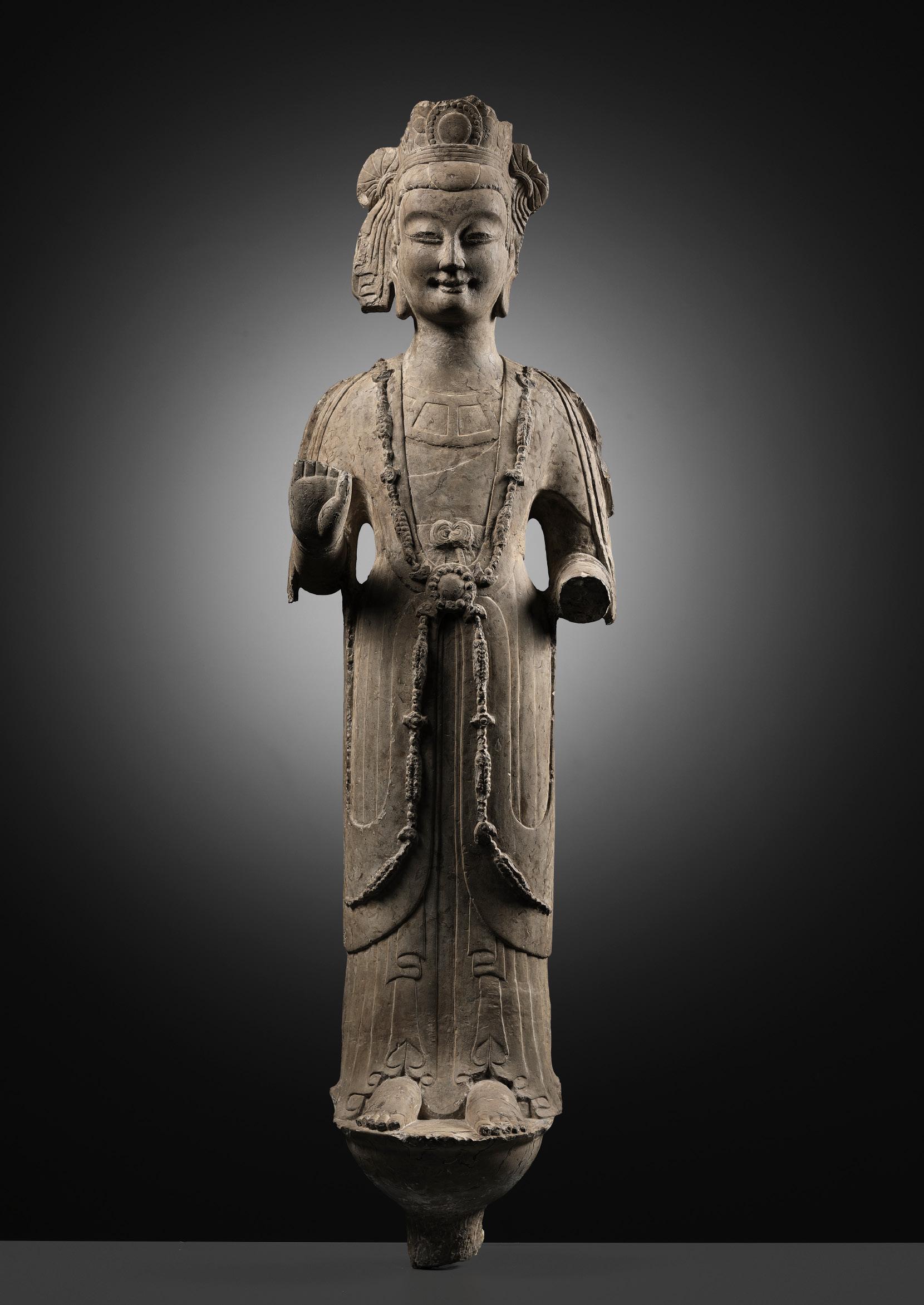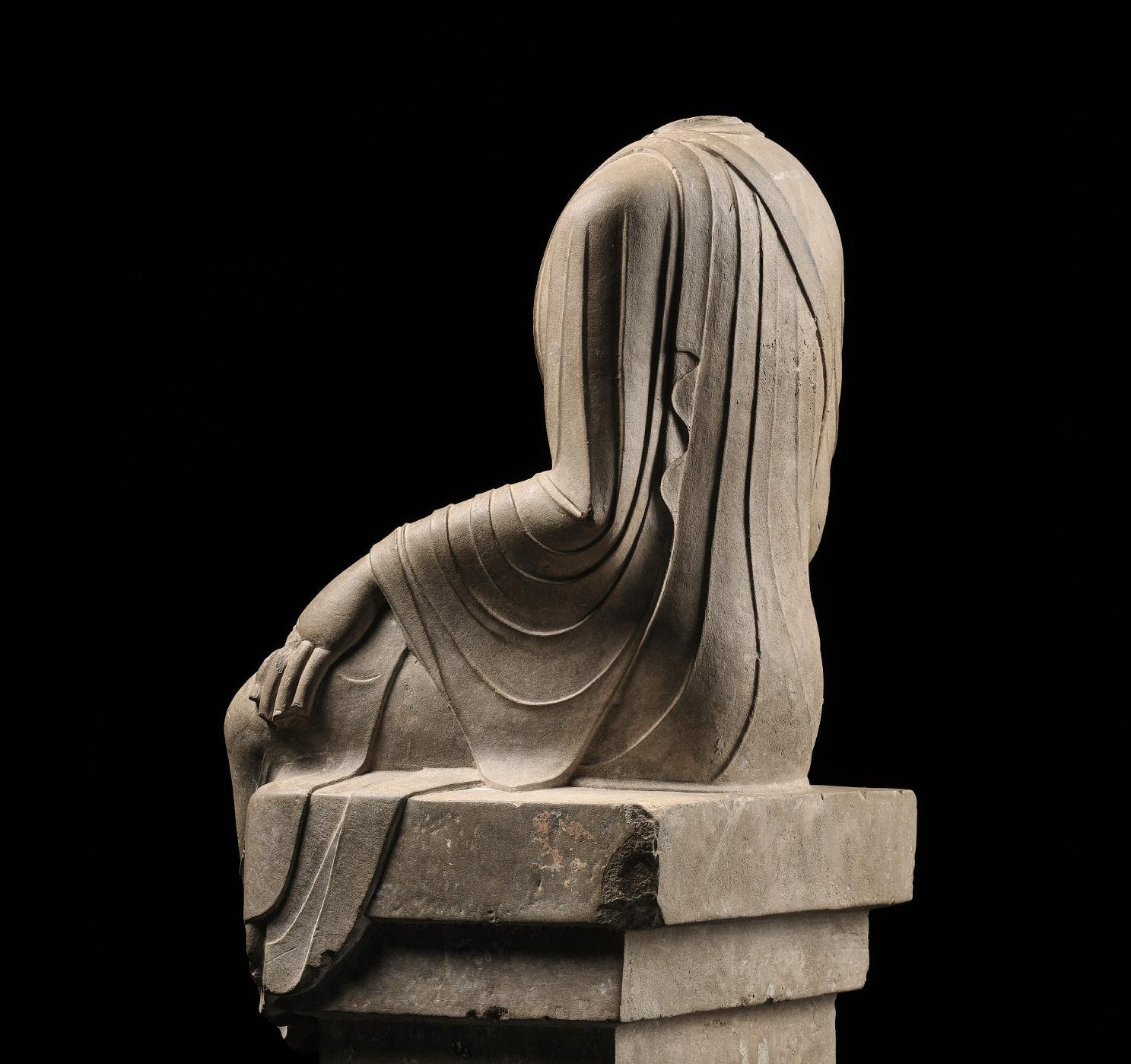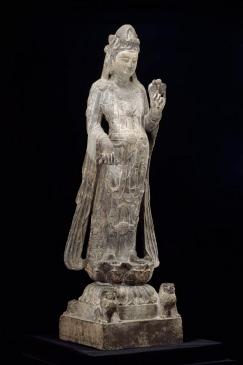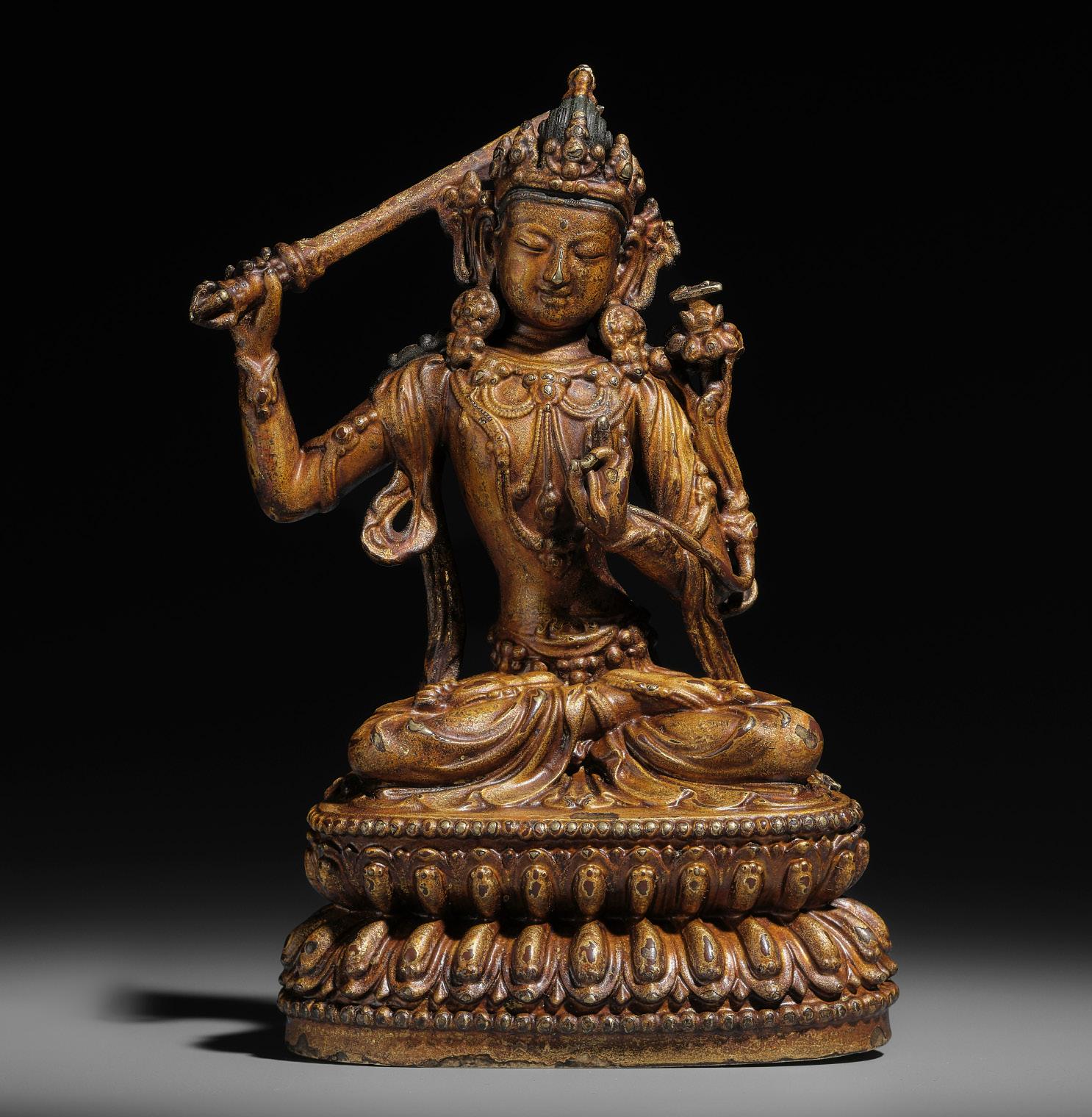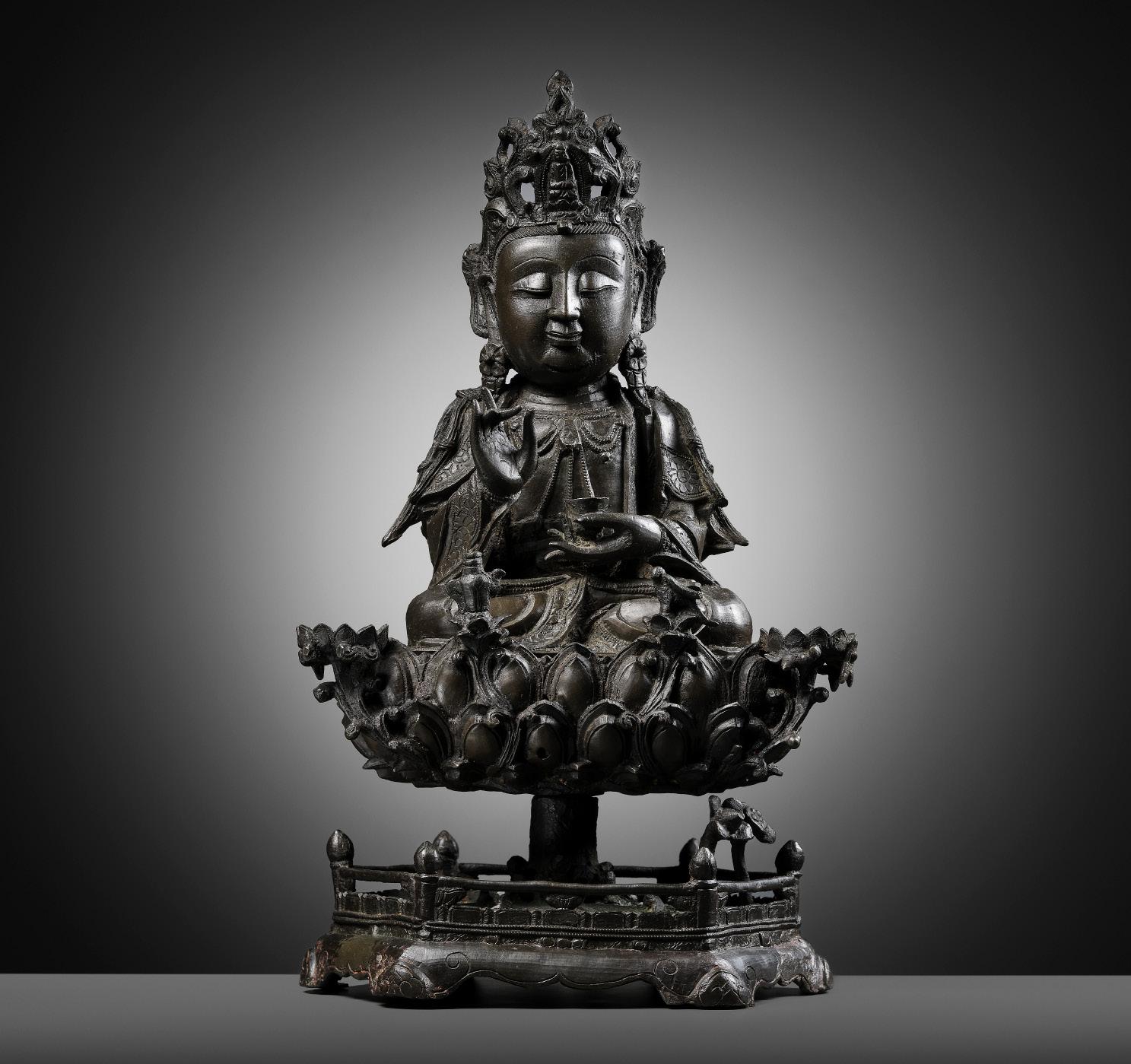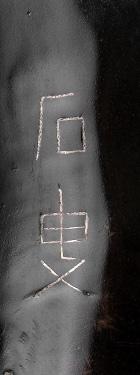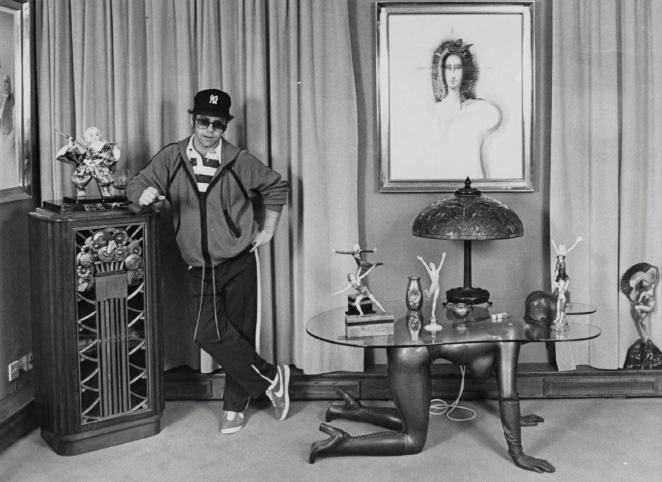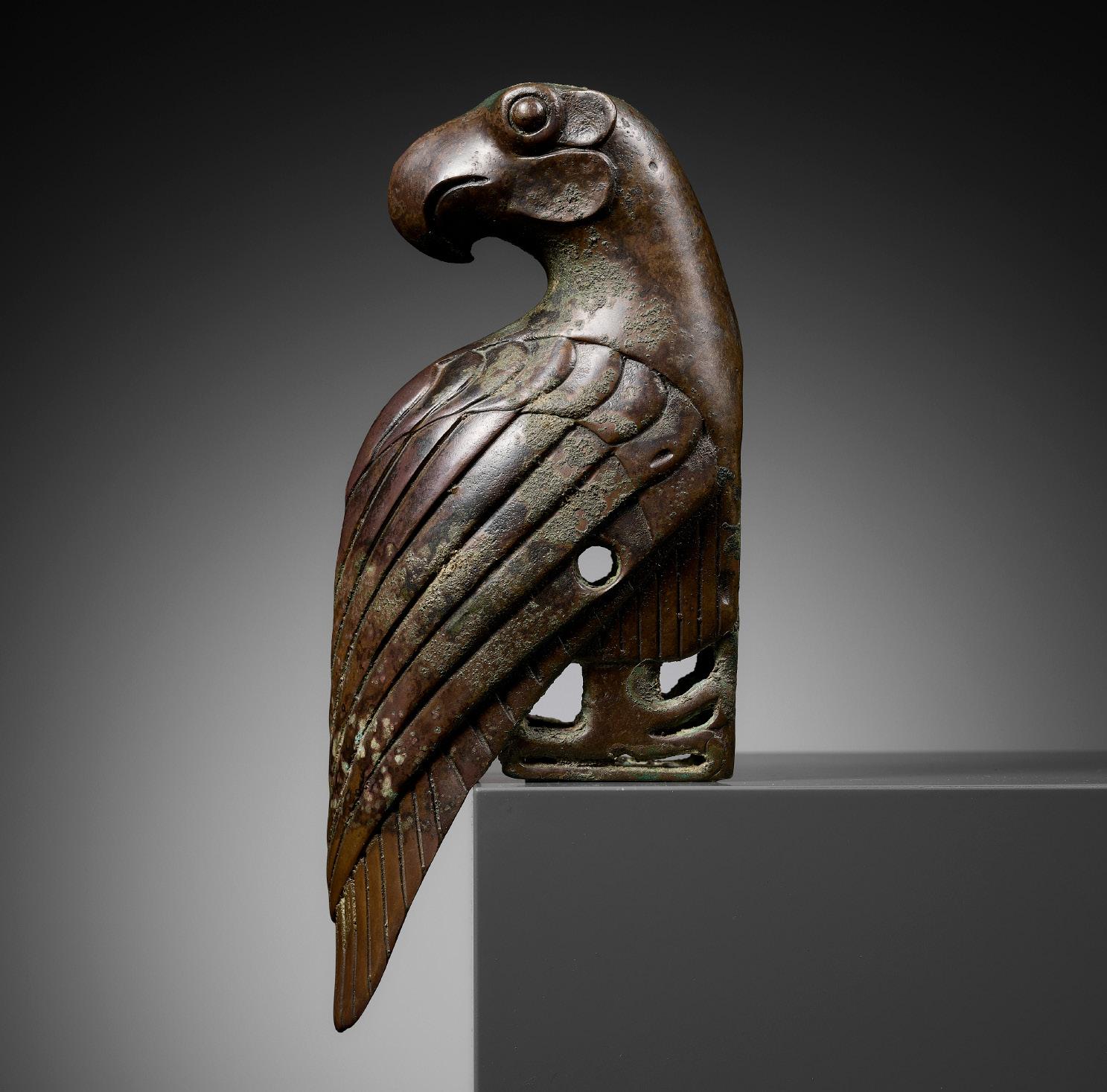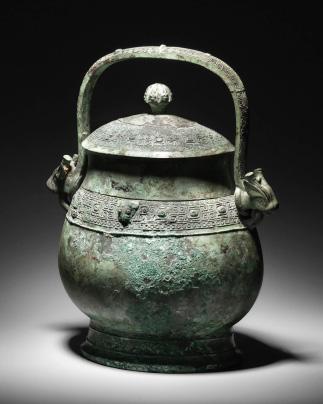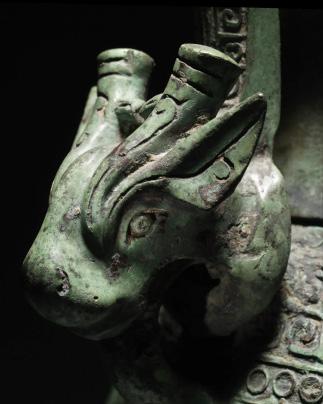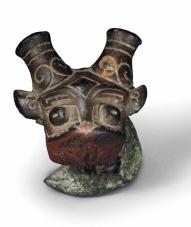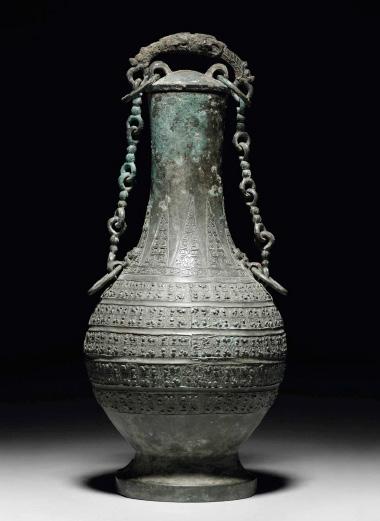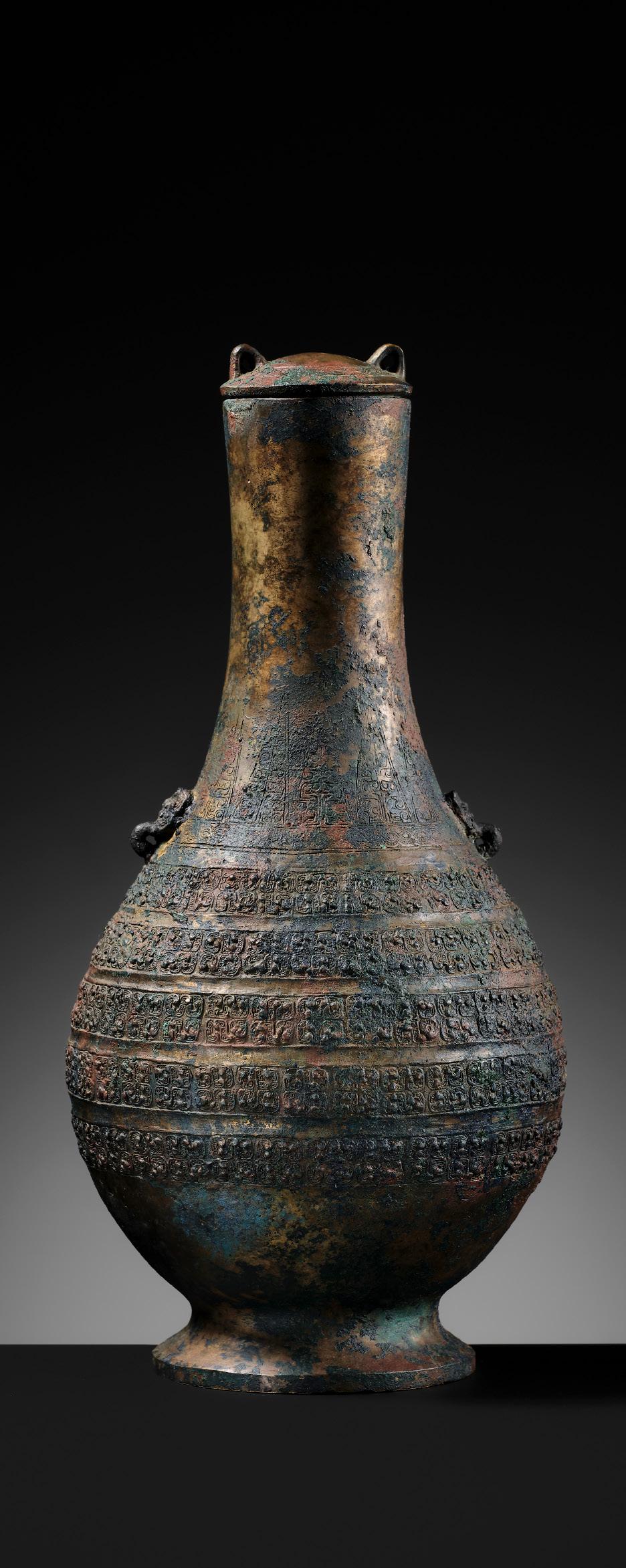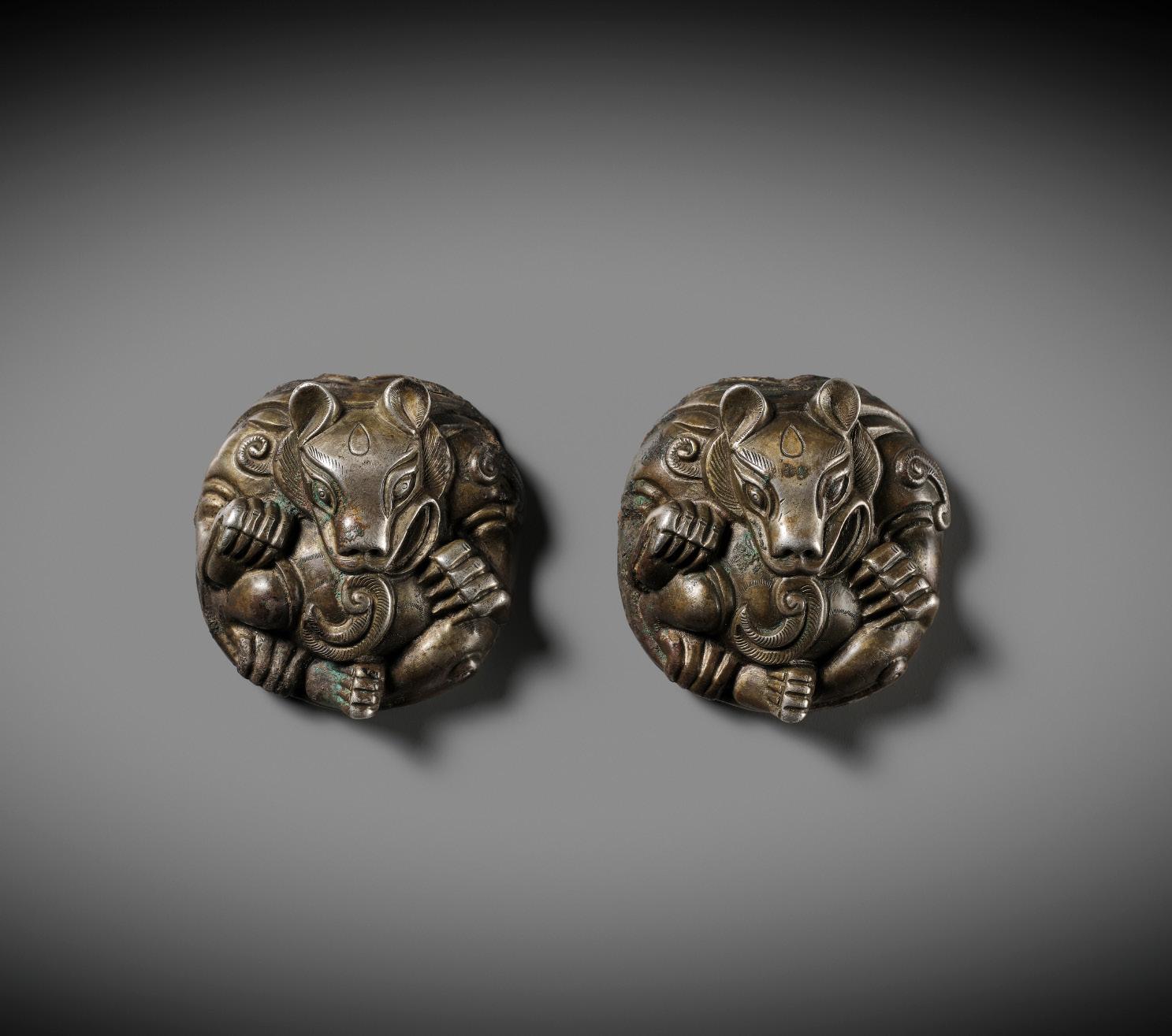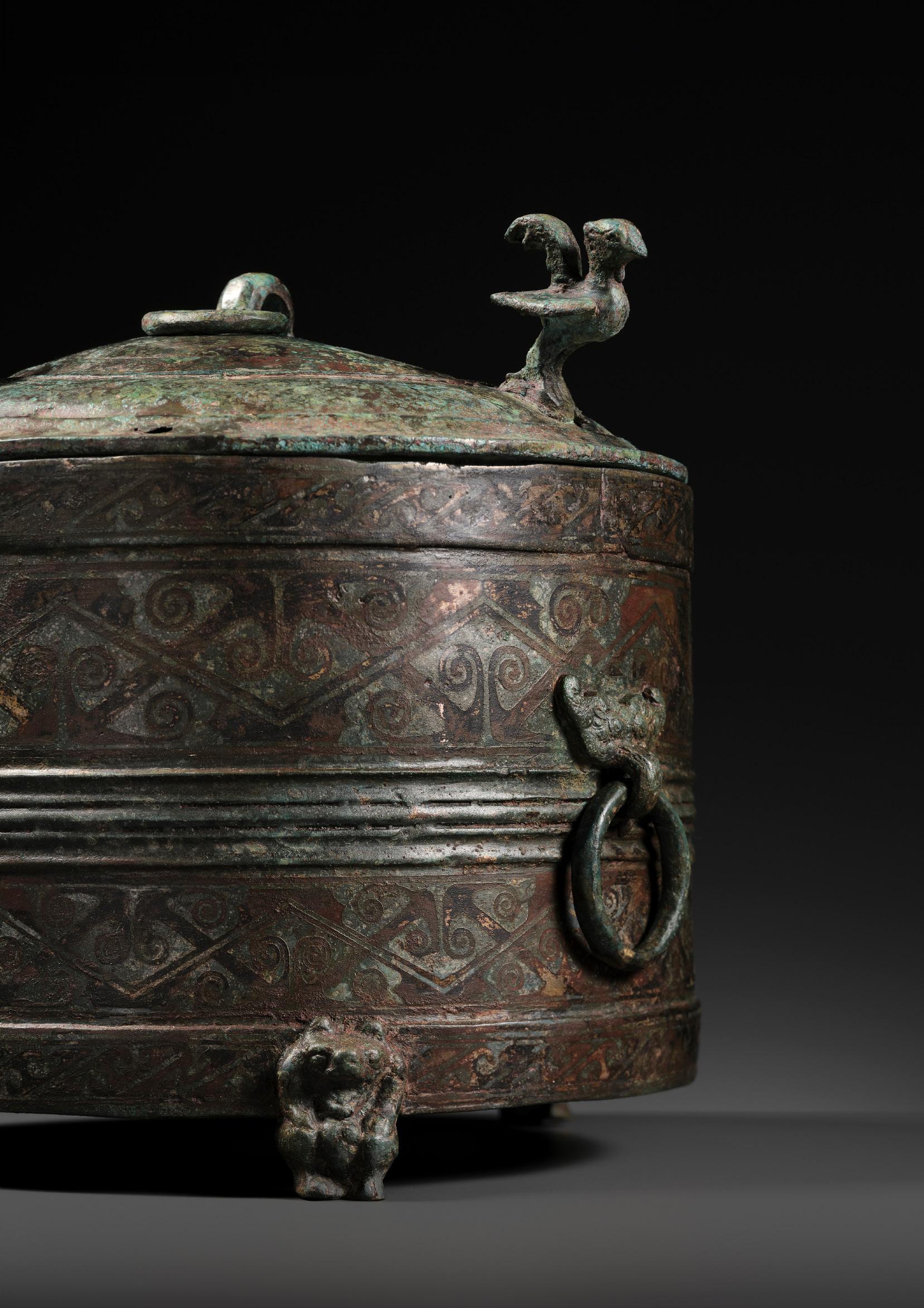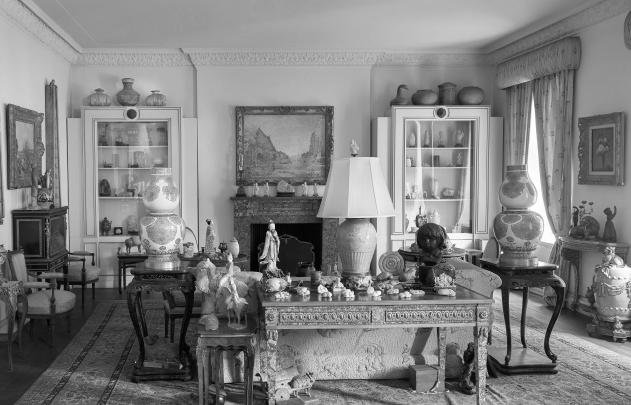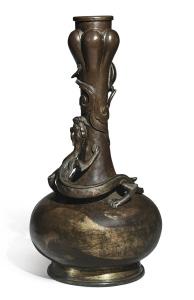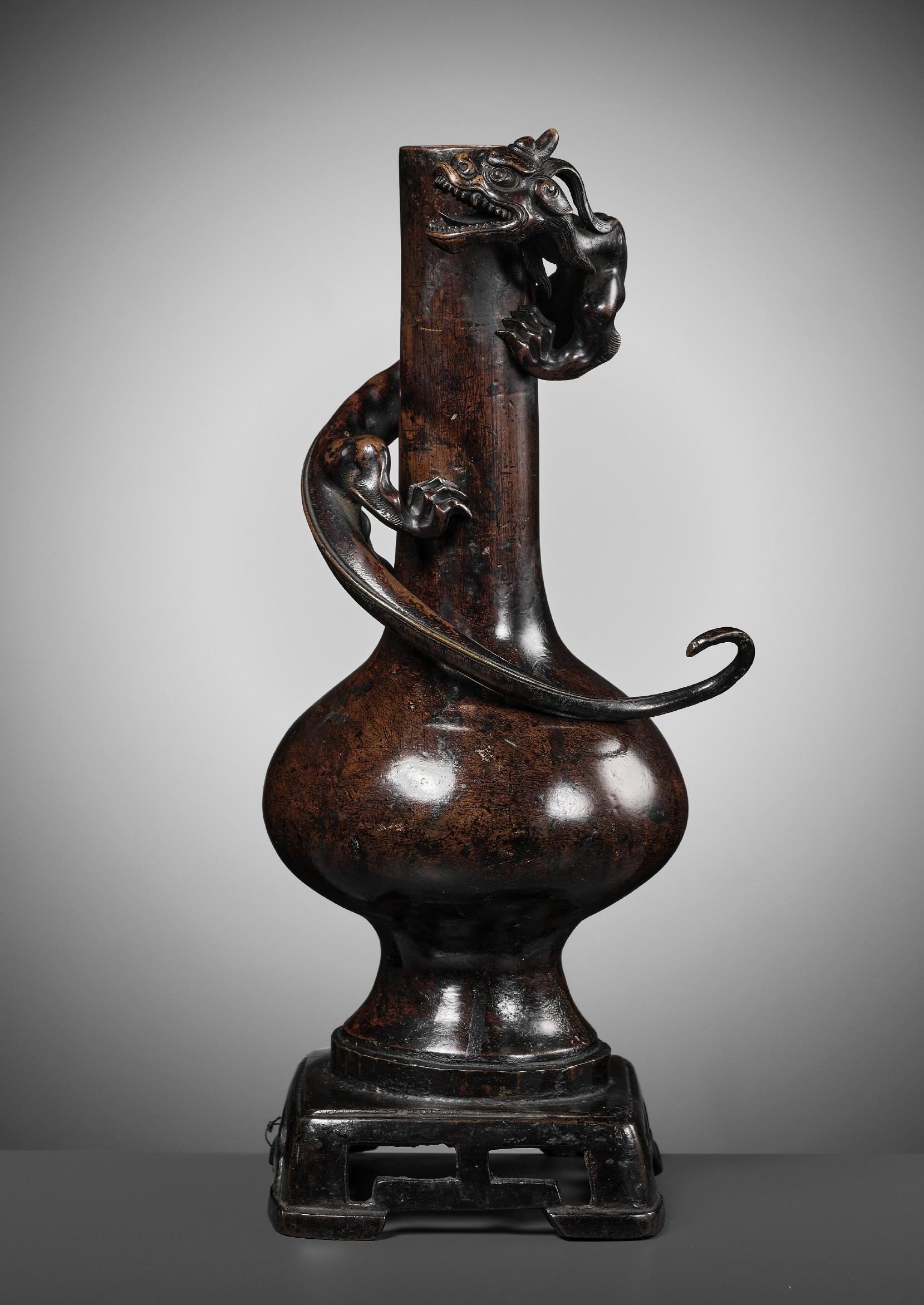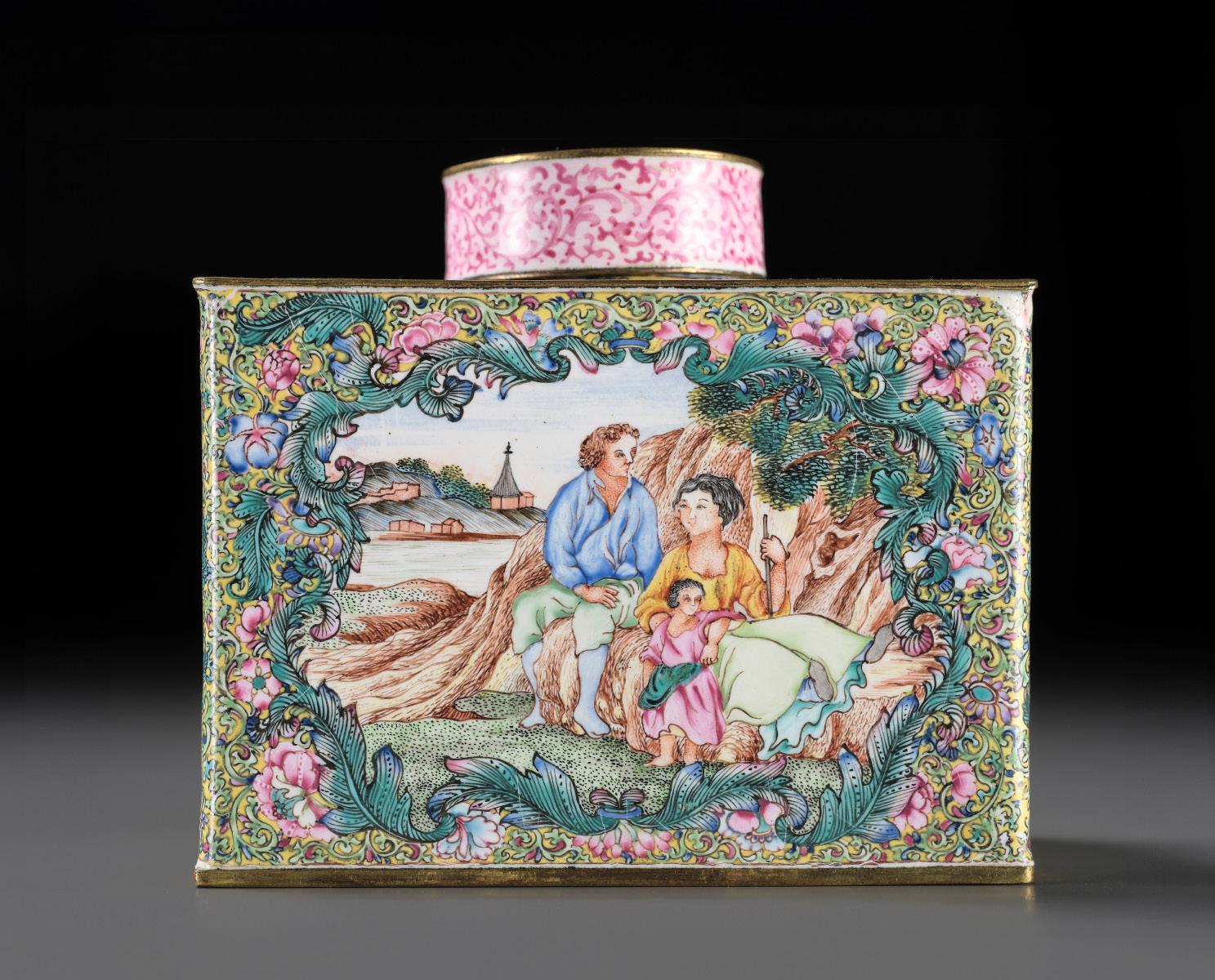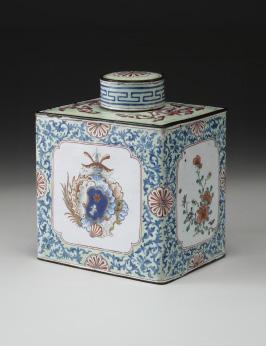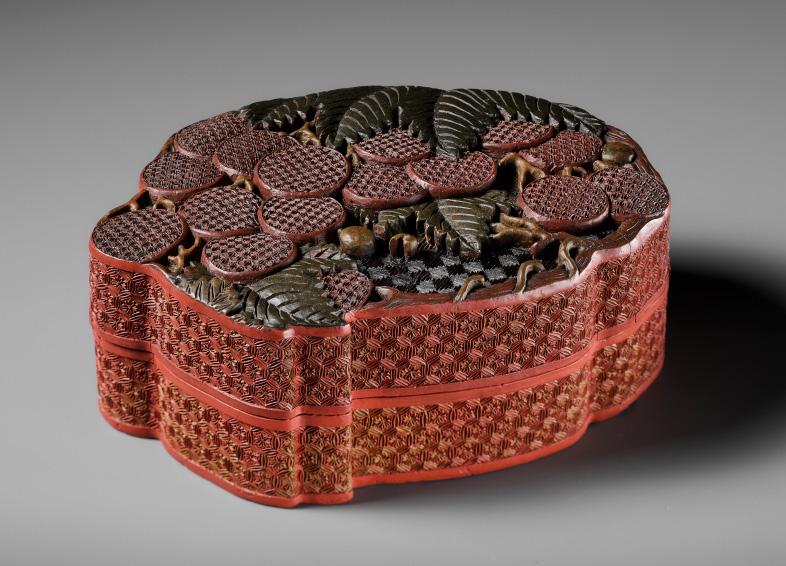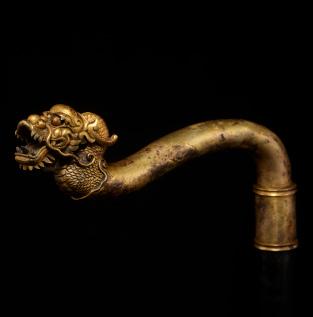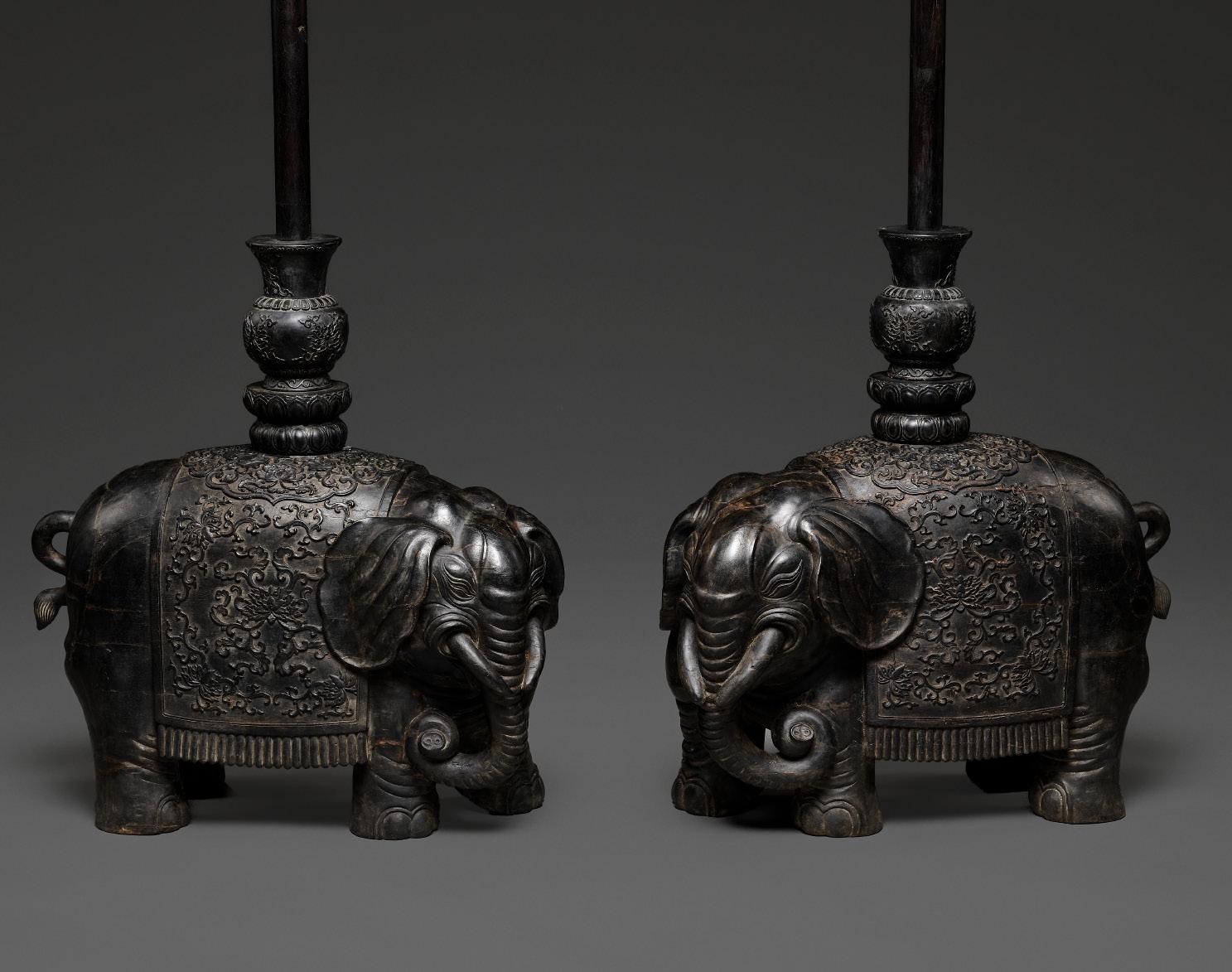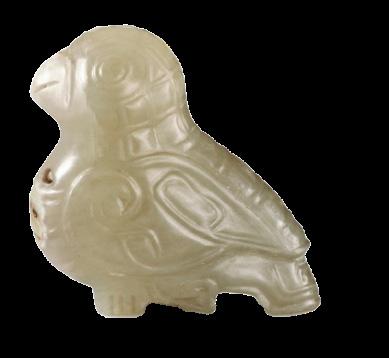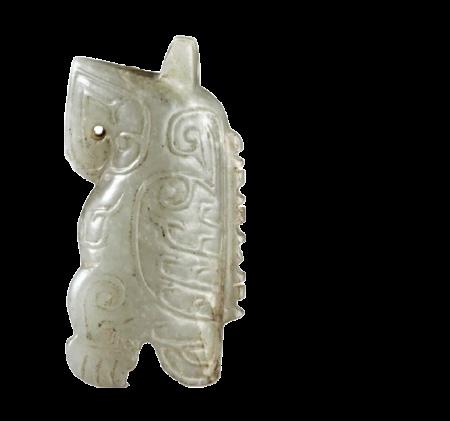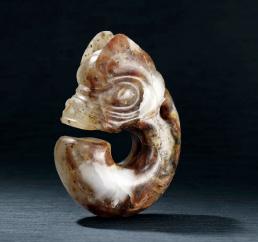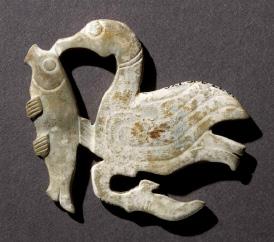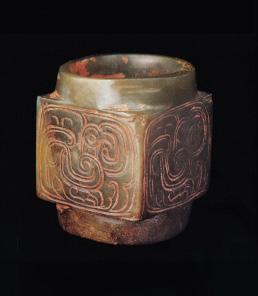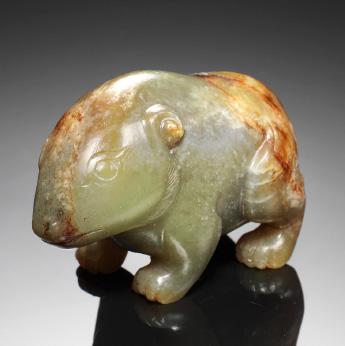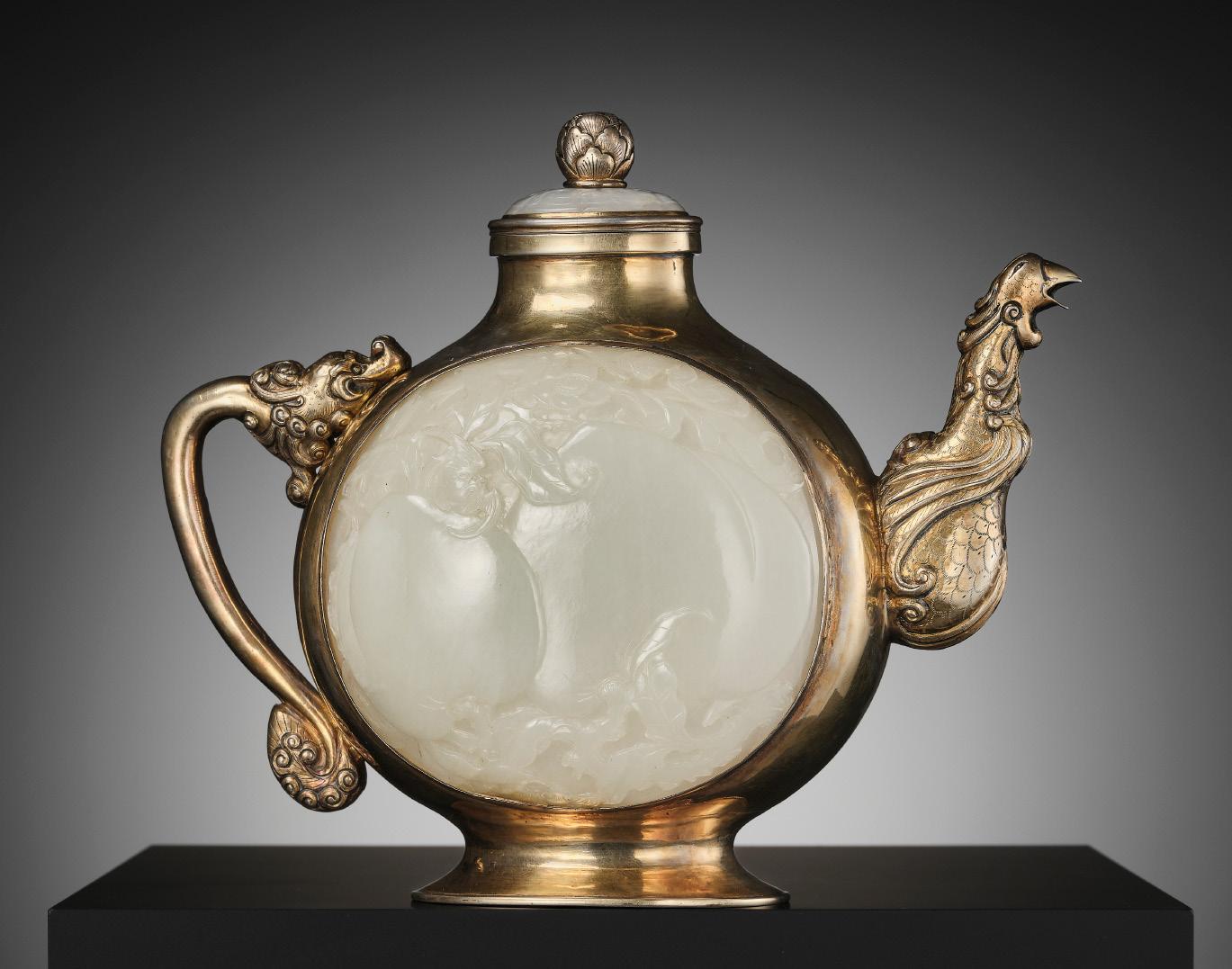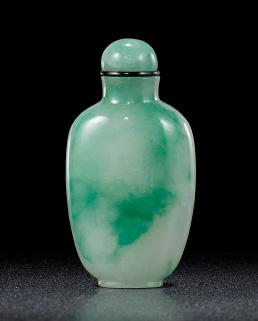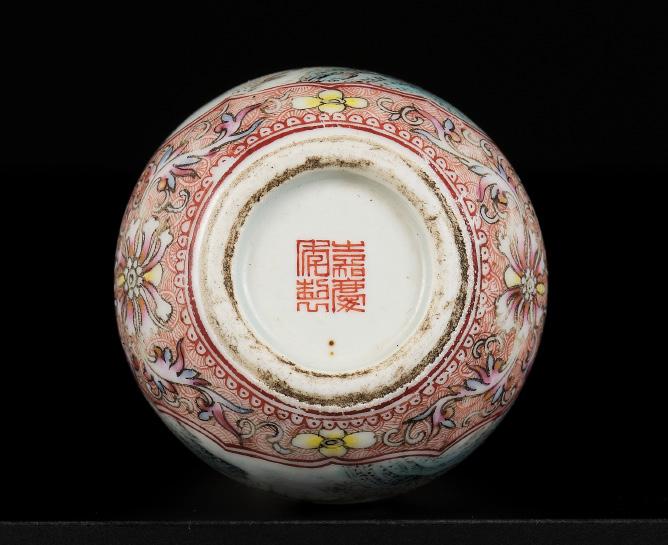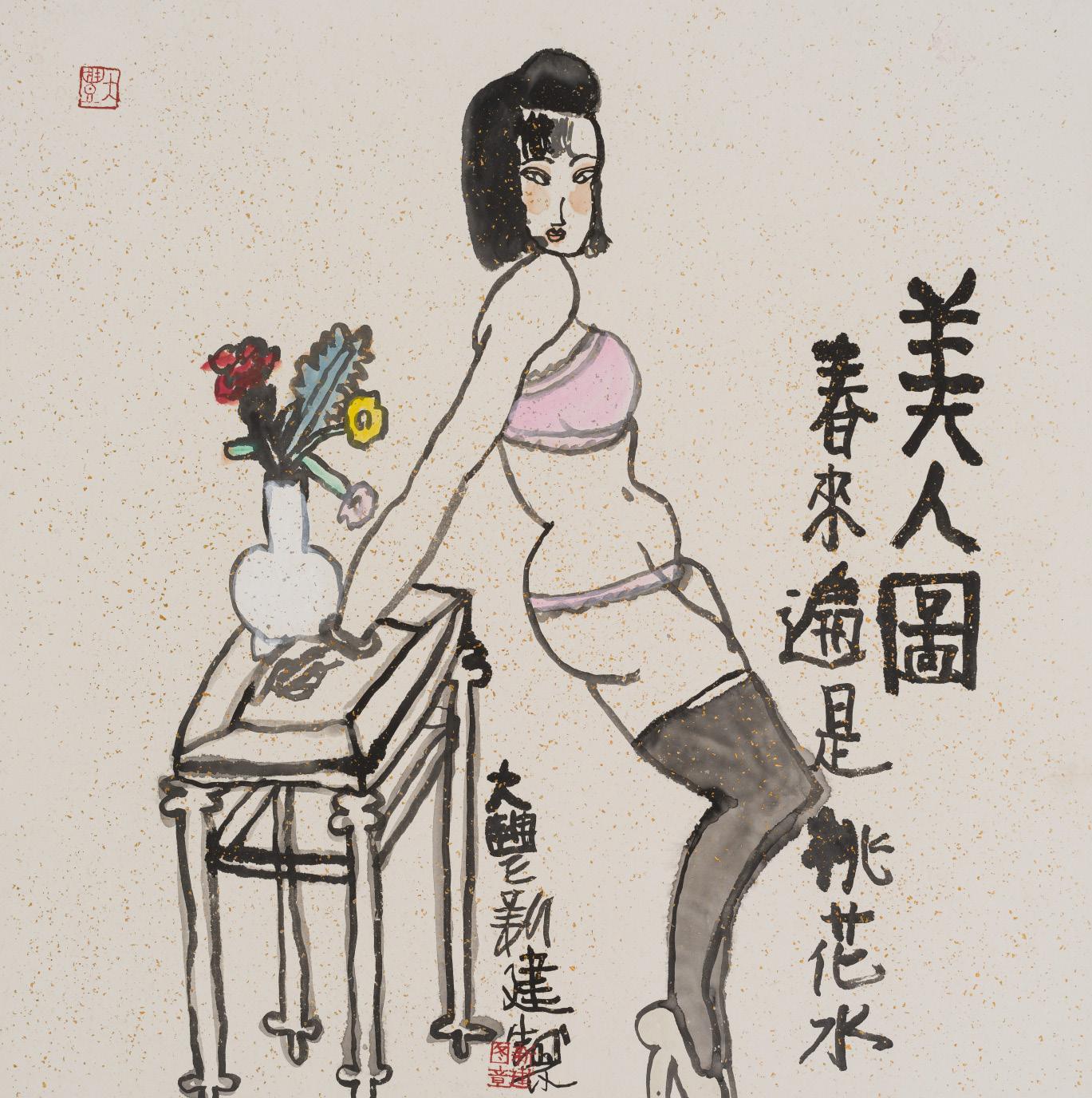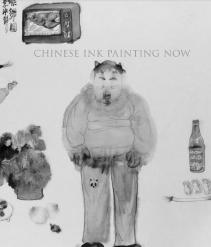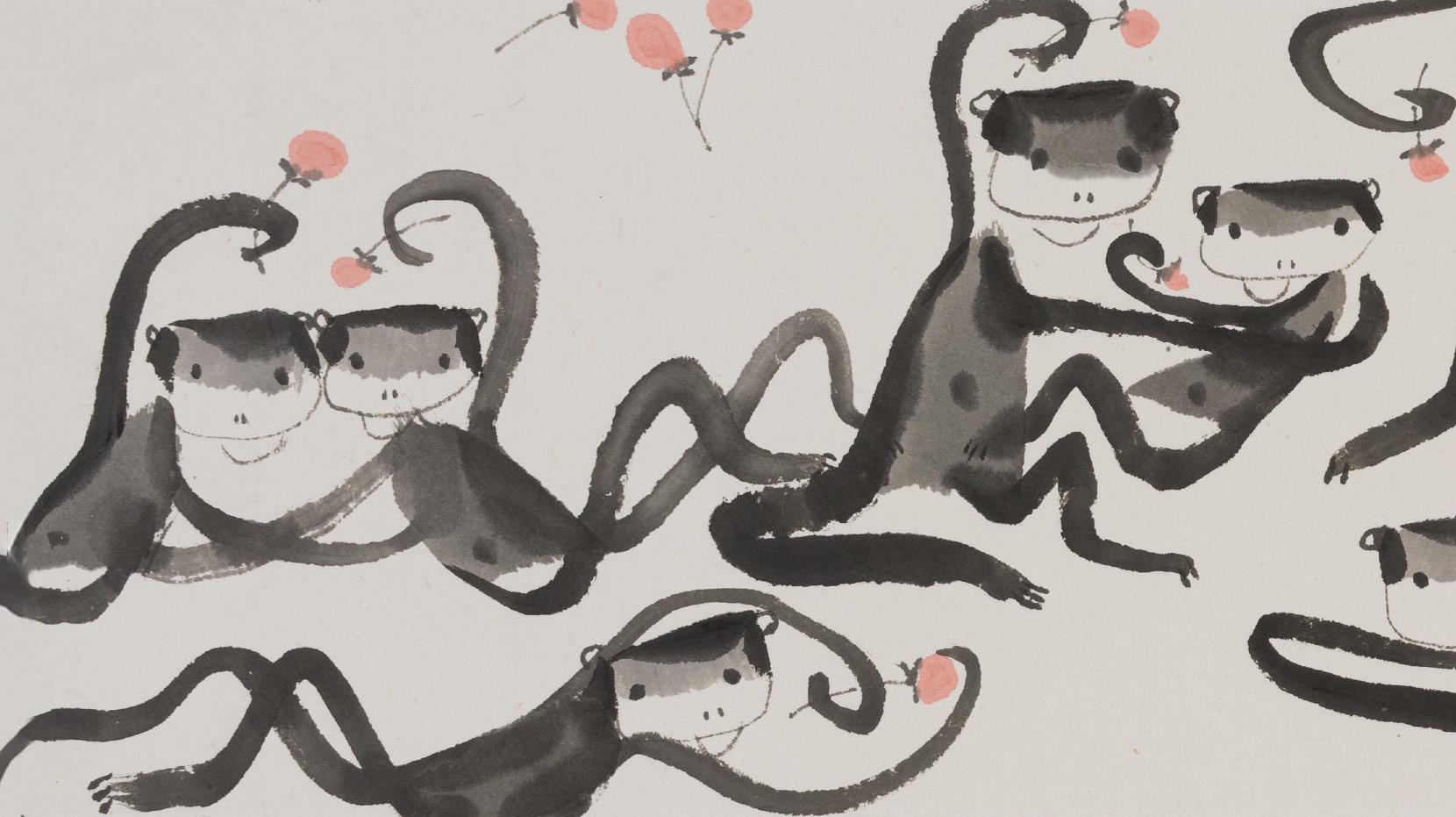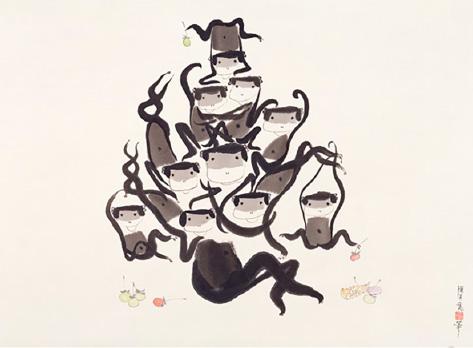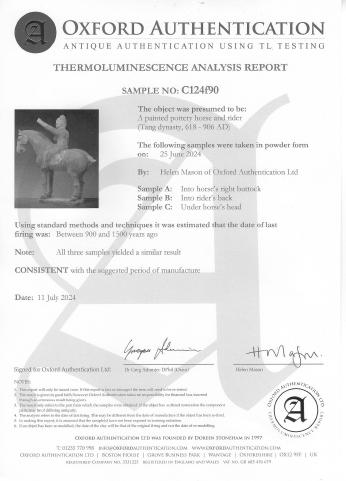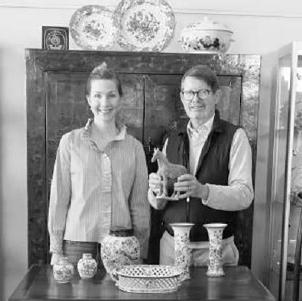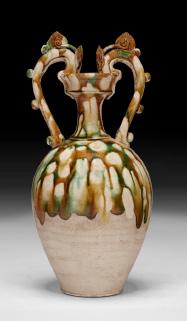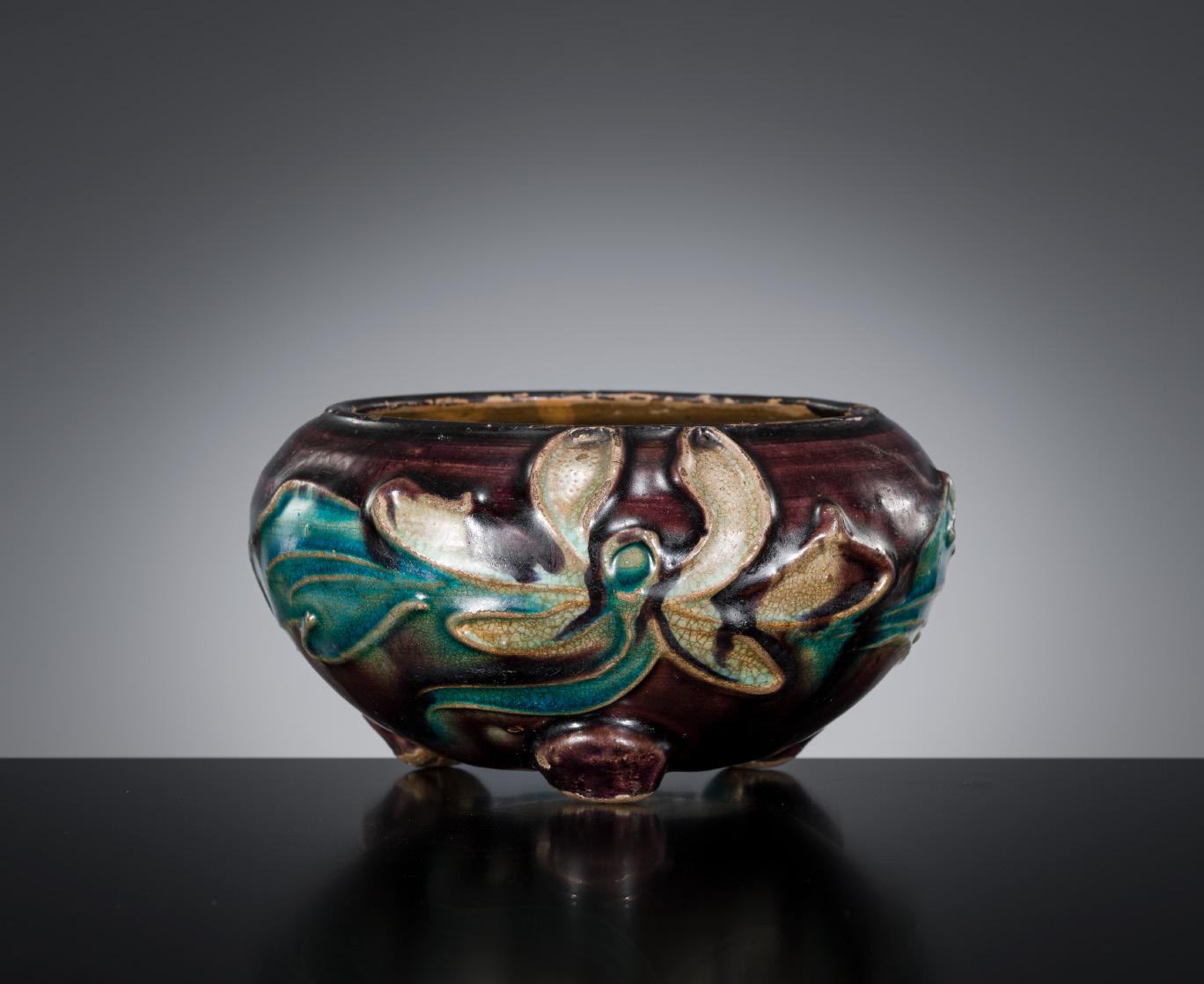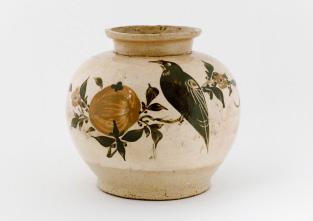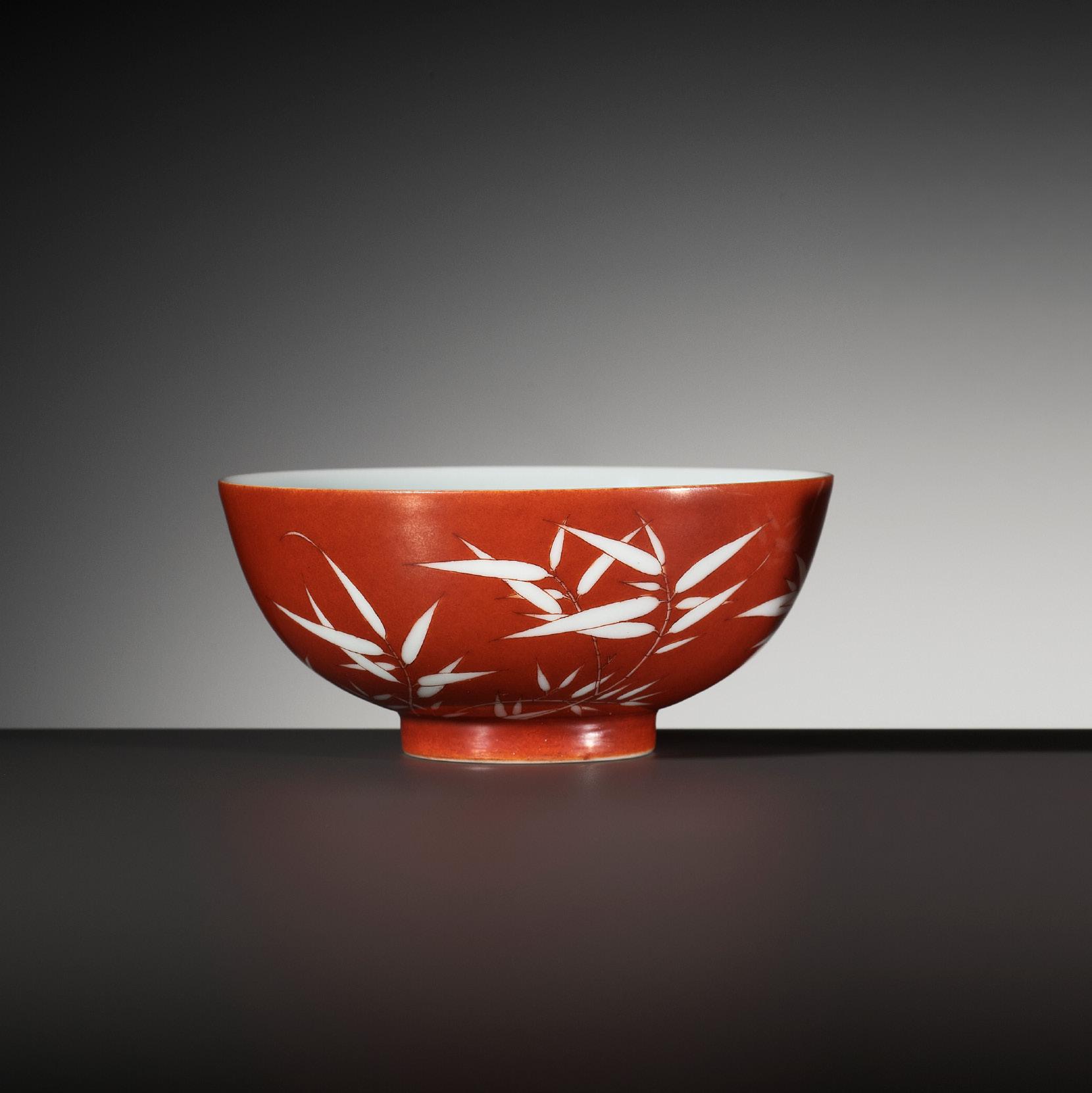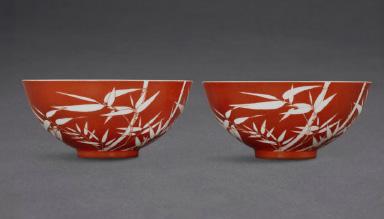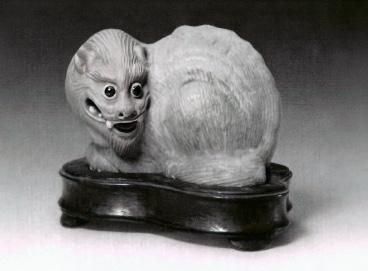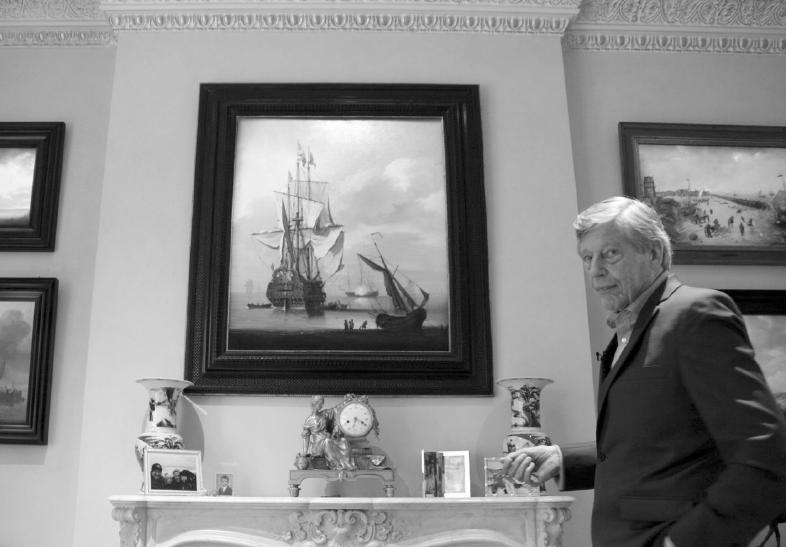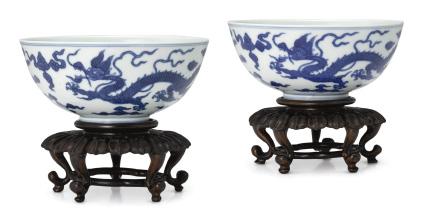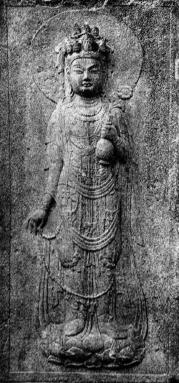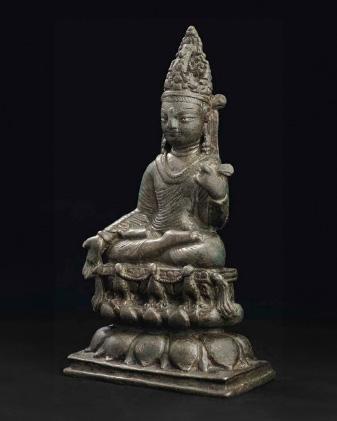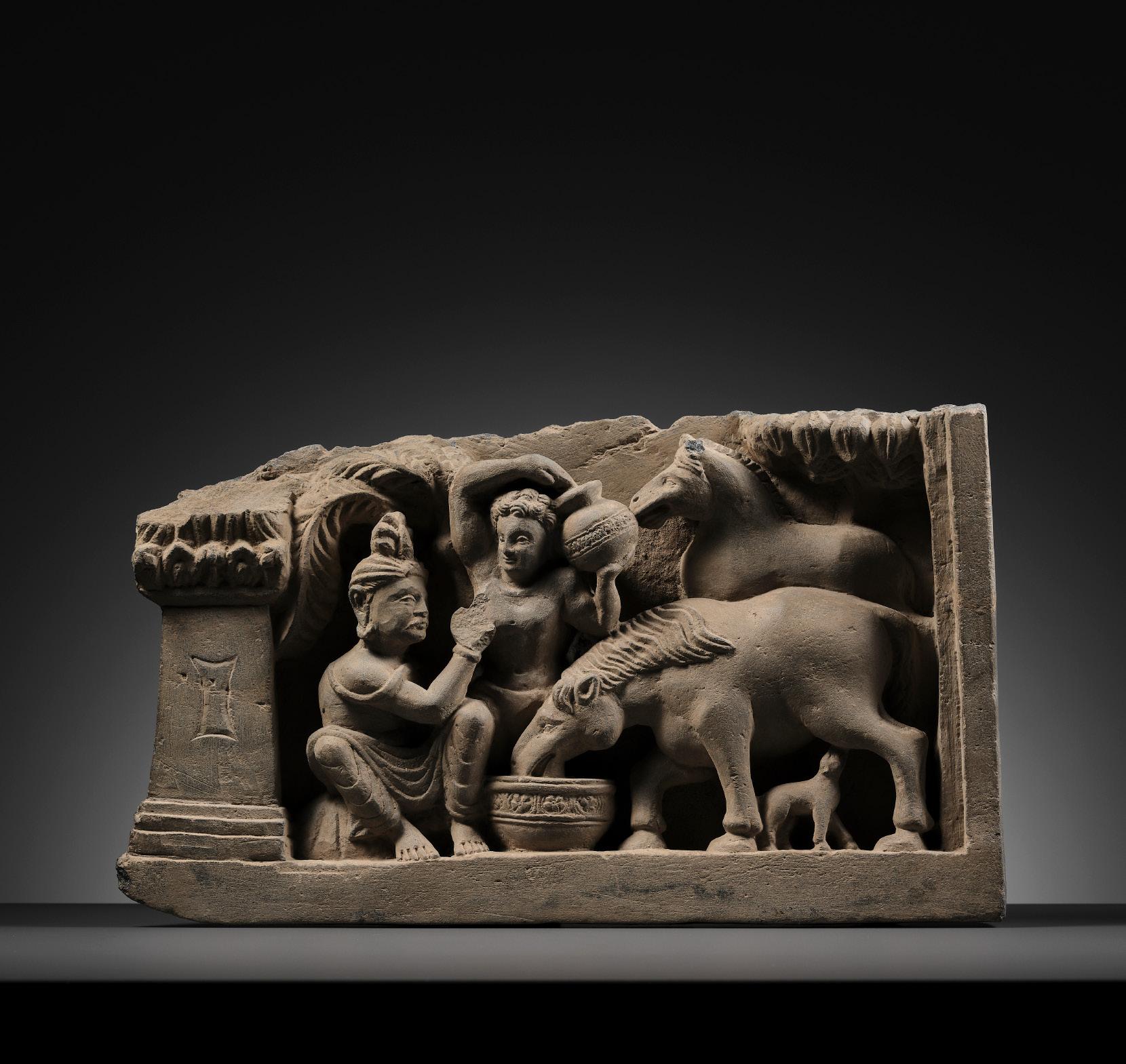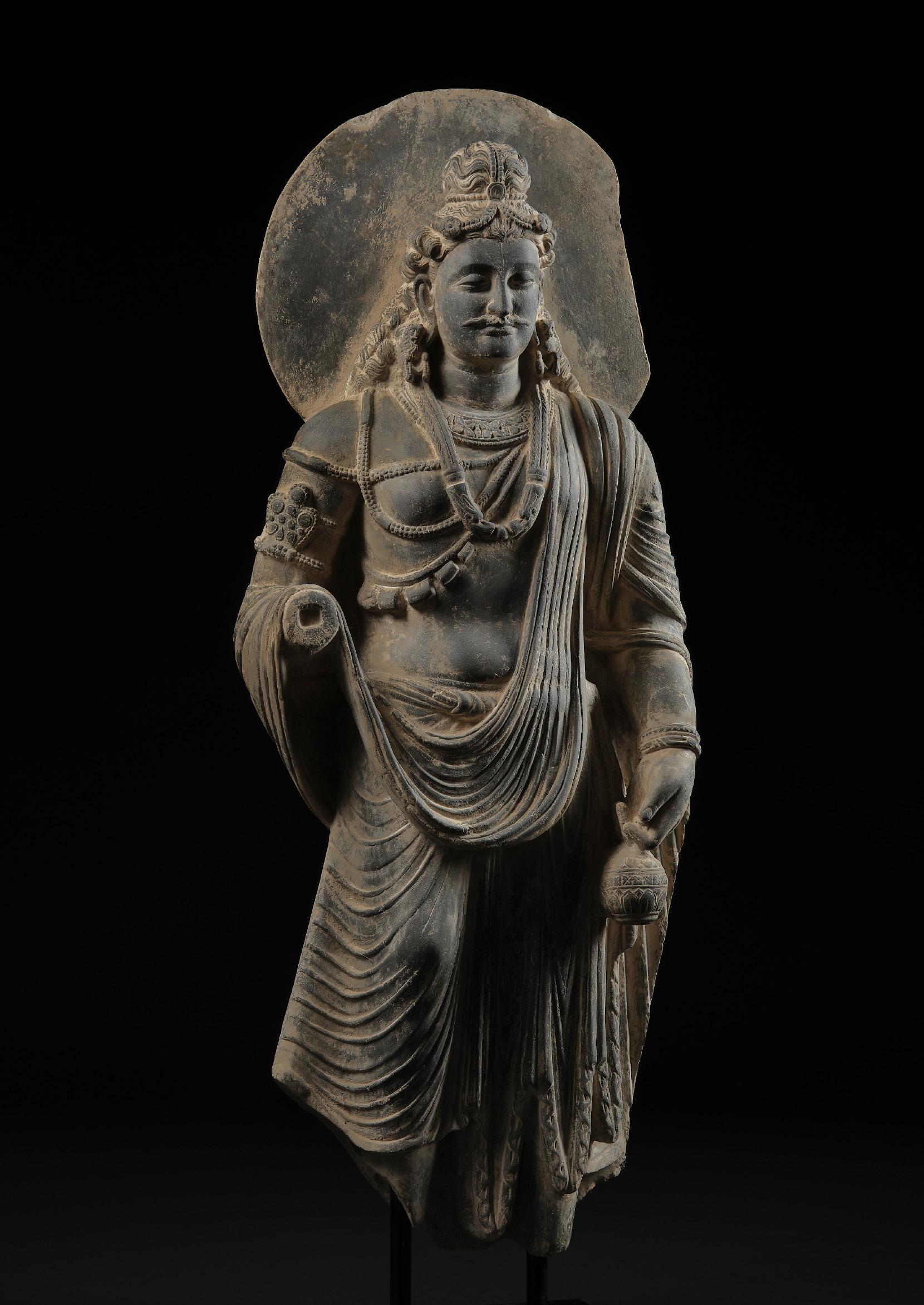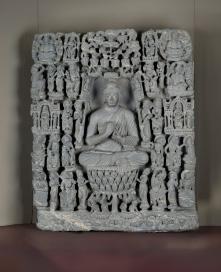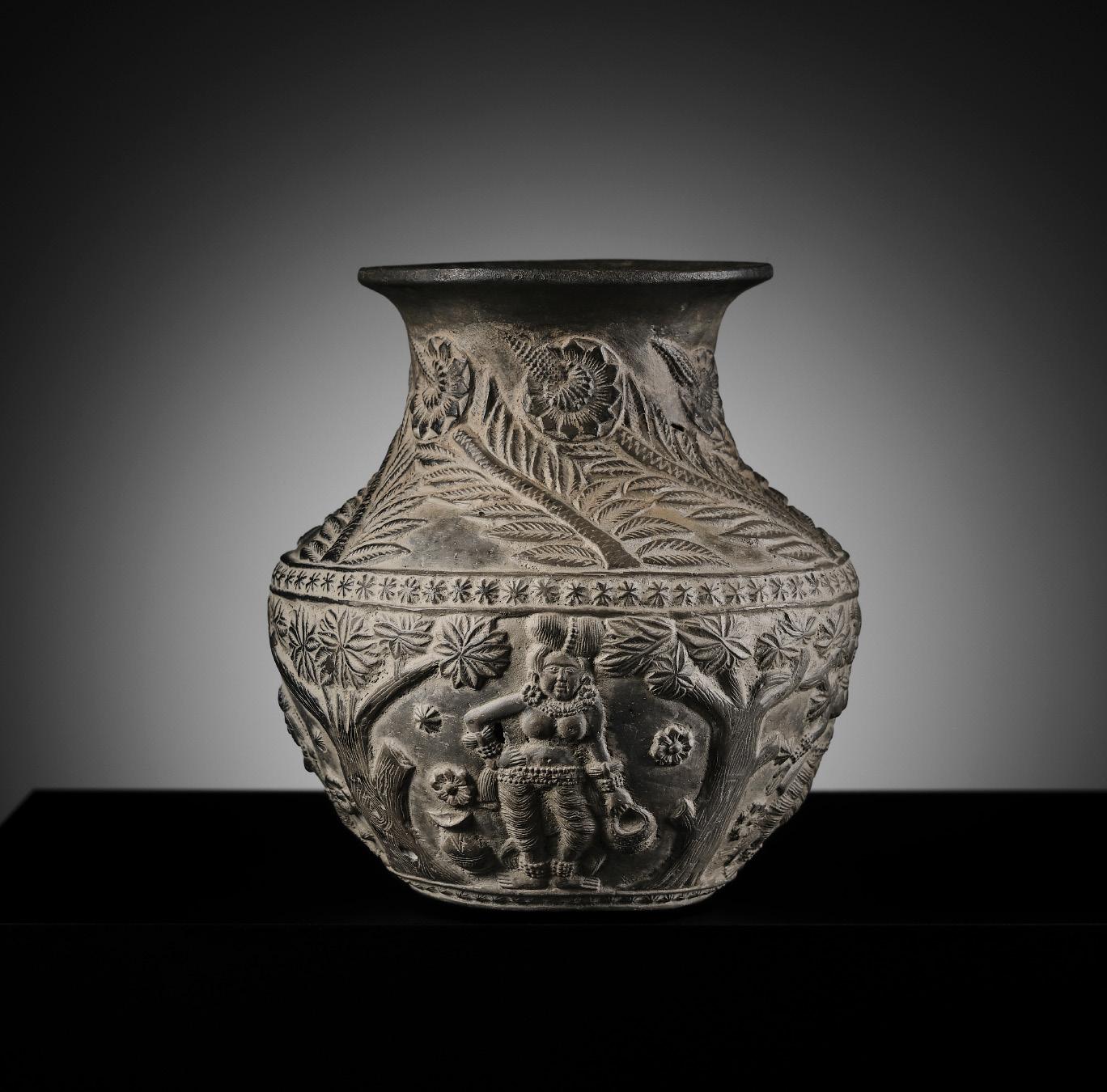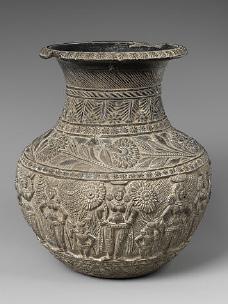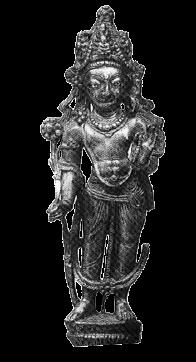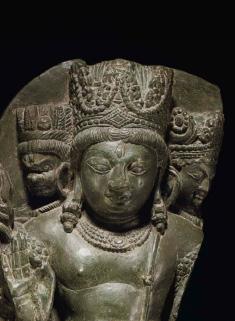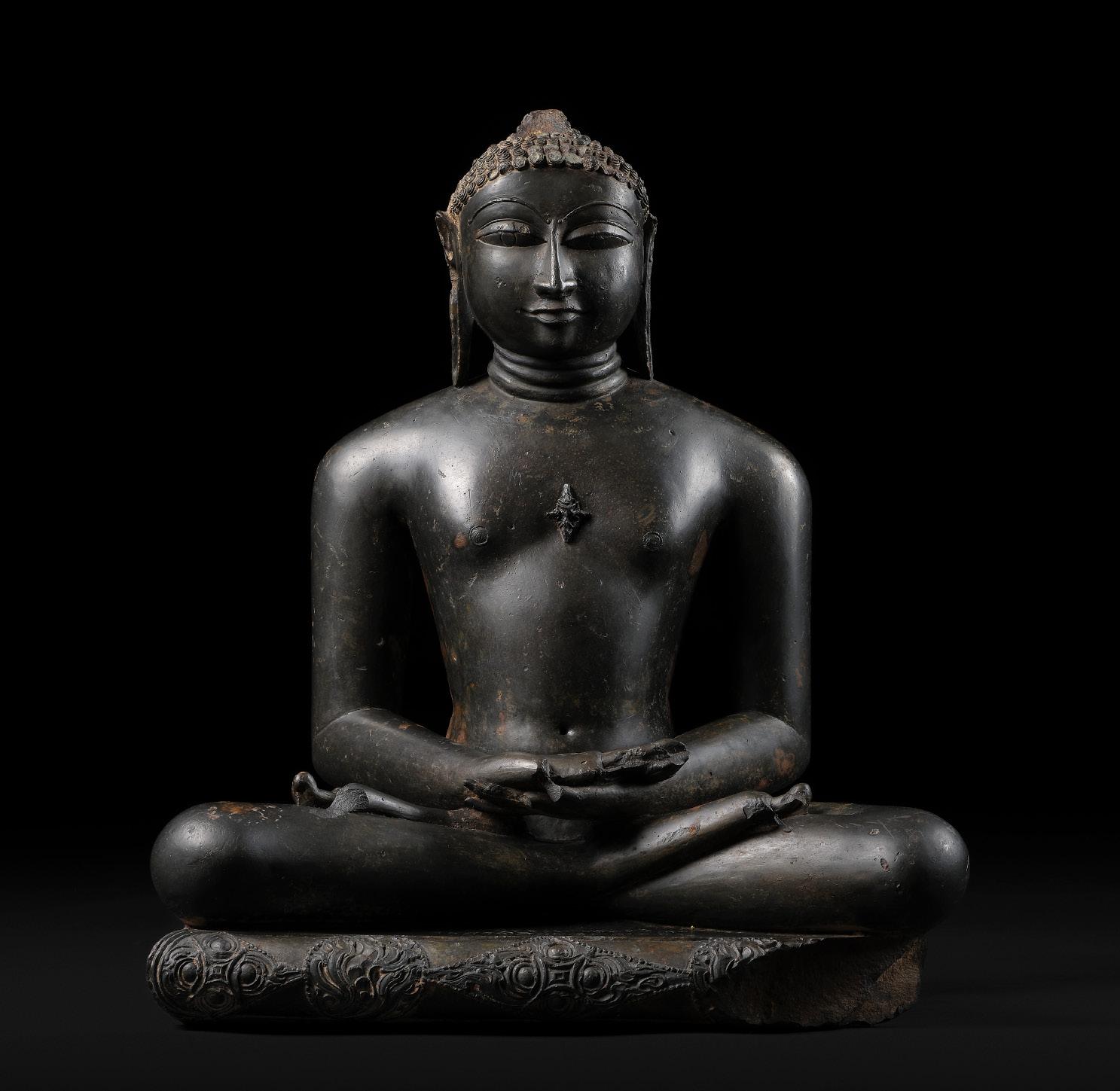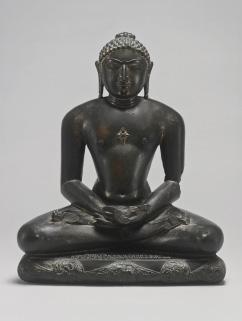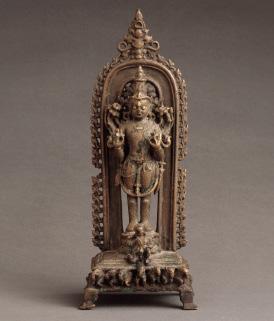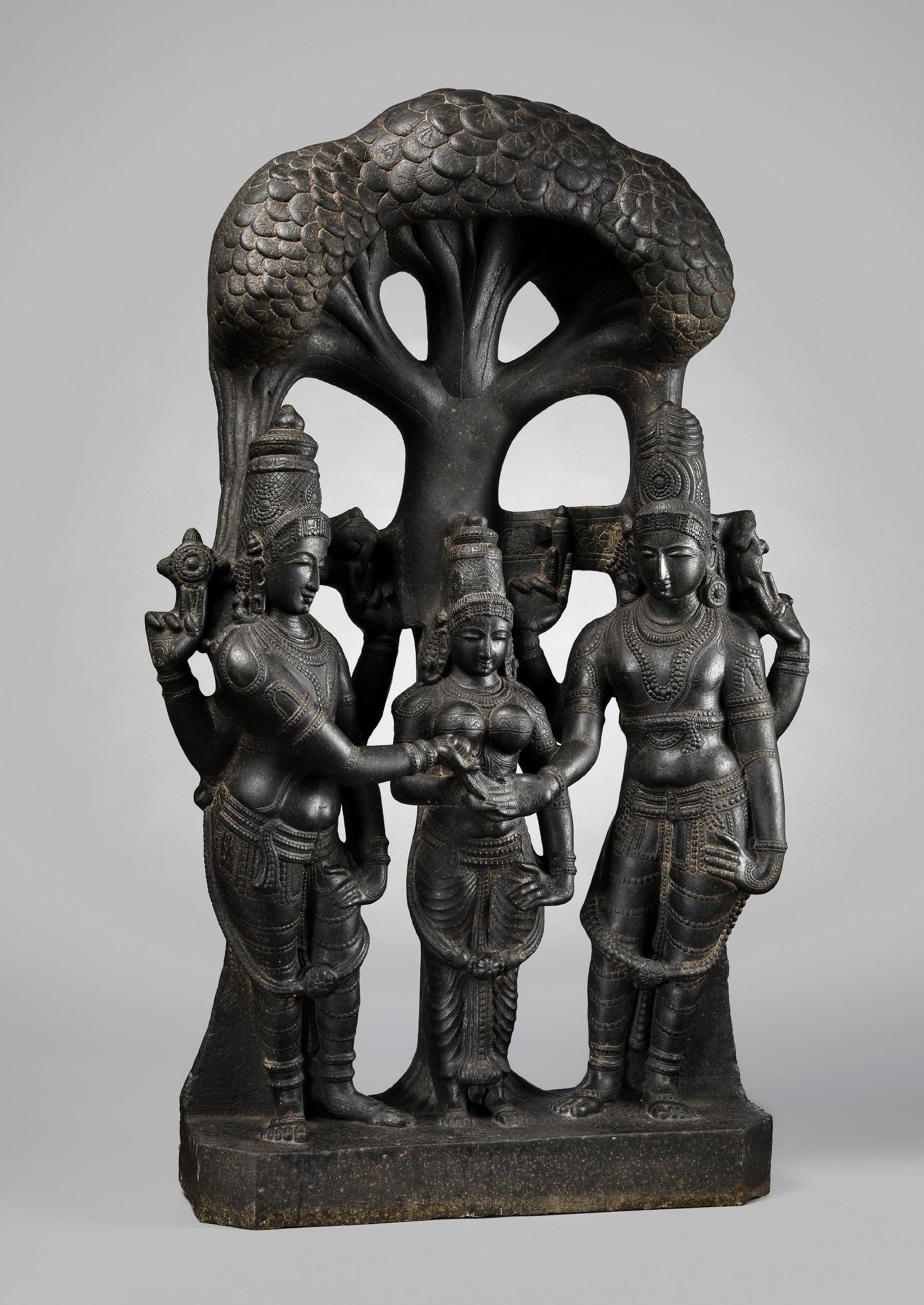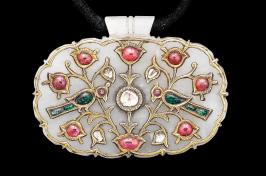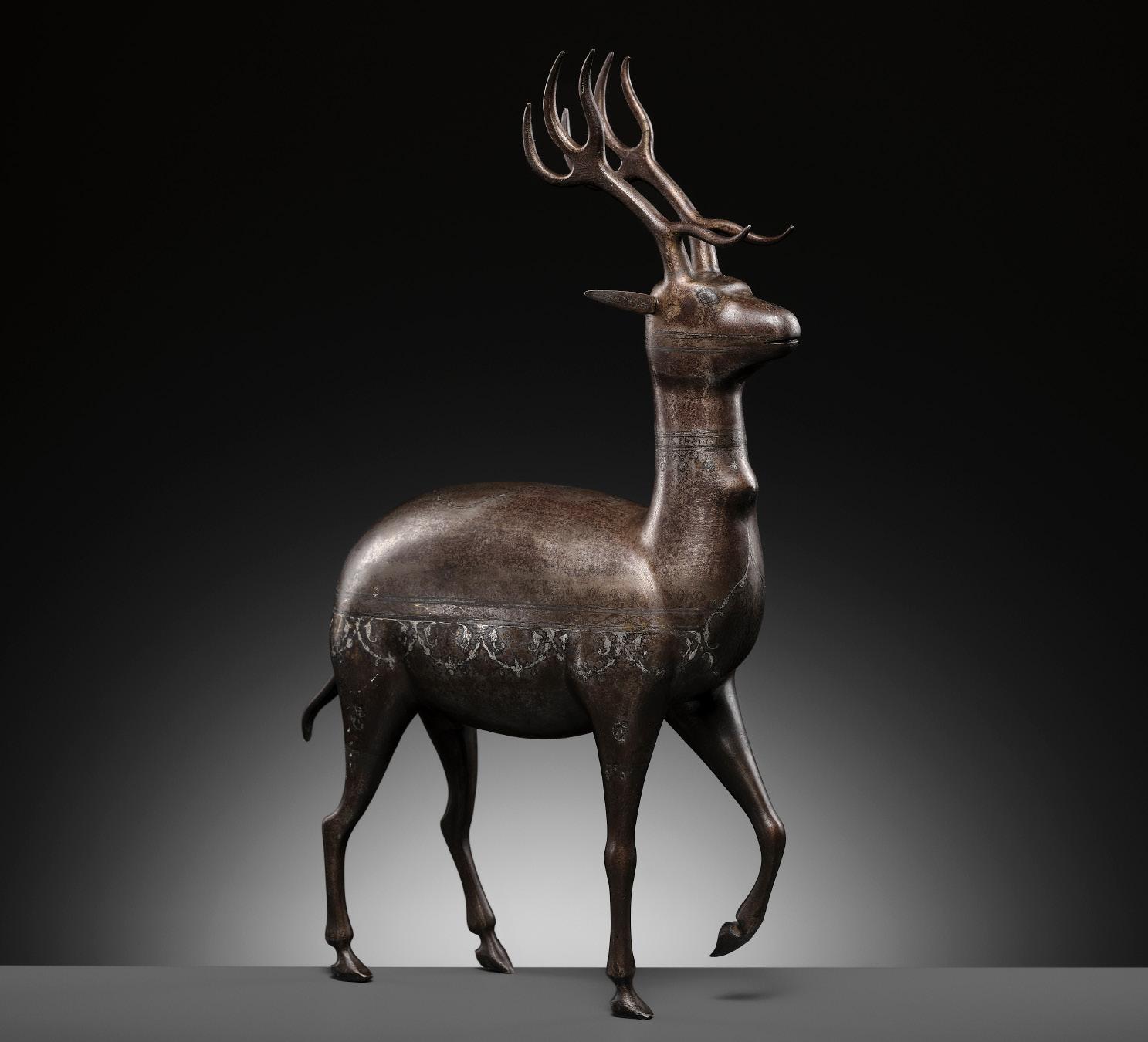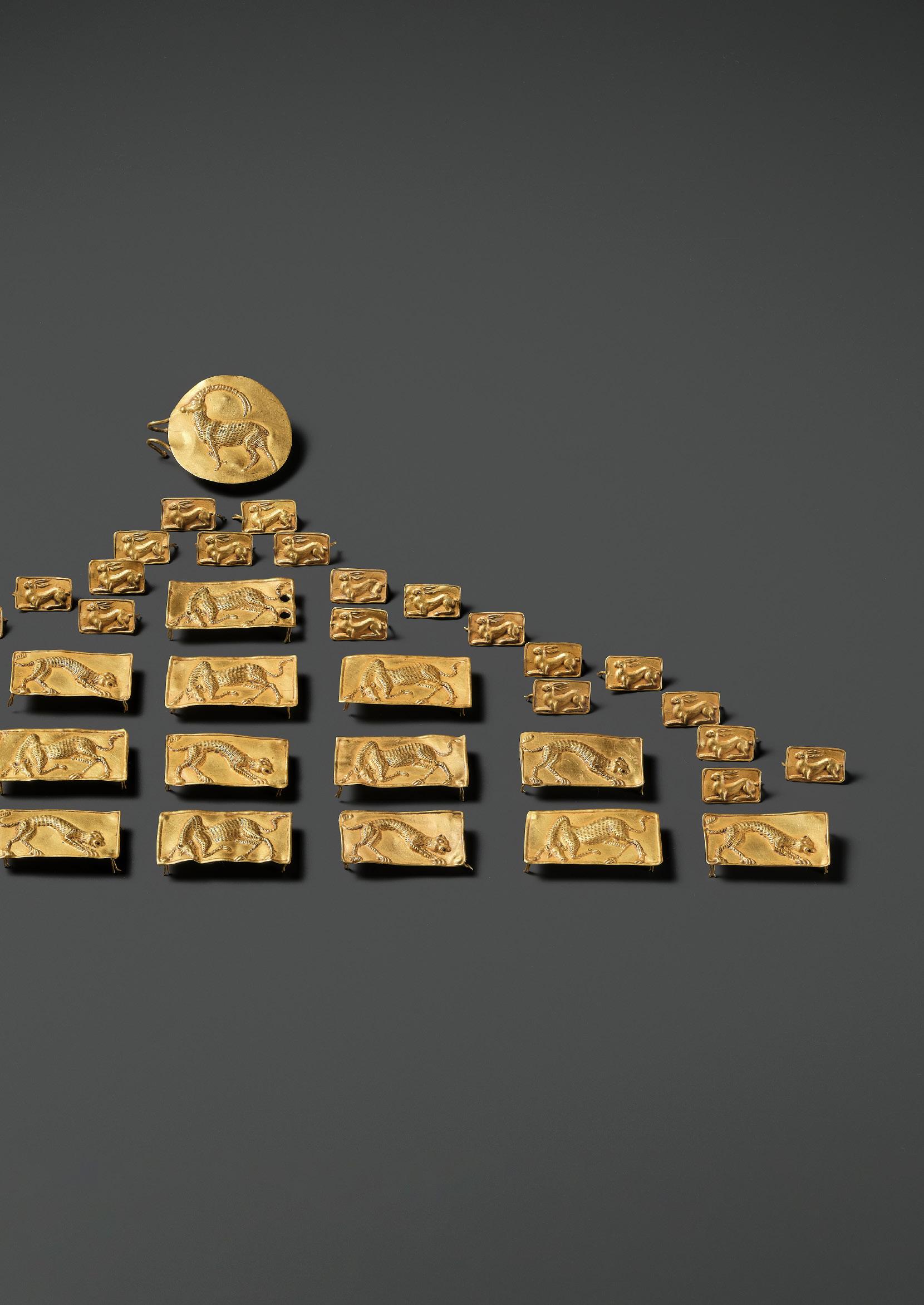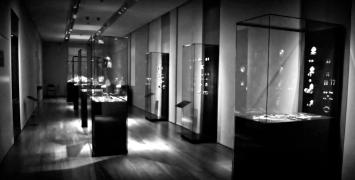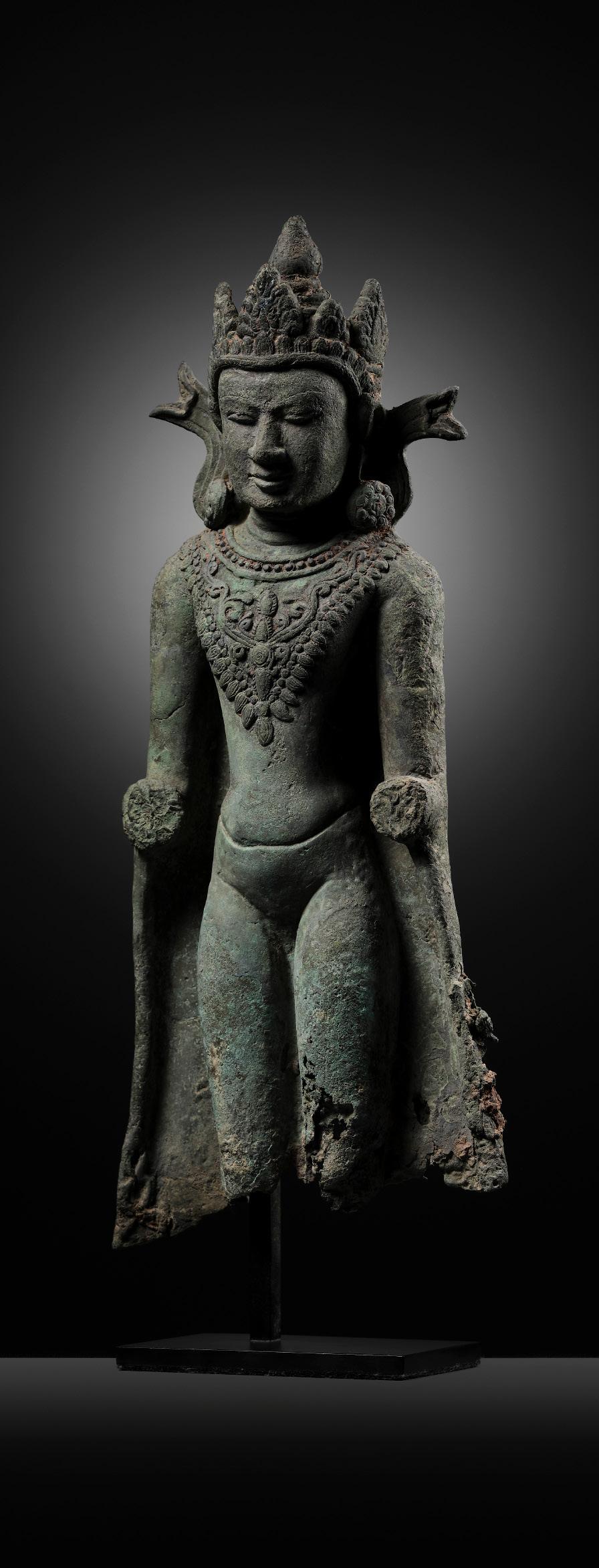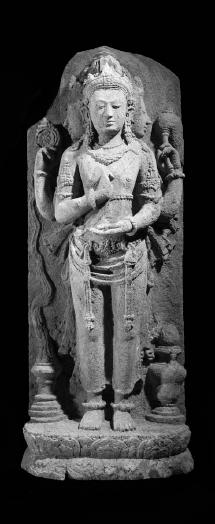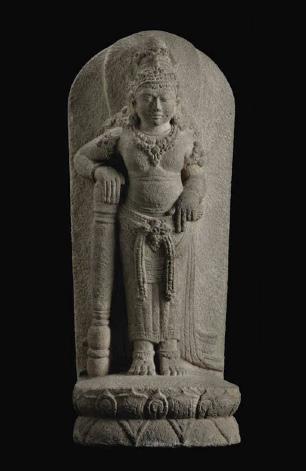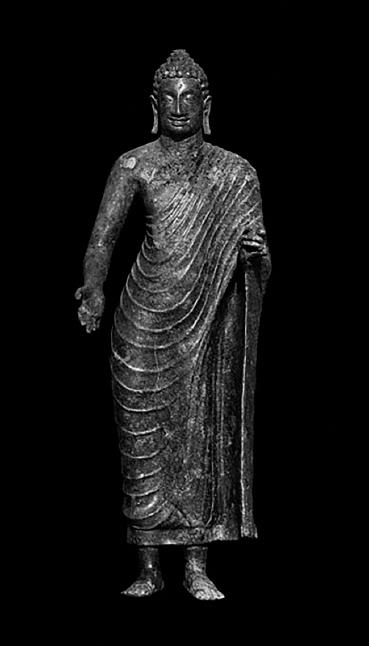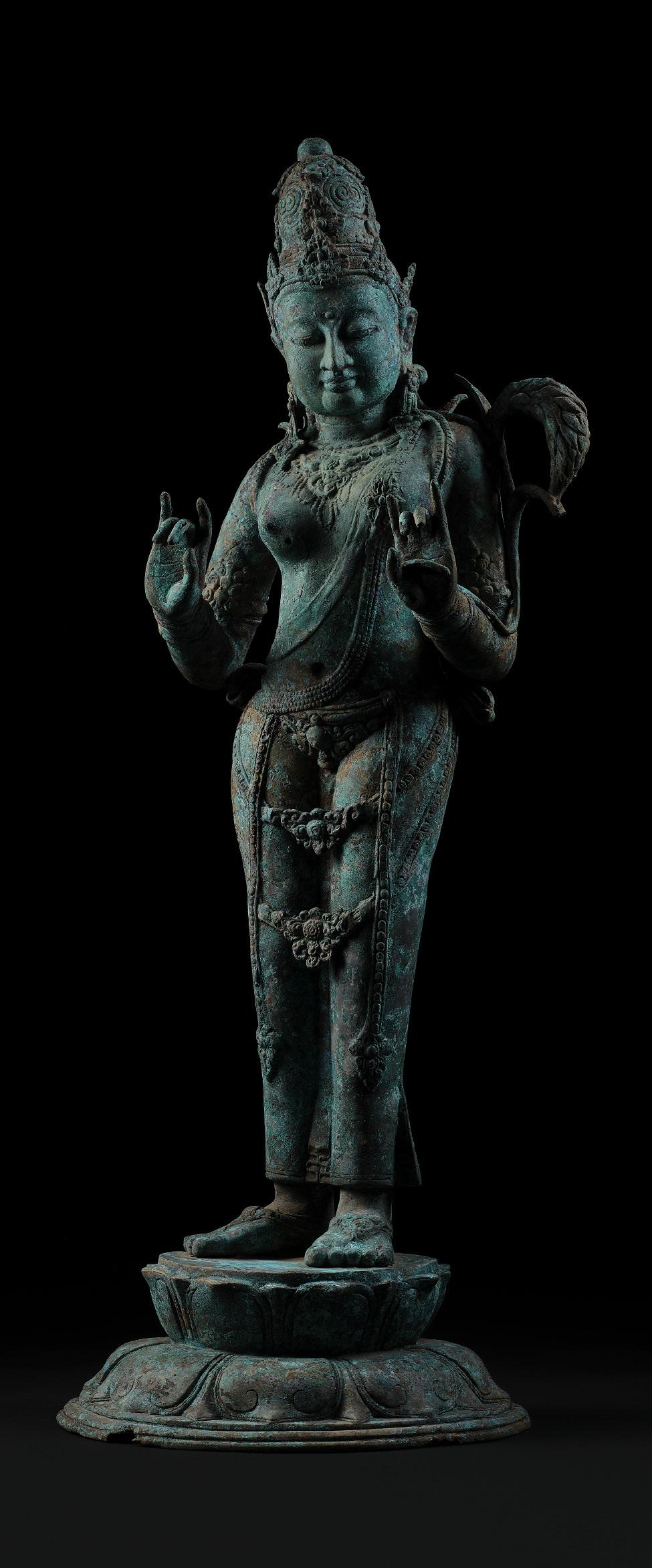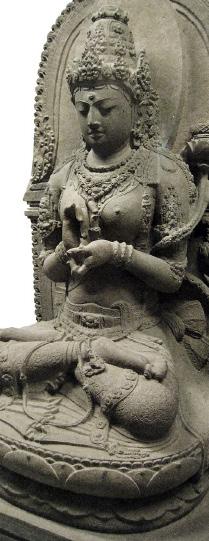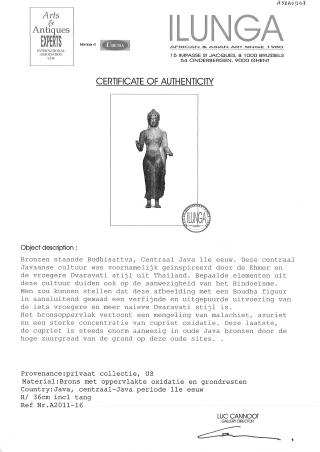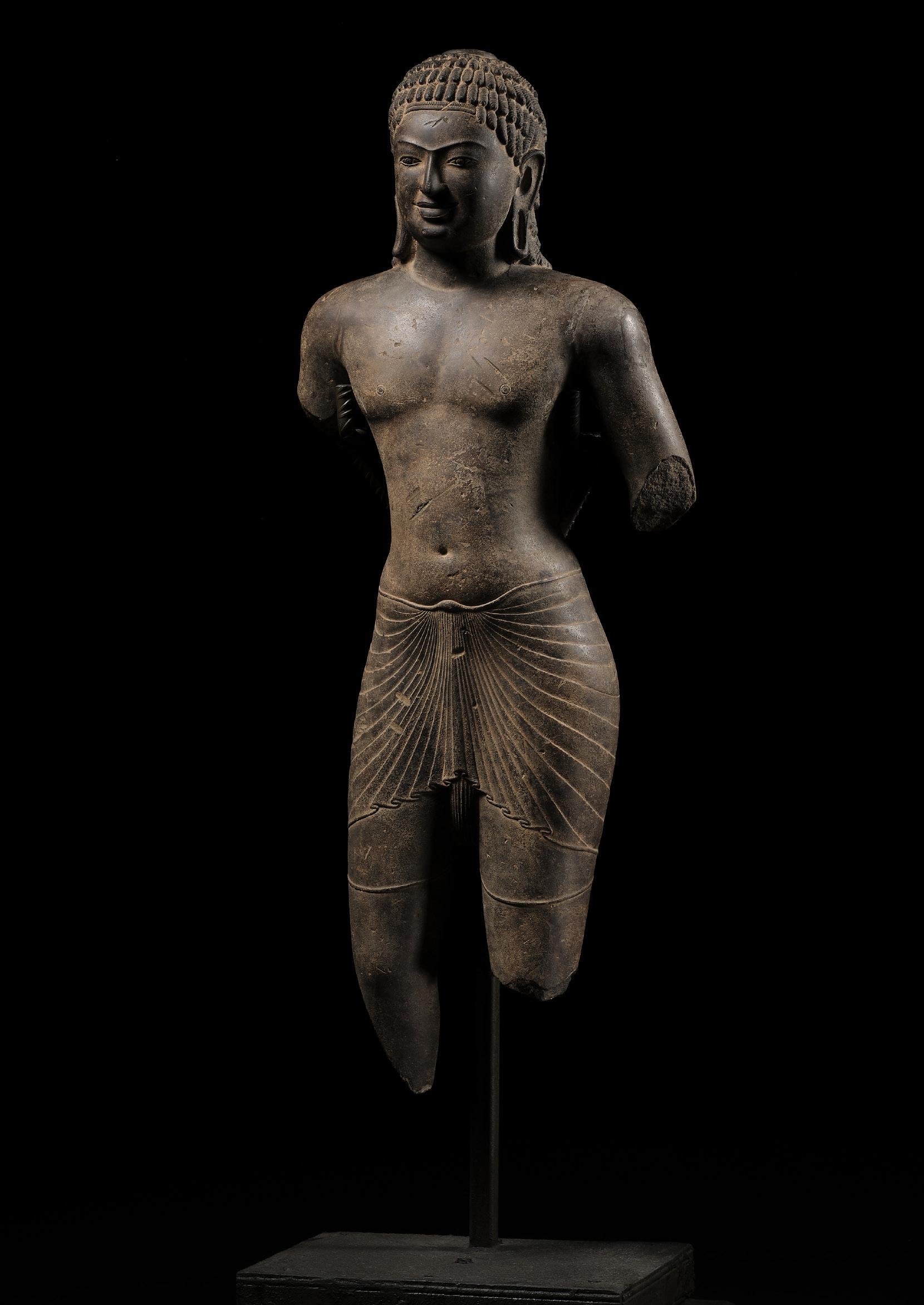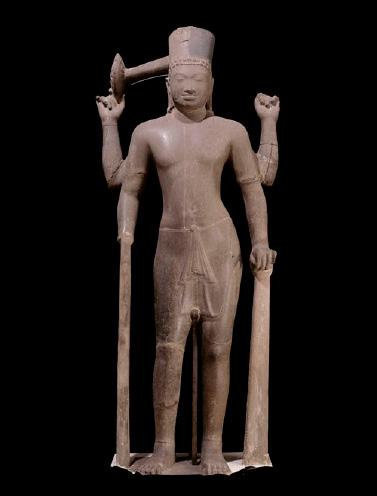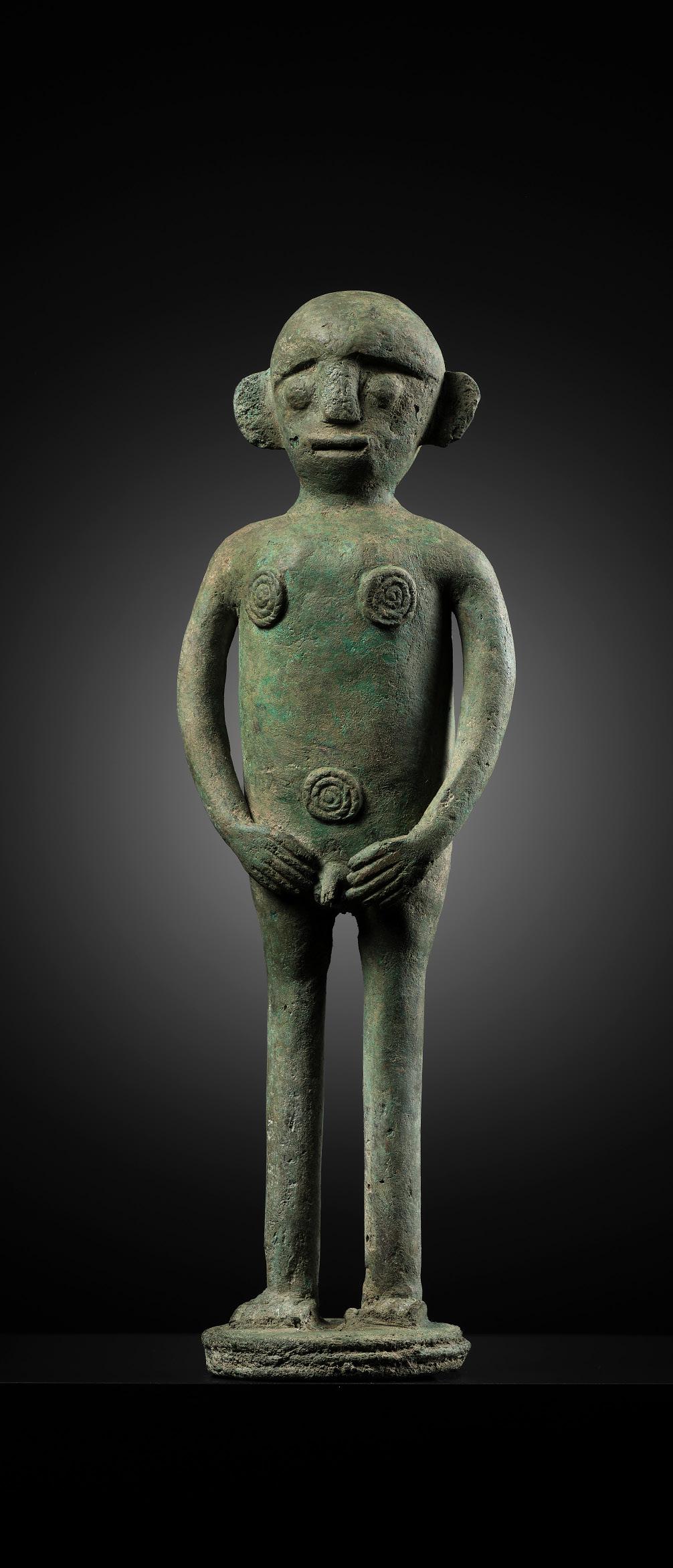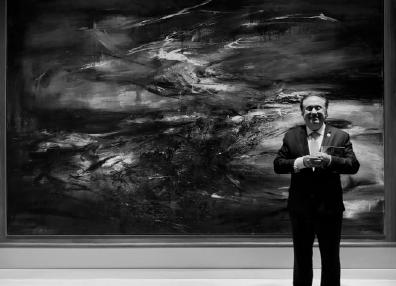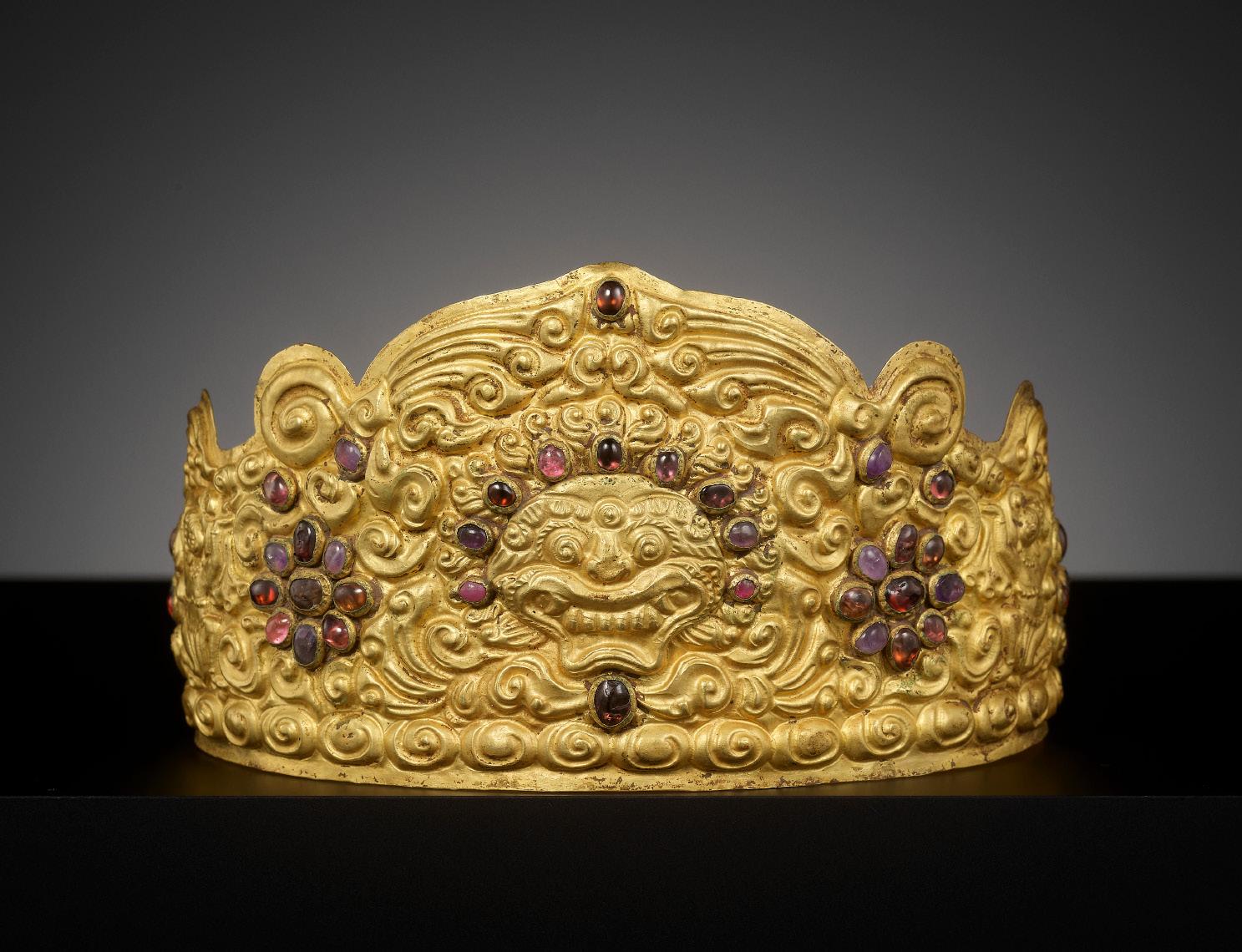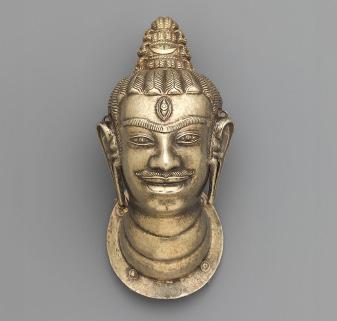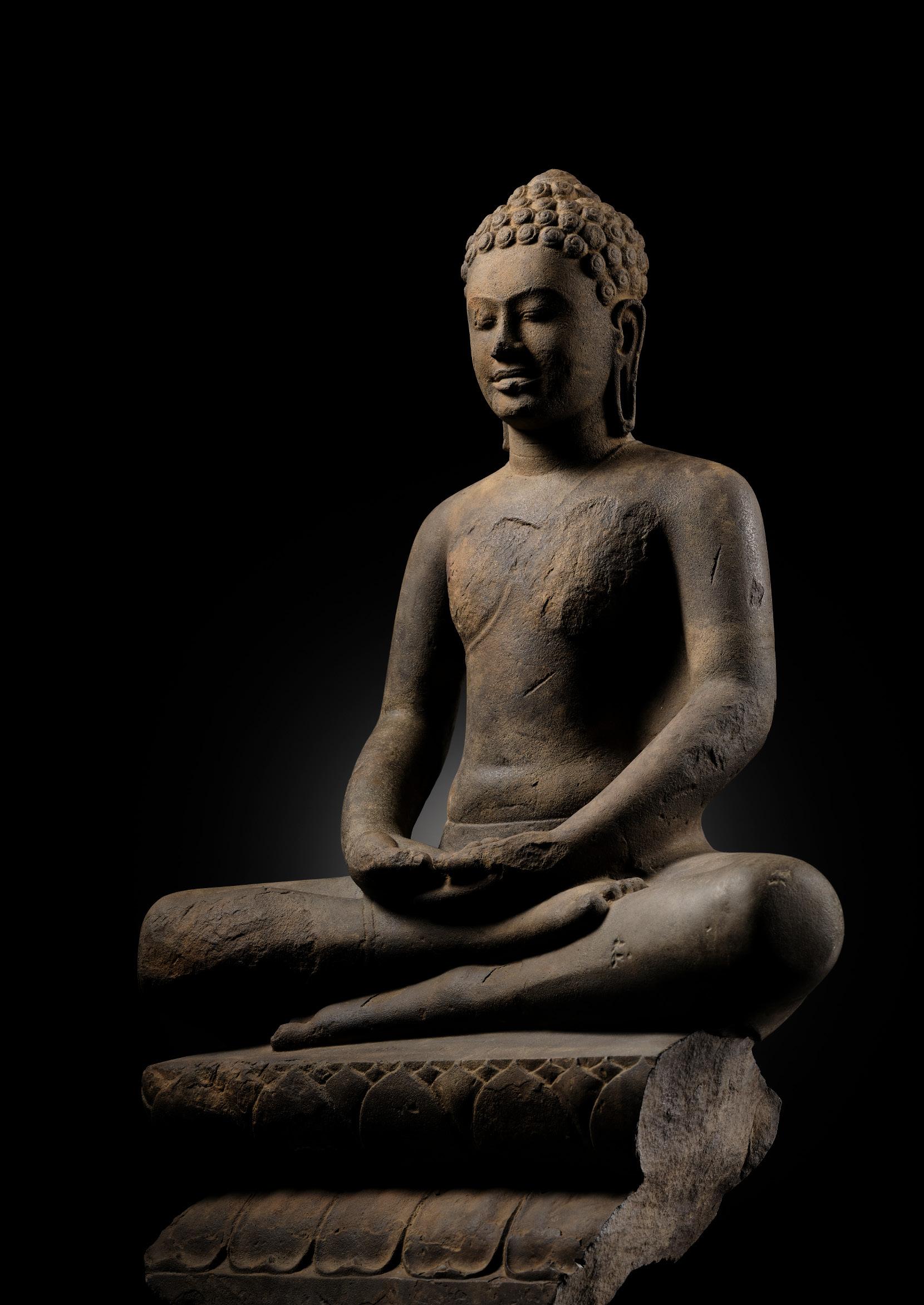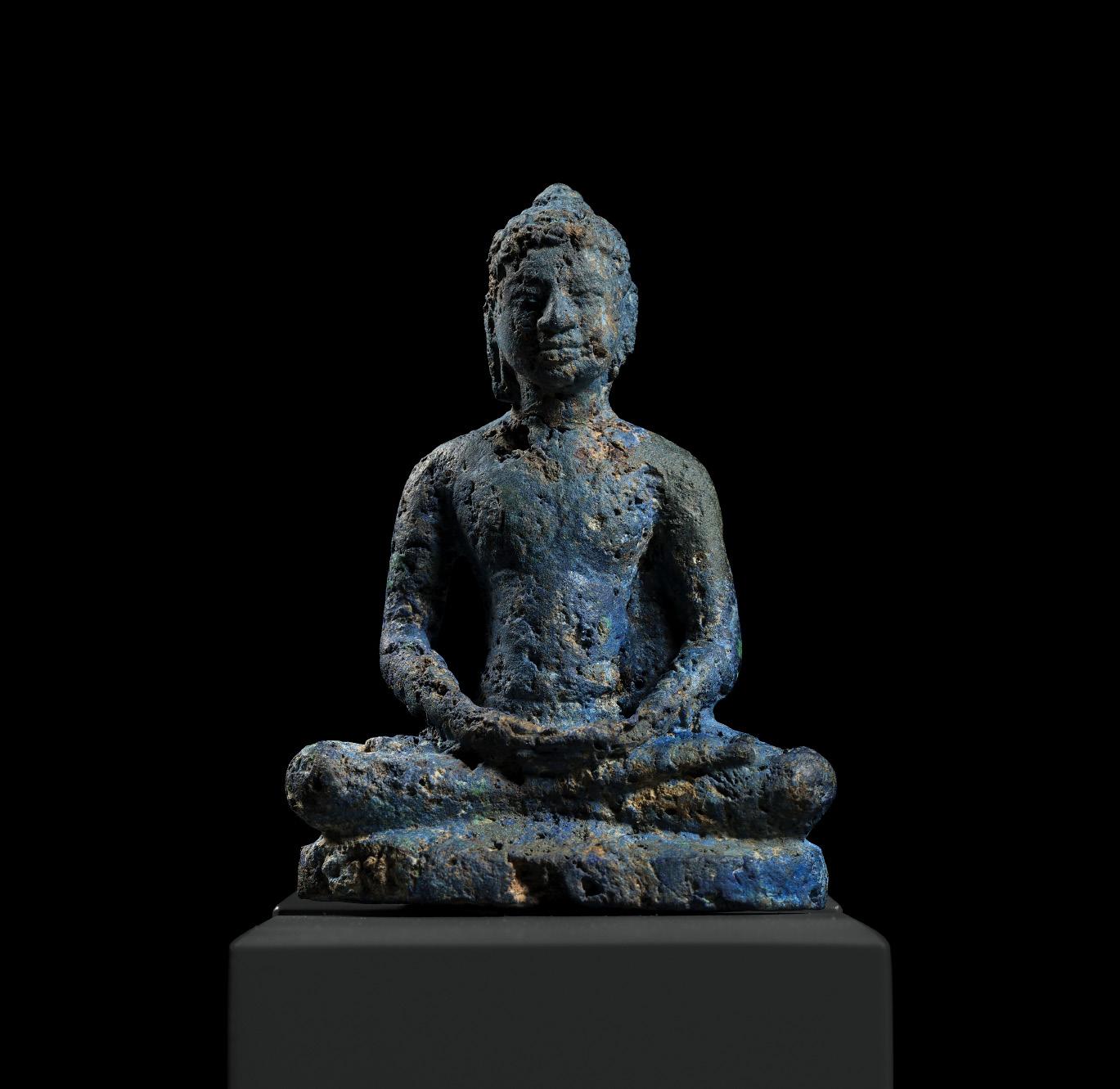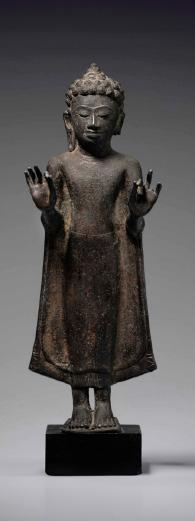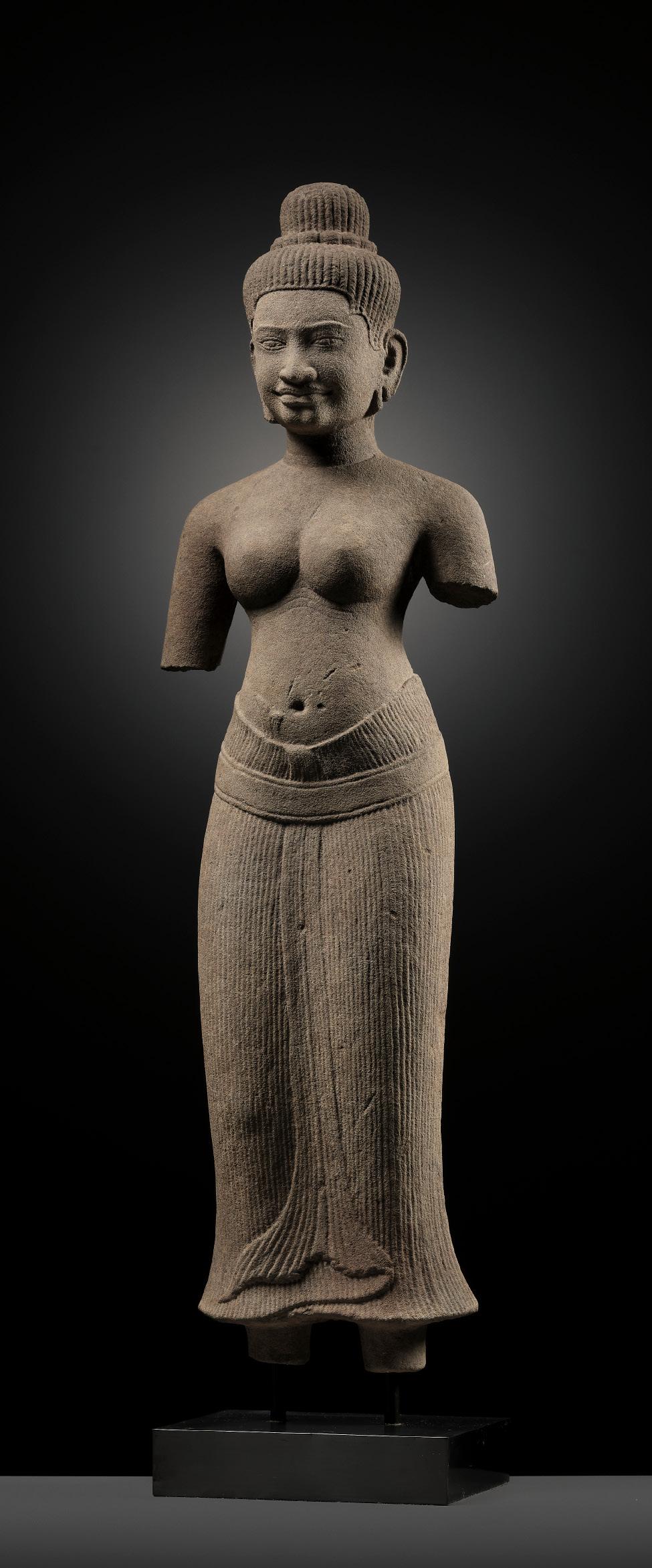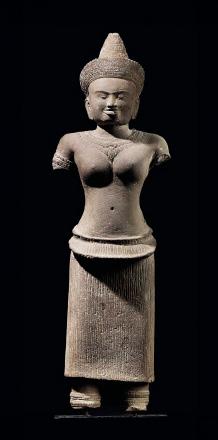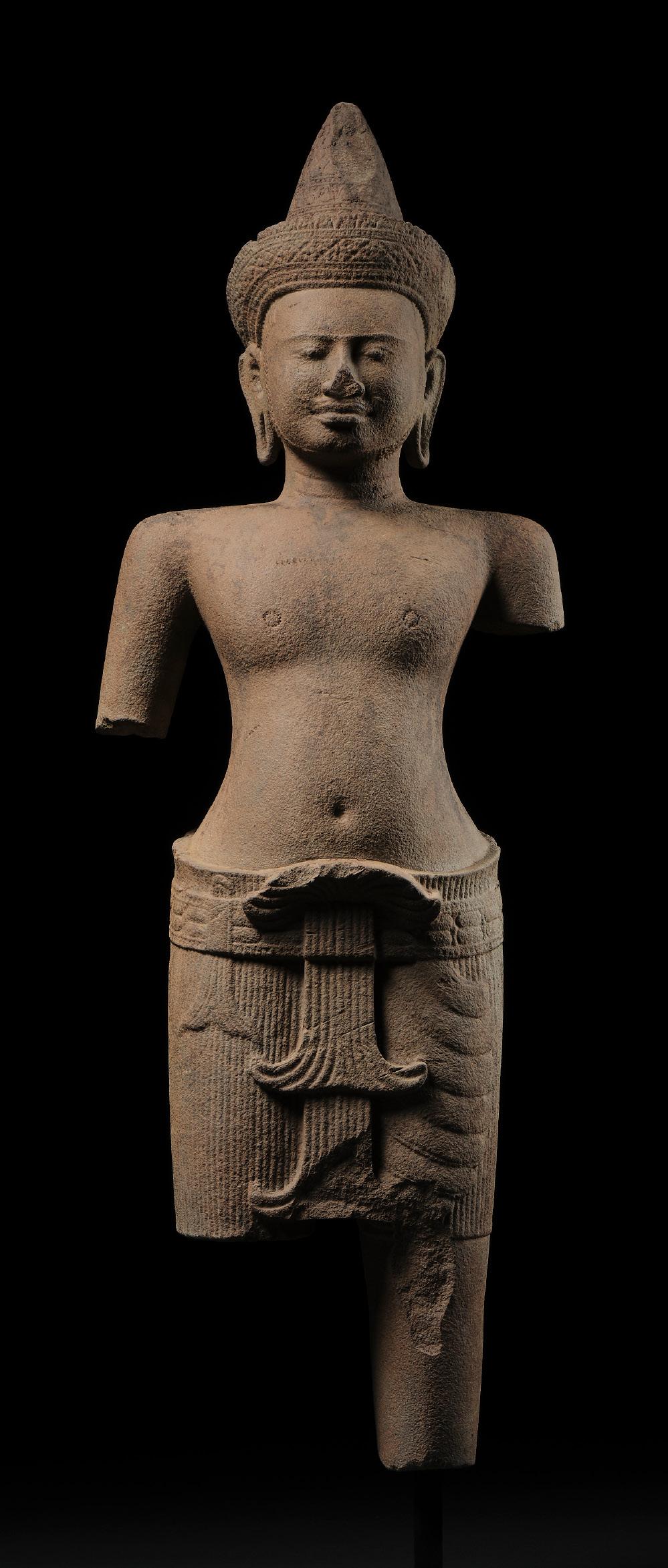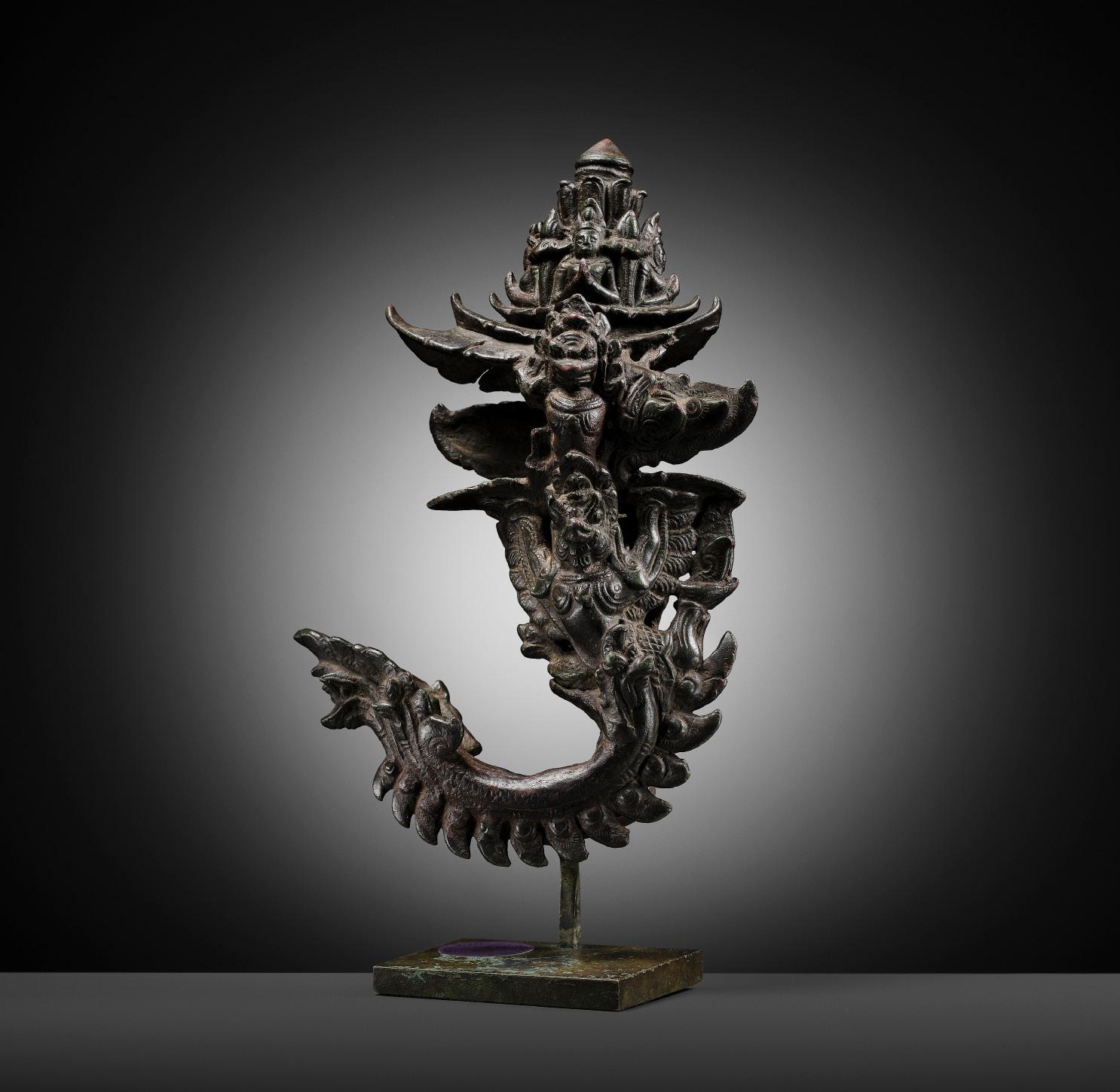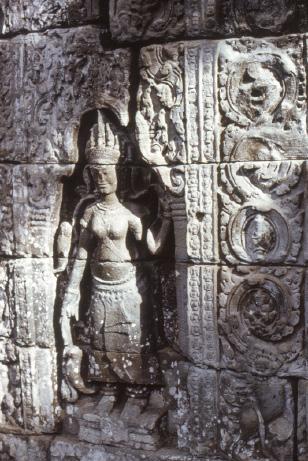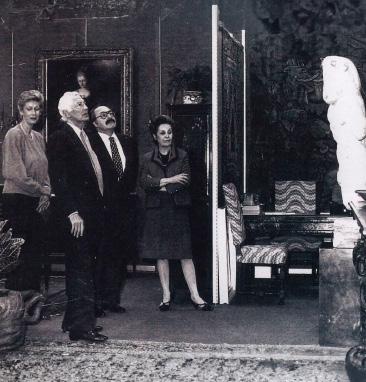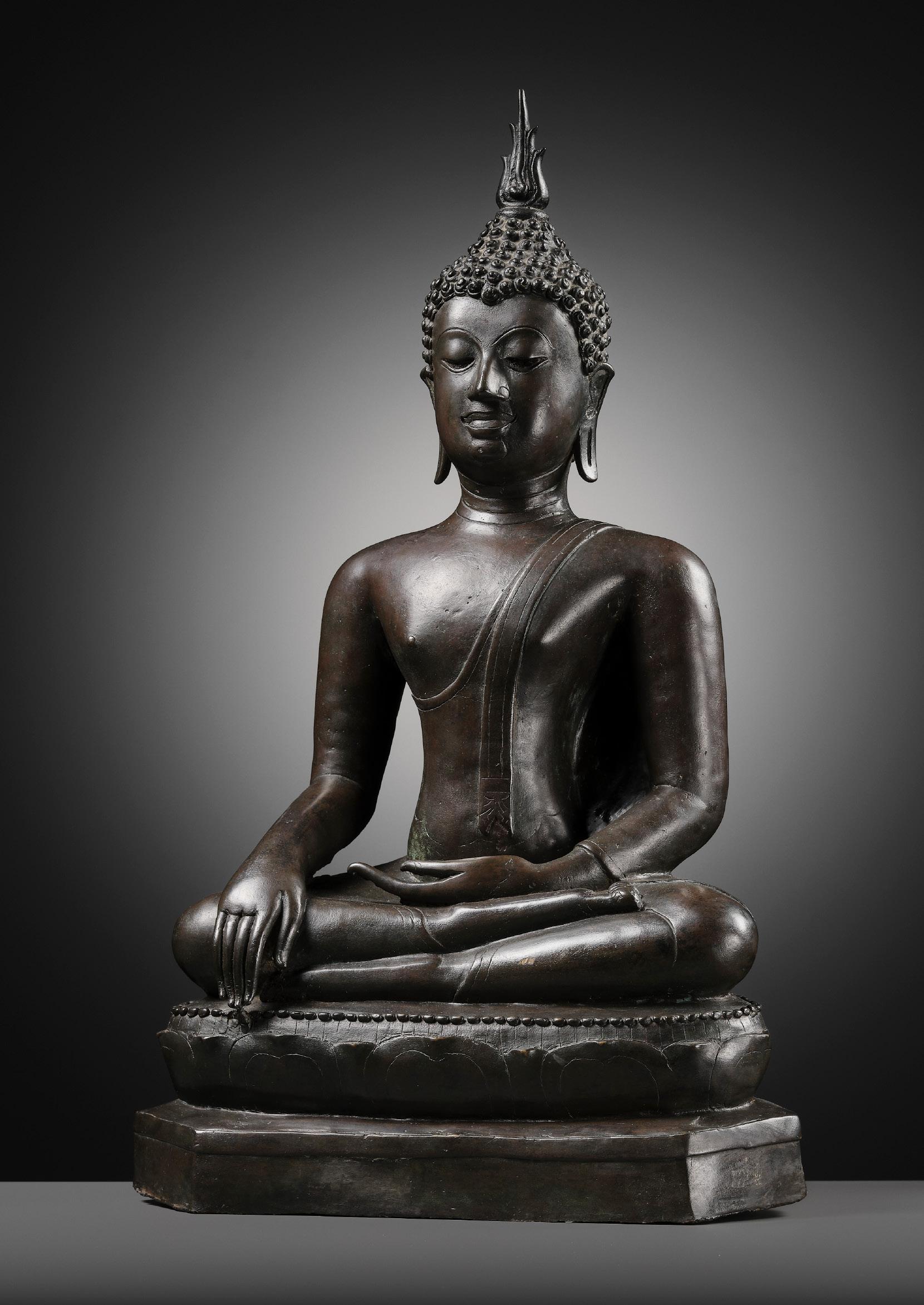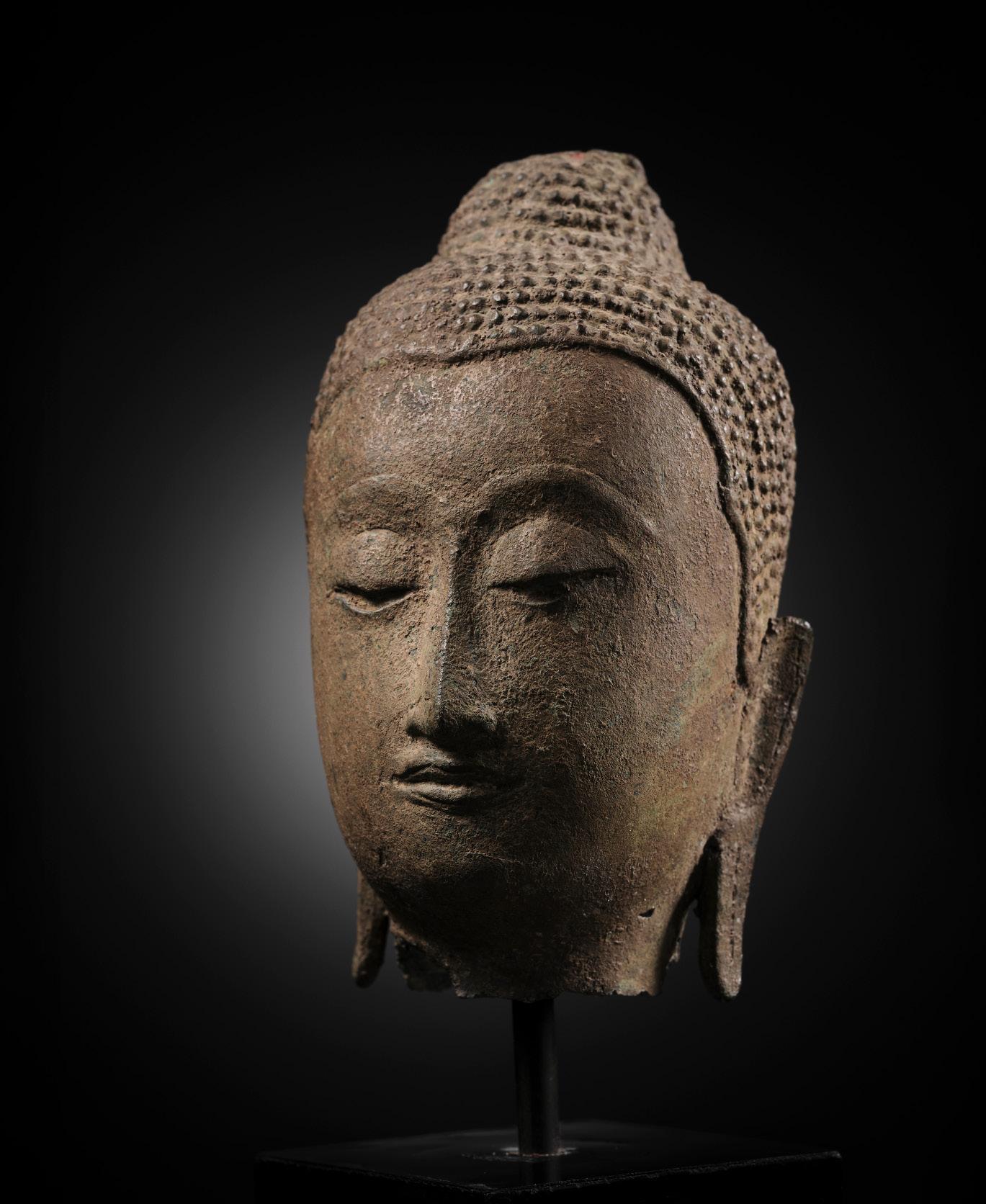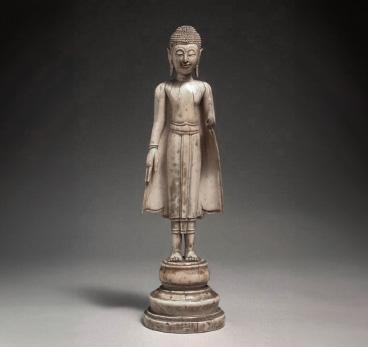STONE
CARVING OF GOPALA KRISHNA, NEPAL, 6TH-7TH CENTURY
Boldy carved, the infant crawling on all fours with one hand cradling the stolen butter ball before his puffed chest. The face meticulously detailed with a resolute expression marked by large almond-shaped eyes, furrowed brows, and full bow-shaped lips. The hair arranged in tight curls echoing the tassels hanging from the band tied around his waist, apart from which he is nude.
Provenance: From a European private collection. Condition: Excellent condition, commensurate with age. Extensive wear, predominantly from centuries of worship within the culture, signs of weathering and erosion, small nicks, chips, small old repairs.
Weight: 163 g
Dimensions: Length 10.3 cm
Krishna, hero of the Bhagavata Purana epic and deity worshipped by Vaishnava Hinduism, is depicted here in his infancy as Gopala, the impish ‘Butter Thief’, holding the butter ball he stole from his foster mother. He supports his weight on his left arm while he holds the butter ball to his chest with his right hand. His elegant cascading curls fall in a wig-like hairdo of small round curls. This figure is related stylistically to 6th-7th century
Nepalese stone sculptures that reflect classic conventions of Gupta period (320-c. 550 A.D.) sculpture in India, such as the square face, swelling chest, coiffure of small snail-shell curls, simple ornaments, and a triumphant posture of bold, heroic portrayals. This Gopala image is important as it relates stylistically to the early Kaliya and other figures and as evidence of a cult of Krishna existing in Nepal as early as the 7th century, because although it is known that Krishna was worshiped from the 5th century in India, he is represented profusely in Nepalese sculpture and painting from the 15th century onwards.
LITERATURE COMPARISON
Compare a closely related Nepalese stone figure of the infant Krishna, 8.4 cm long, dated 6th-7th century, in the Brooklyn Museum, accession number 77.203.
Estimate EUR 8,000
Starting price EUR 4,000
10
A BRONZE FIGURE OF LOKANATHA AVALOKITESHVARA, PALA PERIOD
Northeastern India, 11th century. The Savior of the Universe gracefully seated in lalitasana on a double lotus base with the right foot pendant and supported on a lotus pad. The deity’s left hand holding a lotus stem coming to full bloom at the shoulder, a similar second blossom issuing from the base, his right hand lowered in varada mudra. Superbly cast with a slender waist lending a gentle sway to the overall figure. Adorned with jewelry and wearing a sheer dhoti, his hair fashioned in a tall chignon centered by a diminutive image of the Buddha Amitabha, all flanked by foliate motifs.
Provenance: From a private collection in Chicago, United States. An old collector’s label to the underside, ‘617’.
Condition: Good condition with old wear, predominantly from centuries of worship within the culture. Some casting flaws including fine fissures around the waist. Rubbing, small dents, tiny nicks, few minor losses. Some warping to the base. Remnants of ritual pigment. The bronze with a rich, smooth, naturally grown, coppery patina.
Weight: 500 g
Dimensions: Height 13.2 cm
Expert’s note: Despite extensive wear and rubbing to this bronze, revealing a rich coppery patina from centuries of adulation, the figure can be identified as Lokanatha Avalokiteshvara, known in English as “Savior of the World”. This form was particularly popular during the early Pala period in Northeastern India. He is one of three principal deities of Mahayana Buddhism, along with Shakyamuni, who represents the present, and Maitreya, the future Buddha. Lokanatha displays some distinctly Shaivite features, namely a high chignon and a sensuous, supple body. By the eleventh century, however, one can clearly see the fusion of Brahmanical and Buddhist iconography that appears in this region, particularly the shakta influence of jata in Buddhist images. Here, an effigy of Amitabha sitting at the base of the jata identifies him as unequivocally Buddhist.
AUCTION RESULT COMPARISON
Type: Closely related
Auction: Christie’s New York, 21 March 2018, lot 3001
Price: USD 30,000 or approx. EUR 35,500 converted and adjusted for inflation at the time of writing
Description: A gilt bronze figure of Lokanatha Avalokiteshvara, Northeast India, Pala period, 11th century
Expert remark: Note the strong wear, with features similarly rubbed away from centuries of worship as exhibited by the present lot.
Compare also the closely related subject, modeling, and manner of casting, and the size (9 cm). Note the remnants of gilt.
Estimate EUR 4,000
Starting price EUR 2,000
AN EARLY CAST IRON FIGURE OF TARA, NEPAL, 7TH-8TH CENTURY
Heavily cast, standing in tribhanga atop a tiered rectangular plinth with her right hand raised in abhaya mudra, her pendent left arm resting against her voluminously curved hip, her body sensuously modeled further with a slim waist and voluptuous breasts.
Richly adorned with beaded jewelry, wearing a diaphanous dhoti with flaring hem, secured with a broad sash at the waist, and a billowing scarf. Her serene face with almond-shaped eyes and full lips, and the hair arranged in an elaborate chignon behind the foliate paneled tiara.
Provenance: From an old private collection in southern Germany, according to the previous owners acquired in Asia during the 1960s, and thence by descent.
Condition: Good condition, commensurate with age. Wear, casting irregularities, obvious losses, abrasions, signs of weathering and erosion, encrustations, corrosion, remnants of pigment, old varnish residues. Rich, naturally grown, dark patina.
Weight: 2,943.9 g
Dimensions: Height 31.6 cm
Literature comparison: Compare a closely related gilt-bronze figure of Devi, Nepal, 7th-8th century, 15.5 cm high, in the Cleveland Museum of Art, and illustrated in Ulrich von Schroeder, Indo-Tibetan Bronzes, Hong Kong 1981, 75G.
AUCTION
RESULT
COMPARISON
Type: Closely related
Auction: Christie’s New York, 17 September 1998, lot 39
Price: USD 244,500 or approx. EUR 423,000 converted and adjusted for inflation at the time of writing
Description: An early and rare bronze figure of Tara, Nepal, 7th-8th century
Expert remark: Compare the closely related subject and modeling with similar pose, garments, and expression. Note the size (34.5 cm) and that this figure is illustrated in Ulrich von Schroeder, Indo-Tibetan Bronzes, Hong Kong 1981, 75E.
Estimate EUR 6,000
Starting price EUR 3,000
12
A BRONZE FIGURE OF AKSHOBHYA, WESTERN TIBET, 13TH-14TH CENTURY
Published: Ursula Toyka-Fuong, Ikonographie und Symbolik des Tibetischen Buddhismus: Die Kultplastiken der Sammlung Ernst Senner, Wiesbaden, 1987, p. 64-65, no. C 25.
Finely cast, seated in dhyanasana on a double lotus base, his right hand lowered in bhumisparsha mudra and his left resting in his lap. He is clad in a diaphanous dhoti with neatly incised hems, a billowing scarf wrapped around his arms and forming a semi-circle behind him, and richly adorned with beaded jewelry. His serene face with almondshaped eyes, a broad nose, and full lips forming a benevolent smile, his hair arranged in a tall chignon surmounted by the three jewels behind a five-paneled foliate tiara.
Provenance: From the private collection of Dr. Ernst Senner, acquired between 1950 and 1987, thence by descent. The base inscribed with an old inventory number, ‘BT101’.
Condition: Very good condition with expected old wear and casting irregularities, small nicks, light scratches, minor dents and losses. The bronze with a fine, naturally grown, dark patina. The base sealed.
Weight: 479.9 g
Dimensions: Height 15.4 cm
Bhumisparsha mudra (the ‘earth witness’ gesture) is reserved for images of Buddha Shakyamuni and the Dhyani Buddha, Akshobhya. As Shakyamuni is traditionally depicted as an unadorned ascetic, the presence of the crown on this figure identifies him as Akshobhya.
Literature comparison: Compare a related Tibetan brass figure of Akshobhya, dated to the 14th century, 45 cm high, in the British Museum, registration number 1984,0126.1.a.
AUCTION RESULT COMPARISON
Type: Closely related
Auction: Bonhams Paris, 14 June 2022, lot 35
Price: EUR 17,850 or approx. EUR 19,000 adjusted for inflation at the time of writing
Description: A copper alloy figure of Vajrasattva, West Tibet, 13th/14th century Expert remark: Compare the closely related modeling and manner of casting with similar expression, scarf framing the figure cast with supporting rods, and lotus base. Note the size (23.2 cm).
Estimate EUR 4,000
Starting price EUR 2,000
A GILT-BRONZE FIGURE OF MANJUSHRI, DEDICATED TO SONAM GYALTSEN, 15TH CENTURY
Central Tibet, circa 1430-1440. Superbly cast, seated in dhyanasana atop a double lotus base with beaded edges, holding aloft a flaming sword in his raised right hand, his left forming the surya mudra and holding a lily stem coming to full bloom at his shoulder and supporting a sutra.
Condition: Very good condition with expected old wear. Minimal casting flaws, few minuscule nicks, some rubbing and minor losses to the gilt, some inlays lost and others possibly replaced. Traces of red and blue pigment. The base resealed.
Provenance:
-An old private collection in Austria, acquired in 1980.
-A Hungarian private collection, acquired from the above in 2000.
-Nagel Auctions, 23 June 2021, lot 87, dated 15th century and attributed to Sonam Gyaltsen, sold for EUR 34,850 or EUR 43,500 adjusted for inflation at the time of writing.
-Jules Speelman, London, United Kingdom, acquired from the above.
A copy of a provenance letter, signed by Jules Speelman, confirming that the present lot is dedicated “to Sonam Gyaltsen” and originates from the Jules Speelman private collection, accompanies this lot.
Jules Speelman is a world-leading dealer and collector of East Asian art with 60 years of experience. In 1964 he joined his late father, Alfred, in the family business which already stretched back three generations to 19th century Holland and expanded into England around the turn of the century. Originally, A & J Speelman dealt with antiques, from European ceramics, silver, tapestries, and furniture to Chinese porcelain, and works of art. With his father, Jules gradually shifted the focus towards Asia and under Jules Speelman’s skilled direction, A & J Speelman is now considered amongst the foremost dealers in Asian antiques, with a particular emphasis on figurative sculpture and works of art from the past 2000 years.


Manjushri is clad in a voluminous dhoti neatly incised with flowerheads and elegantly falling in pleats below his feet, the hems decorated with dotted lines, and the body richly adorned with beaded jewelry inlaid with turquoises. The serene face with sinuously lidded eyes, elegantly arched brows, raised urna, and bow-shaped lips forming a benevolent smile. The hair arranged in a high chignon behind the foliate tiara.
Weight: 432.3 g
Dimensions: Height 12.9 cm
Jules Speelman
fig. 1
fig. 2
Many stylistic details of the present work (fig. 1) compare with a One-Thousand-Armed Avalokiteshvara sculpture showing a dedicatory inscription naming Sonam Gyaltsen, sold at Bonhams New York, 19March 2018, lot 3033 (fig. 2).
EXPERT’S NOTE
Created during a period of refinement in Tibetan art history, this gilt bronze sculpture of Manjushri bears the hallmarks of a recently identified master sculptor, Sonam Gyaltsen. Gyaltsen was patronized around 1430 by the Sakya school and the Rinpungpa dynasty centered in Shigatse.
Several master sculptors are believed to have worked in Gyaltsen’s atelier and circle, with some of the most prominent works from this group being regarded as dedications to the master himself.
It remains unclear, however, to what extent Gyaltsen participated in the creation and execution of these rare works. Generally speaking, at that time, almost every significant culture in the world had its masters who successfully ran an atelier, a circle, or a school. Today, whenever works from these masters appear on the market, scholars are engaged in interpreting to what extent and by whom exactly the piece may have been made. The most prominent example of such a scholarly discussion is the “Salvator Mundi,” the famous world-record work by Leonardo da Vinci (and his atelier).
Many stylistic details of the present work compare with a One-ThousandArmed Avalokiteshvara sculpture showing a dedicatory inscription naming Sonam Gyaltsen, sold at Bonhams New York, 19 March 2018, lot 3033. The physique is lithe, the face has a quiet benevolence, and the crown rests above a similar prominent fringe of curls. The shape and execution of Manjushri’s regalia are characteristic of Sonam Gyaltsen’s work, consisting of five-lobed, pointed leaves inset with turquoise repeating throughout his crown and armbands. Furthermore, the treatment of the lotus base, with plump petals terminating in curlicue tips at the front and simplified flattened petals at the back, is consistent with the inscribed Avalokiteshvara. The fluid modeling of Manjushri’s dhoti, with dressy folds naturalistically draped across the base, similarly attest to a master’s hand. Compare the dhoti’s decorative scheme, with clover-like flowers sparsely incised over his legs, with a gilt-bronze Amitayus attributed to Sonam Gyaltsen at Bonhams, Hong Kong, 2 October 2018, lot 44 (see auction result comparison to the right).
AUCTION RESULT COMPARISON
Type: Closely related
Auction: Bonhams Hong Kong, 2 October 2018, lot 44
Price: HKD 2,500,000 or approx. EUR 329,000 converted and adjusted for inflation at the time of writing
Description: A gilt copper alloy figure of Amitayus, attributed to Sonam Gyaltsen (a.15th century), central Tibet, circa 14301440
Expert remark: Compare the closely related manner of modeling, casting, and gilding, as well as the expression, the fringe of curls beneath the foliate crown, the incised floral decoration to the pleated dhoti, and the lotus base. Note the size (21 cm).
Estimate
Compare the dhoti’s decorative scheme, with clover-like flowers sparsely incised over his legs, as well as the the treatment of the lotus base
A COPPER AND SILVER-INLAID BRONZE OF VAJRAPANI, TIBET, 15TH-16TH CENTURY
Well cast, standing in alidhasana holding in his right hand a kapala and in his left a vajra. His face is skillfully modeled with a wrathful expression, neatly inlaid with bulging copper eyes and sharp silver fangs, and well-detailed with finely incised brows, mustache, and beard. He is wearing a short dhoti of animal skin secured to his waist by a naga belt, richly adorned with beaded and snake-form jewelry, his skull tiara centered by a lotus emblem and flanked by ribbons secured by circular floral ornaments. His neatly incised hair is pulled up into a high chignon encircled by snakes.
Provenance: The private collection of Jules Speelman, London, United Kingdom. Jules Speelman is a world-leading dealer and collector of East Asian art with 60 years of experience. A & J Speelman is considered amongst the foremost dealers in Asian antiques, with a particular emphasis on figurative sculpture and works of art from the past 2000 years.
Condition: Very good condition with expected old wear, mostly from extended worship within the culture, some casting irregularities, small nicks, remnants of pigment, minor encrustations. The bronze has a fine, naturally grown, dark patina. Note that the brows and beard may have once been parcelgilt, see the auction result to the right for comparison.
Weight: 752.2 g
Dimensions: Height 20.4 cm (incl. base) 17 cm (excl. base)
Mounted on a modern wood base. (2)
AUCTION RESULT COMPARISON
Type: Related
Auction: Christie’s New York, 15 September 2015, lot 26
Price: USD 137,000 or approx. EUR 170,000 converted and adjusted for inflation at the time of writing
Description: A rare parcel gilt, silver- and copper-inlaid figure of Mahakala Chaturbhuja, Tibet, 16th century
Expert remark: Compare the related modeling, manner of casting, and decoration with a similar face and inlays. Note the parcel gilding, the base, and the smaller size (16 cm).
Estimate EUR 8,000
Starting price EUR 4,000
Jules Speelman
A RARE GILT-BRONZE FIGURE OF BUDDHA MAITREYA, TIBET, 16TH CENTURY
Expert’s Note: Maitreya, in Buddhist tradition, is revered both as a bodhisattva and the future Buddha, destined to succeed the historical Buddha after descending from the Tushita Heaven. Traditionally, Maitreya was depicted in royal regalia, adorned with a crown and regal robes, reflecting his status as a bodhisattva. However, during the revival of the Maitreya cult in the 7th century, his portrayal shifted to that of the future Buddha, where he is depicted in monastic robes, symbolizing his impending role as a spiritual leader. Due to this shift, far fewer depictions of Maitreya as the Future Buddha exist, making the present lot an exceptionally rare example of this significant manifestation
Finely cast, the figure is seated in bhadrasana on a lotus-petal seat atop a stepped throne with beaded edges, supported by four ruyishaped feet. His hands are held in dharmachakra mudra, and he is clad in thick patchwork robes draped over both shoulders. The face features heavy-lidded, downcast eyes, elegant brows, a raised urna, and slender bow-shaped lips forming a calm smile, framed by elongated pierced earlobes. His hair is arranged in tight curls over the high ushnisha, topped by a jewel. The throne and lower robe are intricately incised with floral motifs.
Provenance: From an English private collection.
Condition: Good condition with some wear, minor casting irregularities, slight warping to the base, small nicks, remnants of pigment, the right hand slightly loose, the neck with a small fatigue crack to the back, remnants of varnish. The base sealed.
Weight: 1,889 g
Dimensions: Height 22.5 cm
In the major monasteries of Tibet, such as Tashilhunpo or the Jo-khang at Lhasa, the largest and most central image is of Maitreya in bodhisattva form, seated on a lion throne with a lotus foot rest and his hands in dharmachakra mudra. While the present work is rare in that Maitreya is in his Buddha form, there is nonetheless a close affinity with these large, monumental images.
LITERATURE COMPARISON
Compare an earlier gilt and painted bronze figure of Buddha Maitreya, 16 cm high, dated 12th13th century, in the Khra’brug Monastery, Yar Lung valley, Tibet, illustrated by Ulrich von Schroeder, Buddhist Sculptures in Tibet, Vol. 2, 2001, p. 1146, pl. 300A. Compare an earlier gilt and painted bronze figure of Buddha Maitreya, 18 cm high, dated 7th/8th century, in the Potala Palace, Lhasa, illustrated ibid., p. 1232, pl. 341A.
AUCTION RESULT COMPARISON
Type: Closely related
Auction: Christie’s New York, 19 March 2014, lot 1017
Price: USD 317,000 or approx. EUR 385,000 converted and adjusted for inflation at the time of writing
Description: A large gilt bronze figure of Buddha Maitreya, Tibet, circa 16th century
Expert remark: Compare the closely related subject, modeling, manner of casting, and gilding. Note the similar yet more extensive warping to the base, as well as the different size (45 cm).
Estimate EUR 20,000
Starting price EUR 10,000
A
RARE COPPER REPOUSSÉ PLAQUE OF VARAHI,
16TH CENTURY
Nepal. The four-armed goddess seated in dhyanasana on her vahana, a bull, above a beaded lotus base, holding a cup in her primary right hand and the primary left hand in vitarka mudra, the other two hands holding a snake and a fish. Her face surmounted by a tiara and backed by a flaming aureole. All within a flaming mandorla.
Provenance: From a private collection in Germany. Two old inventory labels to the back of the plaque and base, ‘958’.
Condition: Good condition with old wear, signs of worship, remnants of old pigment and gilt, manufacturing irregularities, small dents and tiny losses to edges, minute nicks, light scratches.
Weight: 503.4 g (incl. base)
Dimensions: Height 24.9 cm (incl. base) 21.5 cm (excl. base)
Mounted to a modern wood stand. (2)
Varahi, also known as Barahi in Nepal, is one of the seven mother goddesses in Hinduism. She is depicted with the body of a woman and the head of a sow. The accoutrements in three of her four hands reference the tantric Hindu practices of drinking revolting liquids from a bowl made from a skull. The fish implies the consumption of illicit food, and the snake
pertains to the noose that keeps one bound in fear and leads to inevitable death. In tantric Hindu rituals, Varahi would aid the practitioners in overcoming the fears that keep them attached to ordinary life in this world.
Literature comparison: Compare a related gilt-bronze repoussé plaque of Ganesha, Nepal, 16th-17th century, in the Art Institute of Chicago, reference number 2008.701.
AUCTION RESULT COMPARISON
Type: Related
Auction: Christie’s New York, 20 September 2000, lot 141
Price: USD 5,875 or approx. EUR 9,700 converted and adjusted for inflation at the time of writing
Description: A copper repouse [sic] plaque of Ganesha, Nepal, 16th century
Expert remark: Compare the closely related modeling and repoussé work, as well as the similar wear, patina, and remnants of gilt and pigment. Note the different subject and size (43 cm).
Estimate EUR 2,000
Starting price EUR 1,000
A RARE TIBETAN GILT-BRONZE FRAGMENT WITH EIGHT HEADS OF AVALOKITESHVARA SAHASRABHUJA EKADASAMUKHA, 16TH CENTURY
Central Tibet. Finely cast as the top eight heads of the eleven headed Avalokiteshvara, with two rows of three heads each with serenely smiling expressions framed by floral earrings and blue curled locks peeking out from a foliate crown, surmounted by the wrathful face of Mahakala with bulging eyes below thick bushy eyebrows and red flaming hair topped by a small head of Buddha Amitabha.
Provenance: E & J Frankel, New York, 1989. Collection of Richard Roland, New York, acquired from the above and thence by descent. The base of the stand with a label printed ‘February 2006’ and inscribed, ‘Tibet, 22 cm, 8 heads of Avalokiteshvara, part of large 9 headed Avalokites. figure partly gilded & painted’. A copy of a signed receipt from E & J Frankel Ltd., dated 23 June 1989, addressed to Richard Roland and describing the present lot as ‘Bronze 11 headed Guanyin’, accompanies this lot. E & J Frankel was a major New York gallery specializing in Asian Art since 1967. Run by Edith (1939-2012) and Joel Frankel (1937-2018), it was one of the oldest galleries in the United States focusing exclusively on Asian art. Leaders in their field, the Frankels traveled the world in search of Asian art treasures and educated the general public about their shared passion. Their gallery on Madison Avenue in New York City became a local institution, best known for its regular schedule of innovative thematic exhibitions, and frequently visited by the biggest names in the field, such as Eskenazi, Ellsworth, Junkunc, and the Alsdorfs. Condition: Expected old wear, the tiaras bent, the inlays lost, flaking to gilt, losses to pigments, nicks, scratches, minor losses, casting flaws.
Weight: 1,3 kg (excl. stand), 1.9 kg (incl. stand)
Dimensions: Height 22 cm (excl. stand), 27.6 cm (incl. stand)
Mounted to a modern metal stand. (2)
The sculpture depicts Avalokiteshvara Sahasrabhuja Ekadasamukha, the All Seeing, All Sided Lord with One Thousand Hands and Eleven Faces, who looks in every direction to save all creatures. Since the first Dharma King of the Yarlung Dynasty, Songtsen Gampo (604-50), Avalokiteshvara has been the primary tutelary deity of Tibet, incarnating spiritual and political rule. Here he appears in his supreme cosmic form expressing his infinite capacity with a multitude of heads. Despite the popularity and central status of Avalokitesvara, very few examples in the form of Sahasrabhujalokeshvara Ekadasamukha are extant.
LITERATURE COMPARISON
Compare a closely related gilt copper alloy figure of the eleven headed Avalokiteshvara, central Tibet, dated to the 16th century, in the Los Angeles County Museum of Art, accession number M.86.220.2.
Estimate EUR 2,000
Starting price EUR 1,000
18
A GILT-BRONZE FIGURE OF VISHNU AND GARUDA, NEPAL 16TH-17TH CENTURY
Finely cast in three parts, the four-armed Vishnu is seated in dhyanasana atop a double lotus pedestal, supported by Garuda with outstretched wings and arms. Vishnu holds the wheel of dharma, a conch, a mace, and a lotus blossom in his four hands. He is clad in a diaphanous dhoti that pools gracefully below his feet, complemented by a billowing shawl, and is richly adorned with elaborate jewelry. His serene face features almond-shaped eyes, a circular urna, and full lips forming a calm smile. His hair is arranged in a high chignon, elegantly framed by a five-paneled tiara.
Separately cast and attached to the front of the lotus pedestal, Garuda wears an elaborate feathered headdress, his wings outspread in flight, his three-clawed talons each clutching the head of a naga.
Provenance: Philip Goldman Collection, London, United Kingdom, and thence by descent. In 1960, Philip Goldman (1922-2012) and his wife Rosalind opened a small gallery in London, specializing in art from Africa, Melanesia, and East Asia. While working for an American company after retiring from the RAF, Philip collected art directly from local tribes during his business trips to New Guinea, Borneo, and Nigeria. A lifelong member of the Royal Anthropological Institute, he continued to collect and sell art privately even in retirement, always expanding his horizons.
Philip Goldman (1922-2012)
Condition: Good condition with extensive wear predominantly from centuries of worship within the culture. Casting irregularities, rubbing and losses to gilt, minor nicks, light scratches, small dents, minor losses. Small scattered areas of verdigris. The base is unsealed. Remnants of red pigment.
Weight: 2,387 g Dimensions: Height 22.7 cm
AUCTION RESULT COMPARISON
Type: Related
Auction: Sotheby’s Paris, 9 December 2021, lot 74
Price: EUR 11,340 or approx. EUR 13,000 adjusted for inflation at the time of writing
Description: A gilt-bronze figure of Vishnu and Garuda, Nepal, 16th century Expert remark: Compare the related subject albeit with a different arrangement. Note the smaller size (19 cm).
Estimate EUR 4,000
Starting price EUR 2,000
A LARGE WOOD MASK DEPICTING BHAIRAVA, NEPAL, 17TH CENTURY
Published: Art of Asia, America and the Pacific, The L. & C. Von Oosterom Collection, The Hague, edition Vos, 1982, collection no. OAZ 003.
Carved in three parts to depict the fierce manifestation of Shiva, the deity with large bulging eyes beneath furled brows, the forehead centered by a third eye, the pierced mouth gently parted and revealing sharp fangs, the deity’s flaming curls are pulled away from the face and backed by a skull-and-naga tiara centered by a head of Shiva.
Provenance: The L. & C. Von Oosterom Collection, The Hague, Netherlands, acquired in 1970 and thence by descent. The back with an old collector’s label inscribed, ‘OAz 3’.
Condition: Extensive wear, obvious losses, and natural imperfections including expected age cracks. Signs of weathering, minor signs of insect activity, encrustations, remnants of pigment. Few small repairs, mainly the left ear. Some chips, few nicks, overall presenting very well.
Weight: 5.2 kg
Dimensions: Height 57 cm, Width 39 cm
Masks like the present lot were not the kind worn, but kept on display and used for special annual festivals dedicated to Indra. On the third night of the Indrajata chang, a local beer or spirit, was poured through a spout placed through the mouth of the mask for revelers who would imbibe the liquid under the auspices of receiving a divine blessing.
AUCTION RESULT COMPARISON
Type: Closely related
Auction: Bonhams New York, 19 March 2012, lot 1094
Price: USD 11,500 or approx. EUR 15,000 converted and adjusted for inflation at the time of writing
Description: A wood Bhairava mask, Nepal, 16th century
Expert remark: Compare the closely related subject, modeling, and manner of carving with similar decoration and rendition of the tall skull-tiara. Note the size (71.1 x 45.7 cm).
Estimate EUR 2,000
Starting price EUR 1,000
Mounted to a modern wood fitting located on the backside of the mask which functions both as a stand and as a suspension for hanging. (2)
A PARCEL-GILT SILVER REPOUSSÉ MASK OF BHAIRAVA, NEPAL, 16TH-17TH CENTURY
Finely worked, the round face with large bulging eyes incised with pupils below flame-like brows centered by the third eye, the pierced mouth agape revealing teeth and fangs, framed by a thick curly beard, and the ear suspending a snake-form earring, all below a tiara of skulls centered by a gemstone-inlaid glass bead.
Provenance: Andrew Rogers, New York, 1983. A private collection in Illinois, United States, acquired from the above and thence by descent. A copy of an invoice from Andrew Rogers, dated 5 April 1983, describing the piece as a ‘Smaller 17th c. Nepalese Bhairab [sic] mask’ and stating a purchase price for the present lot of USD 1,300 or approx. EUR 3,800 (converted and adjusted for inflation at the time of writing), accompanies this lot. The reverse and stand each with an old collector’s label. Andrew R. Rogers is an American collector of Himlayan art who has lived in Asia for the majority of his life. He is also a world-renowned authority on Himalayan furniture since the early 1970s.
Condition: Good condition with old wear, few dents, small nicks, light surface scratches, obvious losses, remnants of pigments, and encrustations. The gemstone-inlaid glass bead to the crown is a later addition.
Weight: 73.1 g (excl. base), 473.3 g (incl. base)
Dimensions: Height 10.6 cm (excl. base), 15.5 cm (incl. base)
With an associated stand. (2)
Newari masks such as the present lot were also constructed in wood and terracotta. Larger examples were never actually worn but kept on display and used during a special annual festival dedicated to Indra, the Indra Jatra. On the third night of the festival, local beer or spirits were poured through a spout placed through the mouth of the mask for revelers who would imbibe the liquid under the auspices of receiving a divine blessing.
Literature comparison: Compare a related Newari gilt bronze mask of Bhairava, dated 19th century, 16.5 cm tall, in the USC Pacific Asia Museum, accession number 1990.52.4.
Estimate EUR 3,000
Starting price EUR 1,500
A RARE PARCEL-GILT AND LACQUERED ZITAN
FIGURE OF TARA, BHUTAN, 17TH - 18TH CENTURY
Finely carved, standing in slight tribhanga on an elaborate lotus base, wearing a loose-fitting dhoti with finely carved folds, well-detailed floral hems, and a gilt-lacquered floral pattern, tied at the waist with a belt suspending pendent beads, a floral shawl draped over her shoulders.
Her serene face with almond-shaped eyes, arched brows, and slender lips forming a benevolent smile. Her neatly incised hair, secured by an ornate foliate-paneled crown, elegantly falls down her shoulders in wavy strands.
Provenance: English trade, acquired from a noted private collection.
Condition: Good condition, commensurate with age, shwoing old wear, natural imperfections, scratches, minor nicks, and obvious losses.
Expected wear and rubbing to gilt, lacquer, and ancient pigments. Good, naturally grown patina overall. The Zitan with a subtle, lustrous shine.
Weight: 1,209.5 g (incl. stand)
Dimensions: Height 36 cm (incl. stand), 29.5 cm (excl. stand)
Expert’s note: The use of precious zitan wood and the remarkably fine painting in gold and underlying lacquer work on the current sculpture are exceptional, strongly suggestive of a commission for the Qing court, possibly under the influence or inspiration of artisans trained in the Zanabazar school.
Literature comparison: Compare a related Bhutan gilt-wood figure of a bodhisattva seated and wearing similarly gilded garments,15.5 cm, dated to the 18th century, in the British Museum, accession number 1947,0414.1.
AUCTION
RESULT COMPARISON
Type: Closely related
Auction:
Christie’s Hong Kong, 6 October 2015, lot 3115
Estimate: HKD 400,000 or approx. EUR 56,500 converted and adjusted for inflation at the time of writing
Description: A rare parcel-gilt and lacquered zitan figure of Padmasambhava, early Qing dynasty, 17th century
Expert remark: Note the near-identical design of the lotus base, a hallmark of the Bhutan school.
Estimate EUR 8,000
Starting price EUR 4,000
A LARGE GILT BRONZE FIGURE OF TARA, 17TH-18TH CENTURY
Tibet or Inner Mongolia. Finely cast seated in dhyanasana on a double lotus base with beaded rim, her hands in varada and surya mudras. Clad in an elegantly flowing dhoti with folds gathering at the base and richly adorned with beaded jewelry inlaid with coral, turquoise, tourmaline, and sapphire. The face with a serene expression marked by downcast eyes, arched brows, and bow-shaped lips forming a calm smile, flanked by elongated lobes suspending loose circular earrings, both made of solid gold. The neatly incised hair pulled up into a tall chignon surmounted by a jewel, neatly inlaid with a single ‘pigeon blood’ ruby.
Provenance: From an important private estate on the US East Coast. Condition: Good condition, commensurate with age, and displaying exceptionally well. With old wear, nicks, surface scratches, few minor dents, rubbing to gilt, losses, some of the inlays lost and replaced, and expected casting flaws including a seamline along the waist.
Weight: 5.2 kg
Dimensions: Height 39.7 cm
AUCTION RESULT COMPARISON
Type: Closely related
Auction: Christie’s Hong Kong, 30 November 2020, lot 3020
Price: HKD 875,000 or approx. EUR 109,500 converted and adjusted for inflation at the time of writing
1
Expert’s note: This statue, with its upright posture, attenuated features, and ornate incised decoration, shares many stylistic characteristics with gilt-bronze Buddhist sculptures from the areas of Inner Mongolia outside the Qing capital of Beijing. The present figure is particularly rare for it being cast, rather than carried out in repoussé, it’s rather heavy weight of 5.2 kilograms confirming this. Compare with another gilt-bronze figure of Tara, attributed to Dolonnor, sold at Christie’s New York, 20 March 2019, lot 674 (fig. 1), and a third one, slightly larger in size, sold at Christie’s Hong Kong, 30 November 2020, lot 3020 (see auction result comparison). Both these figures and the present lot were cast in a few pieces and ingeniously joined along hidden seams. The three figures also share similar facial features, including deeply-arched brows, long, thin noses, and short, bow-shaped mouths. While the robes of the dhoti of the present figure and the one from Hong Kong are somewhat more naturalistic than the heavy, rhythmic folds of the New York example, all three are ornately incised along the hems.
Description: A gilt-bronze figure of green Tara, Tibet or Inner Mongolia, 17th-18th century
Expert remark: Compare the closely related subject, modeling, manner of casting, and gilding, with similar base, hand poses, jewelry, and tall chignon. Note the slightly larger size (47.6 cm) and betterpreserved gilding.
Estimate EUR 10,000
Starting price EUR 5,000
fig.
A GILT BRONZE FIGURE OF THE ELEVEN-HEADED AVALOKITESHVARA, 17TH-18TH CENTURY
Tibetan-Chinese. Finely cast, standing in samabhanga on a double lotus base, his principal hands clasped together in anjali mudra while his six other hands radiate around his body held in various mudras. Wearing a billowing shawl and flared dhoti incised with foliate patterns along the hem, richly adorned with fine beaded jewelry with a belt, necklaces, armlets, bracelets, and foliate crowns all richly inlaid with turquoise cabochons. The base is sealed and incised with a four-pronged vajra.
Provenance: From a private estate in Manhattan, New York, USA.
Condition: Excellent condition with minor wear and casting flaws, few nicks, light scratches, minor dents, rubbing to gilt, one ribbon with a small crack likely inherent to manufacture, some inlays lost and some replaced, minor touchups, remnants of ancient pigments.
Weight: 1.4 kg
Dimensions: Height 27.2 cm
The eight-armed deity has eleven heads, with the first three rows of heads (totaling nine) bearing the same serene expression. Wearing large earrings, their faces have almond-shaped eyes, sinuous brows, and bowshaped lips, topped by a wrathful deity beneath the uppermost head of Buddha Amitabha.
One prominent Buddhist story tells of Avalokiteshvara vowing never to rest until he had freed all sentient beings from samsara. Despite strenuous effort, he realizes that many unhappy beings were yet to be saved. After struggling to comprehend the needs of so many, his head split into eleven pieces. Amitabha, seeing his plight, gives him eleven heads with which to hear the cries of the suffering. Upon hearing these cries and comprehending them, Avalokiteshvara tries to reach out to all those who needed aid but found that his two arms were shattered into pieces. Once more, Amitabha comes to his aid and invests him with a thousand arms with which to aid the suffering multitudes.
AUCTION RESULT COMPARISON
Type: Closely related
Auction: Koller, Zurich, 28 November 2023, lot 122
Price: CHF 68,750 or approx. EUR 72,000 converted and adjusted for inflation at the time of writing
Description: Avalokiteshvara, Tibetan-Chinese, 17th-18th century
Expert remark: Compare the closely related subject, modeling, manner of casting, inlays, and gilding. Note the similar size (29.5 cm).
Estimate EUR 6,000
Starting price EUR 3,000
A GILT BRONZE FIGURE OF AVALOKITESHVARA, TIBET, 17TH CENTURY
Exquisitely cast, the bodhisattva stands in samabhanga, with the right hand in varada mudra and the left in vitarka mudra. Draped in long, loose-fitting layered robes with finely incised floral hems, the figure is adorned with elaborate foliate and beaded jewelry set with turquoise and other gemstones. A billowing celestial scarf wraps gracefully around the arms. The serene face, with downcast eyes, full cheeks, arched brows, and a raised urna, complements the hair arranged in a high chignon, topped by a jewel behind the paneled tiara.
Provenance: The Farrow Collection of Chinese Works of Art, and thence by descent. George F. Farrow (1916-2001), born in Greenwich, South London, was a prominent British art collector and property developer.
After World War II, he expanded a small property firm into one of Britain’s largest private landlord companies. Farrow’s deep passion for art led to the creation of the Farrow Art Collection, which featured Italian and European artworks, fine furniture, Oriental carpets, and Chinese art. Farrow meticulously cataloged his collection, driven by a lifelong fascination with Oriental rugs, a passion sparked by childhood visits to the Horniman Museum and the Victoria and Albert Museum. Although rugs were his primary interest, his first acquisition was a Chinese blue and white charger from the Kangxi period. Farrow described his love of art as “sincere and pure,” driven by passion rather than profit, reflecting his impeccable taste and broad interests in the art world.
Condition: Good condition with old wear, casting flaws, small nicks, minor dents, some of the inlays replaced, and losses. Good, naturally grown patina. The small cavity on the back is sealed.
Weight: 1,445 g (incl. base)
Dimensions: Height 32 cm (excl. base) and 37.5 cm (incl. base)
Mounted on an associated wood base. (2)
AUCTION RESULT COMPARISON
Type: Closely related Auction: Christie’s Paris, 13 June 2013, lot 285 Price: EUR 47,100 or approx. EUR 57,000 adjusted for inflation at the time of writing
Description: A gilt-bronze figure of Manjushri, Tibet, 17th century Expert remark: Compare the closely related modeling, manner of casting, and gilding with similar layered robes, billowing scarf, inlaid jewelry, and gilt-lacquered face. Note the smaller size (27 cm).
Estimate EUR 6,000
Starting price EUR 3,000
George F. Farrow (1916-2001)
A LARGE COPPER ALLOY FIGURE OF KSHITIGARBHA, QING DYNASTY, 19TH CENTURY
China. Finely cast standing in tribhanga atop a circular double-lots pedestal, his left hand pendent and holding a myrobalan fruit. Wearing a diaphanous robe secured at the waist, falling in richly detailed pleated folds, and richly adorned with ornate jewelry neatly inlaid with gemstones.
His serene face is finely painted and gilt-lacquered, with heavy-lidded eyes, arched brows, and full bow-shaped lips, his hair arranged in thin rows and pulled up into an elaborate chignon topped by a jewel behind the paneled tiara.
Provenance: From a noted private collection in New York, United States.
Condition: Very good condition with minor wear, casting irregularities, few shallow scratches, some inlays lost, rubbing to gilt and pigments.
Weight: 6.8 kg
Dimensions: Height 50 cm
Expert’s note:
The patinated dark brown bronze is common to revival workshops in China and Nepal of the 18th and 19th century. This group of sculptures most likely imitates the 11th-12th-century Nepalese form of Maitreya, who usually holds a waterpot instead of the myrobalan fruit, see for example a gilt-copper figure of Maitreya, 66 cm high, in the Metropolitan Museum of Art, accession number 1982.220.12. See also Weldon & Casey Singer, Sculptural Heritage of Tibet, London, 1999, p. 93, pl. 13.
Literature comparison: The present lot belongs to a group of near-identical figures notable for the simplistic treatment of jewelry, finely detailed braided chignon, and exaggerated tribhanga. Compare, for example, a Tibetan bronze figure of Maitreya, 50 cm high, dated before 1900, in the Wereldmuseum, Rotterdam, inventory number WM-29130.
AUCTION RESULT
COMPARISON
Type: Near identical
Auction: Bonhams Hong Kong, 2 October 2018, lot 97
Price: HKD 525,000 or approx. EUR 67,500 converted and adjusted for inflation at the time of writing
Description: A copper alloy figure of Kshitigarbha, Qing dynasty, 19th century Expert remark: Compare the identical subject, modeling, manner of casting, and size (50 cm).
Estimate EUR 30,000
Starting price EUR 15,000
A GILT-BRONZE FIGURE OF THE SIXTH PANCHEN LAMA, LOBZANG PALDEN YESHE
Tibet, second half of the 18th century. Finely cast, seated on a double cushion, holding his right hand in vitarka mudra while cradling a book in his left, wearing a Gelug cap and voluminous patchwork robes richly carved with elegant folds and delicately draped over his seat. His serene face with full lips, a narrow nose, and almond-shaped eyes with one bearing a lower eyelid that is noticeably larger than the other. The base sealed with a copper plate engraved with a double vajra.
Inscriptions: The reverse of the cushion is inscribed in Tibetan with the number ‘6’, identifying the figure as the sixth Panchen Lama, Palden Yeshe.
Provenance: A noted European private collection. Christie’s Paris, 20 June 2017, lot 120, sold for EUR 10,000 or approx. EUR 12,000 (adjusted for inflation at the time of writing). A French private collection, acquired from the above and thence by descent.
Condition: Very good condition with minor wear, casting irregularities, and few small nicks. The base has been resealed, but the copper plate is probably original.
Weight: 1,086 g
Dimensions: Height 15.1 cm
Lobzang Palden Yeshe (17381780) was the sixth Panchen Lama, but the third to hold the title. He is regarded as one of the greatest scholars and teachers in the history of Tibetan Buddhism. He was born 1738 in Tashitse, Shang district, Tsang Province. The 7th Dalai Lama Kelsang Gyatso recognized him as the reincarnation of Panchen

Lobsang Yeshe. He received his novice ordination and many religious instructions from the 7th Dalai Lama. In 1762 at Tashi Lhunpo, he declared the recognition of the 8th Dalai Lama, to whom he gave the upaseka ordination and the name Jetsun Lobzang Tenpe Wangchug Jampel Gyatso. He also officiated at the ceremonies where the 8th Dalai Lama received his novice ordination and his full ordination in Lhasa, in 1765 and in 1777 respectively. From time to time, the Dalai Lama received many special instructions on sutras and tantras from the Panchen. Following an invitation from the Manchu Emperor Qianlong he travelled to China in 1779 and gave the Emperor many teachings and instructions. The Emperor appointed him his spiritual preceptor, and showed him much respect.
AUCTION RESULT COMPARISON
Type: Related
Auction: Sotheby’s New York, 16 September 2015, lot 413
Price: USD 27,500 or approx. EUR 34,000 converted and adjusted for inflation at the time of writing
Description: A gilt-bronze figure of the great fifth Dalai Lama, Ngawang Lobsang Gyatso, Tibet, 17th/18th century
Expert remark: Compare the closely related modeling, manner of casting, and gilding with similar pose, robes, expression, and base. Note the different subject.
Estimate EUR 6,000
Starting price EUR 3,000
The Sixth Panchen Lama Receives George Bogle at Tashilhunpo, oil painting by Tilly Kettle, c. 1775
GYATSO, TIBET, 17TH-18TH CENTURY
This finely cast and incised gilt bronze figure accurately represents His Holiness the 5th Dalai Lama. Seated on a thick square cushion adorned with intricate floral designs, he holds a manuscript in his lap with his right hand resting gently atop it. The figure is dressed in a heavily pleated meditation cloak over voluminous patchwork robes, reflecting the traditional attire associated with the spiritual leader of Tibetan Buddhism. His rounded face is marked by an intense gaze, bow-shaped lips, a broad nose, and almond-shaped eyes, capturing the dignified and contemplative expression characteristic of Lobsang Gyatso.
Provenance: From a private collection in New England, United States. Condition: Very good condition with minor wear, rubbing to the gilding, casting irregularities, and small nicks. The base resealed.
Weight: 450.9 g
Dimensions: Height 9.6 cm
This gilded sculpture has the Fifth Dalai Lama’s likeness of a stout frame, short neck, and round, bald head to which is added a characteristically pursed-lipped, steadfast expression. This portrait emphasizes Lobsang Gyatso’s role as a scholar and preserver of wisdom by depicting him holding a sutra in his lap. The meditation cloak that is draped over his shoulders and across his legs has a foliated collar.
AUCTION RESULT COMPARISON
Type: Closely related
Auction: Christie’s London, 3 November 2020, lot 69
Price: GBP 18,750 or approx. EUR 29,500 converted and adjusted for inflation at the time of writing
Description: A small gilt-bronze figure of the fifth Dalai Lama, Ngawang Losang Gyatso, Tibet, 17th-18th century
Expert remark: Compare the closely related subject, modeling, manner of casting, and gilding with similar facial features. Note the size (11.2 cm).
AUCTION RESULT COMPARISON
Type: Closely related
Auction: Bonhams Hong Kong, 5 October 2020, lot 38
Price: HKD 275,625 or approx. EUR 34,000 converted and adjusted for inflation at the time of writing
Description: A gilt copper alloy figure of the fifth Dalai Lama, Ngagwang Lobzang Gyatso, Tibet, circa 1642-1682
Expert remark: Compare the closely related subject, modeling, manner of casting, gilding, and size (10 cm). Note the identifying inscription along the back of the base.
Estimate EUR 4,000
Starting price EUR 2,000
A RARE THANKGA DEPICTING DORJE DROLO, THE WRATHFUL MANIFESTATION OF PADMASAMBHAVA
Tibet, 18th century. Distemper and gold on cloth. Boldly painted striding atop a ferocious tiger in alidhasana on a lotus cushion, holding a vajra and phurba in his hands, wearing voluminous layered robes intricately decorated with floral and geometric designs, and a garland of severed heads slung around his neck. The bearded face with a grim expression marked by three bulging eyes, furrowed brows, and the mouth pursed and pressed together in a frown, the coiled hair pushed away from the face with a tiara.
Provenance: A private European Collection assembled in the 1960s and 1970s. Bonhams Paris, 10 June 2021, lot 61, in unrestored condition. A noted European private collection, acquired from the above.
Published: Himalayan Art Resources, item number 4475.
Condition: Good condition with age-appropriate wear, including minor stains, soiling, tiny holes, fading, creasing, and flaking. The painting has been professionally restored, with images of the original condition available upon request. Overall, it presents remarkably well.
Dimensions: Size 54.3 x 41.3 cm
Dorje Drolo, or the Wrathful Vajra, is a rare form of the legendary Buddhist master Padmasambhava in his aspect as the Subduer of Demons, a task he is credited with when taming the wild spirits and founding Buddhism in Tibet. Revered in Tibet as the Second Buddha, Padmasambhava is believed to have manifested as Dorje Drolo to fly to the thirteen Tiger’s Nest (Taktsang) caves where he subdued local deities, binding them by oath to protect his teachings and imprinting his hands and feet on the landscapes.
LITERATURE COMPARISON
Compare a closely related thangka depicting Dorje Drolo, dated 19th century, in the collection of the Hahn Cultural Foundation, illustrated in Art of Thangka from the Hahn Kwang-ho Collection, Vol. 2, Hwajeong Museum, Seoul, 2008, and on Himalayan Art Resources, item number 33914 (fig. 1)
Compare a related thangka of Dorje Drolo, Bhutan or Central Tibet, 18th century, in the Rubin Museum of Art, object number F1996.31.14. fig. 1
Estimate EUR 4,000
Starting price EUR 2,000
A SILK APPLIQUÉ THANGKA DEPICTING KSHETRAPALA, TIBET, 17TH-18TH CENTURY
The Protector Deity depicted howling as he rides his bear, the hands held aloft holding a vajra knife and skull cup, dressed in a dhoti secured with a festooned belt, the deity is richly adorned with jewelry and bells. The wrathful face looks upwards, detailed with bulging eyes and furrowed brows centered by a third eye and the mouth agape revealing sharp teeth and fangs, the scrolling hair dramatically forming a halo, all against a damask dragon ground.
Provenance: Stuttgart Art Market, 1990s.
A private collection, acquired from the above, and thence by descent. Christie’s New York, 13 September 2017, lot 642, estimate USD 30,000 or approx. EUR 34,500 (converted and adjusted for inflation at the time of writing).
A private collection in Belgium, acquired from the above in an after-sale transaction.
Published: Himalayan Art Resources, item no. 24342.
Condition: Excellent condition with minor wear, minuscule stains, minor bleeding of colors, minor loose threads, obvious losses.
Dimensions: Image size 240 x 132 cm, Size incl. frame 270 x 136 cm
Kshetrapala is one of five retinue figures belonging to the practices of Shadbhuja Mahakala originating with the Shangpa Kagyu Tradition of Tibetan Buddhism.
The present depiction of Kshetrapala is likely from a larger textile that may have incurred damage. The salvaged portion retains the colorful details of the deity and the damask dragon motif on the dark blue silk ground. The quality of the silk and the presence of a dragon motif indicates the textile was likely commissioned for an Imperial patron
Estimate EUR 20,000
Starting price EUR 10,000
‘MANJUSHRI
SEATED ON A LION’, QING DYNASTY, 18TH CENTURY
China. Ink, watercolors, and gouache on paper. Mounted as a hanging scroll on a paper frame with wooden handles. Finely painted with the bodhisattva seated in royal ease atop his fierce lion, his face with a serene expression and curled mustache, his long hair elegantly falling in twisted locks over his shoulders, backed by a circular halo, all in a rocky landscape under a densely clouded sky.
Provenance: Collection of Anton Exner (1882-1952), Vienna, Austria, and thence by descent.
Galerie Zacke, Vienna, 30 September 2017,

lot 111. A private collection in Vienna, Austria, acquired from the above. An old collector’s label to the handle, inscribed ‘1513/ AMM’. Anton Exner (1882-1952) was the most important dealer, collector, and assessor of East Asian art in Vienna during the interwar period. His collection included all branches of Asian art – particularly Chinese and Japanese – from all epochs. During a long sojourn in Canada and the USA from 1908 to 1910, he made contact with Chinese dealers and later acquired handicrafts and Japanese silk blouses at various Asian ports, which formed the basis for his future business activities in Vienna. From then on, he went almost every year on buying trips to the Far East. The Austrian auction house Dorotheum appointed him as a sworn assessor of Asian art, a position he held for around a quarter of a century. From the early 1920s, he lent objects for all major exhibitions of Asian art in Vienna. Condition: Fair condition with wear, minor soiling and staining, browning, small tears, minor losses, creasing and folds. Obvious small touchups and repairs here and there.
Dimensions: Image size 113 x 72 cm, Size incl. frame 181 x 81 cm
One of the three most important bodhisattvas in East Asia, Manjushri (Wenshu) is said to have originated in China from the mountains associated with Mount Wutai, a famous Buddhist monastic center. He was worshiped in China as the embodiment of knowledge and the guardian of sacred doctrines. Usually presented as a youthful, bejeweled prince, he is often shown seated on the back of a lion, and carries a book of truth and a sword that cuts through the darkness of ignorance.
LITERATURE COMPARISON
Compare a related painting of Manjushri, Qing dynasty, 17th-18th century, at Sotheby’s New York, 31 March 2005, lot 311.
Estimate EUR 2,000
Starting price EUR 1,000
Anton Exner (1882-1952)
A THANGKA OF JE TSONGKHAPA AND 18 EPISODES FROM HIS LIFE, 18TH-19TH CENTURY
Distemper and gold on cloth. Seated in dhyanasana on a lotus base, the deity’s hands holding a vajra and ghanta at the chest, clad in heavy patchwork robes and flanked by blue lotus blossoms at the shoulders supporting the sword and book, the face with a serene expression surmounted by a pointed cap and backed by a nimbus, framed by numerous scenes from Tsongkhapa’s life story with detailed identifying inscriptions.
Provenance: A private collection in Germany and thence by descent. Inscribed to the back, ‘WEIR/4B’.
Condition: Good condition with wear, creasing, minor soiling, small losses, few tears and minor fraying to edges, minor flaking to pigment. The colors are particularly fresh and crisp, the piece is thus presenting exceptionally well.
Dimensions: Image size 68.8 x 45.8 cm, Size incl. frame 72 x 51 cm
The founder of the Gelug school of Tibetan Buddhism, Je Tsongkhapa (1357-1419), appears at the center of the composition surrounded by vignettes from his life story with minuscule and neatly painted identifying inscriptions. This thangka comes from a series of 15 thangkas telling the story of Tsongkhapa’s life.
The standard set of paintings depicting the life story of Tsongkhapa, designed in the early 18th century by Jamyang Shepa (1648-1721/22), has fifteen individual compositions. Typically hung in the grand hall of monasteries, they illustrate how, throughout his previous lives, Tsongkhapa, the 15th century saint and scholar of Tibet, cultivated the Path leading to Enlightenment and how his spiritual progression was attested by prophecies of all the Buddhas of the past. When this group of fifteen thangkas is hung, the first thangka traditionally occupies the central place. For further information, see Francoise Wang, Dje Tsongkhapa, 2002.
The present thangka is the sixth in the series of fifteen, showing various places where Tsongkhapa taught, wrote, or received teachings from other masters. For more details see www.zacke.at
AUCTION RESULT COMPARISON
Type: Closely related
Auction: Bonhams London, 11 May 2017, lot 20
Price: GBP 20,000 or approx. EUR 33,500 converted and adjusted for inflation at the time of writing
Description: A thangka of Tsongkhapa, Tibet, 19th century
Expert remark: Compare the closely related subject and manner of painting with a similar rendition of surrounding vignettes from his life story with identifying inscriptions. Note the size (68 x 45 cm).
Estimate EUR 4,000
Starting price EUR 2,000
A LARGE NEWARI PAINTING OF THE COSMIC MAN, CENTRAL TIBET, 19TH CENTURY
Distemper on cloth. The yogin dressed in a rainbow-patterned dhoti with five lotus roundels depicting the chakra points of the Kundalini, each roundel enclosing a different deity and their consort. The Purusha stands on a lotus in a landscape with the guardians of the directions below, siddhas and adepts at either side, white and golden Vasudhara in the sky above. A sixth flower hovers above his head.
Provenance: From a noted private collection in Geneva, Switzerland. Condition: Good condition with wear, some creasing, few folds, flaking, minor fading to colors, loose threads, and tiny losses.
Dimensions: Image size 131.5 x 86.5 cm, Size incl. frame 134.5 x 89 cm
The five-petal basal chakra of the Muladhara contains a white fourarmed Ganesha and his female aspect, facing each other in an amorous union, followed by a six-petal lotus with a yellow nondual pair, a ten-petal lotus with a red pair, a twelve-petal lotus with a green pair, a sixteen-petal lotus at the throat contains a single nondual figure composed of a green right half (male) and a red left half (female), and the final attainment of the yogin is symbolized in the nondual coupled, contained with a rainbow light just at the top of the head.
The central figure is surrounded by a green mountainous landscape divided by stretches of water and topped by snowy peaks. Flanking the yogin on either side are the pot-bellied Hvashang, an assistant of the Buddha (right), and the Mahasiddha Milarepa (left), in the region of the sky are two manifestations of Vasudhara, each surrounded by various gods and other figures, with winged vidyadharas positioned on each side of the sixth chakra. To the lower half are the Great Adepts: (left to right) Kapalapa, Champaka, Rahula, Kuchipa, followed by the representations of the four Lokapalas: (left to right) Virupaksha, Vaishravana, Virudhaka, and Dhritarashtra, all scattered amidst scenes from the lives of the mahasiddhas.
Set inside an old gilt-lacquered frame behind glass. (2)
The present lot was painted by a Newari artist residing in Tibet and was meant for either Newars living in Lhasa or for export to the Kathmandu Valley. This is particularly evident in the rendition of the overall iconography of the fully developed yogic processes, the face of the Cosmic Purusha, the presence of Vasundhara, winged vidyadharas, and the miniature mustachioed figures on the various chakras, all of which exemplify Newari taste and a familiarity with Newari Buddhist conventions. Even the position of the deities in union in the chakras is in the Newar manner.
Newari Buddhist images of the Cosmic Purusha are relatively rare; he was more popular amongst the Hindu community in the Valley, or amongst the Jains of India. The Purusha presents the Primordial Being from whom the universe was formed. On a microcosmic scale, everyone can become part of the Purusha by following certain mental and physical exercises. Through meditation and yoga, an energy called kundalini will be awakened in one’s body, and is supposed to stream from the lowest to the highest chakra on the top of the head as shown by the body of Purusha. Each flower thus represents a step on the path to spiritual liberation. Upon reaching the highest chakra, Enlightenment is achieved.
LITERATURE COMPARISON
Compare a closely related painting of the Cosmic Purusha, Nepal, c. 1900, illustrated by Hugo E. Kreijger in Kathmandu Valley Painting, The Jucker Collection, Boston, 1999, p. 100, no. 37, sold at Sotheby’s New York, 1 January 2006, lot 45. Compare a closely related painting of the Cosmic Man with Diagrams of Newar Yogic Six Chakra Transformation, central Tibet, c. 19th century, in the Los Angeles County Museum of Art, accession number M.91.118 (fig. 1), illustrated by John C. Huntington and Dina Bangdel, The Circle of Bliss: Buddhist Meditational Art, Chicago, 2003, p. 232, no. 63. Compare a closely related painting in the John Gilmore Ford Collection, illustrated by Detlef Ingo Lauf, Secret Revelation of Tibetan Thangkas, pp. 164-165, pl. 60.
Estimate EUR 4,000
Starting price EUR 2,000
fig. 1
A WHITE MARBLE FIGURE OF A BIXIE, HAN DYNASTY
China, 206 BC-220 AD. Powerfully carved in a prowling pose, the mythical beast is depicted with an intense gaze, its bulging eyes set beneath thick, curling eyebrows. The well-pronounced snout leads to a wide-open mouth in a ferocious roar, baring its fangs. The muscular body is flanked by a pair of wings extending dramatically from the front haunches, detailed with fine incisions.
In Chinese culture, the Bixie, a mythical creature known for warding off evil spirits, holds significant cultural importance. Often seen as a guardian figure, it symbolizes strength and protection, frequently placed in tombs or temples to safeguard against malevolent forces.
Provenance: From a private collection in New York, United States. Condition: Good condition, commensurate with age. Wear, obvious losses, natural imperfections including fissures, chips, nicks, signs of weathering and erosion, encrustations. Remnants of pigment.
Dimensions: Height 42 cm (excl. stand) and 56 cm (incl. stand), Length 56.5 cm
With an associated stand. (2)
LITERATURE COMPARISON
Compare a closely related stone bixie, dated to the Eastern Han dynasty, in the Henan Provincial Museum, Zhengzhou (fig. 1). Compare a closely related stone bixie, Eastern Han dynasty, in the Luoyang Museum.
Estimate EUR 30,000
Starting price EUR 15,000
EXPERT AUTHENTICATION
A copy of an expertise written and signed by Dr. Chang Qing, notarized in the State of New York, dated 20 April 2021, and confirming the dating above, accompanies this lot.
fig. 1
Dr. Chang holds a Ph.D. in Art History from the University of Kansas and has held prestigious positions, including post-doctoral fellow at the Metropolitan Museum of Art and senior research fellow at the Freer and Sackler Galleries of the Smithsonian Institute. He has conducted extensive research in China, participating in archaeological excavations at various historical sites. Dr. Chang is the author of several influential works, including Compassionate Beings in Metal and Stone: Chinese Buddhist Sculptures from The Freer Gallery of Art (2016) and Light of the Buddha in the Desert: Essays on Mogao Grottoes in Dunhuang from 5th-14th Centuries (2012). He is currently a professor at Arts College, Sichuan University.
Dr. Chang Qing
A LIMESTONE HEAD OF BUDDHA, LATE NORTHERN WEI DYNASTY, 6TH CENTURY
China, ca. 500-534. Finely carved, the face with a serene expression, marked by heavy-lidded downcast eyes, arched brows, a slender nose, and a sharply carved mouth well detailed with bow-shaped lips and prominent philtrum, flanked by large ears with pendulous lobes. The hair arranged in tight curls over the high domed ushnisha, all backed by a foliate nimbus.
Provenance: From a private collection in New York, United States. Condition: Good condition, commensurate with age. Ancient wear, signs of weathering and erosion, encrustations, obvious losses, structural cracks, chips, nicks, scratches. Remnants of gilt and old pigments.
Weight: 5,774 g (excl. stand), 7,163 g (incl. stand)
Dimensions: Height 17.7 cm (excl. stand), 24.8 cm (incl. stand)
With an associated stand. (2)
Buddhist stone sculpture experienced one of its greatest moments in the Northern Wei period (386-534), when it was strongly patronized by the Imperial court. As the ruling family gradually adopted a more and more Chinese lifestyle, a stylistic change also took place in Buddhist sculpture during this period. Buddhist images with foreign-looking features, which had been adopted from Indian and Central Asian prototypes, when the religion was first introduced to China, gradually disappeared and were replaced by more Chinese-looking Buddha figures. One of the most enchanting styles appeared in the late Northern Wei, as represented by the present figure, when faces with fine and noble features were depicted with a faint smile, signaling enlightenment as much as benevolence. That the deities thus appeared more approachable undoubtedly helped the rapid propagation of the religion at that time.
EXPERT AUTHENTICATION
Dr. Chang Qing has authenticated this lot, noting its stylistic similarities to Northern Wei Buddha images found in Henan and Shandong provinces of Northern China. A notarized copy of Dr. Chang’s expertise, dated April 18, 2021, in the State of New York, accompanies this lot.
Dr. Chang holds a Ph.D. in Art History from the University of Kansas and has held prestigious positions, including post-doctoral fellow at the Metropolitan Museum of Art and senior research fellow at the Freer and Sackler Galleries of the Smithsonian Institute. Dr. Chang is the author of several influential works, including Compassionate Beings in Metal and Stone: Chinese Buddhist Sculptures from The Freer Gallery of Art (2016) and Light of the Buddha in the Desert: Essays on Mogao Grottoes in Dunhuang from 5th-14th Centuries (2012). He is currently a professor at Arts College, Sichuan University.
LITERATURE COMPARISON
Compare a closely related limestone head of Buddha with a similar nimbus fragment in the Shandong Provincial Museum, Jinan.
Estimate EUR 8,000
Starting price EUR 4,000
35
A
PAINTED
LIMESTONE FIGURE OF BUDDHA, NORTHERN QI DYNASTY
EXPERT
AUTHENTICATION
Dr. Chang Qing has authenticated this lot, identifying its iconographic and stylistic characteristics as typical of the Northern Qi period. A notarized copy of Dr. Chang’s expertise, dated April 21, 2021, in the State of New York, accompanies this lot.
China, 550-577. Finely sculpted, the slender figure standing in samabhanga atop a circular pedestal, dressed in layered robes that cling to the contours of the body as they fall in two rows of U-shaped folds. The face with a serene expression crisply detailed with heavy-lidded downcast eyes, and full bow-shaped lips forming a calm smile. The hair is arranged in neatly incised whorl-like curls over the domed ushnisha.
Provenance: From a private collection in New York, United States.
Condition: Excellent condition, commensurate with age. Wear, obvious losses, natural imperfections including fissures and cracks, nicks, scratches, chips, and encrustations, minor old repairs.
Dimensions: Height 78 cm (excl. stand), 98 cm (incl. stand)
With an associated stand. (2)
Stylistically, this large standing figure of Buddha is a fine representation of Buddha figures of Northern Qi date, and its dignified, upright stance combined with the simplicity of the robes that cling to the body show the strong influence of the earlier Gupta style from Sarnath, India. The small mouth and thin nose, the large, elongated ears with flat, unpierced lobes, and the whorl-like curls are also all characteristic of the Northern Qi style.
The Northern Qi style is an indirect interpretation of the Indian Gupta style, particularly the Sarnath school, transmitted to China via the Central Asian trade routes. The adoption of the foreign style reflects the socio-political changes that occurred at the beginning of the Northern Qi period, when its rulers looked to non-Han stylistic traditions. This was in marked contrast to the Northern Wei rulers, who sought to acculturate themselves within the Han polity through a process of Sinicization.
LITERATURE COMPARISON
Compare a closely related limestone figure of Buddha with similar garment folds, dated to the Northern Qi dynasty, in the Shangdong Provincial Museum and exhibited by the Peranakan Museum, Singapore, Serenity in Stone: The Qingzhou Discovery, 16 January-26 April 2009 (fig. 1). Compare a closely related limestone figure of Buddha with similar garment folds, dated to the Northern Qi dynasty, in the Qingzhou Museum, Shandong Province.
Estimate EUR 15,000
Starting price EUR 7,500
fig. 1
A WHITE MARBLE
FIGURE OF MAITREYA, NORTHERN QI DYNASTY
China, 550-577. The Buddha of the Future seated on a lotus throne supported on a large base carved to the front with a mythical beast and a censer. The body draped in loose robes falling elegantly over the throne and adorned with fine jewelry. His right leg crossed over the left knee with the left hand resting on his foot, leaning forward with downcast eyes, the hair tied behind a tall headdress backed by a mandorla centered by a blossom.
Provenance: Italian trade. Acquired from an important private estate. A label inscribed with an inventory number ‘23’ to the side of the base.
Condition: Good condition, commensurate with age. Extensive wear, losses, nicks, natural fissures and structural cracks, chips, scratches, signs of weathering and erosion, encrustations, old repairs and corresponding touchups.
Weight: 15.2 kg
Dimensions: Height 45.6 cm
Buddhism flourished during the Northern Qi dynasty, which saw a great increase in the production of statues and a proliferation of styles. The Qi aristocracy, headed by a military class of nomadic origin, was not only hostile to Chinese influence, but it also had a predilection for the foreign and exotic, especially in art. Hence, a style influenced by the Gupta art of India acquired pre-eminence soon after the Northern Qi dynasty came to power. Northern Qi figures are generally clad in thin, clinging robes, with an emphasis on portraying the solidity of the body rather than decorative drapery, which was characteristic of figures during the preceding Wei dynasty. This emphasis on the body went hand in hand with increased three-dimensionality. Thus, while Wei dynasty Buddhist figures form a relief with their body nimbuses, Northern Qi sculptures often stand free of their backgrounds.
LITERATURE
COMPARISON
Compare a related marble figure of Maitreya in a pensive pose, dated to the Northern Qi dynasty, in the Freer Gallery of the National Museum of Asian Art, Smithsonian Institute, accession number F1911.411.
AUCTION RESULT
COMPARISON
Type: Closely related Auction: Christie’s New York, 24 September 2021, lot 713
Estimate: USD 250,000 or approx. EUR 264,000 converted and adjusted for inflation at the time of writing
Description: A very rare marble figure of a seated pensive bodhisattva, Northern Qi dynasty, dated by inscription to 553 Expert remark: Compare the related subject, material, manner of carving, and size (46.8 cm).
Estimate EUR 6,000
Starting price EUR 3,000
37
A LIMESTONE FIGURE OF A BODHISATTVA, NORTHERN QI DYNASTY
China, 550-577. Crisply carved with a serene face, the eyes half open in contemplation, a scalloped hairline topped by a floral headdress and secured by a band tied in a knot to either side, clad in a long robe knotted at the front and covering the shoulders, adorned with a beaded garland connected at the waist by a floral ornament, the garment falling in pleated folds above the bare feet standing on a circular base.
Provenance: The private collection of a Hong Kong gentleman who acquired the present lot around 1990 in the local trade and later moved to Canada. Thence by descent. A private collection in Canada, acquired from the above in 2008.
Condition: Good condition, commensurate with age. Extensive wear, signs of weathering and erosion, nicks, scratches, losses, remnants of pigments, few old repairs.
Weight: 34.1 kg
Dimensions: Height ca. 99 cm
The present figure displays several stylistic features typical of the Northern Chinese sculptural tradition dating to the second half of the sixth century, where emphasis was placed towards the volume of the body, evident here in the stocky upper body and the convexity of the stomach, and the folds of the robe, gently cascading towards the bottom of the body.
The Northern Qi dynasty was one of the most vibrant periods in the history of Chinese art, especially in the context of Buddhist art, which experienced a glorious moment following the contamination of foreign ideas and styles.
The elaborate strings of jewels depicted on the chest, consisting of lengths of pearls separated by coral twigs, can be traced to the Central Asian and Indian ornaments worn by Indian noblemen and can be found on Gandharan sculptures. See Kurita Isao, The World of the Buddha. Ghandara Art, Tokyo, 1990, vol. 2, p. 177, fig. 13.
Expert note: The present sculpture exhibits pronounced stylolites above the surface, indicative of a moist burial where minerals have migrated through the veins to the surface. A limestone head of a Bodhisattva from the Liao Dynasty shows the same veining: See Christie’s, New York, 23 September 2022, lot 838.
LITERATURE COMPARISON
Compare a closely related limestone figure of a bodhisattva, dated to the Northern Qi dynasty, 102.9 cm tall, in the Metropolitan Museum of Art, accession number 56.209 (fig. 1). Compare a related marble figure of a bodhisattva, dated to the Northern Qi dynasty, 61.5 cm tall, in the Museum of Fine Arts, Boston, accession number 50.2264.
AUCTION RESULT COMPARISON
Type: Closely related
Auction: Bonham’s, London, 7 November 2019, lot 38
Estimate: GBP 40,000 or approx. EUR 63,000 converted and adjusted for inflation at the time of writing
Description: A rare carved limestone figure of bodhisattva, Northern Qi dynasty
Expert remark: Compare the closely related modeling and manner of carving with similar robes, jewelry, and crown. Note the size (71 cm).
Estimate EUR 8,000
Starting price EUR 4,000
fig. 1
38 AN IMPORTANT AND RARE WHITE MARBLE TORSO OF BUDDHA MAITREYA, TANG DYNASTY, CIRCA 690 -700 AD
Expert’s note: Perhaps the most striking feature of this magnificent marble statue is its realistic portrayal of a seated figure beneath drapery. The remains of his thick neck and developed pectoral muscles are visible above an inner garment that crosses from his left shoulder to the right, secured by a knotted sash. The voluminous outer garment falls in uneven pleats and folds, suggesting the natural effects of gravity as it drapes over the arms, legs, and the front edge of the seat. Even the loop of the knotted belt falls naturally over the outer garment’s upper edge.
China, late 7th to early 8th century, circa 690-700 AD. Powerfully carved, seated in ‘European style’ on a square plinth, his left hand resting on his thigh, wearing voluminous robes elegantly draped over his wide shoulders and broad muscular chest, cascading in deep folds over his pendent legs, falling to the sides of his seat and continuing down his back, the low collar running behind the neck.
Dimensions: Height 66 cm (the marble figure) and 170 cm (incl. stand)
With a fitted metal stand, built around 20 years ago. (2)
& Antoine Barrère

Provenance: An old private collection in Europe. Jacques Barrère, Paris, France, acquired from the above by 2005. De Poortere Collection, Belgium, acquired from the above and thence by descent. A noted collector in the Netherlands, acquired from the above via the local trade. A copy of an expertise written and signed by Jacques Barrère, dated 30 January 2005, confirming the dating above, accompanies this lot In this expertise, the statue is described as “Calcaire” (limestone), which is not incorrect, because limestone is the parent rock of marble, forming through metamorphism under high pressure and temperature conditions. The Jacques Barrère Gallery is located in the heart of Paris, in the Saint-Germain-des-Prés district. Since 1969, it has held exhibitions to promote and preserve Far-Eastern art. The gallery specializes in Chinese sculpture, archaeology, ceramics and decorative arts, as well as Japanese works of art and porcelain. Statuary art from Gandhara, India or South-East Asia is also regularly displayed. Objects once owned by Barrère are now in major museums around the world, including the Guimet, the Cernuschi, and the Shanghai Museum. The Barrère gallery is a regular exhibitor at TEFAF in Maastricht.
Condition: Very good condition, commensurate with age. Expected old wear, signs of weathering and erosion, encrustations, remnants of ancient pigment, small nicks, chips, and obvious losses. The surface with a silky appearance overall, a natural patina, and presenting exceptionally well.
Maitreya, in Buddhist tradition, is both a bodhisattva and the future successor of the historical Buddha once he descends from the Tushita Heaven. As a bodhisattva, he was typically depicted in royal regalia, wearing a crown and regal robes. But during the revival of the cult of Maitreya in the 7th century, he began to be depicted as the future successor of Buddha, wearing monastic robes.
The present lot depicts the Maitreya of the future as the one and only successor of Buddha. This messianic rendition began being depicted during the Six Dynasties on into the Tang dynasty. Maitreya sits with his legs straight rather than folded, which distinguishes him from Shakyamuni, Amitabha, and Vairocana.
A most impressive example for the interest in the cult of Maitreya during the Tang dynasty is the huge seated figure of the Future Buddha Maitreya in cave 565 at Longmen, commissioned by the eminent abbot Huijian. The dedicatory inscription dated 673 places its construction during the reign of the emperor Gaozong (650-683) and his wife Wu Zetian (684-704), who usurped the throne as Emperor of the second Zhou dynasty and proclaimed herself as an incarnation of the future Buddha Maitreya in 690. Professor Angela Howard identifies an idealized realism in the full chest and strong limbs discernible beneath the incised robes of this Maitreya (see A. Howard, Wu Hong, Li Song, and Yang Hong, Chinese Sculpture, 2006, Yale University, pp. 298, 301, fig. 3.108). This realism is also evident in the full chest of the present lot, thus enabling a dating to circa 690-700 AD

The present lot compares favorably with carvings found in the Tianlongshan caves, located near Taiyuan in Shansi. In her 1975 article, Professor Marilyn Rhie suggested that work on Cave XXI could have started as early as 703 and continued through the reign of the Emperor Xuanzong (713-756; Archives of Asian Art, vol. 28, 1975, p. 6-33). Professor Howard aptly described their striking realism: ‘The art of Tianlongshan is more secular than that of any other Tang site of the early eight century, to the extent that the holiness of the image is undermined’ (see Howard, Chinese Sculpture, p. 309).
Jacques
in the 1990s
A figure of the Future Buddha Maitreya in the Tianlongshan caves, located near Taiyuan in Shansi
The nipple on the right chest of the Tianlongshan Buddha Maitreya, housed in the Tokyo National Museum (see Literature comparison below), like that on the present lot, reflect this secular nature of sculpture from the region. Together with statues from the Longmen caves, these figures produced during the late sixth to early seventh century represent some of the finest Chinese Buddhist sculpture produced in the Tang period.
Literature comparison: Compare a closely related sandstone figure of Maitreya Buddha, 50.8 cm high, dated ca. 725, on display in the Nelson Atkins Museum of Art, accession number 32-65/2. Compare a related sandstone torso of Buddha Maitreya from the Tianlongshan grotto, 62.2 cm high, dated to the 8th century, in the Tokyo National Museum, accession number TC-449.
AUCTION RESULT COMPARISON
Type: Closely related
Auction: Bonhams Los Angeles, 22 June 2021, lot 21
Price: USD 350,312 or approx. EUR 388,000 converted and adjusted for inflation at the time of writing
Description: A fine and rare marble torso of Maitreya, Tang dynasty
Expert remark: Compare the closely related subject, material, modeling, and manner of carving. Note the garment knot and the size (80 cm).
AUCTION RESULT COMPARISON
Type: Closely related
Auction: Christies New York, 18 March 2016, lot 1404
Price: USD 905,000 or approx. EUR 1,100,000 converted and adjusted for inflation at the time of writing
Description: A superbly carved massive white marble torso of Buddha, early Tang dynasty, late 7th-8th century
Expert remark: Compare the closely related subject, material, modeling, and manner of carving. Note the size of 120 cm for the complete statue including the base. The actual size of the torso is similar to the present lot
Estimate EUR 150,000
Starting price EUR 75,000
39 A PAINTED LIMESTONE FIGURE OF WILLOW GUANYIN, NORTHERN ZHOU-SUI DYNASTY
Expert authentication:
Dr. Chang Qing, a renowned scholar and professor specializing in Chinese and Buddhist art, has authenticated this lot as being in the typical style of the Northern Zhou or Sui period, identifying it as the left attendant to a figure of Buddha. The statue’s slender form and ornamentation are reminiscent of Buddhist limestone sculptures found in Shaanxi province, the heart of the Northern Zhou and Sui empires. A notarized copy of Dr. Chang’s expertise, dated April 21, 2021, in the State of New York, accompanies this lot.

Dr. Chang holds a Ph.D. in Art History from the University of Kansas and has held prestigious positions, including postdoctoral fellow at the Metropolitan Museum of Art and senior research fellow at the Freer and Sackler Galleries of the Smithsonian Institute. He has conducted extensive research in China, participating in archaeological excavations at various historical sites. Dr. Chang is the author of several influential works, including Compassionate Beings in Metal and Stone: Chinese Buddhist Sculptures from The Freer Gallery of Art (2016) and Light of the Buddha in the Desert: Essays on Mogao Grottoes in Dunhuang from 5th-14th Centuries (2012). He is currently a professor at Arts College, Sichuan University.
Chang Qing
Dr.
China, 557-618. Finely carved standing in samabhanga on a circular lotus dais inserted into a separately carved petal-form base raised on a square plinth with a small Buddhist lion to each corner. The Boddhisattva of Compassion with the left hand lowered holding an amphora and the right hand raised grasping a willow branch. Richly adorned with long flowing robes, billowing shawls, beaded necklaces and chains, all falling in skillfully detailed graceful curves over the pleated dhoti.
The serene face of Guanyin shows downcast eyes, arched brows, and full bow-shaped lips forming a gentle smile. Her hair is arranged in an elaborate chignon, backed by an intricately detailed diadem of twisted, beaded, and jeweled strands.
Provenance: From a private collection in New York, United States. Condition: Good condition, commensurate with age. Ancient wear, signs of weathering and erosion, encrustations, structural cracks and fissures, nicks, losses, chips, and abrasions. Extensive remnants of old pigments. The base with some old repairs.
Dimensions: Height 105 cm (excl. stand), 112 cm (incl. stand) (two separate pieces)
Regal in countenance and adornment, this rare figure effortlessly bridges the aesthetic style of the Northern Zhou and Sui dynasties. The annexation in 553 of Sichuan by China’s northwest (then ruled by the Western Wei dynasty) is essential in understanding the formation of Northern Zhou bodhisattva images. The Northern Zhou style is marked by lavish surface decoration, stemmed from the aesthetic of the northwest and was transmitted from India, forging deep roots in Sichuanese Buddhist art. As seen on the present carving, figures of this period were heavily adorned with necklaces and ornate crowns, thus accentuating their sense of mass.
While further aspects of Northern Zhou carving, such as the columnar body surmounted by a square head with broad nose and lips, remain, the characteristic stockiness has been replaced by a refined lengthening of the silhouette which is typical of Sui dynasty figures. This is evident in the slender waist, emphasized by the sash that is draped over the shoulders and meets at the front and back with a clasp, and the tassel hanging from the center of the necklace.
The subject can be identified as Avalokiteshvara, known as Guanyin in China. Characteristically, the deity carries in her left hand a vase, a ‘pure water bottle’, one of the eight symbols of good fortune. The vase was believed to contain pure water capable of relieving suffering. The right hand holds a willow branch used to sprinkle the divine water.
LITERATURE COMPARISON
Compare a related limestone statue of Guanyin with a similar base, dated about 580, 249 cm high, in the Museum of Fine Arts, Boston, accession number 15.254.
AUCTION RESULT COMPARISON
Type: Closely related
Auction: Bonhams Paris, 26 October 2022, lot 238
Price: EUR 403,575 or approx. EUR 427,000 adjusted for inflation at the time of writing
Description: An exceptionally rare stone figure of a bodhisattva, Northern Zhou/Sui dynasty
Expert remark: Compare the closely related subject, modeling, and manner of carving with similar beaded jewelry and voluminous garments. Note the different size (54.3 cm).
AUCTION RESULT COMPARISON
Type: Closely related
Auction: Sotheby’s New York, 12 September 2018, lot 15
Estimate: USD 400,000 or approx. EUR 448,500 converted and adjusted for inflation at the time of writing
Description: A marble figure of a standing bodhisattva, Northern Zhou / Sui dynasty
Expert remark: Compare the closely related modeling and manner of carving with similar beaded jewelry and voluminous garments. Note the material and the size (88 cm).
Estimate EUR 15,000
Starting price EUR 7,500
A GILT-BRONZE FIGURE OF THE WILLOW BRANCH GUANYIN, SUI TO TANG DYNASTY
China, 581-907. Cast standing in samabhanga atop a circular lotus pedestal raised on a spreading base centered by a shaped recessed panel, holding a willow branch in the right hand and an ambrosia flask in the left, dressed in flowing robes finely incised with radiating pleats, and wearing long beaded necklaces, the face with heavy-lidded eyes, gently arched brows, and bow-shaped lips forming a benevolent smile, the head surmounted by a tall ornate crown. The reverse with a short tang pierced with an aperture for mounting.
Provenance: From an Austrian private estate.
Condition: Very good condition with expected old wear, mostly from worship within the culture, few nicks, light surface scratches, extensive rubbing to gilt, minuscule losses, and expected casting flaws. The bronze entirely covered by a rich, naturally grown patina showing a fine coppery-brown tone.
Weight: 287.1 g (incl. base), 276.1 g (excl. base)
Dimensions: Height 16.8 (incl. base), 16.2 cm (excl. base)
With a neatly fitted wood base, finely carved as a stylized flowerhead, dating from the Qing dynasty. (2)
Representations of Avalokitesvara during the Sui and Tang periods frequently depict the bodhisattva adorned in princely jewels and a crown, bearing a ‘pure water vessel’, believed to heal or bestow immortality upon worshipers, in one hand, and a willow branch, also representative of healing, in the other.
Literature comparison: Compare a related gilt bronze figure of Avalokiteshvara, dated to the Sui dynasty, 10.7 cm high, in the Rijksmuseum, Amsterdam, object number AK-MAK-74.
Estimate EUR 2,000
Starting price EUR 1,000
A GILT BRONZE FIGURE OF MANJUSHRI ON A
LION, SONG DYNASTY
China, 960-1279, Finely cast, seated in lalitasana on a circular lotus pedestal supported by a caparisoned Buddhist lion standing foursquare in a dynamic pose, its mouth wide open in a ferocious roar, the mane and saddlecloth meticulously incised. The bodhisattva’s right arm is held out in front with the left resting on his lap. He is wearing loose robes falling in skillfully carved folds and draped over the seat.
His back with a small pierced tang.
Provenance: English trade, acquired from a private estate in Wiltshire, United Kingdom.
Condition: Excellent condition, commensurate with age. Expected wear, rubbing and losses to gilt, casting irregularities, small nicks, light scratches, minor losses. Good, naturally grown patina overall.
Weight: 337.7 g
Dimensions: Height 12.2 cm
Literature comparison: A Song dynasty figure of Manjushri in the collection of the Palace Museum, Beijing, is illustrated as one of a pair, together with the bodhisattva Samantabhadra in Zhongguo meishu quanji, Diaosu bian (The complete collection of Chinese art: Sculptures), volume 5, Beijing, 1989, pls. 153-154.
AUCTION RESULT COMPARISON
Type: Closely related
Auction: Sotheby’s Hong Kong, 5 April 2017, lot 3695
Price: HKD 437,500 or approx. EUR 58,500 converted and adjusted for inflation at the time of writing
Description: A bronze figure of Simhanada Manjushri, Song dynasty
Expert remark: Compare the closely related subject, modeling, and manner of casting. Note the rectangular base and the lack of gilding.
Estimate EUR 4,000
Starting price EUR 2,000
A LARGE AND RARE BRONZE HEAD OF GUANYIN, SONG DYNASTY OR EARLIER
China, 960-1279. Powerfully and heavily cast, the serene face skillfully modeled with downcast eyes below arched brows, a broad nose, and full lips forming a calm smile. Her finely incised hair is parted in the middle and pulled up into a tall curling chignon secured by a band with the ends trailing down over her long pendulous earlobes, the foliate tiara centered by a diminutive figure of the Buddha Amitabha.
Provenance: From a private collection in Cambridge, Massachusetts. Condition: Very good condition, commensurate with age. Old wear, losses, casting flaws, nicks, scratches. The bronze is covered in a fine, naturally grown, dark patina.
Weight: 10.7 kg (incl. stand)
Dimensions: Height 42.5 cm (excl. stand) and 45 cm (incl. stand)
LITERATURE COMPARISON
Compare a closely related bronze head of a bodhisattva, with similar face, hair, and tiara albeit centered by three Buddhas, dated to the Sui dynasty, 6th-7th century, in the Museo d’Arte Cinese ed Etnografico, Parma.
Estimate EUR 4,000
Starting price EUR 2,000
43
A MASSIVE AND RARE BRONZE HEAD OF GUANYIN, SONG DYNASTY OR EARLIER
China, 960-1279. Heavily cast and sensitively modeled, the Goddess of Mercy with a serene expression, her full rounded face with heavylidded downcast eyes, gently arched brows, and bow-shaped lips forming a compassionate smile, flanked by long pendulous lobes. The neatly incised hair arranged in rows pulled up into a high chignon centered by a figure of the Buddha Amitabha and parting into two strands, each curling to form a loop.

Provenance: The estate of Sir Stephen Aichison (1863-1942), of Lemmington Hall, Alnwick, Northumberland, United Kingdom. Storey, Sons & Parker, Newcastle upon Tyne, 27-28 November 1946, lot 136. An old English private collection, acquired from the above and thence by descent in the same family. Copies of the auction listing and an old photograph of the present lot in the 1946 auction catalog of Storey, Sons & Parker, where the present lot is dated to the Song dynasty, accompany this lot. Sir Stephen Aitchison (1863-1942), son of John Gordon Aitchison of Devizes, was the 1st Baronet of Lemmington in the county of Northumberland. He was knighted in 1928 after having faithfully served as Justice of the Peace for the city of Northumberland and the county of Newcastle upon Tyne.
Condition: Good condition, commensurate with age. Old wear, casting flaws, nicks, losses, minor structural cracks, some minor old fills with associated touchups. The bronze is covered in a fine, naturally grown, dark patina.
Weight: 13.7 kg (incl. stand)
Dimensions: Height 45 cm (excl. stand) and 48.2 cm (incl. stand)
Estimate EUR 4,000
Starting price EUR 2,000
Lemmington Hall, Northumberland
A MONUMENTAL AND EXCEEDINGLY RARE GILT AND PAINTED SANDSTONE HEAD OF GUANYIN, NORTHERN
SONG DYNASTY
China, 960-1127. Finely detailed with sensuous volumes, the figure features a full, fleshy face with downcast eyes, arched eyebrows, and gently smiling bow-shaped lips. A circular recessed urna adorns the forehead, while long, pendulous earlobes with floral studs are framed by neatly incised hair. The tall, elaborate crown is centered by an image of Buddha Amitabha, flanked by two disciples, with two smaller seated Buddhas on either side amid interlacing cloud scrolls.
EXPERT AUTHENTICATION
Dr. Chang Qing has authenticated this lot as being in the typical style of the Northern Song period, noting its female face influenced by Tang-style bodhisattva figures and the charmingly abstract carving of the crown’s details. These features exemplify the highlevel craftsmanship of the era. The broad crown on the head is reminiscent of Northern Song bodhisattva images found in southern China, particularly Sichuan province (see literature comparison for an example at Ball State University). A notarized copy of Dr. Chang’s expertise, dated April 20, 2021, in the State of New York, accompanies this lot.

Dr. Chang holds a Ph.D. in Art History from the University of Kansas and has held prestigious positions, including post-doctoral fellow at the Metropolitan Museum of Art and senior research fellow at the Freer and Sackler Galleries of the Smithsonian Institute. He has conducted extensive research in China, participating in archaeological excavations at various historical sites. Dr. Chang is the author of several influential works, including Compassionate Beings in Metal and Stone: Chinese Buddhist Sculptures from The Freer Gallery of Art (2016) and Light of the Buddha in the Desert: Essays on Mogao Grottoes in Dunhuang from 5th-14th Centuries (2012). He is currently a professor at Arts College, Sichuan University.
Provenance: From a private collection in New York, United States.
Condition: Very good condition, commensurate with age. Extensive wear, signs of weathering and erosion, encrustations, obvious losses, few nicks, scratches. Extensive remnants of ancient gilt and pigments. Displaying exceptionally well.
Dimensions: Height 99 cm (excl. stand), 126 cm (incl. stand)
Mounted on an associated stand. (2)
LITERATURE COMPARISON
Compare a closely related sandstone head of a Bodhisattva, Sichuan, 10th12th century, in the David Owsley Museum of Art, Ball State University, accession number L2014.007.000 (fig. 1). Compare a related gray limestone head of Avalokiteshvara, dated to the Song dynasty, illustrated by Osvald Sirén, Chinese Sculpture from the Fifth to the Fourteenth Century, London, 1970, pl. 563C.
AUCTION RESULT COMPARISON
Type: Closely related Auction: Bonhams London, 17 May 2018, lot 64
Price: GBP 62,500 or approx. EUR 101,000 converted and adjusted for inflation at the time of writing
Description: A rare limestone head of Guanyin, 12th/13th century
Expert remark: Compare the closely related modeling and manner of carving with similar crown centered by Amitabha amid interlacing scroll. Note the much smaller size (43.3 cm).
Estimate EUR 20,000
Starting price EUR 10,000
fig. 1
Dr. Chang Qing
A CARVED WOOD FIGURE OF A LUOHAN, PROBABLY AMOGHAVAJRA (705-774), SONG TO YUAN DYNASTY
China, 960-1368. Finely carved seated in ardha padmasana on a pedestal covered by a pleated cloth and raised on a flat base, wearing loose-fitting robes falling in elegant folds, secured by a ring clasp over his left shoulder. The face is set in a deeply contemplative gaze with heavily lidded eyes. The reverse with a large oval aperture. The dark brown wood of an attractive dark color and striated grain.

Provenance: A noted American private collection. Midori Gallery, Miami, Florida, United States, acquired from the above. The Midori Gallery was opened by Sachi Wagner and her husband in 1971 and has been a celebrated source of antique Asian cultural artifacts for over half a century. In the beginning it was used as a bookstore specializing in East Asian culture, art, and philosophy, but slowly developed into an antique shop focusing on Far Eastern works of art. Sachi Wagner is an authority in Asian antiques with more than 50 years of experience, specializing in China and Japan with elements of Korea, Tibet, India, and Southeast Asia. She has garnered a premier collection of paintings and screens, textiles, porcelain and archaic ceramics, sculpture, furniture, netsuke, folk art, and other artifacts. Condition: Good condition with old wear, natural age cracks, signs of weathering and erosion, few minor signs of insect activity, few small old repairs and minor touchups, nicks, scratches, minor losses.
Weight: 7.3 kg
Dimensions: Height 54.4 cm
Images of luohan, the enlightened followers of the Buddha, became exceedingly popular in China from the Tang period onwards. Because they were often depicted in groups of at least 16, artists began to imbue the different luohan with individualized or distinguishing characteristics of their spiritual states. The portrait-like depictions found in many sculptures of luohan executed in various media from the Song dynasty onwards suggest that some of these depictions may have been portraits of actual monks. In the present case, the subject has been previously identified as Amoghavajra (705-774), in Chinese known as Bukong, who was a prolific translator and became one of the most politically powerful Buddhist monks in Chinese history and is acknowledged as one of the Eight Patriarchs of the Doctrine in Shingon Buddhism.
Literature comparison: For a Northern Song dynasty dry lacquer figure of a luohan of closely related modelling and seated position, in the Honolulu Academy of Arts, dated to 1100, see Saburo Matsubara, Chungoku Bukkyo Chokukushi Ron (The Path of Chinese Buddhist Sculpture), Tokyo, 1995, pp. 832-3.
AUCTION RESULT COMPARISON
Type: Closely related Auction: Sotheby’s Hong Kong, 4 April 2016, lot 2875
Estimate: HKD 600,000 or approx. EUR 81,500 converted and adjusted for inflation at the time of writing
Description: A rare large carved wood figure of a luohan, Song-Yuan dynasty Expert remark: Compare the closely related subject and manner of carving.
AUCTION RESULT COMPARISON
Type: Closely related
Auction: Christie’s New York, 22 March 1999, lot 163
Price: USD 23,000 or approx. EUR 40,000 converted and adjusted for inflation at the time of writing
Description: A rare lacquered wood figure of a luohan, Song dynasty Expert remark: Compare the closely related subject and manner of carving. Note the size (64 cm).
Estimate EUR 6,000
Starting price EUR 3,000
Sachi Wagner
A PAINTED AND CARVED WOOD FIGURE OF A SEATED BUDDHA, JIN DYNASTY
Expert opinion: Portraits of the Buddha that subscribe to a regulated, highly idealized formula of features are rather antithetical to Buddha’s teaching. Seen in this context, it may be somewhat unusual that this icon has a nose characteristic of men of high cast Indian lineage. Nevertheless, it is known that some of the earlier Chinese statues of Buddha attempt to depict a more humanized image of the historic Prince Siddhartha.
China, 1115-1234. Seated in dhyanasana, the hands in shuni mudra, dressed in a loose robe open at the chest and falling over the feet in pleaded folds. The face with a contemplative expression, gentle smile, downcast eyes below arched eyebrows centered by an urna, framed by long pendulous ears, and the hair in tight curls. The body and robes covered in white, green, black, and red pigments.
Provenance: A private estate in Palm Beach, Florida, United States. Midori Gallery, Miami, Florida, acquired from the above. The Midori Gallery was opened by Sachi Wagner and her husband in 1971 and has been a celebrated source of antique Asian cultural artifacts for over half a century. In the beginning it was used as a bookstore specializing in East Asian culture, art, and philosophy, but slowly developed into an antique shop focusing on Far Eastern works of art. Sachi Wagner is an authority in Asian antiques with more than 50 years of experience, specializing in China and Japan with elements of Korea, Tibet, India, and Southeast Asia. She has garnered a premier collection of paintings and screens, textiles, porcelain and archaic ceramics, sculpture, furniture, netsuke, folk art, and other artifacts. Condition: Fine condition commensurate with age. Showing extensive old wear, weathering and erosion, as well as natural imperfections including expected age cracks and insect activity. Nicks, scratches, losses, few old repairs and touchups. Several layers of ancient pigments with extensive crackling, rubbing, flaking and fading. Like most ancient wood statues, it is unclear how many layers of pigment and lacquer have been applied over the centuries, which parts of the wooden structures have been replaced, and when these changes occurred
Weight: 17.3 kg
Dimensions: Height 80 cm
LITERATURE COMPARISON
Compare a closely related painted wood figure of Buddha, 64 cm high, dated to the Jin dynasty, in the Metropolitan Museum of Art, accession number 32.148. Note the similarity of the facial characteristics, especially the nose (see expert opinion above).
Estimate EUR 8,000
Starting price EUR 4,000
Sachi Wagner
47
A RARE EARLY-MING GILT-BRONZE FIGURE OF MANJUSHRI, YONGLE INCISED SIX-CHARACTER MARK AND OF THE PERIOD
Expert’s note:
The present bronze is entirely coated with a fine layer of lacquer applied above the underlying fire gilding, a technique occasionally found on some of the most exquisite Yongle bronzes. This lacquer gilding, made using mercury, shows a rather unique luster and shine, giving the statue a precious appearance. Even after centuries of worship and handling, it retains an unctuous, almost velvety feel. Two notable examples exhibiting similar gilding and patterns of wear, flaking, and patina prove that the Imperial Court commissioned the lacquer gilding of certain Yongle-marked bronzes. The first is a Guanyin, sold at Christie’s London on 13 May 2011 (lot 1295), which had been gifted to Captain W. E. Pye by a Buddhist temple abbot in Tientsin in 1900. The second is the legendary Secret Manjushri in the Palace Museum, which has never left the Forbidden City.
China, 1403-1424. Superbly cast seated in dhyanasana on a doublelotus base with beaded edges, the right hand raised brandishing the sword of truth, the left held near the chest with the thumb and ring-finger pressed together around the stem of a lotus coming to full bloom at the shoulder and supporting the book of knowledge. The sensuously modeled deity is clad in a dhoti gathering in naturalistically detailed folds and richly adorned with beaded festoons and jewelry. His head slightly tilted to the left, the face with a benevolent expression, the neatly incised hair arranged in a coiled chignon topped by a jewel behind a foliate tiara.
Near the feet of Manjushri is the neatly incised six-character reign mark, written from left to right according to the reading orientation of the Tibetan language, da Ming Yongle nianzhi, or ‘Bestowed in the Yongle era of the Great Ming’.
The base retains its original sealing and is engraved with a doublevajra symbol.
Provenance: From an old private collection in France.
Condition: Good condition, commensurate with age. The lacquer gilding with wear and flaking, thus revealing the fire gilding underneath. Expected old wear, minimal casting irregularities. Few light scratches, tiny nicks, and minuscule dents. Several characters of the reign mark are obscured by the lacquer gilding.
X-Ray Images: Available upon request. These images suggest the possible presence of sacred contents. Since the statue is hermetically sealed and must remain unopened, confirming its contents is impossible, leaving their nature uncertain.
Weight: 1,257.8 g Dimensions: Height 19.2 cm
This magnificent figure exemplifies the pinnacle of Chinese Buddhist art made in the Imperial workshops of the Ming dynasty. After overthrowing his nephew Zhu Di (1360-1424), the Yongle Emperor revived the patron-and-priest relationship first enacted by the Mongol rulers of the Yuan dynasty in an effort to legitimize his rule. Instrumental to this goal was the creation of portable images in an innovative, Imperial style that were either presented to visiting religious envoys or delivered to Tibetan monasteries as diplomatic gifts. Many of these examples survive in Tibet, testifying to the heightened period of exchange between Tibet and China during the first half of the 15th century.
As demonstrated by the present work, the best of Imperial bronzes from the Yongle period are regarded for their refinement, exquisite gilding, and precision to detail. Incorporating elements from India, Tibet, and Nepal, this syncretic style was introduced by Newari artists employed in the Yuan court between the late 13th and 14th centuries. In its round yet well-proportioned face and plump upper torso, this gilt bronze ranks among the best of its type. Its Newari aesthetic is unmistakable not only in the voluptuous lotus petals and lavish jewelry, but in Manjushri’s sensuous movement as he sways his hip to one side, causing his dhoti and the ends of the scarf draped over his shoulders to gently twist in response.
The Yongle Emperor was likely introduced to Tibetan Buddhism and became interested in it around 1380, when he was enfeoffed in Beijing, and of course he had strong ties to the Mongol military elite, who were also adherents of Lamaist Buddhism, so it appears that he continued to practice this form of Buddhism for the rest of his life. Certainly, more works of art depicting Lamaist Buddhist deities and imagery were produced during his reign period than under any other Chinese Emperor, with the exception of Qianlong. Based on the extant number of bronzes depicting the Lord of Wisdom in various forms, the Yongle Emperor likely viewed himself to be the living incarnation of Manjushri in the aspect of an almighty ruler and spiritual successor to the Yuan. For further discussion of this topic see J.C.Y. Watt and D.P. Leidy, Defining Yongle: Imperial Art in Early Fifteenth-Century China, Yale University Press, 2005. The Yongle Emperor

The x-ray imagery confirms the exceptional casting precision, a hallmark of Imperial Yongle bronzes
Near the feet of Manjushri is the Imperial six-character mark da Ming Yongle nianzhi, partially obscured by the lacquer gilding
LITERATURE COMPARISON
Compare a closely related figure of the Secret Manjushri, bearing a six-character Yongle mark and of the period, coated overall with the same lacquer-gilding as the present lot, illustrated in The Complete Collection of Treasures of the Palace Museum, Buddhist Statues of Tibet, p. 226, no. 215.
Manjushri is the embodiment of the Perfection of Wisdom. Consistent with iconographic conventions from this period, the bodhisattva is shown wielding a sword and gracefully grasping the stem of a blue lotus which rises and blooms at his left shoulder to support a manuscript of the Prajnaparamita Sutra. Manjushri resides in the Five Peak Mountain, Wutaishan, and is on earth to save people from ignorance. It is believed that Manjushri was instructed by Shakyamuni to transmit his teachings and his residence, Wutaishan, became one of the major centres of pilgrimage for his followers.
AUCTION RESULT COMPARISON
Type: Closely related
Auction: Bonhams Hong Kong, 6 October 2023, lot 8
Price: HKD 8,894,000 or approx. EUR 1,048,000 converted and adjusted for inflation at the time of writing
Description: A gilt copper alloy figure of Manjushri, Ming dynasty, Yongle-six character mark and of the period
Expert remark: Compare the closely related subject, modeling, manner of casting, and gilding. Note the similar size (17.6 cm) as well as the lacquer-gilt and cold-painted face.
Estimate EUR 30,000
Starting price EUR 15,000
A
PAINTED
AND
GILT
STUCCO TEMPLE FIGURE OF A BODHISATTVA, YUAN TO MING DYNASTY
China, 1279-1644. The standing figure dressed in long flowing robes with wind-swept ends, the bare feet protruding from beneath the hems, the hands hidden in the full sleeves. The round face modeled with a serene expression, with a small mouth and heavy-lidded eyes below gracefully arched brows centered by an urna, all beneath hair dressed in snail-shell curls below a conical ushnisha.
Supported on a flat base, the backside unfinished.
Provenance: From a private estate in Houston, Texas.
Condition: Good condition with expected old wear and weathering, some nicks and scratches, age cracks, losses. The head is detachable. The figure with traces of ancient red and black pigments, and gilt accents. Some rubbing to the gilt, some flaking to the stucco. Overall with a solid, naturally grown patina.
Weight: 14.9 kg (incl. base)
Dimensions: Height 63 cm (incl. base) and 55.5 cm (excl. base)
Mounted to an associated modern base. (2)
The Xiaoxitian (Little Western Paradise) Temple and other temples in Shanxi Province including the Shuanglin Temple are profusely decorated with wood and stucco sculptures which have been particularly well preserved, partly due to beneficial climate conditions in the area. The temples range in date from the Liao period through to the late Qing dynasty, and due to the fragile nature of the material were subject to renovation from time to time. The Shuanglin Temple alone houses over 2,000 ancient painted sculptures and well-preserved frescoes dating from the Yuan to Ming dynasty, and is listed as a UNESCO World Cultural Heritage site.
Literature comparison: Ming dynasty stucco figures of bodhisattva wearing similar robes with wind-blown sleeves and hems arranged in rows in the Shuanglin Temple are illustrated in Buddhist Sculpture of Shanxi Province, Beijing, 1991, pl. 172.
AUCTION RESULT COMPARISON
Type: Closely related
Auction: Christie’s New York, 23 March 2012, lot 1766
Price: USD 37,500 or approx.
EUR 47,000 converted and adjusted for inflation at the time of writing
Description: A pair of painted stucco figures of bodhisattvas, Yuan dynasty (1279-1368)
Expert remark: Compare the closely related subject, pose, gilding, pigments, and size (54.6 cm). Note the lot comprises two figures.
Estimate EUR 4,000
Starting price EUR 2,000
A LARGE GILT-BRONZE FIGURE OF BUDDHA, MING DYNASTY
China, 16th-17th century. Heavily cast, seated in dhyanasana with his right hand lowered in bhumisparsha mudra and the left held above his lap. Wearing loosely draped robes opening at the chest engraved with a wan symbol, the hems finely incised with floral decorations, the garment secured with a belt neatly tied around the waist in a bow. The face modeled with a serene expression marked by downcast eyes below gently arched eyebrows centered by an urna, and full lips forming a subtle smile flanked by pendulous earlobes. The hair arranged in tight curls over the ushnisha.
EXPERT’S NOTE
The statue shows several meticulously inlaid miniature bronze plaques of rectangular shape to the back (see detail images online). These plaques have a ritual purpose and are frequently found in Buddhist sculpture.
Provenance: From a private collection in Monaco.
Condition: Very good condition with expected old wear and manufacturing irregularities, including small ancient fills of rectangular shape made from gilt-bronze (see also the expert’s note). One such fill lost. Minor fatigue cracks, nicks, and light scratches. Rubbing and minor flaking to gilding. The bronze overall with a rich, naturally grown patina. Displaying exceptionally well.
Weight: 9.7 kg
Dimensions: Height 40 cm
Literature comparison: A related gilt-bronze figure of Buddha Shakyamuni, dated 16th-17th century, in the Chang Foundation, is illustrated in Buddhist Images in Gilt Metal, Taipei, 1993, pp. 32-33, no. 9.
AUCTION RESULT COMPARISON
Type: Closely related
Auction: Bonhams London, 9 November 2017, lot 204
Price: GBP 68,750 or approx. EUR 112,000 converted and adjusted for inflation at the time of writing
Description: A large gilt-bronze figure of Buddha Shakyamuni, 17th century
Expert remark: Compare the closely related meditative pose and serene expression, wear to gilt, manner of casting, and decoration with similar incised floral hems. Note the closely related size (39.3 cm).
AUCTION RESULT COMPARISON
Type: Closely related
Auction: Christie’s New York, 19-20 September 2013, lot 1529
Price: USD 147,750 or approx. EUR 186,000 converted and adjusted for inflation at the time of writing
Description: A gilt-bronze figure of Buddha, Ming dynasty, 16th-17th century
Expert remark: Compare the closely related meditative pose and serene expression, manner of casting, and decoration with similar incised floral hems. Note the smaller size (30.4 cm).
Estimate EUR 20,000
Starting price EUR 10,000
A GILT LACQUERED BRONZE FIGURE OF WENSHU (MANJUSHRI) ON A LION, MING DYNASTY
China, 16th century. Finely cast seated in lalitasana on a lotus socle borne on the back of a richly caparisoned roaring lion standing foursquare on blossoms atop a lotus plinth. A pair of lotuses are flowering along the deity’s upper arms, supporting his attributes the book and sword. Richly adorned with ornate jewelry, he is dressed in voluminous robes and billowing scarves, the face with a serene expression, and the hair arranged in a tall chignon behind the openworked foliate tiara.
Provenance: From a French private estate.
Condition: Good condition with wear and casting irregularities. Small losses, nicks, light dents, surface scratches, flaking to lacquer, wear and losses to gilt, minor warping. The bronze covered in ancient layers of lacquer and pigments from different periods.
Weight: 3,826 g
Dimensions: Height 34 cm
AUCTION RESULT COMPARISON
Type: Closely related
Auction: Christie’s New York, 19 September 2014, lot 1026
Price: USD 60,000 or approx. EUR 74,000 converted and adjusted for inflation at the time of writing
Description: A gilt-lacquered bronze figure of a Guanyin, Ming dynasty
Expert remark: Compare the related subject, modeling, manner of casting, and lacquer gilding, with similar bejeweled attire, caparisoned lion, and lotus socle. Note the similar size (37 cm).
Estimate EUR 4,000
Starting price EUR 2,000
A GILT-BRONZE FIGURE OF SHANCAI TONGZI (SUDHANA), MING DYNASTY
China, 16th-17th century. Well cast standing on a lotus base with his hands clasped together at the chest in anjali mudra, the face with a serene expression, almond-shaped eyes, bow-shaped lips accentuated in red, three tufts of hair rising from his head, the body covered in loose robes tied at the waist, and a billowing scarf over the shoulders.
Provenance: French private collection. The base with a collector’s number ‘21’.
Condition: Good condition with minor wear, light surface scratches, few nicks, small dents, minor losses, rubbing to gilt, casting flaws, and a fine crack to one petal.
Weight: 674.9 g (excl. base), 728.6 g (incl. base)
Dimensions: Height 16.3 cm (excl. base), 18.5 cm (incl. base)
With a fitted wood base. (2)
This charming figure of Sudhana, known as Shancai in Chinese, a young Indian boy who went on a pilgrimage seeking enlightenment and studying under 53 masters, was associated with the image of Guanyin from the mid-Ming dynasty. In visual representations of the Guanyin, the figure of Sudhana would appear next to the figure of Longnu, the Dragon King’s daughter. These two youths are considered Guanyin’s acolytes, and while there is no scriptural basis for this grouping, the two figures often appear together, Sudhana standing to the right of Guanyin, and the figure of Longnu on the left.
AUCTION RESULT COMPARISON
Type: Closely related
Auction: Bonhams London, 9 November 2017, lot 214
Price: GBP 23,750 or approx. EUR 39,500 converted and adjusted for inflation at the time of writing
Description: A gilt-bronze figure of Sudhana, 16th/17th century
Expert remark: Compare the related subject, modeling, manner of casting, and gilding.
Note the similar size (18.7 cm) and missing base.
Estimate EUR 2,000
Starting price EUR 1,000
A BRONZE FIGURE OF GUANYIN, MING DYNASTY
China, 16th-17th century. Well modeled seated in dhyanasana on a triple lotus pedestal issuing smaller platforms supporting a water vessel and a bird, raised on a hexagonal balustrade base supported on ruyi-form feet and enclosing a lotus pond applied with blossoms. Her right hand is held in vitarka mudra and her left holds a cup. She is dressed in elaborate layered robes with neatly incised foliate hems, and richly adorned with beaded jewelry.
Provenance: From an English private collection.
Condition: Good condition with wear, casting irregularities, encrustations, small nicks, remnants of lacquer, and minor losses. The bronze with a fine, naturally grown, dark patina.
Weight: 8 kg
Dimensions: Height 43 cm (incl. pedestal) and 28 cm (excl. pedestal)
Her serene face shows heavy-lidded eyes below neatly arched brows, and her full lips form a calm smile, flanked by elongated earlobes. The hair arranged in neat strands, secured by a tall crown which is centered by a small figure of the Amitabha Buddha.
The figure and base are cast separately.
AUCTION RESULT COMPARISON
Type: Closely related
Auction: Sotheby’s New York, 11 September 2012, lot 179
Price: USD 25,000 or approx. EUR 30,500 converted and adjusted for inflation at the time of writing
Description: A bronze figure of Guanyin, Ming dynasty, 16th century
Expert remark: Compare the closely related subject, modeling, and manner of casting with similar pose and facial expression. Note the smaller size (34 cm).
AUCTION RESULT COMPARISON
Type: Closely related
Auction: Christie’s Paris, 9 June 2015, lot 206
Price: EUR 37,500 or approx. EUR 45,000 adjusted for inflation at the time of writing
Description: A bronze seated Guanyin, Ming dynasty, circa 16th century
Expert remark: Compare the closely related style and modeling. Note the different base. Note the slightly larger size (49 cm).
Estimate EUR 6,000
Starting price EUR 3,000
A LARGE SILVER-INLAID BRONZE FIGURE OF GUANYIN, SIGNED SHISOU
Expert’s note: The present bronze figure displays a great attention to detail and sculptural qualities. The Chinese mother goddess radiating grace and poise expresses much refinement in her elegant hands with a fine articulation in the wrist and fingers. The movement of her robes is enhanced by the naturalistically rendered folding and the fine silverinlaid decorations along the hems.
China, Qing dynasty, c. 1750-1850. The Goddess of Mercy finely cast standing, gently swaying to her right, the face with a serene expression defined by downcast eyes flanked by pendulous earlobes, holding a scroll in her left hand, wearing a silver beaded necklace and layered robes finely inlaid with silver wire decorated with scrolling designs and clouds, draping elegantly around the body, the hair drawn up into a topknot beneath her veil.
Inscriptions: Signed on the back in silver-inlaid wire, ‘Shisou’.
Provenance: An Italian private collection. The private collection of Jules Speelman, London, United Kingdom, acquired from the above via the London auction market.
Condition: Very good condition with minor wear, minimal casting irregularities, and light tarnishing to the silver inlays. The bronze is covered in a naturally grown, dark copper-brown patina with some malachite encrustations.
Weight: 7.8 kg (excl. stand), 9.6 kg (incl. stand)
Dimensions: Height 48 cm (excl. stand), 59.5 cm (incl. stand)
Mounted on an associated wood stand. (2)
According to the Lotus Sutra, Guanyin could take the form of any type of God, Buddha, King and Heavenly Guardian, and could appear in both male and female form, showing the Bodhisattva’s limitless transcendence beyond gender, in order to teach the Dharma to sentient beings. During the Ming dynasty, it was common belief that, in accordance with descriptions in the ‘Avalokiteshvara’ chapter of the ‘Lotus Sutra’ and ‘The 25 Great Ones’ chapter of the ‘Surangama Sutra’, Guanyin could transform at will and appear in more than thirty human forms to expound Buddhist teaching.
AUCTION RESULT COMPARISON
Type: Closely related
Auction: Christie’s New York, 21 March 2014, lot 2057
Price: USD 35,000 or approx. EUR 43,500 converted and adjusted for inflation at the time of writing
Description: A large silver-inlaid bronze figure of Guanyin, 19th century Expert remark: Compare the closely related form and style albeit with a different, arguably more static pose. Note the identical size (47.9 cm).
Estimate EUR 10,000
Starting price EUR 5,000
Jules Speelman
THREE LARGE BUDDHA STATUES, 17TH-18TH CENTURY, EX COLLECTION OF SIR ELTON JOHN
China. The three carved and gilt-lacquered figures each standing in samabhanga on a separate double-lotus base of hexagonal shape, wearing long flowing robes falling elegantly in richly carved folds. Their serene faces with downcast expressions, calmly smiling bow-shaped lips, and neatly painted eyebrows, flanked by long pendulous earlobes. Their hair arranged in tight snail-shell curls around the red-lacquered ushnisha. (6)
Provenance: The private collection of Sir Elton John. One statue acquired by Elton John at Bonhams (according to label) and the other two from Charlotte Horstmann & Gerald Godfrey Ltd, Hong Kong, circa 1990 (again according to label). After achieving worldwide fame, universally acclaimed British singer, songwriter, and pianist Elton John developed a profound passion for art. He developed his collection through personal visits to art galleries, noted private collections, and antique shops, once saying “Everything you see…was chosen by me. My curator will suggest stuff but nobody goes and collects on my behalf. I live with these works around me and they bring me great joy because every day I wake up and notice something new…I don’t collect things for the value, I collect for the beauty.” Works from the Sir Elton John Collection have been exhibited at the Tate Modern and the Victoria & Albert Museum.
Condition: Good condition with old wear, expected age cracks, small nicks, shallow chips, few losses, old repairs and fills, some touchups. The lacquer gilding has been renewed several times, as there are several layers visible. The latest layer probably dating from the late 19th to early 20th century.
Weight: ca. 6.7 kg (each)
Dimensions: Height ca. 73.6 cm (each)
Coating carved wood figures with gilt-lacquer is a technique that appears to have emerged during the early part of the Ming dynasty, continuing during the Qing dynasty and echoing Buddhist bronze figures in form and decoration.
AUCTION RESULT COMPARISON
Type: Closely related
Auction: Galerie Zacke, 29 September 2022, lot 173
Price: EUR 16,900 or approx. EUR 19,000 adjusted for inflation at the time of writing
Description: A large and important lacquergilt wood figure of Buddha, 17th-18th century.
Expert remark: Compare the closely related form and manner of carving. Note the different size (43.8 cm) and that the lot comprises only one figure.
AUCTION RESULT COMPARISON
Type: Related
Auction: Sotheby’s New York, 22 March 2023, lot 686
Price: USD 127,000 or approx. EUR 119,000 converted and adjusted for inflation at the time of writing
Description: A pair of massive gilt-lacquered wood figures of acolytes, Qing dynasty, 18th / 19th century
Expert remark: Compare the closely related manner of carving and gilding. Note the size (113.5 cm) and that the lot comprises only two figures.
Estimate EUR 20,000
Starting price EUR 10,000
Elton John, by Chalkie Davies, 1978, collection National Portrait Gallery, London
55
A RARE AND IMPORTANT BRONZE RITUAL TRIPOD VESSEL, JIA, SHANG DYNASTY
China, late Erligang culture, 15th-14th century BC. The deep body divided into three lobes supported on three tapering feet, and the neck set with a round handle. The lower section of the body is finely decorated with animal masks with bulging eyes and archaic scrolls, all below a band of taotie masks framed by small circles at the neck. The trumpet mouth is surmounted by columns with mushroom shaped finials which are decorated with stylized flames.
LITERATURE COMPARISON


Provenance: From the private collection of Alan and Simone Hartman, New York. With an old label from the ‘A & S Hartman Collection’ inscribed by Alan Hartman, dating the present lot to the Shang dynasty, and with an inventory number ‘CB658’. Alan Hartman (1930-2023) was an influential American art dealer, who took over his parents’ antique business in Manhattan and established the legendary Rare Art Gallery on Madison Avenue, with further locations in Dallas and Palm Beach. His wife Simone (née Horowitz) already served as assistant manager of the New York gallery before the couple married in 1975, and together they built a renowned collection for over half a century and became noted art patrons, enriching the collections of important museums including the Museum of Fine Arts, Boston (which opened the Alan and Simone Hartman Galleries in 2013) as well as the Metropolitan Museum of Art and Brooklyn Museum in New York. Alan Hartman has been described as the greatest antiques dealer of our generation, and was widely recognized as a world authority in Chinese jade, bronzes, and Asian works of art.
Condition: Exceptionally well-preserved, commensurate with age, signs of weathering and erosion, soil encrustations, nicks, scratches, small dents and losses. Minor ancient repairs as visible on X-Ray images. Magnificent, naturally grown patina mottled with vibrant malachite, cuprite, and scattered azurite encrustations.
Weight: 2 kg
Dimensions: Height 30.6 cm

Compare a near identical bronze vessel, jia, dated to the Shang dynasty, 31.1 cm tall, in the Shanghai Museum (fig. 1), illustrated by Ma Chengyuan in Ancient Chinese Bronzes, Oxford, 1986, p. 92, pl. 22, described by the author as a “mature” example of the Erligang culture. Compare a near identical bronze tripod ritual vessel, Jia, dated 15th14th century BC, 22.9 cm high, exhibited in J.J. Lally & Co. Oriental Art, Bronze and Gold in Ancient China, 24 March -12 April 2003, no. 2 (fig. 2), where the author notes “a similar bronze jia discovered in 1977 at Suixian in Hubei province is illustrated in an excavation report in Wenwu 1981, No. 8, pl. 4, no. 1 and in a line drawing on p. 47, fig. 3, no. 1, with rubbings of the taotie motifs cast on the sides also on p. 47, fig. 4, nos. 1 and 2. The author of the article describes the jia and the other bronzes found at the same site as having been produced in the period between the Erligang culture and the Anyang culture.”


AUCTION RESULT COMPARISON
Type: Closely related
Auction: Christie’s New York, 20 September 2013, lot 1453
Price: USD 135,750 or approx. EUR 170,000 converted and adjusted for inflation at the time of writing
Description: A rare bronze ritual tripod wine vessel, jia, early Shang dynasty, Erligang phase, circa 1600-1500 BC
Expert remark: Compare the related manner of casting and decoration with similar animal mask decoration around the body and taotie band at the neck. Note that this vessel does not have the rare lobed form of the present lot. It is also much smaller.
Estimate EUR 30,000
Starting price EUR 15,000
A part of the collection of Alan & Simone Hartman in their home
Alan & Simone Hartman
fig. 1
fig. 2
A RARE AND IMPORTANT ARCHAIC BRONZE AXE, YUE, SHANG DYNASTY, LATE ANYANG PERIOD
China, 12th-11th century BC. Finely cast, the wide flattened blade flaring towards the curved cutting edge, both sides decorated with a large taotie mask formed by addorsed dragon heads arched above a flanged mouth with fangs, the asymmetrically placed tang (nei) pierced with a hole below a taotie panel cast in thread-relief.
Provenance: From the private collection of Alan and Simone Hartman, New York.
Condition: Very good condition, commensurate with age. Extensive wear, signs of weathering and erosion, encrustations, casting flaws, nicks, losses. The bronze is covered in a rich, naturally grown patina with vibrant malachite as well as scattered cuprite and azurite encrustations.
Weight: 286 g
Dimensions: Length 16.5 cm
Expert’s note: The line-work on the taotie decoration on this present lot is particularly fine. The taotie would have been inlaid, probably with turquoise or other precious materials. A very rare example with intact inlay was sold at Christie’s London, 6th June 1994, lot 67.
AUCTION RESULT COMPARISON
Type: Closely related Auction: Sotheby’s Paris, 14 June 2024, lot 181
Price: EUR 66,000
Description: An archaic bronze axe, Yue, Shang dynasty, late Anyang period
Expert remark: Compare the closely related form, manner of casting, and decorations. Note the size (20.4 cm).
Estimate EUR 4,000
Starting price EUR 2,000
Alan & Simone Hartman
57 AN IMPRESSIVE BRONZE
‘BIRD OF PREY’ ROYAL STANDARD FINIAL, EASTERN ZHOU DYNASTY
Expert’s note (part I): Throughout history, birds of prey such as falcons and eagles have been powerful emblems symbolizing strength, courage, and dominance. In many ancient cultures, these majestic birds were prominently featured in military standards and royal insignias, serving as potent symbols of sovereignty and martial prowess. The symbolism of these birds has been used globally throughout the entire history of mankind. The present finial is not only remarkable because of the sheer quality of its workmanship, but especially because of its large size of more than 26 cm. The chariot that this standard once adorned must have been of a magnificent, almost divine appearance – it most certainly served the Royal House of Zhou
(see the next page for part II of this expert’s note)
China, 771 BCE to 256 BCE. Finely cast perching with sharp talons and the head turned back, the face with large round eyes, a prominent curved beak, and a pair of wattles to either side of the beak and eyes, the body with a pair of feathery wings and tail all tightly bound together. The interior is hollow with an aperture on either side of its wings for mounting.
Provenance: From a private collection in Hampshire, England, acquired in the 1990s.
Condition: Very good condition, commensurate with age. Ancient wear, signs of weathering and erosion, casting flaws, small nicks, minor losses. The bronze is covered overall in a rich, naturally grown, dark patina with distinct malachite encrustations.
Weight: 804 g
Dimensions: Height 26.5 cm
LITERATURE COMPARISON
Compare a closely related, but earlier bronze finial, terminating in the head of a bird of prey, 6 cm long, dating from the Shang dynasty to the Western Zhou dynasty ca. 1200-903 BC, in the British Museum, accession number 1932,1215.18. Also compare with a much smaller, simplified version of the present lot, 9 cm high, dated to the Eastern Zhou Dynasty, described as ferrule, sold at Bonhams Hong Kong, 24 Nov 2013, lot 495.
Expert’s note (part II):
In ancient Egypt, the falcon was associated with the sky god Horus and symbolized divine kingship and protection. Pharaohs were often depicted with falcons, highlighting their god-like status and unassailable power. See fig. 1, a stone statue of the Pharaoh Khafre flanked by a falcon, 168 cm high, dated c. 2570 BC, in the Egypt Museum, Cairo, accession number JE 10062.
In the Roman Empire, the eagle became an iconic emblem of imperial authority. The aquila, or eagle standard, was carried by Roman legions and signified the strength and unity of the empire. See fig. 2, the Praetorians Relief, dated c. 51-52 AD, in the Louvre-Lens, accession number Ma 1079. The eagle standard was the most important possession of the legion, and its loss was a terrible disgrace.
The earliest representations of eagles as imperial standards can be traced back to art and artifacts from ancient Mesopotamia and Greece, where they were associated with gods like Zeus and represented divine power and justice. See fig. 3, a bronze eagle standard unearthed near the Temple of Aphrodite at Dodona, dated ca. 4th century BC, in the Archaeological Museum of Ioannina.
In Mesopotamia, the guardian jinn, with the body of a man and the head of an eagle, were viewed as a divine protectorate of the king and were depicted throughout Assyrian palaces during the 1st millennium BC. See fig. 4, a stone wall relief from the palace in Assur depicting the Assyrian king Assurbanipal in procession with a protective four-winged jinni with the head of an eagle, dated 9th century BC, in the British Museum, accession number 1851,0902.500.
These early depictions laid the groundwork for the eagle’s enduring role as a symbol of military and political power in later civilizations. Eagles loom large in myth and imagery throughout ancient Mesoamerica, particularly for the Aztecs, representing worldly and spiritual power as well as the sun. Aztec eagle warriors were considered the bravest and most elite, and the eagle is central to the Aztec mythic history of the founding of their capital city, Tenochtitlan. See fig. 5, a Mesoamerican stone relief of an eagle eating a human heart, a reference to the ritual of human heart sacrifice, Toltec culture, Mexico, dated 10th-13th century, in the Metropolitan Museum of Art, accession number 93.27.1.
Estimate EUR 15,000
Starting price EUR 7,500
fig.
fig.
fig.
fig.
58
AN ARCHAIC BRONZE
DRAGON-HEAD TERMINAL, EARLY WESTERN ZHOU DYNASTY
China, late 11th to early 10th century BC. Well cast as a bottle-horn dragon head with wide disk-form eyes below thick brows centered by a lozenge symbol, flanked by alert ears and long horns neatly incised with scroll and sawtooth motifs which continue to the vertical section of the handle.
Provenance: From the private collection of Alan and Simone Hartman, New York. Alan Hartman (1930-2023) was an influential American art dealer, who took over his parents’ antique business in Manhattan and established the legendary Rare Art Gallery on Madison Avenue, with further locations in Dallas and Palm Beach. Alan Hartman has been described as the greatest antiques dealer of our generation, and was widely recognized as a world authority in Chinese jade, bronzes, and Asian works of art.
Condition: Very good condition, commensurate with age. Expected surface wear, obvious losses, casting irregularities, minor nicks. The bronze with a fine, smooth, naturally grown patina with malachite encrustations.
Weight: 332.6 g (incl. stand)
Dimensions: Height 7.3 cm (excl. stand) and 13.3 cm (incl. stand)
The animal head is attached to the fragmentary handle decorated with archaic designs in shallow relief and cast with a circular aperture by which it is mounted on an old associated velvet stand from the Hartmans’ Rare Art Gallery. (2)
Expert’s note: The beast depicted on this fragment of an arched handle as typically found on ritual bronze you vessels is commonly identified as a bottle-horn dragon. This animated bovine face was developed by early Western Zhou bronze casters to decorate various vessels often used as wine containers in ritual ceremonies related to a family’s ancestors. Compare a closely related animal-mask terminal fitted on to the arched handle of a ritual bronze, you, dated to the early Western Zhou dynasty, at Bonhams London, 13 May 2021, lot 15.
AUCTION RESULT COMPARISON
Type: Closely related
Auction: Christie’s New York, 16 March 2017, lot 807
Price: USD 35,000 or approx. EUR 42,000 converted and adjusted for inflation at the time of writing
Description: A pair of bronze dragon-head terminals, early Western Zhou dynasty, 11th-10th century BC
Expert remark: Compare the closely related modeling and decoration. Note the smaller size (5.1 cm) and that the lot comprises a pair.
Estimate EUR 2,000
Starting price EUR 1,000
Alan & Simone Hartman
AN INSCRIBED RITUAL WINE BRONZE VESSEL AND COVER, HU, MID-EASTERN ZHOU DYNASTY
China, late Spring and Autumn to Warring States period, 5th-3rd century BC. The slender pear-shaped body rising from a spreading pedestal foot, crisply cast with four bands of interlocking beasts with ram heads, all below a band of upright blades enclosing dragons around the tall, waisted neck, the belly set with three taotie masks suspending loose rings, and two taotie masks at the neck suspending rings supporting a chain that terminates in a dragon handle and which is attached to the cover.

Provenance: From the private collection of Alan and Simone Hartman, New York. Alan Hartman (1930-2023) was an influential American art dealer, who took over his parents’ antique business in Manhattan and established the legendary Rare Art Gallery on Madison Avenue, with further locations in Dallas and Palm Beach. His wife Simone (née Horowitz) already served as assistant manager of the New York gallery before the couple married in 1975, and together they built a renowned collection for over half a century and became noted art patrons, enriching the collections of important museums including the Museum of Fine Arts, Boston (which opened the Alan and Simone Hartman Galleries in 2013) as well as the Metropolitan Museum of Art and Brooklyn Museum in New York. Alan Hartman has been described as the greatest antiques dealer of our generation, and was widely recognized as a world authority in Chinese jade, bronzes, and Asian works of art.
Condition: Good condition, commensurate with age, with extensive wear, nicks, scratches, small dents, minuscule losses, few small cracks, signs of weathering and erosion, and soil encrustations. The bronze is covered in a superb, naturally grown patina with bright cuprite encrustations.
Weight: 1.5 kg
Dimensions: Height 34 cm (with handle) and 28.2 cm (excl. handle)
According to the ‘Rites of Zhou’ (Zhou Li), hu ritual vessels such as the present lot were used as wine containers during the performance of sacrificial ceremonies in Bronze Age China.
Wine vessels were cast in a variety of designs. Vessels with the lid attached to a long chain handle have been mainly excavated from central and southern Chinese provinces including Henan, Hebei, Shandong, and Guangdong Province. These excavations have shown that actual ropes were passed between the rings around the neck and the corresponding ones on the lid, to hold the lid firmly in place while the vessel was being carried. See Wang Tao, Chinese Bronzes from the Meyingtang Collection, London, 2009, page 96, and J. So, Eastern Zhou Ritual Bronzes from the Arthur Sackler Collections, New York, 1995, volume 3, page 250.
The cover incised with an old inscription written in seal script:
1. Character obscured.
2. Pictograph for “king” with a decorative crown above it, meaning royal.
3. Pictograph of a hand next to a child, referring to a male descendant or son.
When read together, 2 and 3 could be interpreted as prince.
4. Pictograph of a person standing next to a character of a clawed hand holding a vessel. In this case, the person is facing away from the hand, so it may be in a deceased context. The meaning would be to offer in a ritual context.
5. Character obscured.
6. Possibly a reference to the character for water.
7. Possibly a variant of the character for death, showing a person laying still, emphasizing the head with a horizontal line, giving a certain celestial connotation to the character, whether this means heaven, god, or important, is open to interpretation. When viewed together with character 6, this gives the meaning of a cave or tomb.
8. The character ‘shi’ which depicts a memorial tablet for spiritual rituals next to a character showing the dawn above the horizon. Usually a reference for grieving.
9. There are similarities here to a few pictograms, from a person riding an animal to one talking about a person’s roots, but it could also be interpreted as a surname.
10. Character obscured.
AUCTION RESULT
COMPARISON
Type: Closely related
Auction: Christie’s New York, 21 March 2014, lot 2023
Price: USD 125,000 or approx. EUR 155,000 converted and adjusted for inflation at the time of writing
Description: A bronze ritual wine vessel and cover, hu, late Spring and Autumn period, late 6th-5th century BC Expert remark: Compare the similar form, as well as the closely related manner of casting and decoration. Note the larger size (41.9 cm).
Estimate EUR 10,000
Starting price EUR 5,000
Alan & Simone Hartman
BRONZE RITUAL WINE VESSEL AND COVER, HU, WARRING STATES PERIOD
China, Spring and Autumn period, late 6th to 5th century BC. The slender pear-shaped body is raised on a spreading pedestal foot and crisply cast in relief with five bands of S-shaped scrolls with curled tips set between plain borders. A band of upright blades above a rope-twist band is flat-cast on the tall, slightly waisted neck and overlaid with a pair of taotie mask loop handles. The domed cover with a rope-twist band and two loops.
Expert’s note: Although almost entirely covered by a most spectacular patina of malachite, turquoise, azurite and cuprite, the finely cast original bronze is still quite well visible in several areas, as well as some distinct remnants of gilt.
Provenance: From the private collection of Alan and Simone Hartman, New York.
Condition: Remarkably wellpreserved overall, commensurate with age, with extensive wear, remnants of ancient gilt, nicks, scratches, minor dents, signs of weathering and erosion, touchups, and small old repairs.
The bronze is covered in a superb, naturally grown patina with bright malachite, azurite, and cuprite encrustations.
Weight: 1.9 kg
Dimensions: Height 35.2 cm
According to the ‘Rites of Zhou’ Zhou Li, hu ritual vessels such as the present lot were used as wine containers during the performance of sacrificial ceremonies in Bronze Age China.
LITERATURE COMPARISON
Compare a closely related bronze hu with similar waisted foot, dated Warring states period, 4th century BC, in the Nara National Museum, accession number 1317-205.
Estimate EUR 3,000
Starting price EUR 1,500
Alan & Simone Hartman
A SILVER-INLAID BRONZE ‘TIGER’ FERRULE, WARRING STATES PERIOD
China, 475-221 BC. Well cast, the cylindrical shaft terminating in a ferocious tiger’s head with bulging eyes, scrolling brows and earls, a wide snout, the mouth issuing a ring, and finely inlaid in silver with scrolls and a sawtooth pattern. Pierced with two minuscule apertures below the ears.
Provenance: From the private collection of Alan and Simone Hartman, New York. Alan Hartman (1930-2023) was an influential American art dealer, who took over his parents’ antique business in Manhattan and established the legendary Rare Art Gallery on Madison Avenue, with further locations in Dallas and Palm Beach. His wife Simone (née Horowitz) already served as assistant manager of the New York gallery before the couple married in 1975, and together they built a renowned collection for over half a century and became noted art patrons, enriching the collections of important museums including the Museum of Fine Arts, Boston (which opened the Alan and Simone Hartman Galleries in 2013) as well as the Metropolitan Museum of Art and Brooklyn Museum in New York. Alan Hartman has been described as the greatest antiques dealer of our generation, and was widely recognized as a world authority in Chinese jade, bronzes, and Asian works of art.
Condition: Very good condition with ancient wear, signs of weathering and erosion, nicks, scratches, small dents, minor losses to inlays, minor touchups and remnants of varnish. The bronze with a fine, naturally grown patina with malachite and cuprite encrustations.
Weight: 100 g
Dimensions: Length 8.3 cm
Mounted on an associated metal and velvet stand from the Hartmans’ Rare Art Gallery. (2)
Literature comparison: For a related example, see Jessica Rawson & Emma Bunker, Ancient Chinese and Ordos Bronzes, Hong Kong, 1990, pp.180-181, no.88. See also a related gold and silver-inlaid chariot fitting excavated between 1981 and 1983 at Pingliang Tai, Huaiyang, Henan Province, and now in the Henan Provincial Museum
AUCTION RESULT COMPARISON
Type: Related
Auction: Bonhams Hong Kong, 24 November 2013, lot 479
Price: HKD 525,000 or approx.
EUR 81,500 converted and adjusted for inflation at the time of writing
Description: An archaic gold and silver-inlaid bronze ‘mythical animal’ ferrule, Eastern Zhou dynasty
Expert remark: Compare the related form, animal head, archaic design, and inlay. Note the larger size (11,5 cm), and gold inlays.
Estimate EUR 2,000
Starting price EUR 1,000
A GOLD, SILVER AND TURQUOISE INLAID BRONZE GARMENT HOOK, DAIGOU, EASTERN ZHOU PERIOD
China, 4th-3rd century BC. Finely cast in openwork relief in the form of two birds, one of which forms the hook, both with long sinuous bodies, the bird at the center with outspread feathered wings, scaly legs, and sharp claws. Their bodies lavishly inlaid in gold and silver and studded with seven turquoise roundels.
The reverse set with a button inlaid in gold and silver with a lozenge issuing spirals from its corners.
The decorative technique, using gold and silver foil and turquoise cabochons inlaid into prepared depressions in the bronze surface, is typical of the late Eastern Zhou period. The openwork, plaque-like body, as well as the dynamic depiction suggest that designs like this were indebted to belt plaques worn by seminomadic peoples who lived along China’s northern frontiers. This garment hook represents a brilliant integration of northern and Chinese cultural and artistic characteristics during the last centuries BC in China.
LITERATURE COMPARISON
Provenance: From the private collection of Alan and Simone Hartman, New York. Alan Hartman (1930-2023) was an influential American art dealer, who took over his parents’ antique business in Manhattan and established the legendary Rare Art Gallery on Madison Avenue, with further locations in Dallas and Palm Beach. His wife Simone (née Horowitz) already served as assistant manager of the New York gallery before the couple married in 1975, and together they built a renowned collection for over half a century and became noted art patrons, enriching the collections of important museums including the Museum of Fine Arts, Boston (which opened the Alan and Simone Hartman Galleries in 2013) as well as the Metropolitan Museum of Art and Brooklyn Museum in New York. Alan Hartman has been described as the greatest antiques dealer of our generation, and was widely recognized as a world authority in Chinese jade, bronzes, and Asian works of art.
Condition: Good condition with old wear, small losses, small nicks, few scratches, sings of weathering and erosion, some inlays possibly later replaced, minor old fills, all as expected from Eastern Zhou dynasty excavations. The bronze with a fine, naturally grown patina with areas of malachite and cuprite encrustation.
Weight: 379.4 g Dimensions: Length 16.5 cm
Compare a closely related bronze, gold, silver, and turquoise garment hook, dated 4th-3rd century BC, published by Eskenazi, Chinese Bronzes: A Selection from European Collections, London/Beijing, 1995, no. 42 (fig. 1). Compare a closely related bronze belt hook, inlaid in gold, silver, and turquoise, dated 3rd century BC, in the Miho Museum, object number H-15.2.
AUCTION RESULT COMPARISON
Type: Closely related
Auction: Bonhams New York, 19 September 2022, lot 274
Price: USD 8,925 or approx. EUR 9,000 converted and adjusted for inflation at the time of writing
Description: A large gold and silver inlaid bronze garment hook, Warring States period Expert remark: Compare the closely related form, subject, openwork, and inlays. Note the size (18.7 cm) and inlays to the back.
Estimate EUR 6,000
Starting price EUR 3,000
fig. 1
Alan & Simone Hartman
AN IMPORTANT GOLD AND TURQUOISE-INLAID BRONZE BELT HOOK, WARRING STATES PERIOD
China, 4th-3rd century BC. The arched shaft terminating in a dragon-headed hook and finely inlaid in gold sheet and wire with an intricate geometric design interspersed by small bosses and filled in with vibrant turquoise, the short sides with sparse gold-wire-inlaid scroll, and the underside with a circular button.
Provenance: From a French private collection. Condition: Superb condition, commensurate with age. Wear, traces of use, minimal signs of weathering and erosion, few losses to inlays, light scratches. Some inlays are ancient replacements. The bronze with a fine, naturally grown, dark patina with areas of malachite and azurite encrustation.
Weight: 463 g
Dimensions: Length 25.9 cm
Literature comparison: Compare a closely related gold- and turquoise-inlaid bronze belt hook, 22.9 cm long, dated to the Warring States period, in the British Museum, registration number 2022,3034.21.
AUCTION RESULT
COMPARISON
Type: Closely related Auction: Christie’s New York, 25 September 2020, lot 1529
Price: USD 100,000 or approx. EUR 110,000 converted and adjusted for inflation at the time of writing
Description: A turquoise and gold-inlaid bronze belt hook, Warring States period, 4th-3rd century. Expert remark: Compare the closely related form and decoration with similar inlays and geometric pattern. Note the much smaller size (19.2 cm).
Estimate EUR 8,000
Starting price EUR 4,000
A PAIR OF SILVERED BRONZE ‘BEAR’ WEIGHTS, WESTERN HAN DYNASTY
North China, 3rd-1st century BC. Each powerfully cast as crouching bears with menacing expression, the mouth wide open, the funnelshaped ears pricked up, the fur neatly incised along the edges of the face, ears, and tail, the large paws well-detailed with long sharp claws. The reverse of each with a lead core.
Weight: 277 g and 247 g
Dimensions: Diameter 5.1 cm (each)
Weights crafted from precious materials such as bronze and jade, often gilded or inlaid with gold, silver or gemstones, were produced in sets of four and served a practical function of anchoring down woven mats for seating. Mats and corner-weights were believed to have been used at banquets, even those laid out in tombs. Inlaid animal-form weights were discovered in the tomb of Dou Wan, consort of Liu Sheng, Prince Jing of Zhongshan (d. 113 BC), alongside food and wine vessels.

Provenance: One from the collection of Max Lowenson, acquired between 1930 and 1959; the other previously with Ted Few, London, United Kingdom. The Essex Collection of Chinese Art, acquired from the above via inheritance and trade, respectively. A copy of a signed receipt recording the exchange of objects between Dr. Ben Essex and Ted Few, dated 3 January 2019, accompanies this lot. Born in Latvia, Max Lowenson (1879-1945) immigrated to Cardiff, Wales, in the early 20th century, where he became a successful businessman. His prosperity allowed him to travel extensively across Asia, sparking a deep fascination with Chinese history and leading to the formation of an impressive collection of Chinese art, spanning from the Warring States period to the Tang dynasty. Lowenson’s legacy continues through his grandson, Dr. Ben Essex, and his wife, Nina Essex, who inherited and expanded the collection. Today, pieces from Dr. Essex’s collection are housed in the National Museum of Wales.
Condition: Very good condition, commensurate with age, with ancient wear, signs of weathering and erosions, encrustations, light tarnishing, casting flaws, and small dents. The silver has a fine, naturally grown patina with some malachite encrustations.
Literature comparison: Compare a closely related silver strap crossing cast with the same bear motif, 3.2 cm diameter, dated 3rd to 2nd century BC, in the Metropolitan Museum of Art, accession number 2002.201.163.
AUCTION RESULT COMPARISON
Type: Closely related
Auction: Christie’s New York, 16 March 2017, lot 852
Price: USD 13,750 or approx. EUR 16,500 converted and adjusted for inflation at the time of writing
Description: A gilt-bronze zither string anchor, se rui, north China, 2nd-1st century BC
Expert remark: Compare the closely related motif of a crouching bear, albeit made from gilt bronze. Note the different purpose, identical size (5.1 cm), and that the lot comprises only a single item.
Estimate EUR 8,000
Starting price EUR 4,000
Dr. Ben Essex
A RARE SILVER-INLAID BRONZE TRIPOD VESSEL AND COVER, LIAN, WESTERN HAN DYNASTY
Expert’s note: It is rare to find a Han-dynasty lian vessel with a matching cover, especially one with silver inlays and all three phoenix handles still intact.
China, 206 BC-8 AD. The deep cylindrical body raised on three bear-form feet and flanked by a pair of taotie mask handles suspending loose rings, the sides intricately decorated with a design of arrowheads and scroll inlaid in silver, the flush-fitting domed cover with a central loop ring encircled by three upright phoenix-form handles.
Provenance: From an important Belgian private collection.
Condition: Very good condition, commensurate with age. Extensive wear, signs of weathering and erosion, encrustations, casting irregularities, small nicks, few shallow dents, expected minor losses to inlays. The bronze is covered in a rich, naturally grown patina with bright malachite and cuprite encrustations.
Weight: 1,976 cm
Dimensions: Height 18.8 cm
LITERATURE COMPARISON
Compare a related silver-inlaid gilt bronze tripod Lian with similar phoenix handles, bear-shaped feet, and inlaid decorations, 19.5 cm high, dated 1st to 2nd century, in the Minneapolis Institute of Art, accession number 50.46.49a,b (fig. 1). A gold lian and cover of matching form but with figural decoration around the sides in the Shanxi Provincial Museum is illustrated in Zhongguo Qingtongqi Quanji , Beijing, 2000, p. 216.
AUCTION RESULT COMPARISON
Type: Related
Auction: Sotheby’s New York, 22 March 2011, lot 195
Price: USD 62,500 or approx. EUR 82,500 converted and adjusted for inflation at the time of writing
Description: An archaic bronze vessel and cover (Lian), Han dynasty
Expert remark: Compare the related form with similar bear-shaped feet. Note the lack of inlays and the different size (22.2 cm).
Estimate EUR 6,000
Starting price EUR 3,000
fig. 1
A PUDDINGSTONE FIGURE OF A LION, TANG DYNASTY
China. 618-907. The lion seated on its haunches atop a rectangular plinth, its bushy tail curled around its feet. The upper body propped up on its muscular forelegs, its head turned to the right with large, bulging eyes, a finely carved curling mane, and mouth open revealing its sharp teeth.
The stone a natural conglomerate of variously colored pebbles suspended in a grey silica matrix.
Provenance: The private collection of Francis Morrissey. A private collector from North America, acquired from the above. Francis X. Morrissey, Jr. (b. 1942), was the eldest son of Francis Xavier Morrissey, a Massachusetts attorney who served as a judge on the Boston Municipal Court from 1958 to 1980, and was John F. Kennedy’s secretary when JFK served as a congressman and senator. Francis Jr. graduated from Harvard and followed in his father’s footsteps, becoming a lawyer. He has served as an admiralty attorney, an estate planner, and a CIA consultant, representing a wide array of important clients. He is perhaps best known for his involvement and conviction in the notorious Brooke Astor case.
Condition: Very good condition, commensurate with age. Old wear, signs of weathering and erosion, encrustations, age cracks, small losses and chips, scratches.
Weight: 5,276 g
Dimensions: Height 23 cm
Lion figures from the Tang dynasty in puddingstone are among the earliest examples of using this material in Chinese art. The term “puddingstone” refers to various naturally occurring conglomerates made up of pebbles held together by sedimentary or siliceous rock, named for their appearance, which resembles raisin pudding. The present figure is carved from limestone conglomerate, a material with a long history of imperial appreciation. Limestone conglomerate carvings were collected by the Qianlong Emperor and likely inspired the incorporation of the material into the palace architecture of the Forbidden City.
Lions are not native to China, and although live animals were brought to the Chinese court by foreign embassies since at least the Han dynasty, they were always exotic rarities. In India, the lion is intimately associated with Buddhism, considered a symbol of strength and protector of the Dharma, the Buddhist law, and with the growing popularity of the Buddhist religion during the Tang dynasty, pairs of lion figures were increasingly placed in front of Buddhist temple gates as guardian animals. The lion is well represented in Buddhist art of the Tang dynasty. Its roar was said to represent the dissemination of the Buddhist scriptures.
LITERATURE
COMPARISON
Compare a pair of closely related puddingstone Guardian lions, 21 cm high, dated to the 8th century, in the Minneapolis Institute of Art, accession numbers 2008.23.1-2.
AUCTION RESULT COMPARISON
Type: Closely related
Auction: Christie’s New York, 21 March 2019, lot 1182
Price: USD 52,500 or approx. EUR 60,000 converted and adjusted for inflation at the time of writing
Description: A small puddingstone figure of a lion, Tang dynasty
Expert remark: Compare the closely related subject, modeling, and manner of carving. Note the different pose and the size (14.3 cm).
Estimate EUR 15,000
Starting price EUR 7,500
Francis X. Morrissey, Jr.
Alan Hartman (1930-2023) was an influential American art dealer, who took over his parents’ antique business in Manhattan and established the legendary Rare Art Gallery on Madison Avenue, with further locations in Dallas and Palm Beach. His wife Simone (née Horowitz) already served as assistant manager of the New York gallery before the couple married in 1975, and together they built a renowned collection for over half a century and became noted art patrons, enriching the collections of important museums including the Museum of Fine Arts, Boston (which opened the Alan and Simone Hartman Galleries in 2013) as well as the Metropolitan Museum of Art and Brooklyn Museum in New York. Alan Hartman has been described as the greatest antiques dealer of our generation, and was widely recognized as a world authority in Chinese jade, bronzes, and Asian works of art.
A part of the collection of Alan & Simone Hartman in their home
Alan & Simone Hartman
67
A RARE PAIR OF SILVER REPOUSSÉ WOMEN’S SHOES, TANG TO LIAO DYNASTY
China, 617-1125. Finely worked in silver alloy repoussé, the toe section pointing upwards with scroll designs to the sides, centered by five ribs neatly incised with scroll and geometric motifs above a flowerhead on a ruyi-form stand. The sides finely engraved with birds amid scrolling leafy vines issuing floral blossoms on a minutely ring-punched ground. (2)
Provenance: From the private collection of Alan and Simone Hartman, New York. With one old label from the Hartman’s inscribed with Alan Hartman’s dating for the present lot, ‘Liao’, along with further abbreviated notes.
Condition: Good condition with expected old wear and tarnish, general traces of usage, small dents, minute nicks, little warping. The interior with minor areas of corrosion and scattered verdigris. Naturally grown patina overall, depicting the typical copper-red hue of ancient Tang silver.
Weight: 274.4 g
Dimensions: Length 16.5 cm (each)
Liao dynasty shoes are extremely rare, as the traditional footwear has always been boots, which were made of leather in real life, and made of gold and silver for the burial of the imperial family. As mentioned by Hiromi Kinoshita in Gilded Splendor: Treasures of China’s Liao Empire (907-1125), New York, 2006, page 104: “Boots were practical and necessary footwear for the seminomadic Khitan. They provided warmth and protected their wearers not only from the elements but also from chafing when riding. ... The high value the Khitan accorded to boots is recorded in Chinese texts when, in the eleventh century, the Song and Liao emperors exchanged leather boots and other luxurious goods as birthday gifts.”
The present examples, made from thinly hammered silver alloy sheets, were made for a female royal burial. As shoes are a crucial part of an ensemble, they may suggest the owners’ penchant toward domestic living rather than the mobile, active lifestyle on the Steppes. Khitan tomb decorations also reflected the Chinese influence on architecture – the burial chamber of the Princess of Chen (d. 1018) is in the shape of a yurt, while the decoration on top of the tomb gate reflects the architectural style of the Jin, who took inspiration from the Han Chinese.
Note the size of 16.5 cm of each shoe, which is roughly one third smaller than that of an average European woman (c. 23-24 cm). This is due to the so-called foot-binding procedure, which surfaced in China during the later Tang period. The general view is that the practice is likely to have originated during the reign of the 10th century Emperor Li Yu of the Southern Tang, just before the Liao dynasty. Li Yu created a 1.8-meter-tall golden lotus decorated with precious stones and pearls and asked his concubine Yao Niang to bind her feet in white silk into the shape of the crescent moon and
perform a dance on the points of her feet on the lotus. Yao Niang’s dance was said to be so graceful that others sought to imitate her. The binding of feet was then replicated by other upper-class women and the practice spread from there.
One of the earliest archeological evidence for foot binding dates to the tomb of Madame Zhou, who died in 1274. Her skeleton, particularly well preserved, showed that her feet were bound with gauze strips and fit into the narrow, pointed slippers that were buried with her.
LITERATURE COMPARISON
A silk embroidered shoe with an up-pointed tip in the Mengdiexuan Collection is illustrated by Jenny F. So in Noble Riders from Pines and Deserts: The Artistic Legacy of the Qidan, Art Museum, The Chinese University of Hong Kong, 2004, pp. 94-95, no. II:4, also on pp. 54-55, figs. 10-11, noted by the author that “Liao shoes from archaeological excavations are very rare” and the only example was found at the Lindong site at Balin Left Banner, Inner Mongolia.” See also a brocade woman’s shoe with a deep upturned tip, discovered from the Southern Song tomb of Pan Ciming and his wife at Mishan, Lanxi, Zhejiang province, illustrated by Zhou and Gao, Zhongguo lidai funü zhuangshi [Women’s Adornment and Dress throughout Chinese History], Taipei, 1988, p. 288, no. 408. Compare a related pair of silver shoes (14 cm long) excavated from the tomb of the Song-dynasty scholar Shi Shengzu, in Quzhou, Zheijiang Province, the soles etched with the name of his first wife, Luo Shuangshuang, now in the Quzhou City Museum (fig. 1)

AUCTION RESULT
COMPARISON
Type: Related
Auction: Bonhams New York, 18 September 2023, lot 94
Price: USD 35,840 or approx. EUR 33,500
converted and adjusted for inflation at the time of writing
Description: A rare and unusual pair of men’s gold shoes, Liao Dynasty Expert remark: Compare the related form and chased decoration. Note the different material and larger size (30 cm).
Estimate EUR 8,000
Starting price EUR 4,000
fig. 1
A SILVER ‘MYTHICAL BEASTS’ TRIPOD JAR AND COVER, TANG DYNASTY
China, 618-907. The compressed spherical body supported on three short curved legs and rising to a waisted neck with everted rim. The exterior finely engraved with seven leonine beasts enclosed by leafy scrolling vines against a ring-punched ground, the animals exquisitely rendered in varying poses, such as prancing or striding, with one pair confronted in the same roundel, one beast standing upright, and another to the base with its limbs stretched out in different directions. The slightly domed, matching cover similarly decorated with scrolling foliage and surmounted by a lotus bud finial.
Provenance: From the private collection of Alan and Simone Hartman, New York. With an old label from the Hartman’s inscribed with Alan Hartman’s dating for the present lot, ‘Tang’, along with further abbreviated notes.
Condition: Good condition with expected old wear, small dings, light dents, minuscule nicks, minor tarnish.
Weight: 76.8 g
Dimensions: Height 5.4 cm
Literature comparison: Compare a closely related silver tripod vessel, lacking the cover, dated to the Tang dynasty, in the Shaanxi History Museum.
AUCTION RESULT COMPARISON
Type: Closely related
Auction: Christie’s New York, 20 September 2013, lot 1466
Price: USD 27,500 or approx. EUR 33,500 converted and adjusted for inflation at the time of writing
Description: A rare miniature parcel-gilt silver globular tripod jar, Tang dynasty
Expert remark: Compare the closely related form and decoration with similar beasts. Note the parcel-gilding, the size (4 cm), and the missing cover.
Estimate EUR 4,000
Starting price EUR 2,000
A PARCEL-GILT SILVER ‘BIRDS’ STEM CUP, TANG DYNASTY
China, 618-907. The deep rounded sides raised on a pedestal foot and rising to a flared rim, the sides encircled by a central ridged band dividing two bands of finely engraved scrolling vines bearing neatly incised leaves and blossoms, the upper band interspersed with five birds, four perched and one in flight, all reserved on ring-punched grounds, the domed base similarly decorated.
Provenance: From the private collection of Alan and Simone Hartman, New York. With an old ‘A & S Hartman Collection’ printed label, inscribed with Alan Hartman’s dating ‘Tang’, along with further abbreviated notes and symbols.
Condition: Good condition with expected ancient wear and tarnish, traces of use, small nicks and minor heat damage. Minimally warped. Manufacturing irregularities including some casting grit to the interior. Distinct remnants of gilt in some recesses of the incision work.
Weight: 120 g
Dimensions: Diameter 7.8 cm, Height 5.6 cm
Literature comparison: Compare a related silver stem cup, 6 cm high, dated to the Tang dynasty, in the Metropolitan Museum of Art, accession number 23.226.1.
AUCTION RESULT
COMPARISON
Type: Closely related
Auction: Christie’s New York, 20 March 2015, lot 727
Price: USD 27,500 or approx. EUR 33,500 converted and adjusted for inflation at the time of writing
Description: A small silver stem cup, China, Tang dynasty
Expert remark: Compare the closely related form and repoussé work with similar floral decoration in two bands and ring-punched ground. Note the similar size (7.3 cm) yet lower weight of only 61 g.
Estimate EUR 4,000
Starting price EUR 2,000
70
A SILVER ‘BIRDS AND FLOWERS’ BOX AND COVER, TANG DYNASTY
China, 618-907. The slightly convex top and base are each finely chased against a minutely ring-punched ground with three flying birds amid leafy scrolling vines, the tall sides similarly decorated with continuous bands of birds and vines.
Provenance: From the private collection of Alan and Simone Hartman, New York. The reverse with an old label printed ‘A & S Hartman Collection’ and inscribed with Alan Hartman’s dating ‘Tang’ and an inventory number ‘CM 334.’
Condition: Excellent condition, commensurate with age. Wear, signs of weathering and erosion, manufacturing flaws, traces of use, expected tarnish, slight warping, minor heat damage, and minuscule dents.
Weight: 36.3 g
Dimensions: Diameter 4.6 cm
AUCTION RESULT COMPARISON
Type: Closely related
Auction: Christie’s New York, 12 September 2019, lot 541
Price: USD 22,500 or approx. EUR 25,000 converted and adjusted for inflation at the time of writing
Description: A small silver circular ‘bird and flower’ box and cover, Tang dynasty Expert remark: Compare the closely related form and decoration. Note the similar size (4.2 cm).
Estimate EUR 3,000
Starting price EUR 1,500
71
A SILVER ‘MYTHICAL BEASTS’ BOX AND COVER, TANG DYNASTY
China, 618-907. The convex top and base each finely chased against a minutely ring-punched ground to depict a central bird encircled by a tiger, lion, duck, and phoenix surrounded by stylized clouds and small birds in flight, the sides similarly decorated with continuous bands of birds amid floral scroll.
Provenance: From the private collection of Alan and Simone Hartman, New York. The interior with an old label from Spink & Son.
Condition: Very good condition, commensurate with age. Wear, signs of weathering and erosion, manufacturing flaws, traces of use, slight warping, minor heat damage, small dents.
Weight: 37.4 g
Dimensions: Diameter 5.1 cm
AUCTION RESULT COMPARISON
Type: Closely related
Auction: Christie’s New York, 12 September 2019, lot 565
Price: USD 27,500 or approx. EUR 31,000 converted and adjusted for inflation at the time of writing
Description: A small parcel-gilt silver ‘mythical beast’ circular box and cover, Tang dynasty Expert remark: Compare the closely related form and decoration. Note the parcel gilding and the size (3.5 cm).
Estimate EUR 3,000
Starting price EUR 1,500
A RARE ‘LION AND GRAPEVINE’ SILVER-INSET BRONZE MIRROR, TANG DYNASTY
Expert’s note: Every detail of this piece exemplifies the pinnacle of Tang silver craftsmanship, showcasing the finest incision work and the highest quality silverwork known from the period. The techniques employed—chasing, hammering, chiseling, and incising—are executed with such precision that even under 100x magnification, the artistry remains absolutely flawless. The meticulous attention to detail reflects the exceptional skill of Tang artisans, making this piece a true masterpiece of its era. We highly recommend enlarging the detailed high resolution photos available on www.zacke.at for a closer look.
China. 618-907. Of square form, the bronze is inlaid to one side with a superbly chased and neatly incised silver sheet. The central beast-form knop is surrounded by six lions with raised heads, frolicking amidst leafy fruiting grapevines, enclosed by a raised circular border. The outer field shows a bird to each corner amid further vines, all below the scroll-decorated rim.
Provenance: From the private collection of Alan and Simone Hartman, New York.
Condition: Excellent condition, commensurate with age. Wear, signs of weathering and erosion, slight corrosion, scattered dents and nicks, and small losses. The silvery bronze with a naturally grown patina with some malachite encrustations.
Weight: 1,192 g Dimensions: Length 16.1 cm
AUCTION RESULT
COMPARISON
Type: Closely related Auction: Sotheby’s New York, 21 September 2021, lot 48
Estimate: USD 30,000 or approx. EUR 31,000 converted and adjusted for inflation at the time of writing
Description: A rare giltsilver-inset bronze mirror, Tang dynasty Expert remark: Compare the closely related technique, the silvered bronze similarly inlaid to one side with a silver sheet. Note the different form, ring-punched ground, and the smaller size (13 cm).
Estimate EUR 6,000
Starting price EUR 3,000
73
AN UNUSUAL ‘CHILONG’ BRONZE VASE, LATE MING DYNASTY
China, 16th-17th century. Heavily cast with an integral openworked stand of square form raised on four bracket feet supporting the waisted foot surmounted by a compressed pear-shaped body rising to a long cylindrical neck:
Encircled by the separately cast clambering chilong which is meticulously detailed with the limbs, spine, and long curling tail neatly incised with fur tufts distinct from its wispy mane issuing from the ferocious head with bulging eyes, scroll ears, ruyi snout, and the mouth wide open in a powerful roar revealing teeth and tongue.
Provenance: The George Forrest Collection of Chinese Bronzes, and thence by direct descent in the family. Once on loan to the National Museum of Scotland, Edinburgh, still bearing a museum label tied to the base and inscribed ‘Loan 331/6’, deaccessioned in 2023. A copy of an old photograph of the vase, taken while it was still in the collection of Forrest, accompanies this lot. George Forrest (1873-1932) was an important Scottish botanist born in Falkirk. He conducted expeditions to China’s remote southwestern province of Yunnan, in search of plants new to horticulture in Europe. He was sponsored by a horticulturist and cotton broker named Arthur Kilpin Bulley (1861-1942) who had a keen interest in finding a new species of rhododendron. Altogether, Forrest made seven trips to the region, ranging as far afield as upper Burma, eastern Tibet and Sichuan province. The majority of his collection of Chinese art, which he amassed during his travels, was donated to the National Museum of Scotland in Edinburgh.

Condition: Very good condition with minor old wear, expected casting flaws, small nicks, few scratches, and a small loss to the base. The bronze is covered in a rich, dark patina. Overall displaying exceptionally well!
Weight: 3,633 g
Dimensions: Height 32.4 cm
Expert’s note: The present lot is highly impressive for its separately cast chilong, which makes it much rarer than the typical bronze dragon vases
such as those illustrated by Rose Kerr, Later Chinese Bronzes, Victoria and Albert Museum, London, 1990, p. 42, no. 29. The type has clearly also struck the fancy of the Qing elite, as evidenced for example by a teadustglazed and gilt-splashed bottle vase applied with a chilong, with a Qianlong mark and of the period, at Sotheby’s Hong Kong, 7 October 2015, lot 3682. However, variations of the form already existed during the Ming dynasty, see for example a relief-decorated and polychrome-enameled vase with coiling dragon, dated to the 16th century, in the Metropolitan Museum of Art, accession number 91.1.311.
AUCTION RESULT COMPARISON
Type: Closely related
Auction: Sotheby’s New York, 11 September 2019, lot 863
Price: USD 22,500 or approx. EUR 25,500 converted and adjusted for inflation at the time of writing
Description: A large parcel-gilt bronze ‘chilong’ garlic mouth bottle vase, Ming dynasty, 16th/17th century
Expert remark: This is a good example of the more common chilong vase type, with parcelgilding, a garlic mouth, and two chilong which are however not cast separately but in “very high relief”. Additionally, it lacks the integral stand of the present lot. Note the size (47 cm).
Estimate EUR 8,000
Starting price EUR 4,000
An old photograph of the vase possibly taken next to the China Inland Mission moon gate in Dali
George Forrest (1873-1932) outside the moon gate of the China Inland Mission in Dali, ca. 1905
Snuff Boxes from The Private Collection of Jules Speelman, London (Lots 74-77)
Jules Speelman is a world-leading dealer and collector of East Asian art with 60 years of experience. In 1964 he joined his late father, Alfred, in the family business which already stretched back three generations to 19th century Holland and expanded into England around the turn of the century. Originally, A & J Speelman dealt with antiques, from European ceramics, silver, tapestries, and furniture to Chinese porcelain, and works of art. With his father, Jules gradually shifted the focus towards Asia and under Jules Speelman’s skilled direction, A & J Speelman is now considered amongst the foremost dealers in Asian antiques, with a particular emphasis on figurative sculpture and works of art from the past 2000 years.
AN ‘IMPERIAL TRIBUTE’ TWO-TONE GOLD AND SILVER SNUFF BOX, QIANLONG PERIOD
China, ca. 1740-1780. The oval container with straight sides rising to a gently domed cover. Finely worked in multiple overlapping reliefs of silver and gold, all neatly incised to depict a ‘European’ landscape with animals and buildings along a river amidst trees and shrubs with distant rocky mountains in the background.
Several fine details are picked out with rose and yellow gold, framed within a band of ruby bead embellishments (the neatly inlaid, microscopic beads are made from ruby paste). The sides with a continuous band reserved with four cartouches depicting weapons and tools as well as plants, all divided by columns and surmounted by a band of intertwined double-spiral scroll.
The base is meticulously engraved with a still life subject enclosed within three bands of geometric and spiral borders in sunken relief. The container opens to reveal a mirror inside the cover.
Provenance: The private collection of Jules Speelman, London, United Kingdom. Bonhams Hong Kong, The Speelman Collection of Chinese ‘Imperial Tribute’ Snuff Boxes, 24 November 2013, lot 4, estimate HKD 600,000 or approx. EUR 92,000 (converted and adjusted for inflation at the time of writing).
Condition: Very good condition with minor wear, traces of use, minimal manufacturing flaws, minor scratches to the base, and one of the ruby beads possibly replaced.
Weight: 202.4 g
Dimensions: Length 8.8 cm
Chinese court officials were fascinated by Western accessories, and thus a small number of snuff boxes were created in China during the earlier 18th century to amuse top-level court officials. The main manufacturing center was Canton, where expert craftsmen attempted to do complete copies of the few European boxes brought by foreign merchants, to make elaborate and beautiful ‘Imperial Tributes’ as gifts to senior Beijing court members. The boxes they managed to create are entirely Chinese and combine the superb craftsmanship of local artists with a foreign object, thus falling within the remarkable tradition of Chinese artisans commissioned by rich Chinese patrons to create amusing and often unfamiliar Western-style shapes that have no origin in the Chinese traditional decorative arts. Such boxes are extremely rare and often surpass their European originals in quality
LITERATURE COMPARISON
Compare a closely related gilt-metal famille-rose ‘peacock’ snuff box with similar designs and craftsmanship toward the exterior, currently in the National Palace Museum, Taipei, illustrated in Hou, Yi-li, Lifting the Spirit and Body: The Art and Culture of Snuff Bottles, Taipei, 2012, p. 81, fig. 1.
Estimate EUR 15,000
Starting price EUR 7,500
Jules Speelman
A ‘EUROPEAN SUBJECT’ SNUFF BOX, IMPERIAL TRIBUTE, CANTON, 18TH CENTURY
China, Qing dynasty, circa 1700-1750 or earlier. The finely cast and incised bronze and silver box is elegantly shaped in the form of a ruyi-head. One side features an embossed figure of a European lady in loose clothing, her hair neatly tied with a floral wreath. Her left hand is raised, with an exotic bird perched with wings extended, while a servant admires her from the right.
The reverse shows a farmer working in the fields, his right hand spreading seedlings and the left holding a sickle, clearing weeds from the field with a jug and scythe beside him.
The lobed sides are further decorated with four cartouches of birds perched on trees, the inside cover bearing a scene of two figures seated atop rockworks within an alcove, indulging in a passionate kiss and flanked by a pair of doves.
The private collection of Jules Speelman, London, United Kingdom. With a collector’s label, ‘W21098, Snuff box.’ Bonhams Hong Kong, The Speelman Collection of Chinese ‘Imperial Tribute’ Snuff Boxes, 24 November 2013, lot 6, estimate HKD 600,000 or approx. EUR 92,000 (converted and adjusted for inflation at the time of writing).
Condition: Excellent condition with minor old wear, traces of use to the interior, small manufacturing irregularities, and a minuscule nick to the base.
Weight: 250 g Dimensions: Length 10.1 cm
The present box is unusual for its Dutch rather than English inspiration. While the Dutch had limited guidance on Canton craftsmanship, some Dutch elements did influence the potters making Export porcelain for Western buyers in Canton. The style of the clothes and the depiction of the elegant foreigners on the present box suggest a Dutch prototype in the late 17th century.
In 17th to 18th century Europe, every socially prominent gentleman (and many ladies) enjoyed the occasional pinch of snuff, the ground tobacco providing an exotic stimulus during a dinner or a long conversation. This imported luxury was stored in a ‘snuff box’, a small, hinged container and cover often created in expensive materials like gold and silver, and sometimes enriched with precious stones. When the Chinese aristocracy discovered snuff around 1700, they initially stored it in small containers. However, due to China’s climate, airtight snuff bottles, which could be tightly sealed to keep the tobacco powder dry, were more suitable than lidded boxes.
Estimate EUR 20,000
Starting price EUR 10,000
Provenance:
76
AN IMPERIAL FAMILLE ROSE ‘EUROPEAN SUBJECT’ SNUFF BOX, QIANLONG PERIOD
Expert’s note: Foreign figures painted on porcelain are extremely rare, as they were more often depicted on metal, especially during the reign of the Qianlong Emperor when enameling on metal was at its peak. This reflects the Emperor’s taste for showy and unusual pieces. The present lot showcases a harmonious blend of Chinese and Western tastes. Qianlong favored items that were technically innovative or unconventional in design and aesthetics, making this box not only one of the more unusual ‘curios’ in his collection but also likely one of the Emperor’s favorites. The quality of the famillerose enameled decoration, mounted in solid gold frames, matches that of Qianlong-marked European-subject boxes found in the Palace Museum, Beijing, and several important private collections.
China, 1736-1795. Of ruyi-head shape, the exterior sides, base, and both sides of the hinged cover finely all painted in bright and remarkably well-preserved famille rose enamels. The exterior cover and sides with a Chinese landscape scene of a town along a river near craggy rolling hills painted in shades of blue and green surrounded by trees turning autumnal colors, the base similarly decorated and enclosed by a band of floral scroll against a pucedotted ground.
The interior of the cover with a European couple in a fenced garden overlooking a small waterfall, the lady wearing a gilt-decorated necklace and long flowing robes, cradling a puppy in her arm, the man holding a cane, accompanied by a dog and a dove perched on the nearby fence.
Fitted with solid gold frames, hinge and container. The gold alloy with a pureness of circa 18 carats.
Provenance: Olympia Antiques Fair, London, 2010. Sotheby’s Hong Kong, 26 May 2021, lot 383, estimate HKD 200,000 or approx. EUR 25,000 (converted and adjusted for inflation at the time of writing). The private collection of Jules Speelman, London, United Kingdom, acquired from the above. The interior with two labels from Jules Speelman inscribed ‘Snuff Box’, ‘Famille Rose Gold 18c’, and with an inventory number, ‘WIC 255’.
Condition: Excellent condition with only minor wear and minimal manufacturing irregularities.
Weight: 176.9 g
Dimensions: Length 9.9 cm
LITERATURE COMPARISON
Compare a similar landscape motif painted in a closely related style on a porcelain panel, by Tang Ying, dated 1755, at Sotheby’s New York, 11 September 2019, lot 663 (fig. 1)
Compare the style of the enameled decoration and precise treatment of the figures on a Qianlong-marked gold-ground box and cover in the Palace Museum, Beijing, of Japanese inro design, illustrated in Kangxi, Yongzheng, Qianlong: Qing Porcelain from the Palace Museum Collection, Hong Kong, 1989, pl. 109.
Estimate EUR 15,000
Starting price EUR 7,500
fig. 1
77 AN ‘IMPERIAL TRIBUTE’ MOTHER-OF-PEARL ‘EROTIC’
SNUFF BOX, QIANLONG PERIOD
China, Canton, ca. 1750. The rectangular box and cover neatly applied with a silver frame to hold the fragile panels. The top brilliantly carved in crisp relief with an elegant scene of a male gazing at a lady at rest under a tree, the base depicting a pair of water nymphs emerging from waves embracing each other, the sides decorated with various scenes of cupids engaging in similar activities, all exquisitely and finely worked panels in attractive crisp relief.
Provenance: The private collection of Jules Speelman, London, United Kingdom. With a collector’s label, ‘WI1105.’ Bonhams Hong Kong, The Speelman Collection of Chinese ‘Imperial Tribute’ Snuff Boxes, 24 November 2013, lot 13, estimate HKD 240,000 or approx. EUR 37,000 (converted and adjusted for inflation at the time of writing).
Condition: Excellent condition with minor wear, traces of use to the interior, and slight tarnishing to the silver mounting.
Weight: 63.1 g
Dimensions: Length 6.1 cm
Expert’s note: The panels on the present lot were finely worked by the Canton craftsman. This sort of shell carving had become a specialty of the region, possibly because the raw material was imported as part of Canton’s entrepot trade. At a later date shell would be used to create more mundane Export. In the 18th century, panels like this would have been carved using European prints as an unusual and mildly erotic design
source. The prints may well have been Dutch, although the Rococo subject matter may well have originally been French, circa 1720-50, see for example A. Kenneth Snowman, Eighteenth Century Gold Boxes of Europe, 1990, col. pl. 170. Mother-of-pearl boxes like this one showcase the supreme craftsmanship of Cantonese artisans, often surpassing their European originals in quality
Literature comparison: Compare a related German or Flemish motherof-pearl gold-mounted snuff box similarly depicting erotic scenes, 7.9 cm long, dated ca. 1800, in the Victoria & Albert museum, accession number 1044-2008.
Estimate EUR 8,000
Starting price EUR 4,000
A RARE CLOISONNÉ ENAMEL ‘TAOTIE’ HU-FORM VASE, LATE MING DYNASTY
China, 1386-1644. The voluminous pear-shaped body resting on a tall splayed foot, sweeping to a waisted neck with gently flaring mouth, applied with a pair of enameled mythical beast mask handles suspending loose rings with scrolls, the vessel with a wide band of taotie surrounded by registers of precious objects, archaistic scroll brackets, meandering lotus scroll, and pendent lappets, all enameled in vibrant turquoise, cobalt blue, yellow, red, green, and white.
Provenance: From a French private collection.
Condition: Good condition commensurate with age showing some wear, nicks, light surface scratches, areas of old restoration with expected fills and touchups, small dents, remnants of varnish, all exactly as expected from an ancient Ming dynasty cloisonné vase. Prospective bidders should request a UV light video for more details.
Weight: 2.9 kg
Dimensions: Height 34.7 cm
The present vessel is rare for its elegant archaistic design, as seen in the main band of taotie decoration encircling the body. Such archaism would become highly popular in later 18th century cloisonné and other works of art.
AUCTION RESULT COMPARISON
Type: Near identical
Auction: Sotheby’s New York, 17 March 2021, lot 16
Price: USD 100,800 or approx. EUR 112,000 converted and adjusted for inflation at the time of writing
Description: A rare cloisonné enamel ‘taotie’ hu-form vase, Late Ming dynasty
Expert remark: Compare the near identical form, taotie and scroll decorations, cloisonné handles, condition, and size (34.5 cm). Note that this vase and the present lot possibly were once part of the same set.
Estimate EUR 8,000
Starting price EUR 4,000
A GILT-BRONZE AND CLOISONNÉ ENAMEL VASE, MEIPING, MING DYNASTY
China, 16th century. Supported on a foot with a recessed base rising to rounded shoulder surmounted by a short cylindrical neck. Decorated with variously colored lotus blossoms with scrolling vines on a light blue ground, with a band of stylized lotus petals above the foot and stylized ruyi designs below the neck. The neck decorated with plum blossoms.
Provenance: A notable private collector in Kensington, London, United Kingdom.
Condition: Good condition with wear, commensurate with age, showing the usual manufacturing irregularities, minute cracks, dents and nicks to enamels, minor losses, expected old fills. Overall displaying remarkably well.
Weight: 1,824 g
Dimensions: Height 31.5 cm
Literature comparison: Compare a closely related cloisonné meiping from the Pierre Uldry Collection, included in the exhibition Chinesisches Cloisonné. Die Sammlung Pierre Uldry, Rietberg Museum, Zurich, 1985, cat. no. 122. Compare a closely related cloisonné meiping in the National Palace Museum, Taipei, exhibited in the Mystery of the Jingtai Cloisonné Unveiled, National Palace Museum, Taipei, cat. no. I-30-1. Compare a closely related cloisonné meiping, illustrated by Gunhild Gabbert Avitabile, Die Ware aus dem Teufelsland. Chinesische und japanische Cloisonné- und Champleve- Arbeiten von 1400 bis 1900 , Hannover, 1981, pl. 14.
AUCTION RESULT
COMPARISON
Type: Closely related
Auction: Christie’s Paris, 15 December 2010, lot 216
Price: EUR 23,750 or approx. EUR 30,000 converted and adjusted for inflation at the time of writing
Description: A bronze and cloisonné enamel vase, meiping, Ming dynasty, 16th century
Expert remark: Compare the closely related form, decoration, and lotus motif. Note the identical size (31.5 cm).
AUCTION RESULT
COMPARISON
Type: Closely related
Auction: Bonhams San Francisco, 21 June 2006, lot 3209
Price: USD 23,900 or approx. EUR 31,500 converted and adjusted for inflation at the time of writing
Description: A good cloisonné enamel meiping
Expert remark: Compare the closely related form, decoration, and lotus motif. Note the similar size (30.5 cm).
Estimate EUR 12,000
Starting price EUR 6,000
80
A PAIR OF CLOISONNÉ-INSET GILT-BRONZE WALL VASES, QIANLONG PERIOD
China, 1736-1795. Each finely cast with a flattened ovoid body supported on a spreading foot and rising to a long waisted neck flanked by openworked scroll-form handles, set with a central panel decorated in bright enamels with a stylized lotus blossom surrounded by scrolling foliage against a dark blue ground, surrounded by finely incised lotus scroll below stiff leaves and ruyi, the foot encircled by a band of key-fret. The flat back with an aperture for suspension. (2)
Provenance: English trade, acquired from a private estate in London. Condition: Very good condition with expected old wear, some manufacturing irregularities, small nicks, light dents, minor losses to the enamels, one with an associated old fill.
Weight: 302 g and 272 g
Dimensions: Height 16.7 cm and 16.5 cm
Expert’s note: These wall vases display the ornate yet precise Imperial aesthetic and technical mastery that characterizes cloisonné wares of the High Qing period. They are particularly fine in the vibrant tones achieved in their enamels and the elegant execution of the linework of the cloisons. The bronze incisions, which are among the best that this author has seen in Qianlong metal wares, add further to the overall rather spectacular appearance of the present lot.
Wall vases in general were particularly popular during the reign of Qianlong and are known to have adorned the walls of the Sanxitang (The Hall of Three Rarities), a tiny studio next to the Imperial bedchamber in the Yangxindian. They were produced in a variety of materials, including porcelain, cloisonné enamel and lacquer, and occasionally inscribed with poems by the Emperor himself. Compare several porcelain wall vases in the collection of the Palace Museum Beijing, illustrated in The Life of Emperor Qianlong, The Macau Museum of Art, Macau, 2002, cat. nos. 63-2 to 63-9.
LITERATURE COMPARISON
Compare a related gilt-bronze jardinière with cloisonné-inset panels, dated mid-Qing dynasty, illustrated in Compendium of Collections in the Palace Museum: Enamels 4. Cloisonné in the Qing Dynasty, p. 48, no. 18.
AUCTION RESULT COMPARISON
Type: Related
Auction: Christie’s Paris, 7 June 2011, lot 319 Price: EUR 15,000 or approx. EUR 20,000 converted and adjusted for inflation at the time of writing
Description: An enameled gilt-bronze wall vase, Qing dynasty, late Qianlong period Expert remark: Compare the related form and decorations. Note the similar size (18.2 cm) and that this lot comprises only one wall vase.
Estimate EUR 4,000
Starting price EUR 2,000
‘TAOTIE’ TRIPOD CENSER AND COVER, QIANLONG PERIOD
China, 1736-1795. The turquoise-ground globular body gracefully narrows at the shoulder into an upright neck with a galleried rim, flanked by a pair of exquisitely crafted gilt-bronze dragon-form handles. The vessel is supported by three cabriole legs emerging from intricately detailed makara heads, each leg adorned with vertical cloisonné panels featuring elegant C-scroll designs.
The body is richly adorned with densely patterned motifs, dominated by large pendent lappets enclosing royal-blue taotie masks, which are separated by finely executed gilt key-fret borders and scrolling foliage. Above this, a band of vibrant polychrome lotus scroll encircles the shoulder, while the neck is crowned by a band of ruyi-heads, adding further to the intricacy and depth of the design.
The domed cover mirrors the elaborate decoration, featuring lotus blooms entwined with scrolling vines, and is topped by a large reticulated finial that echoes the same motif. The base of the vessel is equally refined, with a medallion enclosing a floral hexagonal celldiaper pattern, showcasing the exceptional quality and attention to detail characteristic of the finest workmanship.
Provenance: From an old private collection in southern France, passed down through two generations to the last owner.
Condition: Excellent condition with minor old wear and manufacturing irregularities including expected pitting, with only few tiny fills. Few shallow surface scratches and minute nicks. Some fittings slightly loose. Rubbing and minor losses to gilt. Overall presenting exceptionally well.
Weight: 1,632 g
Dimensions: Height 27 cm
The present piece relates to a group of covered censers of various sizes, unified by the overall form of a globular body on cabriole makara legs, two scrolled chilong handles, and a domed cover surmounted by an openwork finial. The vessel form is derived from archaic bronze ding of the Shang and Zhou periods which were ritual food containers. However, during the Qianlong era, the model has gradually been transformed into a censer and was eventually fitted with an elaborate cover, dragon handles and makara legs to cater to the extravagant taste of the Qing Court.
AUCTION RESULT COMPARISON
Type: Closely related
Auction: Sotheby’s New York, 17 March 2021, lot 259
Price: USD 176,400 or approx. EUR 189,000 converted and adjusted for inflation at the time of writing
Description: A rare cloisonné enamel ‘taotie’ tripod censer and cover, Qing dynasty, Qianlong period
Expert remark: Compare the closely related form and decoration with similar taotie and lotus motifs and cabriole makara legs. Note the phoenix-form handles and the much larger size (48 cm).
Estimate EUR 15,000
Starting price EUR 7,500
82
AN IVORY TEA CADDY CONTAINING A SET OF THREE ENAMEL ON COPPER ‘EUROPEAN SUBJECT’ CANISTERS, QIANLONG PERIOD
China, Canton (Guangzhou), 1736-1795.
The caddy and cover are intricately carved in various levels of relief with dense piercework and skillful undercutting to depict landscape scenes enclosed within lobed cartouches, interspersed with blossoming flowers and birds in the spandrels, all divided by bands of key-fret. The caddy is further applied with fine parcel-gilt metal mounts including a hinged handle to the top, a pair of foliate hinges to the back, and a rocaille lock with accompanying key. (5)
The cover opens to reveal three canisters, perfectly fitting inside the caddy, two for tea and one for sugar, the latter with a sliding cover that appears identical to the typical flat tops and cylindrical covers of the former.
Each canister is superbly painted with pastoral scenes of biblical figures, including the Holy Family and John the Baptist, wearing voluminous robes in a mountainous landscape with rockwork, valleys, and a church in the distance, the short sides decorated within a foliate cartouche with birds fluttering near peonies blossoming from rocky outcrops, all reserved on a yellow ground with foliate blooms borne on scrolling vines. The covers of the caddies decorated with scrolling vines in puce to the sides and blue foliage to the top.
Provenance: An old private collection housed in a Danish manor. Bruun Rasmussen, Copenhagen, Jubilæums Auktion, 6 October 1998, lot 30. A private collection in Denmark, acquired from the above, and thence by descent.
Condition: The ivory casket in good condition with minor wear, natural imperfections including small age cracks, minor nibbling, tiny chips, one corner with an old repair. The tea caddies and sugar box in exceptionally fine condition with only minor old wear and manufacturing irregularities, few minuscule nicks and losses to enamel, and some scratches. The colors remarkably fresh and crisp. Overall, this complete set is most likely the best-preserved still in existence today.
CITES: European Union Certificate number DK-2024-0001763-01, dated 20 March 2024.
Dimensions: Size 24.8 x 11.8 x 10.8 cm (the ivory casket) and 10.8 x 7.5 x 9.8 cm (each enamel canister)
Containing three canisters, two for tea (green and black) and one for sugar, this ivory chest could be locked to secure its highly valuable contents; both tea and sugar were expensive commodities during the eighteenth century.
AUCTION RESULT COMPARISON
Type: Closely related
Auction: Sotheby’s New York, 23 January 2010, lot 188
Price: USD 15,000 or approx. EUR 20,000 converted and adjusted for inflation at the time of writing
Description: A Canton enamel armorial tea canister, circa 1750
Expert remark: Compare the closely related form and decoration, albeit with an armorial motif. Note that this lot comprises only a single tea canister.
Estimate EUR 10,000
Starting price EUR 5,000
A LARGE CANTON ENAMEL ‘SCHOLARS’ DISH, QIANLONG PERIOD
China, 1736-1795. Finely painted in bright enamels to the interior with a scene depicting a group of scholars examining and discussing a scroll held by the eldest sage, accompanied by attendants carrying further scrolls and books. All encircled by a wide band of composite floral scroll against a yellow ground and below a key-fret band, the exterior similarly decorated with four evenly spaced chilong amid lotus scroll against a yellow ground, the base with a chilong medallion. One lazy lad has found an inconspicuous hiding spot behind two trees and sits at a rocky table with his head buried in his arms, blissfully asleep.

Provenance: John Sparks Ltd., London, United Kingdom. Collection of William A. Palmer, acquired from the above in 1987. A copy of the original invoice from John Sparks, dated 18 March 1987, confirming the dating above, and stating a purchase price of GBP 4,850 or approx. EUR 22,500 (converted and adjusted for inflation at the time of writing), accompanies the lot. This lot also includes a copy of a personal letter dated 23 March 1987, written and signed by Michael Gillingham, then director of John Sparks. Addressed to ‘Dear Bill,’ the letter mentions that ‘[his] restorer is filling in the two chips on the reverse [...]’.
Captain William Alexander ‘Bill’ Palmer CBE DL (1925-2020) was the son of Reginald and Lena Palmer, whose Chinese art collection was among the most significant private European collections of the late 19th and 20th centuries.
Condition: Some old wear, firing irregularities, surface scratches, expected stress lines here and there, the foot with a single aperture to the side. Minor chips to the enamel, some with associated old fills. The colors are crisp and incredibly well-preserved. Overall the condition is considerably better than typically found on this type of rather large canton enamel dish. Displaying exceptionally well.
Weight: 2,144 g
Dimensions: Diameter 44.4 cm
AUCTION RESULT COMPARISON
Type: Closely related
Auction: Christie’s Hong Kong, 1 December 2010, lot 3229
Price: HKD 350,000 or approx. EUR 59,000 converted and adjusted for inflation at the time of writing
Description: A large canton enamel circular dish, Qing dynasty, 18th century Expert remark: Compare the closely related form, decoration, and manner of painting, with a similar motif and size (40 cm). Also note the similar stress lines and other condition issues.
Estimate EUR 8,000
Starting price EUR 4,000
The Queen Mother shaking Bill Palmer’s hand during a visit of Huntley & Palmer
A PAIR OF GILT-BRONZE ‘DUTCHMEN’ VASES, SAWASA WARE, 17TH-18TH CENTURY
Superbly cast and worked, each vase is decorated with gilt panels worked in low relief with flowering and fruiting plants along with two figures, rockwork, a pagoda, lingzhi, and birds in flight, all against ringpunched grounds, interspersed by lacquered scenes of Dutchmen engaged in a variety of pursuits including hunting, pouring wine, carrying instruments and banners.
The gilt covers are similarly worked with birds and prunus. The matching stands are of waisted shape and show pierced ruyi designs on five curled legs.
Provenance: The private collection of Jules Speelman, London, United Kingdom. With an inventory label, ‘SN 5711A’. Jules Speelman is a worldleading dealer and collector of East Asian art with 60 years of experience.
Condition: Good condition with wear, manufacturing irregularities, small nicks, rubbing and minor losses to gilding and lacquer with associated touchups mostly to the lacquered background, shallow scratches, minuscule dents, small areas of verdigris to interior.
Weight: 793.5 g and 789.3 g
Dimensions: Height 20.1 cm and 20.4 cm
Sawasa describes a distinctive style of metalwork produced in Asia during the 17th and 18th centuries. The base material was a copper-gold alloy, much like the Japanese shakudo. Sawasa articles usually appear in the form of all kinds of containers like tobacco boxes, but also cups and saucers, ewers, and other items for which the material is suited. The production of Sawasa items is primarily associated with Nagasaki, but various records
EXPERT’S NOTE
The gilt panels and the overall style of combining different colors and materials in the present vases are reminiscent of Sawasa ware. For instance, see a similar ewer and cover with gilt panels from the Edo period, 18th century, 18.3 cm high, sold at Christie’s Paris on 16 October 2013, lot 318. However, the combination of Sawasa gilt panels with lacquered panels depicting Europeaninspired subjects is exceedingly rare. It is also noteworthy how seldom such sets are found complete with their matching covers and stands, even centuries after their creation.
suggest there was also a significant production in both Canton (Guangzhou) and Tonkin (Hanoi). The clientele were mainly the Dutch colonial expat community, who commissioned these items for their own use and to some extent for trade with Europe.
AUCTION RESULT COMPARISON
Type: Near identical Auction: Christie’s London, 9 November 2010, lot 213 Price: GBP 11,875 or approx. EUR 24,000 converted and adjusted for inflation at the time of writing
Description: A pair of gilt-bronze and lacquered lobed vases, 17th/18th century
Expert remark: Compare the near identical form, decoration, and motifs. Note the size (21.4 cm).
Estimate EUR 8,000
Starting price EUR 4,000
Jules Speelman
A SUPERB CINNABAR AND OCHRE LACQUER TRAY DEPICTING FOREIGN TRIBUTE BEARERS, MING DYNASTY
China, 15th-16th century. The square tray with rounded corners and slightly convex sides, supported on four bracket feet. The interior intricately carved in various levels of relief revealing multiple layers of red and ochre lacquer with a lobed panel enclosing a vivid scene of four tribute bearers of different origins, their sumptuous robes, elaborate headdresses, and fine facial features meticulously incised.
The tribute bearers are carrying a gnarled log, a scholar’s rock, a rooster, and a rhinoceros horn, standing beneath an old pine tree amid lingzhi sprouts and swirling clouds. The floor is ornately rendered in a lozenge diaper with wan emblems at the center, the background with similarly detailed hexagonal-floral diaper.
Inscriptions: Each of the four corners depict Chinese archaistic characters for Buddhist emblems with the lower and upper left-hand corners representing the victory banner and the conch, while the upper and lower right-hand corners depict the parasol and fish. The righthand edge inscribed with the character ‘Yue’ 嶽, and the left-hand edge with an archaistic symbol.
Provenance: English trade, acquired from an estate in Somerset, United Kingdom.
Condition: Very good condition with expected old wear and manufacturing irregularities, slight warping, very few minor age cracks, light scratches, minute nicks. Absolutely original condition with no repairs or touchups of any kind, which seems rather rare for Ming dynasty lacquer wares, but appears not to be unusual of this specific group of 15th-16th century two-color lacquers.
Weight: 416 g
Dimensions: 27.5 x 27.5 cm
The central panel enclosed by a cloud border and leafy floral scroll, the rim with a band of key-fret. The exterior similarly decorated with archaistic stylized confronted dragons above a further key-fret band.
Two tributaries wear a feathered headdress with long robes tied at the waist and animal-skin shoes. Their faces are stippled with thin beards. Their statures are corpulent, while the other two tributaries are thin. The third tribute bearer wears a layered cap over his full, curling hair. His shirt is superbly incised with phoenix decorations, his lower garment secured at the waist by a complex sash. The fourth tribute bearer, holding a scholar’s rock with five peaks, has a curly beard and thick hair. He wears a simple robe and slightly slouches beneath the weight of his tribute.
Depictions of foreigners during the Ming dynasty were typically rendered in caricature. However, these tributaries are rendered more realistically than normally seen, and their modeling highlights their ethnic distinctions without denigration. In a similar fashion, a Ming dynasty scroll painting depicts two Indian tribute bearers with similar gifts for a group of four Luohan, dated to the 15th century, sold at Sotheby’s London, 18 May 1983, lot 266 and now in the British Museum, registration number 1983,0705,0.2 (fig. 1)
One with darker skin and curly hair carries a rhinoceros horn while the other holds a scholar’s rock, exactly as found in the present lot fig. 1



Expert’s note: Superbly carved with high precision and profound inspiration, this lacquer tray showcases two distinct and fascinating techniques which allow it to be dated to the early to mid-Ming dynasty, most likely between the reigns of the Emperors Yongle (1402-1424) and Jiajing (1521-1567) . Firstly, the use of colors is exceptionally vivid with the layers of cinnabar-red and ochre-yellow applied so thinly that they appear to flow into each other. For a lacquer box and cover exhibiting a similar use of colors, from the Baoyizhai Collection, see Sotheby’s Hong Kong, 7 October 2014, lot 3212 (note also the very good condition similar to the present lot with only few minute age cracks). Secondly, the plain ground of the archaistic characters and floral decoration surrounding the central panel is not only characteristic of the Ming dynasty but striking in how the deeply carved negative space balances the dense composition to make it seem less crowded. For a similar example of this use of negative space, see a Ming dynasty lacquer tray at Sotheby’s Hong Kong, 9 October 2007, lot 1636. Such grounds were typically of an ochre-yellow color during the early Ming dynasty, and after the Yongle period they would often be cinnabar-
red like in the present lot. Plain grounds vanished completely by the Qing dynasty, when all surfaces would be carved with a variety of diapered grounds.
LITERATURE COMPARISON
Compare a related square cinnabar lacquer tray decorated with figures in a garden, 19.9 x 19.9 cm, dated to the 16th century, in the Metropolitan Museum of Art, accession number 2019.193.5.
Estimate EUR 15,000
Starting price EUR 7,500
A THREE-COLORED LACQUER ‘LYCHEE’ BOX AND COVER, 18TH CENTURY
China. Of lychee form, deeply carved through neatly applied layers of cinnabar, green, and ochre lacquers with a cluster of leafy fruiting lychee stems, the sides with a diaper pattern and blossoms, the interior with finely painted floral sprays in gilt on a black-lacquered ground.
Provenance: French trade, acquired from a notable private estate in Paris.
Condition: Good condition with some wear, minor chips to the rims, one of the carved stems on the cover lost, natural age cracks along the sides, warping, few nicks, and light surface scratches.
Weight: 157 g
Dimensions: Length 13.9 cm
Asymmetrical, fruit-shaped boxes such as this one were made as a part of sets of vessels used to hold confections and stored together in a larger box. For two comparable boxes and covers used as snuff bottle containers see Snuff Bottles in the Collection of the National Palace Museum, National Palace Museum 1991, p. 153 no. 130 and p. 254 no. 378.
The depth of the carving of the lychees on the cover and the lattice patterns on the sides are both typical of eighteenth-century carved lacquer wares.
LITERATURE COMPARISON
Compare a closely related three-color lacquer lychee box dated to the 18th century, 12.7 cm long, in the Metropolitan Museum of Art, accession number 13.220.145a, b.
AUCTION RESULT COMPARISON
Type: Closely related
Auction: Christie’s New York, 15 September 2011, lot 917
Price: GBP 16,250 or approx. EUR 19,200 converted and adjusted for inflation at the time of writing
Description: A small three-color lacquer double peach-form box and cover, Qianlong period (1736-1795)
Expert remark: Compare the closely related form, carving technique, and colors. Note the slightly smaller size (11.4 cm).
Estimate EUR 4,000
Starting price EUR 2,000
A RARE HUANGHUALI MEDICINE CHEST, YAOXIANG, LATE 17TH TO 18TH CENTURY
China. Of rectangular form, topped by a humpback handle, each corner fitted with a brass edge, the removable door with a huanghuali frame finely paired with an attractively figured huamu (burlwood) panel showing a beautiful grain.
The door with a rectangular lock plate opening to reveal eight drawers of various sizes, each with a loose tab handle suspended from a circular fitting.
Provenance: Tomlinson Antique House, Geylang, Singapore. Collection of Jacques Ferriere, France, acquired from the above between 1992 and 1994.
A copy of a Certificate of Antiquity from Tomlinson Antique House, including an old photograph of the present lot, dating it to the Qing dynasty, and confirming the wood to be huanghuali, accompanies this lot.
Condition: Very good condition with expected old wear and traces of use, some manufacturing irregularities, natural imperfections, and few shallow scratches primarily to the base.
Weight: 4,679 g
Dimensions: Size 31.2 x 26.7 x 19.7 cm
Constructed from highly-figured huanghuali wood, the present lot is a rare example of a medicine chest, Yaoxiang. The term refers to small boxes with no opening at the top. While such boxes may have been intended to store precious herbs, medicines and medical instruments, they were equally suitable as tabletop chests for storing small items, from documents to writing materials and small seals.
AUCTION RESULT COMPARISON
Type: Closely related
Auction: Christie’s Paris, 7 June 2011, lot 209
Price: EUR 21,250 or approx. EUR 26,500 converted and adjusted for inflation at the time of writing
Description: A huanghuali traveling medicine cabinet, Yaoxiang, China, 17th/18th century
Expert remark: Compare the closely related form and type of wood. Note the size (34 x 31 x 23.2 cm).
Estimate EUR 6,000
Starting price EUR 3,000
The present example features a front panel that can be removed to permit access to the eight drawers. The door is held in place by tongueand-grove at the bottom and a brass lock above.
A JICHIMU TAPERED KANG CABINET, YUANJIAO KANGGUI, EARLY QING DYNASTY
China, 17th-18th century. The small cabinet made of jichimu (‘chicken wing wood’), with characteristic attractive graining resembling bird feathers, and a rounded protruding rectangular top with ‘ice-plate’ edge supported on slightly splayed, rounded corner posts, beaded where they meet the side panels and doors, with rounded, molded frames and fitted with rectangular lock plates and pulls. The doors opening from the removable central stile to reveal two shelves and a pair of drawers with flower-blossom lock plates and oval pulls, all above a plain beaded apron and shaped stretchers.
Provenance: Christie’s New York, 26 March 2003, lot 129, sold for USD 10,158 or approx. EUR 16,000 (converted and adjusted for inflation at the time of writing). Collection of Dorothy Tapper Goldman, acquired from the above. Dorothy Tapper Goldman (1945-2023) was an American professor, philanthropist, and major collector of American historical documents. Her vast collection of art, antiques, and antiquities went far beyond printed Americana, however. Her career as a professor of architecture and interior design at the Wentworth Institute of Technology in Boston brought her often to the city’s Museum of Fine Arts where, nurturing a lifelong love of museums and the arts, she became enamored by their incredible holdings of Chinese art. Goldman’s Park Avenue penthouse brought together treasures spanning thousands of years of Chinese craftsmanship, from rare porcelains to classical furniture. Condition: Good condition with only minor old wear, manufacturing irregularities, natural flaws, expected age cracks, small nicks to edges, some soiling to interior, the metalwork partly corroded, the back panel with a small fillet and a wax-filled patch.

Weight: 5.2 kg
Dimensions: Size 57.2 x 42.9 x 19 cm
Cabinets of this small size would have been used on a bed or kang in Northern China, and in the corridor of an alcove canopy bed in Southern China. The use of jichimu and long rectangular hardware point to Fujian province as the origin of this piece. Cabinets of this form were manufactured from the Ming Dynasty onwards. A typical feature of this form is to use the two doors to display the natural beauty and grain of the wood, which is superbly executed in the present lot
AUCTION RESULT
COMPARISON
Type: Closely related
Auction: Christie’s New York, 20 September 2002, lot 30
Price: USD 38,240 or approx. EUR 62,000 converted and adjusted for inflation at the time of writing
Description: A pair of Jichimu sloping-style Kang cabinets, Kanggui, 17th century Expert remark: Compare the closely related form and material. Note the size (62.9 x 50.6 x 26.5 cm) and that this lot comprises a pair.
Estimate EUR 8,000
Starting price EUR 4,000
Dorothy Tapper Goldman, 1945-2023
A MAGNIFICENT PAIR OF IMPERIAL ZITAN ‘ELEPHANT’ STANDS, WITH MATCHING GILT-BRONZE ‘DRAGON’ HOOKS AND CLOISONNÉ ENAMEL LANTERNS, PROBABLY TAKEN FROM THE FORBIDDEN CITY OR THE SUMMER PALACE
Provenance note: The present Imperial zitan lantern stands and cloisonné lanterns were most certainly removed by force from their original location, probably inside the Forbidden City or the Summer Palace. It is reasonable to surmise that this occurred during a foreign occupation in the second half of the 19th or early 20th century; the Forbidden City was looted several times by occupation forces during this period, with the French active in both the Second Opium War (1860) and the Boxer Rebellion (1900). Subsequently, the current lot was transported to France and remained in a French castle until a few years ago, passed down from generation to generation, when the lanterns and their stands were for a while separated during estate proceedings and eventually auctioned off in different houses, before they were once again reunited.
China, early to mid-18th century. Each caparisoned elephant standing on a heavily weighted rectangular stepped base, carrying on its back a lotus pedestal supporting a zun-form vase with globular body, spreading foot, and trumpet mouth issuing a tall cylindrical pole.
Fitted with a pair of matching gilt-bronze S-shaped hooks incised with stylized lotus blossoms and terminating in an exquisitely cast dragon head with the mouth wide open in a ferocious roar.
Each suspending a cloisonné lantern of gently tapered cylindrical form constructed with glass-fitted vertical posts joined by the circular base and top frame as well as two bow-strings. Finely decorated with vertical bands of key-fret, as found in most Imperial cloisonné’s, below a horizontal wan band, all above a final band of pierced pendent ruyiheads. (2)
Provenance: From an aristocratic family collection in France, housed in an old castle for probably over 100 years. By family descent to the last owners.
Condition: Overall good condition, commensurate with age, presenting exceptionally well.
The stands with expected age cracks and associated old fills, remnants of old varnish, small nicks here and there, small losses and replacements. The wood with ancient wear, weathering, minor warping and shallow surface scratches.
The lanterns with small cracks and losses to the glass, the interior with signs of use and areas of malachite encrustation and verdigris. The enamels with minor fills and losses as expected from 18th century cloisonné wares. The lantern covers, chains, candle prickets, bayonet catches, and some screws have been replaced over time.
The dragon hooks show some rubbing to the gilt, minor casting flaws, dents and nicks here and there, overall with a good and solid patina.
The lantern bases each with a small bud-form handle connected to the interior bayonet catch and connected pricket, allowing it to be removed to replace the candle. The functionality of this system, however, cannot be guaranteed.
English Export License: Application for Export Licence, no. PAU/01436/23, has been granted by the Arts Council England on 24 August 2023. A copy of the holder’s sheet accompanies this lot.
Weight: 110 kg (total)
Dimensions:
Total height 220 cm (each)
Size of base 30 x 72 x 52 cm (each)
Size of lantern 34 x 24 cm (each)
The carver of the present Imperial zitan lantern stands paid extremely close attention to detail. The balustrade bases are carved with openworked rails decorated with three-peaked mountains and lingzhi, above floral scroll and lotus lappets as well as the ruyi feet. The separately carved elephants wear saddle blankets with extremely fine lotus scroll decoration with a bracket-lobed border encircling the lotus base and zun. The mighty pachyderms are naturalistically rendered and well detailed with rotund bodies, large floppy ears, long curling trunks flanked by curved tusks, heavy-lidded eyes, and short tails forming loops. The gilt-bronze lantern hook are equally ornate, the dragon heads with minute scales overlapping in neat rows and neatly incised whiskers.
These types of Imperial lantern stands and lanterns belong to the group of lavish Palace furnishings of the early to mid-18th century. They are superb examples, owing to their size, style and quality of carving, and substantial use of precious zitan. The stands had different forms at times, some suspending fans or flower baskets rather than lanterns. Examples include a pair of zitan lantern stands with gilt-bronze dragon hooks suspending flower baskets flanking the royal throne within the Palace of Tranquil Longevity or Ningshou Gong (fig. 1); another pair suspending fans in the Hall of Mental Cultivation or Yangxin Dian, the center of political governance in the Forbidden City during the Qing dynasty; and a third pair in the Palace of Eternal Spring or Chang Chun Gong.
with near-identical gilt-bronze
Fig. 1: The Palace of Tranquil Longevity (Ningshou Gong) in the Forbidden City, with a pair of closely related zitan lantern stands, fitted
dragon hooks suspending flower baskets, and flanking the central throne
Close-up of fig. 1: Details of the near-identical gilt-bronze dragon hooks in the Forbidden City
Details of the near-identical gilt-bronze dragon hooks on the present lot
LITERATURE COMPARISON
Compare the near-identical form and size of the cloisonné lanterns on the present lot with a pair of imperial silver-inlaid zitan and cloisonné enamel lanterns, Qianlong period, at Christie’s Hong Kong, 30 May 2018, lot 3014.
Elephants held an esteemed position in the royal courts of the Qing dynasty. Throughout Chinese history, elephants were used in warfare, and their enormous size became a symbol of power and authority. They were depicted iconographically in royal temples and palaces, see a gilt-bronze caparisoned elephant at the entrance of the Forbidden City’s imperial garden. These massive creatures were not only symbols of power but also of wisdom and peace. In Buddhist traditions, elephants were one of the seven sacred treasures and were linked to the Boddhisatva of wisdom, Samantabhadra. The creatures thus became symbols of enlightenment and peace. During the Qing dynasty, elephants were offered as tributes to
the Emperor as a symbol of peace, often accompanied by a vase. See, for example, a scroll painting dated 1761 depicting envoys presenting tributes to the Emperor including an elephant carrying a large vase (illustrated by Jessica Rawson, China: The Three Emperors, 1662-1795, 2005, p. 180).
The combination of elephant and vase forms a play on words, taiping yoxiang, which sounds like ‘peaceful times.’ On one occasion, the Qianlong Emperor was so pleased by a cloisonné elephant given as tribute by the governor-general Li Shiyao, he named it ‘taiping yoxiang’ and placed it in his temple, the Hall of Imperial Peace (exhibited by the Dallas Museum of Art, Splendors of China’s Forbidden City: The Glorious Reign of Emperor Qianlong, 21 November 2004-29 May 2005).
AUCTION RESULT
COMPARISON
Type: Related
Auction: Christie’s Hong Kong, 28 November 2012, lot 2041
Price: HKD 6,500,000 or approx. EUR 1,028,000 converted and adjusted for inflation at the time of writing
Description: A magnificent and very rare pair of large imperial zitan lantern stands and zitan and softwood lanterns, Tiao Gan Deng Jia, 18th century
Expert remark: Compare the related form, heavy zitan wood, manner of carving, and vase motif. Note the different lanterns and the size (259 cm).
Estimate EUR 100,000
Starting price EUR 50,000
90 A RARE CARVED CHENXIANGMU (ALOESWOOD) CARVING OF A MOUNTAIN WITH A SCHOLAR PAINTING ON THE ROCK FACE, LATE MING TO EARLY QING DYNASTY
China, 17th-18th century. The aloeswood ‘rock’ is beautifully shaped in the form of a vertical mountain peak, finely carved in varying levels of relief and openwork, the cliff face hanging over a pierced rocky base with intricately carved undergrowth and undercut pine tree supporting two scholars leaning over to watch a third painting the cliff wall next to his attendant, the distinctive grain skillfully heightened and ingeniously incorporated into the carving to give the appearance that the painter is moving his brush in a bold fluid stroke, his wizened face bearing minutely incised heavy wrinkles and a long beard.
The wood is of a rich tone and intense aroma.
Provenance: From an English private estate.
Condition: Very good condition with extensive old wear, some natural weathering and other imperfections, and expected age cracks.
Weight: 387 g (excl. base) and 514 g (incl. base)
Dimensions: Height 26.1 cm (excl. base) and 27.5 cm (incl. base)
With a matching boxwood base dating from the same period. (2)
Chenxiangmu, also known as aloeswood or eaglewood, is a resinous wood from the Aquilaria tree, an evergreen tree native to Southeast Asia. The tree frequently becomes infected with a parasitic fungus or mold, Phialophora parasitica, and begins to produce an aromatic resin in response to the attack, a fragrance that permeates the wood, and which has made it highly treasured in China, Japan and Tibet. Because of its rarity, the wood is typically only found in small segments of usable material, and those that date to the Qing dynasty are traditionally pieced together to make small scholar’s articles, such as brush pots or wine cups. Older examples were more likely to be made from sections of relatively larger size, but they were more vulnerable to cracks and flakes.
AUCTION RESULT COMPARISON
Type: Closely related
Auction: Bonhams Hong Kong, 29 May 2023, lot 327
Price: HKD 192,000 or approx. EUR 23,000 converted and adjusted for inflation at the time of writing
Description: A rare carved chenxiangmu ‘pine’ group, early Qing dynasty
Expert remark: Compare the closely related mountain form and manner of carving, similarly with varying levels of relief and openwork. Note the different size (42 cm).
Estimate EUR 6,000
Starting price EUR 3,000
A LARGE TAIHU SCHOLAR’S ROCK, 1.07 METERS HIGH, QING DYNASTY OR EARLIER
China, 1644-1912 or earlier. The vertical alignment of the stone formed with interwoven arms creating an intricate perforated structure. The stone of a beige hue with fine natural veining throughout.
Provenance: From a private family collection in Missouri, United States, kept on the estate grounds since the 1930s. Thence by descent.
Condition: Very good condition with expected natural weathering and ancient wear, some signs of erosion, few small chips here and there, minor fissures. With a solid, naturally grown patina overall.
Weight: 30.2 kg
Dimensions: Height c. 107 cm
Taihu is a kind of limestone produced at the foot of Dongting Mountain in Suzhou, which is close to Lake Tai. Due to long-term surging by water, this kind of rock features many pores and holes of various depths and sizes.
AUCTION RESULT COMPARISON
Type: Closely related
Auction: Christie’s New York, 15 September 2017, lot 975
Price: USD 52,500 or approx. EUR 61,500 converted and adjusted for inflation at the time of writing
Description: A massive taihu scholar’s rock Expert remark: Compare the closely related form, the stone of similar color to the present lot and also with natural perforations of different sizes. Note the height (121 cm).
AUCTION RESULT COMPARISON
Type: Closely related
Auction: Christie’s New York, 22 March 2024, lot 881
Price: USD 226,800 or approx. EUR 209,000 converted at the time of writing
Description: A large taihu scholar’s rock Expert remark: Compare the closely related form, the stone of similar color to the present lot and also with natural perforations of different sizes. Note the height (94 cm).
Estimate EUR 6,000
Starting price EUR 3,000
A FINE TIANHUANG ‘MYTHICAL BEAST’ SEAL, QING
DYNASTY
China, 1644-1912. Of oval form, exquisitely carved as a mythical beast standing foursquare in a dynamic pose with the head of a phoenix, turned backward and grasping a sprig of lingzhi in its beak, and the body of a chilong, its strong limbs accentuated with scroll, the long feathery tuft and tail finely incised.
The seal face is neatly carved in intaglio relief with a three-character inscription bearing a studio name.
Inscription: To the seal face, ‘Xiaocang zhai’.
Provenance: From a private collection in New York, United States. Condition: Very good condition with minor wear, some traces of use and shallow scratches, and minuscule nibbles.
Weight: 30.5 g
Dimensions: 4.2 x 1.6 x 3.3 cm
The fine coloration and luminosity of this tianhuang stone are skillfully accentuated through its intricately carved details which reveal the layers of subtle golden hues. The combination of carving in the round and low-relief detailing effectively captures the light as it shines on and passes through the seal to further intensify the richness of color.
Tianhuang is a type of soapstone that is valued for its warm yellow tones and lustrous sheen and was considered the rival to the finest and purest jade. Apart from being graded by its color, tianhuang was also priced according to its weight rather than size, hence making it one of the most expensive materials to carve.
LITERATURE COMPARISON
Compare a related tianhuang seal depicting a similar beast with the head of a phoenix and the body of a chilong, attributed to Yang Yuxuan and dated to the 17th century, previously in the Water, Pine and Stone Retreat Collection, illustrated by Gerard Tsang and Hugh Moss, Arts from the Scholar’s Studio, Fung Ping Shan Museum, University of Hong Kong, Hong Kong, 1986, cat. no. 163, and sold at Sotheby’s Hong Kong, 7 October 2010, lot 2203.
Estimate EUR 4,000
Starting price EUR 2,000
A RARE HAIR CRYSTAL CARVING OF A CAT, 18TH CENTURY
Published: Paul Ruitenbeek, ‘Objects of the Ming and Qing’, Amsterdam, Holland, 2022, no. 49. Exhibited and vetted at TEFAF Maastricht 2024.
China. Expertly carved from a premium piece of hair crystal, this recumbent feline rests its front paws delicately atop one another, its tail flicked to the side and curling upwards. With ears laid back and head gently bowed, the cat’s alert eyes convey a sense of tranquil vigilance. The crystal’s good clarity, interwoven with fine streaks of sparse tourmaline needles, enhances the cat’s appearance, imbuing it with a spiritual aura that seems to animate the figure, giving it an otherworldly presence.
Provenance: From a private collection in the Netherlands. Paul Ruitenbeek, Chinese Art. The matching wood base with a label, ‘Paul Ruitenbeek – Chinese Art – W54.’ Paul Ruitenbeek is a member of the Royal Association of Fine Art Dealers in the Netherlands and is the director of the gallery Paul Ruitenbeek Chinese Art, which he founded in 2021. The son of a former auction house director and museum curator, Paul has extensive experience in the field of Chinese ceramics and works of art. His specialty is Ming and Qing dynasty porcelain, scholarly objects, and snuff bottles. He regularly exhibits at TEFAF Maastricht and other prominent fairs.
Condition: Superb condition with only minimal wear and natural imperfections.
Weight: 177.9 g (incl. stand), 147.6 g (excl. stand)
Dimensions: Length 7.1 cm
With an associated fitted wood stand. (2)
Rock-crystal carving reached new heights of popularity at the Qing Imperial court, where ample material supply and strong patronage fueled a thriving decorative arts industry. Needle-like black tourmaline inclusions, typically reserved for snuff bottles and scholar’s objects—referred to as ‘hair crystal’—are rarely seen in figural carvings. This vibrant cat exemplifies the masterful use of exceptional materials to create subtle yet mesmerizing effects, showcasing the keen observation and accomplished skills of an 18th-century master carver.
Cats were clearly part of domestic Chinese life from early times onwards, and, like dogs, seem to have been as beloved in 18th century China as in the West. Cats are found in export ceramics first as nightlights, in 18th century blanc-de-chine, and in hardstone carvings like the present lot, although examples in hair crystal are extremely rare, if not unique.
AUCTION RESULT COMPARISON
Type: Related
Auction: Bonhams London, 7 November 2013, lot 63
Price: GBP 10,625 or approx. EUR 20,000 converted and adjusted for inflation at the time of writing
Description: A rock crystal ‘three rams’ group, 18th/19th century
Expert remark: Compare the related pose and material. Note the similar size (8.5 cm).
Estimate EUR 4,000
Starting price EUR 2,000
LOTS 94-102
From the Collection of David Taylor (1876-1958)
David Taylor (1876-1958), a prominent British businessman based in Belfast, owned several commercial properties and a substantial portfolio of stocks and shares. His grandfather, Sir David Taylor (18151904), was born in Perth, Scotland, and relocated to Belfast in 1842, where he served as mayor in 1867, and again in 1883 and 1884.
During his travels to East Asia in the early 20th century, David Taylor (1876-1958) acquired a significant collection of Chinese jades, which remained in his family for nearly a century. In 2020, a portion of this collection emerged at a UK auction house, where the jades were sold in mixed lots at rather modest prices. However, in March 2023, two pieces from this group reappeared at Sotheby’s New York, catalogued as Shang dynasty carvings, and fetched significantly higher prices (fig. 1 and fig. 2). Zacke also sold a Shang dynasty kneeling figure from this collection (fig. 3). The current owner of the remaining Taylor jades has since approached us, and we are honoured to present these previously unseen pieces, adding a new chapter to the legacy of a great collector and the exceptional jades his family cherished.
94
A ‘FU HAO TYPE’ JADE CARVING OF A KNEELING HUMAN FIGURE, SHANG DYNASTY
China, c. 1200 BC. Remarkably well carved, the figure faces forward, kneeling with an upright posture, hands resting on knees. The bold facial features include large eyes, a broad nose, and full lips, topped by a pierced tubular headdress. The figure wears robes open at the chest, adorned with thread-relief designs of stylized beasts and scrolls, secured by a matching patterned belt at the waist. Each of the arms is pierced with a small aperture.
The semi-translucent stone is of a fine white tone with russet and brown speckling, gray inclusions, and creamy patches of opaque calcification.
Provenance: From the collection of David Taylor (1876-1958), passed down through the Taylor family to his descendants. During his travels to East Asia in the early 20th century, he acquired numerous jades, including the present lot.
Condition: Superb condition, commensurate with age. Ancient wear, signs of weathering and erosion, soil encrustations indicating a prolonged period of burial, tiny nibbles. The stone with natural fissures, some of which have developed into small hairline cracks.
Weight: 14.4 g
Dimensions: Height 6.3 cm
Kneeling figures like the present lot are among the rarest jade artifacts from the Shang dynasty. A closely related example, with similar features, was discovered in the tomb of Lady Hao, dated to around 1200 BC, suggesting that this piece was likely created during the same period. While the precise identification and function of these kneeling figures remains speculative, Jessica Rawson writes “they are likely to have been extremely valuable and to have offered Fu Hao some sort of power or access to power” (see Mysteries of Ancient China, London, 1996, page 108).
Sir David Taylor, Mayor of Belfast (1867 and 1883-1884), grandfather of David Taylor (1876-1958)
Sotheby’s New York, 22 March 2023, lot 639, sold for USD 91,440
Height 3.4 cm
Sotheby’s New York, 22 March 2023, lot 641, sold for USD 76,200
Height 4.8 cm
Zacke, 1 March 2024, lot 48, sold for EUR 31,200
Height 4.6 cm
fig. 1
fig. 2
fig. 3
Regarding the kneeling jade figure from the Tomb of Fu Hao, Ai Weiwei observes that “Some people believe this small carving represents Fu Hao herself, but I see it as more mythological than memorial in function — a ritual object connected to a higher power” (see It Speaks to Me: Art That Inspires Artists, 2019). This interpretation underscores the enigmatic role such figures played in Shang dynasty rituals and beliefs.
The Tomb of Fu Hao is an important archaeological site located at Yinxu, the ruins of the ancient Shang dynasty capital Yin, within modern-day Anyang in Henan Province, China. Discovered in 1976 by archaeologist Zheng Zhenxiang, the tomb was identified as the final resting place of Queen and military general Fu Hao, who died around 1200 BC. Fu Hao is believed to be the Lady Hao mentioned in oracle bone inscriptions by King Wu Ding and one of his many wives. The tomb contained an extraordinary array of artifacts, including 755 jade objects, which encompassed both contemporary Shang jades and older pieces from the Longshan, Liangzhu, Hongshan, and Shijiahe cultures. Notably, the Tomb of Fu Hao is the only Shang royal tomb discovered intact, with its contents undisturbed, likely due to its remote location, far from other known burial sites. This pristine condition has provided invaluable insights into Shang dynasty culture and the significance of jade in their ritual practices.
Estimate EUR 30,000
Starting price EUR 15,000
Compare a closely related jade kneeling figure from the Tomb of Fu Hao, with similar robes and also topped by a pierced tubular headdress, exhibited in the National Museum of China in Beijing
A RARE NEOLITHIC JADE ‘BIRD HEAD’ PENDANT, HONGSHAN CULTURE
China, Neolithic period, c. 4000-3000 BC. Exquisitely carved, the bird shows a long, hooked beak, drop-shaped eyes, and a curved crown, all of which evoke the iconic zhulong (‘pig-dragon’), known for its distinctive, serpent-like forms and symbolic significance in ancient Chinese culture. The pronounced lore and the piercing at the base of the head, likely intended for suspension, further enhance this pendant’s connection to the most popular of all Neolithic jades. The parallels to zhulong carvings also emphasize the ritual importance of this piece, while the nuanced details reflect the depth and craftsmanship characteristic of the period.
The semi-translucent stone exhibits a celadon hue, accented by a russet skin, icy veins, dark and cloudy inclusions, and small areas of brown calcification, all of which further contribute to its ancient and mystic appearance.
Provenance: From the collection of David Taylor (1876-1958), passed down through the Taylor family to his descendants. During his travels to East Asia in the early 20th century, he acquired numerous jades, including the present lot.
Condition: Superb condition, commensurate with age. Ancient wear, signs of weathering and erosion, and few microscopic nibbles. The jade with natural fissures, some of which may have developed into small hairline cracks.
Weight: 44.6 g
Dimensions: Length 6.4 cm
Literature comparison: Compare a related Hongshan culture celadon jade ‘bird’s head’ finial illustrated by Angus Forsyth and Brian McElney, Jades from China, The Museum of East Asian Art, Bath, 1994, cat. no. 17, and later sold at Sotheby’s Hong Kong, 28 November 2019, lot 723. Compare also a related late Hongshan culture finial in the collection of the National Palace Museum, Taipei, illustrated by Teng (ed.), Jingtian gewu: Zhonggup lidai yuqi daodu, Taipei, 2011, p. 57, nos. 4-5-10a and 4-5-10b, described as the finial for a staff, and another previously with J. J. Lally and sold at Bonhams New York, 20 March 2023, lot 17.
AUCTION RESULT COMPARISON
Type: Related
Auction: Christie’s Hong Kong, 27 November 2019, lot 2708
Price: HKD 437,500 or approx. EUR 55,000 converted and adjusted for inflation at the time of writing
Description: An agate carving of a ‘pigdragon’, Hongshan Culture, circa 3500 BC
Expert remark: Compare the closely related manner of carving with similar eyes and pricked ears. Note the different subject and material. Also note the size (7.2 cm).
Estimate EUR 8,000
Starting price EUR 4,000
A SHIJIAHE-TYPE JADE PENDANT IN THE FORM OF A HEAD, WESTERN ZHOU DYNASTY OR EARLIER
China, ca. 10th century BC or earlier. Finely carved, face with large eyes, round pupils, thick arched brows, a broad nose, and slender lips, the ears subtly detailed in low relief with scroll designs, the head surmounted by a grooved headdress. The top pierced for suspension.
The semi-translucent jade is of a celadon hue with russet speckling, icy veining, and small areas of white calcification.
Provenance: From the collection of David Taylor (1876-1958), passed down through the Taylor family to his descendants. During his travels to East Asia in the early 20th century, he acquired numerous jades, including the present lot.
Condition: Superb condition, commensurate with age. Ancient wear, signs of weathering and erosion, soil encrustations suggesting a prolonged period of burial, few tiny nicks. The jade with natural fissures, some of which may have developed into small hairline cracks.
Weight: 51.8 g
Dimensions: Height 5.2 cm
Expert’s note: The present lot belongs to an important group of monsterlike human jades, often characterized by bulging eyes, protruding teeth, and thick lips. These features are closely related to the decoration of jades from a late Neolithic culture centered around the middle Yangtze River region in Shijiahe town, Hubei province. Several similar examples were excavated in 1955 and 1981 at Shijiahe culture sites, as illustrated in Du Jinpeng’s article, “Shijiahe yudiao shenxiang qianshuo [A Brief Discussion on the Jade Figures of Deities from the Shijiahe Culture],” in Jianghan Archaeology, Hubei, March 1993, pp. 51-59. For comparison, see a closely related jade ‘human face’ tubular bead from the Shang dynasty in the Shanghai Museum, illustrated in Yang Boda’s Zhongguo yuqi quanji [Complete Collection of Chinese Jades], Hebei, 2005, no. 178, and another larger example recovered from the Shang period burial at the Dayangzhou Chengjia site, Xingan county, Jiangxi province, illustrated in Xingan shangdai damu [The Large Shang Tomb in Xingan], 1997, p. 157, fig. 79, col. pl. 45.
LITERATURE COMPARISON
Compare a related Shijiahe culture calcified jade ornament in the shape of a human head, excavated from the Xiaojia Roof site in Hubei Province, now in the Jingzhou Museum.
AUCTION RESULT COMPARISON
Type: Related
Auction: Sotheby’s Hong Kong, 8 April 2023, lot 3794
Price: HKD 4,064,000 or approx. EUR 481,000 converted and adjusted for inflation at the time of writing
Description: A Shijiahe type pale celadon jade ‘human face’ plaque, early Western Zhou dynasty
Expert remark: Compare the related subject and manner of carving with a similar headdress. Note the flattened form and later dating. Notably, the hammer price significantly exceeded the initial estimate of HKD 300,000-500,000, indicating that bidders were likely unconvinced by Sotheby’s Western Zhou dating of this carving.
Estimate EUR 6,000
Starting price EUR 3,000
AN UNUSUAL JADE PENDANT IN THE FORM OF A MYSTICAL HEAD, SHIJIAHE CULTURE
China, circa 2500-2000 BC. Boldly carved in the form of a humanoid head with almond-shaped eyes, a broad nose, and full lips, flanked by elongated rounded rectangular ears, wearing a plain crown hanging over the sides, pierced through the headdress and earlobes for suspension.
The semi-translucent stone is of a pale celadon tone with striated dark specks, russet and cloudy inclusions, and icy veins.
Provenance: From the collection of David Taylor (1876-1958), passed down through the Taylor family to his descendants. During his travels to East Asia in the early 20th century, he acquired numerous jades, including the present lot.
Condition: Very good condition, commensurate with age. Ancient wear, signs of weathering and erosion, soil encrustations indicating a prolonged period of burial, a small chip to one corner which has been smoothened over time, few small nibbles. The jade with natural fissures, some of which have developed into small hairline cracks.
Weight: 80.8 g
Dimensions: Length 4.2 cm
LITERATURE COMPARISON
Compare a closely related Shijiahe culture jade carving of a head, 3.2 cm long, in the Jingzhou Museum.
AUCTION RESULT COMPARISON
Type: Closely related
Auction: Christie’s Hong Kong, 27 November 2019, lot 2752
Price: HKD 5,885,000 or approx. EUR 746,000 converted and adjusted for inflation at the time of writing
Description: A yellow jade carving of a head, Shijiahe culture, circa 2500-2000 BC
Expert remark: Compare the closely related manner of carving with similar facial features. Note the interior is hollowed. Note the smaller size (3 cm).
Estimate EUR 8,000
Starting price EUR 4,000
AN EXCEPTIONAL JADE PENDANT OF A STANDING HUMAN FIGURE, SHANG DYNASTY
China, c. 1200 BC. Of flattened form, finely carved as a standing figure with the hands bent in front of the chest. The face with large round eyes, a broad nose, and full oval lips opened to reveal minutely incised teeth. The figure is wearing heavy robes with neatly detailed pleats along the legs and an elaborate headdress with extensions hanging down along the side of the head.
The translucent jade is of a fine white hue with pale yellow and brown shadings and dark specks.
Provenance: From the collection of David Taylor (1876-1958), passed down through the Taylor family to his descendants. During his travels to East Asia in the early 20th century, he acquired numerous jades, including the present lot.
Condition: Superb condition, commensurate with age. Ancient wear, signs of weathering and erosion, soil encrustations suggesting a prolonged period of burial, and minor nibbling to edges.
Weight: 34.9 g
Dimensions: Height 7.9 cm
Jade carvings with humanoid figures are quite rare among Shang dynasty artifacts. The distinct pose of hands bent in front of the chest, as seen in this piece, can be traced back to earlier jade carvings from the Neolithic period.
Pendants of this type are among the Shang dynasty jade artifacts discovered in the Tomb of Fu Hao, located at Yinxu, the ruins of the ancient Shang capital, now within modern Anyang in Henan Province, China. Discovered in 1976 by archaeologist Zheng Zhenxiang, the tomb was identified as the final resting place of Queen and military general Fu Hao, who died around 1200 BC. Likely the Lady Hao mentioned in oracle bone inscriptions by King Wu Ding, Fu Hao was one of his many wives. The tomb’s excavation revealed 755 jade objects, including not only contemporary Shang pieces but also jades from the Longshan, Liangzhu, Hongshan, and Shijiahe cultures. Remarkably, it is the only Shang royal tomb found intact, with its contents undisturbed, likely due to its remote location, far from other known burial sites.
LITERATURE COMPARISON
Compare a closely related jade figural pendant of similar flattened form unearthed from the tomb of Lady Hao, dated ca. 1200 BC, exhibited in the National Museum of China in Beijing (fig. 1). Compare two related jade figures, each 7 cm high and dated to the 10 century BC, in the British Museum, accession numbers 1945, 1017.38 and -.39.
AUCTION RESULT COMPARISON
Type: Closely related
Auction: Sotheby’s Hong Kong, 8 April 2023, lot 3790
Price: HKD 13,760,000 or approx. EUR 1,619,000 converted and adjusted for inflation at the time of writing
Description: An extremely rare pale celadon jade ‘kneeling human’ ornament, mid - late Shang dynasty Expert remark: Compare the closely related subject with similar pose of hands bent in front of the chest, flattened yet curved form, and size (7.4 cm). Note also the incision work, albeit with geometric motifs, and color of the jade.
Estimate EUR 8,000
Starting price EUR 4,000
fig. 1
A YELLOW JADE PENDANT WITH A CORMORANT EATING A FISH, LATE SHANG DYNASTY
China, 11th-10th century BC. Of flattened form, finely carved as the bird of prey eating a fish grasped in its mouth and claws, its wings and tail feathers neatly detailed in thread-relief, the fish with densely incised fins, both animals with round eyes.
The translucent stone is of a fine yellow tone with russet and cloudy inclusions as well as icy veins.
Provenance: From the collection of David Taylor (1876-1958), passed down through the Taylor family to his descendants. During his travels to East Asia in the early 20th century, he acquired numerous jades, including the present lot.
Condition: Superb condition, commensurate with age. Ancient wear, signs of weathering and erosion, soil encrustations suggesting a prolonged period of burial, few tiny nicks. The jade with natural fissures, some of which may have developed into small hairline cracks.
Weight: 27.8 g
Dimensions: Length 7.1 cm
LITERATURE COMPARISON
Compare a closely related jade pendant in the form of a cormorant eating a fish, 4 cm long, dated late Shang to Western Zhou dynasty, circa 1100-901 BC, in the British Museum, registration number 1937,0416.175 (fig. 1). Earlier related bird of prey jade carvings dated to the Hongshan period include two examples in the National Palace Museum, Taipei, illustrated in Teng Shu-ping, Selected Jades in the National Palace Museum, Volume One, ‘The Spirit of Jade, I’, Taipei, 2019, nos. I-056 and I-057, pp. 319-320.
Estimate EUR 6,000
Starting price EUR 3,000
fig. 1
A ‘TAOTIE’ CYLINDRICAL JADE BEAD, LATE SHANG TO EARLY WESTERN ZHOU DYNASTY
China, c. 13th-11th century BC. Of cong form with circular rims and rounded rectangular sides, boldly carved in thread relief to each side with a horizontal taotie mask, its large eyes set beneath curling brows. The bead with a central aperture for suspension.
The semi-translucent jade is of a celadon hue with dark gray and brown inclusions, russet veining, and creamy patches of opaque calcification.
Provenance: From the collection of David Taylor (1876-1958), passed down through the Taylor family to his descendants. During his travels to East Asia in the early 20th century, he acquired numerous jades, including the present lot.
Condition: Superb condition, commensurate with age. Ancient wear, signs of weathering and erosion, soil encrustations along the interior indicating a prolonged period of burial, and few tiny nibbles. The jade with natural fissures, some of which have developed into small hairline cracks.
Weight: 59.4 g
Dimensions: Length 5.5 cm
Literature comparison: Compare a related jade cylindrical bead dated to the Western Zhou dynasty in the Museum of East Asian Art, Bath, record number BATEA : 434. Compare a related jade tubular bead with similar taotie design in thread relief, dated ca. 1300-1050 BC in the National Museum of Asian Art, Smithsonian Institution, accession number S2012.9.427.
AUCTION RESULT COMPARISON
Type: Closely related
Auction: Christie’s London, 3 November 2020, lot 9
Price: GBP 137,500 or approx. EUR 213,000 converted and adjusted for inflation at the time of writing
Description: A rare dark greygreen jade bead, late Shang dynasty, circa 1200 BC
Expert remark: Compare the closely related manner of carving and motif with a similar taotie mask in thread-relief. Note the different bead form and the much smaller size (3.3 cm).
Estimate EUR 4,000
Starting price EUR 2,000
WESTERN ZHOU DYNASTY
China, 1046-771 BC. Finely carved, each rectangular side decorated in thread-relief with a stylized bird between two bands of lozenge pattern. The tubular bead drilled vertically from both sides. The opaque stone of a pale gray and dark brown tone with celadon and russet inclusions, icy veining, and areas of creamy calcification.
Provenance: From the collection of David Taylor (1876-1958), passed down through the Taylor family to his descendants. During his travels to East Asia in the early 20th century, he acquired numerous jades, including the present lot.
Condition: Very good condition, commensurate with age. Ancient wear, signs of weathering and erosion, soil encrustations suggesting a prolonged period of burial, some calcification, few small nicks, nibbling to edges. The jade with natural fissures, some of which have developed into small hairline cracks.
Weight: 97.2 g Dimensions: Height 5.3 cm
LITERATURE COMPARISON
Compare a closely related jade cong-form bead carved with a bird on each side, dated to the Western Zhou period, 5.5 cm long, excavated from tomb no. 170 in Zhangjiapo, Chang’an in Shaanxi Province, now in the Institute of Archeology at the Chinese Academy of Social Sciences, illustrated by Gu Fang (ed.), The Complete Collection of Jades Unearthed in China, Vol. 14, 2005, p. 43.
Estimate EUR 6,000
Starting price EUR 3,000
102
A SET OF 16 JADE BELT PLAQUES DEPICTING MUSICIANS, DANCERS AND TRIBUTE BEARERS, TANG DYNASTY
China, 618-907. Each carved in high relief with a figure atop a ribboned mat, wearing long flowing robes with neatly incised folds. The set comprises two larger rounded-corner tuowei plaques depicting sleeve dancers in dynamic poses as well as ten moon-shaped and four square plaques depicting musicians and tribute bearers in seated and kneeling poses. Each pierced for suspension to the reverse. The translucent jade is of a celadon tone with russet patches, veins, and inclusions. (16)
Provenance: From the collection of David Taylor (1876-1958), passed down through the Taylor family to his descendants. During his travels to East Asia in the early 20th century, David Taylor acquired numerous jades, including the present lot.
Condition: Superb condition, commensurate with age. Old wear, traces of use, signs of weathering and erosion, small nicks to edges, minor nibbling. The jade with natural fissures, some of which may have developed into small hairline cracks.
Weight: 443 g (total)
Dimensions: Size 7.2 x 4.4 cm (the largest) and 3.9 x 4.5 cm (the smallest)
Jade from Khotan in the Tarim basin was plentiful during the Tang dynasty. It was fashioned into ornaments such as women’s comb tops and decorative plaques for belts worn by senior officials. The jade plaques in this set are carved in relief with images of dancers, musicians, and tribute bearers from central Asia.
LITERATURE COMPARISON
Compare a closely related set of ten jade belt plaques, the longest 11.1 cm, dated to the Tang dynasty, in the Metropolitan Museum of Art, accession number 1992.165.22a–j (fig. 1), described as depicting dancers and musicians of Central Asian origin, probably of Kizil ethnicity. Compare a closely related set of seven plaques, together with a silver buckle, dated to the 8th century, in the Museum of Fine Arts, Boston, accession number 58.692a.
AUCTION RESULT COMPARISON
Type: Closely related
Auction: Sotheby’s Hong Kong, 1 June 2023, lot 319
Estimate: HKD 600,000 or approx. EUR 71,000 converted and adjusted for inflation at the time of writing
Description: A set of eleven white jade ‘musicians and dancers’ belt plaques, Tang dynasty
Expert remark: Compare the closely related manner of carving, motifs, and form of the tuowei plaque. Note the size (the longest 5.2 cm) and that this lot comprises only eleven plaques.
Estimate EUR 30,000
Starting price EUR 15,000
fig. 1
Actual size
A PALE CELADON JADE FIGURE OF A BEAR, LATE MING TO EARLY QING DYNASTY
EXPERT’S NOTE
The pose, head, and facial features of this bear resemble those of Han dynasty prototypes, see for example a smaller jade bear at Bonhams London, 10 November 2011, lot 301 (sold for EUR 10,200 adjusted for inflation). However, the present bear’s somewhat archaistic Shang-style decorations, scrolling ears, and serrated fur may point to a later date.
China, 17th – 18th century or earlier. Skillfully carved standing foursquare with the head facing forward in an alert pose, well detailed with a long snout, round eyes, and scrolling ears, the claws and serrated fur to each leg neatly articulated, the body with both raised and thinly incised archaistic scroll decoration, the forehead with crosshatched lines within a shaped reserve. The semi-translucent stone is of a pale celadon tone with few dark gray specks as well as russet and icy veins.
Provenance: From a private estate in Paris, France, according to family repute acquired long time ago and in the family ever since.
Condition: Very good condition with expected old surface wear, natural inclusions and fissures, a microscopic chip to one of the spikes on the right hind leg.
Weight: 114.5 g
Dimensions: Length 7 cm
AUCTION RESULT COMPARISON
Type: Closely related
Auction: Christie’s New York, 21 March 2014, lot 2500
Price: USD 18,750 or approx. EUR 23,000 converted and adjusted for inflation at the time of writing
Description: A small pale greenishgrey jade figure of a bear
Expert remark: Note that Christie’s chose not to publish a dating for this bear figure, which is closely related to the present lot in its size (6.7 cm), the color of the stone, and the bear’s pose. Note also how similar some of the more stylized features are, like the circular eyes and scrolling ears.
Estimate EUR 4,000
Starting price EUR 2,000
A RARE AND LARGE WHITE JADE FIGURE OF A BIXIE, QIANLONG
China, 1736-1795. Exquisitely fashioned in the form of a winged and horned feline beast crouched low in an attacking stance, standing on four sharply clawed feet, its head turned to the left as it bares its teeth in a ferocious growl, below a ruyi-shaped snout, bulging round eyes, and curling bushy brows. The body, wings, and furcated tail neatly detailed with skillful incision work. The translucent stone is of a fine white hue with minuscule russet and icy inclusions.
Provenance: The Jeffrey M. Kaplan Collection, thence by descent. Raised in an artistic and cultured family, Jeffrey Kaplan graduated from the University of Michigan where he studied art history and English literature before attending Yale Law School. He began collecting in his thirties and assembled a large collection encompassing a wide range of subjects including Chinese ceramics and works of art, 20th century design, European furniture & decorative arts, Art Glass of the 19th-21st centuries, American modernist works on paper, and European print. He was a highly ambitious and passionate collector, intensely involved in the cataloging, physical care, and presentation of his collection. Condition: Superb condition with minimal wear.
Weight: 473.5 g
Dimensions: Length 15.2 cm
The bixie, ‘averter of evil’, a lion-like mythical beast with claws (in contrast to the qilin which has hooves), appears in Chinese art as early as the Han dynasty, both in monumental stone sculpture and in small jade carvings.
The Qianlong Emperor composed a poem for a Han dynasty jade carving of a Bixie (now in the National Palace Museum, Taipei):
Why is this feline called a bixie? With swelling chest and splendid rump, Mottled and broidered all around, Ready to leap and seize his prey? Yet doubts arise, however he could Bring fortune to a noble house, Avert calamity, turn it to gain, Or manifest prosperity, ah no! Imperially inscribed, Spring 1774, second month, first decade
(see Masterworks of Chinese Jade in the National Palace Museum, Taipei, 1969, pl. 20)
Both the Yongzheng and Qianlong Emperors were deep admirers of ancient arts and encouraged their reproduction on various levels. An erudite scholar and passionate collector of antiques, the Qianlong Emperor’s love for the past was grounded in his admiration for Chinese history and influenced by Confucian philosophy, which emphasized the study of history in the pursuit of virtue. He actively influenced jade production and commissioned significant numbers of archaistic jade items for his court.
LITERATURE COMPARISON
Compare a jade bixie dated to the Han dynasty, 8.2 cm long, at Christie’s Hong Kong, 9 July 2020, lot 2867.
Estimate EUR 10,000
Starting price EUR 5,000
A PAIR OF PALE BROWN AND WHITE JADE ‘ELEPHANT’ FIGURES, QING DYNASTY, 18TH CENTURY
China. Each finely carved with a robust body standing foursquare, the head turning to the back and tail flicked in the opposite direction, with sensitively carved grooves imitating creased folds of the skin. The opaque stones of a mottled white and pale brown tone with dark specks, areas of russet, and cloudy inclusions. (2)
Provenance: From the private collection of Victoria Hougron, SaintOuen, France, acquired in the English trade during the 1990s. A copy of a provenance letter, signed by Victoria Hougron, and confirming the above, accompanies this lot. Victoria Hougron is a noted French collector and dealer of Chinese works of art. Her late husband Jean Hougron (d. 2001) was a noted novelist famous for a series of works set in French Indochina in the mid-20th century, which is where he resided and travelled for several years before they married. In 2003, she started a gallery named after his last novel, Beauté Chinoise.
Condition: Very good condition with minor wear and natural imperfections including fissures and inclusions. Few tiny nicks. One hind leg of one elephant with an old repair.
Weight: 2,848.3 g, 2,891.6 g
Dimensions: Length 14 cm (each)
The elephant is an auspicious symbol which is used in numerous rebuses to convey peace, prosperity, and good fortune. In Buddhism, elephants are regarded as one of the Seven Treasures and in a broader context are seen as symbols of strength, wisdom, and power.
AUCTION RESULT COMPARISON
Type: Closely related
Auction: Christie’s London, 14 May 2019, lot 131
Price: GBP 45,000 or approx. EUR 71,000 converted and adjusted for inflation at the time of writing
Description: A large pale greyish-green jade carving of an elephant, 18th century
Expert remark: Compare the closely related manner of carving and deep incision work with similar ‘naturalistic’ details and floppy ears. Note the different pose, size (22.8 cm), and that this lot comprises a single jade elephant.
Estimate EUR 6,000
Starting price EUR 3,000
A FINE AND RARE WHITE JADE ‘HEHE ERXIAN’ GROUP, 18TH CENTURY
China. Deftly and intricately carved to depict the twin immortals, one seated on rockwork holding a lotus pod while the other stands carrying a floral box, the pair with smiling expressions and dressed in loose robes, above an exquisitely detailed base of forcefully crashing waves and dense lotus, a small frog resting on an upturned lotus leaf near the center. The stone is of an even white color.
Provenance: The Robert A. and Elizabeth Cookson Collection. S. Bernstein & Co., San Francisco, 2009. A private collection in New York, United States, acquired from the above.
Robert ‘Bob’ Cookson (1922-2008) studied at Stanford University and later joined the family business for manufacturing industrial doors in San Francisco, working for The Cookson Company until his retirement in 1985. However, he was best known for his involvement in tennis, eventually serving as the president of the United States Tennis Association. His other passion was collecting Chinese jades, especially of the brilliant white variety, which he assembled throughout his life together with his wife Betty (d. 2022), a tennis player and National Gold Slam Champion. Their collection was published by internationally recognized Chinese art dealer Sam Bernstein in ‘Chinese Jade the Immortal Stone. The Robert A. & Elizabeth Cookson Collection’ in 2009. According to Bernstein, their collection is “a rich treasure trove of material for future scholars to study and collectors to admire”.
PUBLISHED
S. Bernstein & Co., Chinese Jade the Immortal Stone. The Robert A. & Elizabeth Cookson Collection, San Fransico, 2009, no. 67. Described as “Group of two immortals, eighteenth century.”
AUCTION RESULT COMPARISON
Type: Closely related
Auction: Bonhams Hong Kong, 29 November 2023, lot 959
Price: HKD 179,200 or approx. EUR 22,000 converted and adjusted for inflation at the time of writing
Description: A white jade ‘Hehe Erxian’ boulder, 18th century
Condition: Excellent condition with minor wear and few tiny natural inclusions.
Weight: 278.6 g
Dimensions: Height 9.5 cm
Expert remark: Compare the closely related subject, manner of carving, and color of the jade.
Note the size (13.1 cm).
Estimate EUR 4,000
Starting price EUR 2,000
Bob and Betty Cookson
107
A YELLOW JADE ARCHAISTIC ‘DRAGON AND PHOENIX’ EWER, GONG, QIANLONG PERIOD
China, 1736-1795. Superbly carved in imitation of an archaic bronze gong. Standing on a slightly splayed foot, the ovoid body and neck finely decorated in low relief with stylized kuilong and phoenix designs accentuated by leiwen and scroll motifs, flanked by the angular scrollform handle with a playfully clambering chilong and a smaller handle below the elegantly curved spout issuing from a well-detailed beast head and suspending a loose ring above a taotie mask.
The translucent stone shows a smooth polish overall and is of an attractive pale yellow hue with few russet veins and cloudy inclusions.
With a fitted and matching Zitan stand, neatly carved in openwork with scrolling foliage, key-fret, and a dragon and phoenix. Dating from the same period. (2)
Provenance: From the personal collection of Xu Yingkui (1830-1903), Viceroy of Min-Zhe, Guangzhou, China, this piece has been passed down directly through three generations within his family. Xu Yingkui, a first-rank court official, served as Viceroy of Min-Zhe, Governor of Fuzhou, and General of Fujian from 1898 to 1903 during the reign of the Guangxu Emperor (1871-1908). Born into a prestigious gentry family in Guangzhou, Xu was the godson of Empress Cixi and the grandnephew of Lu Xun. He was a poet, scholar, avid art collector, and influential politician. Notably, Xu was appointed Viceroy of Min-Zhe shortly before the Boxer Rebellion. During the rebellion, he famously signed the Mutual Protection of South China Agreement, striving to maintain peace and sovereignty in his province alongside Yuan Shikai, the future president of the Republic of China, and three others, openly defying the Qing court. After the signing of the Peace Agreement between the Eight-Nation Alliance and China, Xu retired. In his retirement, he planned to construct a large and luxurious private garden in Guangzhou, but he passed away before the project could be realized.

Xu Yingkui, Viceroy of Min-Zhe
Condition: Very good condition with minor wear, little nibbling, and light surface scratches. The stone with natural fissures, some of which may have developed into thin hairline cracks.
Weight: 628 g (excl. stand)
Dimensions: Height 17.5 cm (excl. stand) and 21.2 cm (incl. stand)
The bronze from which the present jade takes its inspiration is the gong, a ritual wine vessel, one of the types that appeared during the Anyang period of the Shang dynasty without being based on earlier ceramic prototypes. By the middle of the Western Zhou dynasty it had already disappeared. These ritual vessels were designed to facilitate pouring the wine, are often cast with fascinating zoomorphic imagery, and all basically share the same general shape, with some of rectangular form and some of more graceful oval section.
Gong vary in the arrangement of their decoration; on some there are horizontal and vertical divisions created by flanges on the body only, while the present example has been decorated with stylized kuilong and phoenix designs, accentuated by leiwen and scroll motifs, all to highlight the soft, lustrous quality of the yellow stone.
A bronze Gong illustrated in the woodblock printed catalog Xiqing Gujian, ‘Inspection of Antiques’
The Qianlong Emperor’s great love of jade combined with his passion for antiques resulted in his commissioning significant numbers of archaistic jade items for his court. The present example belongs to a small group of vessels made during his reign to imitate Shang and Zhou dynasty bronze gongs, made only for the nobility to use. Bronze gongs were recorded in the Imperial Archives as ‘yi’ vessels. The original form and design for the present jade would have been an archaic bronze wine vessel known as the ‘Zhou Li yi’, illustrated in Xiqing gujian [Catalogue of Chinese ritual bronzes in the collection of the Qianlong Emperor], compiled by Imperial decree in the 16th year of Qianlong period (1751), volume 33, page 12.
Literature comparison: Only few other examples of this rare form and outstanding quality are known, most of which are preserved in the Qing court collection. A white jade gong of wider proportion, also made without a cover, is in the Palace Museum, Beijing, illustrated in Zhongguo yuqi quanjj – 6 – Qing, Shijiazhuang, 1991, no. 37. For a white jade gong with cover, compare two examples in the National Palace Museum, Taipei, one of which is closely modeled after the bronze original in form and decoration, the other similar in style to the present ewer but of a more flattened form, see The Refined Taste of the Emperor: Special Exhibition of Archaic and Pictorial Jades of the Ch’ing Court, Taipei, 1997, nos. 13 and 20, respectively.
AUCTION RESULT COMPARISON
Type: Closely related
Auction: Christie’s Paris, 14 December 2022, lot 535
Price: EUR 277,200 or approx. EUR 297,000 adjusted for inflation at the time of writing
Description: A yellow and brown jade archaistic ewer and cover, gong, China, Qing dynasty, Qianlong period
Expert remark: Compare the closely related form, openwork details, yellow color, and size (16.5 cm). Note the presence of a cover.
AUCTION RESULT COMPARISON
Type: Related
Auction: Bonhams Hong Kong, 30 November 2022, lot 118
Price: HKD 2,775,000 or approx. EUR
337,500 converted and adjusted for inflation at the time of writing
Description: A fine and rare imperial white jade archaistic ‘phoenix’ vessel, gong, Qianlong
Expert remark: Compare the closely related form, openwork details, and fine carving style. Note the larger size (20.2 cm) and the lack of a cover.
Estimate EUR 15,000
Starting price EUR 7,500
A PALE CELADON JADE WATER POT
WITH INTEGRAL STAND, 18TH-19TH CENTURY
China. Finely carved, supported on an openworked foot in the form of angular scroll, flanked by two dragon heads issuing loop handles suspending loose rings. The exterior decorated in low relief with taotie masks and archaistic scroll between lappet bands, all below a neatly incised band of key-fret encircling the narrow mouth. The translucent jade of a pale celadon hue with russet inclusions and veining, and icy clouding.
Provenance: French private collection.
Condition: Very good condition with minor wear and few minuscule nibbles. The stone with natural fissures, some of which have developed into small hairline cracks over time.
Weight: 291.5 g
Dimensions: Length 11.5 cm (across the handles)
AUCTION RESULT COMPARISON
Type: Related
Auction: Christie’s Hong Kong, 6 June 2023, lot 3269
Estimate: HKD 300,000 or approx. EUR 35,500 converted and adjusted for inflation at the time of writing
Description: A white jade ‘dragon and shou’ water pot with integral stand, Qing dynasty 18th century
Expert remark: Compare the related form and manner of carving with similar integral stand, albeit with different motifs. Note the size (9 cm).
Estimate EUR 8,000
Starting price EUR 4,000
109
A WHITE JADE AND GILT SILVER ‘DRAGON AND PHOENIX’ EWER
China, Qing dynasty, circa 1750-1850.
Expert’s note: This magnificent ewer is notable for its white jade plaques set in a gilt silver body, a popular 18th-century practice across various media. The exceptionally large size of the two main plaques indicates they were made specifically for this ewer. Its unusual flattened form, influenced by the jade insets, also harks back to archaic bronze ewers (he) of the Eastern Zhou (770-256 BC), which often featured zoomorphic designs and were raised on four legs. For example, see a bronze ‘bird’ ewer, he, Spring and Autumn period, at Christie’s London, 10 November 2015, lot 24, and another in the Compton Verney Art Gallery and Park, Warwickshire, collection number CVCSV 0230.1-2A.
Provenance: The private collection of Jules Speelman, London, United Kingdom. Sotheby’s Hong Kong, 2 October 2018, lot 3462, estimate HKD 2,500,000 or approx. EUR 330,000 (converted and adjusted for inflation at the time of writing). Jules Speelman is a world-leading dealer and collector of East Asian art with 60 years of experience.
Condition: Very good condition with expected old wear to the silver from extensive handling, rubbing to gilt, and manufacturing irregularities including minor traces of soldering. The jade with natural fissures, some of which may have developed into small hairline cracks, and microscopic nibbles here and there.
Weight: 1,184 g
Dimensions: Length 25.5 cm
The finely gilt silver vessel is of flattened form with a circular body, supported on a splayed foot and surmounted by a tapering neck and galleried mouth-rim, flanked by a handle modeled in the form of a dragon’s head at the top and ending with an upturned tail, opposite a spout cast as a phoenix with its beak forming the aperture and plumage elaborately rendered in scrollwork.
Each main side of the vessel is inset with a rather large, convex white jade panel of oval form. One side is worked in low relief with two peaches borne on gnarled leafy branches and further rendered with two bats. The other side is similarly decorated with a partially concealed bat and a floral bloom issuing from a stem.
The oval cover is similarly inset with a pierced white jade panel adorned with a pair of kui dragons, encircling a gilt finial cast covered with petal motifs.
The base neatly incised with a four-character mark
AUCTION RESULT COMPARISON
Type: Related
Auction: Sotheby’s Hong Kong, 4 April 2012, lot 3030
Estimate: HKD 300,000 or approx. EUR 48,000 converted and adjusted for inflation at the time of writing
Description: A white jade and silver double-gourd vase, Qing dynasty, 18th century Expert remark: Compare the related white jade insets on a silver vase of different form, lacking the fine gilding of the present lot.
Estimate EUR 10,000 Starting price EUR 5,000
Qianlong nianzhi
Jules Speelman
110
A RARE PAIR OF BLACK AND WHITE NEPHRITE JADE STRIATED BOWLS, QIANLONG MARK AND PERIOD
China, 1736-1795. Each bowl with steep sides rising to the flared rim, and supported on a thick ring foot incised with a single line border. The translucent stone of an attractive pale gray tone with bands of fine black flecks as well as cloudy white inclusions.
The bases are incised with a six-character mark da Qing Qianlong nianzhi and of the period. (2)
Provenance: From a private collection in Bath, United Kingdom.
Condition: Very good condition with minor wear, few minute nibbles to the rims, and light surface scratches.
Weight: 188.8 g and 190 g
Dimensions: Diameter 14.2 cm (each)
Literature comparison: Compare a closely related jade bowl, of nearidentical material showing gray veins running diagonally through the stone, but of slightly larger size and incised with a Jiaqing four-character mark, illustrated in Lord Jiaqing and the Journey to Taiwan: A Special Exhibition on Cultural Artifacts of the Qing Emperor Renzong, National Palace Museum, Taiwan, 2016, pp. 260-261, no. III-24. The author notes that the gray jade derives from the Xinjiang region, that several gray Islamic-style jades are in the collection of the National Palace Museum but only a few have reign marks, and that of the jade tribute items submitted from Kashgar in 1817, there is a two-handled gray jade bowl of similar quality.
AUCTION RESULT COMPARISON
Type: Near identical
Auction: Christie’s New York, 17 September 2020, lot 113
Price: USD 21,250 or approx. EUR 23,500 converted and adjusted for inflation at the time of writing
Description: An unusual black and white jade striated bowl, 18th/19th century
Expert remark: Compare the near identical form, color, reign mark, and size (14.2). Note that this lot comprises only a single bowl
AUCTION RESULT COMPARISON
Type: Closely related
Auction: Sotheby’s Hong Kong, 9 October 2007, lot 1584
Estimate: HKD 400,000 or approx. EUR 73,000 converted and adjusted for inflation at the time of writing
Description: A fine speckled black and white jade bowl seal mark and period of Qianlong
Expert remark: Compare the closely related form and color. Note that this lot comprises only a single bowl
Estimate EUR 6,000
Starting price EUR 3,000
A MUGHAL-STYLE PALE CELADON JADE EWER AND COVER, 19TH CENTURY
China. Superbly hollowed, of flattened pear shape, supported on a splayed foot, set with an S-shaped handle, and a domed cover with double gourd finial. The sides finely carved with a wider and a narrower band of scrolling vines issuing lotus blossoms, all worked in high relief.
The cover is attached to the handle with a matching silver chain. The translucent, almost transparent stone is of a pale celadon tone with cloudy white inclusions and few areas of russet.
Provenance: From the private collection of Alan and Simone Hartman, New York. With an old label printed ‘A & S Hartman Collection’ and inscribed with Alan Hartman’s dating ‘XIX c’ and an inventory number ‘AJ 4140 HEHX’.
Condition: Very good condition with only minor wear and little nibbling along the rims. Remarkably well-preserved given its rather fragile nature. Presenting exceptionally well.
Weight: 307 g
Dimensions: Height 25 cm
The base carved in intaglio with an apocryphal four-character mark Qianlong nianzhi within a double square.
Expert’s note: Mughal prototypes for the present lot include four teapots in the National Palace Museum, Taipei, see Treasures from Across the Kunlun Mountains: Islamic Jades in the National Palace Museum Collection, Taipei, 2015, pp.103-104, no.068-070. Each of these teapots features a long tubular spout with very thinly carved walls, similar to the present lot. While these Mughal elements were later Sinicized with traditional lotus scrolls and thicker walls, the present lot remains close to its predecessors in both technical execution and design.
AUCTION RESULT COMPARISON
Type: Related
Auction: Sotheby’s Hong Kong, 8 April 2014, lot 3159
Price: HKD 375,000 or approx. EUR 55,500 converted and adjusted for inflation at the time of writing
Description: A Mughal-Style Green Jade Ewer Qing Dynasty, 19th Century
Expert remark: Compare the related pear form, fine floral decorations, and color of the jade.
Estimate EUR 8,000
Starting price EUR 4,000
Alan & Simone Hartman
White Jade Plaques from the Private Collection of Alan and Simone Hartman, New York (Lots 112-115)
Alan Hartman (1930-2023) was an influential American art dealer, who took over his parents’ antique business in Manhattan and established the legendary Rare Art Gallery on Madison Avenue, with further locations in Dallas and Palm Beach. His wife Simone (née Horowitz) already served as assistant manager of the New York gallery before the couple married in 1975, and together they built a renowned collection for over half a century and became noted art patrons, enriching the collections of important museums including the Museum of Fine Arts, Boston (which opened the Alan and Simone Hartman Galleries in 2013) as well as the Metropolitan Museum of Art and Brooklyn Museum in New York. Alan Hartman has been described as the greatest antiques dealer of our generation, and was widely recognized as a world authority in Chinese jade, bronzes, and Asian works of art.
112
A WHITE JADE ‘BAT AND POMEGRANATE’ PLAQUE, 19TH CENTURY
China. Of rectangular form, finely carved in low relief with two confronted chilong detailed with scroll amid neatly incised spiral clouds, the beasts’ angular bodies enclosing to one side a flying bat next to a pomegranate with seeds bursting forth borne on a leafy flowering branch as well as a flowerhead, and to the other with three archaistic jue tripod vessels with quadrilobed rims and tall posts. The translucent stone of an even white hue. The top with a small aperture suspending a string.
Provenance: From the private collection of Alan and Simone Hartman, New York. An old label from the Hartmans inscribed with Alan Hartman’s dating for the present lot, ‘XIX C’, along with further abbreviated notes, is attached by a string to the present lot.
Condition: Very good condition with minor wear and minuscule nibbling.
Weight: 53.8 g
Dimensions: Length 6.5 cm
AUCTION RESULT COMPARISON
Type: Related
Auction: Christie’s London, 4 November 2014, lot 42
Price: GBP 9,375 or approx. EUR 16,500 converted and adjusted for inflation at the time of writing
Description: A white jade plaque, 19th century
Expert remark: Compare the related form, bat and fruit motif, kui-dragon decoration, color of the jade, and size (6.3 cm).
113 AN INSCRIBED WHITE JADE PLAQUE DEPICTING A LADY PLAYING THE PIPA, 18TH
CENTURY
China. Of oval form, finely carved to one side in low relief with a court lady seated on a rock playing the pipa, wearing long flowing robes, the neatly incised hair arranged in a double topknot, the rim carved with a pearl border. The smoothly polished, translucent stone of an even white hue. The top with a small aperture suspending a string.
Estimate EUR 2,000
Starting price EUR 1,000
Inscriptions: To the reverse, ‘When the ladies rejoice, they play the pipa and spread its sound’.
Provenance: From the private collection of Alan and Simone Hartman, New York. An old label from the Hartmans inscribed with Alan Hartman’s dating for the present lot, ‘XVIII C’, along with further abbreviated notes, is attached by a string to the present lot.
Condition: Very good condition with minor wear and minuscule nibbling.
Weight: 42.4 g
Dimensions: Length 5.1 cm
AUCTION RESULT COMPARISON
Type: Closely related
Auction: Christie’s London, 9 May 2017, lot 54
Price: GBP 10,625 or approx. EUR 17,500 converted and adjusted for inflation at the time of writing
Description: A white jade oval plaque, 18th-19th century
Expert remark: Compare the identical form, the similar motif with a bearded figure playing a qin on the front and a poetic inscription with four lines of calligraphy on the reverse, the near-identical color of the jade, and the size (5.6 cm). Note the lack of a pearl border.
Estimate EUR 2,000
Starting price EUR 1,000
Alan & Simone Hartman
A part of the collection of Alan & Simone Hartman in their home
AN INSCRIBED WHITE JADE ‘BUDAI’ PLAQUE, 18TH CENTURY
China. Of oval form, well carved in low relief with Budai dressed in loose robes framing his protruding belly, the reverse with a neatly incised four-character inscription within a raised circular reserve, all framed by two confronted chilong with furcated tails and scrolling limbs amid spiral clouds. The smoothly polished, translucent stone of an even white hue. The top with a small aperture suspending a string.
Inscriptions: To the reverse, ‘Fo guang puzhao’ (‘Buddha’s light shines brightly’).
Provenance: From the private collection of Alan and Simone Hartman, New York. An old label from the Hartmans inscribed with Alan Hartman’s dating for the present lot, ‘XVIII C’, along with further abbreviated notes, is attached by a string to the present lot.
Condition: Excellent condition with minor wear.
Weight: 17.7 g
Dimensions: Length 4.8 cm
AUCTION RESULT COMPARISON
Type: Closely related
Auction: Christie’s London, 13 May 2016, lot 716
Price: GBP 6,250 or approx. EUR 10,500 converted and adjusted for inflation at the time of writing
Description: A white jade ‘luohan’ plaque, 18th19th century
Expert remark: Compare the related form, subject, incision work, the inscription to the reverse, and color of the stone. Note the size (6 cm).
Estimate EUR 2,000
Starting price EUR 1,000
115
A FINE OPENWORK WHITE JADE PENDANT, 18TH CENTURY
China. The plaque of oval form, finely carved and reticulated with four intertwined chilong encircling the central ring with a moveable core carved as a stylized blossom with interlocked petals. The finely polished, translucent stone of an even white hue.
Provenance: From the private collection of Alan and Simone Hartman, New York. An old label from the Hartmans inscribed with Alan Hartman’s dating for the present lot, ‘XVIII C’, along with further abbreviated notes, is attached by a string to the present lot.
Condition: Very good condition with minor wear and minuscule nibbling.
Weight: 27.8 g
Dimensions: Length 5.3 cm
Literature comparison: Compare a related white jade pendant with moveable core, dated to the 18th century, sold at Christie’s Hong Kong, 29 November 2005, lot 1678 (part-lot).
AUCTION RESULT COMPARISON
Type: Related
Auction: China Guardian Hong Kong, 2 October 2017, lot 459
Price: HKD 70,800 or approx. EUR 9,500 adjusted for inflation at the time of writing
Description: A fine openwork white jade pendant, Qing Dynasty, 18th Century
Expert remark: Compare the form, color of the jade, and manner of carving with similar core. Note the larger size (6.5 cm).
Estimate EUR 2,000
Starting price EUR 1,000
WHITE JADE SNUFF BOTTLE, ATTRIBUTED TO THE PALACE WORKSHOPS, BEIJING, 1760-1820
China. Very well hollowed, of compressed globular form, supported on four short legs with ruyi decoration, and surmounted by a waisted neck with galleried rim, finely carved in low relief with peonies at the shoulders and a band of ruyi encircling the neck. The matching stopper topped by a delicately carved peony blossom. The semitranslucent stone of a brilliant white color with tiny, almost invisible cloudy inclusions.
Provenance: From a private collection in Bath, United Kingdom.
Condition: Very good condition with minor wear, the stopper with few microscopic nicks to the flower and inner rim.
Weight: 44.2 g
Dimensions: Height including stopper 64 mm. Diameter neck 18 mm and mouth 12 mm.
Hindustan jades, or jades influenced by the Mughal style, became popular under the Qianlong Emperor’s reign. The skill of Indian lapidaries made a deep impression on the Qianlong Emperor during the mid-reign, elevating these fine and intricate jade pieces to equal, and sometimes even higher status than locally carved wares. At some time around 1760, a Palace workshop known as the ‘Tibetan Workshop’ was established to carve such wares, and the style continued into the first half of the nineteenth century. Such wares are characterized by a unique hybrid style which incorporates complex Indian design and its preference for thinness and high polish into distinctive Chinese forms.
AUCTION RESULT COMPARISON
Type: Closely related
Auction: Christie’s New York, 16 September 2016, lot 1293
Price: USD 22,500 or approx. EUR 27,000 converted and adjusted for inflation at the time of writing
Description: A white jade Mughal-style snuff bottle, probably imperial, attributed to the palace workshops, Beijing, 1760-1820
Expert remark: Compare the closely related form, color of the jade, and manner of carving with similar ruyi collar and feet, albeit with small handles suspending loose rings. Note non-matching green jade stopper and the size (5.1 cm).
Estimate EUR 6,000
Starting price EUR 3,000
A SUPERB EMERALD-GREEN ‘SPLASHED’ JADEITE SNUFF BOTTLE, 1780-1880
Published: Viviane Jutheau, Guide du collectionneur de tabatières chinoises, 1980, p. 74, third row, first from the left, and page 112, figure 3. Note that on page 74, the present lot is identified as jade and grouped with a snuff bottle made in imitation of jade, to show the superiority of the original.
Exhibited: Tres Precieuses Tabatières Chinoises, Collection Rassemblée par Maître Viviane Jutheau, L’Arcade Chaumet, Paris, Brussels and Amsterdam, June-August 1982, cat. no.144, p. 18.
China. Remarkably well hollowed, the flattened ovoid body rests on a short oval foot and is topped by a broad cylindrical neck with a slightly concave lip. Each of the four sides features a raised panel, with the longer sides resembling integral snuff dishes. The semi-translucent stone is of a pale apple-green tone, accented by powerful emerald green splashes.
Provenance: The private collection of Maître Viviane Jutheau, Comtesse de Witt. Millon, Paris, 1 April 1987, lot 287. Collection Parisienne de M. B., acquired from the above. Viviane Jutheau was a French auctioneer and the first major snuff bottle specialist in France. She wrote a seminal guide on snuff bottles (wherein the present lot is published) which is still used as a reference today. She was highly influential in the Chinese art trade in Paris.
Condition: Very good condition with minor old wear, little nibbling to the rims, and light surface scratches. The stopper with small dents.
Stopper: Coral with incised gilt-metal collar
Weight: 74.2 g
Dimensions: Height incl. stopper 64 mm, Diameter neck 16 mm and mouth 5 mm.
This snuff bottle allows the viewer to take pleasure in the natural beauty and translucency of the stone by leaving the material mostly unadorned with a lustrous polish.
EXPERT’S NOTE
The emerald green splash on one side of the bottle strikingly resembles the purple splashes on a group of Junyao dishes, like one sold at Bonhams London on May 9, 2022 (lot 310). This ware was highly popular at the Qing Court, where both the Yongzheng and Qianlong Emperors, captivated by the Jun glaze, commissioned many imitations. Both the craftsman and the original owner of the present bottle would most likely have recognized this similarity.
AUCTION RESULT COMPARISON
Type: Closely related
Auction: Bonhams Hong Kong, 26 November 2019, lot 54
Price: HKD 75,625 or approx. EUR 9,700 converted and adjusted for inflation at the time of writing
Description: A fine jadeite snuff bottle, 18th/19th century
Expert remark: Compare the related color of the jadeite with irregular emerald-green splashes. Note the size (5.7 cm).
Estimate EUR 4,000
Starting price EUR 2,000
AGATE SNUFF BOTTLE WITH A HAWK BENEATH A FULL MOON, 1730-1850
China, official school. Of flattened spherical form, supported on a recessed oval base and surmounted by a short cylindrical neck. One side finely carved in high relief skillfully using a mottled gray-black inclusion of the stone to depict a hawk with head turned and perched on a rock beneath the full moon, the reverse with flowering prunus and leafy bamboo.
Provenance: From the private collection of Suzanne Braley, and thence by descent.
Suzanne Henriette Marguerite Braley (18931970) was a banker based in Monte Carlo, Monaco. She also lived in Shanghai between around 1910 and 1920, where she collected Chinese antiques including snuff bottles, porcelain, and paintings.
Condition: Very good condition with minor wear, natural imperfections including fissures and inclusions, minor nicks to the neck.
Suzanne Henriette Marguerite Braley (1893-1970)
Stopper: Coral, carved with chilong
Weight: 93.3 g
Dimensions: Height incl. stopper 70 mm. Diameter neck 17 mm.
AUCTION RESULT COMPARISON
Type: Closely related
Auction: Christie’s New York, 16 September 2015, lot 251
Price: USD 12,500 or approx. EUR 15,500 converted and adjusted for inflation at the time of writing
Description: A carved cameo agate snuff bottle, Official School, 1730-1850
Expert remark: Compare the closely related subject and manner of carving. Note the different color and the size (5.5 cm).
Estimate EUR 4,000
Starting price EUR 2,000
A CAMEO AGATE ‘MONKEY AND BEE’ SNUFF BOTTLE, FENGHOU, SUZHOU SCHOOL
China, 1750-1850. Well hollowed, of flattened globular form supported on an oval foot and surmounted by a cylindrical neck with a slightly concave lip. One side is finely carved in low relief utilizing the dark areas of the stone to depict a monkey perched on a rock with a mischievous expression on its face, holding a stick while glancing over one shoulder at a bee which the simian is surely about to strike.
Expert’s note: The highly skilled lapidary has exploited not only the various tones present in the stone, but also the pale and dark brown markings. The exquisite, semi-translucent stone is of a distinct mistygray tone with dark brown patches and veins.
Provenance: From the private collection of Suzanne Braley, thence by descent. Suzanne Henriette Marguerite Braley (1893-1970) was a banker based in Monte Carlo, Monaco. She also lived in Shanghai between around 1910 and 1920, where she collected Chinese antiques including snuff bottles, porcelain, and paintings.
Condition: Very good condition with minor wear, a minuscule nick to the lower end of the stick, and little nibbling around the mouth. The stone with natural fissures, some of which may have developed into fine hairlines.
Stopper: Jadeite cabochon on gilt-metal collar with rope-twist design
Weight: 86.8 g
Dimensions: Height including stopper 74 mm. Diameter neck 19 mm and mouth 7 mm.
The popular subject of a monkey (hou) with a bee or wasp (feng) provides the rebus fenghou, which means ‘To be bestowed the rank of a marquis’.
AUCTION RESULT COMPARISON
Type: Related
Auction: Galerie Zacke, Vienna, 29 September 2022, lot 66
Price: EUR 26,000 or approx. EUR 28,000 adjusted for inflation at the time of writing
Description: An important cameo agate snuff bottle, Suzhou School
Expert remark: Compare the related subject, stone, and manner of carving. Note the size (55 mm).
Estimate EUR 6,000
Starting price EUR 3,000
120 AN IMPERIAL FAMILLE ROSE ‘IMMORTALS’ SNUFF BOTTLE, DAOGUANG MARK AND PERIOD
China, 1821-1850. Of compressed globular form, decorated in bright enamels, gilt, and iron-red, each side with a roundel, one enclosing Lan Caihe carrying a flower basket attached to a hoe slung over the shoulder, the immortal accompanied by a recumbent deer and flying bat, amid rocks and lingzhi. The other side with Lu Dongbin dressed in fine robes with a scholar’s hat, holding a bow, and with a sword attached to his belt, framed by rockwork and ruyi-shaped clouds. The recessed base with an iron-red four-character mark Daoguang nianzhi and of the period.
Provenance: From a private estate in Texas, USA.
Condition: Very good condition with minor wear, light surface scratches, and rubbing to gilt and enamels.
Stopper: Agate
Weight: 51.3 g
Dimensions: Height including stopper 68 mm. Diameter of the neck 13 mm and mouth 5 mm.
The roundels framed by gilt bands, surrounded by lotus scroll on a turquoise ground, the neck with a band of pendent ruyi-heads on a yellow ground below the gilt rim, the foot framed by a thin band of scroll, and the bottle surmounted by a faceted agate stopper.
AUCTION RESULT COMPARISON
Type: Related
Auction: Sotheby’s New York, 14 September 2010, lot 27
Price: USD 52,500 or approx. EUR 70,500 converted and adjusted for inflation at the time of writing
Description: An enamelled porcelain snuff bottle Expert remark: Compare the related form, figural decoration, the sides with scroll designs on a turquoise ground, and Daoguang seal mark.
Estimate EUR 2,000
Starting price EUR 1,000
121 AN IMPERIAL FAMILLE ROSE PORCELAIN SNUFF BOTTLE, JIAQING MARK AND PERIOD
China, 1796-1820. Of double gourd form, each section with two lobed frames enclosing finely enameled mountain and river landscapes flanked by lotus and chrysanthemum blossoms issuing from vines, and set against a dense and vivid ground of tighter formalized floral scroll picked out in iron-red, all below a double lined upper rim and a lappet border above the foot.
The recessed base with an iron-red four-character Jiaqing nianzhi mark and of the period.
The double gourd was a popular form for snuff bottles and one used frequently for Imperial vessels of all kinds. It was produced by the Imperial workshops from the Yongzheng period onwards and continued to be popular throughout the eighteenth century and beyond.
LITERATURE COMPARISON
Compare a near-identical snuff bottle, also with a Jiaqing mark and of the period, illustrated by Li Feng Zheng on the website for his personal collection, 壺 中宣豫 Hu Zhong Xuan Yu (‘spread the happiness inside the bottle’).

Provenance: I. M. Chait, Los Angeles, United States. A private collection in Bath, United Kingdom, acquired from the above and thence by descent in the same family. An old label from I. M. Chait with a lot number ‘39’. The I. M. Chait Gallery is a family-owned gallery and auction house based in Los Angeles, founded by Isadore ‘Izzy’ M. Chait (1946-2021) in 1969. Two years after he started casually selling Chinese antiques from his living room in 1967, Izzy launched his first Asian art gallery in West Hollywood, developing it into one of the top dealerships on the West Coast. Eventually he opened the highly successful I.M. Chait Gallery in Beverly Hills. Isadore also worked as an appraiser for museums, universities, and government agencies, including the Consulate General of The People’s Republic of China.
Condition: Very good condition with minor wear and minimal firing irregularities, little rubbing to the iron red, and few light scratches.
Stopper: Gilt bronze stopper with a shou sign on top and bats cast in high relief; this is most likely the original Imperial stopper, which is missing on the example shown in the literature comparison.
Weight: 41.2 g
Dimensions: Height incl. stopper 76 mm, Diameter neck 16 mm and mouth 8 mm.
Estimate EUR 3,000
Starting price EUR 1,500
Isadore ‘Izzy’ M. Chait (1946-2021)
‘LADY
AND PARROT’, BY XU CAO (1899-1961)
China. Ink, gilt, and watercolors on paper. Mounted as a hanging scroll. Finely painted with a noble lady seated in an elaborately crafted wooden chair with gilt fittings and silk brocade back, a table holding a wine cup and an ancient bronze vessel as well as a large vase held by a stand beside her. The lady is looking toward her parrot perched on a gilt swing suspended from a dragon fitting mounted to a wooden pole and stand.
Inscriptions: Upper left, signed ‘Yansun Xu Cao’, and with a lengthy poetic inscription about a parrot in a golden cage. One seal of the artist.
Provenance: A British private collection. Galerie Zacke, Vienna, 11 March 2022, lot 546, sold for EUR 6,325 or approx. EUR 7,200 (adjusted for inflation at the time of writing). A private collection in Vienna, Austria, acquired from the above.
Condition: Excellent condition with minor old wear. Soiling, browning, and foxing, all found exclusively outside the depiction, therefore probably added by the artist on purpose.
Dimensions: Image size 81 x 35.5 cm, Size incl. mounting 215 x 51 cm
Expert’s note: Xu Cao was a leading conservative artist in Beijing during the 1930s and 1940s. Some scholars have later described him as possibly the last living proponent of the Imperial School. Xu Cao’s zestful brushwork and taste for theatrics were conservative in their references to the past, but wholly modern in the spirit of defiance and abandon they celebrated. This is clearly seen in the present work, with the paper being deliberately ‘aged’ with simulated wear, a dramatic effect that – like in theater – creates a stark contrast between the actual depiction and the background.
AUCTION RESULT
COMPARISON
Type: Closely related
Auction: Christie’s Hong Kong, 30 May 2017, lot 1297
Price: HKD 150,000 or approx. EUR 20,000 converted and adjusted for inflation at the time of writing
Description: Xu Cao, Lady and Parrot
Expert remark: Compare the closely related subject and manner of painting, with simulated wear as found in the present lot, executed by the same artist. Note the dating inscription and different size (120.5 x 46 cm).
Estimate EUR 6,000
Starting price EUR 3,000
Xu Cao (1899-1961)
123
WU GUANZHONG (1919-2010): ‘PARROTS (II)’, DATED 1990
This print was executed by the artist, after a well-known work of his, which sold at Sotheby’s Hong Kong, 1 April 2018, lot 1243, for HKD 10,320,000 or approx. EUR 1,357,000 (converted and adjusted for inflation at the time of writing).
China. Collotype print on rice paper. Number 108 from an edition of 300. Depicting a group of ten colorful parrots perched on branches of a tree, created in expressive brushstrokes with vibrant accents.
Inscriptions: Lower right, stamped with the artist’s seal ‘Guanzhong print’, signed ‘Wu Guanzhong’, and numbered ‘108/300’. Upper left, inscribed in Chinese with a poem ‘Parrots talk in front of people, so no one dares to speak in front of a parrot’ and stamped with the artist’s seal.
Provenance: From a noted private collector of Tibetan and Buddhist art, based in the United Kingdom. Condition: Very good condition with minor wear and little creasing.
Dimensions: Image size 67.7 x 67.8 cm
Wu Guanzhong (1919-2010) was a Chinese artist known for landscapes that combined traditional Eastern ink wash drawing with Western oil painting. Born in Jiangsu Province, he traveled to Paris to study on a scholarship at the École nationale supérieur des Beaux-Arts in 1947. His time in France inspired him greatly and he left having learned formal ideas studying the works of Henri Matisse, Paul Cézanne, and Vincent van Gogh. He was the first living Chinese artist to be given a solo exhibition at London’s British Museum in 1992. His works are held in the collections of the Spencer Museum of Art in Lawrence, the National Gallery Singapore, and the Metropolitan Museum of Art, among others.
AUCTION RESULT COMPARISON
Type: Near identical
Auction: Sotheby’s Hong Kong, 27 May 2022, lot 507
Price: HKD 107,100 or approx. EUR 13,500 converted and adjusted for inflation at the time of writing
Description: Wu Guanzhong, Parrots Expert remark: This print is from the same edition as the present lot, numbered 132/300.
Estimate EUR 6,000
Starting price EUR 3,000
Wu Guanzhong (1919-2010)
ZHU XINJIAN (1953-2014): ‘PORTRAIT OF A BEAUTY’, DATED 2004
China. Ink and color on gold-sprinkled paper. Finely painted in an idiosyncratic, whimsical style depicting a lady dressed in lingerie leaning against a table supporting a vase with a bouquet of flowers.
Inscriptions: Right and center, signed ‘Dafeng Xinjian’, titled ‘Portrait of a Beauty’, inscribed ‘during Spring, peach blossoms are everywhere’, one seal of the artist, ‘Xinjian’. Upper left, one seal of the artist, ‘Dafeng’.
Provenance: From a noted private collector of Tibetan and Buddhist art, based in the United Kingdom. The present lot was acquired directly from the artist.
Condition: Excellent condition with minimal wear.
Dimensions: Image size 67.5 x 66 cm
Zhu Xinjian (1953-2014)
Zhu Xinjian (1953-2014) was a Chinese contemporary artist known for his unique blend of traditional Chinese painting techniques with modern artistic expressions. Born in Nanjing, Zhu was deeply influenced by the cultural heritage of his hometown, which is reflected in his work. He
graduated from the Nanjing Art Institute in 1982 and later became a professor there, nurturing the next generation of artists. Zhu’s paintings often feature bold colors and dynamic brushwork, combining elements of Chinese calligraphy with abstract and figurative imagery. His work has been exhibited internationally and is recognized for its contribution to the evolution of Chinese ink painting in the context of global contemporary art. Zhu Xinjian’s art is celebrated for its emotional depth, innovative style, and the seamless fusion of classical and contemporary aesthetics.
AUCTION RESULT COMPARISON
Type: Closely related
Auction: Bonhams Hong Kong, 23 November 2014, lot 1631
Estimate: HKD 120,000 or approx. EUR 17,500 converted and adjusted for inflation at the time of writing
Description: Zhu Xinjian, Portrait of a Beauty Expert remark: Compare the closely related subject and manner of painting, the beauty similarly leaning against a table supporting a vase, albeit fully dressed and accompanied by a small cat. Note the similar calligraphy and related size (65 x 65.5 cm).
Estimate EUR 6,000
Starting price EUR 3,000
125
ZHANG DAWO (B.1943): ‘OUTBURST’ SERIES 2022, DATED 2000
China. Ink on paper. The abstract ‘action’ painting executed in expressive and bold splashes of varying depth and intensity, reminiscent of a rocky landscape.
Inscriptions: Lower right, four seals of the artist.
Zhang Dawo (b. 1943) was born in Chengu Shanxi province near Beijing and received a systematic calligraphy training during his early years. His grandfather was the first president of the National Palace Museum Beijing and a famous archeologist and his father, Zhang Wanli, was a linguist, translator and calligrapher. Zhang studied calligraphy under Li Henian and Wu Yuru, which built a solid technical platform for his later development. After the cultural revolution, he returned to Beijing to teach calligraphy. A few years later, he left for Tasmania, where he got inspired by the rugged landscape and incorporated it into his later artworks. Works of Zhang were included in the pioneering exhibition of calligraphy organized by Gordon Barrass at the British Museum in 2002.
Provenance:
Published & Exhibited: Michael Goedhuis & Jason C. Kuo, Chinese Ink Painting Now, New York/Hong Kong, 2010, page 144.
AUCTION RESULT COMPARISON
Type: Closely related
Auction: Rongbaozhai Auction, Shanghai, 9 May 2014, lot 853
- Goedhuis Contemporary, New York, United States, 2010.
- The Origo Collection, acquired from the above.
- Sotheby’s Hong Kong, The Origo Collection – Contemporary Ink Art, 3 April 2016, lot 536, estimate HKD 200,000 or approx. EUR 27,500 (converted and adjusted for inflation at the time of writing)
- A private collection in the United Kingdom, acquired from the above in an after-sale transaction.
Condition: Excellent condition with minimal wear.
Dimensions: Image 180 x 96.5 cm, Size incl. frame 203 x 120 cm. Mounted on canvas and framed behind glass. (2)
Price: CNY 600,000 or approx. EUR 89,500 converted and adjusted for inflation at the time of writing
Description: Zhang Dawo, Landscape (2002)
Expert remark: Compare the closely related concept, technique, composition, and size (180 x 95 cm).
Estimate EUR 4,000
Starting price EUR 2,000
Zhang Dawo (born 1943)
CHEN QIKUAN (1921-2007), ‘MONKEYS‘
China. Ink and watercolors on paper. Finely painted with twelve monkeys seated and reclined in relaxed poses, three pairs are intertwined, the simians each facing the viewer with humorous expressions, their limbs and bodies elongated, some holding red flowers with their hands or tails, amid further scattered flowers.
Inscriptions: Lower right, signed ‘by Chen Qikuan’, one seal of the artist. The reverse with a slip signed ‘Chen Qikuan’ and titled ‘Monkeys’.
Provenance: An Asian private collection. Sotheby’s Hong Kong, 5 October 2015, Lot 2801, sold for HKD 125,000 or approx. EUR 17,500 (converted and adjusted for inflation at the time of writing). A noted private collection, United Kingdom, acquired from the above. A label from Sotheby’s Hong Kong, dated ‘October 2015, lot 2801’ to the back. Condition: Very good condition with minor wear, little foxing. The frame with little wear.
Dimensions: Image size 52.2 x 14.6 cm, Size incl. frame 93 x 45 cm
Framed behind glass. (2)
Chen Qikuan (1921-2007) was a renowned Taiwanese artist, architect, and educator. He is especially noted for his paintings and architectural contributions to Tunghai University. Chen studied architecture at Southeast University, graduating in 1944. He then moved to the United States and worked under Bauhaus architect Walter Gropius in 1951, eventually becoming a lecturer at the Massachusetts Institute of Technology. While in the U.S., Chen held numerous exhibitions in Boston and New York, gaining significant popularity for his work.
Chen Qikuan (1921-2007)
In the present lot, which hails from the artist’s most famous series of his studies of monkeys, Chen demonstrates his fluency with the brush and a distinctive playful spirit. Throughout his career as an architect, Chen Chi-Kwan produced works that are currently part of notable permanent collections, including the Harvard University Museums, the University of Oxford’s Ashmolean Museum, and the National Palace Museum, Taipei.
LITERATURE COMPARISON
Compare a closely related work depicting monkeys by the same artist, dated 1988, 40 x 59 cm, in the Taipei Fine Arts Museum.
AUCTION RESULT COMPARISON
Type: Closely related
Auction: Sotheby’s Hong Kong, 1 October 2017, lot 837
Price: HKD 300,000 or approx. EUR 40,000 converted and adjusted for inflation at the time of writing
Description: Chen Qikuan, A Gathering of Monkeys
Expert remark: Compare the closely related subject and manner of painting. Note the size (182 x 31 cm).
Estimate EUR 8,000
Starting price EUR 4,000
127
A BLACK PAINTED POTTERY
FIGURE OF A PREGNANT SOW, HAN DYNASTY
Scientific Analysis Report: A thermoluminescence report issued by Oxford Authentication on 21 May 2004, based on sample no. C104k29, sets the firing date of both samples taken at 1500-2400 years ago and is consistent with the dating of this lot. A signed copy of the report accompanies this lot.
China, 206 BC-220 AD. Superbly and realistically modeled standing foursquare with the head facing forward, well detailed with almond-shaped eyes, prominent snout, large floppy ears, and a low full belly with nipples, covered overall in black pigment.
Provenance: From a private estate in New York city, USA.
Condition: Very good condition, commensurate with age. Extensive wear, losses, fissures, encrustations. Some repair and touchups as generally expected from Han dynasty excavations. Drilled holes from sample-taking.
Weight: 7.5 kg
Dimensions: Length 47.5 cm
Literature comparison: Figures of pigs are quite well known among Han dynasty mingqi. Compare a closely related painted pottery sow, dated to the Western Han dynasty, 46 cm long, excavated from the East Side Pit of the Yangling Mausoleum in 2002, lent to the Metropolitan Museum of Art and exhibited in Age of Empires: Chinese Art of the Qin and Han Dynasties, 3 April-16 July 2017. A related example from the Jingguantang Collection was included in the exhibition, Art Treasures from Shanghai and Hong Kong, University of Hong Kong Art Gallery, November 1996-January 1997, p. 82, no. 14. A pair of pregnant pottery pigs, each 44 cm long, were excavated from the attendant pits of the Yangling Mausoleum of the Han Emperor Jingdi and illustrated in line drawings in Wenwu 1994:6, p. 14, fig. 19.1. An excavated example from tomb no. 2 at Hejiashan, Mianyang city is illustrated in Wenwu 1991:3, p. 11, fig. 8.
AUCTION RESULT COMPARISON
Type: Closely related
Auction: Christie’s New York, 15 September 2011, lot 1441
Price: USD 22,500 or approx. EUR 29,000 converted and adjusted for inflation at the time of writing
Description: A painted grey pottery figure of a sow, Six Dynasties period
Expert remark: Compare the closely related modeling with similar pose and details. Note the related size (45.8 cm).
Estimate EUR 4,000
Starting price EUR 2,000
A VERY LARGE SICHUAN POTTERY MODEL OF A HARNESSED DOG, HAN DYNASTY
Scientific Analysis Report: A thermoluminescence analysis report issued by Oxford Authentication on 11 July 2024, based on sample number C124f97, sets the firing date of four samples taken between 1400 and 2200 years ago, consistent with the dating above. A copy of the report accompanies this lot.
China, 206 BC-220 AD. Heavily potted, the canine with its head slightly lowered and looking straight ahead with large eyes, alert ears, and a broad nose, the mouth sightly agape revealing tongue and teeth, the skin folds around its jowl finely carved. The stout body standing squarely on four muscular legs with the tail curled above the strong haunches, encased in an elaborate harness.
Provenance: From an important private collection of a prominent family in the Southern United States.
Condition: Good condition overall, commensurate with age. Wear, few losses, minor chips, encrustations, and structural cracks. Minuscule drilled holes from sample-taking. Old repairs and touchups, as generally expected from Han dynasty excavations.
Weight: 18.1 g
Dimensions: Length 75 cm
In the late Shang dynasty, dogs were buried in royal tombs as sacrificial animals. Thousand years later, by the Han dynasty, actual dogs had long since been replaced by clay replicas. Placed at the entrance to underground tombs, they served to guard the deceased and the tomb furnishings. Many different breeds and regional preferences can be recognized among the Han-period tomb figurines. Like other dogs found in Sichuan, this one wears a snug harness. Everything about this creature speaks to its vitality and strength, from the alert stance, the erect ears, and outward gaze, to the neatly curled tail.
Literature comparison: Compare a closely related tomb figure of a dog, Eastern Han period, in the collection of the Miho Museum, Japan.
AUCTION RESULT COMPARISON
Type: Closely related
Auction: Christie’s New York, 18 March 2016, lot 1471
Price: USD 6,250 or approx. EUR 7,700 converted and adjusted for inflation at the time of writing
Description: A massive Sichuan grey pottery model of a dog, Han dynasty Expert remark: Compare the closely related modeling and similar alert stance, curled tail, and harness. Note the related size (68.7 cm).
Estimate EUR 4,000
Starting price EUR 2,000
129
A RARE PAIR OF FOREIGN EQUESTRIAN ARCHERS, PAINTED POTTERY, TANG DYNASTY
Scientific Analysis Report: Two thermoluminescence analysis reports issued by Oxford Authentication on 11 July 2024, based on sample numbers C124f89 and C124f90, set the firing date of all six samples between 900 and 1500 years ago, consistent with the dating above. Copies of both reports accompany this lot.
China, 618-907. Each figure dressed in a fitted long-sleeved robe and a black peaked cap, the bearded faces painted with expressions of concentration, as each twists his body to shoot an arrow into the air, the muscular horses of strong build with pricked ears and open mouths standing foursquare on rectangular bases, all picked out in red, blue, green, black, and white pigments. (2)
Provenance: From the private collection of Alan and Simone Hartman, New York. Alan Hartman (1930-2023) was an influential American art dealer, who took over his parents’ antique business in Manhattan and established the legendary Rare Art Gallery on Madison Avenue, with further locations in Dallas and Palm Beach. Alan Hartman has been described as the greatest antiques dealer of our generation, and was widely recognized as a world authority in Chinese jade, bronzes, and Asian works of art.
Condition: Good condition with minor wear and firing irregularities. Losses, fissures, firing cracks, encrustations, and flaking to pigments. Some repair, filling, and touchups as generally expected from Tang dynasty excavations. Natural wear and weathering overall. Six small holes from sample taking.
Weight: 4,517 g and 4,704 g
Dimensions: Height 42.6 cm and 44.5 cm
These painted figures once equipped with reins and bridles of wood and fabric or leather were placed in tombs, to accompany the deceased in the afterlife. From the riders’ headgear and faces, it is evident that they originated in western Asia rather than China. Their presence in the tomb of a high-ranking member of Chinese society reflects flourishing international contacts in the period.
AUCTION RESULT
COMPARISON
Type: Closely related
Auction: Christie’s New York, 16 October 2001, lot 360
Price: USD 41,125 or approx. EUR 66,500 converted and adjusted for inflation at the time of writing
Description: A group of four painted pottery equestrian archers, Tang dynasty Expert remark: Compare the closely related subject and modeling with similar poses, robes, and caps. Note the slightly smaller sizes (33.7 cm) and that the lot comprises four groups of horse and rider.
Estimate EUR 6,000
Starting price EUR 3,000
FIGURE OF A BACTRIAN CAMEL, TANG DYNASTY
Scientific Analysis Report: A thermoluminescence analysis report issued by Oxford Authentication on 8 July 2024, based on sample number C124f87, sets the firing date of two samples taken between 900 and 1500 years ago, consistent with the dating above. A copy of the report accompanies this lot.
China, 618-907. Standing foursquare on an unglazed rectangular base, the head raised high and the mouth open in a braying motion with the teeth bared, further detailed with round bulging eyes and funnelshaped ears, covered in an amber glaze, the saddle splashed with green, ochre, and straw-colored glazes.
Provenance: From a private collection in New York, United States.
Condition: Good condition, commensurate with age. Extensive wear, minor losses, some flaking, minor chips, few nicks, and light scratches. Small touchups and repairs, all as expected from authentic Tang dynasty excavations. Two minuscule holes from sample drilling.
Weight: 5,438 g
Dimensions: Height 56 cm
With an associated fitted wood stand. (2)
AUCTION RESULT
COMPARISON
Type: Closely related
Auction: Sotheby’s Hong Kong, 26 August 2021, lot 1054
Price: HKD 239,400 or approx. EUR 30,000 converted and adjusted for inflation at the time of writing
Description: A sancai-glazed pottery figure of a camel, Tang dynasty
Expert remark: Compare the closely related modeling and similar molded caparison, glaze and size (59.5 cm).
Estimate EUR 8,000
Starting price EUR 4,000
A HIGHLY DETAILED POTTERY GROUP OF A HORSE WITH ITS GROOM, TANG DYNASTY
Scientific Analysis Report: Thermoluminescence analysis reports have been issued by Oxford Authentication for both figures, based on sample numbers C114j88 and C114j89, dated 25 September and 7 October 2014 respectively, each setting the firing date between 900 and 1500 years ago, consistent with the dating above. Copies of the two reports accompany this lot.
China, 618-907. The powerfully modeled and neatly painted horse striding forward in a dramatic pose with the muscular neck twisting as it raises and rears its head, the mouth agape revealing large teeth, trying to free itself from the foreign groom wrangling it in, its face further detailed with wide painted eyes and pricked ears, the tail raised.
The bearded groom skillfully modeled low to the ground, using his body weight and every ounce of his strength to pull back and control the horse, wearing a gray-blue tunic, tall riding boots, and Phrygian cap, his face finely painted and with a strained expression. (2)
Provenance: A private Swedish collection formed in the 1970s, and thence by descent.
A & J Speelman Oriental Art, London, United Kingdom, acquired from the above in 2014 via the local trade. Jules Speelman is a worldleading dealer and collector of East Asian art with 60 years of experience. In 1964 he joined his late father, Alfred, in the family business which already stretched back three generations to 19th century Holland and expanded into England around the turn of the century. Originally, A & J Speelman dealt with antiques, from European ceramics, silver, tapestries, and furniture to Chinese porcelain and works of art. With his father, Jules gradually shifted the focus towards Asia and under Jules Speelman’s skilled direction, A & J Speelman is now considered amongst the foremost dealers in Asian antiques, with a particular emphasis on figurative sculpture and works of art from the past 2000 years.
Condition: Good condition, commensurate with age. Extensive wear, signs of weathering and erosion, encrustations, nicks, chips, drilled holes from sample taking, repairs, touchups, all as generally expected from authentic Tang dynasty excavations. Remnants of ancient pigments. An even, naturally grown patina overall.
Weight: 3,410 g (the horse) and 1,154 g (the groom)
Dimensions: Height 36.5 cm (the horse), Length 21.5 cm (the groom)
Pottery horses such as the present lot held deep significance, representing high social status and immense wealth. Proudly displayed in the tombs of elite, they served as a testament to the deceased’s prominence and position within society. The Chinese firmly believed in the continuity between the earthly and afterlife realms, emphasizing the need for essential provisions during the journey beyond. Thus, by including these majestic horses in their final resting places, the departed were revered, honored, and equipped for their transcendental voyage.

A pottery figure of a seated foreigner, which appears to be of similar ethnic type as the present figure, with full, textured beard, pronounced hooked nose and brows, and wearing a similar cloth cap tied in the same fashion, is illustrated by Margaret Medley in ‘Tang Pottery and Porcelain’, London, 1979, page 56, plate 47. The author notes, page 54, that it was fashionable in the seventh and eighth centuries to employ foreign grooms, and that they included “Central Asians such as Khorezmians, Sogdians, Uighurs and Turks”, as well as Iranians, and others with Caucasian features.
LITERATURE COMPARISON
Compare a related horse with its groom, similarly attempting to hold it steady, dated to the Tang dynasty, in the Shaanxi Provincial Museum.
AUCTION RESULT COMPARISON
Type: Related
Auction: Galerie Zacke, 11 April 2024, lot 133
Price: EUR 27,016
Description: A painted pottery figure of a drinking horse, Tang dynasty Expert remark: Compare the related modeling and technique of this closely related horse. Note the size (40 cm) and that the lot comprises a figure of a horse without the groom.
Estimate EUR 30,000
Starting price EUR 15,000
Jules Speelman
A RARE GROUP OF SEVEN PAINTED POTTERY MUSICIANS, TANG DYNASTY
Scientific Analysis Report: Thermoluminescence analysis reports have been issued by Oxford Authentication for two of the present figures, based on sample numbers C107s89 and C107s90, each dated 25 June 2007 and setting the firing date of two samples taken between 900 and 1500 years ago, consistent with the dating above. Copies of the two reports accompany this lot.
China, c. 750-800. Each well modeled in a seated pose, dressed in loose-fitting robes falling in finely carved folds around the long sleeves and legs, their faces exquisitely detailed with varied expressions, their hair tied in tall chignons and painted in black. (7)
The conductor raises his hand to direct the group.
The lutist strikes a chord on his pipa, letting the sound ring out. Two flautists are playing the xiao and sheng, respectively.
The percussion section comprises one figure holding a paiban (clapper) in both hands before the chest, another about to strike his circular drum, and a third using a small double-gourd as a shaker.
Provenance: Robert Kleiner, London, United Kingdom, 2007. A private collection in the United Kingdom, acquired from the above. A copy of the original invoice from Robert Kleiner & Co. Ltd., dated 20 June 2007 and stating a purchase price for the present lot of GBP 9,000 or approx. EUR 20,000 converted and adjusted for inflation at the time of writing, accompanies this lot. Robert Kleiner (1948-2014) was an important expert of Chinese snuff bottles, beginning his long career at the Sotheby’s Chinese Art department in London. Along with Hugh Moss and Bob Hall, he became a key advisor to the Mary and George Bloch collection, and it was Robert who wrote and produced the very first catalog of their bottles.
Condition: Very good condition with minor wear, signs of weathering, encrustations, nicks, minor losses, scratches, firing flaws, fading and losses to pigment. A small repair to the transverse flute. The pipa and paiban player each with two drilled holes from sample-taking.
Weight: 1.7 kg (total)
Dimensions: Height ca. 13.5 cm (each)
LITERATURE COMPARISON
Compare a closely related group of four seated musicians, dated to the Tang dynasty, in the Metropolitan Museum of Art, accession number 23.180.4–.7.
AUCTION RESULT
COMPARISON
Type: Related
Auction: Christie’s New York, 9 December 2020, lot 205
Price: USD 52,500 or approx. EUR 58,000 converted and adjusted for inflation at the time of writing
Description: A set of six tang-style pottery figures of female musicians Expert remark: Compare the related subject, modeling, and manner of painting with similar facial features and instruments. Note the standing poses, different size (38.5 cm), and that the lot comprises only six figures.
Estimate EUR 10,000
Starting price EUR 5,000
A MONUMENTAL AND EXTREMELY RARE PAINTED POTTERY FIGURE OF A COURT LADY, TANG DYNASTY
Expert’s note: The present court lady boasts an impressive size of over a meter, which makes it extremely rare with no comparable figure of similar size recorded in private or public collections, the largest examples including one 75.5 cm tall in the National Palace Museum, Taipei, and another 77.8 cm high at Christie’s New York, 29 March 2006, lot 383.
Scientific Analysis Report: A thermoluminescence analysis report issued by Oxford Authentication on 23 November 2006, based on sample number C206d49, sets the firing date of three samples taken between 900 and 1500 years ago, consistent with the dating above. A fourth sample taken from under the front of the right arm contained restoration material which could not be dated. A copy of the report accompanies this lot.
China, 618-907. The elegant figure stands on a flat, shaped base, and is dressed in a long robe that falls to the feet in heavy folds emphasizing the graceful sway of the body. The robe conceals her hands that are held together at the front of the chest. The face is sensitively modeled and finely painted with full cheeks, a small dimpled chin, heart-shaped lips, and striking eyes, and is framed by the soft coiffure which is drawn up into a large loop that is worn to one side. The figure is covered in white slip and shows traces of ancient red, black, and green pigments.
Weight: 56.5 kg
Dimensions: Height 102 cm
Björn and Anna Gremner at Antik West galleries in Gothenburg, Sweden
Provenance: Antik West Oriental Art and Antiques, Gothenburg, Sweden. A private collection in London, United Kingdom, acquired from the above at Olympia International Art & Antiques Fair in 2007. A copy of a signed invoice from Antik West, dated 14 June 2007, confirming the dating above and stating a purchase price for the present lot of GBP 50,000 or approx. EUR 86,500 (converted and adjusted for inflation at the time of writing), accompanies this lot. Antik West is a noted Swedish gallery specializing in Chinese and Japanese porcelain as well as other Asian works of art, founded by Björn Gremner in 1971. The family-run business has since become one of Gothenburg’s leading antique dealers. They participate in annual antique exhibitions in Beijing, London, Hong Kong, Stockholm, and Oslo. In the early 2000s, they operated an office in London with a showroom at Patrick Sandberg Galleries on Kensington Church Street.
Condition: Very good condition, commensurate with age. Extensive wear, structural fissures, encrustations, minor losses, remnants of pigment, old repairs, minor touchups, two drilled holes from sampletaking.
This elegant figure exemplifies the court ladies that became fashionable in the second half of the Tang dynasty and represents the ideal female of the time. Pottery figures with such voluptuous features are attributed to the first half of the 8th century, and in particular to the reign of Emperor Xuanzong (r. 712-756). The plump features of these figures, their long voluminous robes, and flamboyant hairstyles are believed to be representative of the aesthetic trend led by the famous Imperial concubine Yang Guifei (719-756), beloved consort of the Emperor and one of the Four Beauties of ancient China.
AUCTION RESULT
COMPARISON
Type: Closely related
Auction: Christie’s New York, 20 September 2013, lot 1255 Price: USD 87,500 or approx. EUR 107,500 converted and adjusted for inflation at the time of writing
Description: A large painted red pottery figure of a court lady, Tang dynasty (AD 618-907) Expert remark: Compare the closely related subject, modeling, and decoration with similar pose, coiffure, robe, and pigments. Note the much smaller size (55.8 cm)
Estimate EUR 20,000
Starting price EUR 10,000
A POLYCHROME STUCCO FRESCO FRAGMENT DEPICTING TWO CELESTIAL MAIDENS, YUAN TO MING DYNASTY
China, 13th-16th century. Finely painted in polychrome pigments with details picked out in gesso relief. Depicting two celestial maidens adorned in elaborate layered robes, billowing scarves, and high jeweled headdresses, one looking to the side with downcast eyes and holding a lotus blossom, the other facing the viewer and holding a massive jade chime, the background with thick swirling clouds.
Provenance: From a German private collection. Condition: Very good condition, commensurate with age. Old wear and expected age cracks, losses and fading to the pigments, showing evidence of various periods of minor retouching. The frame with some wear, nicks, and scratches. Presenting very well overall. The gesso in particular is exceptionally well preserved.
Dimensions: Size 83 x 54 cm
The painting belongs to an important group of Buddhist stucco works dating from the Late Yuan to Early Ming dynasties, featuring ‘Court’ and ‘Paradise’ scenes from monasteries that date from the 12th to 13th centuries, containing a painting repertoire favored during the Tang dynasty. The style of painting in this fresco is reminiscent of the Tang dynasty painter Wu Daozi (c. 685–758) and was ideal for painting religious figures. Unlike earlier modes stressing precise contours, the whirling spiritual energy of this brushwork gives the impression of qi, or inner life.
The style of the present fresco is inspired by the late Tang dynasty temple painting style. This is evident in the treatment of the roundness of the ‘melon-seed’-shaped faces and the billowing robes, giving a dynamism to the work, which was popular amongst builders and decorators of Buddhist temples of the time and continued throughout the Song, Yuan, and Ming dynasties.
Literature comparison: For a discussion on the creation of Yuan and Ming wall frescos, and their context in monasteries, see Ka Bo Tsang, Further Observations on the Yuan Wall Painter Zhu Haogu and the Relationship of the Chunyang Hall Wall Paintings to ‘The Maitreya Paradise’ at the ROM.” Artibus Asiae, vol. 52, no. 1/2, 1992, pp. 94-118.
AUCTION RESULT COMPARISON
Type: Closely related
Auction: Christie’s, New York, 17 September 2008, lot 379.
Price: USD 15,000 or approx. EUR 20,000 converted and adjusted for inflation at the time of writing
Description: A large polychrome fragment of a Buddhist fresco, Yuan / Ming dynasty
Expert remark: Compare the closely related subject and manner of painting. Note the size (84.5 x 55.9 cm).
AUCTION RESULT COMPARISON
Type: Closely related
Auction: Sotheby’s New York, 11 September 2019, lot 816
Price: USD 37,500 or approx. EUR 40,500 converted and adjusted for inflation at the time of writing
Description: A polychrome stucco fresco fragment, Yuan / Ming dynasty
Expert remark: Compare the closely related subject and manner of painting. Note the size (77.5 x 45.5 cm).
Estimate EUR 6,000
Starting price EUR 3,000
A YUEYAO CELADON GLAZED CHICKEN HEAD EWER, JIN DYNASTY, 265-420 AD
China. Well potted with a globular body with a narrow groove on the shoulder interrupted by a pair of loop handles, a curved handle and the short chicken-head spout, covered overall with a rich glaze of celadon green tone attractively pooling over the body and accented with brown iron-spot highlights to the rim, the unglazed concave base burnt red in the firing.
Weight: 1.9 kg
Dimensions: Height 23.2 cm
With a padded storage box. (2)
AUCTION RESULT COMPARISON
Type: Closely related
Auction: Sotheby’s New York, 23 March 2022, lot 398
Provenance: Tsu Po Antique Co., Hong Kong, 1988. The private collection of a Lady, assembled in Hong Kong throughout the 1980s and 1990s, acquired from the above and thence by descent. Sotheby’s London, 8 November 2023, lot 302, estimate GBP 5,000 or approx. EUR 6,000 (converted and adjusted for inflation at the time of writing). A copy of the original invoice from Tsu Po Antique Co. dated 2 July 1988, describing the piece as a ‘Jin dynasty celadon glazed chicken head ewer’, confirming the dating above, and stating a purchase price for the present lot of HKD 32,000 or approx. EUR 12,500 (converted and adjusted for inflation at the time of writing), accompanies this lot.
Condition: Very good condition with expected old wear and weathering of the glaze, some firing flaws including glaze pooling and recesses, few minor glaze touchups at the base.
Price: USD 10,710 or approx. EUR 11,000 converted and adjusted for inflation at the time of writing
Description: A ‘Yue’ chicken-head ewer, Jin dynasty
Expert remark: Compare the related form, glaze, and russet splashes at the upper section. Note the smaller size (20.4 cm).
AUCTION RESULT COMPARISON
Type: Closely related
Auction: Christie’s New York, 20 September 2005, lot 168
Price: USD 9,600 or approx. EUR 14,500 converted and adjusted for inflation at the time of writing
Description: A yueyao chicken-head ewer, eastern Jin dynasty (317-420)
Expert remark: Compare the related form, glaze, and russet splashes at the upper section. Note the smaller size (21.5 cm).
Estimate EUR 3,000
Starting price EUR 1,500
136
A SANCAI SPLASHED POTTERY JAR AND COVER, TANG DYNASTY
China, 618-907. Well potted with a high-shouldered body supported on a slightly spreading foot and rising to a short waisted neck with a thick lipped rim, richly splashed with green and amber glazes falling in an irregular line above a white slip which stops short of the foot revealing the buff ware. The domed cover similarly decorated and surmounted by a bud-shaped finial. Great care was taken in applying the glaze, with precise splashes and the rim and finial glazed purely in amber.
Provenance: A distinguished Asian collection, prior to 2000. Christie’s New York, 26 March 2003, lot 203, sold for USD 5,975 or approx. EUR 9,400 (converted and adjusted for inflation at the time of writing).
Property of a European Collector, acquired from the above, and thence by descent. Two old Christie’s labels to the base.
Condition: Condition commensurate with age showing ancient wear. Substantial flaking to glaze with associated touchups, mostly along the mid-section of the body and the rim of the cover. Firing flaws including uneven glazing, pitting, open bubbles, and small firing cracks. One crack to the body. Overall largely as expected from ancient Tang dynasty ceramics.
Weight: 1.7 kg
Dimensions: Height 23.8 cm
Literature comparison: Compare a similarly glazed and proportioned jar and cover illustrated by A. Leth, Catalogue of Selected Objects of Chinese Art in the Museum of Decorative Art, Copenhagen, Copenhagen, 1959, no. 68.
AUCTION RESULT COMPARISON
Type: Closely related
Auction: Christie’s New York, 17 September 2008, lot 418
Price: USD 25,000 or approx. EUR 33,000 converted and adjusted for inflation at the time of writing
Description: A sancai-glazed pottery jar and cover, Tang dynasty (618-907)
Expert remark: Compare the closely related form and glaze. Note the related size (21.9 cm).
Estimate EUR 3,000
Starting price EUR 1,500
A SANCAI-GLAZED APPLIQUÉ-DECORATED
DRAGON-HANDLED AMPHORA, TANG DYNASTY
China, 618-907. The slender vessel with swelling shoulder and ribbed neck rising to a cupped mouth flanked by a pair of handles applied with bosses and dragon-head terminals biting the mouth rim. The shoulder applied with four molded stylized medallions and foliate appliqués, covered in rich glazes of green, amber, and straw tones stopping short of the foot exposing the buff ware.
Provenance: London trade. Acquired from a private collector. Condition: Fine condition, commensurate with age, displaying remarkably well. Wear, chips, losses, manufacturing flaws including firing cracks, the handles with some old repairs and corresponding touchups, all quite as expected from authentic Tang dynasty amphoras.
Weight: 3.9 kg
Dimensions: Height 42 cm
Scholars have suggested this distinctive Tang form was inspired by earlier Hellenistic ceramic and glass vessels deriving from the Greek amphora. If so, Chinese artisans thoroughly transformed that ancient shape, creating a high-shouldered silhouette with a slender neck, which is gracefully framed by curved handles, whose dragon heads bite the cupped mouth rim in their open jaws.
AUCTION RESULT COMPARISON
Type: Closely related
Auction: Christie’s New York, 22 September 2023, lot 1002
Price: USD 47,880 or approx. EUR 45,000 converted and adjusted for inflation at the time of writing
Description: A sancai-glazed pottery amphora, Tang dynasty (618-907)
Expert remark: Compare the closely related form, glaze, and dragon handles. Note the smaller size (31 cm) and the lack of appliqué handles.
Estimate EUR 6,000
Starting price EUR 3,000
A STRAW-GLAZED DOUBLE-DRAGON-HANDLED AMPHORA VASE, TANG DYNASTY
Scientific Analysis Report: A thermoluminescence analysis report issued by Oxford Authentication on 2 August 2024, based on sample number P124f99, sets the firing date of one sample taken between 900 and 1400 years ago, consistent with the dating above. A copy of the report accompanies this lot.
China, 618-907. Superbly potted, the well-rounded ovoid body rising from a flat foot, surmounted by a waisted neck and cupped mouth, flanked by a pair of curved strap handles terminating in dragon heads biting the lipped rim. Covered with a finely crackled straw glaze that falls on the body in an irregular line exposing the buff ware.
Provenance: Collection of Solomon and Hannah Shahmoon, New Rochelle, New York, United States, and thence by descent. Solomon E. Shahmoon (1893-1987) emigrated to Shanghai from Baghdad in 1911 and became a renowned property developer and financier during the peak of the early 20th century building boom and the city’s development as the major commercial center in Asia. His success was capped in 1927 by the construction of the eight-story Shahmoon Building dominating the Bund and sited above their Art Deco masterpiece, The Capitol Theater. The Shahmoons collected art, objects, carpets, and furniture. Condition: Excellent condition, commensurate with age. Old wear and manufacturing irregularities including firing cracks, dark spots, glaze recesses, and orange speckling indicating overfiring. Light flaking to the glaze, small chips, two drilled holes from sample taking.
Weight: 1,799 g
Dimensions: Height 34.3 cm
AUCTION RESULT COMPARISON
Type: Closely related
Expert’s note: Tang amphorae of this flamboyant form, with freely modeled dragon heads, are among the most characteristic vessel forms of the early Tang dynasty and reflect the international spirit of the period. Their form was inspired by Hellenistic glass vases made in the Roman Empire whose style reached China via the Silk Route, where it was modified by the addition of dragon heads.
Literature comparison:
Compare a near identical amphora with dragon-shaped handles, 34.3 cm high, dated to the 7th century, in the Metropolitan Museum of Art, accession number 29.100.217.
Auction: Christie’s New York, 27 March 2018, lot 27
Price: USD 17,500 or approx. EUR 20,500 converted and adjusted for inflation at the time of writing
Description: A straw-glazed stoneware amphora, Tang dynasty
Expert remark: Compare the closely related form with the glaze stopping above the foot. Note the size (36.5 cm).
Estimate EUR 4,000
Starting price EUR 2,000
Salomon Shahmoon, ca. 1930
A RARE DINGYAO MOLDED
‘XINIU
GAZING AT THE MOON’ FOLIATE-RIM SAUCER DISH, NORTHERN SONG DYNASTY
China, 12th century. Delicately potted, the shallow rounded sides finely decorated to the interior with a xiniu surrounded by crashing waves, the mythical beast’s head turned to the side as it gazes at the crescent moon amid star constellations and swirling ruyi clouds, encircled on the cavetto with scrolling foliage below a key-fret border below the unglazed hexalobed rim, covered overall in an ivory glaze with characteristic tear streaks.
Provenance: Ben Janssens Oriental Art, London, United Kingdom. A private collection in New Jersey, United States, acquired from the above. A copy of a signed invoice from Ben Janssens confirming the dating above accompanies this lot. Ben Janssens has been an authority in Asian antiquities since the late 1990s. His impressive gallery in the heart of London focuses primarily on early Chinese art, hosting impressive exhibits. Ben has also been a regular exhibitor at TEFAF in Maastricht for many years.
Condition: Very good condition with minor wear and firing irregularities, including areas of kiln grit. Tiny losses and minute nibbling along the rim.
Weight: 159.2 g
Dimensions: Diameter 14.9 cm
With a padded storage box. (2)
Literature comparison: Compare a closely related Ding ware dish with a mythical bovine amid waves viewing the moon and constellations, diameter 14.6 cm, in the Art Institute Chicago, reference number 1964.757. A Dingyao saucer dish molded with a similar scene and border, but bound with a metal rim, in the National Palace Museum, Taiwan, is illustrated in Dingyao Baici Tezhan Mulu, (Special Exhibition of Ting Ware White Porcelain), October 1987, no. 119.
AUCTION RESULT
COMPARISON
Type: Closely related
Auction: Sotheby’s Hong Kong, 4 April 2017, lot 3216
Price: HKD 875,000 or approx. EUR 118,000 converted and adjusted for inflation at the time of writing
Description: A rare dingyao moulded ‘xiniu and moon’ dish, Jin dynasty
Expert remark: Compare the closely related molding of the recumbent xiniu gazing at the moon against similar tempestuous waves encircled by a band of key-fret.
Estimate EUR 6,000
Starting price EUR 3,000
140
A RUSSET-PAINTED “PHOENIX” WINE JAR, XIAOKOU PING, HENAN, NORTHERN SONG-JIN DYNASTY
Scientific Analysis Report: A thermoluminescence analysis report issued by Oxford Authentication on 19 June 2001, based on sample number P101n8, sets the firing date of one sample taken at between 600 and 1000 years ago and is consistent with the dating of this lot. A copy of the report accompanies this lot.
China, 960-1234. The high shouldered body is surmounted by a ribbed neck below an everted mouth rim. Finely painted in bold brush strokes with two abstract phoenixes of russet-brown tone reserved against a black-glazed ground that stops above the narrow foot exposing the buff body.
Provenance: Alberto Manuel Cheung Asian Antiquities, New York, 2001. A private collection in the United States, acquired from the above. A copy of the signed invoice from Alberto Manuel Cheung Asian Antiquities, dated 24 March 2001 and stating a purchase price for the present lot (“including T.L. Oxford Test”) of USD 4,800 or approx. EUR 8,000 (converted and adjusted for inflation), accompanies this lot. The base with an old collector’s label, inscribed, ‘#23 Jin 1115-1234 (Song), Black-glazed, Brown birds in flight, 3-24-01’. Alberto Manuel Cheung opened his first gallery in 1997 at the Manhattan Art and Antiques Center, after a seven-year tenure with the Metropolitan Museum of Art’s Conservation Department. He was active as a collector, dealer, and restorer. He regularly exhibited in the annual New York Arts of Pacific Asia Show, the precursor to Asia Week. Pieces sold by Alberto Manuel Cheung are today found in major collections and museums in the United States.
Condition: Very good condition with minor wear and firing irregularities. Minuscule chips, small flakes, and minor losses to the foot. One drilled hole from sample-taking.
Weight: 1,122.2 g
Dimensions: Height 20.7 cm
AUCTION RESULT COMPARISON
Type: Closely related
Auction: Christie’s Hong Kong, 2 December 2015, lot 2823
Price: HKD 300,000 or approx. EUR 42,500 converted and adjusted for inflation at the time of writing
Description: A large henan russet-painted black glazed wine jar, Jin dynasty
Ovoid jars of this type, with this distinctive small, double-ringed mouth, are termed xiaokou ping (smallmouthed bottles) and were likely used for storing wine and other liquids. Typically dark-glazed, such bottles are often painted in russet, in this instance decorated with an abstract phoenix design. Birds in flight, or abstract floral decoration, rendered with vigorous, calligraphic strokes, are characteristic of these jars.
Expert remark: Compare the closely related form with similar high shoulder, and manner of painting with similar phoenix motif. Note the larger size (28.2 cm).
Estimate EUR 4,000
Starting price EUR 2,000
A LONGQUAN CELADON ‘BIRDS’ BOWL, SOUTHERN SONG TO YUAN DYNASTY
Published & Exhibited: Bluett & Sons, The Postan Collection of Early Chinese Ceramics, 8-25 November 1972, London (not illustrated).
China, 1127-1368. Heavily potted with shallow, rounded sides, this piece rests on a short splayed foot and features an everted lip. The interior shows a fluidly carved central roundel with a foliate spray, encircled by a band of six long-tailed birds. It is covered in a fine sea-green glaze, deepening in the recesses and thinning slightly at the rim, leaving the unglazed foot and recessed base exposed, revealing the buff ware beneath.
Condition: Very good condition with expected old wear, traces of use and firing irregularities, light scratches, some glaze flaking, few minor glaze lines, the foot with a small chip, the unglazed base with a noncontinuous circular firing crack.
A copy of Nicolas de la Mare Thompson’s notes on the present lot, confirming the provenance, accompanies this lot. In these notes, the collector writes that he thinks the present lot is “definitely not Longquan” and suggests it could be a later piece from the “Yue area”. He further notes that another collector, Brian Salzberg, has a “somewhat similar one dated 1050” which he thinks originates from the Longquan kilns of the Northern Song.
AUCTION RESULT COMPARISON
Type: Closely related
Auction: Sotheby’s Hong Kong, 9 April 2024, lot 41
Price: HKD 330,200 or approx. EUR 38,500 converted and adjusted for inflation at the time of writing
Description:
Expert remark: Compare the closely related form, decoration, and glaze, with similar lipped rim, combed foliate scroll, and bluish-green color. Note the size (25 cm).
Provenance:
-The Postan Collection of Early Chinese Ceramics, no. 15 (label).
-Bluett & Sons, London, 1972 (label).
-A private collection in the United Kingdom, acquired from the above. -Stockspring Antiques, London, 13 August 1996 (dated Yuan or early Ming, 14th-15th century).
-Collection of Nicolas de la Mare Thompson, no. 23, acquired from the above and thence by descent.
The base with three old labels, ‘C.R. & M.M. Postan. 15’, ‘Bluett London’, and ‘Robert McPherson. London W8. 23’.
Lady Cynthia Rosalie Postan (1918-2017) was a British debutante, secretary for MI5, translator and editor, horticulturalist, and porcelain collector, born to the aristocratic Keppel family. She married Sir Michael Moissey Postan (18991981). Together, they shared a passion for collecting. Their first major collection was of early Chinese ceramics, particularly monochrome wares of the Song Dynasty, and was sold by Bluett & Sons in November 1972.
Nicholas de la Mare Thompson (1928-2010) was an English book publisher and important collector of Chinese ceramics. He was the grandson of author Walter de la Mare, and his brother was the highly respected Chinese art expert Julian Thompson, who was Chairman of Sotheby’s Asia from 1992 to 2003. Nicholas de la Mare Thompson was a committee member of the Oriental Ceramics Society, which he believed should be run for the benefit of every member and open to all.
Weight: 659.1 g
Dimensions: Diameter 20 cm
Estimate EUR 4,000
Starting price EUR 2,000
Lady Cynthia Postan (1918-2017), 1938
Nicholas de la Mare Thompson (1928-2010)
A FINE GUAN-TYPE VASE, YUAN TO MING DYNASTY
China, 1279-1644. Delicately potted, the four-lobed ovoid body supported on a slightly splayed foot and rising to a long waisted neck with a gently flared rim, covered overall in a thick pale gray glaze suffused with an irregular network of black and golden-russet crackle, save for the brown-washed foot rim.
Provenance: Bernheimer, Munich, Germany, 1970s. Collection of Joachim Schlotterbeck, by repute acquired from the above as Song dynasty, and thence by descent.
- The Bernheimer business was started by Lehmann Bernheimer (1841-1918) in 1864 with a tiny market stall in Munich, Germany, and swiftly grew into the most illustrious antique and interior decoration emporium in the world.
During the Nazi regime, the Bernheimer family emigrated across the whole world. In 1945, Otto Bernheimer returned to Munich, rebuilt his company and fought for the restitution of the family property. The Bernheimer Collection counts among the finest art collections in the world, reflecting the erudite quest of four generations to discover the very best of ancient art.
- Joachim Schlotterbeck (1926-2007) was a German painter, artist, and noted collector. He attended the Munich Academy of Fine Arts from 1949 to 1951 at the request of his father, a prominent Würzburg wine dealer. After his studies, he came to prominence as a contemporary painter. During this time, he began to assemble an art collection of his own, kept in his studio in Würzburg and his summer home in Sicily.
Condition: Very good condition with minor wear and firing irregularities including small glaze recesses and fine glaze lines, the rim with a tiny bruise.
Weight: 243 g
Dimensions: Height 14.1 cm
With a silk storage box. (2)
AUCTION RESULT COMPARISON
Type: Closely related
Auction: Sotheby’s New York, 24 June 2020, lot 848
Price: USD 12,500 or approx. EUR 14,000 converted and adjusted for inflation at the time of writing
Description: A small guan-type ovoid jar, Yuan - early Ming dynasty
Expert remark: Compare the closely related glaze with similar jinsitiexian crackle, pale gray color nearing ivory-white, and glaze pooling. Note the different form and size (7 cm).
AUCTION RESULT COMPARISON
Type: Closely related
Auction: Christie’s London, 9 May 2017, lot 120
Price: GBP 12,500 or approx. EUR 18,500 converted and adjusted for inflation at the time of writing
Description: A Ge-type glazed jar, Guan, Ming dynasty, 15th century
Expert remark: Compare the closely related glaze with similar russet and dark crackle, glaze pooling, and brownwashed foot. Note the different form and size (21 cm).
Estimate EUR 4,000
Starting price EUR 2,000
Joachim Schlotterbeck with one of his works, ca. 1995
143
A RARE LARGE CIZHOU PAINTED ‘PEONY’ JAR, JIN-YUAN DYNASTY
Scientific Analysis Report:
A thermoluminescence analysis report issued by Oxford Authentication on 6 August 2024, based on sample number P124f98, sets the firing date of both samples taken between 600 and 1000 years ago, consistent with the dating above. A copy of the report accompanies this lot.
China, 12th-14th century. Heavily potted with a robust ovoid body rising from a short foot, the tapering body is painted in brownish-black on a white slip with two shaped cartouches enclosing peony blossoms, below the shoulder with a band of petals against a wave ground, all framed by line borders.
Provenance: From an old private estate in Paris, France.
Condition: Good condition with expected old wear and firing flaws. Some flaking to the slip, tiny bruises to edges, light scratches, few tiny losses. Several stabilized hairline cracks. Two small holes to base from sample drilling.
Weight: 9,347 g
Dimensions: Height 40 cm
The present vase showcases the adept and unrestrained painting style of Cizhou potters, skillfully capturing the vitality of flowers, reminiscent of a traditional Chinese ink painting.
Literature comparison: Compare a closely related Cizhou vase decorated with peonies, dated to the Yuan dynasty, in the collection of the University of Michigan Museum of Art, accession number 1987/1.261. Compare a closely related Cizhou vase decorated with phoenix and peonies, dated to the Song dynasty, in the collection of the Asahi Group Oyamazaki Villa Museum of Art.
AUCTION RESULT COMPARISON
Type: Closely related
Auction: Christie’s New York, 22 March 2024, lot 821
Price: USD 69,300 or approx. EUR 63,500 converted at the time of writing
Description: A rare large painted Cizhou ‘boy and crane’ jar, Jin dynasty
Expert remark: Compare the closely related form, manner of painting, and size (40.5 cm).
AUCTION RESULT COMPARISON
Type: Closely related
Auction: Christie’s New York, 19 September 2014, lot 758
Price: USD 16,250 or approx. EUR 20,000 converted and adjusted for inflation at the time of writing
Description: A Cizhou-type painted ovoid jar, JinYuan dynasty, 12th-14th century
Expert remark: Compare the closely related technique and manner of painting, similarly painted on a white slip with floral designs. Note the different form and slightly smaller size (33.4 cm).
Estimate EUR 6,000
Starting price EUR 3,000
China, c. 1500. The deep rounded sides supported on three short stout feet and rising to an incurved lipped rim. The exterior decorated with two lotus sprays freely carved in high relief and outlined with slip under the finely crackled turquoise glaze, lightening to a pale blue in the petals, and pooling slightly over the outlines onto the rich aubergine ground. The recessed base glazed turquoise, the interior left unglazed.
Provenance: From the private collection of Friedrich Otto Hasse (1886-1964), Bremen, Germany, acquired between the 1920s and 1950s in Europe and thence by descent in the same family. The base with two old collector’s labels, ‘75’ and ‘86’, and a third inscribed with a series of crossed-out datings and ‘um 1500’. Friedrich Otto Hasse joined the chocolate manufacturer Hachez & Co, where he became sole shareholder in 1933. He was an expert art collector and owned artworks of Kokoschka, Braque, Ensor, Vlaminck, and Coester. Hasse further collected Chinese ceramics and bronzes, specializing in Chinese ceramics of the Song to Ming periods, mostly acquired in 1924 at Hugo Meyl and in the Cassirer & Helbing auctions in Berlin. His passion for collecting was also reflected in his library, which included the complete series of the George Eumorfopoulos Collection, the books by R. L. Hobson about Chinese ceramics, and other contemporary works on Chinese art.
Friedrich Otto Hasse (1886-1964)
Condition: Good condition with old wear, minuscule losses, few nicks, light surface scratches, glaze flaking, firing irregularities, minute touchups around the mouth, all as expected form authentic 16th century ceramics.
Weight: 376 g
Dimensions: Diameter 13.2 cm
Literature comparison: Compare a related fahua bowl, 18.1 cm diameter, dated to the Ming dynasty, in the Metropolitan Museum of Art, accession number 17.120.150.
AUCTION RESULT COMPARISON
Type: Closely related
Auction: Christie’s New York, 19 September 2014, lot 767
Price: USD 12,500 or approx. EUR 15,000 converted and adjusted for inflation at the time of writing
Description: A fahua tripod censer, Ming dynasty, 15th century
Expert remark: Compare the related tripod form, the closely related fahua glaze, floral motif, and near identical size (13.3 cm).
Estimate EUR 3,000
Starting price EUR 1,500
A RARE AND LARGE CIZHOU POLYCHROME POTTERY FIGURE OF BUDDHA, JIN DYNASTY
China, 1115-1234. Superbly potted, seated in dhyanasa atop a lotus throne raised on a tall stepped octagonal base decorated with floral, scroll, and ruyi designs. His right hand is held at the chest and his left lowered in his lap. He is wearing loose robes decorated with floral and scroll patterns, all painted in brownish-black and dark red on an ivorywhite slip under a clear glaze.
Provenance: From a private collection in Japan, acquired prior to World War II, and thence by descent.
Condition: Excellent condition with minor wear and firing irregularities including firing cracks, dark spots, pitting, and kiln grit. Minor soiling and minuscule nibbling to the foot ring. One minor glaze flake to the back.
Weight: 2,457 g
Dimensions: Height 41 cm
With a Japanese wood tomobako (storage box). (2)
LITERATURE COMPARISON
Compare a closely related Cizhou figure of Buddha, attributed to the Linshui kiln, 61.5 cm high, dated to the Jin dynasty, excavated in 1972 from a hoard in Fengfeng Mining District, Handan City, and illustrated in Complete Collection of Ceramics Art Unearthed in China – 3 – Hebei, Beijing, 2008, no. 192.
Estimate EUR 8,000
Starting price EUR 4,000
China, 1368-1644, c. 16th century. Well potted with a globular body supported on a broad tapering foot and surmounted by a slightly waisted neck with a galleried rim.
Freely painted in black and russet on a creamy white slip to the body with a crane in flight amid swirling clouds, covered overall in a finely crackled clear glaze.

Provenance: From the private collection of Friedrich Otto Hasse (1886-1964), Bremen, Germany, acquired between the 1920s and the 1950s in Europe and then by descent in the same family. An old label ‘Sung [sic!] 28’ to the base. Friedrich Otto Hasse joined the chocolate manufacturer Hachez & Co, where he became sole shareholder in 1933. He was an expert art collector and owned artworks of Kokoschka, Braque, Ensor, Vlaminck, and Coester. Hasse further collected Chinese ceramics and bronzes, specializing in Chinese ceramics of the Song to Ming periods, mostly acquired in 1924 at Hugo Meyl and in the Cassirer & Helbing auctions in Berlin. His passion for collecting was also reflected in his library, which included the complete series of the George Eumorfopoulos Collection, the books by R. L. Hobson about Chinese ceramics, and other contemporary books on Chinese art.
Condition: Good condition with minor wear and firing irregularities including dark spots, small glaze recesses, minor kiln grit. Few small chips and few short hairlines to the mouth rim, one chip under the foot rim.
Weight: 1.3 kg
Dimensions: Height 18.9 cm
LITERATURE COMPARISON
Compare a jar of closely related form and decoration, painted with a galloping horse, in the Cernuschi Museum, Paris (fig. 1). Compare a jar painted with a similar crane in the Cizhouyao Museum, Handan, Hebei.
Estimate EUR 4,000
Starting price EUR 2,000
fig. 1
Friedrich Otto Hasse (1886-1964)
A LARGE AND IMPOSING SANCAI FIGURE OF THE DAOIST GUARDIAN WANG LINGGUAN, LATE MING DYNASTY
Scientific Analysis Report: A thermoluminescence analysis report issued by Oxford Authentication on 19 July 2024, based on sample number C124f94, sets the firing date of both samples taken between 350 and 500 years ago, consistent with the dating above. A copy of the report accompanies this lot.
China, 16th-17th century. Powerfully modeled in a dynamic pose with his raised left leg resting on a rocky base, the wrathful guardian holding a demon by the hair with the other hand raised in a fist above his head as if about to strike, the mouth agape revealing teeth, the bearded face with bulging eyes and thick bushy brows. The deity is wearing an elaborate dragon headdress and an ornate suit of armor with a celestial scarf billowing above his shoulders and trailing down the sides. The figure supported on a rock, and covered in meticulously balanced emerald-green, amber, and brownish-black glazes.
Provenance: From the private collection of John Victor Cassara, New York, United States. The back with an old label inscribed ‘65000’, which may be indicative of an original purchase price of USD 65,000. John Cassara (1934-2022) was the CEO of the Brownstone Agency in Park Slope, Brooklyn. His collection included fine Murano glass, important French furniture, and rare Chinese antiques.
Condition: Overall good condition, commensurate with age and use. Expected wear, signs of weathering and erosion, obvious losses, nicks, encrustations, chips, flaking, and firing flaws. Some losses, old repairs, minor touchups. Tiny drilled holes from sample-taking.
Weight: 23.4 kg (incl. base)
Dimensions: Height 67 cm (excl. base), 72 cm (incl. base)
Mounted to a modern acrylic base. (2)
Such large-scale ceramic sculptures are rare survivors from what would once have been a common sight in temples throughout China. This magnificent guardian figure can be identified as the Daoist God Wang Lingguan, who is revered as the Protector of the Daoist Temple. With his armor and whip, he possesses the ability to fight off evil spirits.
AUCTION RESULT COMPARISON
Type: Related
Auction: Christie’s London, 6 November 2012, lot 106
Price: GBP 115,250 or approx. EUR 217,000 converted and adjusted for inflation at the time of writing
Description: A rare large giltbronze figure of the Daoist guardian figure Wang Lingguan, late Ming dynasty, 16th/17th century
Expert remark: This figure and the present sculpture not only depict the same deity, but also originate from the same period. The figure here has lost the castigated demon, whereas the present lot is lacking its weapon, a sword or whip. Compare the closely related pose, armor, dragon motifs, wrathful expression, and size (67.5 cm).
Estimate EUR 10,000
Starting price EUR 5,000
148 A PAIR OF LARGE AND HEAVY SANCAI DRAGON RIDGE ROOF TILES, LATE MING DYNASTY
Scientific Analysis Report: A thermoluminescence analysis report issued by Oxford Authentication on 4 April 2019, based on sample number C119d5, sets the firing date of two samples taken between 300 and 500 years ago, consistent with the dating above. A copy of the report accompanies this lot.
China, 16th-17th century. Each massively potted and skillfully modeled in two sections as a ferocious four-clawed dragon with a long scaly sinuous body writhing amid wispy clouds, the head raised with the mouth wide open in a protective roar exposing numerous sharp fangs and a curved tongue, the nostrils flared, the large bulging eyes with black pupils. (2)
Inscriptions: One dragon is incised with two characters, ’Nan Dong’.
Provenance: From a private collection in the United States, acquired between the 1970s and 1990s, and thence by descent within the family. Condition: Overall good condition, commensurate with age and usage, displaying exceptionally well. Wear, traces of weathering, minor chips, small losses, old repairs and minor touchups, all as expected from genuine Ming dynasty roof tiles.
Weight: 83.6 kg (total)
Dimensions: Length ca. 107 cm (each)
Beginning in the Tang dynasty, temples decorated their roofs with glazed tiles. The practice became extremely popular during the Ming dynasty when yellow tiles began being reserved for temples of the royal families. Also, during this time the ridges of roofs began to be adorned with mythical creatures of astounding size. These were commonly known as ‘crouching beasts’ and had their origins in Chinese folklore. These included dragons, phoenix, Buddhist lions, the heavenly horse, the xiayu fish, the heavenly bull, and other guardian beasts.
Dragon roof tiles, like the present lot, adorn the apex of temple roofs typically flanking a central stupa topped by a flaming pearl. Ancient
Closely related to the present lot are the twin dragons atop the temple roof in Dukezong, Shangri La, constructed in the 7th century, which flank a stupa topped by a flaming pearl
examples still exist to this day, such as two dragons adorning the roof of Xiantong Temple in the Wutai Mount monastery complex in Shanxi province. The temple was erected during the Tang dynasty and renovated and maintained throughout the Ming and Qing dynasties. Similarly, Xianshen Lou temple in Shanxi Province was built during the Song dynasty and its roof is ornately adorned with four dragons, representing the four directions, flanking a central flaming pearl. See also the twin dragons atop the temple roof in Dukzong, Shangri-La, constructed in the 7th century, which flank a stupa topped by a flaming pearl. This practice is not isolated to China alone, however, with dragons adorning temple roofs in Thailand, Burma, Indonesia, India, and Tibet.
LITERATURE COMPARISON
Compare a closely related pair of three-sectioned fahua-glazed dragon tiles, 116.8 cm long, dated 1500-1600, in the Asian Art Museum of San Francisco, object numbers B62P220.2.a-.c (fig. 1) and B62P220.1.a-.c.
Compare a related four-sectioned sancai-glazed dragon-form roof ridge tile, 149 cm high, dated late 16th to early 17th century, in the NelsonAtkins Museum of Art, object number 2000.7.A-D.
1
AUCTION RESULT COMPARISON
Type: Related
Auction: Sotheby’s London, 16 May 2018, lot 79
Price: GBP 32,500 or approx. EUR 54,000 converted and adjusted for inflation at the time of writing
Description: A pair of large sancai-glazed dragon roof tiles, Ming dynasty
Expert remark: Compare the related sancai glaze and overlapping yellow scales. Note the different form and the size (117 cm).
Estimate
fig.
A SMALL IMPERIAL YELLOW-GLAZED DISH, JIAJING MARK AND PERIOD, 1521-1567
China. Delicately potted with shallow rounded sides rising from a short tapered foot to a gently everted rim. Covered overall with a thin glaze of a rich egg yolk-yellow color pooling slightly to a darker tone towards the foot. The recessed base left white and with an underglaze-blue six-character kaishu mark da Ming Jiajing nianzhi within a double circle and of the period.



Provenance: Bluett & Sons, London, United Kingdom, 5 January 1968. The John E. Bodie OBE (1930-2023) Collection of Chinese Art, no. 21, acquired from the above, and thence by descent. The base with an old label from Bluett & Sons and another from John E. Bodie OBE, London, collection no.21. Copies of a Bluett & Sons insurance certificate dated 6 June 1968 and the original signed invoice dated 5 January 1968, both confirming the dating above, accompany this lot (note that both documents have been redacted for reasons of privacy and GDPR compliance). Bluett & Sons was an important dealer of Chinese works of art, founded by brothers Leonard and Edgar Bluett and later continued by Leonard’s son Roger Bluett, who was president of the British Antique Dealers’ Association, of which his father and uncle were founding members in 1919. Roger Bluett was also Chairman of the Grosvenor House Antiques, first Chairman of the ceramics course at West Dean and first Chairman of the Museum of East Asian Art, Bath. John manuel Bodie OBE (1930-2023) was a partner of the property development agents DE & J Levy and played a leading role in the London property boom in the 1960s. He was awarded an OBE in the Queen’s 2002 Birthday Honors for his charitable services. Bodie was also a long-time friend of Margaret Thatcher, who he had worked alongside before, during, and after her time as Prime Minister. He began to collect Imperial Chinese porcelain during the later 1960s, constantly improving his knowledge by frequently visiting the auction rooms of Christie’s and Sotheby’s, where he met and befriended now-famed dealers Roger Bluett and William Clayton. Of the former, he wrote: “He was immensely scholarly and a very gentle person who took much pleasure in imparting his abundant knowledge to me.”
Condition: Superb condition with only minor old wear, light surface scratches, and firing flaws including dark spots.
Weight: 110 g
Dimensions: Diameter 12.7 cm
Of all the monochrome glazes, yellow holds a special significance due to its direct association with Imperial patronage. Characterized by a seemingly simplistic form and color, the present dish stands amongst the most technically demanding porcelain wares ever crafted. Achieving perfection in potting, glazing, and firing was imperative, as even the slightest flaw could lead to the piece being discarded. The ‘Imperial yellow’ glaze, made by infusing ferric oxide into the lead silicate base, was produced at the Imperial kilns in Jingdezhen throughout the Ming dynasty. Yellow-glazed dishes of this type with Jiajing marks have been found crafted in graduated dimensions, with the present lot being of a rather rare size
Literature comparison: Compare a closely related yellow-glazed dish, also with a Jiajing mark and of the period, 16.2 cm diameter, in the British Museum, registration number PDF.536.
AUCTION RESULT COMPARISON
Type: Near-identical
Auction: Sotheby’s New York, 17 March 2015, lot 261
Price: USD 40,000 or approx. EUR 49,000 converted and adjusted for inflation at the time of writing
Description: A small yellow-glazed dish, Jiajing mark and period
Expert remark: Compare the closely related form and egg-yolk yellow glaze pooling slightly to a darker tone towards the foot, and note the almost identical size (12.8 cm).
AUCTION RESULT COMPARISON
Type: Closely related
Auction: Christie’s New York, 23 March 2012, lot 1980
Price: USD 56,250 or approx. EUR 71,000 converted and adjusted for inflation at the time of writing
Description: A pair of yellow-glazed saucer dishes, Jiajing six-character marks in underglaze blue within double circles and of the period (1522-1566)
Expert remark: Compare the closely related form, egg yolk-yellow glaze, and reign mark. Note the different size (16.5 cm).
Estimate EUR 15,000
Starting price EUR 7,500
John Bodie and Margaret Thatcher
150
A FAHUA ‘WINDSWEPT’ VASE, MEIPING, 15TH TO 16TH CENTURY
China. Superbly potted, the sides finely decorated depicting a sage drifting towards a pavilion enshrouded in clouds approached by an attendant carrying a wrapped qin as well as a further scholar and his attendant amid pines, bamboo, and rockwork, all between a ruyi-collar enclosing lotus blossoms at the shoulder and a lappet band below.
Glazed in deep aubergine, the design within raised borders filled with translucent turquoise and white glazes, the base unglazed.
Provenance: Collection of Aline Thorold (1869-1951) and Ernest James Wythes (18681949), Copped Hall, Essex, until 1917 and subsequently the Wood House, Essex, United Kingdom. By descent to Barbara Dorothy Wythes (1896-1984) and (Francis) Guy Robert Elwes (1895-1966) at The Wood House, Essex until 1961 and subsequently Ham Spray House, Marlborough, United Kingdom. By descent to Aline Mary Margaret (Elwes) McDonnell (1923-2023) and Hubert McDonnell Jr. (1919-2004), Greenwich, Connecticut, United States and thence by descent in the same family to the last owner.


Aline Thorold, daughter of politician Sir John Thorold and the Honorable Alexandra Willoughby, was raised at Syston Park in Lincolnshire. She married the wealthy landowner and yachtsman Ernest James Wythes and received an OBE (Order of the British Empire) in 1918. Her lineage traces back to King George II of England. The family home, Copped Hall in Essex, near the medieval town of Epping, was originally occupied by the FitzAucher family, who served as foresters. The name ‘Copped’ derives from the Old English word for peak, referring to the site’s vantage point. The 18th-century mansion stood until it was destroyed by fire during World War I. The family salvaged furniture, paintings, and objects, which were later sold or dispersed to cover the losses. The remaining items were moved to The Wood House, where Aline’s mother, Barbara, resided. Aline later married New Yorker Hubert McDonnell, and they settled in Greenwich, Connecticut. In the early 1950s, they shipped the remaining collection bequeathed to Aline, preserving it lovingly ever since. Condition: Very good condition with some old wear and firing irregularities, light scratches, minor chips and losses, and few minuscule touchups. Overall, this is exceptionally well-preserved, and potential bidders should request a blue-light video to confirm the condition.
Weight: 3 kg
Dimensions: Height 35.5 cm
Fahua glazes are a distinctive type of Chinese ceramic decoration that emerged during the Ming Dynasty and gained prominence in the 15th and 16th centuries. These glazes are notable for their vibrant, jewel-toned colors and the complex technique used to apply them. Fahua wares involved outlining the design on the ceramic body with raised or incised lines of clay, which formed compartments. These compartments were then filled with different colored glazes, creating a design somewhat similar to cloisonné enamel work but adapted for ceramics.
The style of painting on this vase and others like it is commonly known as ‘windswept’, which refers to the way in which the sashes and hair of the figures flutter in the breeze. All of these vases have a similar treatment of the clouds and landscape details and have decorative borders above and below the main band. See for example a blue and white ‘windswept’ meiping, depicting a scholar and his attendant carrying a qin, sold at Christie’s New York, 21 March 2014, lot 2113 (fig. 1). The motif is more often seen on blue and white vases and much rarer in fahua glazed wares
Literature comparison: Compare a related fahua meiping with a windswept design, dated to the Ming dynasty, in the Statens Historika Museer, Stockholm, accession number XLVIII:VII:B.d.a.01._HWY. Compare a closely related fahua glazed meiping, dated to the Ming dynasty, in the Cleveland Museum of Art, accession number 1920.405.
AUCTION RESULT COMPARISON
Type: Closely related
Auction: Sotheby’s New York, 15 March 2017, lot 654
Price: USD 56,250 or approx. EUR 67,000 converted and adjusted for inflation at the time of writing
Description: A fahua meiping Ming dynasty, 16th century
Expert remark: Compare the closely related form, glaze, and motif. Note the straw-colored accents and somewhat muddier details.
Estimate EUR 10,000
Starting price EUR 5,000
An engraving of Copped Hall, 1807
Portrait of Aline Wythes, née Thorold, (1869-1951)
fig. 1
A BLUE-GLAZED CARVED ‘FISH’ BALUSTER JAR, JIAJING PERIOD, 1521-1567
China. Heavily potted, the ovoid sides supported on a short broad foot and rising to a high shoulder surmounted by a gently tapered neck with a lipped rim, finely decorated with neatly carved fish swimming amid aquatic plants, the body covered in a vibrant blue glaze attractively pooling above the foot, the unglazed decoration slightly burnt to orange in the firing.
Provenance: Bluett & Sons, London, United Kingdom, February 1950. The Reginald and Lena Palmer Collection, no. 648, acquired from the above, thence by descent to their son William A. Palmer, and thence by further descent. The base with an old label inscribed with the Palmer Collection inventory number, ‘648’. A copy of a page from the Palmer Collection ledger listing the present lot, no. 648, and confirming the provenance and dating above, accompanies this lot. The Reginald and Lena Palmer Collection was one of the most important private European collections of Chinese art during the late 19th and 20th centuries. Reginald Palmer (1898-1970) was the son of W. Howard (1865-1923) and Ada Palmer (1870-1953), and his grandfather established a successful biscuit manufacturing firm known as Huntley & Palmer in 1841, which remained in the family for three generations. The constant commercial success of the firm enabled members of the family to pursue their collective passion for Chinese art. The first pieces of the Palmer Collection were assembled by Reginald’s father, Howard, who kept a collection of 17th century Chinese porcelain in their Victorian mansion in Berkshire, where pieces of fine Chinese art had been kept even prior to its acquisition by the Palmer family. Reginald married Lena Cobham (d. 1981) in the 1920s and began collecting Ming and early Qing dynasty domestic porcelain ware, deviating from the taste of his parents who collected primarily export ware. The couple joined the Oriental Ceramic Society in the 1940s, but despite varying trends in the market and changing tastes of collectors, they continued to focus on collecting Ming and early Qing porcelain up until Reginald’s death in 1970. Their important and sublime collection was hosted in over ten exhibitions by the OCS.
Condition: Good condition with old wear and firing flaws including minor pitting, few glaze recesses, and small firing cracks. Light scratches, few losses to unglazed decoration, the rim with three short hairlines cracks, the foot with slightly smoothened areas.
Reginald and Lena Palmer, 1949
Weight: 1,088 g
Dimensions: Height 16.9 cm
LITERATURE COMPARISON
Compare a closely related blue-glazed jar with fish, dated to Ming dynasty, in the Victoria & Albert Museum, accession number CIRC.110-1929.
Estimate EUR 6,000
Starting price EUR 3,000
152
A FAMILLE VERTE ‘ELEGANT BEAUTY IN A PALACE GARDEN’ DISH, KANGXI PERIOD
China, 1662-1772. Finely potted with shallow rounded sides supported on a short tapered foot and rising to an everted rim, the interior superbly decorated with bright enamels in shades of green, aubergine, yellow, and blue with iron-red and gilt accents to depict a court lady standing in front of a table with incense accoutrements and two stools in a fenced garden with craggy rockwork and leafy shrubbery, dressed in long flowing robes decorated with large emblems to the front and tied at the waist, holding a fan to her chest, her face with a gentle smile, all below the full moon shining in gilt.
Provenance: The Ionides Collection, and thence by family descent to Lady Camilla Panufnik. Born to a leading AngloJewish family with trade connections in China and Japan, Nellie Ionides (18831962) was well known as a collector, connoisseur, philanthropist, and expert on Chinese porcelain. She married Basil Ionides (1884-1950), a member of the Greek shipping family, who, like her own, were great patrons and philanthropists.
Condition: Near-perfect condition with only minor wear and rubbing to gilt. Some firing irregularities including few dark spots. A minuscule nibble to the rim at one o’clock.
Weight: 154.6 g
Dimensions: Diameter 15.2 cm
The recessed base with an apocryphal underglaze-blue six-character kaishu mark da Ming Chenghua nianzhi within a double circle.
AUCTION RESULT COMPARISON
Type: Closely related
Auction: Sotheby’s London, 2 November 2022, lot 333
Price: GBP 30,240 or approx.
EUR 38,500 converted and adjusted for inflation at the time of writing
Description: A pair of famille-verte ‘lady and child’ saucer dishes, Qing dynasty, Kangxi period
Expert remark: Compare the closely related form, subject, decoration, and identical size (15.2 cm) with similar gilt and enamels. Note that this lot comprises two dishes.
AUCTION RESULT COMPARISON
Type: Closely related
Auction: Sotheby’s New York, 19 March 2019, lot 350
Price: USD 32,500 or approx. EUR 37,000 converted and adjusted for inflation at the time of writing
Description: A famille-verte ‘elegant beauty’ dish, Kangxi mark and period
Expert remark: Compare the closely related form, subject, decoration, and identical size (15.2 cm), with similar gilt and enamels. Note the Kangxi reign mark.
Estimate EUR 6,000
Starting price EUR 3,000
Nellie Ionides with her poodle, Clicquot, c. 1945
A FAMILLE VERTE
‘CHILONG AND CARP’ MALLET VASE, YAOLINGZUN, KANGXI PERIOD
China, 1662-1722. Superbly potted with high shoulders supported on a flaring foot and surmounted by a long waisted neck rising to a galleried rim, the neck applied with an aubergine chilong coiled around the neck grasping a leafy lingzhi sprig in its mouth, the lower body finely enameled in shades of green, iron-red, pale yellow, and aubergine, with a leaping carp amid three-peaked mountains rising from crashing waves in a spiral sea interspersed with precious treasures, above a double-line border.
Provenance: From a noted private collection in California, United States, assembled in the 1980s and 1990s, buying primarily from Alice Boney as well as Christie’s and Sotheby’s. Thence by descent within the same family.
Condition: Superb condition with expected minor wear here and there, light surface scratches, and firing flaws including kiln grit to the base.
Weight: 453 g
Dimensions: Height 21.8 cm
The elegant form of this vase, with its long, slender, slightly waisted neck rising from pronounced shoulders, is particularly associated with the Kangxi reign. In Chinese the name often given to this form is yaoling zun, or ‘hand bell vase’. The reference is to bronze bells, which formed part of the repertoire of Chinese instruments used in formal secular and religious music, although pottery bells of similar, if less refined form, were made in China as early as the Neolithic period.
AUCTION RESULT COMPARISON
Type: Closely related
Auction: Bonhams London, 11 May 2021, lot 263
Price: GBP 37,750 or approx. EUR 57,000 converted and adjusted for inflation at the time of writing
Description: A rare famille verte ‘chilong’ bottle vase, Chenghua six-character mark, Kangxi Expert remark: Compare the closely related decoration with similar enamels, applied chilong around the neck, and size (21.3 cm). Note the slightly different form.
AUCTION RESULT COMPARISON
Type: Related
Auction: Christie’s New York, 23 March 2023, lot 899
Price: USD 37,800 or approx. EUR 36,500 converted and adjusted for inflation at the time of writing
Description: A dehua ‘chilong’ vase, Kangxi period, 17th century
Expert remark: Compare the closely related form, applied chilong with leafy stem in its mouth, and size (22.5 cm) on this Dehua white-glazed vase, also with an unmarked base.
Estimate EUR 8,000
Starting price EUR 4,000
A FAMILLE VERTE WALL FOUNTAIN, KANGXI PERIOD
China, 1662-1722. Of pear shape, brightly enameled with three court ladies conversing on a terrace, observed by a courtier, the background depicting pavilions and auspicious objects, the spout formed as a horned beast mask with an aperture for a metal pipe, the upper rim decorated with bands of pendent ruyi-heads and lozenge diaper, the foot encircled by a band of floral sawtooth. The reverse flattened and pierced with a small circular aperture for mounting.
PUBLISHED
The Residence of Mr. Basil Ionides and the Honorable Mrs. Nellie Ionides, The Antique Collector, issue 3/6, April 1955, page 50. Photographed in situ on the shelf in the staircase hall of the Ionides’ residence, Riverside House.

Provenance: The Ionides Collection, and thence by family descent to Lady Camilla Panufnik. The base inscribed in red lacquer, ‘663’. Born to a leading AngloJewish family with trade connections in China and Japan, Nellie Ionides (18831962) was well known as a collector, connoisseur, philanthropist, and expert on Chinese porcelain. She married Basil Ionides (1884-1950), a member of the Greek shipping family, who, like her own, were great patrons and philanthropists. Basil Ionides is particularly remembered as the pioneering Art Deco designer of The Savoy Theatre and Claridges. Nellie and Basil Ionides shared a love of the arts and were both collectors, bequeathing items to various museums, including the Victoria and Albert. Nellie had a special admiration for Chinese porcelain, especially the blue and white and famille verte wares of the Kangxi period, and has been credited with having an almost intuitive gift for discovering museum quality pieces in the Brighton Lanes, the Tunbridge Wells Pantiles, and the antique shops and auction houses of Sussex, Surrey, and London. Her granddaughter Lady Camilla Panufnik (b. 1937, née Jessel), the widow of Polish composer and conductor Andrzej Panufnik, has observed: “My grandmother, Nellie Ionides, was an impassioned collector. She loved each item that she found, had restored and brought home. At the end of her life, when she realized that almost everything would have to be sold to cover her death duties, she used to say she only wished she could be present at the sales to see who bought her favorite treasures, and indeed, to see how much they all went for under the auctioneer’s hammer.”
Condition: Good condition with some old wear, expected traces of use, and minor firing irregularities. The upper rim with few chips. Some flaking to enamels. Overall displaying exceptionally well.
Weight: 4.5 kg
Dimensions: Height 39.3 cm
Wall fountains of this kind are based on European prototypes made from various metals, probably for the Dutch market, since these tend to date to the late 17th century, when there was still a flourishing export market of Famille Verte porcelain in Holland through the V.O.C. There is no evidence that fountains of this specific form were ever intended to have basins underneath them.
LITERATURE COMPARISON
Compare a closely related famille verte wall fountain, dated 1710, in the collection of Mompesson House, Wiltshire, accession number NT 723472.
Estimate EUR 8,000
Starting price EUR 4,000
Nellie Ionides with her poodle, Clicquot, c. 1945
A CAFÉ-AU-LAIT GLAZED SHALLOW BOWL, YONGZHENG MARK AND PERIOD
China, 1722-1735. The rounded sides supported on a broad foot and rising to a gently everted rim, encircled on the exterior by a double bow-string band, covered inside and out with a slightly iridescent glaze of reddish-brown tone, the base glazed white with an underglaze-blue six-character kaishu mark da Qing Yongzheng nianzhi within a double circle and of the period.
Provenance: Sotheby’s Paris, 10 December 2019, lot 98, sold for EUR 11,875 or approx. EUR 13,500 (adjusted for inflation at the time of writing). An important Irish private collection, acquired from the above. An anonymized copy of the original invoice from Sotheby’s accompanies this lot.
Condition: Good condition with some old wear, light surface scratches, firing irregularities, the base with a fine Y-shaped glaze line.
Weight: 230.1 g
Dimensions: Diameter 17 cm
Literature comparison: See a related Yongzheng café-au-lait-glazed bowl, illustrated in Old Oriental Ceramics Donated by Mr. Yokogawa, Tokyo National Museum, 1953, pl.389. Compare a related café-au-lait-glazed bowl in the Hong Kong Chinese University exhibition Ch’ing Porcelain from the Wah Kwong Collection, 1973, catalogue, no. 35.
AUCTION RESULT COMPARISON
Type: Closely related
Auction: Bonhams Hong Kong, 29 May 2024, lot 6
Price: HKD 256,000 or approx. EUR 30,500 converted and adjusted for inflation at the time of writing
Description: A rare cafe-au-lait-glazed shallow bowl, Yongzheng six-character mark and of the period
Expert remark: Compare the closely related form, glaze, decoration, reign mark, and size (16.8 cm).
Estimate EUR 15,000
Starting price EUR 7,500
156
A RARE DOUCAI ‘DEER’ DISH, YONGZHENG MARK AND PERIOD
China, 1722-1735. Delicately potted and superbly painted in bright enamels of crimson red, pale yellow, turquoise-green, and aubergine with outlines and borders in cobalt-blue, the central medallion enclosing a stag prancing in a fenced garden with lingzhi below two flying bats under swirling colorful clouds, encircled by a broad band with a monkey perched on a fruiting pomegranate branch amid lingzhi issuing from rockwork, further with a bird and two bees flying amid blossoming chrysanthemums. The recessed base with an underglazeblue six-character mark da Qing Yongzheng nianzhi within a double circle and of the period.
Provenance: A distinguished European private collection, acquired in June 1979 from an important French private collection, Paris. Bonhams, 8 November 2012, lot 103, sold for GBP 16,250 or approx. EUR 30,500 (converted and adjusted for inflation at the time of writing). A private collection, acquired from the above.
Condition: Superb condition with old wear, light surface scratches, and firing flaws such as minimal glaze crackling and warping.
Weight: 279 g
Dimensions: Diameter 20.1 cm
AUCTION RESULT COMPARISON
Type: Closely related
Auction: Sotheby’s New York, 19 March 2013, lot 175
Price: USD 22,500 or approx. EUR 28,000 converted and adjusted for inflation at the time of writing
Description: A doucai ‘deer’ dish qing dynasty, Kangxi period
Expert remark: Compare the closely related form, decoration, and subject. Note that this dish shows an apocryphal Chenghua mark and was dated to the Kangxi period.
Estimate EUR 8,000
Starting price EUR 4,000
AN INCISED BLUE AND WHITE ‘DRAGON SHROUDED IN MIST’ MEIPING, YONGZHENG MARK
AND PERIOD
China, 1722-1735. Superbly potted, the shoulders neatly incised and painted in underglaze blue with a dragon shrouded in mist and chasing a flaming pearl, covered overall in a semi-translucent white glaze stopping neatly around the recessed base.
With an underglaze-blue four-character kaishu mark Yongzheng nianzhi and of the period.
Condition: Near-perfect condition with only minor wear, minimal firing irregularities, and very few light scratches.
The base with an old label from Christie’s, ‘Lot 40, E. T. Hall Collection, 7 June 2004’.
Provenance:
- Edward Thomas Hall Collection, no. 226.
- Christie’s London, The E. T. Hall Collection of Chinese Monochrome Porcelains, 7 June 2004, lot 40.
- The Inder Rieden Collection, acquired from the above.
- Bonhams New Bond Street, 10 November 2011, lot 53, estimate GBP 40,000 or approx. EUR 77,000 (converted and adjusted for inflation at the time of writing).
- A noted European private collection, acquired from the above in an after-sale transaction.
Professor Edward Thomas Hall CBE (1924-2001)
Professor Edward Thomas Hall CBE (1924-2001) was a physical scientist and inventor who worked as the Director of the Oxford radiocarbon dating laboratory from 1954 to 1989. He collected Chinese ceramics and historical clocks. In retirement, he built one of the most accurate pendulum clocks in the world. Hall’s driving interest was the pursuit of archaeological science – the use of methods for finding, dating, and authenticating ancient objects. He developed nondestructive methods of analyzing museum objects such as the X-ray fluorescence spectrometer which was used for glazed Chinese pottery and other ancient material. A trustee of the National Gallery and the British Museum, he sat on the Advisory Council of the Science Museum. He was a regular client at Bluett’s and purchased Qing Imperial monochromes. See Roy Davids and Dominic Jellinek, Provenance. Collectors, Dealers & Scholars: Chinese Ceramics in Britain & America, Oxford, 2011, page 211-212.
Anthony Inder Rieden was a Dutch financial advisor and hedge fund manager who is well known for his collection of 17th century Dutch maritime paintings, the largest in private hands. Inder Rieden’s collection of Imperial Chinese porcelain represented another of his passions and was formed over three decades, initially focusing on monochromes and Kangxi blue and white of the type imported by the V.O.C., but then gradually developing into an enhanced taste for the finest quality enameled ‘mark and period’ wares of Imperial China.
Inder
Weight: 530.6 g Dimensions: Height 17.4 cm
Arguably the best-known motif in Chinese art, and certainly one of the most iconic in the world, the dragon is a multivalent symbol imbued with many layers of meaning, including protection, happiness, and fertility. In early Chinese art the dragon was understood as a symbol of the eastern cardinal direction and it has long been associated with water, particularly lakes and rivers. The dragon also signifies imperial rule, and works decorated with five-clawed dragons are known to have been produced for use at court.
Estimate EUR 30,000
Starting price EUR 15,000
EXPERT’S NOTE
The dragon on the present vase appears to emerge from misty clouds, an iconic scene and most notably a homage to the Song dynasty artist Chen Rong, and his famous ‘Six Dragons’ painting, sold by Christie’s New York in 2017 for $48 million.
In porcelain, however, the design is complex to execute: The dragon is first incised into the ware, then overpainted in faint hues of cobalt blue, and finally covered with a semi-translucent glaze paste. This glaze pools inside the incisions and over the cobalt blue during firing. When kilned accurately, the blue attains a distinctive ‘foggy’ appearance, reminiscent of Yongle anhua wares but more vibrant, aligning closely with the ‘Six Dragons’ motif.
Due to the complex execution process and the high likelihood of misfires, very few such pieces were ever created. In fact, it appears that the present lot is the only known surviving example.
Anthony
Rieden in his London flat
AN EXCEPTIONALLY RARE IMPERIAL ‘ROBIN’S EGG’ GLAZED MOON FLASK, QIANLONG MARK AND OF THE PERIOD
EXPERT’S NOTE
Porcelain with a ‘robin’s egg’ glaze was produced in limited quantities, making moon flasks with this glaze exceedingly rare. Only two other examples with Qianlong marks have been on the auction market outside China (see comparisons), and they are both of a different type.
The elegant form of the present flask follows early Ming dynasty prototypes inspired by Middle Eastern metal wares. For comparison, see a Yongle period blue and white flask of near-identical form, featuring a similarly flattened moon-shaped body rising from a circular splayed foot to a garlic neck, flanked by a pair of handles ending with ruyi-shaped terminals on the shoulders, further decorated with two domed lugs, sold at Sotheby’s Hong Kong on 9 October 2023, lot 301.
China, circa 1740-1750. Meticulously potted, the flask is overall covered in a pale turquoise and dark lavender glaze of which the flowing and pooling is masterfully controlled, with minuscule spots accentuating the lip, handles, and foot rim. The glaze then expands along the body into wider patterns of streaks and isthmuses, creating a dense landscape resembling rocky peaks interspersed with deep crevices and grottoes.
The broad, flattened and unglazed foot is covered with a brown wash, encircling a concave well which is covered with a ‘robin’s egg’ glaze. The center of this well is neatly incised with a six-character seal mark da Qing Qianlong nianzhi and of the period.
Provenance: West Berkshire, United Kingdom, local trade. By repute acquired from a private estate.
Condition: Good condition with expected old wear, the glaze flaking at the upper rim and to one boss with associated minor glaze losses, revealing the white ware underneath. Some areas of the glaze show dense networks of crackling, which are inherent to firing.
Weight: 902.3 g
Dimensions: Height 18.2 cm
The ‘robin’s egg’ glaze represents a significant technical innovation of the preceding Yongzheng period attributable to Tang Ying (1682-1756), the greatest porcelain superintendent in Chinese history. The Yongzheng Emperor, who initiated many revivals of earlier ceramic techniques, was particularly enamored with the variegated Jun glazes of the Song and Ming dynasties. In order to have the glazes recreated or imitated, Tang Ying sent his trusted assistant from the Imperial kilns in Jingdezhen, Jiangxi province, on study trips to the Jun region in Henan province to learn from the local potters. Among the many types of glazes derived from those efforts are mottled purple ones such as the flambé variety, and mottled turquoise ones such as ‘robin’s egg’, which Tang Ying termed lu Jun or Oven Jun, (Jingdezhen Institute of Ceramic Archaeology et al, The Cultures of Porcelain Superintendents and Jingdezhen, conference volume, Nanchang, 2011).
AUCTION RESULT COMPARISON
Type: Related
Auction: Sotheby’s Hong Kong, 7 April 2015, lot 3627
Price: HKD 12,080,000 or approx.
EUR 1,707,000 converted and adjusted for inflation at the time of writing
Description: An extremely fine and brilliantly enamelled robin’s-egg glazed moonflask, incised seal mark and period of Qianlong
Expert remark: Compare the closely related ‘robin’s egg’ glaze and incised reign mark, as well as the related moon flask form.
AUCTION RESULT COMPARISON
Type: Related
Auction: China Guardian Hong Kong, 7 October 2022, lot 1317
Estimate: HKD 1,200,000 or approx. EUR 148,000 converted and adjusted for inflation at the time of writing
Description: Qianlong Six-Character Sealmark and of the Period (1736-1795) A Robin’s EggGlazed Double-Gourd Vase
Expert remark: Compare the related pattern of flowing and pooling of the glaze and Qianlong mark. Note the different form and larger size (26.7 cm).
Estimate EUR 15,000
Starting price EUR 7,500
A FLAMBÉ-GLAZED LOBED BOTTLE VASE, 18TH CENTURY
China. Heavily potted, the lobed compressed globular body supported on a broad foot and surmounted by a tall cylindrical neck. Covered overall in a richly streaked pale blue and deep lavender glaze thinning to mushroom at the rim and the recesses between the lobes, the base covered in a finely crackled pale gray glaze.
Provenance: French trade. Acquired from a private estate in the Paris region.
Condition: Good condition with expected old wear, the base drilled with a central aperture, the rim with a light glaze line, the foot with few minor chips and smoothened in some areas, probably inherent to manufacturing, due to the uneven glaze dripping along the rim which is expected from this type of ware.
Weight: 4.2 kg
Dimensions: Height 34.5 cm
Expert’s note: The present vase with its superb quality and attractive glaze color is an exceptional example of monochrome ceramics that were produced during the Yongzheng and Qianlong reigns. In this instance the glaze is emulating earlier Jun wares of the Song dynasty. As early as the third (1725) and sixth year (1728) of the Yongzheng reign, the Emperor requested for the Jun vessels in the Palace to be identified and requests were made for this type of glaze to be reproduced at the Imperial kilns in Jingdezhen. In the seventh year of the Yongzheng reign (1729), Tang Ying, the renowned Superintendent of the Imperial kilns, sent Wu Yaopu to Junzhou in Henan to investigate the glaze recipe of early Jun ware. Wu’s mission appeared to be successful as Palace records indicated that after 1730 the Emperor frequently ordered the firing of Jun-type vessels (refer to Harmony and Integrity: The Yongzheng Emperor and His Times, Taipei, 2009, pages 227-228).
AUCTION RESULT COMPARISON
Type: Closely related
Auction: Sotheby’s New York, 12 September 2018, lot 137
Price: USD 75,000 or approx. EUR 86,000 converted and adjusted for inflation at the time of writing
Description: A rare flambe-glazed lobed vase qing dynasty, Qianlong period
Expert remark: Compare the lobed form and the similar flambé glaze and period. Also note the similar size (32.4 cm).
Estimate EUR 4,000
Starting price EUR 2,000
160
AN EXCEEDINGLY RARE
ANHUA-DECORATED
YONGLE-STYLE MOONFLASK, BIANHU, QIANLONG PERIOD
China, 1736-1795 or slightly earlier. Expertly modeled with a flattened spherical body featuring two convex sides, supported by a rectangular foot and topped with a waisted neck and small bulb-shaped mouth. The piece is flanked by elegantly arched strap handles that extend from the upper neck to the narrow sides.
The body is intricately incised with lotus petals partially enclosing trefoil ruyi motifs, all radiating from a central medallion surrounded by a striated border and scrolling designs. A delicate floral scroll encircles the lower mouth, while the lobed terminals of the handles are adorned with floral sprays.
The entire piece is covered in a rich, unctuous ‘sweet-white’ glaze.
Provenance: Old Swiss private collection. Galerie Koller, Zurich, 1-3 June 1978, lot 950. A private collection in southern Germany, acquired from the above and thence by descent in the same family. A copy of the Koller auction catalog listing and photograph of the present lot, confirming the dating above, accompanies this lot.
Condition: Good condition with minor old wear. Some firing irregularities, minimal pitting, and few dark spots. One of the handles with a hairline crack.
Weight: 1,713 g Dimensions: Height 31.1 cm
EXPERT’S NOTE
The present vase is a Qianlong-period replica of the white-glazed anhuadecorated moon flasks originally produced under the Yongle Emperor. A comparable example can be found in the National Palace Museum, Taipei (image 1B003486N000000000PAB). This piece (fig. 1) exemplifies the archaistic style prevalent during the Qianlong era, a period marked by the Emperor’s deep fascination with archaic bronzes and antiques, as well as his relentless pursuit of recreating lost glaze techniques. These efforts pushed craftsmen to their limits, resulting in unparalleled aesthetic achievements.
For a similar Qianlong copy of an early Ming prototype, see a whiteglazed anhua-decorated stem bowl with an incised Qianlong mark, sold at Christie’s Hong Kong on 29 May 2013, lot 2276 (fig. 2). Additionally, compare a related white-glazed double-gourd vase with similar handles, clearly inspired by Yongle moon flasks, featuring a Qianlong seal mark, sold at Sotheby’s London on 7 November 2018, lot 73 (fig. 3)
fig. 1
fig. 2
fig. 3 Estimate
A FINE AND RARE PAIR OF CORAL-GROUND REVERSE-DECORATED ‘BAMBOO’ BOWLS, QIANLONG MARK AND PERIOD
China, 1736-1795. Superbly potted. Each bowl with deep, gently rounded sides covered to the exterior in a brilliant coral red, decorated in reserve with freely executed bamboo shoots highlighted by delicately penciled iron-red outlines, the interiors and bases white. The recessed bases each with an underglaze-blue six-character seal mark da Qing Qianlong nianzhi and of the period. (2)
Provenance: A private collection in the United Kingdom. Christie’s London, 3rd November 2020, lot 172, sold for GBP 25,000 or approx. EUR 39,000 (converted and adjusted for inflation at the time of writing).
A noted private collector, acquired from the above, and thence by descent. Each bowl with a Christie’s label inscribed ‘172/2. 3.11.20’. Condition: Perfect condition with only minor wear and minimal firing irregularities.
Weight: 118.1 g and 106 g
Dimensions: Diameter 11.4 cm (each)
This impressive pair of bowls is notable for the beautifully executed design of bamboo in reserve, which creates a sharp and pleasing contrast between the iron-red enamel and the white porcelain. While iron red was already used to decorate Cizhou wares in the Jin dynasty and was adopted at Jingdezhen during the Yuan dynasty, it was only in the 18th century that its decorative potential was fully realized, when Tang Ying (1682-1756) supervised the Imperial kilns during the Yongzheng and early Qianlong periods. Iron-red adheres in a thin opaque layer, allowing for razor-sharp lines as seen on the pointy leaves of the present lot, which could not be achieved with other enamels that are thicker and glassier. This property makes ‘negative’ reverse designs most successful, giving it a delicacy rarely seen with ‘positive’ painting on a white ground.


Against a backdrop in red, which in China is the color of joyful celebrations, bamboo serves both as a pun for congratulations (zhu) and as a symbol for peace, as the Chinese saying goes zhubao pingan (‘bamboo reporting peace’).
LITERATURE COMPARISON
Compare a closely related pair or iron-red-decorated bowls, with iron-red Qianlong marks and of the period, in the Victoria and Albert Museum, accession numbers 74-1883 and 74A-1883.
AUCTION RESULT COMPARISON
Type: Near identical Auction: Sotheby’s Hong Kong, 29 April 2022, lot 3503 Price: HKD 2,268,000 or approx. EUR 276,500 converted and adjusted for inflation at the time of writing
Description: A fine and rare pair of coral-ground reserve-decorated ‘bamboo’ bowls, Seal marks and period of Qianlong
Expert remark: Compare the near identical form, decoration, and reign mark. Note the closely related size (11.8 cm) and similarly perfect condition.
Estimate EUR 30,000
Starting price EUR 15,000
Fine Yixing Ware From
The Gerard Hawthorn Collection (Lots 162-163)
In 1963, Gerard Hawthorn joined Sydney L. Moss Ltd. He later became an independent art dealer, assisting the world’s leading collectors and museums in acquiring rare Chinese antiques. Additionally, he formed his own collection of Chinese art, especially Yixing stoneware, which before their sale in November 2011 was regarded as one of the world’s greatest and most distinguished collection of Yixing wares by a single owner. Gerard Hawthorn is also the author of the catalog series ‘Oriental Works of Art’, which features fine works of art from China, Japan, and Korea.
162
AN EXTREMELY RARE YIXING FIGURE OF A MYTHICAL BEAST, QIANLONG PERIOD
Expert’s note: Scholar’s objects made from Yixing clay were particularly prized by the Imperial families during the Yongzheng and Qianlong periods. The Qinggong Zaobanchu Gezuo Chengzuo Huojidan (‘Archives of Imperial Workshops and Court Inventories of the Qing dynasty’) records that in the forty-eighth year of his reign (1783), the Qianlong Emperor ordered the Imperial workshops to create a matching wood stand for a Yixing stoneware mythical beast presented by the eunuch E Leli.
China, 1736-1795. Finely modeled in a crouching position with the head tilted to the left, the tail swept along the body and the feet tucked below, its fur neatly and densely incised, the folds of its corpulent body deeply carved, its mouth agape in a quizzical expression, the teeth and nails glazed white, the eyes glazed black, the stoneware of a pale brown color.
Provenance: The Gerard Hawthorn Collection of Yixing Stoneware. Bonhams Hong Kong, 28 November 2011, lot 207, sold for HKD 125,000 or approx. EUR 21,000 (converted and adjusted for inflation at the time of writing). An important private collection, acquired from the above, and thence by descent. The base with a label from the 2013 Bonhams sale.
Condition: Very good condition with minor wear mostly at the base.
Weight: 186 g
Dimensions: Length 7.8 cm and height 6 cm
LITERATURE COMPARISON
Compare a related Yixing stoneware model of a mythical beast, dated to the Qianlong period, from the Qing Court Collection and now in the Beijing Palace Museum, see Yixing Zisha Wares in the Palace Museum, Beijing, 2009, p. 234, pl. 143.
Estimate EUR 12,000 Starting price EUR 6,000
Gerard Hawthorn in front of his gallery
A YIXING STONEWARE ‘PEACH’ CUP, SIGNED CHEN MINGYUAN, EARLY QING DYNASTY
China, mid-17th to early 18th century. Superbly potted as a half-peach supported on a gnarled branch coiling under the cup and extending up one side, dividing into two stems forming the handle. The exterior is masterfully carved and incised with luxuriant leaves and a blossoming flower. The interior smoothly finished.
Expert’s note: The opaque stoneware depicts a flamboyant ‘burnt Sienna’ hue, which is of exceptional elegance. The clay used for potting was particularly rich in iron oxide, which gave the vessel this distinctive color, primarily red, but with a subtle shade of purple. This is the most iconic hue and gives the pottery its name, Zisha, which means ‘purple sand’.
Inscriptions: To the base, signed ‘Chen Mingyuan’ with a two-character zhuanshu seal.
Provenance: The Gerard Hawthorn Collection of Yixing Stoneware. Bonhams Hong Kong, 28 November 2011, lot 240, sold for HKD 500,000 or approx. EUR 84,000 (converted and adjusted for inflation at the time of writing). An important private collection, acquired from the above, and thence by descent.
Condition: Good condition with only minor old wear, traces of use including some black ink staining to the well, small nicks, and few minor losses.
Weight: 69.9 g
Dimensions: Length 10.4 cm
With a fitted silk box and stand, dating from the later Qing dynasty or Republic period. (2)
Chen Mingyuan was active during the reigns of Kangxi and Yongzheng (mid-17th to early 18th century). He was a highly respected ceramic artist, and is generally regarded as one of the finest of all the Yixing potters, second only to Shi Dabin. Chen is particularly known for his ingenious use of natural forms, from teapots to various models of fruits and nuts.
LITERATURE COMPARISON
Compare a related cup in the form of a lotus pad, also bearing the seal of Chen Mingyuan, 8.3 cm long, dated 1645-1799, in the Art Institute of Chicago, accession number 1964.902.
AUCTION RESULT COMPARISON
Type: Related
Auction: Christie’s New York, 22 March 2012, lot 1253
Price: USD 386,500 or approx. EUR 492,000 converted and adjusted for inflation at the time of writing
Description: A very rare beige Yixing double peach-form water pot, signed Chen Mingyuan
Expert remark: Compare the related subject, also with the signature of Chen Mingyuan. Note the different form and color of the ware. Also note the near-identical size (10.2 cm).
Estimate EUR 15,000
Starting price EUR 7,500
164
AN IRON-RUST-GLAZED ‘IMITATION BRONZE’ VASE, CONG, 18TH CENTURY
China. Finely potted in imitation of an archaistic bronze Cong, the vase has a massive rectangular body of square section with a cylindrical foot and tapered neck, the corners with six raised horizontal bands. Covered overall with a faux ‘patinated bronze’ glaze, of lustrous and silvery appearance, thinning to white on the interior.
Provenance: From a French private collection.
Condition: The vase in good condition with minor wear and firing irregularities, few light scratches, the foot with minimally smoothened areas and drilled with an aperture for mounting as a lamp. The fitted hardwood base in good condition with wear, few nicks, minuscule losses, and light scratches, also drilled through the center.
Weight: 5.8 kg (excl. base), 6.2 kg (incl. base)
Dimensions: Height 38.9 cm (excl. base), 41.9 cm (incl. base)
With a carved and fitted European hardwood base, dating from circa 1870-1930. (2)
Iron-rust glaze (tiexiu hua you) was an innovation made during the reign of the Yongzheng emperor and became popular during the Qianlong period. The major colorants of the glaze are iron and manganese. See Peter Y. K. Lam, Shimmering Colours: Monochromes of the Yuan to Qing Periods, Hong Kong, 2005, p. 243. The glaze was originally intended to imitate bronze and create porcelain pieces that would cater to the archaistic tastes of the Court.
AUCTION RESULT COMPARISON
Type: Closely related
Auction: Bonhams New York, 18 March 2024, lot 37
Price: USD 40,960 or approx. EUR 38,500 converted and adjusted for inflation at the time of writing
Description:
A rare iron-rustglazed ‘imitation bronze’ vase, 18th century Expert remark: Compare the closely related glaze. Note the different, more common form and the much smaller size (18.4 cm).
Estimate EUR 4,000
Starting price EUR 2,000
A TEADUST-GLAZED TRIPLE-NECKED DOUBLEGOURD VASE,
18TH CENTURY
China. Well potted in the form of three conjoined vases rising from the threelobed body to the conforming necks, applied overall with a teadust glaze suffused with fine specks save for the brown-washed trefoil foot.
Provenance: Lempertz Cologne, June 1985, lot 1351. A noted private collection in Cologne, Germany, acquired from the above. Thence by descent within the family to the last owner.
Condition: Excellent condition with only minor wear and firing irregularities.
Weight: 876 g
Dimensions: Height 24 cm
Literature comparison: Compare a related celadon-glazed gourd vase with three necks, dated to the Qing dynasty, in the National Palace Museum, Taiwan, accession number 故瓷018385N000000000.
AUCTION RESULT COMPARISON
Type: Nearidentical
Auction:
Sotheby’s New York, 19 March 2024, lot 382
Price: USD 13,970 or approx. EUR 13,000 converted and adjusted for inflation at the time of writing
Description: A teadust-glazed triplenecked double-gourd vase, Qing dynasty, 18th century
Expert remark: Compare the nearidentical form, glaze, and unmarked base. Note the smaller size (18.5 cm).
Estimate EUR 6,000
Starting price EUR 3,000
166
A RARE PAIR OF DOUCAI ‘MEDALLION’ BOWLS, IAQING MARKS AND OF THE PERIOD, WITH MATCHING IMPERIAL LACQUER STANDS
China, 1796-1820. Each neatly potted with remarkably thin walls, supported on succinct foot rims, and of distinctive, flaring form. Finely decorated to the exterior in cobalt blue, red, green, and yellow enamels, all embellished with meticulously applied gilt. Painted with five large medallions in the form of leafy fruiting trees divided by pomegranate sprays, above a lappet band enclosing the foot.
The recessed bases each with an underglaze-blue six-character seal mark da Qing Jiaqing nianzhi and of the period.
Each with a matching black and gold-lacquered stand, supported on five ruyi-form feet, most likely coming from Imperial production as well, and having remained with these bowls ever since. In the 1993 Sotheby’s catalog entry, these stands are described as follows: “Supported on circular black lacquer stands finely edged in gilt lacquer”. (4)
Condition: The bowls with only minor wear and few firing flaws including dark spots and small burst bubbles. The bases with few minor chips and small natural age cracks. Overall displaying exceptionally well and near-impossible to find in this near-perfect condition together with their matching stands.
Provenance:
-Sotheby’s London, 7 December 1993, lot 286.
-The Inder Rieden Collection, acquired from the above.
-Bonhams London, Fine Chinese Art, 10 November 2011, lot 100, estimate GBP 50,000 or approx. EUR 96,500 (converted and adjusted for inflation at the time of writing).
-A noted European private collection, acquired from the above in an after-sale transaction.
Each bowl and lacquer base with an old Sotheby’s label, ‘no. 286/4, 7 December 1993’.
Anthony Inder Rieden was a Dutch financial advisor and hedge fund manager who is well known for his collection of 17th century Dutch maritime paintings, the largest in private hands. Inder Rieden’s collection of Imperial Chinese porcelain represented another of his passions and was formed over three decades, initially focusing on monochromes and Kangxi blue and white of the type imported by the V.O.C., but then gradually developing into an enhanced taste for the finest quality enameled ‘mark and period’ wares of Imperial China.
Weight: 224.8 g and 227.5 g (excl. bases)
Dimensions: Diameter 15.5 cm and 15.6 cm
Anthony Inder Rieden in his London flat
Expert’s note: Bowls with this decoration are based on Kangxi prototypes, such as the example found in the Qing Court collection, illustrated in The Complete Collection of Treasures of the Palace Museum, Porcelains in Polychrome and Contrasting Colors, Hong Kong, 1999, p. 216, no. 197. It is interesting to note, however, that the Kangxi examples tend to have more rounded sides when compared to later types, which tend to have steep, flared sides.
Literature comparison: It is rare for a pair of Jiaqing seal mark and period doucai bowls of this design to be offered for sale. Compare a single doucai flaring bowl illustrated in Treasures in the Royalty: The Official Kiln Porcelain of the Chinese Qing Dynasty, Shanghai, 2003, p. 363.
AUCTION RESULT COMPARISON
Type: Closely related
Auction: Christie’s New York, 15 September 2011, lot 1542
Price: USD 134,500 or approx.
EUR 171,000 converted and adjusted for inflation at the time of writing
Description: Two doucai bowls, one with Qianlong seal mark and one with Jiaqing seal mark, and both of the period
Expert remark: Compare the closely related form, decoration, and size (15 cm). One bowl has a Jiaqing mark similar to those on the present lot. Note the complete lack of gilt and the slight variations in the color patterns.
Estimate EUR 30,000
Starting price EUR 15,000
A PAIR OF BLUE AND WHITE ‘DRAGON’ BOWLS, DAOGUANG MARK AND
PERIOD
China, 1821-1850. Well potted, each with rounded sides rising from a short straight foot, the exterior finely painted in inky shades of cobalt blue with a pair of five-clawed sinuous dragons amid clouds, framed by a double-line border below the rim and three similar lines encircling the foot, the interior with a central medallion depicting a third dragon. Each recessed base with an underglaze-blue six-character mark da Qing Daoguang nianzhi and of the period. (2)
Provenance: A private collection in the United Kingdom. Christie’s London, 21 February 2019, lot 125, sold for GBP 5,000 or approx. EUR 8,000 (converted and adjusted for inflation at the time of writing). An important Irish private collection, acquired from the above. One bowl with a Christie’s label ‘125/2 14.1.19’ to the base. An anonymized copy of the original invoice from Christie’s London accompanies this lot. Condition: Excellent condition with minor wear and minimal manufacturing flaws including few dark spots.
Weight: 275.8 g and 272.9 g
Dimensions: Diameter 14.6 cm (each)
AUCTION RESULT COMPARISON
Type: Closely related
Auction: Sotheby’s Hong Kong, 28 November 2018, lot 413
Price: HKD 237,500 or approx. EUR 31,500 converted and adjusted for inflation at the time of writing
Description: A pair of blue and white ‘dragon’ bowls, seal marks and period of Daoguang
Expert remark: Compare the closely related form, decoration, motif, reign mark, and size (14.9 cm).
Estimate EUR 8,000
Starting price EUR 4,000
168 AN EXCEEDINGLY RARE PAIR OF BLUE AND WHITE ‘EIGHT IMMORTALS’ STEM BOWLS, DAOGUANG MARK AND PERIOD, DATED 1845
China. The bowl is supported on a flaring foot, finely painted in cobalt blue with the eight immortals amid scrolling and ruyi-shaped clouds to the upper section, the foot enclosed by a band of stylized crashing waves, the interior with a ‘shou’ symbol at the well enclosed by five bats and with double lines below the upper rim.
The interior of each foot is inscribed in iron-red with a kaishu mark Daoguang yisi nian guangxutang zhi corresponding to 1845 and of the period.
Provenance: From the private collection of Klas Erik Böök, Sweden, thence by descent in the family. Each foot with an old label ‘LF’ to the interior. Klas Erik Böök (1909-1980) was a diplomat and public servant who served as Governor of the Swedish National Bank from 1948 to 1951 and was a Swedish ambassador serving in various diplomatic posts around the world between 1951 and 1972, including in Beijing (1956-1961), Ottawa, Bangkok, and New Delhi.
Klas Erik Böök and Zhou Enlai (1898-1976), first Premier of the People’s Republic of China
Condition: Good condition with minor wear and firing irregularities, the rims and feet with few tiny nicks, slightly smoothened.
Weight: 289.3 g and 288.2 g
Dimensions: Height 11.1 cm and 10.9 cm
AUCTION RESULT COMPARISON
Type: Closely related
Auction: Bonhams New York, 21 July 2020, lot 153
Price: USD 27,575 or approx. EUR 30,500 converted and adjusted for inflation at the time of writing
Description: A pair of blue and white ‘Eight Immortals’ bowls, Daoguang marks and of the period
Expert remark: Compare the near identical decoration and motif. Note the different form, six-character reign marks, and the size (10.8 cm).
AUCTION RESULT COMPARISON
Type: Related
Auction: Christie’s Hong Kong, 5 December 2023, lot 3129
Price: HKD 138,600 or approx. EUR 17,000 converted and adjusted for inflation at the time of writing
Description: A rare café-au-lait ground blue and white ‘eight immortals’ stem cup, jingjintang zhi mark, Daoguang period (1821-1850)
Expert remark: Compare the related form and decoration to the exterior of the cup. Note the lot comprises only one stem cup (8.5 cm), with a different mark and no cyclical date.
Estimate EUR 10,000
Starting price EUR 5,000
A LARGE PEACH-FORM PORCELAIN WATER DROPPER, JOSEON DYNASTY
Korea, 18th-19th century. Finely modeled resting on the stem of the fruit, issuing three branches and two underglaze-blue leaves neatly incised with diagonal veins, the pointed tip and stylized blossoms in copper-red, the stems and foot of a distinct iron-rust color, and the body covered by a transparent glaze with a pale blue hue.
Provenance: From the private collection of Lennart Hast, and thence by descent in the same family. Lennart Hast (1910-1999) was the deputy head of the Swedish Red Cross Hospital and stationed in Busan, South Korea, at the end of the Korean War in 1953. He was known as a keen collector of Korean art, mostly ceramics and bronze sculptures, who donated many pieces to museums in Sweden and other European countries.
Condition: Very good condition with expected old wear, some traces of use, and firing flaws including kiln grit and glaze recesses to the base.
Weight: 597.8 g
Dimensions: Height 12.3 cm
In Korea, water droppers took many imaginative forms and their decoration often included auspicious emblems of Chinese origin, such as peaches, which represent longevity.
Literature comparison: Compare a related peach form water dropper, dated to the second half of the 18th century, Korea, in the Brooklyn Museum, accession number 1993.185.3. For other examples see Choi Sunu, National Museum of Korea, Seoul, vol. 2 of The World’s Ceramics, Oriental Ceramics, Tokyo, New York and San Francisco: Kodansha International, Ltd., 1982, no. 309; Catalogue 17: Special Exhibition of One Hundred Selected Writing Materials, Seoul, Ewha Womans University Museum, 1988, pl. 31.
AUCTION RESULT COMPARISON
Type: Closely related
Auction: Christie’s New York, 15 September 1999, lot 378
Price: USD 57,500 or approx. EUR 99,000 converted and adjusted for inflation at the time of writing
Description: A peach-form porcelain water dropper, Choson period, 19th century
Expert remark: Compare the closely related form, glazes, and decoration. Note the smaller size (7.7 cm).
Estimate EUR 3,000
Starting price EUR 1,500
170
A BLUE AND WHITE ‘DRAGON’ JAR, JOSEON DYNASTY
Korea, 18th-19th century. Heavily potted, the baluster body supported on a tapered foot and rising to a broad cylindrical neck. Finely painted to the exterior in shades of cobalt blue with a ferocious four-clawed dragon with a sinuous scaly body in pursuit of the flaming pearl, below a cloud border at the shoulder and stylized clouds to the neck.
Provenance: From the private collection of Ivan Bratt, and thence by descent in the same family. Ivan Bratt (1878-1956) was a Swedish doctor, politician, and entrepreneur. He was a prominent figure who played a pivotal role in introducing and enforcing the Swedish alcohol rationing law that was named after him as the Bratt System. In 1913, he applied for a license to trade in alcohol in Stockholm and began buying up alcohol merchants until he succeeded to realize a private alcohol monopoly. In 1923, he was voted into the Riksdag’s Second Chamber.
Condition: Good condition with minor wear, light surface scratches, small chips to the upper rim, and manufacturing irregularities including firing cracks.
Weight: 3.9 kg
Dimensions: Height 31 cm
In Korea, dragons are believed to bring good fortune to those they favor, and they also symbolize the authority of the ruler and the balance in nature. Historical records show that during the reign of King Yongjo (r. 1724-1776), dragon jars were the only blue-and-white wares sanctioned for production, as the expensive cobalt blue ore had to be imported from the Middle East through China.
Literature comparison: Compare a closely related blue and white dragon jar, dated to the late 19th century, 50.8 cm tall, in the collection of the Brooklyn Museum, accession number 80.120.1.
AUCTION RESULT COMPARISON
Type: Closely related
Auction: Christie’s London, 18 June 2002, lot 199
Price: GBP 3,346 or approx. EUR 8,800 converted and adjusted for inflation at the time of writing
Description: A Korean blue and white ‘dragon’ jar, 19th century Expert remark: Compare the closely related form and decoration with similar receding foot, wide-eyed dragons, and stylized clouds. Note the larger size (48.9 cm).
Estimate EUR 3,000 Starting price EUR 1,500
Ivan Bratt, circa 1915
A GILT-BRONZE FIGURE OF A PENSIVE BODHISATTVA, GORYEO DYNASTY
Korea, circa 12th-13th century. Finely cast, seated in lalitasana on a cylindrical pedestal draped with a silken covering on a lotus-petal base, one hand resting on his ankle while he rests his head on his other hand in a pensive position. Wearing a diaphanous robe falling in folds around the ankles and secured at the waist, with an ornate necklace with a pendant tassel. His contemplative expression with almondshaped eyes, a central urna, and bow-shaped lips, his head adorned with an ornate tiara.
Provenance: From the collection of Sven Åkesson, acquired in Korea between 1950 and 1958, and thence by descent in the family. Sven Åkesson (1902-1991) was a Swedish medical physician who worked at the Swedish Red Cross field hospital in Busan, Korea between 1950 and 1958, from 1952 as the hospital’s director. His printed writings are mainly about electrocardiography.
Condition: Very good condition with extensive wear, predominantly issuing from worship within the culture, some casting irregularities, small nicks, losses to the gilding, and an old fill to the back of the head. The bronze is covered in a dark, naturally grown patina with malachite encrustations along the interior.
Weight: 918.3 g
Dimensions: Height 19.8 cm
Images of the Pensive Bodhisattva became prevalent in East Asia between the fifth and eighth centuries. In Korea, the type emerged as an important Buddhist icon during the sixth and seventh centuries, particularly in the kingdoms of Baekje and Silla. The present figure shows this motif continued to be popular during the Goryeo dynasty. It is infused with a subtle yet palpable energy that is articulated in such details as the pliant and lifelike fingers on the right hand.
LITERATURE COMPARISON
Compare a related earlier figure of a pensive Bodhisattva, 17.1 cm high, dated to the Three Kingdoms period, in the National Museum of Korea, accession number M265 (fig. 1). Compare a related earlier figure of a pensive Bodhisattva, 22.5 cm high, dated to the 7th century, in the Metropolitan Museum of Art, accession number 2003.222. Compare also a group of related earlier figures, all dated 6th-7th century, Three Kingdoms period, illustrated by the Ministry of Foreign Affairs, Republic of Korea, Korean Arts, Vol. 1, Painting and Sculpture, nos. 62-68.
AUCTION RESULT COMPARISON
Type: Related
Auction: Galerie Zacke, Vienna, 11 April 2024, lot 34
Price: EUR 23,400
Description: A gilt-bronze figure of the eleven-faced Avalokiteshvara Gwanseum, Goryeo Dynasty
Expert remark: Compare the related modeling, expression, and manner of casting with similarities in the gilt, alloy and corresponding patina. While this figure doesn’t emulate an earlier type, it does include a dating inscription that falls into the Three Kingdoms period. Furthermore, it comes from the same provenance as the present lot. Note the size (26.6 cm).
Estimate EUR 8,000
Starting price EUR 4,000
fig. 1
A RARE AND IMPORTANT BRONZE FIGURE OF SIBILMYEON GWANEUM, UNIFIED
SILLA DYNASTY
Korea, 8th-9th century. Heavily cast, the elevenheaded Avalokiteshvara standing in samabhanga holding a water pot in his left arm, his right hand lowered in chin mudra. He is wearing loose flowing robes draped over his shoulders and falling in elegant folds. His serene face with heavylidded eyes, gently arched brows, a circular urna, and bow-shaped lips. His neatly incised hair is pulled up into a chignon, encircled by a row of small heads centered by a figure of the Buddha Amitabha and surmounted by a single head.
Provenance: From a very old French private collection and thence by descent within the family. The reverse with several ancient collector’s and/ or museum inventory inscriptions, neatly applied in various colors, ‘50744’, ‘[…] den-Wonner’, and ‘No. 21205’.
Condition: Very good condition with ancient wear, some casting flaws, small nicks, minor losses. The statue is entirely filled with lead. The base is fitted for screwing the statue to a base. With affine, naturally grown, deep copper-brown patina overall.
Weight: 4,356 g
Dimensions: Height 34 cm
LITERATURE COMPARISON
Compare a related granite relief of an eleven-headed Gwaneum from the Seokguram Grotto in the Bulguksa temple complex in Gyeongju, South Korea, dated to the 8th century (fig. 1) Compare a related bronze figure of a bodhisattva, 22.3 cm high, dated to the Unified Silla Dynasty, in the British Museum, registration number 1949,0516.1. Compare a related bronze figure of Buddha, 18.5 cm high, dated to the Unified Silla Dynasty, in the Cleveland Museum of Art, accession number 1918.500.
Estimate EUR 4,000
Starting price EUR 2,000
fig. 1
A
BRONZE FIGURE OF BUDDHA SHAKYAMUNI, SWAT VALLEY, 7TH CENTURY
Seated in dhyanasana on a double lotus base with his right hand lowered in varada mudra, the left holding the hem of his sanghati which falls from his shoulders in precisely incised pleats, his face with a serene expression, silver-inlaid almond-shaped eyes, incised brows, and faintly smiling lips, flanked by elongated earlobes, the hair arranged in tight curls piled atop a domed ushnisha. The back with a looped tang.
Provenance: A noted private collection. German trade, acquired from the above.
Condition: Good condition with extensive wear, commensurate with age. Signs of weathering and erosion, encrustations, tiny nicks, small losses, light scratches and nicks, and casting flaws. The bronze with a naturally grown dark patina with vibrant malachite encrustations.
Weight: 235.6 g
Dimensions: Height 9.8 cm
The Swat Valley is located along the upper stream of the Indus in the heartland of the Gandhara region. It was a melting pot of various people and arts and served as a link between India and Central Asia and further eastwards for a constant flow of Buddhist pilgrims. The earlier Gandhara style is still echoed in the art of many icons of the Swat Valley, as visible in the present example. The Buddha’s parallel folds as well as the protuberance on top of his head can be traced back to Gandhara Buddha figures. However, the V-shaped pleats around his neck are associated with Kashmiri prototypes, as is the use of silver inlay. His face reflects a Gupta idiom, with its small mouth and incised eyebrows. The lotus base on which he sits is typical for Swat Valley images. Thus, this fine bronze Buddha figure perfectly embodies the aforementioned melting pot of various styles.
Literature comparison: Compare a closely related silver-inlaid figure of Maitreya, 10.9 cm high, in the Ashmolean Museum, Oxford, accession number EA1995.165.
AUCTION RESULT COMPARISON
Type: Closely related
Auction: Christie’s New York, 15 March 2016, lot 44
Price: USD 173,000 or approx. EUR 212,000 converted and adjusted for inflation at the time of writing
Description: A silver-inlaid bronze figure of Buddha Shakyamuni, Swat Valley, 7th century Expert remark: Compare the closely related modeling and manner of casting, with similarly incised garment folds and silver-inlaid eyes. Note the slightly larger size (13.4 cm).
Estimate EUR 4,000
Starting price EUR 2,000
A SILVER-INLAID COPPER ALLOY FIGURE OF RATNASAMBHAVA, KASHMIR, 7TH-9TH CENTURY
Scientific Analysis Report: A thermoluminescence analysis report issued by Oxford Authentication on 16 July 2024, based on sample number N124f85, sets the firing date of two samples taken between 1000 and 1600 years ago, consistent with the dating above. A copy of the report accompanies this lot.
EXPERT’S NOTE
Only few Swat bronzes are known that retain a complete backplate as in the present example. Compare a related bronze figure of Buddha Shakyamuni with a different backplate, dated 8th-9th century, Swat Valley, confirmed by an Oxford thermoluminescence analysis report setting the firing date of one sample taken at between 800 and 1200 years ago, from the same collection as the present lot, sold in these rooms, 9 March 2023, lot 233.
Seated in dhyanasana on a double lotus throne atop a rectangular base, his right hand lowered in varada mudra and the left holding the hem of his tight-fitting sanghati richly incised with dense pleats. The serene face with large almond-shaped eyes and urna inlaid with silver, his full lips forming a subtle smile, flanked by long pendulous lobes suspending floral earrings, the hair tied behind a tall foliate paneled tiara, all backed by a flaming mandorla. The deity is joined by a small figure of a female devotee seated to his right.
Provenance: A private collection in Hong Kong. German trade, acquired from the above.
Condition: Good condition with extensive wear. Signs of weathering and erosion, tiny nicks, some losses, scratches, and casting flaws. The bronze with a rich patina with malachite and cuprite encrustations.
Weight: 629.5 g
Dimensions: Height 14.5 cm
In Vajrayana Buddhism, the Five Dhyani Buddhas represent the five aspects of enlightenment. The present figure can be identified as Ratnasambhava (south) - representing equanimity - by his jeweled tiara and by his gesture of giving (varada mudra).
AUCTION RESULT COMPARISON
Type: Closely related
Auction: Bonhams Hong Kong, 8 April 2024, lot 804
Price: HKD 1,083,500 or approx. EUR 127,000 converted at the time of writing
Description: A silver inlaid copper alloy figure of Padmapani Lokeshvara, swat valley, 6th/7th century
Expert remark: Compare the closely related modeling and manner of casting. Note the similar small figure to one corner of the base and the near-identical size (14.6 cm). Also note the lack of a mandorla.
AUCTION RESULT
COMPARISON
Type: Closely related
Auction: Christie’s New York, 22 March 2011, lot 219
Price: USD 122,500 or approx. EUR 157,500 converted and adjusted for inflation at the time of writing
Description: A bronze figure of a seated Buddha, Swat valley or Kashmir, 7th/8th century
Expert remark: Compare the related subject, manner of casting, and size (16.5 cm). Note the missing mandorla.
Estimate EUR 8,000
Starting price EUR 4,000
175
AN IMPORTANT SILVER-INLAID BRONZE FIGURE OF BUDDHA SHAKYAMUNI, GANDHARA, 6TH-7TH CENTURY
Expert’s note:
This rare and important bronze dates from the late Gandharan phase and displays unique characteristics that influenced and defined evolving contemporary styles in Swat Valley and Kashmir. The meticulously rendered garment folds, for example, are unlike those found in comparable Swat Valley and Kashmir bronzes, where they are either more stylized and parallel (see fig. 1, a Swat Valley figure dated 8th-9th century at Bonhams Hong Kong, 2 December 2021, lot 1007) or omitted altogether (see fig. 2, a Kashmir bronze dated 7th century at Christie’s New York, 19 March 2014, lot 1040). Another factor indicating a sightly earlier date for this bronze are the traces of wear from prolonged worship which occurred before its burial, as evidenced by the smoothed edges of the folds on the deity’s robe, some of which now present with extensive encrustations.
Seated in dhyanasana on a tiered plinth supported by a pair of lions and raised on a double lotus base, his right hand raised in abhaya mudra and the left lowered in varada mudra, wearing a loose-fitting sanghati which falls from his shoulders in precisely rendered folds. The serene face with silver-inlaid almond-shaped eyes, neatly incised pupils, and full lips forming a subtle smile, flanked by long pendulous earlobes, the hair arranged in tight curls over the ushnisha.
Provenance: A noted private collection. German trade, acquired from the above.
Condition: Good condition, commensurate with age. Extensive wear, partly from centuries of worship within the culture, signs of weathering and erosion, encrustations, nicks, losses, scratches, casting flaws. The bronze with a rich, naturally grown, dark patina.
Weight: 636.2 g
Dimensions: Height 14.7 cm
This magnificent figure of Buddha belongs to a rare group of bronze figure cast in the regions of ancient Gandhara and the Swat Valley in the fifth through seventh centuries. The solidly cast bronze is a masterpiece of the Buddha image, illustrating the exquisite marriage of the contemporary Gupta style with the earlier influences of Hellenistic Gandhara.
During the Kushan period, Gandhara was a fervent center of Buddhism, with thousands of monasteries sprawled across the wide riverine plains and tucked away in the more remote valleys north of the Kabul River. The demand for images of the Buddha was great and the vast quantity of works in schist and stucco, and to a lesser degree terracotta and bronze, illustrates the rich artistic tradition of the region. The decline of the Kushans, however, precipitated the invasion of the Huns in the middle of the fifth century, and the peace and splendor of Gandhara was destroyed. Those that survived sought refuge in the remote valleys of Swat and the Hindu Kush, where Buddhism quietly endured until the invasion of Muslim forces in the tenth and eleventh centuries.
During the fifth through seventh centuries, the production of large Buddhist works in stone and stucco declined, while the creation of smaller scale images in bronze reached a zenith. This phenomenon must be explained in part by the new conditions of Buddhist worship during this time: except for certain sites such as Bamiyan, the large and wealthy
1
monasteries of the previous era had been replaced by smaller, migratory groups of worshipers. The Chinese pilgrim Xuanzang, who traveled to India in the first half of the seventh century, described the situation in Swat as follows: “There had formerly been 1400 monasteries but many of these were now in ruins, and once there had been 18,000 [Buddhist] Brethren but these had gradually decreased until only a few remained” (see Ulrich von Schroeder, Indo-Tibetan Bronzes, 1981, p. 72).
2
Pushed to the margins of society, the Buddhist adherents could no longer afford to commission large and permanently installed works. Images in stucco were extremely fragile, while works in schist were too heavy to transport. Bronze, on the other hand, was durable, and when scaled down to a small size and cast in several parts, could be bundled up and carried from place to place. Despite the reduced size, the present work would no doubt have been an expensive and precious object of veneration.
LITERATURE COMPARISON
Compare a related Gandharan bronze finial in the form of the enthroned Buddha, with similar garment folds and dark patina, 11.1 cm high, dated 4th-5th century, in the Metropolitan Museum of Art, accession number 2015.782.1.
AUCTION RESULT COMPARISON
Type: Related
Auction: Christie’s New York, 22 March 2011, lot 229
Price: USD 47,500 or approx. EUR 61,000 converted and adjusted for inflation at the time of writing
Description: A bronze figure of the seated Buddha, Gandhara, 6th century
Expert remark: Compare the related subject, modeling, and manner of casting with similar pose, expression, and patina. Note the different base and size (16.5 cm).
Estimate EUR 8,000
Starting price EUR 4,000
fig.
fig.
176
AN EXTREMELY RARE SILVER REPOUSSÉ ‘THOUSAND BUDDHA’ RELIQUARY STUPA, ANCIENT REGION OF GANDHARA
Kushan empire, 1st-3rd century AD. Finely worked, the tall flaring sides encircled by 843 (!) individually worked miniature Buddhas, including one row around the rim of the domed cover housing four larger Buddha figures, each in deep meditation seated in dhyanasana with hands lowered in dhyana mudra, alternating with neatly chased floral designs, and surmounted by a detachable three-tiered umbrella finial.
Provenance: Ex-Collection of The Zelnik István Southeast Asian Gold Museum.
Institutional art collection in Belgium, acquired from the above. Dr. István Zelnik, President of the Hungarian South and Southeast Asian Research Institute, is a former high-ranking Hungarian diplomat who spent several decades in Southeast Asia, building the largest known private collection of Asian art in Europe.
Condition: Good condition commensurate with age, with expected wear, small dents, expected traces of use, tiny nicks, tarnishing, some warping, and minor losses.
Alloy composition range: 85.61% silver, 9.09% copper, 4.14% iron, and 1.15% Zinc. The lot was tested by the Zelnik István Southeast Asian Gold Museum.
Weight: 221 g
Dimensions: Height 20.7 cm
The motif of a thousand Buddhas is common in Mahayana Buddhism, but evidently exceedingly rare in a Gandharan context. The Bhadrakalpika Sutra, also known as the ‘Sutra of the Fortunate Aeon’, is a Mahayana sutra which discusses the names and deeds of over a thousand Buddhas, of which most of them are said to arise in the future. The sutra dates to around 200-250 AD and its original text is now lost, however Gandhari and Sanskrit fragments have survived, for example in the Schoyen Collection, illustrated in Buddhist Manuscripts Volume IV, pls. XVIII-XXIV.
The stupa is probably the most popular monument in early Buddhism and takes its origin from the burial mound. The earliest examples were constructed to store Buddha’s ashes and relics. In due course they were built to store the remains of Buddha’s famous disciples or holy manuscripts.
Literature comparison: Compare a related gold reliquary in the form of a stupa, 5 cm high, dated to the 1st century, in the British Museum, accession number 2004,0331.1. Compare a related copper alloy reliquary in the form of a stupa, 12.9 cm high, dated 2nd-3rd century, in the British Museum, accession number 1887,0717.23.
AUCTION RESULT COMPARISON
Type: Related
Auction: Christie’s New York, 22 March 2011, lot 376
Price: USD 25,000 or approx. EUR 33,000 converted and adjusted for inflation at the time of writing
Description: A rare silver stupa, Gandhara, 2nd/3rd century
Expert remark: Compare the related form with a similar tiered umbrella attached to the silver dome reliquary. Note the similar size (24.6 cm) and of course the fact that there are no Buddha statues present on this lot.
Estimate EUR 15,000
Starting price EUR 7,500
The Zelnik István Southeast Asian Gold Museum
Dr. István Zelnik
A ROCK CRYSTAL AND GOLD RELIQUARY IN THE FORM OF A STUPA, ANCIENT REGION OF GANDHARA, 1ST-3RD CENTURY
Finely carved from transparent rock crystal, the four-piece reliquary with a stepped base, a domed cover, a gold band of lotus petals with a stepped top, and a finial with three disk overhangs. The gold fitting is finely chased and hammered with minute beading and a crenulated rim. The interior of the reliquary is hollow, housing sacred relics.
Provenance: Art of the East galleries, Thailand. Collection of Julian Cerne, Slovenia, acquired from the above and thence by descent in the same family. A copy of the original invoice, signed by gallery director Asmat Ali, dated 19 January 2014, accompanies this lot.
Condition: Fair good condition, commensurate with age. Ancient wear, the gold with soil encrustations indicating a prolonged period of burial, minuscule dents, small nicks, minor losses. The rock crystal with natural imperfections including fissures and inclusions, nicks, chips, few cracks and associated small losses.
Weight: 231.6 g
Dimensions: Height 11.4 cm
Expert’s Note: The present work likely served as a reliquary deposited within a larger stupa or monument. Typically made of stone and bronze, stupas of gold and rock crystal were likely perquisites of the elite. Several similar rock crystal reliquaries have been documented in Isao Kurita’s book Gandharan Art, vol. II, Tokyo, 2003, p. 249 and 263, nos. 753 and 794-795.
AUCTION
RESULT COMPARISON
Type: Related
Auction: Christie’s New York, 24 September 2020, lot 962
Price: USD 27,500 or approx. EUR 31,000 converted and adjusted for inflation at the time of writing
Description: A small rare rock crystal stupa, ancient region of Gandhara or Sri Lanka, 2nd-4th century
Expert remark: Compare the related form albeit with a gold finial. Note the more simplistic style and the relic still preserved to the interior. Note the related size (10.8 cm).
Estimate EUR 2,000
Starting price EUR 1,000
Sacred relics inside the reliquary
A
SCHIST PANEL DEPICTING THE BIRTH OF SIDDHARTHA’S HORSE KANTHAKA, ANCIENT REGION OF GANDHARA, 2ND-3RD CENTURY
Finely carved, depicting a mare being fed by Chandaka’s father, as her newly born foal, Kanthaka, nurses from her. Chandaka is assisted by another figure holding a pot aloft as a horse appears to greedily sneak food from the vessel. Enclosed to one side by a Corinthian-style pillar.
Provenance: From a private collection in southern Switzerland, acquired before 2005, and thence by descent. Condition: Very good condition, commensurate with age. Extensive wear, obvious losses, some fissures, and encrustations. Few minor repairs.
Weight: 8,412 g
Dimensions: Length 38.3 cm, Height 22.2 cm
The panel depicts scenes from the life of Kanthaka, Buddha’s favored white steed. At the time of Siddhartha’s birth, five hundred servants were born, Chandaka foremost, and five hundred horses were born, Kanthaka being foremost.
Literature comparison: Compare a related panel showing Buddha parting from Kanthaka and his groom Chandaka, Gandhara, 2nd-3rd century, 20.4 cm high, in the British Museum, museum number 1880.65.
AUCTION RESULT COMPARISON
Type: Closely related Auction: Sotheby’s New York, 17 September 2014, lot 411
Price: USD 20,000 or approx. EUR 25,000 converted and adjusted for inflation at the time of writing
Description: A gray schist stupa drum panel depicting the birth of Kanthaka, ancient region of Gandhara, Kushan period, 2nd-3rd century Expert remark: Compare the closely related style, material, and subject of the birth of Kanthaka. Note the similar Corinthian-style pillar.
Estimate EUR 4,000
Starting price EUR 2,000
A GRAY SCHIST FIGURE OF BUDDHA, ANCIENT REGION OF GANDHARA
Kushan period, 2nd-3rd century. Superbly carved, standing in samabhanga on a rectangular plinth carved in relief with Buddha seated in dhyanasana flanked by worshipers. He is dressed in voluminous robes draped across both shoulders, carved naturalistically with U-shaped folds that reveal the contours of his powerful body. The face sensitively modeled with a benevolent expression with crisply delineated features like heavy-lidded almond-shaped eyes, rosebud mouth, and full cheeks, centered by the urna and flanked by elongated earlobes. The hair arranged in wavy locks rising over the ushnisha, backed by a smoothly polished nimbus encircled by a wreath.
Provenance: From the private collection of Marie Louise Alexienne Vanleew (1929-2024), Belgium, acquired in the early 1960s and thence by direct descent to her grandson, the present owner of this lot. A copy of a provenance statement written and signed by the present owner, confirming the above, accompanies this lot.
Condition: Good condition, commensurate with age.
Extensive wear, obvious losses, signs of weathering and erosion, encrustations, cracks, old repairs and touchups, chips, nicks, scratches.
Weight: 44.1 kg
Dimensions: Height 99.5 cm (excl. stand), 101 cm (incl. stand)
Mounted on an associated stand. (2)
This masterfully carved figure embodies an idealized and transcendent male form. The heavy sanghati delicately models the muscular shoulders, torso, soft belly and rounded thigh; the left knee bends in preparation to step forward. Heavy eyelids frame the almond-shaped eyes, the forehead remains perfectly unlined, and there is no tension in the rosebud mouth. While activated with energy, movement and life, the Buddha is simultaneously in a state of otherworldly tranquility.
EXPERT’S NOTE
The halo bears a rare and distinctive wreath carved around the rim, which is also seen on two examples in Pakistan illustrated by Harald Ingholt, Gandharan Art in Pakistan, New York, 1957, and one held within the Mr. and Mrs. John D. Rockefeller 3rd Collection at Asia Society, New York, accession number 1979.3 (fig. 1), illustrated in Buddhist Heritage of Pakistan, New York, 2011, pp. 150-1, no. 58.
AUCTION RESULT COMPARISON
Type: Closely related
Auction: Bonhams Hong Kong, 29 November 2016, lot 112
Price: HKD 937,500 or approx. EUR 128,000 converted and adjusted for inflation at the time of writing
Description: A schist figure of Buddha, ancient region of Gandhara, circa 3rd century
Expert remark: Compare the closely related subject, modeling, and manner of carving, with similar expression, features, robe and garment folds, wreath carved around the rim of the halo, and base carved in relief with a figural scene. Note the size (71 cm).
Estimate EUR 16,000
Starting price EUR 8,000
fig. 1
A GRAY SCHIST FIGURE OF BUDDHA, ANCIENT REGION OF GANDHARA
Kushan period, 2nd-3rd century. Finely carved, standing in samabhanga on a rectangular plinth carved in relief with devotees attending to a burning censer. He is wearing voluminous robes draped across both shoulders and elegantly falling in heavy folds. His serene face with almondshaped eyes and full lips forming a gentle smile, centered by an urna and flanked by elongated earlobes. The hair arranged in wavy locks surmounted by tighter curls over the ushnisha, backed by a halo.
Provenance: From the private collection of Marie Louise Alexienne Vanleew (1929-2024), Belgium, acquired in the early 1970s and thence by direct descent to her grandson, the present owner of this lot. A copy of a provenance statement written and signed by the present owner, confirming the above, accompanies this lot.
Condition: Good condition, commensurate with age. Extensive wear, obvious losses, signs of weathering and erosion, encrustations, old repairs and touchups, structural fissures, chips, nicks, scratches.
Weight: 15.5 kg
Dimensions: Height 61 cm (excl. stand), 67 cm (incl. stand)
AUCTION RESULT COMPARISON
Type: Closely related
Auction: Christie’s New York, 12 September 2012, lot 511
Price: USD 35,000 or approx. EUR 44,000 converted and adjusted for inflation at the time of writing
Description: A gray schist figure of Buddha, Gandhara, 3rd century
Expert remark: Compare the closely related subject, modeling, and manner of carving. Note the size (72.4 cm).
Estimate EUR 6,000
Starting price EUR 3,000
A LARGE AND IMPORTANT SCHIST FIGURE OF MAITREYA, ANCIENT REGION OF GANDHARA
Kushan period, 2nd-3rd century. Superbly carved, standing in sambhanga and holding a kundika in his lowered left hand, wearing fine pleated robes and billowing scarves, richly adorned with beaded and floral jewelry. His mustachioed face bearing a serene expression marked by half-opened almond-shaped eyes and full lips. His wavy hair is gathered in a double-looped topknot secured by a beaded headdress, backed by a circular nimbus.
Provenance: From the private collection of Marie Louise Alexienne Vanleew (1929-2024), Belgium, acquired in the early 1960s and thence by direct descent to her grandson, the present owner of this lot. A copy of a provenance statement written and signed by the present owner, confirming the above, accompanies this lot.
Condition: Good condition, commensurate with age. Extensive wear, obvious losses, signs of weathering and erosion, encrustations, old repairs and touchups, structural fissures, chips, nicks, scratches.
Dimensions: Height 146 cm (excl. stand), 151 cm (incl. stand)
Mounted on an associated stand. (2)
The present schist figure of Maitreya is of exceptional sculptural quality. The statue’s refinement and elegant restraint place it in the 2nd3rd centuries, often considered the high period of Gandharan art. The dramatic visual contrast created by the robe’s tension around the body is exceptional. Pulled tightly in vertical and horizontal pleats around the left shoulder and arm, the robe then swoops diagonally across the thighs and slack hems curl around the right knee. This arrangement in Gandharan sculpture is typically reserved for bodhisattvas, with Avalokiteshvara and Maitreya being the most prominently worshipped (see Isao Kurita, Gandharan Art, vol. II, Tokyo, 1990, pp. 14, 33, 49, nos. 15, 71, 117).
Maitreya is one of the most popular bodhisattvas depicted in Gandharan sculpture. Also known as the Loving One, he is identified by the kundika, or sacred water flask, held in his lowered left hand. His rise in popularity coincided with the tenants of Mahayana Buddhism, for which the role of the bodhisattva, and his ability to transfer his own merit to others became paramount. In his preordained role as the Buddha of the Future, Maitreya promises redemption and salvation for devoted practitioners of the faith.
Images of bodhisattvas reveal the syncretism of Indic and Hellenistic styles, as Maitreya is depicted as an Indian noble bedecked with a jeweled crown and necklace. The almond-shaped eyes and naturalistic modeling of the body nevertheless underscore the influences of the Classical traditions of art.
LITERATURE COMPARISON
Compare a closely related figure of Maitreya, Gandhara, 2nd-4th century, 119 cm high, in the Victoria and Albert Museum, accession number IS.1001972. Compare a closely related figure of a Bodhisattva, Gandhara, 2nd3rd century, 150.5 cm, in the Art Institute Chicago, reference number 2015.445 (fig. 1)
AUCTION RESULT COMPARISON
Type: Closely related Auction: Christie’s New York, 21 March 2008, lot 518 Price: USD 217,000 or approx. EUR 295,000 converted and adjusted for inflation at the time of writing
Description: An important gray schist figure of Maitreya, Gandhara, 2nd-3rd century Expert remark: Compare the closely related subject, modeling, and manner of carving. Note the smaller size (137 cm) and the halo inscribed with the Buddhist creed.
Estimate EUR 40,000
Starting price EUR 20,000
fig. 1
AN EXCEPTIONAL GRAY SCHIST TRIAD OF BUDDHA SHAKYAMUNI FLANKED BY BODHISATTVAS, ANCIENT REGION OF GANDHARA, 3RD-4TH CENTURY
Superbly carved in deep relief to depict Buddha Shakyamuni in retinue with Avalokiteshvara, the Bodhisattva of Compassion, and Maitreya, the Buddha of the Future. Accompanied by splendid portrayals of nature, the figures of Buddha and his attendants are elegantly modeled, appearing at points to be entirely in the round.
The central Buddha seated in dhyanasana atop a lotus throne with diminutive figures of Nanda and Upananda kneeling in devotion on either side, flanked by the bodhisattvas Avalokiteshvara and Maitreya standing atop lotus pedestals. His hands are held close to his chest in dharmachakra mudra, and he is wearing a loose-fitting robe falling in richly carved pleats. His serene face is sensitively modeled with almond-shaped eyes, elegantly arched brows, a circular urna, and full lips, the hair arranged in tight snail-shell curls over the high domed ushnisha, backed by a halo.
Emerging from the background are the crowned Indra and an ascetic Brahma, below several proto-yaksha figures holding parasols and garlands, all raised on a rectangular base carved to the front with devotees and garland bearers supporting a large sinuous wreath.
Provenance: Collection of Giovanni Paltenghi, Milan, Italy, by the 1990s. Leonardo Vigorelli, Bergamo, Italy, acquired from the above. Leonardo Vigorelli, a retired Italian art dealer and renowned collector, once specialized in African and ancient Hindu-Buddhist art. With a background in anthropology and decades of travel and field research across India, the Himalayas, Southeast Asia, and Africa, he founded the prestigious Dalton Somaré art gallery in Milan, now managed by his two sons. Condition: Very good condition, commensurate with age. Wear, natural imperfections, minor structural cracks, obvious losses, nicks, shallow surface scratches, chips, encrustations and soiling from an extended period of burial, and signs of weathering and erosion. Old repairs to two yakshas at the top. Displaying exceptionally well.
Dimensions: Height 92 cm, Width 65 cm
The scene depicted in this relief, along with similar compositions, has been a subject of scholarly debate for the past century. Alfred Foucher, a prominent early scholar of Gandharan art, attributed this type to ‘The Great Miracle at Shravashti,’ where Buddha performs several miracles to counter challenges from heretics (see A. Foucher, The Beginnings of Buddhist Art, London, 1917, pp. 147-184). Among these miracles, perhaps the most significant is Buddha’s self-multiplication. According to Buddhist doctrine, Buddha sat cross-legged on a lotus flower created by the naga kings Nanda and Upanda. As he entered a state of contemplation, a second lotus emerged atop the first, and on this new lotus, a second seated Buddha appeared.
In his discussion of the comparable Mohammed Nari Stele at the Lahore Museum (see literature comparison below), Juhyung Rhi questions the attribution of this triad type to the Miracle at Shravashti. Instead, Rhi suggests that the composition could alternatively represent Sukhavati, the paradise of Buddha Amitabha (see Complex Steles: Great Miracle, Paradise, or Theophany in The Buddhist Heritage of Pakistan: Art of Gandhara, 2011, New York, pp. 65-72). The present triad, along with similar examples, draws parallels to early East Asian depictions of Sukhavati, where a seated Buddha is flanked by standing Bodhisattvas. Comparable triads can be found in the seventh-century Tang dynasty murals at Dunhuang and the Qianxisi Cave at the Longmen Grottoes, which closely mirror this configuration.
LITERATURE COMPARISON
Compare the famous Brussels Buddha (fig. 1), sold at Christie’s New York, 23 September 2020, lot 609, formerly in the Claude de Marteau Collection and now in a private collection in Japan, belonging to the Agonshū sect of Buddhism, thought to have been excavated in Sahri Bahlol due to its similarity with a statue (fig. 2) from the same location, now in the Peshawar Museum, illustrated by H. Hargreaves, Handbook to the Sculptures in the Peshawar Museum 1930, no. 1527, pl. 2.
Compare also the Mohammad Nari Stele (fig. 3) in the Lahore Museum, Pakistan.
AUCTION RESULT COMPARISON
Type: Closely related
Auction: Christie’s New York, 17 March 2021, lot 410 Price: USD 475,000 or approx. EUR 511,000 converted and adjusted for inflation at the time of writing
Description: A rare gray schist relief triad of Buddha Shakyamuni flanked by bodhisattvas, ancient region of Gandhara, 3rd-4th century
Expert remark: Compare the closely related subject, modeling, and manner of carving. Note the size (74.9 x 49.2 cm).
Estimate EUR 30,000
Starting price EUR 15,000
fig. 2
fig. 1
fig. 3
Leonardo Vigorelli
183
AN EXTREMELY RARE PAINTED STUCCO FRAGMENT DEPICTING BUDDHA, ANCIENT REGION OF GANDHARA
Kushan period, 3rd-5th century. Finely painted, the deity seated in dhyanasana atop a white lotus, his right hand lowered in bhumisparsha mudra and the left resting on his lap, dressed in red monastic robes, his serene face with heavy-lidded sinuous eyes, arched brows, and pursed lips forming a gentle smile, all flanked by ears with pendulous lobes, and backed by a halo painted blue.
Provenance: From a private collection in southern Switzerland, acquired from a German art dealer via Dr. Michael Henss, Zurich, Switzerland. This lot is accompanied by copies of a letter from Dr. Michael Henss to the previous owner brokering the sale of the present lot and an old photograph of the present lot inscribed with a handwritten note. Dr. Michael Henss is a Swiss art historian, researcher, and author of numerous books and articles on Tibetan and East Asian art.
Condition: Extensive wear, cracks, obvious losses, flaking, chips, scratches, old repairs.
Weight: 3,576 g (incl. frame)
Dimensions: Height 28.5 cm (excl. frame), 45.5 cm (incl. frame)
Set inside an ingeniously fitted frame. (2)
Expert’s note: Influence of the Greco-Buddhist art of Gandhara is well documented in the Buddhas of Bamiyan which represent a later evolution of the classic blended style. Since the 2nd century, Bamiyan had been a
Buddhist religious site on the Silk Road under the Kushans, remaining so until the Islamic conquests. These Buddhas were surrounded by numerous caves and surfaces decorated with paintings, of which the smaller works of art are considered an artistic synthesis of Buddhist art and Gupta art from ancient India, with influences from the Sasanian Empire and the Byzantine Empire, as well as the Tokhara Yabghus. Some of these caves were housed by Buddhist monks who at times embellished their caves with religious murals and elaborate, brightly colored frescoes, sharing the culture of Gandhara. In 2008, murals in the Bamiyan caves were revealed by an international team of conservators and archeologists to be the oldestknown oil paintings in the world, containing drying oils of most likely walnut or poppy-seed, challenging the widely held belief that oil painting first emerged in Europe leading into the Renaissance. See a closely related mural of Buddha, dressed in similar red robes with a halo framing the head and a nimbus to the back, in the Bamiyan Caves, Afghanistan, and a mural fragment depicting a seated Buddha, identified as an oil painting, at the Foladi Caves, Afghanistan.
LITERATURE COMPARISON
Compare a related fragment of a fresco in the cupola of a grotto from Bamiyan, in the collection of the Musée Guimet, Paris. Compare a related group of Bactrian painted terracotta panels depicting Greek and Hindu deities, Kushan period, circa 3rd century, formerly in the collection of Isao Kurita and now in the Metropolitan Museum of Art, accession numbers 2000.42.1-4. Compare a related Gandharan style fresco fragment with Buddhist monks, dated ca. late 3rd century AD, Central Asia, digitalized by the University of Washington Libraries, order number INC0898 (fig. 1)
Estimate EUR 8,000
Starting price EUR 4,000
1
fig.
Dr. Michael Henss
184
A GRAY SCHIST FIGURE OF MAITREYA, KUSHAN PERIOD, ANCIENT REGION OF GANDHARA, CIRCA 3RD CENTURY
Seated in meditation on a lion-flanked throne, Maitreya holds a water vessel in his left hand and is draped in a voluminous sanghati with richly carved folds, adorned with elaborate necklaces. His serene face features heavy-lidded almond-shaped eyes, centered by a raised circular urna. Wavy hair cascades elegantly over his shoulders, secured by a headdress that wraps around the ushnisha, all framed by a circular halo.
Provenance: Collection of Edda Racherbäumer, Hemmingen, Germany, by 1997 and thence by descent in the family to the present owner.
Condition: Good condition, commensurate with age. Extensive wear, obvious losses, signs of weathering and erosion, encrustations, small nicks, chips, minor structural cracks.
Weight: 6.3 kg
Dimensions: Height 38 cm
The stone shows rich rust-colored inclusions and dark brown vertical streaking, with areas of minute mica inclusions which delicately shimmer.
MUSEUM AUTHENTICATION
The Museum of Indian Art, BerlinDahlem, in cooperation with the Rathgen Research Laboratory, both part of the Berlin State Museums, conducted a thorough physical examination of the present lot in the summer of 1997. A copy of a letter written and signed by Prof. Dr. Marianne Yaldiz, then-director of the Museum of Indian Art, addressed to the previous owner Edda Racherbäumer, dated 6 August 1997, detailing the findings, confirming the authenticity of the present lot, and adding literary references, accompanies this lot.
Prof. Dr. Marianne Yaldiz (née Kessel, b. 1944) is a German art historian and scholar of Indian art, who has published numerous papers and books on the subject, focusing particularly on sculpture of the first millennium AD. She was the director of the Museum of Indian Art, Berlin-Dahlem, from 1986 until 2006 when the collection was absorbed into the Museum of Asian Art.
Literature comparison: The link between the art of Gandhara and early Buddha images in China is demonstrated through a direct comparison of the facial features, robes, and lion throne of the present lot and a gilt bronze Buddha held in the Harvard Art Museums, object number 1943.53.80.A, which is among the earliest devotional Buddhist images made in China. Compare also a closely related schist figure of Maitreya seated on a similar throne flanked by lions, 50.8 cm high, dated 2nd-3rd century, in the British Museum, registration number 1899,0715.4.
Estimate EUR 12,000
Starting price EUR 6,000
185
AN IMPORTANT STUCCO FIGURE OF MAITREYA, ANCIENT REGION OF GANDHARA, 3RD-5TH CENTURY
Kushan empire. Superbly modeled, standing in samabhanga with his left hand lowered holding a kamandalu (water pot), wearing a loosefitting dhoti secured at the waist and a billowing scarf draping down from his left shoulder, the garments elegantly falling in neatly carved folds. He is richly adorned with fine jewelry. His serene face with heavylidded almond-shaped eyes below gently arched brows, centered by a raised urna, and full bow-shaped lips beneath a thick wavy mustache. His hair is neatly arranged in wavy locks secured by a headband, backed by a halo.
Provenance: Austrian private collection.
Condition: Good condition, commensurate with age. Extensive wear, signs of weathering and erosion, encrustations, remnants of pigment, nicks, chips, losses.
Weight: 35.5 kg
Dimensions: Height 88 cm
Buddhists pour water from the kamandalu onto the palms of people, before rituals where the water symbolizes the elixir of life. Bodhisattvas like Maitreya and Avalokiteshvara are commonly depicted carrying the kamandalu. The kamandalu was initially imported from Hinduism to Buddhism, through the god Brahma to the bodhisattva Maitreya; it later was incorporated in representations of many Mahayana Buddhist deities.
In addition to schist, stucco was a popular medium for sculpture in the ancient Gandhara region. A lightweight, malleable ware, stucco readily lends itself to delicate detailing and sensitive modeling, conveying an emotional presence exemplified in this figure of Maitreya. Of the surviving Gandharan stuccos, some still show traces of their coloring, such as the present lot. Here the hair, mustache, brows, and irises are black. Few stucco figures have survived in their entirety, the present lot being a rare example of one of the better preserved stucco sculptures from this period.
LITERATURE COMPARISON
Compare a closely related Gandharan stucco figure of Maitreya, 55 cm high, dated 4th-5th century, in the Musée Guimet, accession number MA 12974.
AUCTION RESULT COMPARISON
Type: Related
Auction: Christie’s New York, 20 March 2012, lot 16
Price: USD 98,500 or approx. EUR 127,000 converted and adjusted for inflation at the time of writing
Description: An important polychromed stucco figure of Buddha, Gandhara, 3rd/4th century
Expert remark: Compare the related modeling and similarly painted details. Note the size (80 cm).
Estimate EUR 15,000
Starting price EUR 7,500
A RARE TERRACOTTA FIGURE OF A FEMALE DEITY, ANCIENT REGION OF HUND
Scientific Analysis Report: A thermoluminescence analysis report issued by Oxford Authentication on 11 December 2006, based on sample number N206e11, sets the firing date of three samples taken between 1100 and 1700 years ago, consistent with the dating above. A copy of the report accompanies this lot.
Pakistan, 5th-7th century. Modeled seated with her right hand in the lap and her left hand raised as if engaged in a conversation. The face downcast with almond-shaped eyes below neatly incised brows, flanked by pendulous earlobes with slit, the loose curls of hair on the goddess’s head falling in ringlets over the shoulders, the hair adorned with a pearl diadem centered by a flower, the neck with magnificent jewelry, one necklace made of linked beads and a second one of leafshaped pendants surrounding a single lotus that echo her ringlets of hair.
Provenance: From a notable collector in London, United Kingdom. Condition: Excellent condition, commensurate with age. Extensive wear, signs of weathering and erosion, obvious losses, nicks, scratches, old repairs to the fingers, minor touchups, chips, cracks, and expected firing flaws. Overall, fully consistent with the age of the sculpture.
Weight: 8.1 kg (incl. base)
Dimensions: Height 54 cm (incl. base), 45 cm (excl. base)
Mounted to a modern metal base. (2)
The ringlets falling over the goddess’ shoulders recall images from Gupta India, see a figure of a devotee with a related hair dress, dated to the 5th century, in the Prince of Wales Museum, Bombay, accession number TC 56 (fig. 1). The Gupta style itself was inspired by Gandharan prototypes, where elaborate coiffures are associated with princely bodhisattva statues. The fan of curls at the crown of her head, as well as the profusion of locks falling down behind, perhaps indicates that a wig, rather than natural hair, formed such an elaborate coiffure.
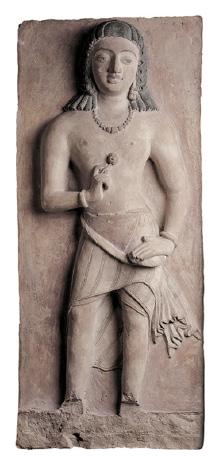
The strongly incised facial features bear similarities to clay sculptures from Ushkur (see a related terracotta head of a man, dated to the 6th to 7th century, in the Los Angeles County Museum of Art, accession number M.85.193.1 and another head, dated to the 7th to 8th century, in The British Museum, museum number 1861,0728.15). The same dramatic line of the eyebrows, running down to the bridge of the nose, the large expressive eyes and sublime smile indicates a distinct style of beauty.
Hund, known in antiquity as Udabhandapura, was a small village in the Swabi district, situated on the right bank of the Indus River in the Khyber Pakhtunkhwa province of Pakistan. It was the Turk Shahi dynasty’s capital of Gandhara, and possibly functioned as a winter capital alternating with the summer capital of Kabul within the kingdom of Kapisa-Gandhara in the 7th to 9th century. Old relics and remains of ancient civilizations have been found in the village after excavation work was undertaken by the government in the recent past. The history and past glory of the Hund has been preserved by the local government which constructed a museum and a replica of the tower of Olympia. The tower watches over the mighty Indus River, commemorating Alexander the Great’s crossing of the Indus while staying in Hund during his final military campaign for the Indian subcontinent.

Expert’s note: For a more detailed commentary, elaborating on the historical context and showing further comparisons, please request a PDF copy of the academic dossier for this lot from our customer support department.
LITERATURE COMPARISON
Compare a related terracotta figure of a deity seated in Rajalilasana, Fondukistan, ca. 6th century, in the Musee Guimet, Paris, illustrated in Gies and Cohen, Serinde, Terre de Bouddha, Paris, 1995, p. 135. Compare a related statue of a female Devata from Hund, dated 6th-7th century, in the Museum of Oriental Art in Turin (fig. 2)
AUCTION RESULT COMPARISON
Type: Closely related
Auction: Christie’s Paris, 12 June 2012, lot 304
Price: EUR 23,750 or approx. EUR 29,000 adjusted for inflation at the time of writing
Description: A terracotta bust of a celestial female attendant, Pakistan, Hund region, circa 8th century
Expert remark: Compare the closely related subject, shape of the body, facial features, jewelry, and hair. Note the size (63 cm).
Estimate EUR 20,000
Starting price EUR 10,000
fig. 2
fig. 1
A LARGE CHANDRAKETUGARH POTTERY VESSEL, 2ND-1ST CENTURY BC
Scientific Analysis Report: A thermoluminescence sample analysis has been conducted by Arcadia, Tecnologie Per I Beni Culturali, Milan, dated 26 November 2008, reference no. X659, and signed by Giovanna La Pietra. The result is consistent with the suggested period of manufacture. A copy of the thermoluminescence analysis report accompanies this lot.
India, West Bengal. Of ovoid form, supported on a stepped waisted foot and surmounted by a waisted neck with flaring rim, decorated in relief with four registers depicting finely carved figures, animals, stylized flowerheads, foliate designs, as well as floral and beaded borders, the neck with four winged kinnara, all divided by beaded, floral, and petal bands, with an exuberant floral band above the foot.
Provenance: Alexis Renard, Paris, 2008. A private collection in Paris, France, acquired from the above and thence by descent. Alexis Renard is a French art expert and dealer specializing in Islamic and Indian works of art with over 20 years of experience in the field. His gallery is located on Île Saint-Louis, a small island in the Seine in Paris, France.
Condition: Good condition, commensurate with age. Extensive old wear, obvious losses, chips, small cracks, few old repairs, minor touchups.
Weight: 1.9 kg (excl. stand) and 5.3 kg (incl. stand)
Dimensions: Height 47.3 cm (excl. stand) and 52.3 cm (incl. stand)
Mounted to a modern stand. (2)
Literature comparison: Compare a related vase with similar flowers, dated circa 100 BC, 26 cm high, in the collection of the Los Angeles County Museum of Art, accession number M.2005.155. Compare a related terracotta vase with figural decoration, described as Chandraketugarh, dated to the 2nd1st century BC, 74.3 cm high, in the Nelson Atkins Museum, object number 2009.54.
AUCTION RESULT COMPARISON
Type: Closely related
Auction: Galerie Zacke Vienna, 11 March 2022, lot 584
Price: EUR 11,376 or approx. EUR 12,500 adjusted for inflation at the time of writing
Description: A Chandraketugarh vase, 2nd - 1st century BC
Expert remark: Compare the related form and decorations. Note the smaller size (27 cm). Also note that this vase and the present lot were both TL-tested by Arcadia on the same day.
Estimate EUR 6,000
Starting price EUR 3,000
188
A RARE CHANDRAKETUGARH POTTERY VASE, SHUNGA PERIOD, 2ND-1ST CENTURY BC
India, West Bengal. The compressed globular body supported on a slightly convex foot and surmounted by a broad waisted neck with a wide flaring rim, decorated in relief to the body with finely carved figures of generous devis, each wearing pleated dhotis and ornate jewelry and headdresses, interspersed by verdant trees, enclosed within a foliate band to the base and shoulder, the neck similarly carved with tall stalks bearing stylized flowers.
Provenance: Alexis Renard, Paris, 2008. A private collection in Paris, France, acquired from the above and thence by descent. Alexis Renard is a French art expert and dealer specializing in Islamic and Indian works of art with over 20 years of experience in the field. His gallery is located on Île Saint-Louis, a small island in the Seine in Paris, France.
Condition: Excellent condition, commensurate with age. Expected old wear, few minuscule nicks and cracks, some scratches, minute losses, encrustations.
Weight: 330.3 g
Dimensions: Height 14.6 cm
Chandraketugarh is an archaeological site located beside the Bidyadhari river, about 35 kilometers northeast of Kolkata. Excavation between 1957 and 1968 (conducted by the Asutosh Museum of Indian Art) revealed relics of several historical periods, although the chronological classification of the relics remains incomplete. According to some historians, the Chandraketugarh site and surrounding area could be the place known to ancient Greek and Roman writers as having the same name as the river Ganges, sometimes referred to as Gangaridai.
This ancient capital and important urban center has yielded a wealth of artistically accomplished pottery of diverse object types and ceramic wares. Buff-colored low-fired earthenware was prevalent. Numerous sculptures, relief plaques, and ornate vases were produced. They are decorated primarily with images of sophisticated women and fertility goddesses richly adorned with elaborate hairstyles, intricately patterned textiles, and an abundance of jewelry.
LITERATURE COMPARISON
Compare a closely related vessel with similar flowers, dated circa 1st century BC, Shunga period, 18.4 cm high, formerly in the Metropolitan Museum of Art and deaccessioned for return to India in March 2023. Compare a closely related pottery vase, dated 2nd century BC, 15.5 cm high, illustrated by A & J Speelman Oriental Art on their website. Compare also an earthenware fragment depicting a closely related female figure, dated 100 BCE-100 CE, 16.5 cm high, in the Asian Art Museum, accession number 1991.256.
Estimate EUR 3,000
Starting price EUR 1,500
A SANDALWOOD VOTIVE PLAQUE OF A CROWNED BUDDHA, WEST INDIA, 1ST MILLENNIUM AD
Finely carved, the square plaque depicting the crowned Buddha seated in dhyanasana atop a columned base supported by a lion. His hands lowered in dhyana mudra, wearing fine robes, sashes, and jewelry, flanked by two foreign attendants with curly hair and tall helmets holding chauris and poles, all below a parasol and baldachin.
Provenance: From an old private collection in Germany.
Condition: Good condition commensurate with age. With extensive old wear, natural imperfections including expected minor age cracks, small nicks, few chips to edges, and the faces with significant rubbing predominantly from centuries of worship within the culture.
Weight: 52.3 g
Dimensions: Size 7.9 x 7.5 x 1.2 cm
The back is neatly carved with a central square panel enclosing lozenge diaper, surrounded by a foliate border.
Early depictions of the Buddha in India frequently have images of chauri-bearers on either side. Initially they were identifiable as nature divinities called yakshas, until later specific bodhisattvas would take this role. The present attendants are particularly unusual as they represent foreigners as clearly evidenced by their clothes and helmets. During the first millennium AD, contact with and between distinct if not distant cultures was of course more limited than today but nonetheless a fact of life, perhaps nowhere more than in the many territories along the vast Silk Road, once the greatest thoroughfare on earth linking Rome and China, which facilitated the transmission not just of goods but also ideas and culture, with the spread of religions and cultural traditions also leading to syncretism and new interpretations.
LITERATURE COMPARISON
Compare a related Gandharan bone plaque of 4.4 x 3.5 cm depicting a loving couple, described as possibly of West Indian manufacture, dated 1st-3rd century, in the Metropolitan Museum of Art, accession number 1998.348.
Estimate EUR 3,000
Starting price EUR 1,500
Scientific Analysis Report:
A thermoluminescence analysis report issued by Oxford Authentication on 24 February 2011, based on sample number N110q15, sets the firing date of two samples taken between 1000 and 1700 years ago, consistent with the dating above. A copy of the report accompanies this lot.
Eastern India, Bihar or Bengal, 5th-6th century. Finely modeled as Shiva in a swayed pose, with plump torso, arms, and a round head surmounted by a mass of frizzed curls, its central tresses drawn into a low chignon. His ears are adorned with a loop earplug on the right side and bell-like ornament on the left side, denoting the female and male aspects of his personality. Shiva wears a necklace of Rudraksha beads, a ribbon tie on his right shoulder, and two different bracelets adorning his sensitively posed hands which evoke divine energy flowing through his fingers.
Provenance: From a notable collector in London, United Kingdom.
Condition: Excellent condition, commensurate with age. Extensive wear, signs of weathering and erosion, obvious losses, nicks, scratches, small repairs to the face, minor touchups, chips, and expected firing flaws. Overall, fully consistent with the age of the sculpture.
Weight: 4.2 kg (incl. base)
Dimensions: Height 31.5 cm (incl. base), 27 cm (excl. base)
Mounted to a modern metal base.
It is believed that clay from the bed of the sacred rivers is endowed with the spiritual qualities required for icons into which a god could enter because it harnessed the four elements. These elements represent the forces controlled by Shiva, making clay a particularly appropriate material for his images.
This terracotta image of dancing Shiva probably comes from an outer wall of a temple. The figure is sculpted in high relief, originally part of a rectangular panel that occupied a ghanadvara (solid aperture) on a temple wall.
LITERATURE COMPARISON
Compare a related terracotta relief of Garuda, dated to the 5th to 6th century, Bihar or Bengal, in the Asian Civilisations Museum, accession number 2011-01953.
Estimate EUR 12,000
Starting price EUR 6,000
191
AN EXCEPTIONAL SANDSTONE FIGURE OF PADMAPANI, SALT HILLS, PUNJAB, CIRCA 6TH-8TH CENTURY
Masterfully carved standing on a rectangular lotus pedestal, his right hand raised in abhaya mudra, the bodhisattva dressed in princely clothes falling in evenly spaced lines along the legs. The shoulders are widened by the addition of symmetrically arranged necklaces and scarves.
His face with a serene expression and bow-shaped lips forming a calm smile, flanked by pendulous slit earlobes. The head surmounted by a turban-shaped crown, the brow band with massive square-cut gems, centered by an image of Amitabha Buddha, backed by a plain aureole. A small worshiper kneels to his right.
Provenance: From a notable collector in London, United Kingdom. Condition: Excellent condition, commensurate with age. Extensive wear, signs of weathering and erosion, obvious losses, nicks, and scratches. Overall fully consistent with the age of the sculpture.
Weight: 16.2 kg (incl. base)
Dimensions: Height 56.5 cm (incl. base), 54.2 cm (excl. base)
Mounted to a modern metal base. (2)
Expert’s note: For a more detailed commentary, elaborating on the historical context and showing further comparisons, please request a PDF copy of the academic dossier for this lot from our customer support department.
Literature comparison: Compare a related sculpture of Karttikeya, dated 6th to 7th century, Pakistan, 15.7 cm tall, in the Metropolitan Museum of Art, accession number 1988.260.
Estimate EUR 30,000
Starting price EUR 15,000
This sculpture represents an early image of Padmapani, as the lotus resting on his shoulder is rather small, similar to those seen in a brass group from Kashmir or Gilgit dated 715, illustrated in Pratapaditya Pal, Himalayas, an Aesthetic Adventure, Chicago, 2003, no. 64 (fig. 1), and Tumshuq figures in the Musée Guimet, illustrated in Giès and Cohen, Sérinde, Terre de Bouddha, Paris, 1995, nos. 164 and 165 (fig. 2). The bodhisattva’s facial appearance is similar to those seen in the Bajaur Padmapani dated 6th-7th century, illustrated in Kurita, Gandhara Art II, 2003, p. 881 (fig. 3). The sweeping eyebrows magnify the eye area, emphasizing the downward gaze of the bodhisattva as he surveys the woes of humanity. The large nose and full, sensitive mouth are also frequently seen in terracotta sculptures of the Gupta Empire, whose influence spread as far as Kashmir in the 5th and 6th centuries.
fig.
AN IMPORTANT GRAY CHLORITE HEAD OF VAIKUNTHA VISHNU, KASHMIR, 8TH TO EARLY 9TH CENTURY
The central face of Vishnu naturalistically carved with a serene expression, almond-shaped eyes below gently arched brows, full bow-shaped lips, and surmounted by ringlets below a tall ornate crown. His face is flanked by two of his most dramatic and ferocious avatars, the boar Varaha and lion Narasimha.
Provenance: From a notable collector in London, United Kingdom. Condition: Excellent condition, commensurate with age. Extensive wear, signs of weathering and erosion, obvious losses, nicks, scratches, and a small repair to the right eye. Overall, fully consistent with the age of the sculpture.
Weight: 18.2 kg (incl. stand)
Dimensions: Height 31.3 cm (incl. stand), 29 cm (excl. stand)
Mounted to a modern metal stand. (2)
This complex form of Vishnu, first referred to by the name Vaikuntha in the 7th century, is four-faced with the heads of a lion (right) and a boar (left) flanking a human head. He is also identifiable in this form by the epithet Para-Vasudeva, the ‘highest god’. The lion and boar represent Vishnu’s Varaha and Narasimha avatars. On some sculptures, the back of the halo is carved in low relief with a fourth face, a demonic, grimacing representation of Kapila, an immortal spirit who emerged from the Vedic ritual fire.
Expert’s note: For a more detailed commentary, elaborating on the historical context and showing further comparisons, please request a PDF copy of the academic dossier for this lot from our customer support department.
LITERATURE COMPARISON
Compare a closely related Kashmir chlorite statue of Vaikuntha Vishnu, dated 875-900, in the Los Angeles County Museum of Art, accession number M.69.13.2. Compare a closely related Kashmir chlorite statue of Vaikuntha Vishnu, dated to the last quarter of the 8th century, in the Metropolitan Museum of Art, accession number 1991.301.
AUCTION RESULT COMPARISON
Type: Closely related Auction: Christie’s New York, 20 March 2012, lot 39
Price: USD 98,500 or approx. EUR 124,500 converted and adjusted for inflation at the time of writing
Description: An important green stone figure of Shiva and Nandi, India, Kashmir, 8th century
Expert remark: Compare the closely related origin, subject, style, and manner of carving. Note the size (52 cm).
Estimate EUR 30,000
Starting price EUR 15,000
A LARGE SANDSTONE RELIEF OF BALARAMA, CENTRAL INDIA, MEDIEVAL PERIOD
Madhya Pradesh, late 9th-11th century. Finely carved standing in tribhanga, the slender body sensuously modeled, the right hand raised in vitarka mudra; the left lowered and holding a water pot, a coiling serpent on either side. Dressed in a dhoti secured by a festooned belt, the deity is adorned with beaded jewelry. His serene face with wide almond-shaped eyes, arched brows, and full lips forming a calm smile. The hair arranged in a tall chignon secured by a tiara, below a towering multi-headed naga hood, flanked by two diminutive attendant deities similarly dressed and posed, each standing under a smaller serpent hood.
Provenance: Collection of Paul J. Jewell, who lived and worked in South East Asia for over 20 years, serving as the executive director of the European Chamber of Commerce in Vietnam. To this day, he continues to collect Asian art and antiquities. Condition: Condition commensurate with age, with extensive ancient wear, weathering and erosion, encrustations, few chips, small nicks, minor losses and old repairs.
Dimensions: Height 93.5 cm (excl. stand), 95 cm (incl. stand)
Balarama is a Hindu god, and the elder brother of Krishna. He is identified in the present lot by the naga hood above his head and the water pot he holds. The snake hoods recall the god’s role as a manifestation of Shesha, the demigod-serpent Vishnu rests upon. Balarama’s mythology and his association with the ten avatars of Vishnu is relatively younger and post-Vedic, with narratives found in Mahabharata, Harivamsha, Bhagavata Purana, and other Puranas.
Nagas are serpent deities associated with water and agricultural abundance, but at the same time they are venomous and bring floods and destruction. Snake worship goes back to remote antiquity and numerous representations of nagarajas (serpent kings) are known from as early as the second century BC. Thus, it is not surprising that with the emergence of the Hindu, Jain, and Buddhist religious traditions we see the integration of naga deities.
LITERATURE COMPARISON
Compare a closely related buff sandstone figure of Balarama, Madhya Pradesh, 9th century, 110 cm, in the Central Museum, Gwalior, accession number 34147.
Compare a related earlier sandstone figure of Nagaraja, Uttar Pradesh, dated by inscription to 207, during the reign of the Kushan king Vasudeva, in the Asian Art Museum, San Francisco, object number B86S4.
Estimate EUR 20,000
Starting price EUR 10,000
Paul J. Jewell
194
A PINK SANDSTONE FIGURE OF A CELESTIAL BEAUTY, SURASUNDARI, 11TH CENTURY
Rajasthan or Central India. Finely carved, standing in a dynamic pose with her right arm raised as her body twists in a dancing motion, next to an ornate column exquisitely detailed with small figures and beasts as well as decorative elements such as beads and petals. She is richly adorned with elaborate jewelry around her neck and waist, and a small long-tailed bird rests on her lowered right arm as she feeds it, with her thumb and finger pressed together near the beak. Her face with downcast almond-shaped eyes and full lips forming a beguiling smile, the hair neatly incised.
Provenance: Austrian private collection.
Condition: Very good condition, commensurate with age. Extensive wear, signs of weathering and erosion, nicks, chips, losses.
Weight: 99.7 kg (incl. stand)
Dimensions: Height 116.5 cm (incl. stand), 94 cm (excl. stand)
In Indian art, a surasundari (lit. ‘beautiful goddess’) is a young maiden characterizing feminine beauty and graceful sensuality. Buddhist and Jain shrines have featured sensual figures in form of yakshis and other spirits since the 2nd century BC. However, the surasundari motif gained prominence in Indian temple architecture only around the beginning of the 9th century AD. Shilpa-Prakasha, a 9th-century Tantric architectural treatise, declares a monument without a surasundari as inferior and fruitless.
Mounted on a metal stand. (2)
Literature comparison: Compare a related marble figure of a surasundari, 78.1 cm high, dated to the 11th century, in the Metropolitan Museum of Art, accession number 69.247.
AUCTION RESULT COMPARISON
Type: Related
Auction: Bonhams New York, 17 March 2014, lot 78
Price: USD 87,500 or approx. EUR 109,000 converted and adjusted for inflation at the time of writing
Description: A red sandstone figure of a celestial woman (Surasundari), Rajasthan or Central India, circa 11th century
Expert remark: Compare the closely related subject, modeling, and manner of carving. Note the different size (43.2 cm).
Estimate EUR 8,000
Starting price EUR 4,000
A surasundari at a Khajuraho temple
A RED SANDSTONE HEAD OF VISHNU, WESTERN RAJASTHAN, 12TH-13TH CENTURY
India. The stone finely carved, incised and superbly polished. The serene face with an aquiline nose, elegantly arched brows, and full lips forming a subtle smile, his hair neatly arranged in curled locks beneath the ornate crown with three large jeweled and beaded panels, pulled up into a high coiled chignon surmounted by a jewel.
Provenance: Nagel Auktionen, Stuttgart, 19-20 May 2000, lot 2069 (dated 17th century or earlier), sold for EUR 5,800 or approx. EUR 9,100 (adjusted for inflation at the time of writing). German private collection, acquired from the above.
Condition: Very good condition, commensurate with age. Old wear, obvious losses, signs of weathering and erosion, structural fissures, nicks, scratches.
Weight: 2,988 g (incl. stand)
Dimensions: Height 23.2 cm (incl. stand) and 20.6 cm (excl. stand)
Mounted on a wood stand. (2)
AUCTION RESULT COMPARISON
Type: Closely related Auction: Christie’s New York, 15 March 2016, lot 315
Price: USD 25,000 or approx. EUR 30,500 converted and adjusted for inflation at the time of writing
Description: A black stone head of Vishnu, India, Western Rajasthan, circa 12th century Expert remark: Compare the closely related subject, modeling, and manner of carving, with similar facial features, curls, and crown. Note the different material, which nonetheless exhibits a polish quite similar to the present lot, and the size (27.4 cm).
Estimate EUR 4,000
Starting price EUR 2,000
A PALE PINK SANDSTONE STELE OF VISHNU VARAHA, THE COSMIC BOAR
Central India, 11th-12th century. Finely carved to depict Vishnu as the cosmic boar Varaha standing in samabhanga. The deity holding one of his attributes – the shankha, chakra, gada, and lotus – in each hand. Wearing a tight-fitting pleated dhoti and adorned with beaded necklaces and a vanamala. His head is turned to the side and detailed with curling tusks which balance the weight of the earth. To his feet stand four devotees, two with their hands clasped together in anjali mudra.
Provenance: Collection of José Ramón Pons Oliveras, Barcelona, Spain, acquired before 1990. Jacques Barrère, Paris, France, acquired from the above.
- José Ramón Pons Oliveras (19282013) was a traveler, photographer, and cinematographer of nature. He acquired rare and important works of art during his travels to India in the 1970s, some of which have been sold by Christie’s.
Jacques Barrère with French President Jacques
at the Biennale des Antiquaires in Paris, 1974
- Since 1969, The Jacques Barrère Gallery has held exhibitions to promote and preserve Far-Eastern art. Objects once owned by Barrère are now in major museums around the world, including the Guimet, the Cernuschi, and the Shanghai Museum.
Condition: Good condition with ancient wear, signs of weathering and erosion, encrustations, obvious losses, chips, tiny nicks, scratches, and structural fissures.
Weight: 67.4 kg (incl. stand)
Dimensions: Height 70.3 cm (excl. stand), 71.5 cm (incl. stand)
With an associated metal stand. (2)
AUCTION RESULT COMPARISON
Type: Closely related
Auction: Christie’s New York, 20 September 2000, lot 26
Price: USD 14,100 or approx. EUR 23,500 converted and adjusted for inflation at the time of writing
Description: A sandstone stele of Vishnu Varaha, Central India, 10th/11th century
Expert remark: Compare the related subject, modeling, and manner of carving. Note the size (99 cm).
Estimate EUR 4,000
Starting price EUR 2,000
Chirac
197
A MARBLE STELE OF PARVATI, WESTERN INDIA, 11TH-12TH CENTURY
Gujarat or Rajasthan. Well carved, the four-armed deity standing in samabhanga, flanked by attendants with hands clasped together in anjali mudra, the goddess’ raised hands holding a gadha and an image of her son Ganesha. She wears a short dhoti with a billowing sash wrapped around her arms and is richly adorned in beaded and festooned jewelry. Her round face with a benevolent expression, sensitively modeled with downcast eyes and slender lips forming a gentle smile, flanked by elongated lobes suspending circular earrings, the head crowned with a high, domed, beaded and incised tiara.
Provenance: Robert H. Ellsworth, New York, 1960. A private collection in Belgium, acquired from the above. Gallery Ilunga, Ghent, ca. 2000, acquired from the above. Collection of Mr. and Mrs. Sergeant, Ghent, Belgium, acquired from the above, and thence by descent. A copy of a certificate of authenticity from Gallery Ilunga, written and signed by Luc Cannoot and confirming the provenance above, accompanies this lot. Robert Hatfield Ellsworth (1929-2014) was a noted Manhattan-based collector and dealer of Asian paintings, works of art and furniture from the Ming and Qing dynasties, who had his business and residence in a Manhattan townhouse, which he shared with actress Claudette Colbert. Ellsworth’s clients included America’s major museums and important collectors, among them John D. Rockefeller III, Sir Joseph Hotung, Herbert Irving, and socialite Brooke Astor, after whom a room at the Metropolitan Museum of Art is named. Ellsworth was a supporter of architectural restoration in Huangshan and an honorary Chinese citizen. Condition: Good condition with wear and natural imperfections. Obvious losses, chips, nicks, scratches, fissures, and signs of weathering and erosion. With a fine, naturally grown patina and lustrous shine overall.

Weight: 7,975 g
Dimensions: Height 35 cm
LITERATURE COMPARISON
Compare a related Jain marble stele depicting Neminatha, dated 11th century, 37.5 cm high, in the Norton Simon Museum, accession number F.1978.28.S.
Estimate EUR 3,000
Starting price EUR 1,500
Robert H. Ellsworth in the living room of his Fifth Avenue apartment, New York, 1980
198 AN IMPORTANT POLISHED BLACK STONE FIGURE OF MAHAVIRA, THE HISTORICAL FOUNDER OF JAINISM, DATED 1098
Western India, Rajasthan, dated 1098 (Samvat 1155).
Finely carved, the Jina seated in dhyanasana on an ornate cushion carved along the rim with foliate designs in shaped cartouches. His hands lowered in dhyana mudra. His rib cage rises in iconographically prescribed diagonals towards his broad chest with the shrivatsa mark between his smooth pectorals. His arms extend from broad shoulders, his neck displays the trivali mark.
He shows a determined yet charming expression with large eyes, bow-shaped lips forming a calm smile, a pronounced chin, and rounded cheeks, flanked by elongated earlobes. His hair is neatly arranged in numerous snail-shell curls, all of which are remarkably well carved.
Inscriptions: To the cushion, dated ‘Samvat 1155’, corresponding to 1098.
Provenance: The private collection of Frits Seegers, assembled during the 1990’s and early 2000’s, and in 2021 by descent to his widow Kartika Soekarno Seegers. A copy of an ownership letter written and signed by Kartika Soekarno Seegers, dated 25 June 2024, confirming the lot was in the collection of her late husband Frits, accompanies this lot. For privacy reasons, this letter will be released to the winning bidder only, after full payment has been received. Frits Seegers (1959-2021) was a well-known European financial executive and the president of Citibank Europe. His widow Kartika Soekarno Seegers is the daughter of Sokarno, the national hero and first president of Indonesia, serving from 1945 to 1967.
Condition: Very good condition, commensurate with age. Significant ancient wear, predominantly from extensive worship within the culture. Signs of natural weathering and erosion, encrustations, some iron oxide residues, scratches. Minor nicks, chips, and obvious losses. The polish is remarkably well preserved. Overall with a naturally grown patina and presenting extraordinarily well.
Dimensions: Height 61 cm
elegant figure probably depicts the Jina Mahavira
BC), the historical founder of Jainism, a near contemporary of the Buddha Shakyamuni in the fifth century B.C. The statue is a superlative example of 11th century Jain sculpture. Sensuously modeled, the broad shoulders, short neck and narrow waist of the seated Jina demonstrate the powerful and meditative equipoise of the subject. Also note the fine carving and rendering of the iconographical details, including the delicately incised individual curls, the tufted whorls at the nipples, the stylized srivatsa at the center of the chest, and the motif at the palms of the hands and soles of the feet, which continued at the base cushion.
Frits Seegers (1959-2021)
Kartika Soekarno Seegers
This
(circa 480-408
Jainism was established in India around the sixth century BC and flourished alongside Hinduism and Buddhism. The ultimate goal of the Jains or ‘conquerors’ was to achieve liberation from the cycle of reincarnations. They worship a group of twenty-four Supreme Teachers or Tirthankaras, arihants who after attaining kevala jnana (pure infinite knowledge) preach the dharma. An arihant is also called Jina (victor), one who has conquered inner enemies such as anger, attachment, pride, and greed.
Literature comparison: Compare the rounded, carved base cushion and dedicatory inscription on the current work with a contemporaneous marble sculpture of a Jain Svetambara Tirthankara in meditation in the Metropolitan Museum of Art, accession number 1992.131. For a related 12th century polished sandstone sculpture of a Jina in the collection of Dr. David R. Nalin, see Pratapaditya Pal, Peaceful Liberators: Jain Art from India, Los Angeles, 1994, p. 140, cat. no. 27.
AUCTION RESULT COMPARISON
Type: Closely related
Auction: Sotheby’s 16 March 2016, lot 763
Price: USD 670,000 or approx. EUR 820,000 converted and adjusted for inflation at the time of writing
Description: A polished black stone figure depicting a Jina, Western India, Rajasthan, dated Samvat 1153 (1096 CE) by inscription
Expert remark: Compare the closely related subject, modeling, manner of carving, and dating inscription.
AUCTION RESULT COMPARISON
Type: Closely related
Auction: Christie’s Paris, 14 December 2016, lot 2
Price: EUR 140,500 or approx. EUR 169,000 adjusted for inflation at the time of writing
Description: A rare black stone figure of a Jain Tirthankara, central India, Western Rajasthan region, dated 1098
Expert remark: Compare the closely related subject, modeling, manner of carving, and dating inscription. Note the missing head and the resulting smaller size (49 cm).
Estimate EUR 80,000
Starting price EUR 40,000
199
A SCHIST STELE OF VISHNU, PALA PERIOD, 10TH-12TH CENTURY
Northeastern India, Bihar. The grey stone is finely and deeply carved in openwork, the four-armed deity standing in samabhanga on a doublelotus pedestal with arms raised and holding a gada and chakra. Richly adorned with beaded jewelry, the deity is dressed in a tight-fitting dhoti secured with an ornate tasseled belt, a thin scarf, and sacred thread across the chest, and a vanamala (long floral garland). The serene face is sensitively modeled with heavy-lidded eyes, elegantly curved brows, and bow-shaped lips pursed to form a calm smile, flanked by long pendulous lobes suspending floral earrings. The hair is tied in an elaborate chignon and secured with a tall conical headdress surmounted by a lotus bud behind the foliate tiara, backed by a lotuspetaled halo.
Provenance: From an old private collection in North Rhine-Westphalia, Germany, acquired before 1971, and thence by descent.
Condition: Excellent condition, commensurate with age. Some wear, obvious losses, signs of weathering and erosion, chips, nicks, scratches.
Weight: 32.7 kg (incl. stand)
Dimensions: Height 68.5 cm (excl. stand), 91.3 cm (incl. stand)
Mounted to an associated and finely carved hardwood stand, of tapering stepped form. (2)
Vishnu is attended by his two consorts, the goddess of poetry and music Sarasvati playing the vina to his left, and the goddess of fortune Lakshmi holding a fly whisk to his right, as well as devotees and donors kneeling below, and with celestial garland bearers above.
LITERATURE COMPARISON
Compare a closely related stele of Vishnu, Pala dynasty, dated 10th-11th century, 79 cm, in the Princeton University Art Museum, object number y1961-47 (fig. 1). Compare a closely related stele of Vishnu, Pala dynasty, dated mid-11th century, 93 cm, in the collection of the Ashmolean Museum, Oxford, accession number LI894.12.
AUCTION RESULT COMPARISON
Type: Closely related
Auction: Christie’s New York, 13 September 2017, lot 616
Price: USD 47,500 or approx. EUR 56,000 converted and adjusted for inflation at the time of writing
Description: A black stone stele of Vishnu, Northeastern India, Pala period, 12th century Expert remark: Compare the closely related subject, modeling, and manner of carving, with Vishnu, Sarasvati, and Lakshmi all similarly depicted to the present lot. Note the similar size (70.5 cm).
Estimate EUR 6,000
Starting price EUR 3,000
200
A FINE AND RARE BRONZE ALTAR OF SURYA, PALA PERIOD
Published: Eastern Indian Bronzes, Nihar Ranjan Ray et al., 1986, Lalit Kala Akademi, page 154, no. 240 (described as “Formerly Ajit Ghosh Collection, Calcutta. Present whereabouts unknown.”)
Northeastern India, Bengal, 11th century. Finely cast standing in samabhanga atop a circular double-lotus pedestal raised on an elaborate openworked balustrade plinth with seven galloping horses led by Aruna on his chariot. One worshiper is kneeling near the right foot of the base. Surya holds a lotus stem in each hand coming to full bloom at the shoulders. He wears a diaphanous dhoti secured at the waist by an ornate belt, and fine jewelry with a tiara in front of the tall chignon. The figure is backed by a tall openworked mandorla with foliate border centered by the sun.

Provenance: Ajit Ghosh Collection, Calcutta, India, by the 1960s. JeanClaude Moreau-Gobard, Paris, France, acquired from the above. A private collection in France, acquired from the above, and thence by descent. A copy of an expertise written and signed by Jean-Claude Moreau-Gobard, dated 16 May 2000, confirming the dating and provenance above, accompanies this lot. Note that this expertise includes a description of the figures of Dandi and Pigala, which are in fact missing, as correctly pointed out by the Lalit Kala Akademi publication. Ajit Ghosh was an Indian lawyer for the Calcutta High Court and a noted scholar, collector, and critic who is perhaps best known for his early work on Kalighat paintings, writing an article in 1926 for the Rupam Magazine, the quarterly journal of the Indian Society of Oriental Art. He studied and wrote about varied Indian art subjects ranging from Buddhist manuscripts to Indian miniatures. The Smithsonian Institution has published much of his work. His collection of Kalighat paintings was acquired by Basant Kumar Birla (1921-2019), an Indian businessman of the Birla family. Jean-Claude Moreau-Gobard was an important French collector and dealer specializing in Asian art, born into a family of antiques experts in Paris. Today, the family business is continued by Juliette Moreau-Gobard.
Condition: Good condition, commensurate with age. Old wear, casting irregularities, signs of weathering and erosion, nicks, scratches, losses. Good, naturally grown patina overall.
Weight: 1,100 g
Dimensions: Height 26 cm
The Hindu sun god Surya is often depicted as a resplendent deity holding lotus flowers in both hands, riding a chariot pulled by, like in this present lot, seven horses which represent the seven colors of visible light and the seven days of the week. These horses are named after the seven meters of Sanskrit prosody: Gayatri, Brihati, Ushnih, Jagati, Trishtubha, Anushtubha and Pankti. Earliest representations of Surya riding a chariot occur in the Buddhist railings of the Mahabodhi temple in Bodhgaya during the 2nd century BC, but he only began to be worshiped within Hindu temples in the 8th century AD.
LITERATURE COMPARISON
Compare a related Pala bronze altar of Surya from Bengal, 19.6 cm high, dated ca. 1075, in the Los Angeles County Museum of Art, accession number M.81.99 (fig. 1)
Compare a related Pala bronze altar of Surya from Bangladesh, 19.5 cm high, dated 10th-12th century, in the Art Institute of Chicago, reference number 1980.267
AUCTION RESULT COMPARISON
Type: Closely related
Auction: Christie’s New York, 20 March 2012, lot 79
Price: USD 30,000 or approx. EUR 38,500 converted and adjusted for inflation at the time of writing
Description: A bronze altar of Surya, Northeastern India, Pala period, circa 10th century
Expert remark: Compare the identical subject, similar altar form, and closely related manner of casting. Note the smaller size (19.7 cm).
Estimate EUR 8,000
Starting price EUR 4,000
fig. 1
Jean-Claude Moreau-Gobard with the minister of cultural affairs André Malraux, at the Biennale des Antiquaires in Paris, 1960s
201
A MAGNIFICENT WHITE MARBLE HEAD OF A DHARMIC DEITY, WESTERN INDIA
Gujarat or Rajasthan, 16th century or earlier. Finely carved and polished, the head is surmounted by an elaborate cubic crown depicting confronted lions centered by a Dharmachakra on three of its four sides.
The dharmachakra, or wheel of dharma, is a prominent symbol in Dharmic religions, particularly Buddhism and Hinduism. It signifies the 8 Noble Truths taught by the Buddha. Historically, the dharmachakra has been widely used in East Asian statues and inscriptions from ancient times to the present. It remains a major symbol of Buddhism today. Dharmic religions are a group of religions that originated in the Indian subcontinent and share common spiritual concepts and practices, such as dharma (moral law) and karma (cause and effect).
The crown is topped by a flowerhead, above skillfully modeled curled locks and the deity’s serene face marked by heavy-lidded almondshaped eyes below elegantly arched brows, centered by a dropshaped urna.
The full bow-shaped lips forming a gentle smile above the prominent chin, flanked by long pendulous earlobes with a lotiform earring, adorned with a densely and neatly incised necklace.
Provenance: The private collection of Frank Sys, Brussels, Belgium. A private collection in Belgium, acquired from the above in the late 1990s and thence by descent. Frank Sys was a noted antiques dealer in Belgium who ran Passage 125 Gallery in Brussels and Alinea Gallery in Knokke. He was also active in Brussels’ famous Old Market on the Place du Jeu de Balle.
Condition: Good condition with ancient wear, obvious losses, old repairs, structural cracks, minor chips, small nicks, light scratches.
Weight: 22.2 kg
Dimensions: Height 37.5 cm (excl. stand), 45 cm (incl. stand)
Mounted to an associated stand. (2)
Expert’s note: The lustrously polished ivory-white stone is known as Makrana marble after the town in Rajasthan where it is mined. It has been popular in sculpture for many centuries and was used in the construction of iconic monuments such as the Taj Mahal. Compare the polished marble of a figure of Ganesha, dated 12th century, at Christie’s New York, 21 September 2005, lot 46 (fig. 1), and of a figure of a bull formerly in the James and Marilynn Alsdorf Collection, sold by Christie’s New York, 24 September 2020, lot 970 (fig. 2)


The present deity’s crown displays a remarkable early Hellenistic influence and a fascinating syncretism: Its square form is reminiscent of the Greek goddess Tyche’s mural crown, see a relief dated c. 160 AD in the Louvre, accession number Ma 590 (fig. 3) The iconography displayed within the crown, with lions and the dharmachakra, is also found in the famous Lion Capital of Ashoka, the head of a column erected by the Mauryan emperor Ashoka the Great in Sarnath, India, c. 250 BC, and now in the Sarnath Museum (fig. 4)
Estimate EUR 8,000
Starting price EUR 4,000
Frank Sys
fig. 3
fig. 4
fig. 1
fig. 2
A
AND IMPORTANT
FIGURE OF VISHNU JANARDANA, ORISSA, 16TH CENTURY
Eastern India. Superbly cast, standing in samabhanga on a circular plinth supported on a lotus pedestal raised on a cylindrical stem atop a domed base, his principal hands lowered and clasped around a lotus bud and club, the secondary hands raised and holding a chakra and shankha.
Dressed in a loincloth with tassels to one side, the deity is simply adorned, his neck and chest neatly incised with a foliate pendant hanging from a necklace. The face with a remarkably powerful expression, marked by large almond-shaped eyes neatly inlaid in silver, an aquiline nose, and gently pursed lips, all flanked by large ears with perforated lobes, the hair finely incised with scroll-like curls and tied in a small topknot.
Provenance: Maître Guy Loudmer, Paris, 26 June 1995, lot 61. A private collection in France, acquired from the above. This lot is accompanied by a copy of a certificate of authenticity, written and signed by Guy Loudmer, no. 1319, dated 24 July 1995, confirming the provenance above, attached to an old photograph of the present lot. Guy Loudmer (d. 2019) was a prominent French auctioneer, nicknamed the ‘Patton’ of the French Compagnie des CommissairesPriseurs (Auctioneers Association).
Guy Loudmer
Condition: Good condition with significant ancient wear as expected, issuing mostly from extensive worship within the culture, and casting irregularities. Wear, rubbing, minuscule losses, minor warping, scattered dents, nicks, and scratches. The bronze with a fine, naturally grown, smooth patina.
Weight: 34.1 kg (incl. stand)
Dimensions: Height 70.5 cm (excl. stand), 76 cm (incl. stand)
Mounted on an ingeniously crafted revolving base, allowing for the statue to be turned around, despite its significant weight of 34 kilograms. (2)
Janardana is an epithet of Vishnu in the Puranas. Janardana means, ‘he who is the original abode and protector of all living beings’. His main shrine is the Janardanaswamy temple situated in Varkala. In the Mahabharata, Sanjaya uses this epithet of Vishnu to describe the latter’s prowess to King Dhritarashtra:
“You askest me repeatedly, O king, about the Pandavas for knowing their strength and weakness. Listen now to all that in brief. If the whole universe be placed on one scale and Janardana on the other, even then Janardana will outweigh the entire universe. Janardana, at his pleasure, can reduce the universe to ashes, but the entire universe is incapable of reducing Janardana to ashes. Wherever there is truthfulness, wherever virtue, wherever modesty, wherever simplicity, even there is Govinda. And thither where Krishna is, success must be. That soul of all creatures, most exalted of male beings, Janardana, guides, as if in sport, the entire earth, the firmament, and the heaven.”
— Vyasa, Mahabharata, Section LXVIII
LITERATURE COMPARISON
Compare a related brass figure of Krishna with Balarama, Orissa, 16th century, in the National Museum of Asian Art, Smithsonian Institution, accession number S2001.32
(fig. 1). Compare also a related bronze figure of Narasimha, the lion-headed incarnation of Vishnu, with similar silver-inlaid eyes, in the Art Institute of Chicago, reference number 1996.88.
AUCTION RESULT COMPARISON
Type: Closely related
Auction: Bonhams New York, 19 March 2012, lot 1034
Price: USD 254,500 or approx. EUR 322,000 converted and adjusted for inflation at the time of writing
Description: A brass figure of Radha, Orissa, circa 16th century
Expert remark: Compare the closely related modeling and manner of casting with similar facial features and patina, as well as the nearidentical size (68.5 cm). Note the different subject, and the lack of silver inlay.
Estimate EUR 8,000
Starting price EUR 4,000
1
fig.
A LARGE BRASS FIGURE OF GANESHA BENEATH A NAGA HOOD, WESTERN HIMALAYAS, 16TH-17TH CENTURY
Ancient region of Himachal Pradesh.
Finely cast seated in royal ease on a pierced rectangular lotus base, his body guarded by intertwined cobras terminating in five crowned heads forming a protective hood above him. His face with a long curling trunk, with which he samples a sweet held in his lower left hand, his lower right hand is holding a radish, the upper two hands holding an axe and hammer, the head surmounted by a foliate crown.
Provenance: From a notable collector in London, United Kingdom. Condition: Good condition with extensive wear to the face, hands, belly, and legs, predominantly from centuries of worship within the culture. Few minuscule losses, minor cracks, dents, and casting flaws. Naturally grown, even patina overall.
Weight: 14 kg (incl. plinth)
Dimensions: Height 36.2 cm (incl. plinth), 34.4 cm (excl. plinth)
The figure is cast in three parts: Ganesha, the base, and the naga hood. Mounted to a modern metal plinth. (2)
Ganesha, the elephant-headed son of Shiva and Parvati, is a widely cherished deity in the Hindu pantheon. He is worshiped throughout India at the beginning of journeys or new endeavors. As such, he is often placed at thresholds or entries where he is traditionally offered sweets, fruits, coins, flowers, and freshly cut grass. Renowned for his powers to remove obstacles, he also aids in areas of education, knowledge and wisdom, literature and fine arts.
Unlike the single Nagaraja who similarly protects the Buddha and the Jain tirthankaras Suparshvanatha and Parshvanatha, a number of serpents are involved here; it suggests that they represent the awakened Kundalini. Kundalini, visualized as a coiled snake, is a source of energy located at the base of the spine that is activated during yoga practice and also during tantric rituals.
The crown on Ganesha’s head indicates a stylistic origin for this sculpture in northwestern India or western Nepal. It maintains a tradition that can be traced back to 8th century Kashmir when Buddhist bodhisattvas and Hindu gods were depicted in this way. The sculpture is cast in brass, indicating its origin in the western Himalayas; brass is a traditional medium for metal images in Kashmir, Himachal Pradesh, Ladakh and western Nepal.
Expert’s note: For a more detailed commentary, elaborating on the historical context and showing further comparisons, please request a PDF copy of the academic dossier for this lot from our customer support department.
Estimate EUR 15,000
Starting price EUR 7,500
BLACK BASALT OPENWORK STELE, DEPICTING THE CELESTIAL WEDDING OF SHIVA AND PARVATI, KALYANASUNDARA
Dravidian, southern India, 16th-17th century.
Finely carved and incised, Meenakshi (Parvati) is depicted in the center, with her brother Vishnu on the left, giving away her hand to Sundareswarar (Shiva) on the right, all under the shade of a tall verdant tree.
The groom holds the bride’s hands, performing the Panigrahana ritual, as her brother pours a lustration blessing (abhiseka) over the couple’s open hands from a gold pot. The three deities are richly adorned in beaded jewelry and vanamalas, Parvati’s dhoti is carved with elegant pleats. Shiva displays two attributes in his secondary arms, a deer and an axe, while Vishnu similarly holds his mace and conch.
Provenance: A noted private collection in the south of France, region of Marseille, circa 1920, and thence by descent. Dominique Weitz, Paris, France, acquired circa 1991, and thence by descent. Condition: Magnificent condition with some old wear, mostly from extensive worship within the culture, as well as a few minuscule nicks, chips, small losses, tiny structural fissures, and traces of weathering and erosion. Remnants of ancient ritual pigment.
The present lot is accompanied by copies of:
- An old photograph of the present lot, bearing a handwritten expertise on the backside, describing the statue as a ‘Stèle au basalte - groupe Dravidien, Inde du Sud – XVIe, H. 153 cm’ (basalt stele, Dravidian group, southern India, XVIth, height 153 cm), with stamp and signature from Guy and Thierry Portier, Paris, France.
- A signed expertise from Françoise LeroyLaveissère, Paris, dated 5 December 1988, with a handwritten note from Dominique Weitz addressed to French expert M. Vernet-Vaghari regarding a meeting.
- A detailed typewritten description of the present lot, mentioning the expertise from Françoise LeroyLaveissère, as well as the photograph with the expertise by Guy et Thierry Portier, with a handwritten note from Dominique Weitz addressed to M. Vernet-Vaghari, discussing a possible sale of the present lot.
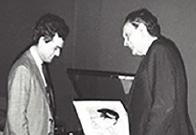

Guy Portier (1919-2005) was an important French auctioneer and Asian art expert. His father André specialized in the import of silk from the Far East and later served as an expert in the sales of major French collections of Asian art. Guy was in charge of the silk department of the family company until he took over in 1942, gradually focusing on Far Eastern works of art, Japanese prints being one of his passions. In 1967, he included a list of estimates for the objects put up for sale in one of his catalogs for the first time, back in these days a revolutionary change. His son, Thierry Portier, joined the firm in 1973, when the Japanese art market was at its highest. He was appointed honorary expert at the Court of Appeal of Paris, and expert at the French Syndicate of Experts in Works of Art and Collections (SFEP). The family company, Cabinet Portier, still exists to this day.
Dimensions: Height 153 cm, Length 91.5 cm
The Meenakshi Temple in Madurai, South India (fig. 1), has a related group carved during the same period as the present lot. Arulmigu Meenakshi Sundareswarar Temple is a historic Hindu temple located on the southern bank of the Vaigai River in the temple city of Madurai, Tamil Nadu, India. The complex is one of the most prominent examples of Dravidian architecture, dedicated to the Goddess Meenakshi, a form of Parvati, and Lord Sundareswarar, a form of Shiva, the very subject of the present lot. Although the temple has historic roots dating to the 12th century, it was extensively rebuilt in the 16th century by the Vijayanagar and Nayak dynasties after suffering significant destruction during the 14th century invasion by the Delhi Sultanate. Today, it is renowned for its ornate gopurams, Hall of Thousand Pillars, vibrant sculptures, and elaborate architecture.

The rock carvings at Cave 29, Ellora, Maharashtra, India, include a related basalt Kalyanasundara panel. The Ellora Caves are a UNESCO World Heritage Site renowned for their impressive rock-cut architecture. Dating from the 6th to 10th centuries, they feature 34 caves representing Buddhist, Hindu, and Jain traditions, illustrating the religious harmony of the period. Although the caves served as temples and a rest stop for pilgrims, the site’s location on an ancient South Asian trade route also made it an important commercial center in the Deccan region.
The circumstances leading to the marriage of Shiva and Parvati constitute a significant episode in the Hindu mythology. After the death of his first wife Sati, Shiva withdrew into an ascetic lifestyle. Taking advantage of the situation, Tarakasura, the demon king secured from Brahma a clever boon that none could kill Tarakasura other than the son of Lord Shiva. Believing himself immortal, Tarakasura terrorized the universe and the heavens. Meanwhile, Sati, Shiva’s deceased wife reincarnated as Parvati. She was born to the Himavan and Mena. She underwent severe austerities to impress Shiva to marry her. The gods, in their desperation pursued Kamadeva, the god of love to disturb Shiva’s meditation. Though Shiva was awakened, Kamadeva was burnt up by Shiva’s fury. Implored by the other gods to marry, Shiva agreed, but decided to test Parvati’s devotion first. The Saptarishi (the seven sages) approached Parvati and mocked Shiva to dissuade her; however Parvati remained resolute. Then Shiva himself, disguised as an old ascetic, visited Parvati and vilified himself in her presence. As an angry Parvati was about to leave, Shiva revealed his true form to her and promised to marry her, pleased with her love and devotion. The couple married and produced a son, Kartikeya, who subsequently slew Tarakasura.
Kalyanasundara (lit. ‘beautiful wedding’) is the iconographical depiction of the wedding of the Hindu deities Shiva and Parvati. The couple are often depicted performing the panigrahana ritual, where the groom accepts the bride by taking her right hand in his. They are often accompanied by a host of divinities and other celestial beings. Although this icon is not the object of popular worship and is usually used only in the celebrations of the divine wedding in annual temple festivals, it is found across India in caves, sculptures and on temple walls. At the Meenakshi Amman Temple, women consecrate the Kalyanasundara sculpture to find husbands.
The Dravidian peoples are an ethnicity composed of many distinct ethnolinguistic groups native to South Asia, predominantly India. They speak the Dravidian languages and form the majority of the population of South India and Northern Sri Lanka. The origins of the Dravidians are a complex subject of research and debate. Some evidence suggests the language family may have deep pre-Neolithic roots from Western Asia, specifically from the Iranian plateau. Their origins are often viewed as being connected with the ancient Indus Valley Civilization.
Literature comparison: Compare a related basalt figure of Vishnu Narayana lying on the serpent Ananta, 17th-18th century, in the Musée Guimet.
Estimate EUR 40,000
Starting price EUR 20,000
fig. 1
Guy Portier and his son Thierry during the viewing of the Le Véel auction in 1979
205
A RARE WOOD CARVING OF WOMAN GIVING BIRTH, TAMIL NADU, 18TH CENTURY
India. Finely carved with a woman seated on a plinth, her right hand clutching her braided hair tightly as she delivers a child into the welcoming hands of the midwife positioned at her feet. She is accompanied by two attendants who are both adorned in jewelry and dressed simply in a dhoti, their chests bare, one holding a staff as she protectively looks over the vulnerable mother, who is nude with elaborately braided and embellished hair and richly adorned with jewelry, all below a central kirtimukha.
Provenance: From a Belgian private estate. Condition: Good condition with expected old wear and natural imperfections. Obvious losses, chips, cracks, nicks, rubbing, mounting apertures, and signs of weathering. Remnants of varnish.
Weight: 10.97 kg (incl. stand)
Dimensions: Height 49.7 cm (excl. stand), 52.5 cm (incl. stand)
With an associated metal stand. (2)
The present panel depicts the moment of childbirth from the womb of a mother. Her left hand and arm are extended downward, and both her feet are turned outward with the knees thrown out sideways. The postures seen in the images of Salabhanjika and the mothers in delivery, with one hand holding the branch of a tree, here clasped around her braided hair, and the other hand held downward or rested on the waist, akin to the dancing postures frequently found on the panels in the passageways of gopuras.
LITERATURE COMPARISON
Compare a related wood carving of birth as an image of creation, South India, 18th century, illustrated by Ajit Mookerjee and Madhu Khanna in The Tantric Way: Art, Science, Ritual, 1989, p. 171. Compare a related wood carving of childbirth in squatting position holding onto women on each side, South India, illustrated in Md. Rifat Rahman et al. in The Process of Childbirth of the Malo Women in Bangladesh: Birth Ritual Based on Archaeological Evidence and Ethnographic Observation, Contemporary Voice of Dalit, 2022, p. 9 (fig. 1) fig. 1
Estimate EUR 3,000
Starting price EUR 1,500
AN INDIAN MINIATURE PAINTING OF KINNARIS RIDING RAMPAGING ELEPHANTS
India, Deccan, Hyderabad, 18th century. Watercolors, gouache, and gold on paper. Depicting two elephants engaged in a vicious battle with their trunks intertwined, each surmounted by a crowned kinnari with spread wings and holding elephant hooks (ankusha). Framed within yellow and orange bands.
Provenance: His Exalted Highness, the Nizam of Hyderabad, Osman Ali Khan (1886-1967), personally gifted to Dr. Mallanah Shrinagesh, Hyderabad, India. Thence by descent to Dr. Shrinagesh’s daughter Shakuntala Hartog (1924-2006). Thence by descent to her widower Rudolf Hartog (1924-2018). Thence by descent in the family to the last owner. Dr. Mallanah Shrinagesh was the personal physician to H.E.H. Mir Osman Ali Khan, Asaf Jah VII, the last Nizam of the Princely State of Hyderabad, the largest state in the British Indian Empire, who reigned from 1911 to 1948. The paintings were a personal gift by the Nizam to Shrinagesh, given during the 1930s as compensation for his work. They decorated the walls of the doctor’s apartment in the court at Hyderabad. His daughter Shakuntala inherited the pieces and brought them with her when she moved with her husband Rudolf Hartog to Germany. Shakuntala and Rudolf Hartog both wrote several books about India, published in Germany.
Condition: Very good condition with minor wear and little soiling. The frame with light scratches and minute nicks.
Dimensions: Image size 30.7 x 21.8 cm, Size incl. frame 37.8 x 30.2 cm
Framed behind glass. (2)
LITERATURE COMPARISON
Compare a related miniature depicting a battle of two elephants at the court of Sha Alem in the Bibliothèque Nationale, Paris (fig. 1). Compare a related miniature depicting two elephants fighting in a courtyard before Muhammad Shah, dated c. 1730-1740, in the Cleveland Museum of Art, accession number 2005.1.a.
AUCTION RESULT COMPARISON
Type: Related
Auction: Christie’s London, 11 April 2014, lot 92
Price: GBP 11,875 or approx. EUR 21,500 converted and adjusted for inflation at the time of writing
Description: A princess on horseback amidst rampaging elephants, Hyderabad, deccan, first half 18th century
Expert remark: Compare the related subject. Note the transparent pigments and smaller size (26 x 19.5 cm).
Estimate EUR 8,000
1
Starting price EUR 4,000
fig.
His Exalted Highness, the Nizam of Hyderabad, Osman Ali Khan, who gifted the present lot to Dr. Mallanah Shrinagesh
THE CARL KEMPE MUGHAL NECKLACE OF DIAMOND, GEM AND GOLD-SET JADE PENDANTS, 18TH-19TH CENTURY
Northern India. The silk necklace intricately couched in bi-color gold and silver-wrapped threads and suspending three jade pendants of lobed form, each minutely inlaid with gold and set with diamonds, pearls, tourmalines, rubies, sapphires, citrines, coral, and turquoises, decorated with symmetrical floral motifs, with a pierced suspension piece at the top. The finely polished, highly translucent, and semitransparent stones of an even white tone. The necklace further embellished with inlaid stones on both ends.
Provenance: The Dr. Johan Carl Kempe Collection, and thence by descent in the family. Dr. Johan Carl Kempe (1884-1967) was a leading figure of the Swedish pulp and paper industry and an Olympic silver medalist. However, he is probably best known for his magnificent and legendary collection of Chinese art. The famous collection specialized in three principal areas, Chinese gold and silver from the Zhou to the Qing dynasty, Chinese white porcelains from the Song and Tang dynasties, and Chinese glass, but he also collected Chinese lacquer, snuffboxes, bronzes and other metalwork, enamels, hardstones, and Roman glassware. Kempe and his wife traveled to Mainland China for the first time in 1935, where he reportedly purchased around 250 objects. After his death, part of his collection was donated to the British Museum and the Museum of Art and Far Eastern Antiquities in Ulricehamn, some items were exhibited in 1971 by the Kempe Foundation which organized a touring exhibition to the United States showing 150 items of gold, silver and ceramics, and some objects were sold at auction houses including Sotheby’s Hong Kong, while a substantial portion has remained in the family to this day.
Condition: Very good condition with minor wear, minuscule nibbling, few stones with minor damage, some may have been replaced over time, few small losses to the gold inlay.
Weight: 38.3 g
Dimensions: Length of the jade plaques 4.8 cm, 2.8 cm and 2.9 cm, the wirework 19.4 cm
A haldili is a pendant amulet worn to control involuntary palpitations of the heart. Haldilis are usually decorated with a linear, conventionalized, symmetrical branching tree-of-life pattern, the gemstones being a reference to fruit or flowers on the tree of life. The reverse side of the haldili can be plain which may mean it was intended for use by a Hindu, or, if for a Muslim, it was never inscribed.
The jade for these amulets was traditionally mined in Turkistan, prepared in Jaipur, and inlaid in Delhi or Jaipur by means of the Kundan process. For a full description of Haldili ornamentation, see Traditional Jewelry of India, by Oppi Untracht, pages 116-119.
LITERATURE COMPARISON
Compare a related bellshaped jade plaque with gem inlays, dated to the 18th to 19th century, in The British Museum, accession number 684-1874.
AUCTION RESULT COMPARISON
Type: Closely related
Auction: Bonhams London, 24 April 2012, lot 226
Price: GBP 8,000 or approx. EUR 15,000 converted and adjusted for inflation at the time of writing
Description: A Mughal gem-set gold mounted jade Pendant (haldili), India, late 18th/early 19th century
Expert remark: Compare the related form, gold inlay, gemstones, and color of the jade. Note the size (5.2 cm) and that this lot comprises only a single pendant.
AUCTION RESULT COMPARISON
Type: Related
Auction: Christie’s New York, 19 June 2019, lot 201
Price: USD 46,250 or approx. EUR 52,500 converted and adjusted for inflation at the time of writing
Description: Tipu Sultan’s gem set jade pendant, North India or Decan, 1720-1750, mounted as a brooch circa 1900
Expert remark: Compare the closely related gold inlay, gemstones, and color of the stone. Note the different form and motif as well as the rather small size (3.7 cm). Also note that this lot only comprises a single pendant.
Estimate EUR 8,000
Starting price EUR 4,000
Carl Kempe at Ekolsung manor with the necklace in the display cabinet on the left
208
A GILT AND GEM-INLAID MUGHAL JADE ‘HORSE’ DAGGER, KHANJAR, 17TH-18TH CENTURY
The steel double-edged curved blade with medial ridge is flanked by grooves and decorated to either side with a pendent foliate design resembling a fleur-de-lis.
The jade hilt is finely carved as a horse head decorated with floral designs in low relief and set with numerous gemstones and gilt metal for the eyes and bridle, further detailed with a neatly incised mane and pricked ears, the mouth agape revealing teeth and tongue. The translucent stone is of a pale gray tone with cloudy white inclusions and dark specks, showing a smooth, ancient polish overall.
Provenance: French trade. Acquired from a private estate in Monte Carlo.
Condition: Very good condition with minor old wear, the jade with natural imperfections including fissures and inclusions, and minute nicks here and there. The blade with signs of use, minute nicks, light scratches, some gemstones possibly replaced. The piece with a good, naturally grown patina overall.
Weight: 342 g
Dimensions: Length 35.2 cm
Literature comparison: Compare a closely related Mughal dagger with a jade ‘horse’ hilt with gem inlays, 34.1 cm long, dated 17th-19th century, in the Metropolitan Museum of Art, accession number 36.25.654a, b.
AUCTION RESULT COMPARISON
Type: Closely related Auction: Christie’s New York, 19 June 2019, lot 151
Price: USD 43,750 or approx. EUR 65,000 converted and adjusted for inflation at the time of writing
Description: A gem set jade horse head dagger, Mughal, India, 18th century Expert remark: Compare the closely related jade ‘horse’ hilt with similar carved and gemset decoration. Note the size (34.3 cm).
Estimate EUR 6,000
Starting price EUR 3,000
209
A LARGE QAJAR SILVER-DAMASCENED IRON FIGURE OF A STAG, PERSIA, 19TH CENTURY
Naturalistically modeled mid-stride, the antlers curling over the head, the animal further detailed with swept ears, almond shaped eyes, and a long snout. The body finely decorated with silver-damascened foliate and geometric decorations, the chest and back with floral arabesques, and the head with facial features and hair neatly outlined.
Provenance: German trade. Acquired from a deceased estate. Condition: Good condition with expected old wear and manufacturing flaws, light scratches, tiny nicks, small dents, wear to inlays, encrustations, corrosion. A rich, naturally grown patina overall.
Weight: 4,063 g
Dimensions: Height 44.2 cm, Length 26 cm
Iron (pulad) was widely available in Iran and had been in use in these lands since the Pre-Islamic period, though before the 18th century this material was used primarily for the production of arms. The boom in artistic expression that occurred during the Qajar era was a side effect of the period of relative peace that accompanied the rule of Agha Muhammad Khan (1742-1797), the founder of the Qajar dynasty, and his descendants. With his ascension, the bloody turmoil that had been the first half of the 18th century came to a close and made it possible for peacetime arts to flourish again in Persia.
Damascened iron figures of animals are one of the Qajar period’s most beloved creations, depicting a vast range of creatures including ibexes, deer, cats, elephants, camels, peacocks, doves, and many more. These sculptures served to decorate the ‘alams’ (devotional standards) used
during important ceremonies and processions, the most important taking place during the month of Muharram and commemorating Hussain’s martyrdom in Kerbela (see Annabelle Collinet, L’empire des Roses: Chefsd’œuvre de l’art persan du XIXe siècle, Louvre-Lens, 2018, p. 92-93).
Literature comparison. Compare a closely related pair of Qajar damascened steel animals, Persia, 19th century, at Sotheby’s London, 27 April 2005, lot 142. Compare a closely related silver and gold-damascened steel deer, dated to the second half of the 19th century, 43 cm high, in the Musée des Beaux-Arts, Rennes, accession number 1932.8.120, and included in the exhibition L’empire des Roses: Chefs-d’œuvre de l’art persan du XIXe siècle, Louvre-Lens, 23 March-23 July 2018, p. 93, no. 78.
AUCTION RESULT COMPARISON
Type: Closely related
Auction: Galerie Zacke, Vienna, 11 October 2023, lot 244
Price: EUR 11,700 or approx. EUR 12,000 converted and adjusted for inflation at the time of writing
Description: A Qajar silver-and golddamascened iron figure of an ibex, Persia, 19th century
Expert remark: Compare the closely related subject, modeling, silver- and gold-damascening, and arabesque decoration. Note the smaller size (30.5 cm).
Estimate EUR 2,000
Starting price EUR 1,000
210
A SET OF FORTY-FOUR GOLD REPOUSSÉ PLAQUES, ACHAEMENID EMPIRE, PERSIA, 7TH-5TH CENTURY BC
Each plaque finely worked on a thin rectangular sheet of gold. Embossed, chased, and neatly incised with twenty-seven depicting rabbits, eight showing bulls, another eight with lions, and a single larger circular plaque depicting an ibex. The hares each rendered naturalistically in alert crouching pose with slender body and long ears, while the bulls, lions, and ibex have elongated bodies with densely incised fur. The reverse of each plaque with attachment loops. (44)
Provenance: The collection of The Zelnik István Southeast Asian Gold Museum.
Institutional art collection in Belgium, acquired from the above. Dr. István Zelnik, President of the Hungarian South and Southeast Asian Research Institute, is a former high-ranking Hungarian diplomat who spent several decades in Southeast Asia, building the largest known private collection of Asian art in Europe.
Condition: Very good condition. Old wear, minor dents, small nicks, soil encrustations indicating a prolonged period of burial, light scratches, and minuscule losses. One plaque with two punctures, possibly for mounting. Some warping.
Alloy composition: 66.2% gold, 31.57% silver, 1.42% iron, 0.69% copper, and 0.11% zinc. The lot was tested by the Zelnik István Southeast Asian Gold Museum.
Weight: 92 g (total)
Dimensions: Length 5.3 (ibex plaque), ca. 4.5 cm (bull and lion plaques), and ca. 2 cm (hare plaques)
Trade between smaller tribes in Anatolia and the Near East flourished under the rule of the Achaemenid Empire, founded by Cyrus the Great (550-530 BC) after Babylon fell to the Medes and Persians in 539 BC. The smaller tribes, like the Lydians and Scythians situated in Anatolia and the Steppe, paid homage to their Persian rulers who offered trade protections to their subjects. Both tribes are depicted together with several other smaller people groups on wall reliefs within the Apadana palace in Persepolis. Belts fitted with gold plaques, such as the present lot, have been discovered in Turkey and Iran belonging to various tribes during this period.
Literature comparison: Compare a related set of thirty-eight Lydian gold appliqués from Persia, depicting hares, dated to the late 6th-5th century BC, in the Archaeological Museum, Uşak, Turkey, accession number Uşak 1.91.96.
AUCTION RESULT COMPARISON
Type: Closely related
Auction: Christie’s London, 25 April 2007, lot 174
Price: GBP 8,400 or approx. EUR 16,000 converted and adjusted for inflation at the time of writing
Description: A Persian gold repoussé plaque, circa 7th century BC
Expert remark: Compare the closely related modeling, repoussé work, and size (4.8 cm). Note this lot comprises a single plaque
Estimate EUR 50,000
Starting price EUR 25,000
The Zelnik István Southeast Asian Gold Museum
Dr. István Zelnik
A GOLD REPOUSSÉ ‘SUN’ ORNAMENT, HELLENISTIC PERIOD
Hellenistic Kingdoms of Western or Central Asia, circa 4th century BC to 2nd century AD. Of domed form, finely embossed and chased to depict the sun with a humanoid face showing a grim expression, with large almond-shaped eyes and bow-shaped lips, encircled by seventeen pointed rays flanked by flames. Pierced with two apertures around each cardinal point.
Provenance: From the collection of The Zelnik István Southeast Asian Gold Museum. Dr. István Zelnik, President of the Hungarian South and Southeast Asian Research Institute, is a former high-ranking Hungarian diplomat who spent several decades in Southeast Asia, building the largest known private collection of Asian art in Europe.
Condition: Very good condition, commensurate with age. Ancient wear, soil encrustations, minor dents, one small tear.
Alloy composition range: 66.95% gold, 26.99% silver, 3.38% iron, 1.83% manganese, and 0.84% copper. The lot was tested by the Zelnik István Southeast Asian Gold Museum.
Weight: 59.1 g
Dimensions: Length 11.4 cm
Although the Western iconographic tradition of depicting the Sun with rays and a human face developed in the high medieval period and became widespread in the Renaissance, this motif is actually based on Greco-Roman art, namely the Sun god Helios (or Sol in Rome) wearing a radiate crown (fig. 1). See a silver tetradrachm of Rhodes showing Helios, sold by Classical Numismatic Group, Triton XII, 5 January 2009, lot 332. See also the limestone relief of Sol, dated 2nd-3rd century, in Lugdunum, accession number 2001.0.326.
However, an even earlier example of a closely related motif is found in a gold repoussé ornament from the funerary garment of a noble Macedonian, dated 6th century BC, in the Museum of the Royal Tombs of Aigai (Vergina) (fig. 2). Of course, through Alexander’s conquests and the resulting Hellenistic kingdoms of Western and Central Asia, such motifs would eventually spread throughout the Asian continent. See, for example, a gilt silver pendant from the Philippines in the Peabody Museum of Archaeology & Ethnology, object number 13-9-70/85302 (fig. 3)
Estimate EUR 15,000
Starting price EUR 7,500
The Zelnik István Southeast Asian Gold Museum
Dr. István Zelnik
fig. 3
fig. 1
fig. 2
A RARE GEMSTONE-SET GOLD WREATH WITH A RAM’S HEAD, HELLENISTIC PERIOD
Western Asia, circa 4th century BC to 3rd century AD. Superbly worked in repoussé technique with myrtle and other leaves and floral blossoms, composed of finely chased gold sheet as well as gold wire, centered by the well-modeled head of a ram, the larger blooms set with gemstone cabochons, all attached to two semi-circular gold rods set with further gemstones and connected by gold wire.
Provenance: Ex-Collection of The Zelnik István Southeast Asian Gold Museum.
Institutional art collection in Belgium, acquired from the above. Dr. István Zelnik, President of the Hungarian South and Southeast Asian Research Institute, is a former high-ranking Hungarian diplomat who spent several decades in Southeast Asia, building the largest known private collection of Asian art in Europe.
Condition: Superb condition, commensurate with age, few small losses to the leaves and inlays, some inlays possibly replaced, some loose, small dents, nicks, scratches, encrustations, minor old repairs.
Alloy composition range: 78.92% gold, 19.44% silver, 0.88% copper, 0.75% iron. The lot was tested by the Zelnik István Southeast Asian Gold Museum.
The Zelnik István Southeast Asian Gold Museum
Dr. István Zelnik
Weight: 167 g
Dimensions: Width 21.8 cm
Hellenistic gold wreaths were placed in graves as funerary offerings for the honored dead or dedicated to the gods in sanctuaries. They were too fragile for use as crowns or diadems in life. They are best known from the graves of Macedonian rulers – a gold myrtle wreath believed to have belonged to Meda, the fifth wife of Philip II of Macedon, was found in the royal tombs at Vergina – but Hellenistic gold wreaths have been found as far afield as southern Italy, the Dardanelles, the Levante and even further eastwards, into Western Asia, where the present lot is reported to have been found.
Literature comparison: Compare a related Hellenistic gold wreath from the Dardanelles, dated 350-300 BC, in the British Museum, registration number 1908,0414.1. Compare a Greek silver bracelet with similar gold ram’s-head terminals, dated early 3rd century BC, in the Getty Museum, Los Angeles, object number 79.AM.36.
AUCTION RESULT
COMPARISON
Type: Related
Auction: Giquello Paris, 11 June 2024, lot 5
Estimate: EUR 60,000
(not including any buyers premium, sale result not reported)
Description: A rare gold wreath, Hellenistic art, 2nd century BC to 3rd century AD
Expert remark: Compare the closely related modeling and decoration with similar leaves and gold wire. Note the smaller size (18 cm). Also note the missing ram’s head
Estimate EUR 60,000
Starting price EUR 30,000
213
A LARGE PERSIAN POTTERY ‘RAM’ RHYTON, 1ST MILLENNIUM AD
Scientific Analysis Report: A thermoluminescence analysis report issued by Oxford Authentication on 11 July 2024, based on sample number N124f88, sets the firing date of one sample, taken from under the top rim, between 800 and 1300 years ago, consistent with the dating above. A second sample was taken from an area of restoration and was fired less than hundred years ago. A third sample consisted of unfired material which cannot be dated. A copy of the report accompanies this lot.
Iran, probably Parthian or Sasanian. Of trumpet form, terminating in the forequarters of a ram with curling horns, slit-like mouth, applied circular eyes, all painted with a red slip, the back of the ribbed vessel pierced with a geometric pattern. With a fine, ancient patina overall.
Provenance: New York trade, acquired from an old private collection in Manhattan.
Condition: Good condition, commensurate with age. Extensive wear, firing irregularities, signs of weathering and erosion, flaking to the slip, minor losses, few chips, tiny nicks, encrustations, old repairs. Minuscule drilled holes from sample-taking.
Weight: 3,381 g
Dimensions: Height 43 cm
The rhyton first appeared in Iran in the 4th Millennium BC and continued to be used throughout the pre-Islamic period. An 11th century Persian dictionary gives the definition of the rhyton as ‘a bull or cow formed of pottery, gold or other materials used for the drinking of wine’. However, Hittite texts found in Turkey (circa 1450-1200 B.C.) refer to the use of animal-shaped rhytons for making ritual libations of wine or beer to certain deities. It is quite possible that rhytons were used for both purposes and that deities were being made offerings of drink in imitation of everyday domestic meals.
AUCTION RESULT COMPARISON
Type: Closely related
Auction: Bonhams London, 30 September 2015, lot 69
Price: GBP 11,250 or approx. EUR 20,000 converted and adjusted for inflation at the time of writing
Description: A Persian terracotta stag rhyton, circa 1st millennium BC
Expert remark: Compare the related form, modeling, and subject. Note the size (26.5 cm).
Estimate EUR 3,000
Starting price EUR 1,500
A LARGE CEREMONIAL VESSEL IN THE FORM OF A CAPARISONED ELEPHANT, THAILAND, CIRCA 1400-2100 YEARS OLD
Scientific Analysis Report: A thermoluminescence analysis report issued by Oxford Authentication on 11 July 2024, based on sample number N124f91, sets the firing date of one sample, taken from the rear of the body, between 1400 and 2100 years ago, consistent with the dating above. Two other samples, taken from areas of restoration, were fired less than hundred years ago. A copy of the report accompanies this lot.
Well modeled as an elephant with massive rotund body standing foursquare on stout feet, the animal finely detailed with long curved tusks and large eyes with raised round pupils as well as neatly incised caparison decorated with sinuous snakes, its back surmounted by the flared mouth of the vessel.
Provenance: From a Spanish private estate. One leg with an old label, ‘M3’.
Condition: Good condition, commensurate with age. Old wear, firing flaws, signs of weathering, encrustations, nicks, scratches, losses, flaking. Some restoration work, as generally expected from ancient excavations with an age of 2000 years and more. Three drilled holes from sampletaking.
Weight: 2,839 g
Dimensions: Height 20.8 cm
LITERATURE COMPARISON
Compare a related ceremonial vessel in the form of a water buffalo, Thailand, 10th-3rd century, in the Minneapolis Institute of Art, accession number 2000.204.1.
Estimate EUR 4,000
Starting price EUR 2,000
215
AN ANDAGU STONE MINIATURE STELE DEPICTING SCENES FROM THE LIFE OF BUDDHA, PAGAN PERIOD
Burma, c. 12th century. Superbly carved, the central Buddha Shakyamuni is seated in dhyanasana on a double-lotus base under a Bodhi tree, with his right hand lowered in bhumisparsha mudra, the left held in dhyana mudra above his lap, his serene face with almondshaped eyes and subtly smiling lips. He is surrounded by smaller figures depicting eight scenes from his life.
Provenance: An old German collection. The private collection of Madame Béatrice Bück-Hennebelle in Luxembourg, acquired from the above on the German auction market.
Condition: Good condition, commensurate with age. Wear and natural imperfections including fissures. Some nicks, few scratches, losses, and nibbling around the edges. Minor old repairs and small fills here and there.
Weight: 195.6 g
Dimensions: Height 8.1 cm
The scenes from Buddha’s life depicted in this stele, starting at the bottom and moving clockwise:
1. The Nativity in which Maya-devi (the Buddha’s mother) gives birth to the Buddha in the Lumbini grove, attended by her sister Prajapati.
2. The Buddha’s first sermon in the Deer Park at Sarnath.
3. The subjugation of Nalagiri, the elephant, which the Buddha prevented from destroying him by overcoming it with love.
4. On the highway of Rajagrih
5. At the apex, Buddha’s death (or Parinirvana or Mahaparinibbana), showing him surrounded by his disciples under a small stupa or chaitya.
6. The descent from Tavatimsa heaven
7. The twin miracles, in which flames arise from the Buddha’s shoulders and water pours from his feet while at the same time a vast number of images of him appear all over the sky.
8. And the Parileyyaka episode, in which a monkey offers the Buddha a gift of honeycomb.
Andagu is a metamorphic rock similar to schist and slate, but with a glossier luster to its surface. It also has a particularly fine texture that allows the stone to be carved very precisely and the carver to achieve a much greater amount of detail.
A small number of Buddhist sculptures in this rare stone have survived, and are commonly referred to as Andagu, the site in Myanmar where they were discovered. Highly prized because of its capacity for intricate and highly polished carving, the actual stone may have originally come from Yunnan, China, and then exported to places as far away as Sri Lanka and Tibet via the various Asian trade routes. It is thought that these portable plaques would have been carried on pilgrimage and have been discovered in India, Myanmar, Nepal, Sri Lanka, China and especially Tibet.
AUCTION RESULT COMPARISON
Type: Related
Auction: Christie’s New York, 13 September 2017, lot 632
Price: USD 68,750 or approx. EUR 80,500 converted and adjusted for inflation at the time of writing
Description: A sedimentary stone stele depicting scenes from the life of the Buddha, Burma, 11th-12th century
Expert remark: Compare the closely related form and as well as the related subject and manner of carving. Note the larger size (18.3 cm).
Estimate EUR 3,000
Starting price EUR 1,500
A RARE AND IMPORTANT BRONZE FIGURE OF A CROWNED BUDDHA, THAILAND OR BURMA, 13TH CENTURY
Finely cast standing in samapada, the crowned figure dressed in a sanghati draped over both shoulders with flaring sides, the pectoral embellished with beaded and scrolling adornments. The serene face with downcast eyes under incised brows, full lips forming a gentle smile, flanked by ears with large foliate earrings and curling ribbons, the hair arranged in a tiered chignon over a domed ushinisha and surmounted by a lotus bud, all backed by foliate tiara with a lappet rim.
Provenance: From a German private collection.
Condition: Good condition with minor wear and casting irregularities. Obvious losses, nicks, scratches, fissures, encrustations, and signs of weathering and erosion. The bronze with a naturally grown dark patina with extensive malachite encrustations.
Weight: 9,953 g (incl. stand)
Dimensions: Height 53 cm (excl. stand), 58.8 cm (incl. stand)
With an associated metal stand. (2)
The crowned and bejeweled Buddha image, adopted by the present sculpture, represents a deviation from the orthodox art tradition in which the Buddha is depicted without ornament. Buddha as a Chakravartin or Universal Monarch, clad in humble monk’s robes yet anointed with precious ornaments and crown, is very likely connected to the trikaya doctrine of Mahayana Buddhism. Such images are first encountered within the Pala period, (8th-12th centuries), spreading vastly throughout Southeast Asia, China, and the Himalayas.
Further, the present lot is remarkable in its resemblance to standing bronze figures of Buddha made at Kurkihar in Eastern India during the Pala period. His richly decorated three-leaf crown and its inward-tilting leaves are indicative of a later date during the Pala period. Generally speaking, the crown design of the period becomes more complex through time. For instance, most of the crowns in early Pala consist of three simple leaves, but by the 11th-12th century, decorative elements resembling flower branches were added between the crown leaves, such as in the case of the present sculpture. The flat ribbons falling behind his ears curl upwards are also typical of Pala style of the 11th-12th century. The Pala style strongly influenced Burmese art of Pagan.
Literature comparison: Compare the closely related bust of a crowned and adorned Buddha, Burma, 1201-1300, 31.5 cm high, in the Art Institute Chicago, accession number 2016.105.
AUCTION RESULT
COMPARISON
Type: Related
Auction: Christie’s New York, 17 September 1999, lot 253
Price: USD 85,000 or approx.
EUR 147,000 converted and adjusted for inflation at the time of writing
Description: An important bronze figure of a crowned Buddha, Thailand or Burma, 13th century
Expert remark: Compare the closely related subject with similar modeling. Note the size (54.7 cm).
Estimate EUR 6,000
Starting price EUR 3,000
217
A RARE AND IMPORTANT BRONZE FIGURE OF BUDDHA, PAGAN PERIOD
Burma, 12th-13th century. Superbly cast standing on a circular double-lotus base with thick petals, the right arm angled with his hand lowered in vitarka mudra and his left holding the tip of his sanghati, the flaring robe falling in undulating folds above the feet. The oval face with a serene expression, sensitively modeled and neatly incised with downcast eyes, arched brows, pointed chin, and bow-shaped lips, flanked by pendulous earlobes, the hair arranged in tight curls over the high ushnisha surmounted by a large bud finial.
Provenance: De Blauwe Olifant, Maastricht. Onno Janssens Collection, Netherlands, acquired from the above at TEFAF Maastricht in 2008. De Blauwe Olifant (Galerij Blue Elephant) was founded in 1981 by Dr. Egidius and Ms. Mary Amkreutz, specializing in sculptures from Southeast Asia, Japan, and China, and participating in various fairs including Antiquaris in Barcelona, Sculpture Highlights in Maastricht, the Westdeutsche Kunstmesse in Cologne, and Feriarte in Madrid. Onno Janssens (b. 1941) is an Olympiad bridge player and prominent collector of Himalayan and Buddhist art. After studying Tibetology, he began in the 1990s to assemble an impressive collection including thangkas, mandalas, stupas, ritual implements, and sculptures in bronze, copper, and stone, which he acquired from auction houses and dealers of the highest order. A part of the collection was sold at Christie’s New York on 22 March 2011, in a legendary sale which at the time achieved a record total for Indian and Southeast Asian Art. Condition: Very good condition, commensurate with age. Extensive wear, casting flaws, tiny nicks, small losses, minor dents, encrustations, rubbing to gilt. The bronze with a fine, smooth, naturally grown patina with vibrant malachite encrustations.
Weight: 4.5 kg
Dimensions: Height 43.2 cm
Expert’s note: A Pagan bronze of this size with the base still intact is exceedingly rare. Burmese sculptural art in the Pagan Empire was strongly influenced by the Pala style, particularly Kurkihar bronzes, reflecting the cultural exchange between the great monasteries of these regions. Compare, for example, the circular lotus base, long flaring robe, and elegant silhouetted frame of the Sonnery Kurkihar Buddha sold at Bonhams Hong Kong, 3 October 2017, lot 16 (fig. 1)
Similar details, including the undulating folds of the robe, oval face, and sharp nose, are also exhibited by the great standing Buddhas of Shwezigon Pagoda completed during the reign (1084 to 1112/13) of King Kyansittha of the Pagan dynasty.
AUCTION RESULT COMPARISON
Type: Closely related
Auction: Christie’s New York, 17 September 1998, lot 170
Price: USD 134,500 or approx. EUR 239,000 converted and adjusted for inflation at the time of writing
Description: A large bronze figure of Buddha, Burma, Pagan period, 12th century
Expert remark: Compare the closely related modeling and manner of casting with similar pose, flaring sanghati with undulating folds, high ushnisha with large bud finial, oval face, and rich green patina. Note the short circular plinth, silver-inlaid eyes, and slightly larger size (50.5 cm).
Estimate EUR 12,000
Starting price EUR 6,000
fig. 1
Onno Janssens
218
A VOLCANIC STONE RELIEF DEPICTING SHIVA MAHADEVA, CENTRAL JAVA, 9TH CENTURY
Indonesia. The andesite figure finely carved standing in samabhanga, the primary hands held to the center, one on top of the other, the secondary hands raised and holding a fly-whisk and prayer beads enclosing a flowerhead. Dressed in a diaphanous dhoti secured by a festooned belt, the deity is adorned with beaded and foliate jewelry as well as the sacred thread around which a naga coils at his left shoulder.
The face with a peaceful expression marked by downcast eyes and elegant brows centered by the third eye on his forehead, above full lips forming a calm smile, flanked by ornate earrings. The hair arranged in a jatamukuta centered by a skull and crescent, all backed by a nimbus.
Provenance: Collection of Paul J. Jewell, who lived and worked in South East Asia for over 20 years, serving as the executive director of the European Chamber of Commerce in Vietnam. To this day, he continues to collect Asian art and antiquities.
Exhibited: Jonathan Tucker and Antonia Tozer, Asian Art in London, Fall 2018.
Condition: Very good condition, commensurate with age. Natural imperfections, obvious losses, chips, nicks, scratches, encrustations, signs of weathering and erosion, water and rust stains.
Dimensions: Height 112 cm (excl. stand), 115 cm (incl. stand)
With an associated stand. (2)
Numerous Hindu and Mahayana Buddhist temple complexes were built in Java during the Shailendra Dynasty (c. 730-930), including the great “cosmic mountain” of Borobudur in the 9th century. The present lot shares close affinities with a statue of Shiva Mahadeva (see literature comparison) in Prambanan, a 9th-century Hindu temple compound in the Special Region of Yogyakarta, in southern Java, Indonesia, dedicated to the Trimurti, the expression of God as the Creator (Brahma), the Preserver (Vishnu), and the Destroyer (Shiva). It was originally built in 850 during the reign of the Hindu Sanjaya dynasty. The temple compound, a UNESCO World Heritage Site, is the largest Hindu temple site in Indonesia and the second largest in Southeast Asia after Angkor Wat. It is characterized by its tall and pointed architecture, typical of Hindu architecture, and by the towering 47-metre-high (154 ft) central building inside a large complex of individual temples. Prambanan temple compounds originally consisted of 240 temple structures, which represented the grandeur of ancient Java’s Hindu art and architecture, and is also considered as a masterpiece of the classical period in Indonesia.


LITERATURE COMPARISON
Compare a closely related andesite sculpture of Brahma, Central Java, 9th century, 116.2 cm high, in the Los Angeles County Museum of Art, accession number M.2000.30 (fig. 1). Compare a closely related figure of Shiva in the central chamber of the Lara Djonggrang complex, Prambanan, illustrated by A. J. Bernet Kempers, Ancient Indonesian Art, 1959, pl. 157-158 (fig. 2)
AUCTION RESULT
COMPARISON
Type: Related
Auction: Christie’s New York, 22 March 2011, lot 267
Price: USD 50,000 or approx. EUR 63,500 converted and adjusted for inflation at the time of writing
Description: A volcanic stone stele of Shiva, Indonesia, Java, 11th-12th century
Expert remark: Compare the related stone, modeling, and manner of carving, albeit of later date than the present lot and arguably less fine. Note the much smaller size (61.5 cm).
Estimate EUR 20,000
Starting price EUR 10,000
fig. 1
fig. 2
Paul J. Jewell
Prambanan, Central Java, Indonesia
219
A BRONZE FIGURE OF BUDDHA, SRIVIJAYA, 8TH-9TH CENTURY
Western Indonesia. Finely cast standing in a slight tribhanga, the right hand raised and held in vitarka mudra, the left lowered and clasped around the hem of the uttarasanga. The deity is dressed in a sanghati covering both shoulders and falling gracefully in neatly raised U-shaped folds. His face is cast with a serene expression, heavylidded downcast eyes with incised lids below arched brows, centered by a raised urna, the full lips forming a calm smile, flanked by long pendulous earlobes. The hair arranged in tight curls over the high ushnisha.
Provenance: An old private collection in Bali, Indonesia, by 1980. In 2021 by descent to the present owner.
Condition: Very good condition, commensurate with age. Ancient wear, casting irregularities, obvious losses, signs of weathering and erosion, encrustations, nicks, a small dent to the neck. The bronze with a smooth, naturally grown patina with malachite and azurite encrustations.
Weight: 8,082 g (incl. stand)
Dimensions: Height 39.6 cm (excl. stand), 45.5 cm (incl. stand)
Srivijaya was a Buddhist thalassocratic empire based on the island of Sumatra (in modern-day Western Indonesia), which influenced much of Southeast Asia and was an important center for the expansion of Buddhism from the 7th to the 12th century AD. It also was the first unified kingdom to dominate much of the Malay Archipelago. Due to its location, the powerful state over time developed more and more complex technology utilizing maritime resources. The rise of the Srivijayan Empire was therefore also parallel to the end of the Malay seafaring period.
LITERATURE COMPARISON
Compare a closely related copper alloy figure of Buddha granting boons, with similarly raised U-shaped folds, Western Indonesia, 8th century, 41 cm, exhibited in the Metropolitan Museum of Art, Lost Kingdoms: HinduBuddhist Sculpture of Early Southeast Asia, 5th to 8th Century, 14 April – 27 July 2014, cat. no. 52 (fig. 1)
Compare a closely related copper alloy figure of Bodhisattva Avalokiteshvara, with a related teardrop halo, Western Indonesia, 9th century, 34 cm, in the collection of the Musée Guimet, reference number MG3816, and exhibited ibid., cat. no 161.
Estimate EUR 30,000
Starting price EUR 15,000
220
A LARGE SILVER AND COPPER-ALLOY FIGURE OF BUDDHA SHAKYAMUNI, CENTRAL JAVA, CIRCA 9TH CENTURY
Expert’s note: This remarkable statue once had an immaculate and resilient layer of silver above its copper-alloy core, much of which has worn away over time. This loss is due in part to centuries of veneration within the culture, as well as natural weathering and heat damage, possibly from a temple fire. Its spectacular appearance today is a testament to it’s over a millennium-long history, during which it has been a silent witness to cultural transformations, conflicts, and wars. These experiences are etched into the statue itself, allowing it to convey a profound sense of history and persistence to those who observe it.
Indonesia. Finely cast standing in samabhanga atop a circular double-lotus base with beaded upper edge, his left hand held in karana mudra, the right holding the hems of his diaphanous dhoti and sanghati elegantly pooling above the ankle, draped over his left shoulder, and gathering there in a richly carved fold. The serene face with downcast eyes, arched brows, a broad nose, and full lips forming a gently smile, centered by a raised urna to the forehead, and flanked by ears with long pendulous lobes. The hair arranged in large incised snail-shell curls piled atop the domed ushnisha.
Provenance: A private collection in New Delhi, India, 1971. Collection of Eudald Daltabuit Zabalegui, acquired from the above. A noted French collector, acquired from the above. A private collector from Milan, Italy, acquired from the above. A copy of a provenance statement written and signed by Eudald Daltabuit Zabalegui, dated 25 February 2023, confirming the provenance above, accompanies this lot. Eudald Daltabuit Zabalegui lived and worked in India as an officer for the Spanish Embassy, New Delhi, during Indira Gandhi’s administration from 1966 to 1977. After his return to Spain, he became active as an art dealer and gallery owner.
Condition: Good condition with extensive ancient wear, weathering, corrosion, and notable casting irregularities such as fatigue cracks and pitting. Minor losses, scattered dents and nicks, light scratches. Abrasions, rubbing and expected losses to the silvering. Signs of heat damage, mostly to base.
Weight: 2,848 g
Dimensions: Height 39 cm (excl. stand), 42 cm (incl. Stand)
With an associated stand. (2)
LITERATURE COMPARISON
From left to right: The Spanish Ambassador, Eudald Daltabuit Zabalegui (the previous owner of the present lot), Mrs. Indira Gandhi, and the Indian Minister of Commerce, 1968
Compare a related silver figure of Buddha, part of a triad, Central Java, 9th century, 15 cm high, illustrated by Jaak Polak in Ancient Indonesian Silver of the Central and Eastern Javanese Period, 2023, page 6, no. 5. Compare also a closely related silver alloy figure of Shakyamuni Buddha, Java, Indonesia, circa 9th century, of much smaller size, with a pleasing figural volume and similar pleated sanghati draped over the left shoulder, at Bonhams Hong Kong, 2 December 2021, lot 1002.
Estimate EUR 20,000
Starting price EUR 10,000
221 A VOLCANIC STONE FIGURE OF BUDDHA, CENTRAL JAVA PERIOD, SHAILENDRA DYNASTY, 9TH-10TH CENTURY
Expert’s note: A Buddha image radiating ineffable quiet and stillness has been expertly carved from rough volcanic andesite. The broad profile and dome of the head taper gently into the forehead, cheeks, and chin, creating a smooth, polished appearance that belies the stone’s porous nature. Remarkably, this sculpture has withstood over a millennium of weather exposure with stunning resilience. The sculptors of 9th-century Central Java, known for their work on great stone monuments, produced some of the most beautifully proportioned Buddhist sculptures of any period or medium, and this piece is an iconic example of their art and skills.
Indonesia. Boldly carved and seated in dhyanasana atop a double lotus base, the figure’s right hand is raised to the chest in apaan mudra, while the left rests flat on the lap. Draped in a diaphanous sanghati that elegantly falls over the left shoulder and gathers in folds below the feet, the figure’s face exudes serenity, with a broad nose, heavy-lidded eyes, and full lips, centered by a raised urna. The hair is arranged in tight snail-shell curls atop the domed ushnisha, all framed by a flaming mandorla.
Provenance: Collection of Paul J. Jewell. Three copies of old photographs, showing the present lot in its original state of discovery, accompany this lot. Paul J. Jewell lived and worked in South East Asia for over 20 years, serving as the executive director of the European Chamber of Commerce in Vietnam. To this day, he continues to collect Asian art and antiquities.
Condition: Very good condition, commensurate with age. Wear, natural imperfections, signs of weathering and erosion, encrustations, losses, nicks, scratches. Professionally cleaned and with minor restoration work.
Dimensions: Height 60.5 cm (excl. stand), 65 cm (incl. stand)
With an associated stand. (2)
The present statue is almost certainly from Borobudur or a related temple site, such as Sewu or Plaosan in Central Java. Built by the Shailendra dynasty around 825 CE, Borobudur is one of the greatest Buddhist monuments of all time, having one of the largest and most complete ensembles of Buddhist narrative relief panels in the world.
LITERATURE COMPARISON
Compare a closely related figure of Akshobhya, Central Java, 9th century, in the Musée Guimet, Paris.
Estimate EUR 12,000
Starting price EUR 6,000
A RARE BRONZE FIGURE OF MAHADEVA SHIVA, JAVA, 9TH-10TH CENTURY
Indonesia. Heavily cast, standing in samabhanga with his principal right hand held in karana mudra and his left holding a water vessel, his secondary hands holding mala beads and a fly-whisk. He is wearing a fine sampot with neatly rendered pleats to the sides, secured by a sash with a floral fastener, and a tiger skin wrapped around his waist. His serene face with almondshaped eyes, elegantly arched brows, urna, and full lips. His hair arranged in a high chignon with the Mahadeva moon crescent and sun disk at the center topped by a jeweled finial, secured by an ornate paneled tiara.
Provenance: From a noted private collection in Singapore.
Condition: Very good condition, commensurate with age, with wear. Signs of weathering and erosion, minor casting irregularities, and small nicks. The bronze is covered in a dark, naturally grown patina with malachite encrustations.
Weight: 6.2 kg (incl. stand)
Dimensions: Height 44.5 cm (excl. stand), 52.5 cm (incl. stand)
LITERATURE COMPARISON
Compare the closely related bronze statue of Mahadeva Shiva, from Tegal, Indonesia, 96 cm high, dated to the 9th century, in the National Museum of Indonesia, Jakarta.
Estimate EUR 6,000
Starting price EUR 3,000
223
A RARE AND EXCEPTIONALLY LARGE BRONZE FIGURE OF DEWI SRI, BORNEO, 12TH CENTURY
Kingdom of Kutai Martadipura (399-1635), East Kalimantan, Indonesia. Heavily cast, standing in samabhanga on a double lotus base with both hands held in karana mudra, the left grasping the thin curved stem of a rice stalk hanging over her shoulder. The goddess wearing a diaphanous dhoti secured at the waist by a belt and beaded bands suspending foliate tassels, and richly adorned with ornate floral jewelry including pendent earrings, armlets, bracelets, a necklace, and anklets. Her serene face with downcast eyes, full lips forming a calm smile, and a raised urna. The hair pulled up into a high chignon decorated with further jewels behind the five-leaf tiara.
Scientific Analysis Report:
An XRF laboratory test report issued by Hebolabo, Pelt, Belgium, on 27 February 2024, based on verification analysis by EDXRF (energy dispersive x-ray fluorescence spectrometry), concludes that the statue “is made of leaded brass, originated in medieval Indonesia”. A copy of the report accompanies this lot.
Provenance: Found in Kutai, Borneo, early 1980s. Collection of Paul J. Jewell, acquired 1985 in Singapore. Alexander Goetz, Bali, Indonesia, acquired from the above. A copy of an old photograph showing the present lot shortly after it was first found in Borneo over forty years ago and a provenance statement, written and signed by Paul J. Jewell, accompany this lot.
- Paul J. Jewell lived and worked in South East Asia for over 20 years, serving as the executive director of the European Chamber of Commerce in Vietnam. To this day, he continues to collect Asian art and antiquities.
- Alexander Goetz is a noted German art expert and collector who specializes in Indonesian works of art. As a young man, he built and sailed wooden boats around the world, and eventually arrived in Bali in 1971. Within a year, he became involved in the local art scene and in 1975, he was sponsored by the Indonesian Institute of Science to do research on contemporary art in Bali. In 1990, Goetz and his family moved to London where he opened a gallery specializing in Southeast Asian art, with Indonesia as the main focus. Since 2015, Alexander Goetz has run Gallery 101, a dedicated art space in Kabupaten Badung, Bali.
A copy of a provenance letter signed by Paul J. Jewell accompanies this lot
Condition: Good condition, commensurate with age, displaying exceptionally well. Ancient wear, distinct signs of weathering and erosion, some corrosion with associated scattered losses, and significant soil encrustations from a prolonged period of burial. Some casting flaws. Minor dents and nicks, some losses with associated fills and restoration, as generally expected from ancient excavated metal artifacts. The bronze is covered in a fine, naturally grown patina with bright malachite encrustations all over, as well as scattered yet distinct of areas azurite. Prospective bidders are encouraged to request a detailed condition report dossier, which will identify the exact locations where fills and repairs are in place, as well as the area where the sample for the metal analysis was taken.
Weight: 19 kg
Dimensions: Height 105 cm
A copy of an old photograph of the present lot after it was first found in Borneo over forty years ago accompanies this lot
The Kingdom of Kutai Martadipura (3991635) was the oldest Hindu kingdom in the Pacific archipelago, located on the banks of the Mahakam River in Kutai, East Kalimantan province. It was founded during the 5th century by King Kudungga, who was the first to adopt Hinduism. The kingdom was ruled by the Mulawarman dynasty, named after the grandson of Kudungga. Only seven inscriptions of the kingdom have so far been discovered, still leaving some gaps in the historiography of the region. The kingdom was eventually annexed by the Islamic Kingdom of Kutai Kertanegara.
Dewi Sri or Shridevi is the Javanese, Sundanese, and Balinese Hindu Goddess of rice and fertility, still widely worshiped on the Indonesian islands of Java, Bali, and Lombok. She is often associated or equated with the Hindu goddess Lakshmi, the consort of Vishnu. She is however easily distinguished by the sprig of rice in her hand, where Lakshmi would hold a lotus, and the practice of paying homage to the goddess of rice or the goddess of fertility had already existed prior to Hindu-Buddhist influences to the archipelago.
The cult of the primordial rice goddess has its origin in the prehistoric domestication, development and propagation of rice cultivation in Asia, possibly brought by Austroasiatic or Austronesian population that finally migrated and settled in the archipelago. Similar but slightly different rice spirits and rice deity mythologies are widespread among Indonesian ethnicities and also in neighboring countries like Thailand and Cambodia. In those societies, the veneration of the goddess of rice is very closely related to the fertility cult and its important role in agriculture.
LITERATURE COMPARISON
Compare the famous Prajnaparamita of Java, originating from 13th century Singhasari, East Java, 126 cm high, in the National Museum of Indonesia, Jakarta (fig. 1)
Compare a related earlier seated figure of Dewi Sri, Java, 9th century, in the Sonobudoyo Museum, Yogyakarta, Indonesia. For a similarly large Indonesian bronze figure, see the earlier Shiva Mahadeva statue dated to the 9th century in the National Museum of Indonesia, Jakarta. fig. 1
Estimate EUR 60,000
Starting price EUR 30,000
A BRONZE FIGURE OF SHIVA, KALIMANTAN, 10TH CENTURY
Indonesia, Borneo. Heavily cast, the four-armed deity seated in lalitasana, supporting himself with his lower left arm, holding a water pot (kamandalu), mala beads, and a flywhisk. Wearing a diaphanous dhoti secured at the waist by an ornate belt, richly adorned with fine jewelry, a naga wrapping its thin body around his body. His serene face with downcast eyes, full lips, a broad nose, and neatly arranged hair surmounted by a high chignon with a central moon crest.
The underside and back each with a massive tang.
Provenance: La Balaustra, Archeologia Classica Orientale e Precolombiana, Bologna, 1998.
Paolo Bertuzzi, acquired from the above. A copy of an old expertise from La Balaustra, dated 15 October 1998 and signed by Giuliana Zanetti, accompanies this lot.
Paolo Bertuzzi (19432022) was a fashion stylist from Bologna, Italy. He was also an avid collector of antiques for more than 60 years. His collection includes both archaic and contemporary art, and he edited two important books about Asian art, Goa Made - An Archaeological Discovery, about a large-scale archaeological project carried out with the Italian and Indonesian governments, and Majapahit, Masterpieces from a Forgotten Kingdom.
Condition: Very good condition, commensurate with age. Extensive wear, signs of weathering and erosion, soil encrustations indicating a prolonged period of burial, casting irregularities, small nicks, few losses. The bronze is covered in a rich, naturally grown patina with malachite encrustations.
Weight: 8.3 kg
Dimensions: Height 33.5 cm
Literature comparison: Compare a related bronze Kalimantan standing figure of Shiva or Avalokiteshvara, 24.8 cm high, dated ca. 8th century, in the Metropolitan Museum of Art, accession number 1995.257.23.
AUCTION RESULT COMPARISON
Type: Related
Auction: Christie’s New York, 21 September 2007, lot 350
Price: USD 29,800 or approx. EUR 41,000 converted and adjusted for inflation at the time of writing
Description: A bronze figure of Avalokiteshvara, Indonesia, Central Java, 10th century Expert remark: Compare the related modeling and manner of casting with similar pose and jewelry. Note the base and the smaller size (12.7 cm).
Estimate EUR 8,000
Starting price EUR 4,000
A RARE ANDESITE LINGA AND YONI, MAJAPAHIT EMPIRE, DATED 1372
Indonesia, Java. The neatly incised volcanic stone linga decorated with two knops and supported on the separately carved square stepped yoni terminating in a tapered spout above a fierce kirtimukha head, one side exquisitely carved in low relief with Garuda standing in a dynamic pose with his wings spread out and his face bearing a fierce expression with the beak open exposing his long curling tongue.
Inscriptions: Dated along the side, ‘124[4] Śaka,’ corresponding to 1372.
Weight: 19 kg
Dimensions: Height 38 cm
Paolo Bertuzzi working on one of his books, Goa Made, An archeological Discovery
Provenance: Daniel Milano, Paris, France, 2002. Paolo Bertuzzi, acquired form the above. A copy of the original invoice from D Milano, dated 15 November 2002, addressed to Paolo Bertuzzi, confirming the dating above, and stating a purchase price for the present lot of EUR 6,500 or approx. EUR 9,400 (adjusted for inflation at the time of writing), accompanies this lot. Paolo Bertuzzi (1943-2022) was a fashion stylist from Bologna, Italy. Paolo Bertuzzi later took over his mother’s business and designed exclusive pieces, some of which were exhibited in the Costume Institute of the Metropolitan Museum of Art in New York, USA. He was also an avid collector of antiques for more than 60 years. His collection includes both archaic and contemporary art, and he edited two important books about Asian art, Goa Made - An Archaeological Discovery, about a largescale archaeological project carried out with the Italian and Indonesian governments, and Majapahit, Masterpieces from a Forgotten Kingdom. Condition: Good condition, commensurate with age. Extensive wear, signs of weathering and erosion, nicks, chips, old repairs, losses, few minor fills.
The linga and yoni (or snanadroni) are aniconic representations of Shiva and Uma. They are symbolic of the female and male reproductive organs, which within Hinduism bring a balance to the cosmos when joined together. Within Hindu countries, adoration of the lingam was understood to be worship of the great generative principle of the universe, conceptualized as an aspect of Shiva. Some of the Khmer kings identified themselves with Shiva, placing a lingam at the summit of their most important temples as part of their royal paraphernalia.
LITERATURE COMPARISON
Compare a pair of closely related volcanic stone linga and yoni carved in low relief with Garuda from the Majapahit Temple, as well as a related linga and yoni from East Java, all dated 13th to early 16th century, in the Trowulan Museum, East Java.
Estimate EUR 3,000
Starting price EUR 1,500
A BRONZE FIGURE OF BUDDHA, INDONESIA, 9TH-11TH CENTURY
Central Java. Expertly cast, standing in samabhanga with the arms extended, the right hand held in shuni mudra and the left hand grasping the hem of his robe. Clad in a long diaphanous sanghati draped over his left shoulder, the serene face with skillfully incised eyes and lips, a prominent raised urna, flanked by long pendulous earlobes, the hair arranged in snail-shell curls around the ushnisha.
Provenance: A private collection in the United States.
Gallery Ilunga, Ghent, ca. 2000.
The collection of Mr. and Mrs. Sergeant, Ghent, Belgium, acquired from the above and thence by descent. A copy of a certificate of authenticity from Gallery Ilunga, signed by Luc Cannoot, and confirming the dating above, accompanies this lot. Ilunga was a noted gallery of African and Asian art and antiquities founded in 1980 in Ghent, Belgium, operated by its long-time director Luc Cannoot. Ilunga is the name that the Luba people give to those they consider to be unifying or bringing people together.
Condition: Good condition, commensurate with age. Old wear, signs of weathering and erosion, encrustations, casting irregularities, small nicks, losses, few old repairs, minor touchups. The bronze covered in a rich, mottled, naturally grown patina with extensive malachite and cuprite encrustations.
Weight: 1,871 g (incl. stand)
Dimensions: Height 38.5 cm (incl. stand), 33.3 cm (excl. stand)
With an old associated wood stand. (2)
Literature comparison: Compare a related bronze figure of Buddha, 19.5 cm high, dated to the 9th century, Java, in the Metropolitan Museum of Art, accession number 1987.142.19.
AUCTION RESULT
COMPARISON
Type: Closely related
Auction: Christie’s New York, 20 March 2012, lot 148
Price: USD 22,500 or approx. EUR 29,000 converted and adjusted for inflation at the time of writing
Description: A bronze figure of Buddha, Indonesia, Srivijaya, Palambang, 8th century
Expert remark: Compare the closely related subject, modeling, and manner of casting. Note the extensive losses and the size (34.3 cm).
Estimate EUR 4,000
Starting price EUR 2,000
ANTHROPOMORPHIC FIGURE, HAMPATONG, EAST KALIMANTAN, BORNEO, LATE 19TH-EARLY 20TH CENTURY
Indonesia. Finely carved from the antler of a Sambar deer (Rusa unicolor) and shown seated atop a short circular base, holding a small vessel at the chest with both hands. The wide almond-shaped eyes are incised with large pupils centered by a long narrow nose above thick pouting lips, flanked by C-shaped ears, one suspending a long pendulous earring, the head covered by a tall crown deeply incised with foliate designs.
Provenance: From the Fauque de Jonquières family collection, France. An old collector’s label to the base is inscribed, ‘Bornéo. “Deer Horn”. Art Dayak, East Kalimantan, 1982’.
Condition: Very good condition with minor wear and natural imperfections. Few nicks, tiny scratches, and minuscule losses. One tiny chip to the right ear.
Weight: 87.2 g
Dimensions: Height 12.2 cm
The general name Dayak includes all the peoples native to the inland area of the island of Borneo, who principally settled in the Sarawak and Kalimantan regions. The term underpins a cultural identity that may be attributed to a broad variety of ethnicities including such diverse, distinct peoples as the Iban, Kayan, Kenyah, Ngaju, and Ot Danum.
Among the most important artistic Dayak creations are anthropomorphic figures. Known as hampatong, they assert a great variety of styles reflecting an array of ceremonial or propitiatory functions. Depending on their dimensions and selected locations - for each one could be placed in front of a ceremonial lodge, at a village crossroads or on a riverbank -, they could perform important functions of protection, commemoration or representation of an ancestor.
LITERATURE COMPARISON
Compare a related deer antler handle for a sword carved with the figure of an aso, 14 cm high, in the Metropolitan Museum of Art, accession number 2013.1137.32.
Compare a related bone handle for a metal tool, 13.5 cm long, in the Yale University Art Gallery, loan number ILE2019.12.432 (fig. 1)
Estimate EUR 2,000
Starting price EUR 1,000
fig. 1
228
A JACKFRUIT WOOD FIGURAL DOOR, LIANG BATU, SA’DAN TORAJA, SULAWESI
Indonesia, circa late 19th to early 20th century. The rectangular door carved in high relief with a male figure, its short nude form with slender legs and a narrow neck. The face with almond-shaped eyes, a broad nose, and narrow mouth, the hair pulled up into a topknot.
Provenance: From the collection of Serge Le Guennan. Serge Le Guennan, a passionate collector of tribal arts, amassed a collection of around 500 pieces during his travels across Oceania, Africa, and Asia. As an intrepid adventurer, Serge’s insatiable curiosity for tribal art drove him to explore and read extensively. His collection grew so large that he eventually founded his own traveling gallery.
Condition: Extensive wear, signs of weathering and erosion, expected age cracks and other natural imperfections, small nicks, chips, and losses. Overall presenting very well.
Weight: 10.9 kg
Dimensions: Height 61 cm

According to Roxana Waterson, “[t]he Sa’dan Toraja are renowned for their family tomb chambers (liang), cut into living rock and sealed with an almost square wooden door. Particularly famous is the dramatic cliff face full of such tombs, with their balconies of attendant funeral effigies (tau tau) at Lemo, a village some miles to the north of Ma’kale, but there are many other such sites, often in egg-shaped granite boulders, dotted around the Toraja landscape. The tombs take months to cut out of the rock with chisels, and the stonemasons take payment in buffalo; at least six or seven large buffalo with well-developed horns are still the going rate today […]. Since the Toraja believe that the ancestors in the tomb bring blessings to the living, [this figure] serves the dual function of ensuring not only that the dead rest undisturbed but that the living should enjoy peace and long life too.” See Reimar Schefold (ed.), Eyes of the Ancestors, Dallas Museum of Art, 2013, p. 206.
Literature comparison: Compare a related Toraja wood door with a human figure above a bull head, 77.5 cm high, dated early- to mid-20th century, in the British Museum, registration number As1987,01.23.
AUCTION RESULT COMPARISON
Type: Related Auction: Sotheby’s Paris, 8 November 2021, lot 80
Estimate: EUR 20,000 or approx. EUR 23,000 adjusted for inflation at the time of writing
Description: Toraja Liang Batu door, Toraja, Rembon Province, Sulawesi, Indonesia
Expert remark: Compare the related manner of carving. Note the size (63 cm).
Estimate EUR 3,000
Starting price EUR 1,500
Serge Le Guenann with his collection, 2017
229
A LARGE WOOD FIGURE, HAMPATONG, DAYAK PEOPLE, IBAN TRIBE, 19TH TO EARLY 20TH CENTURY
Borneo, Indonesia. The tall figure seated with the hands resting on the thighs, seated on a high stool, looking straight ahead. The oval face with deeply carved, wide almond-shaped eyes.
Natural weathering, erosion, and exposure have given this fascinating sculpture a completely unique appearance that creates a striking, almost haunting atmosphere and leaves the viewer ruminating on its philosophical implications yet captivated by its undeniable energy.
Provenance: Valentine Willie Fine Art, Kuala Lumpur, Malaysia, 1998.
A noted French private collection, acquired from the above, and thence by descent. A copy of an invoice from Valentine Willie Fine Art dated 10 March 1998 accompanies this lot. Valentine Willie was born in Sandakan, Malaysia, to a carpenter and lumberjack. He attended school in the UK as a young boy, eventually earning a degree in law at University College London. He returned to Borneo to practice law, and began collecting native tribal art. His gallery grew to prominence as he combined native tribal art with local contemporary art, attracting a wide swath of artists, collectors and dealers alike.
Condition: Extensive wear, signs of weathering and erosion, age cracks and splits, warping, signs of insect activity, losses, presenting very well.
Weight: 11.7 kg (incl. stand)
Dimensions: Height 91 cm (incl. stand) 87.5 cm (excl. stand)
Mounted to a wood stand.
The Iban are part of the original inhabitants of Borneo and are a tribal division of the Dayak people of the island. In colonial times they were referred to as ‘Sea Dayaks’ by the British due to their proximity to the coastline, but as time passed the tribes moved further inland. The Iban were renowned for tribal and territorial expansion, and this created many enemies for them. One such enemy was the Kayan tribe who referred to them as ‘Hivan’, which slowly developed linguistically into the tribe’s name, Iban.
Before Western influences began to impact their lifestyles, the Iban were known as one of the most fearsome and successful warring tribes in the area. Like the Ngadju and Ot Danum tribes, the Iban live along the inland sections of several of the rivers that drain into the coast of Borneo.
The tribes of Borneo commonly erected human or animal figures near the entrances to their dwellings and along footpaths leading from their villages to the river. Known collectively as hampatong, some figures portray ancestors and other supernatural guardians who prevent dangerous spirits, particularly those bringing sickness, from entering the community.
AUCTION RESULT COMPARISON
Type: Closely related
Auction: Bonhams New York, 20 November 2012, lot 247
Price: USD 6,250 or approx. EUR 8,000 converted and adjusted for inflation at the time of writing
Description: Kontu (Kantu) Dayak ancestral figure, west Kalimantan, Borneo
Expert remark: Compare the closely related manner of carving and material with similar weathering and erosion. Note the different size (170 cm).
Estimate EUR 4,000
Starting price EUR 2,000
AN IRONWOOD ‘UDOK’ BABY CARRIER, DAYAK, BAHAU, BORNEO, LATE 19TH TO EARLY 20TH CENTURY
The curved basket with a crest seat, finely carved in relief with a large mask with pierced circular eyes, a broad triangular nose, and an open mouth revealing teeth, all flanked by foliate motifs. The sides with loops to hook rattan straps woven from palm leaves.
Provenance: A private collection in Bali, Indonesia, and thence by descent within the family.
Condition: Extensive wear, losses, natural imperfections, traces of use, age cracks, nicks, and scratches. Some repairs and touchups. The central motif is preserved very well.
Weight: 2,997 g
Dimensions: Height 32 cm
The present lot is from the central highlands of Borneo, where it was believed that in the early stages of a child’s life the soul was not firmly attached to the body, thus able to wander through the forest and encounter danger. Hence the Dayak performed elaborate rituals to help repel bad spirits which included elaborate carriers to protect their children. Mothers on the island of Borneo carry their infants on their backs using this type of carrier. The decorations are intended to protect infants from harm. This carrier bears the face of an udok, an underworld creature with the power to keep evil spirits at bay.
In their seminal study, Whittier and Whittier (Baby Carriers. A Link Between Social and Spiritual Values Among the Kenyah Dayak of Borneo, 1988) divide the baby carriers of the Kenyah-Kayan Dayak complex into three categories: those with wickerwork backs decorated with beaded mesh, those supported by carved wooden or bone uprights, and those made of hardwood, featuring carved faces in high relief.
AUCTION RESULT COMPARISON
Type: Related
Auction: Sotheby’s Paris, 8 November 2021, lot 76
Estimate: EUR 7,000 or approx. EUR 7,900 adjusted for inflation at the time of writing
Description: Architectural zoomorphic element, Dayak, Kalimantan, Borneo, Indonesia
Expert remark: Compare the closely related manner of carving. Note the similar size (28 cm).
Estimate EUR 2,000
Starting price EUR 1,000
A CANOE PROW IN THE SHAPE OF A CROCODILE HEAD, IATMUL PEOPLE, MIDDLE SEPIK RIVER
Papua New Guinea, 19th to early 20th century. The long snout of the crocodile gracefully curved at the top and tapering towards the round nose, the bulging eyes protruding upward, the menacing teeth boldly rendered. The base of the head with a single aperture for mounting.
Provenance: From the collection of Jean-Luc Cortes and thence by descent in the family. Jean-Luc Cortes (d. 2021) was a collector, selftaught researcher, and dealer of Himalayan art, one of the first experts on Nepalese statuary. Cortes became an expert through his extensive travels throughout the region during which he collected and researched the local art and its history. As one of the few dealers and collectors to go into the field, he undertook expeditions into the isolated regions of northwest Nepal near the Karnali basin. He organized exhibitions of Nepalese sculpture in Paris and contributed to several catalogs and books, including La Statuaire Primitive de l’Ouest du Népal published in 2011.
Condition: Good condition with wear, signs of weathering and erosion, expected age cracks and water damage, nicks, chips, and losses, presenting exceptionally well. The wood with a rich, naturally grown, dark patina.
Weight: 2,224 g
Dimensions: Length 55 cm
Crocodiles play a central role in the art and culture of the Iatmul people. According to one Iatmul creation account, an ancestral crocodile was responsible for forming the land. In the beginning, the earth was covered by a primordial ocean, into whose depths the crocodile dived.
Reaching the bottom, it brought up on its back a load of mud, which became an island when it surfaced. From that island, the land grew and hardened, but it continues to rest on the back of the ancestral crocodile, which occasionally moves, causing earthquakes. Both now and in the past, the prows of most sizeable canoes are carved, as here, in the form of a crocodile. The scale of the present work indicates that it probably adorned a large war canoe, capable of holding from fifteen to twenty-five men. These large canoes, hollowed from a single massive log, were also used for trading and fishing expeditions. Although canoes are no longer used in warfare, contemporary Iatmul carvers continue to make large examples for use in trade and general transportation.
Literature comparison: Compare a related Iatmul crocodile canoe prow, 99.1 cm long, dated 20th century, in the Seattle Art Museum, accession number 81.17.1466.
AUCTION RESULT COMPARISON
Type: Closely related
Auction: Christie’s Paris, 22 November 2017, lot 2
Estimate: EUR 3,000 or approx.
EUR 3,800 converted and adjusted for inflation at the time of writing
Description: A canoe prow figure in the shape of a crocodile
Expert remark: Compare the closely related form and style.
Estimate EUR 2,000
Starting price EUR 1,000
Jean-Luc Cortes
232 A SANDSTONE FIGURE OF KRISHNA, PHNOM DA STYLE, PRE-ANGKOR PERIOD, 6TH CENTURY
Powerfully modeled standing in slight tribhanga, wearing a short dhoti finely carved with fanning pleats and tied along the back of the waist with a short fish-tail. His face with almond-shaped eyes, neatly incised pupils, elegant brows and nose, and full lips forming a calm smile, flanked by elongated pierced earlobes, the hair arranged in coiled locks falling elegantly down his back. The surface of the sandstone with a smooth, ancient polish overall, showing distinct signs of weathering and worship.
Provenance: A private collection in London, United Kingdom, acquired in the 1980s. The private collection of a gentleman in Cambridgeshire, United Kingdom, acquired from the above in 1990. Timeline Auctions, February 2020, lot 324. The private collection of Norbert Bück and Béatrice Bück-Hennebelle, Mersch, Luxembourg, acquired from the above. Norbert Bück was the co-founder of Galerie Ganesha which continues to this day, run by his widow Béatrice Bück-Hennebelle, who has been active in the trade for over 40 years. The gallery offers a wide range of antiques and works of art, with a special focus on Asian art, as well as appraisal and restoration services. A copy of the invoice from Timeline Auctions, addressed to Norbert Bück, dated 20 February 2020, and stating a purchase price for the present lot of GBP 37,500 or approx. EUR 59,500 (converted and adjusted for inflation at the time of writing), accompanies this lot.
Condition: Good condition, commensurate with age. Extensive wear, signs of weathering and erosion, encrustations, nicks, scratches, losses, minor old repairs.
Weight: 80.3 kg
Dimensions: Height 135 cm (incl. stand), 103 cm (excl. stand)
Phnom Da is a historic site about three kilometers southeast from Angkor Borei. Together, they formed the capital of the Funan Empire in the 6th century. The site holds the oldest surviving temples, Khmer and Sanskrit inscriptions, as well as what are possibly the earliest stone statues in the region, dated to the 6th century and assumed to have originated during the reign of King Rudravarman (r. 514-539). These sculptures appear to predate the stone temples in Angkor Borei; the oldest standing Khmer stone temple (late 6th century) may have been preceded by wooden Hindu temples.
LITERATURE COMPARISON
Compare two closely related sandstone figures of Rama and Balarama, 180 cm and 186 cm high, from the Phnom Da sanctuary in Takéo province and now in the collection of the National Museum of Cambodia, inventory numbers Ka.1638 and Ka.1640, both exhibited by the Cleveland Museum of Art, in Revealing Krishna: Journey to Cambodia’s Sacred Mountain, 2021-2022. Compare a closely related sandstone figure of Krishna lifting Mount Govardhan, 203 cm high, dated 6th century, in the Cleveland Museum of Art, accession number 1973.106 (fig. 1) fig. 1
Estimate EUR 30,000
Starting price EUR 15,000
The sanctuary in the Phnom Da temple in Takéo province
AN IMPORTANT AND VERY RARE GRAY SANDSTONE TORSO OF UMA, PRASAT ANDET STYLE, PRE-ANGKOR, LATE 7TH CENTURY
Scientific Analysis Report: A detailed microanalysis report issued by Laboratoire M.S.M.A.P. on 23 October 2020, no. 20-150 OA, states that the characteristics of the present lot are “in accordance with the assumed origin and age of the object.” A copy of this report accompanies this lot.
Powerfully modeled standing with one hip thrust slightly outward, the body with an elegantly pinched waist, soft sloping shoulders, full breasts, and a deep indentation to the spinal column. Dressed in a long, incised dhoti which falls gracefully above her ankles with distinct pocket-like pleats over her stomach.
Provenance: From a noted private collection in Spain and thence by descent in the family. Two old collector’s labels to the figure and stand, inscribed, ‘SB 176’.
Condition: Very good condition, commensurate with age. Obvious losses, old wear, nicks, scratches, chips, structural fissures, signs of weathering and erosion. The stone overall with a fine, naturally grown patina and a smooth polish.
Weight: 31.6 kg (incl. stand)
Dimensions: Height 76 cm (excl. stand), 77.5 cm (incl. stand)
Mounted on a metal stand. (2)
This powerful representation was clearly a primary devotional icon, as is evident from the scale of the sculpture as well as its formal frontal stance. The subtle volumetric articulation of the figure and the low-relief drapery typify the Prasat Andet style.
LITERATURE COMPARISON
Compare a closely related figure of a female deity, with similarly incised and relief-carved drapery, preAngkor period, last quarter of the 7th centuryearly 8th century, 134 cm high, in the Metropolitan Museum of Art, accession number 2000.531.
Estimate EUR 12,000
Starting price EUR 6,000
AN IMPORTANT AND LARGE SANDSTONE FIGURE OF VISHNU, PRE-ANGKOR PERIOD, PHNOM DA STYLE
Ancient region of Funan, Mekong Delta, 6th-7th century. Superbly carved, the Preserver of the Universe standing in samabhanga on a rectangular base, the primary hands holding a lotus bud and mace, the raised secondary hands with the conch and chakra.
Dressed in a short sampot fastened at the waist by a thin belt, centered by a bulbous fold issuing two overlapping fishtail pleats. The face is carved with a serene expression, marked by almond-shaped eyes with neatly incised pupils, an aquiline nose, and full lips forming a gentle smile, flanked by elongated earlobes, the head surmounted by a tall cylindrical mitre.
Provenance: The collection of Rino Walter Marchi, Conegliano, Italy, according to family repute acquired in the 1970’s in London and imported to Italy in 1978. Collection of Leonardo Vigorelli, Bergamo, Italy, acquired from the Marchi family in 2016. Leonardo Vigorelli, a retired Italian art dealer and renowned collector, once specialized in African and ancient HinduBuddhist art. With a background in anthropology and decades of travel and field research across India, the Himalayas, Southeast Asia, and Africa, he founded the prestigious Dalton Somaré art gallery in Milan, now managed by his two sons.
Leonardo Vigorelli
Condition: Very good condition, commensurate with age. Wear, signs of weathering and erosion, encrustations, obvious losses, nicks, scratches, chips.
Dimensions: Height 153 cm (incl. base), 112 cm (excl. base)
Nearly all discovered stone sculptures in the Phnom Da style appear to be associated with Vishnu and his incarnations, as exemplified by this piece. The Phnom Da style is notably cohesive and consistent, exhibiting less variation compared to other stylistic periods. This uniformity suggests a focused artistic vision, reflecting a deep reverence for Vishnu and his realm, as well as a clear dedication to maintaining a specific aesthetic throughout the period.
LITERATURE COMPARISON
Compare a closely related sandstone figure of Vishnu, Tuol Dai Buon, Pre-Angkor period, Phnom Da, 6th century, 192 cm tall, in the National Museum of Cambodia, accession number Ka.1597 (fig. 1), illustrated by Helen Ibbitson Jessup (ed.), Millennium of Glory: Sculpture of Angkor and Ancient Cambodia, Washington, 1997, p. 168. fig. 1
AUCTION RESULT COMPARISON
Type: Closely related
Auction: Christie’s Paris, 20 November 2003, lot 407
Price: EUR 43,475 or approx. EUR 61,500 adjusted for inflation at the time of writing
Description: A sandstone figure of Vishnu, pre-Angkor, Phom Da style, 7th century
Expert remark: Compare the closely related subject, modeling, and manner of carving, with similar fishtail pleat to the sampot. Note the different size (43 cm).
Estimate EUR 20,000
Starting price EUR 10,000
A LARGE AND IMPRESSIVE SANDSTONE FIGURE OF HARIHARA, PRE-ANGKORIAN PERIOD, PHNOM DA STYLE
Ancient region of Funan, Mekong Delta, 6th-7th century. Superbly carved standing in samabhanga, the left half representing Vishnu (Hari) clad in a pleated sampot, holding a disk in his raised hand, the hair arranged in a tall smooth kiritamakuta, while the right half representing Shiva (Hara) wears a tiger skin incised with the beast’s head above the knee, the hair arranged in a braided jatamakuta.
His powerful body and serene face are masterfully modeled, marked by the slender waist, strong chest, and broad shoulders as well as the almond-shaped eyes with neatly incised lids and pupils, centered by a third eye, and full lips forming a subtle smile, flanked by long pendulous earlobes.

Provenance: Del Gobbo Collection, Venice, Italy, by family repute acquired in the 1980s and thence by descent. Leonardo Vigorelli, Bergamo, Italy, acquired from the above. Leonardo Vigorelli is a retired Italian art dealer and noted collector, specializing in African and ancient Hindu-Buddhist art. After studying anthropology and decades of travel as well as extensive field research in India, the Himalayan region, Southeast Asia, and Africa, he founded the Dalton Somaré art gallery in Milan, Italy, which today is run by his two sons. Condition: Very good condition, commensurate with age. Wear, obvious losses, natural imperfections, nicks, chips, scratches, signs of weathering and erosion, and encrustations.
Dimensions: Height 141 cm (excl. stand), 153 cm (incl. stand)
Mounted on a stand. (2)
The supporting arch, still intact in the upper part of the sculpture, originally encircled the god, connecting the arms to the head. This feature reflects the careful craftsmanship and precautions taken by sculptors during the pre-Angkorian period.
The Phnom Da style of the 7th century is notable for its combination of stylization with soft, sensitive realistic modeling. This approach is particularly evident in the treatment of the bust, which echoes the post-Gupta Indian sculptures of the 6th-7th centuries. Emerging from a Vishnuite context, the works in this style often exhibit seemingly contradictory characteristics: a slender torso paired with a slightly relaxed abdomen, an oval face with stylized features, and hair that is realistically rendered as it cascades down the back. These elements reflect a sophisticated blend of artistic influences and a nuanced approach to form and detail.
LITERATURE COMPARISON
Compare a closely related sandstone figure of Harihara, Pre-Angkor period, Phnom Da, 7th century, which according to current knowledge, is one of the oldest Khmer representations of Harihara, in the Musée Guimet, inventory number MG 14910.
Estimate EUR 24,000
Starting price EUR 12,000
Leonardo Vigorelli
A MONUMENTAL AND HIGHLY IMPORTANT SANDSTONE FIGURE OF BUDDHA, PRE-ANGKORIAN PERIOD, ZHENLA KINGDOM, 550-802
Mekong Delta, circa 7th century. Boldly carved in a powerful pose, seated in ardhapadmasana on a double-lotus base, the figure’s hands rest in dhyana mudra. Draped over the left shoulder is a diaphanous uttarasanga. The serene face, with downcast eyes, gently arched brows, and full lips forming a subtle smile, is crisply defined. The lips and eyelids are finely incised, flanked by elongated earlobes. The hair, arranged in large snail-shell curls, crowns the domed ushnisha.
Provenance: Angelo Attili, Parma, Italy, acquired in Hong Kong during the late 1980s. Leonardo Vigorelli, Bergamo, Italy, acquired from the above. Angelo Attili was an Asian art dealer based in Parma, Italy, specializing in classical and tribal works of art from India, Nepal, China, and Southeast Asia. He was a widely respected expert who regularly exhibited at major art fairs. Leonardo Vigorelli, a retired Italian art dealer and renowned collector, once specialized in African and ancient Hindu-Buddhist art. With a background in anthropology and decades of travel and field research across India, the Himalayas, Southeast Asia, and Africa, he founded the prestigious Dalton Somaré art gallery in Milan, now managed by his two sons.

Condition: Very good condition, commensurate with age. Old wear, natural imperfections, few nicks, small chips, some losses, encrustations, and signs of weathering and erosion. Remnants of ancient gilt. Old repairs to one leg. Overall, displaying exceptionally well.
Dimensions: Height 109 cm
The present statue reflects the seventh-century style associated with the Mekong Delta and the Zhenla kingdom, a successor polity to the kingdom of Funan, preceding the Khmer Empire. Zhenla, or Chenla as designated by the Chinese, existed from the late 6th to early 9th century in Indochina. However, there is debate among historians about whether Chenla was a unified kingdom or a series of loose confederations, as suggested by Chinese chroniclers.
Like Funan, Chenla occupied a strategic position at the convergence of the Indosphere and East Asian cultural spheres, leading to significant socio-economic and cultural influences. This included the adoption of the epigraphic systems of the South Indian Pallava and Chalukya dynasties. Originally a regional center within Funan, Chenla gained recognition as a separate political entity in the late sixth century, with Bhavavarman I as its independent ruler. However, considerable scholarly debate persists regarding Chenla’s geographic origin, extent, territorial dynamics, and whether it was a unified entity under a single leadership.
LITERATURE COMPARISON
Compare a closely related sandstone seated Buddha, Vietnam, 7th-8th century, 40.3 cm high, in the Metropolitan Museum of Art, accession number 1980.526.3. According to the Met, the “statue is in a style of the seventh century associated with the Mekong Delta and the Zhenla kingdom.” Compare also a closely related sandstone figure of Buddha in meditation, Southern Vietnam, 8th-9th century, 46.5 cm high, in the National Museum of Vietnamese History, Ho Chi Minh City, accession number BTLS 5519, and exhibited in the Metropolitan Museum of Art, Lost Kingdoms: Hindu-Buddhist Sculpture of Early Southeast Asia, 5th to 8th Century, 14 April – 27 July 2014, cat. no. 47. Compare a closely related sandstone seated Buddha, Angkor Borei, dated second half of the 6th century, 120 cm high, exhibited ibid., cat. no. 43.
Estimate EUR 30,000
Starting price EUR 15,000
Leonardo Vigorelli
A RARE BRONZE FIGURE OF A MAN, DONG SON CULTURE
Vietnam, 500 BC-300 AD. Finely cast, the man standing on a circular base and gazing up at the sky, with his hands lowered toward his waist around his prominent member. His chest and belly detailed with spiral designs, the bold face with protruding ears, full lips, a broad nose, and large round eyes.
Provenance: From the private collection of Darwin Freeman, collected between 19681971, and thence by descent within the same family. Born 1946 in Idaho, USA, Darwin Freeman was a member of the armed forces and later became an avid collector. He met his wife in the mid-1960s, and the pair later relocated to her hometown of Innsbruck, Austria. In 1967, Freeman was drafted into the U.S. Army and served in Germany and Thailand. While he was stationed at the Embassy in Bangkok, between 1969 and 1971, he actively began engaging in the exploration and collection of ancient bronzes and other works of art. Upon completing his duty, Freeman arranged for his collection to be shipped to Austria, where it remained in storage until this day.
Condition: Very good condition, commensurate with age. Ancient wear, signs of weathering and erosion, soil encrustations indicating a prolonged period of burial, casting flaws, small nicks, minor losses, few shallow scratches.
Weight: 993 g Dimensions: Height 32 cm
LITERATURE COMPARISON
Compare a related smaller seated male figure, 8.9 cm high, dated 500 BC-300 AD, in the collection of the Metropolitan Museum of Art, accession number 2000.287.
AUCTION RESULT COMPARISON
Type: Related Auction: Galerie Zacke, 16 October 2021, lot 579
Price: EUR 15,168 or approx. EUR 17,000 adjusted for inflation at the time of writing
Description: A rare male bronze figure, Dong son culture Expert remark: Compare the closely related modeling, style, and manner of casting. Note the size (28 cm).
Estimate EUR 8,000
Starting price EUR 4,000
LOTS 238-242
THE COLLECTION OF THE ZELNIK ISTVÁN SOUTHEAST ASIAN GOLD MUSEUM AN IMPORTANT PRIVATE COLLECTION, ACQUIRED FROM THE ABOVE
Dr. István Zelnik, President of the Hungarian South and Southeast Asian Research Institute, is a former high-ranking Hungarian diplomat who spent several decades in Southeast Asia, building the largest known private collection of Asian art in Europe.
Lots 238-241 are published in: The Zelnik Istvan Southeast Asian Gold Museum, Budapest, 2013
238 AN EXTREMELY RARE AND IMPORTANT GOLD RAIN DRUM, ANCIENT KINGDOMS OF CHAM
The only recorded golden raindrum known to archaeology.
Published & Exhibited: The Zelnik Istvan Southeast Asian Gold Museum, Budapest, 2013, p. 134.
Lots 238-241 were examined and tested by Dr. Peter Northover of BegbrokeNano. Peter Northover is a metallurgist and senior research fellow at the Department of Materials, University of Oxford, and the Oxford Materials Characterization Service. He specializes in the characterization of metalwork from archaeological, cultural, and industrial heritage with extensive experience of over 30 years in the authentication of metal antiquities and antiques, and has authored several publications on ancient alloys.
Lots 238-240 with an expert opinion by Jean-François Hubert, a leading authority and senior expert on Vietnamese art currently working as a senior consultant for Christie’s. He has curated exhibitions for the Musée Royal de Mariemont, Indonésie, Archipel des Dieux, and L’Ame du Vietnam. In addition, he authored several books including Arts de Vietnam (2002) and L’Art du Champa (2005).
Expert dossier: For a detailed commentary by Cham art expert Jean-François Hubert and Oxford University senior research fellow Peter Northover, elaborating on Champa culture, gold in Southeast Asia, and the authentication of ancient metal artifacts, please request a PDF copy of this academic and scientific document from the department.
Expert opinion: Jean-François Hubert dates the gold drum between the 10th and 12th century based on its stylistic elements. He states that it is an authentic Cham piece made in Vietnam under a post-Dongsonian influence.
Scientific Analysis
Report: The present lot was examined and tested by Dr. Peter Northover of BegbrokeNano Oxford Materials Characterization Service, senior research fellow at the Department of Materials, University of Oxford. In his report, Dr. Northover finds “[…] good evidence of age […]” and concludes that “[t] he body of the drum is ancient and authentic.
[…]” Furthermore, an electron probe microanalysis (EPMA) with wavelength dispersive spectrometry gave an alloy of 61.4% gold, 33.8% silver, and 4.7% copper. A copy of the report, signed by Dr. Peter Northover, No. R4654, dated 12 November 2013, accompanies this lot.
Dr. István Zelnik
The Zelnik István Southeast Asian Gold Museum
Peter Northover in his laboratory
Jean-François Hubert at Christie’s Hong Kong
Vietnam, ancient kingdoms of Cham, ca. 10th-12th century. The gold repoussé finely hammered and skillfully applied with gold wire, the top decorated with a central star design symbolizing the sun, encircled by a meander band surmounted by four separately crafted frogs, well modeled in crouching poses, enclosed by the braided rim, above the hourglass body set with four loop handles and decorated with meander and spiral designs.
Provenance: The collection of The Zelnik István Southeast Asian Gold Museum. An important private collection, acquired from the above. Condition: Remarkably well-preserved given its extremely fragile nature, its high age, and the high value of the material it is made from. Possibly the best preserved example of its kind in the world. Ancient wear, nicks, scratches, dents, losses, cracks, encrustations, the frogs with traces of ancient soldering.
Hungarian Export License: Mutargykisero igazolas, reference number MHO/53/12(2017), dated 26 June 2017, has been granted. A copy accompanies this lot.
Weight: 303 g
Dimensions: Height 22.1 cm
Little is known about gold rain drums, however a Karen myth mentions a gold drum when talking about the origin of the rain drums. Pu Maw Taw, a diligent farmer, tended his rice fields on a steep hill close to a cave every day, but his efforts to harvest were constantly hampered by the depredations of a band of monkeys who continually stole his grain. In despair, the old man wearily lied down and pretended to be dead. On finding him in a prone position, the monkeys clustered around him saying remorsefully, ”We have eaten his grain, now he is dead. Let us perform a proper funeral for him.” With that they carried his body to the mouth of the cave. Several monkeys then went to get their drums, which they were in the habit of using for funeral rites. Of the three drums they brought, one was of gold, one of silver, and the third white in appearance. As the monkeys were beating the drums, the farmer sat up and began to look around, scaring the monkeys who fled in terror and left their drums behind. Pu Maw Taw took their drums and they became the most sacred possessions of the Karen people, who subsequently worshiped them in an annual ceremony.
Estimate EUR 150,000
Starting price EUR 75,000
A CHAM GOLD REPOUSSÉ AND GEMSTONE-SET DIADEM WITH KIRTIMUKHA
Published & Exhibited: The Zelnik Istvan Southeast Asian Gold Museum, Budapest, 2013, p. 113 (dated c. 10th century).
Expert Opinion: Jean-François Hubert describes the present tiara, based on several distinct Kala traits such as the bulging eyes, the fullness of the figure, and the marked eyebrows, among other facts, as an authentic Cham piece dating to around the 12th century. He further states that the diadem is formed as a semi-circle so it could be fitted to the sculpture of a deity.
Scientific Analysis Report: The present lot was examined and tested by Dr. Peter Northover of BegbrokeNano Oxford Materials Characterization Service, senior research fellow at the Department of Materials, University of Oxford. An electron probe microanalysis (EPMA) with wavelength dispersive spectrometry gave the following result for the alloy composition: 69.1% gold, 30.7% silver, and 0.2% copper. A copy of the report, signed by Dr. Peter Northover, No. R4657, dated 12 November 2013, accompanies this lot.
Vietnam, ancient kingdoms of Cham, c. 10th-12th century. The diadem consists of two sheets of gold, the front finely worked in repoussé and inlaid with cabochons of zircon, amethyst, almandine, and spinel, neatly embossed and chased with a central kirtimukha head with a wrathful expression, bulging eyes, open mouth revealing sharp fangs, and a rich mane embellished with gemstone inlays surrounded by swirling clouds, flanked by two kneeling figures bearing offerings divided by gemstone-inlaid flowerheads.
Provenance: The collection of The Zelnik István Southeast Asian Gold Museum. An important private collection, acquired from the above.
Condition: Very good condition with minor wear, encrustations, small dents and little bending, few tiny nicks, some inlays replaced, scattered small areas of verdigris.
Hungarian Export License: Mutargykisero igazolas, reference number MHO/53/3(2017), dated 26 June 2017, has been granted. A copy accompanies this lot.
Weight: 101 g
Dimensions: Height 7.7 cm, Diameter 13.9 cm
AUCTION RESULT COMPARISON
Type: Related
Auction: Galerie Zacke, Vienna, 4 December 2020, lot 22
Price: EUR 13,904 or approx. EUR 17,000 converted and adjusted for inflation at the time of writing
Description: An extremely rare and fine Cham gemstone-set gold repoussé crown with Garudas
Expert remark: Compare the closely related form, material, repoussé work and Garuda motif. Note the size (14.5 cm) and that this crown was also previously in The Zelnik István Southeast Asian Gold Museum.
Estimate EUR 20,000
Starting price EUR 10,000
240 AN EXCEEDINGLY RARE CHAM GOLD AND SILVER REPOUSSÉ HEAD OF SHIVA, LINGAKOSHA
Published & Exhibited: The Zelnik Istvan Southeast Asian Gold Museum, Budapest, 2013, p. 173.
Scientific Analysis Report: The present lot was examined and tested by Dr. Peter Northover of BegbrokeNano Oxford Materials Characterization Service, senior research fellow at the Department of Materials, University of Oxford. In his report, Dr. Northover concludes that “[…] this head is ancient and authentic.”
Furthermore, a particle induced X-ray emission (PIXE) analysis of the gold gave an alloy of 81.1% gold, 17.9% silver, and 0.7% copper, and an electron probe microanalysis with wavelength dispersive spectrometry (EPMA) of the silver sample gave an alloy of silver with 1.5% copper, 0.02% bismuth, 0.06% lead, and 0.55% gold. A copy of the report written and signed by Dr. Peter Northover, No. R4651/61, dated 12 November 2013, accompanies this lot.
Expert Report: Jean-François Hubert indicates that the head exhibits several features of the My Son E1 style, such as the carefully drawn moustache and the plump lips. He points out that the earrings and collar are additions that may have been made with ritual purpose. He dates the present Shiva head to around the 9th century
Vietnam, former kingdoms of Champa, c. 9th century. Superbly modeled as a head displaying the classic iconography of Shiva, the deity showing a calm expression with almond-shaped eyes, one uninterrupted bow-shaped eyebrow below the third eye which is inlaid with a ruby, above a broad nose, elegantly curled mustache, and thick lips forming a subtle smile, framed by long earlobes and neatly incised braided locks of hair piled up into a natural crown (jatamukuta). The topknot and back of the head are of a silver alloy, whereas the rest of the sculpture is of a gold alloy.
Provenance: The collection of The Zelnik István Southeast Asian Gold Museum. An important private collection, acquired from the above. Condition: Good condition, commensurate with age. Old wear, small nicks, light scratches, few dents, minor losses, old repairs, some inlays renewed, encrustations, areas of corrosion, traces of soldering. JeanFrançois Hubert points out that the earrings and collar are additions that may have been made with cultural purpose.
Hungarian Export License: Mutargykisero igazolas, reference number MHO/53/13(2017), dated 26 June 2017, has been granted. A copy accompanies this lot.
Weight: 127.9 g (incl. collar and earrings)
Dimensions: Height 15.6 cm
This head was set with small loops above the ears for mounting and adding stability. This indicates that the head was originally riveted to a metal or stone linga. The gem inlays are associated with specific directions: east and south in the case of the ruby, west for the topaz, north for the diamond, and the sapphire is attributed to both south-east and north-east. The choice of the stone symbolized the King’s protection.
The ears suspending separately worked gold earrings inlaid with gemstones, and the neck decorated with a detachable gold repoussé collar inlaid with rubies, garnet, and glass.
LITERATURE COMPARISON
Compare a closely related Cham gold and silver repoussé head of Shiva, dated late 9th10th century, 17.1 cm tall, in the Metropolitan Museum of Art, accession number 1996.239. Note the back of this head is also of silver alloy, like the present lot.
MARKET RESULT
COMPARISON
Type: Closely related Exhibition: Spink, London, 13 October 1997, no. 23
Price: USD 400,000 or approx. EUR 710,500 converted and adjusted for inflation at the time of writing
Description: Head of Siva, Vietnam, Cham period, 10th century AD
Expert remark: Compare the closely related subject, modeling, repoussé work, and inlays. Note the different size (21 cm).
Estimate EUR 50,000
Starting price EUR 25,000
A UNIQUE SILVER CROWN WITH GOLD ORNAMENTS, ANCIENT KINGDOMS OF CHAM
Published & Exhibited: The Zelnik Istvan Southeast Asian Gold Museum, Budapest, 2013, p. 153.
Scientific Analysis Report: The present lot was examined and tested by Dr. Peter Northover of BegbrokeNano Oxford Materials Characterization Service, senior research fellow at the Department of Materials, University of Oxford. Dr. Northover finds that the state of corrosion and degradation of the silver frame confirms both antiquity and authenticity. The impurities of the silver are also consistent with ancient Vietnamese silver, and the gold repoussé plaques have surface features consistent with age.
Furthermore, an electron probe microanalysis (EPMA) with wavelength dispersive spectrometry of a sample from the frame and from one gold plaque was performed, see the alloy composition details to the right.
Vietnam, 8th-9th century. The four-tiered silver alloy frame supported on a circular base and mounted with three rows of gold repoussé petal-form plaques, totaling eighteen pieces, each finely embossed and chased with a foliate design, surmounted by a gold bud-form terminal neatly inlaid with a gemstone.
Provenance: The collection of The Zelnik István Southeast Asian Gold Museum. An important private collection, acquired from the above. Condition: Good condition, commensurate with age. Extensive wear, signs of weathering and erosion, encrustations, corrosion, malachite encrustations, losses, dents, nicks, scratches, few minor old repairs. One petal and one piece of the frame detached.
Alloy composition analysis: The crown frame is made from an alloy comprising 90.28% silver. One tested crown petal is made from an alloy of 55.6% gold and 40.94% silver. The crown and stand were both tested by Dr. Peter Northover from BegbrokeNano, Oxford Materials Charaterization Service. A copy of a signed test report, No. R4650/55/58, dated 12 November 2013, accompanies the lot. Hungarian Export License: Mutargykisero igazolas, reference number MHO/53/11(2017), dated 26 June 2017, has been granted. A copy accompanies this lot.
Weight: 298 g (total)
Dimensions: Height 19.8 cm, the plaques ca. 4 cm (each)
As part of the royal cult in Cham, the statues in royal sanctuaries were richly ornamented with jewelry. Petal-shaped and foliate gold plaques were fastened in multi-layered circles to crowns that coated the deity’s head with a golden glow. The present crown is the only known example ever to appear on the market that has retained its original frame.
LITERATURE
COMPARISON
Compare the details of a crown of an enthroned planetary deity, carved from sandstone, dated to the third quarter of the 9th century, central Vietnam, exhibited by the Metropolitan Museum of Art, Lost Kingdoms: Hindu-Buddhist Sculpture of Early Southeast Asia, 5th to 8th Century, 14 April-27 July 2014, cat. no. 156.
Estimate EUR 20,000
Starting price EUR 10,000
A GROUP OF THREE GOLD REPOUSSÉ AND GEMSTONE-SET ‘GARUDA’ CROWN ORNAMENTS
Vietnam, ancient kingdoms of Cham, 8th-9th century. Each shaped as a petal and finely embossed, chased, and incised to depict a frontfacing Garuda with wings spread amid scrolling clouds, grasping a helpless naga in each hand, accentuated with inlays of ruby and other gemstones. Each with small straps for mounting to the reverse. (3)
Provenance: The collection of The Zelnik István Southeast Asian Gold Museum. An important private collection, acquired from the above. Each plaque with collector’s numbers ‘2’, ‘4’, and ‘5’.
Condition: Good condition with old wear, minor dents, tiny losses, small tears, tiny nicks, light scratches, encrustations, some of the inlays possibly replaced.
Weight: 75.5 g
Dimensions: Height 9-10 cm
Petal-shaped ornaments like the present lot were fastened in multilayered circles to crowns that coated the deity’s head with a golden glow. The most frequent motif depicted on the petals is Garuda, the divine sunbird of Hindu mythology. The petals were fixed to the truss with chords threaded through little straps on the back of the petals.
Garuda is a half-bird, half-human creature that appears in both Hinduism and Buddhism. The mythological account of Garuda’s birth in the Mahabharata identifies him as the younger brother of Aruna, the charioteer of the sun god, Surya. Garuda’s mother, Vinata, mother of the birds, was tricked into becoming the slave of her sister and co-wife, Kadru, mother of the nagas. The lasting enmity between the birds, particularly Garuda, and the serpents is attributed to this. The nagas agreed to release Vinata if Garuda could obtain for them a drink of the elixir of immortality, the amrita or soma. Garuda performed the feat, thus giving the snakes the ability to slough off their old skins. On his return, Garuda met Vishnu and agreed to serve him as his vehicle.
LITERATURE COMPARISON
Compare with a highly important complete crown of Champa, dating from the 7th to the 8th century, on display in the Museum of Vietnamese History, Ho Chi Minh City, Vietnam, formerly known as The National Museum of Vietnam in Saigon.
Estimate EUR 12,000
Starting price EUR 6,000
AN EXCEEDINGLY RARE SILVER REPOUSSÉ HEAD OF SHIVA, LINGAKOSA, WITH MATCHING EARRINGS AND NECKLACE
Central Vietnam, former kingdoms of Champa, 8th-10th century. The head displaying the classic iconography of Shiva, the central deity of the Cham people, with long earlobes and piled up locks of hair tied in braids and centered by a half-moon. The face showing a fine, calm expression with almond-shaped eyes, one uninterrupted bow-shaped eyebrow below the third eye, a broad nose, an elegantly curved mustache, and thick lips forming a subtle smile. The head adorned with loose earrings and a necklace. The eyes and jewelry inlaid with garnets.
Provenance:
Ex-Collection of The Zelnik István Southeast Asian Gold Museum.
Institutional art collection in Belgium, acquired from the above.
Dr. István Zelnik,
President of the Hungarian South and Southeast Asian Research Institute, is a former high-ranking Hungarian diplomat who spent several decades in Southeast Asia, building the largest known private collection of Asian art in Europe.
Condition: Very good condition with minor wear, few nicks, small dents, light surface scratches, encrustations, minor signs of weathering and erosion, and few small malachite encrustations. Some of the garnets may be later additions.
Weight: 447 g
Dimensions: Height 25 cm
Gold and silver Shiva heads such as this one once belonged to lingakosa but were often separated due to the weak riveting used to fix the heads to the linga bodies.
The act of religious patronage most singled out for attention in early inscriptions from Champa was the commissioning and installation of lingakosas, precious metal sheaths with a raised face of Shiva Mahadeva, sometimes encrusted with jewels. Sanskrit and Cham inscriptions of the sixth to eighth century make clear that lingakosas were gifts of the highest order, reserved for royal and other high-ranking donors and accruing much merit for their donors. The earliest confirmed reference to the installation of a lingakosa in a Cham temple ritual is in an inscription on a stele installed by King Prakasadharma-Vikrantavarman in 687.
LITERATURE COMPARISON
Compare a closely related silver lingakosa dated ca. 8th10th century, exhibited by the Metropolitan Museum of Art, Lost Kingdoms: Hindu-Buddhist
Sculpture of Early Southeast Asia, 5th to 8th Century, 14 April-27 July 2014, cat. no. 89 (fig. 1)
Compare a closely related gold and silver repoussé head of Shiva, dated ca. 9th-10th century, in the Metropolitan Museum of Art, accession number 1996.239. Compare a closely related gold and silver lingakosa, also with matching earrings and necklace, dated to the 8th century, in the Musée Guimet, inventory number MA6835.
Estimate EUR 15,000
Starting price EUR 7,500
fig. 1
The Zelnik István Southeast Asian Gold Museum
Dr. István Zelnik
244
A LARGE PRE-ANGKOR SANDSTONE FIGURE OF BUDDHA, ANGKOR BOREI, 6TH-9TH CENTURY
Scientific Analysis Report:
A Scanning Electron Microscopy analysis report issued by CIRAM Science for Art Cultural Heritage on 12 February 2019, based on stone samples and surface impressions, finds that the sandstone exhibits signs of wear and alteration that have occurred since the carving, consistent with the dating above. A copy of this analysis report accompanies this lot.
Seated in ardhapadmasana on a double-lotus base, the hands held in dhyanamudra, wearing a diaphanous monastic robe draped over his left shoulder, the face of the deity with downcast eyes, gently arched brows, and full lips forming a gentle smile, flanked by ears with pendulous lobes, the hair arranged in tight snail-shell curls over the domed ushnisha.
Provenance: Gallery Stefaan Grusenmeyer, Brussels, by 1990. Collection of Robert Courtoy (1924-2023), Brussels, acquired from the above and thence by descent. Stefaan Grusenmeyer was a Belgian art dealer initially based in Ghent. In 1983, he opened a gallery in Brussels, which his son Karim took over in 2000. Today, the gallery specializes in sculpture, archaeology, jewelry, and decorative arts from Southeast Asia, China, and India.
Condition: Good condition, commensurate with age. Extensive wear, obvious losses, natural imperfections including structural cracks and fissures, signs of weathering and erosion, chips, nicks, and encrustations.
Weight: ca. 80 kg (incl. stand)
Dimensions: Height 88 cm (excl. stand) and 90 cm (incl. stand)
Mounted on an associated stand. (2)
Angkor Borei was an important early center of Buddhism and Buddhist temple construction before the establishment of the Khmer Empire. The present figure is characteristic of Angkor Borei sculpture, as seen in the subtle protuberance of the ushnisha and the large snail-shell curls. Sculpture from this early period exhibits the naturalism and grace that echoes the treatment of the body in Gupta-period India, where ornamentation is minimized to emphasize the smooth volume of the form. Note how the thin drapery closely follows the body, gently modeling the belly.
LITERATURE
COMPARISON
Compare a closely related sandstone figure of Buddha, Pre-Angkor period, Angkor Borei style, exhibited by the Museum Angewandte Kunst, Frankfurt, Buddha 108 Encounters, 26 February-7 June 2015.
AUCTION RESULT COMPARISON
Type: Closely related
Auction: Christie’s New York, 20 March 2021, lot 151
Price: USD 338,500 or approx. EUR 385,000 converted and adjusted for inflation at the time of writing
Description: A sandstone figure of Buddha Shakyamuni, Angkor Borei, 9th century
Expert remark: Compare the closely related subject and modeling. Note the similar size (82.6 cm).
Estimate EUR 40,000
Starting price EUR 20,000
A BRONZE FIGURE OF BUDDHA, PRE-ANGKOR PERIOD, STYLE OF ANGKOR BOREI
Ta Keo region of the Mekong Delta, 7th century. Seated in dhyanasana on a rounded base, the hands in dhyana mudra, the face with downcast eyes below gently arched eyebrows, a wide nose above bow-shaped lips, flanked by elongated earlobes, the hair arranged in tight snail-shell curls over the ushnisha.
Expert’s note: Over the past 1400 years, the raw material of this sculpture has developed an extensive and completely immersive azurite patina. This attests to the authenticity of this statue, as it is impossible to imitate.
Provenance: German private estate.
Condition: Extensive wear, some losses and cracks, traces of erosion, minor nicks, and an old repair to the neck. Fine condition considering the high age of this statue. Fine naturally grown patina with extensive azurite and some malachite encrustation.
Weight: 413.8 g
Dimensions: Height 14.8 cm
Angkor Borei was an important early center of Buddhism and Buddhist temple construction before the establishment of the Khmer Empire. The present figure is characteristic of Angkor Borei sculpture, as seen in the subtle protuberance of the ushnisha and the large snail-shell curls. Sculptures from this early period exhibit the naturalism and grace that echoes the treatment of the body in Gupta-period India, where ornamentation is minimized to emphasize the smooth volume of the form.
Literature comparison: Compare a related smaller bronze figure of Buddha, 7.8 cm high, dated 7th-8th century, in the the Metropolitan Museum of Art, accession number 1981.462.2.
AUCTION RESULT COMPARISON
Type: Closely related
Auction: Galerie Zacke Vienna, 29 September 2022, lot 231
Price: EUR 8,580 or approx. EUR 9,600 adjusted for inflation at the time of writing
Description: A bronze figure of buddha, Pre-Angkor period
Expert remark: Compare the closely related subject, modeling, and manner of casting with similar patina, albeit with less azurite encrustation compared to the current lot. Note the size (17.4 cm).
Estimate EUR 6,000
Starting price EUR 3,000
A RARE SANDSTONE FIGURE OF BUDDHA, MON-DVARAVATI PERIOD
Thailand, 7th-9th century. Finely sculpted and sensitively carved, standing in tribhanga, wearing a diaphanous dhoti with an elegant waistline, draping from his outstretched arms. His serene face bearing a benevolent expression with full lips forming a calm smile, downcast eyes beneath arched brows, and his hair arranged in large snail-shell curls around a domed ushnisha.
Provenance: Austrian private collection. Condition: Good condition, commensurate with age. Extensive wear, signs of weathering and erosion, encrustations, scratches, nicks, chips, losses.
Weight: 27.1 kg (incl. stand)
Dimensions: Height 80 cm (incl. stand), 71 cm (excl. stand)
Mounted on a metal stand. (2)
Literature comparison: Compare a closely related sandstone figure of the Buddha preaching, attributed to Southern Cambodia and dated to the late 7th century, 94 cm high, in the collection of the Musée Guimet, reference number MG18891, and exhibited in the Metropolitan Museum of Art, Lost Kingdoms: Hindu-Buddhist Sculpture of Early Southeast Asia, 5th to 8th Century, April 14, 2014–July 27, 2014, cat. no. 44.
AUCTION RESULT
COMPARISON
Type: Closely related
Auction: Sotheby’s New York, 17 March 2015, lot 1100
Price: USD 68,750 or approx. EUR
86,000 converted and adjusted for inflation at the time of writing
Description: A sandstone figure depicting Buddha, Thailand, MonDvaravati period, 7th-9th century
Expert remark: Compare the related modeling and large snail-shell curls. Note the later date range.
Estimate EUR 8,000
Starting price EUR 4,000
A RARE BRONZE FIGURE OF KRISHNA, PRE-ANGKORIAN PERIOD, PHNOM DA STYLE
EXPERT’S NOTE
The present lot originates from the pre-Angkorian Khmer kingdom, as evidenced quite strikingly by the sandstone Krishna in the Cleveland Museum of Art (see literature comparison below), but also shares key characteristics with the contemporaneous Prakhon Chai style found in modern-day southern Buriram, Thailand. Compare the slender waist, broad shoulders, accentuated chest, short sampot, and stout legs of a bronze Avalokiteshvara dated approx. 675-725, 69.9 cm high, in the Asian Art Museum of San Francisco.
Ancient region of Funan, Mekong Delta, 6th-7th century. The statue is cast from solid bronze, its weight being more than four kilograms.
Krishna is standing in samabhanga with his right hand raised in abhaya mudra, dressed in a short sampot centered by a pleated fishtail fold, the round face finely detailed with wide, almond-shaped eyes below thick, elegantly arched brows, his full lips pursed to form a subtle smile, the shoulder-length hair arranged in coiled locks.
Provenance: From a private estate in France. An old label to the base, inscribed, ‘No. 7292’.
Condition: The statue was professionally cleaned in its recent history, preserving only a thin layer of natural malachite patina on its surface. This patina is resistant to solvents, including acetone and various acids. A varnish coating, later applied for visual enhancement, has significantly browned over the decades and is now peeling off, revealing the malachite patina once again. In the coming years, the peeling will continue, so no conservation measures are necessary at this time. The statue shows expected wear, minor casting irregularities, shallow surface scratches, tiny nicks, and minuscule dents. While not assumed, it’s possible that some ancient repairs or fills may be concealed beneath the remaining varnish coating.
Weight: 4,156 g (excl. stand), 4,800 g (incl. stand)
Dimensions: Height 36 cm (excl. stand), 38 cm (incl. stand)
With an associated wood stand. (2)
The present figure encapsulates the subtle elegance of the late Funan style; the confident, noble presentation represents an established local aesthetic, although some aspects of its appearance recall the Indian Gupta tradition. Nevertheless, the embellishment one would find in north Indian sculpture of the period is absent, enhancing the svelte physique and cerebral strength, without reducing the sense of majesty. The slender body form replicates the ethnic Southeast Asian appearance, being both fine boned but physically powerful.
Literature comparison: Compare a related brass alloy figure of Lokeshvara, also dated to the pre-Angkorian period, 19.1 cm high, in the National Museum of Cambodia, inventory number Ga.6940. Note the close resemblance of the tang on this statue and the present lot. Compare a related sandstone figure of Krishna lifting Mount Govardhan, Phnom Da, 6th century, in the Cleveland Museum of Art, accession number 1973.106.
Estimate EUR 6,000
Starting price EUR 3,000
A BRONZE FIGURE OF BUDDHA, MON-DVARAVATI PERIOD, 9TH CENTURY
Expert’s note: A standing figure of the Buddha with both hands raised in the gesture of vitarka mudra, the gesture of elucidation or argumentation, is an iconographic form unique to mainland Southeast Asia. The thumb and forefinger, joined at the tips, form circles representing both perfection and eternity. The figure is symmetrically arranged with the monastic robes closely clinging to the body, displaying sensitive modeling of the torso and focusing on the purity and fluidity of form.
Thailand. Finely cast standing in samabhanga on a square base, his arms thrust forward with hands raised in vitarka mudra. He is dressed in a sheer dhoti and uttarasangha with hems pooling near the ankles. His face with a serene expression incised with heavy-lidded downcast eyes, arched brows, and full lips forming a calm smile, all flanked by long pendulous lobes, the hair arranged in large snail-shell curls over the ushnisha.
Provenance: From a private collection in Belgium. Condition: Excellent condition, commensurate with age. Old wear, signs of weathering and erosion, encrustations, casting irregularities, the base slightly warped, few nicks, light scratches, minor dents, tiny losses. The bronze with a rich, naturally grown patina with areas of malachite encrustation.
Weight: 3,576 g
Dimensions: Height 42 cm
AUCTION RESULT COMPARISON
Type: Closely related
Auction: Christie’s New York, 15 March 2017, lot 244 Price: USD 68,750 or approx. EUR 81,000 converted and adjusted for inflation at the time of writing
Description: A bronze figure of Buddha, Thailand, Mon Dvaravati style, 9th century Expert remark: Compare the closely related subject, modeling, and manner of casting with similar pose, facial features, expression, curls, ushnisha, and robe. Note the similar size (42.5 cm).
Estimate EUR 8,000
Starting price EUR 4,000
249
A SANDSTONE TORSO OF VISHNU, PRE-KHMER PERIOD, 7TH CENTURY
Finely carved, the four-armed deity wearing a long sampot stopping mid-shin, drawn up and knotted at the waist, the folds arching inward, with the excess end falling down the center of his legs. The torso modeled with the slender waist and broad shoulders.
Provenance: French private collection.
Condition: Good condition, commensurate with age. Extensive wear, signs of weathering and erosion, encrustations, nicks, scratches, obvious losses.
Weight: 30.1 kg
Dimensions: Height 67.5 cm (incl. stand), 66 cm (excl. stand)
Mounted on a modern metal stand. (2)
AUCTION RESULT COMPARISON
Type: Closely related
Auction: Christie’s New York, 18 March 2015, lot 4058
Price: USD 100,000 or approx. EUR 124,000 converted and adjusted for inflation at the time of writing
Description: A sandstone torso of Vishnu, Khmer, Angkor Borei period, 8th/9th century
Expert remark: Compare the closely related modeling and manner of carving, with a similar sampot albeit in a slightly different style, lacking the incised pleats of the present lot. Note the more extensive losses. Note the much smaller size (40.6 cm).
Estimate EUR 8,000
Starting price EUR 4,000
250
A SANDSTONE FIGURE OF BUDDHA, MON-DVARAVATI PERIOD, 7TH-9TH CENTURY
Scientific Analysis
Report: A certificate issued by Re. S. Artes on 19 May 2016, no. C 142481A-1, based on the scientific analysis of a sample and a surface replica, finds that the sandstone exhibits signs of wear and alteration that have occurred since the carving and point to an age of over 800 years, consistent with the dating above. A copy of the report accompanies the lot.
Thailand. Superbly carved standing in samabhanga atop a double-lotus base, his hands thrust forward with fingers folded delicately over the palm, well detailed with neatly articulated joints and nails. He is dressed in a diaphanous dhoti and uttarasangha with overlapping hemlines pooling near the ankles. His face with a serene expression crisply delineated with downcast eyes, sinuous lids, arched brows, and full lips forming a calm smile, flanked by long pendulous earlobes, the hair arranged in large snail-shell curls over the high ushnisha.
Provenance: From the collection of Yvette Starck, Luxembourg, acquired on June 10th, 1989, from Galerie Rambagh, Brussels, and thence by descent in the family. A copy of the original invoice from Galerie Rambagh, confirming the provenance and dating above, accompanies this lot.
Condition: Good condition, commensurate with age. Extensive wear, signs of weathering and erosion, encrustations, shallow surface scratches, nicks, obvious losses, minor structural cracks and old repairs.
Dimensions: Height 129 cm (incl. stand), 105 cm (excl. stand)
With an associated stand. (2)
LITERATURE COMPARISON
Compare a closely related sandstone figure of the Buddha, Central Thailand, first half of the 7th century, 171 cm tall, in the National Museum, Bangkok, reference number DV6, and exhibited by the Metropolitan Museum of Art, Lost Kingdoms: Hindu-Buddhist Sculpture of Early Southeast Asia, 5th to 8th Century, 14 April-27 July 2014, cat. no. 50. Compare a closely related sandstone figure of the Buddha preaching, late 7th century, 94 cm high, in the Musée Guimet, reference number MG18891, and exhibited ibid., cat. no. 44 (fig. 1) fig. 1
Estimate EUR 20,000
Starting price EUR 10,000
251
A RARE SANDSTONE
FIGURE OF AVALOKITESHVARA, PRAKHON CHAI STYLE, BURIRAM, PRE-ANGKORIAN PERIOD
Thailand, 8th century. Clad in a short sampot neatly incised with pleats to the front and secured by a belt tied into a bow, the deity’s rounded face with outlined lips and almond-shaped eyes, gently ridged brows, and long pendulous earlobes, the hair arranged in a tall jatamukuta centered by a diminutive figure of Amitabha.
Provenance: From the private collection of Marie Louise Alexienne Vanleew (1929-2024), Belgium, acquired in the early 1970s and thence by direct descent to her grandson, the present owner of this lot. A copy of a provenance statement written and signed by the present owner, confirming the above, accompanies this lot.
Condition: Good condition with wear, commensurate with age. Obvious losses, natural imperfections, chips, nicks, signs of weathering, and encrustations. Repairs to one arm and one leg.
Weight: 37 kg
Dimensions: Height 82 cm (excl. stand) 88.5 cm (incl. stand)
Mounted on an associated stand. (2)
As a center of Buddhist practice, primarily Mahayana Buddhism, the Prakhon Chai region produced figures of Buddhas and Bodhisattvas that are depicted as ascetics. As unifying stylistic features, the bodies of Prakhon Chai figures are strikingly slender and graceful, and the fingers of the four hands curl inwards towards the palm, as if the Buddha were delicately plucking flowers. The elaborate looping coiffure of the braided hair in the present example is also distinctive to the region, the looping strands neatly arranged in symmetrical rows, contrasting with the wild jatamukutas of Shaiva ascetics as they are depicted in India. Here the hair is centered by a diminutive image of the Buddha Amitabha, the figure’s sole mark of identification as Avalokiteshvara.
AUCTION RESULT COMPARISON
Type: Related
Auction: Christie’s Amsterdam, 16 December 2003, lot 154
Price: EUR 41,825 or approx. EUR 66,000 converted and adjusted for inflation at the time of writing
Description: A Khmer, Bayon style, sandstone figure of Lokeshvara
Expert remark: Compare the related modeling and manner of carving in this later Khmer Bayon style figure, which nonetheless shares key features with the present lot, such as the short sampot and high chignon. Note the size (90 cm).
Estimate EUR 6,000
Starting price EUR 3,000
A RARE AND LARGE SANDSTONE HEAD OF BUDDHA, MON DVARAVATI
Thailand, 8th-9th century. Finely carved and sensitively modeled with a serene expression marked by neatly incised downcast eyes beneath gently arched brows, his similarly outlined bow-shaped lips forming a benevolent smile, flanked by long pendulous earlobes. The hair arranged in thick snail-shell curls over the high domed ushnisha.
Provenance: Collection of Asbjoern Hansen, a retired judge for the Danish Supreme Court, acquired from a German dealer ca. 2004-2006. The private collection of John Jessen Hansen, acquired from the above.
Condition: Very good condition, commensurate with age. Wear, structural cracks, obvious losses, minor chips and nicks, signs of weathering and erosion, remnants of old varnish, all as generally expected from a sandstone head of this age.
Weight: 31.4 kg
Dimensions: Height 41 cm (excl. stand), 54 cm (incl. stand)
Expert’s note: While there is great variation within the Mon-Dvaravati tradition, the sensitivity paid to the modeling of these facial features is in keeping with the period’s focus on the purity and fluidity of form. As expressed by Jean Boisselier in The Heritage of Thai Sculpture, 1975, page 73, “The school of Dvaravati may stand alongside the great Buddhist artistic traditions of India, so enduring were its innovations and so persuasive its influence on most of the art of Southeast Asia.”
Archaeological research over the past two decades or so has revealed the presence of a ‘proto-Dvaravati’ period which spans the 4th-5th century, and perhaps earlier. Dvaravati itself was heavily influenced by Indian culture and played an important role in introducing Buddhism and particularly Buddhist art to the region.
Dvaravati art came into form around the 6th century by the Mon communities as part of numerous minor kingdoms that existed in Thailand. Surrounding geography proved treacherous for travel and thus provided a fair amount of isolation for the individual kingdoms. Isolation enabled the development of a highly sophisticated and distinct Mon-Dvaravati style.
AUCTION RESULT COMPARISON
Type: Closely related
Auction: Christie’s Paris, 13 June 2018, lot 239 Price: EUR 15,000 or approx. EUR 17,500 adjusted for inflation at the time of writing
Description: A stone head of Buddha Shakyamuni, Thailand, Dvaravati period, 8th-9th century
Expert remark: Compare the related modeling and manner of carving with similar facial features. Note the different size (32 cm).
Estimate EUR 8,000
Starting price EUR 4,000
253
A FINE SANDSTONE FIGURE OF VISHNU, BAPHUON STYLE, ANGKOR PERIOD
Khmer Empire, 11th century. Well carved in a slender profile, wearing a short sampot tied at the waist with a butterfly knot to the back, secured with a low belt with one end shown in curved pleats on his left thigh. The face sensitively carved in a serene expression with full lips, incised beard and mustache, and finely braided hair gathered in a domed topknot secured with a beaded diadem, the body finely polished.
Provenance: Austrian private collection. Condition: Good condition, commensurate with age. Extensive wear, signs of weathering and erosion, encrustations, scratches, nicks, chips, losses, old repairs.
Weight: 23.9 kg (incl. stand)
Dimensions: Height 98 cm (incl. stand), 84 cm (excl. stand)
AUCTION RESULT
COMPARISON
Type: Closely related
Auction: Christie’s New York, 20 March 2009, lot 1425
Price: USD 98,500 or approx. EUR 133,000 converted and adjusted for inflation at the time of writing
Description: A sandstone figure of Vishnu, Khmer, Angkor period, Baphuon style, 11th century
Expert remark: Compare the closely related subject, modeling, and manner of carving. Note the size (91 cm).
Estimate EUR 8,000
Starting price EUR 4,000
A RARE AND IMPORTANT SANDSTONE FIGURE OF VISHNU, ANGKOR PERIOD, PRE-RUP STYLE
Khmer Empire, mid-10th century. Gracefully carved, standing in samabhanga leaning on his mace, the right hand holding a lotus. Wearing a short sampot neatly incised with parallel pleats, secured by a belt with double fish-tail folds falling to the front and a butterfly knot at the back. The mustachioed face with serene expression, almond-shaped eyes, gently ridged brows, and full lips forming a subtle smile, flanked by elongated earlobes. The hair coiffed in a tiered faceted chignon behind the flared foliate tiara.
Provenance: Austrian private collection. Condition: Good condition, commensurate with age. Extensive wear, signs of weathering and erosion, encrustations, scratches, nicks, chips, losses, old repairs.
Weight: 23.3 kg (incl. stand)
Dimensions: Height 93 cm (incl. stand), 88.5 cm (excl. stand)
Mounted on a metal stand. (2)
Literature comparison: Compare a closely related sandstone figure of Vishnu, dated c. 950, 226 cm tall, in the Los Angeles County Museum of Art, accession number M.76.19. Compare a closely related sandstone figure of Vishnu, carved in the slightly later Angkor Wat style of the first half of the 12th century which was strongly influenced by Pre-Rup sculpture, in the Asian Civilizations Museum, Singapore.
AUCTION RESULT COMPARISON
Type: Closely related
Auction: Christie’s Paris, 11 December 2013, lot 342
Price: EUR 121,500 or approx. EUR 147,000 adjusted for inflation at the time of writing
Description: A rare and important sandstone figure of Vishnu, Cambodia, Khmer, Pre-Rup style, mid-10th century
Expert remark: Compare the closely related subject, modeling, and manner of carving. Note the size (121 cm).
Estimate EUR 8,000
Starting price EUR 4,000
255
A LARGE SANDSTONE TORSO OF A FEMALE DEITY, ANGKOR WAT STYLE, ANGKOR PERIOD
Khmer Empire, first half of the 12th century. Standing in samabhanga, the unadorned figure with prominent breasts and a beautifully rounded belly, dressed in a long, striated sarong tied at the front, the long central fold elegantly culminating in a fishtail hem, secured by a plain belt and short flange falling over the belt.
Provenance: From a private collection in Monte Carlo, Monaco.
Condition: Very good condition, commensurate with age. Wear, losses, signs of weathering and erosion, structural fissures, nicks, and scratches.
Weight: 74.6 kg
Dimensions: Height 96 cm (excl. stand), 108 cm (incl. stand)
Mounted on an associated metal stand. (2)
Angkor Wat, erected by King Suryavarman II (r. 1113 - circa 1150), the great ruler of the Khmer empire, was built both as the royal temple complex dedicated to the Hindu deity Vishnu and as the ruler’s personal mausoleum. The magnitude of this building program underscored the intention of the King to establish his authority and strength as a leader. By linking himself directly to Vishnu, the deity associated with restoring cosmic order, he legitimized his spiritual and worldly power. This is captured aesthetically in the sturdy figural proportions and powerfully frontal images created during his time, evident here in this present sculpture of Vishnu.
Literature comparison: Compare a closely related female torso, dated first half of the 12th century, in the Brooklyn Museum, accession number 1998.178.3.
AUCTION RESULT COMPARISON
Type: Closely related
Auction: Christie’s New York, 18 September 2013, lot 394
Price: USD 22,500 or approx. EUR 28,000 converted and adjusted for inflation at the time of writing
Description: A sandstone figure of a female deity, Khmer, Angkor period, Angkor Wat style, 12th century
Expert remark: Compare the closely related subject, modeling, manner of carving, and decoration with similar sampot, overhanging flange, fishtail pleat, and finely delineated folds. Note the much smaller size (55.3 cm).
Estimate EUR 4,000
Starting price EUR 2,000
A SANDSTONE FIGURE OF UMA, BAPHUON STYLE, ANGKOR PERIOD
Khmer empire, 11th century. Finely carved, dressed in a long sampot with a pendent fish-tail pleat and secured by a simple belt tied at the waist. Her serene expression with almond-shaped eyes, bow-shaped lips forming a calm smile, and a dimpled chin, her hair neatly arranged in rows of braids drawn up into a high chignon secured by a beaded diadem.
Provenance: From the private collection of Darwin Freeman, collected between 1968-1971, and thence by descent within the same family. Born 1946 in Idaho, USA, Darwin Freeman was a member of the armed forces and later became an avid collector. He met his wife in the mid-1960s, and the pair later relocated to her hometown of Innsbruck, Austria. In 1967, Freeman was drafted into the U.S. Army and served in Germany and Thailand. While he was stationed at the Embassy in Bangkok, between 1969 and 1971, he actively began engaging in the exploration and collection of ancient bronzes and other works of art. Upon completing his duty, Freeman arranged for his collection to be shipped to Austria, where it remained in storage until this day.
Condition: Very good condition, commensurate with age, with ancient wear. Signs of weathering and erosion, encrustations, scratches, small nicks, minor old chips which have smoothened over time.
Weight: 17.1 kg (incl. stand)
Dimensions: Height 81 cm (incl. stand), 70 cm (excl. stand)
The art of the Baphuon period introduced new elements and refinements drawing on the developments of the previous half-century. The wide, muscular torsos are replaced with rounded shoulders and a narrow waist, with curved hips emphasized by the hem of the sampot, which is pulled up over the hips in a U-shape. The folds of the sampot during the Baphuon fall in asymmetrical pleats, emphasizing the multiple layers of the garment, while the knots at the waist often tail off in scrolling embellishments.
AUCTION RESULT
COMPARISON
Type: Closely related
Auction: Christie’s New York, 21 March 2019, lot 1108
Price: USD 93,750 or approx. EUR 108,000 converted and adjusted for inflation at the time of writing
Description: A sandstone figure of a female deity, Khmer, Baphuon style, 11th century
Expert remark: Compare the closely related form and style. Note the similar size (71.4 cm).
Estimate EUR 8,000
Starting price EUR 4,000
SANDSTONE
FIGURE OF LAKSHMI, ANGKOR WAT STYLE, ANGKOR PERIOD
Khmer Empire, first half of the 12th century. Finely carved standing in samabhanga, clad in a long, richly pleated sampot secured at the waist by a belt visible on the reverse obscured in the front by the folded-over flange above the fishtail hem falling along the center. Her serene expression with large almond-shaped eyes, full lips forming a calm smile, and a broad nose, her hair arranged into a high conical chignon behind the flaring foliate tiara.
Provenance: Austrian private collection. Condition: Very good condition, commensurate with age. Extensive wear, signs of weathering and erosion, encrustations, nicks, chips, scratches, and obvious losses.
Weight: 44.3 kg (incl. stand)
Dimensions: Height 92 cm (excl. stand), 103 cm (incl. stand)
Mounted on a metal base. (2)
Literature comparison: Compare a closely related sandstone figure of a goddess, 62.2 cm high, dated 1100-1150, in the Asian Art Museum of San Francisco, accession number B65S2.
AUCTION RESULT
COMPARISON
Type: Related
Auction: Christie’s London, 11 May 2016, lot 113
Price: GBP 27,500 or approx. EUR 51,000 converted and adjusted for inflation at the time of writing
Description: A sandstone figure of Lakshmi, Cambodia, Khmer, Angkor Wat period, 12th century
Expert remark: Compare the related modeling and manner of carving with similar headdress and pleated sampot, albeit lacking the fishtail fold. Note also the jewelry and the size (73 cm).
Estimate EUR 6,000
Starting price EUR 3,000
AN
EXCEEDINGLY RARE AND IMPORTANT
SANDSTONE FIGURE OF ARDHANARISHVARA, BAPHUON STYLE, ANGKOR PERIOD
Khmer Empire, 10th-11th century. Finely carved in a slender profile, representing Shiva and Uma merged into one body, wearing a half-short, half-long sampot secured at the waist with a low belt with one end shown in curved pleats on his left thigh and tied with a butterfly knot at the back. The serene face sensitively modeled and crisply delineated with almond-shaped eyes and full lips. The finely braided hair gathered in a domed topknot partly behind a conical half-tiara.
Provenance: Austrian private collection. Condition: Commensurate with age, a crack to the waist and neck with associated old repairs, losses, nicks, chips, and scratches. Extensive wear, signs of weathering and erosion.
Weight: 16.9 kg
Dimensions: Height 79.5 cm (excl. metal bar), 88 cm (incl. metal bar)
Ardhanarishvara is a form of the Hindu deity Shiva combined with his consort Parvati. The god is usually depicted as half-male and half-female, equally split down the middle. Ardhanarishvara represents the synthesis of masculine and feminine energies of the universe and illustrates how Shakti, the female principle of God, is inseparable form Shiva, the male principle of God.
Literature comparison: Compare a related Baphuon style sandstone figure of Ardhanarishvara, 69.5 cm tall, in the National Museum of Cambodia, inventory number Ka.2734.
Estimate EUR 6,000
Starting price EUR 3,000
A SANDSTONE HEAD OF A MALE DIVINITY, ANGKOR WAT STYLE, 12TH CENTURY
Khmer Empire. Sensitively modeled, the serene face with narrow almond-shaped eyes with incised pupils, gently arched eyebrows, a broad nose, and full bow-shaped lined lips, the finely incised hair arranged in braided rows rising to a conical chignon decorated with a floral pattern and secured by a foliate tiara with a chevron trim tied neatly to the back.
Provenance: From the private collection of Jean Dumoulin, Overijse, Belgium, acquired in Thailand during the mid1990s. A copy of a provenance statement, written and signed by Jean Dumoulin, dated 2 August 2024, and confirming the above, accompanies this lot. Jean Dumoulin developed a great passion for Asian culture as a young man, and frequently traveled the Asian continent. His private collection of Asian works of art comprises sculptures and objects he acquired in Burma, Thailand, and on the European market.
Condition: Very good condition, commensurate with age. Wear, obvious losses, minor nicks, minuscule chips, signs of weathering and erosion, encrustations.
Weight: 13.23 kg (incl. stand)
Dimensions: Height 34 cm (excl. stand), 46 cm (incl. stand)
Mounted on a modern metal stand. (2)
AUCTION RESULT COMPARISON
Type: Closely related
Auction: Christie’s Paris, 12 June 2012, lot 330
Price: EUR 37,000 or approx. EUR 45,000 converted and adjusted for inflation at the time of writing
Description: A sandstone head of a male divinity, Cambodia, Khmer, Angkor Vat style, 12th century
Expert remark: Compare the closely related modeling and manner of carving with similar expression, facial features, and headdress. Note the similar size (32 cm).
Estimate EUR 8,000
Starting price EUR 4,000
Jean Dumoulin with a part of his collection including the present lot
A SANDSTONE FIGURE OF VISHNU, ANGKOR PERIOD, ANGKOR WAT STYLE
Khmer Empire, 12th century. Powerfully carved, wearing a short sampot neatly incised with parallel pleats, secured by a belt with double fish-tail textile sections falling to the front and a butterfly sash at the back. The face with a serene expression marked by almond-shaped eyes, gently ridged brows, and full lips forming a subtle smile, flanked by elongated earlobes. The hair arranged in an elaborate high conical chignon carved with overlapping petals between beaded borders behind the flared tiara similarly carved with floral designs.
Provenance: From the private collection of Marie Louise Alexienne Vanleew (1929-2024), Belgium, acquired in the early 1970s and thence by direct descent to her grandson, the present owner of this lot. A copy of a provenance statement written and signed by the present owner, confirming the above, accompanies this lot.
Condition: Good condition, commensurate with age. Extensive wear, obvious losses, chips, few nicks and cuts, scratches, signs of weathering and erosion, encrustations.
Weight: 39.9 kg
Dimensions: Height 91 cm (excl. stand) 101 cm (incl. stand)
Mounted on an associated stand. (2)
AUCTION RESULT COMPARISON
Type: Closely related
Auction: Christie’s Paris, 11 December 2013, lot 342
Price: EUR 121,500 or approx. EUR 146,500 adjusted for inflation at the time of writing
Description: A rare and important sandstone figure of Vishnu, Khmer, Pre-Rup style, mid-10th century
Expert remark: Compare the closely related modeling and manner of carving. This figure is of the earlier Pre-Rup style, mid-10th century, but the similar treatment of the sampot and the crown belie the influence this style had on the present lot. Note the size (121 cm).
AUCTION RESULT COMPARISON
Type: Closely related
Auction: Sotheby’s New York, 20 September 2021, lot 380
Price: USD 126,000 or approx. EUR 132,000 converted and adjusted for inflation at the time of writing
Description: A gray sandstone figure of Vishnu, Khmer, Angkor Wat style, 12th century
Expert remark: Compare the closely related modeling and manner of carving. Note the size (59 cm).
Estimate EUR 6,000
Starting price EUR 3,000
A LARGE SANDSTONE
FIGURE OF UMA, MEKONG DELTA, LATE 12TH CENTURY
Exquisitely carved, this statue stands in samabhanga on a flat base, featuring a sensuously modeled figure adorned in a long, pleated sampot tied at the front. A central fishtail fold drapes elegantly down the front, secured at the hips with a stylized knot. The serene face, with almondshaped eyes beneath gently arched brows, is framed by elongated earlobes and full lips forming a gentle smile. The hair is intricately arranged in finely incised foliate braids, culminating in a thick topknot secured by a lozenge-patterned band.
Provenance: Collection of Leonardo Vigorelli, Bergamo. Leonardo Vigorelli, a retired Italian art dealer and renowned collector, once specialized in African and ancient Hindu-Buddhist art. With a background in anthropology and decades of travel and field research across India, the Himalayas, Southeast Asia, and Africa, he founded the prestigious Dalton Somaré art gallery in Milan, now managed by his two sons.
Condition: Very good condition, commensurate with age. Ancient wear, obvious losses, scattered nicks, shallow surface scratches, and minor natural fissures, traces of erosion and weathering. Displaying remarkably well.
Italian Export License: Attestato di libera circolazione, N. 13590, dated 24 February 2015, has been granted by the Ufficio Esportazione di Milano and a copy accompanies this lot.
Dimensions: Height 142 cm (incl. tang)
EXPERT’S NOTE
This lot is remarkable for its blend of stylistic elements from both Champa and the Khmer Empire. The foliate braids and singular brow are typical of Cham sculpture, while the sensuously modeled figure, graceful outline, and long sarong with a stylized knot and fishtail sash are hallmarks of the Khmer Baphuon style (cf. a sandstone figure of Shiva, 10th-11th century, Christie’s New York, 17 March 2015, lot 24, sold for $365,000, see fig. 1). Notably, the sculpture exhibits an exceptional naturalism in its carving, characteristic of Khmer, particularly Baphuon, craftsmanship, but surpassing the skills typically associated with Cham artisans. This suggests it was carved by a Khmer artist for a Cham patron, possibly during Champa’s occupation of Angkor between 1177 and 1181
Estimate EUR 15,000
Starting price EUR 7,500
fig. 1
Leonardo Vigorelli
262
A LARGE BRONZE FIGURE OF A CROWNED BUDDHA, BAYON STYLE, ANGKOR PERIOD
Khmer Empire, 12th-13th century. Finely cast standing in samapada with both hands raised in abhaya mudra revealing raised chakras on the palms, dressed in a sheer robe that hangs gracefully from his forearms, with a beaded pleat and tapering hems, adorned with bejeweled and floral-decorated belt and necklace. The serene face with almond-shaped eyes and full bow-shaped lips, flanked by elongated earlobes with large pendeloque earrings, the hair arranged in neat petal-like rows pulled up into a high conical chignon and secured with an ornate crown.
Provenance: From an old private collection in North Rhine-Westphalia, Germany.
Condition: Good condition with minor wear and casting irregularities. Few nicks, minuscule losses, light scratches. Ancient varnish with some flaking. One fingertip on the right hand with an old repair. The bronze with a fine, smooth, naturally grown, almost black patina with scattered malachite and cuprite encrustations, particularly the latter is pleasingly visible on the face.
Weight: 4,661 g (incl. base)
Dimensions: Height 39.4 cm (excl. base) and 46.2 cm (incl. base)
Mounted to an associated European wood base from the late 19th to early 20th century. (2)
The image of the Buddha in royal attire, with both hands raised, appeared in late Khmer art around the mid-12th century. This unusual iconographic convention derived from Mon representations of the Buddha of the Dvaravati period (7th-10th centuries). The richly ornamental figure type finds its immediate precursor in the lintel reliefs of Pimai, a 12thcentury provincial Khmer center in eastern Thailand. Crowned Buddhas of this type are associated with both Angkor (Bayon style) and the Buddhist art of Lopburi. The large size of the present lot makes this bronze extremely rare.
Literature comparison: Compare a closely related Khmer bronze figure of a standing Buddha, 39.4 cm high, dated 12th century, Angkor period, in the Metropolitan Museum of Art, accession number 42.25.25.
AUCTION RESULT
COMPARISON
Type: Closely related Auction: Christie’s Amsterdam, 31 October 2000, lot 164
Price: NLG 46,808 or approx. EUR 33,500 converted and adjusted for inflation at the time of writing
Description: A rare Khmer, Bayon style, bronze figure of Vishvakarman, 13th century
Expert remark: Compare the closely related modeling, black patina and manner of casting. Note the smaller size (23 cm).
Estimate EUR 8,000
Starting price EUR 4,000
The central lotus bud borne on a leafy stem raised on a four-petaled base and issuing sinuous vines coming to full bloom to form two oil receptacles in the form of open blossoms with elongated overlapping petals forming the walls, each supported by a seven-headed naga above an elegantly curved stem terminating in a makara head supported on a three-petaled base, with intricately incised details to the stems, leaves, petals, and beasts.
Provenance: From the collection of André Crochet and his daughter Juliette Renault, formed in Indochina (presentday Vietnam) before 1935 and thence by descent within the same family.
André Crochet arrived in Tourane (Da Nang) in Annam in 1888 as an agent for Messageries Maritimes. His daughter Juliette was born in 1894 and lived with her parents in the Kingdom of Luang Prabang, where her family met King Zakarine, and subsequently in Saigon. In 1923, Juliette married Philippe Oreste Renault (1881-1934), Director of Offices in the Cochinchine government and Prefect of Saigon. He was posted successively to Tan An, My Tho and Soc Trang, then to Saigon in 1927, where their daughter Françoise was born the same year. After Philippe Renault’s death in Saigon, Juliette Renault left for France in 1935 with her mother and daughter, bringing the family collection with her, much of which had to be sold off in her lifetime, unlike the present lot which was passed down through two generations.
Condition: Very good condition with minor wear and casting irregularities. Tiny nicks, few dents, minuscule losses, signs of weathering and erosion, traces of use. One stem with a minor stress crack. The bronze with a fine, naturally grown patina with malachite encrustations.
Weight: 4,010 g
Dimensions: Height 22.3 cm, Length 52 cm
The presence of multiheaded naga, makara heads, and lotus pads reflect the pervasive Khmer obsession with water symbols.
LITERATURE COMPARISON
Compare a closely related Khmer bronze lamp with a similar sevenheaded naga, dated 12th century, in the National Museum of Cambodia, accession number Ga 5730, exhibited by the J. Paul Getty Museum, Getty Center, 22 February-14 August 2011.
Estimate EUR 2,000
Starting price EUR 1,000
Philippe Renault and his wife, Juliette Renault, on the left, in Soc Trang in 1926
A BRONZE PALANQUIN HOOK, KHMER EMPIRE, 12TH-13TH CENTURY
Well cast with a hooked naga head, the central section decorated on each side with two fierce Garuda with wings spread out, one of the half-bird half-human creatures supporting the other, the stylized lotus-bud top with four apsaras facing different directions, each with their hands folded together in anjali mudra.
Provenance: Sotheby’s Parke-Bernet, No. 84 (according to old label), New York after 1964. Sotheby’s New York, 30 November 1994, lot 314. A private collection, acquired from the above and thence by descent. The base with two old Sotheby’s labels, one inscribed with the lot number ‘314’, and a Sotheby’s Parke-Bernet label inscribed ‘84’, and two labels with inventory numbers.
Condition: Good condition, commensurate with age. Old wear, losses, cracks, casting irregularities, signs of weathering and erosion, nicks, and scratches, all as expected from an authentic Khmer bronze. The bronze with a smooth, dark patina with malachite encrustations.
Weight: 1,156.5 g (excl. stand), 1,491.1 g (incl. stand)
Dimensions: Height 20.7 cm (excl. stand), 21.5 cm (incl. stand)
With an associated metal stand with malachite encrustations. (2)
At the height of the Khmer Empire, royalty and aristocracy traveled in handheld carriages or palanquins. The seat of a palanquin was slung from ropes attached to hooks like the present pair. They were used to support a bronze ring from which hung the seat, like a hammock or swing. A wooden pole would then have passed through the hollow collar at the top of the hook and was carried by bearers on their shoulders.
Garuda is a half-bird, half-human creature that appears in both Hinduism and Buddhism. In Hinduism, Garuda is the mount of the god Vishnu and the sworn enemy of the Naga serpent. As a symbol of supremacy, this bird-king demonstrates the harmony between power and grace, creating a magical figure of strength and heroism.
AUCTION RESULT COMPARISON
Type: Closely related
Auction: Bonhams Paris, 25 October 2022, lot 81
Price: EUR 16,575 or EUR 17,500 adjusted for inflation at the time of writing
Description: A pair of copper alloy palanquin hooks, Angkorian period, mid12th century
Expert remark: Compare the related form. Note the slightly larger size (25 cm) and that the lot comprises two hooks.
Estimate EUR 2,000
Starting price EUR 1,000
A FINE BRONZE FIGURE OF GANESHA, KHMER EMPIRE, ANGKOR WAT STYLE
Cambodia, 12th century. Seated in dhyanasana on a rectangular plinth, the pot-bellied deity holding a modak, a sweet delicacy, in one hand and the curling stem of a lotus in the other, richly adorned with jewelry and clad in a short sampot elegantly tied with a butterfly tang to the back. The serene face with a long trunk, fanning ears, and wide eyes, the hair arranged in a conical chignon behind the tiara.
Provenance: From a private collection in Chicago, United States.
Condition: Good condition with wear and casting irregularities.
Expected nicks, minor dents, some losses, stress cracks, and few encrustations. Very minor warping of metal. The bronze with a smooth, naturally grown, dark patina with areas of malachite encrustation.
Weight: 183.6 g
Dimensions: Height 9 cm
God of wisdom and remover of obstacles both visible and invisible, the elephant-headed Ganesha is invoked at the commencement of any new undertaking or journey. As the deity’s spirit was thought to reside within its likeness, this small bronze statue would thus constitute a perfect traveling companion, guiding its owner towards wise decisions and safe paths.
AUCTION RESULT COMPARISON
Type: Closely related
Auction: Christie’s Paris, 7 December 2007, lot 389
Price: EUR 8,050 or approx. EUR 10,500 adjusted for inflation at the time of writing
Description: A bronze figure of Ganesha, Khmer, Angkor Vat style, 12th century
Expert remark: Compare the closely related modeling and manner of casting with similar stance, raised trunk, and rectangular plinth.
Note the slightly larger size (15 cm).
Estimate EUR 3,000
Starting price EUR 1,500
A BRONZE ‘GARUDA AND NAGA’ FINIAL, ANGKOR PERIOD, BAYON STYLE
Khmer Empire, 12th-13th century. Finely cast and well detailed with neatly incised scales and plumage, the Garuda standing on a long cylindrical post decorated with geometrical patterns, his arms both stretched forward with hands held in abhaya mudra, the palms incised with circles, his boldly grimacing face with large bulging eyes, bushy brows, and a pointed beak, framed by three rows of radiating feathers and backed by a sevenheaded naga hood.
Provenance: A private collection in Brussels, Belgium. A noted private collection, acquired from the above via the Belgian trade.
Condition: Good condition, commensurate with age. Extensive wear, signs of weathering and erosion, losses, nicks, dents, scratches.
Few fine stress cracks. The bronze with a fine, naturally grown patina with malachite and cuprite encrustations.
Weight: 8.2 kg (incl. base)
Dimensions: Height 66.5 cm (incl. base), 61 cm (excl. base), and 36 cm (the Garuda)
Mounted on a modern base. (2)
Garuda is a half-bird, half-human creature that appears in both Hinduism and Buddhism. In Hinduism, Garuda is the mount of the god Vishnu and the sworn enemy of the Naga serpent. As a symbol of supremacy, this bird-king demonstrates the harmony between power and grace, creating a magical figure of strength and heroism. Naga and Garuda are natural enemies, but when represented together they become a symbol of peace. This motif is often shown in Khmer architecture.
Literature comparison: Compare a related gilt bronze Garuda finial, dated to the late 12th century, Thailand, 40 cm tall, in the Metropolitan Museum of Art, accession number 2015.500.4.26. Compare a related bronze terminal in the form of Garuda, dated 12th-13th century, in the Minneapolis Institute of Art, accession number 70.11. Compare three bronze ornaments depicting Garuda, illustrated by Emma C. Bunker and Douglas Latchford, Khmer Bronzes. New Interpretations of the Past, Chicago, 2011, p. 345, 346, and 410, figs. 8.50, 8.53, and 9.53 a.
AUCTION RESULT COMPARISON
Type: Related
Auction: Christie’s New York, 22 March 2011, lot 423
Estimate: USD 20,000 or approx. EUR 25,500 converted and adjusted for inflation at the time of writing
Description: A gilt bronze finial of Garuda, Khmer, Angkor period, Bayon style, 13th century
Expert remark: Compare the related subject, modeling, and manner of casting. Note the gilding and smaller size (27.6 cm).
Estimate EUR 4,000
Starting price EUR 2,000
A LARGE SANDSTONE RELIEF OF AN APSARA, BAYON STYLE, ANGKOR PERIOD, LATE 12TH-13TH CENTURY
Khmer Empire. The large panel finely carved with an apsara standing in samabhanga with her hands clasped around the stems of foliate vines bearing buds. She is dressed in a long sampot with a flaring fishtail hem to one side, secured by a charm-embellished belt. Her body is ornamented in fine jewelry, including a collar necklace, bracelets, armbands, earrings, and an ornate diadem. The serene face with narrow almond-shaped eyes with incised pupils, gently arched eyebrows, a broad nose, and full lips forming a gentle smile, all flanked by ears suspending pendulous earrings.
Provenance: From the collection of René Ronveaux (d. 1991), Belgium, probably acquired in the 1970s, and thence by descent to Robert Ronveaux (b. 1955).
Condition: Very good condition with minor wear, commensurate with age. Obvious losses, natural imperfections, small chips, few nicks, encrustations, soiling, signs of weathering and erosion, and few stains.
Weight: approx. 150 kg
Dimensions: Size 145 x 70.5 cm (excl. base), 150 x 80 cm (incl. base)
Mounted on a modern metal stand. (2)
present lot closely resembles the sandstone reliefs at a number of temples built by King Jayavarman VII during the late 12th and early 13th century. He was the first king devoted to Buddhism, and built the Bayon as a monument to Buddhism. Jayavarman VII is generally considered the most powerful of the Khmer monarchs by historians. His government built many projects including hospitals, roads, rest houses, and temples. With Buddhism as his motivation, King Jayavarman VII is credited with introducing a welfare state that served the physical and spiritual needs of the Khmer people.
Estimate EUR 15,000
Starting price EUR 7,500
The
Robert Ronveaux (b. 1955)
A closely related relief depicting an apsara at the Preah Khan temple at Angkor, built in the 12th century for King Jayavarman VII to honor his father
A closely related relief depicting an apsara at Ta Som, built by King Jayavarman VII during the late 12th century
BRAHMA WORSHIPPED BY GANESHAS, ANGKOR PERIOD
Khmer Empire, 10th-12th century. Boldly and deeply carved to the center with Brahma – his fourth head is obscured due to the two-dimensional nature of the piece – seated in ardhapadmasana on a short rectangular base, dressed in a short sampot, adorned with fine jewelry, the primary hands resting on his lap and secondary arms raised and holding a mala and a book, within a lobed arched niche with foliate decorations, flanked by two soaring apsaras with hands clasped together in anjali mudra and six kneeling Ganeshas.
Provenance: Collection of Margaretha Smits, Antwerp, Belgium, inherited from her uncle who acquired the present lot in Cambodia in 1902, during his Grand Tour from Belgium to China between 1900 to 1903. The private collection of Béatrice Bück-Hennebelle, Mersch, Luxembourg, acquired from the above. Béatrice BückHennebelle is a collector and dealer of Asian art who has been active in the trade for over 40 years. She offers a wide range of antiques and works of art, with a special focus on Asian art, as well as appraisal and restoration services.
Condition: Good condition, commensurate with age. Extensive wear, losses, chips, nicks, signs of weathering and erosion, encrustations, few old repairs, minor touchups.
Dimensions: Length 114 cm, Height 50 cm (excl. stand)
Mounted to an associated stand. (2)
Literature comparison: Compare a related sandstone lintel dated to the Angkor period, 139 cm long, 52.5 cm high, in the National Museum of Cambodia, inventory number Ka.3217. Compare a related sandstone lintel from the Bayon depicting apsaras, dated late 12th to early 13th century, 25.4 x 87.6 cm, in the Cleveland Museum of Art, accession number 1938.433.
AUCTION RESULT COMPARISON
Type: Related
Auction: Christie’s Amsterdam, 21 May 2003, lot 674
Price: EUR 15,535 or approx. EUR 24,500 converted and adjusted for inflation at the time of writing
Description: A Khmer sandstone tympan, late 10th century
Expert remark: This architectural element is of similar shape as the foliate niche in the center of the present lintel, and of closely related height (51 cm).
Estimate EUR 4,000
Starting price EUR 2,000
Béatrice Bück-Hennebelle
A SANDSTONE HEAD OF DVARAPALA, BAYON STYLE, 12TH-13TH CENTURY
Khmer Empire. Powerfully and expressively carved, the fierce protector with a boldly detailed face marked by large round eyes below furrowed bushy brows, the broad nose with deep wrinkles, the snarling mouth slightly agape with teeth bared, above a prominent cleft chin, flanked by long pendulous lobes suspending floral earrings, the neatly incised hair arranged in wavy strands pulled back and secured with a foliate tiara.
Provenance: A noted private American Collection, 1980s, and thence by descent. Christie’s New York, 21 March 2007, lot 302 (sold for USD 9,600 or approx. EUR 13,500 converted and adjusted for inflation at the time of writing). Jacques Barrère, Paris, France, acquired from the above. The Jacques Barrère Gallery is located in the heart of Paris, in the Saint-Germain-des-Prés district. Since 1969, it has held exhibitions to promote and preserve Far-Eastern art. The gallery specializes in Chinese sculpture, archaeology, ceramics and decorative arts, as well as Japanese works of art and porcelain. Statuary art from Gandhara, India or South-East Asia is also regularly displayed. Objects once owned by Barrère are now in major museums around the world, including the Guimet, the Cernuschi, and the Shanghai Museum. The Barrère gallery is a regular exhibitor at TEFAF in Maastricht. Condition: Very good condition, commensurate with age. Extensive wear, signs of weathering and erosion, encrustations, chips, nicks, scratches, obvious losses.

Jacques Barrère with French President Jacques Chirac at the Biennale des Antiquaires in Paris, 1974
Weight: 17 kg
Dimensions: Height 26.5 cm
Literature comparison: Compare a closely related head of an asura, style of Angkor Thom, 12th-13th century, in the University of Michigan Museum of Art, accession number 1999/2.20. Compare a related sandstone head of an asura, dated late 12th to early 13th century, in the Dallas Museum of Art.
AUCTION RESULT COMPARISON
Type: Closely related
Auction: Christie’s London, 11 May 2016, lot 104
Price: GBP 25,000 or approx. EUR 44,000 converted and adjusted for inflation at the time of writing
Description: A rare and monumental sandstone head, Cambodia, Khmer, Bakheng period, 10th century
Expert remark: Compare the closely related modeling and manner of carving with similar fierce expression, facial features, and floral earrings. Note the size (43 cm).
Estimate EUR 8,000
Starting price EUR 4,000
A LARGE BRONZE FIGURE OF BUDDHA, NORTHERN SUKHOTHAI, 15TH CENTURY
Thailand. Heavily cast seated in sattvasana on a lotus base raised on a hexagonal pedestal, his right hand in bhumisparshamudra, his left resting on his lap, wearing a samghati, his face with serene expression, his hair worked in tight curls rising to the ushnisha surmounted by a flame.
Provenance:
- The Dani & Anna Ghigo Collection, acquired in Bangkok on 26 October 1973.
- Christie’s London, 11 May 2016, lot 75.
- Simon Ray Ltd., London, 2018. A copy of the original invoice from Simon Ray, dated 8 October 2018, stating a “special discount” price of GBP 30,000 or approx. EUR 48,500 (converted and adjusted for inflation at the time of writing), accompanies this lot.
- The collection of John Lippitt, Hampshire, United Kingdom, acquired from the above, and thence by descent.
Condition: Very good condition with minor old wear and expected casting irregularities. Few nicks, small dents, minor scratches, and some tiny losses. A metal fill to the base. Naturally grown, even patina. The statue has a remarkable presence overall.
Dani Ghigo, a true antiquarian and discerning collector, was a leading Italian carpet dealer who formed a remarkable private collection over five decades together with his wife Anna. Housed in the Ghigo ancestral home on the hillside in Turin, their collection vividly captures the breadth of the couple’s knowledge and passion for carpets, South East Asian, Himalayan and Indian sculpture, French and Italian furniture, tapestries, as well as Chinese and Japanese works of art.
Simon Ray is a noted London-based art dealer focusing on Indian and Islamic works of art, who once worked for Michael Spink and Francesca Galloway.
John Lippitt (1928-2019) was a civil servant who dominated British industrial policy in the 1970s and became a commercial negotiator for the General Electric Company in East Asia. He was involved in major projects including the Guangdong power station in China, the Pergau Dam in Malaysia, and in defense and high technology projects all over Southeast Asia. Lippitt was said to be a tough negotiator, and his Chinese counterparts gave him the nickname ‘The man behind the jade screen’.
Weight: 15.24 kg
Dimensions: Height 53.5 cm
The sculpture is cast in the Northern Sukhothai style, sometimes called Chien Seng, which blends elements of the Sukhothai and Lan Na schools – two highpoints of Thai sculpture. The distinctive design of the pedestal, with a hexagonal base supporting a lotus throne of broad petals and a beaded upper rim, is characteristic of the Lan Na style. However, whereas classical Lan Na images depict the robe’s hem draped high above the left pectoral, here a Sukhothai convention of terminating by the navel is followed. Also emblematic of the Sukhothai style are its slimmer features, often seen in sculptures created after the mid-15th century, after Sukhothai was annexed by the Ayutthaya kingdom.
AUCTION RESULT COMPARISON
Type: Closely related
Auction: Bonhams New York, 22 March 2022, lot 320
Price: USD 62,812 or approx. EUR 63,500 converted and adjusted for inflation at the time of writing
Description: A copper alloy figure of Buddha, Thailand, Northern Sukhothai style, 15th-16th century
Expert remark: Compare the closely related subject, modeling, pose, and foliate hexagonal base. Note the similar size (47 cm).
Estimate EUR 30,000
Starting price EUR 15,000
John Lippitt as a young man
Mr. and Mrs. Dani Ghigo with Mr. and Mrs. Gianni Agnelli in 1985
271
A BRONZE HEAD OF BUDDHA, EARLY AYUTTHAYA KINGDOM
Thailand, 15th-16th century. Superbly cast, the masterfully modeled face with a serene expression, heavy-lidded eyes, and long sinuously arched brows, an aquiline nose, and full lips forming a calm smile, all detailed with elegantly curved and sharply cut lines, flanked by long pendulous earlobes, the hair arranged in tight spikes over the domed ushnisha.
Provenance: From the private collection of Fritz & Lucy Jewett, San Francisco, California. Lucille ‘Lucy’ McIntyre Jewett (1929-2023) and her husband George Frederick ‘Fritz’ Jewett (19272008), a timber industry scion and executive, were well-known philanthropists and dedicated patrons of art.
Condition: Good condition, nicks, scratches, small losses, remnants of lacquer and gilt, old fills, touchups, casting flaws, and soil encrustation.
Weight: 7.3 kg (incl. base)
Dimensions: Height 28 cm (excl. base), 39 cm (incl. base)
Mounted to a modern base. (2)
During the 14th through 16th centuries, Thailand’s Ayutthaya kingdom became one of the most powerful forces on mainland Southeast Asia. Continuing the artistic trajectory set forth under the Sukhothai, the Theravada polity sponsored the production of Buddha images fashioned in a new distinct style. The faces display a curvilinear contour with the hairline lower towards the sinuous brow line accentuated by elongated ears flared at upper and lower tips. The eyes, extending evenly across the width of the face, are three-quarters closed to endow the figure with a sense of serenity that is at once inwardly directed and also engaged with the world.
AUCTION RESULT COMPARISON
Type: Closely related
Auction: Christie’s New York, 17 September 1999, lot 260
Price: USD 14,950 or approx. EUR 26,000 converted and adjusted for inflation at the time of writing
Description: A bronze head of Buddha, Thailand, Ayuthia, 15th/16th century
Expert remark: Compare the closely related modeling and manner of casting with similar high forehead and sharply cut features, ears, and hair. Note the strong wear and considerable losses, as well as the size (38 cm).
Estimate EUR 3,000
Starting price EUR 1,500
Lucy and Fritz Jewett
A BRONZE HEAD OF BUDDHA, AYUTTHAYA PERIOD, 14TH-15TH CENTURY
Thailand. Sensitively modeled and finely cast, the oval face with an imperturbable expression, heavy-lidded downcast eyes below arched brows converging on a narrow nose bridge, and bow-shaped lips forming a subtle smile, all flanked by elongated concave ears, the hair arranged in tight curls over the high ushnisha.
Provenance: From a French private estate.
Condition: Good condition with wear and casting irregularities, obvious losses, signs of weathering and erosion, encrustations, nicks, and scratches. Remnants of pigment and old varnish. The bronze with a fine, naturally grown patina with malachite encrustations. Presenting exceptionally well.
Weight: 2,558 g (excl. stand) and 2,974 g (incl. stand)
Dimensions: Height 18.2 cm (excl. stand) and 27.7 cm (incl. stand)
With an associated wood stand. (2)
AUCTION RESULT COMPARISON
Type: Closely related
Auction: Christie’s New York, 17 March 2021, lot 432
Price: USD 10,625 or approx. EUR 11,500 converted and adjusted for inflation at the time of writing
Description: A bronze head of Buddha, Thailand, Ayutthaya period, 14th-15th century
Expert remark: Compare the closely related modeling and manner of casting with similar serene expression, tight curls with distinct hairline, and long concave ears. Note the slightly smaller size (15.9 cm).
Estimate EUR 3,000
Starting price EUR 1,500
A LARGE AND IMPRESSIVE BRONZE
HEAD OF BUDDHA, AYUTTHAYA STYLE, 15TH-16TH CENTURY
Thailand. Heavily cast, the exquisitely modeled face with a serene expression, deep heavy-lidded eyes, elegantly arched brows, neatly incised slender lips forming a subtle smile, all detailed with elegantly curved lines, flanked by elongated ears with pointed tips and pendulous lobes, the hair arranged in tight spikes over the high ushnisha.
Provenance: From the private collection of John Victor Cassara, New York, United States. John Cassara (1934-2022) was the CEO of the Brownstone Agency in Park Slope, Brooklyn. His collection included fine Murano glass, important French furniture, and rare Chinese antiques. Condition: Good condition with extensive wear and casting irregularities. Few nicks, some chips, tiny scratches, slight warping, holes for mounting, encrustations, and losses, especially to the back. The bronze overall with a rich, naturally grown, dark patina with extensive malachite encrustation.
Weight: 22.8 kg (incl. stand)
Dimensions: Height 36 cm (excl. stand) and 54 cm (incl. stand)
With an associated stand. (2)
During the 14th through 16th centuries, Thailand’s Ayutthaya kingdom became one of the most powerful forces on mainland Southeast Asia. Continuing the artistic trajectory set forth under the Sukhothai, the Theravada polity sponsored the production of Buddha images fashioned in a new distinct style. The faces display a curvilinear contour with the hairline lower towards the sinuous browline accentuated by elongated ears flared at upper and lower tips. The eyes, extending evenly across the width of the face, are three-quarters closed to endow the figure with a sense of serenity that is at once inwardly directed and also engaged with the world.
Literature comparison: Compare a closely related bronze head of Buddha, dated 15th-16th century, 39.4 cm high, in the Metropolitan Museum of Art, accession number 2019.570.12.
AUCTION
RESULT COMPARISON
Type: Closely related
Auction: Christie’s New York, 20 March 2009, lot 1221
Price: USD 62,500 or approx. EUR 85,500 converted and adjusted for inflation at the time of writing
Description: A bronze head of Buddha, Ayutthaya style, 15th century
Expert remark: Compare the closely related modeling and manner of casting with similar facial features, hairstyle, and patina. Note the related size (33 cm).
Estimate EUR 6,000
Starting price EUR 3,000
A BUDDHA HEAD FRAGMENT, KAMPHAENG PHET, SUKHOTHAI PERIOD, 14TH CENTURY
Northern Thailand. Sensitively modeled, the oval face with heavylidded downcast eyes, elegantly arched brows, and full bow-shaped lips forming a subtle smile, all crisply delineated with precise incision work, the forehead with an incised urna beneath the foliate tiara and snail-shell curls.
Expert’s note: This fragment is highly recommended, not only for its exceptionally striking appearance but also as one of the earliest examples of Thai Buddhist art!
Provenance: Galerie Beurdeley, Paris, France, 1988. Collection d’un amateur Marseillais, acquired from the above, and thence by descent. Established in 1817 by Jean Beurdeley (1771-1853) as a shop selling curiosities, Galerie Beurdeley rose to prominence under his grandson AlfredEmmanuel-Louis Beurdeley (1847-1919) as the most important Chinese art gallery in Paris. After World War II, the gallery was run by Michel Beurdeley (1911-2012). In the early 1970s, his son Jean-Michel Beurdeley took over operations of the gallery for the next three decades before eventually moving to Thailand in 2001. Jean-Michel is a co-founder of MAIIAM Contemporary Art Museum in Chiang Mai and sponsor of the Patsri Bunnag Foundation. He was honored with the French title Chevalier de l’Ordre des Arts et des Lettres in 2007 and promoted to Officer in 2018. Condition: Extensive wear, signs of weathering and erosion, obvious losses, nicks, structural cracks. Overall presenting remarkably well.

Alfred-Emmanuel-Louis Beurdeley (1847-1919), 1906, Musée d’Orsay, Paris, Inventory number RF 1979 48, Portait by Anders Zorn
Weight: 1,680 g
Dimensions: Height 29 cm (incl. stand), 19.7 cm (excl. stand)
With an associated metal stand from the 20th century. (2)
LITERATURE COMPARISON
Compare with several stylistically related stucco heads, albeit of much larger size, in situ at Kamphaeng Phet Historical Park, Thailand.
Estimate EUR 3,000
Starting price EUR 1,500
A FINE BRONZE BUST OF BUDDHA, AYUTTHAYA KINGDOM
Thailand, 15th-17th century. Standing upright with the right arm slightly raised and the left lowered, wearing a long flaring sanghati secured at the waist with a belt. The face showing a serene expression with downcast eyes below elegantly arched brows, flanked by elongated earlobes, the hair in tight curls over the ushnisha and pushed away from the forehead by a thin, plain band, surmounted by a flame.
Provenance: From a private estate in Germany.
Condition: Overall good condition with wear, signs of weathering and erosion, encrustations, obvious losses, few scratches, tiny nicks, minor structural fissures, remnants of gilt, the flame replaced.
Weight: 6,115 g (incl. stand)
Dimensions: Height 45.5 cm (excl. stand)
Mounted to a modern stand. (2)
The Ayutthaya Kingdom considered the Buddha as a symbol of enlightenment and wisdom, and was known for its patronage of Buddhism, and many temples built during the period. These temples housed images of
the Buddha and other Buddhist deities and were regarded as sacred places where people could practice their faith. The Ayutthaya Kingdom’s rulers also used Buddhism as a means of legitimizing their power, considering themselves as “Buddha’s representatives on earth,” and their patronage of Buddhism was seen as a sign of their moral authority and righteousness.
Literature comparison: Compare a closely related Ayutthaya bronze figure of Buddha, 119 cm high, dated 15th-16th century, in the Victoria and Albert Museum, accession number IS.11-1996.
AUCTION RESULT COMPARISON
Type: Closely related
Auction: Christie’s Paris, 6 July 2022, lot 233
Price: EUR 22,680 or approx. EUR 24,500 adjusted for inflation at the time of writing
Description: A bronze figure of Buddha Shakyamuni, Thailand, Ayutthaya period, 17th century
Expert remark: Compare the closely related modeling and manner of casting with similar expression, facial features, and robe. Note the size (106 cm).
Estimate EUR 3,000
Starting price EUR 1,500
AN IMPRESSIVE BRONZE FIGURE OF BUDDHA SHAKYAMUNI, NORTHERN THAILAND, KINGDOM OF AYUTTHAYA (1351-1767)
Finely cast seated in padmasana on a shaped base, his hands held in dharmachakra mudra, dressed in a loose-fitting sanghati draped elegantly over his left shoulder terminating in a fishtail hem and richly pooling to the base in heavy symmetrical folds.
The face with a serene, meditative expression marked by almondshaped eyes, gently arched brows, aquiline nose, and slender lips forming a subtle smile, flanked by elongated concave ears.
The hair is neatly arranged in large snail-shell curls, each meticulously modeled individually, above the domed ushnisha.
Provenance: From a French private estate and thence by descent. The back of the base is engraved with the commemorative date “15/11/06” and the same date in Thai.
Condition: Good condition, commensurate with age, with expected natural wear and casting irregularities. Few holes to the back and scattered dents. Several layers of ancient lacquer coating and one layer of old varnish, some of which has peeled off over time. Fine malachite encrustations in some areas. The base with some modern repair work, only visible on the inside.
Weight: 20.8 kg
Dimensions: Height 63.4 cm
The Cambodian kingdom of Angkor had exercised, in the period between 1000 and 1200, varying degrees of dominance in northeastern and central Thailand. In the century following that period, however, the political power of Angkor weakened, and in 1351 the Thai people established a new kingdom in central Thailand. Cultural influences flowed in both directions between Cambodia and central Thailand, and it is sometimes not easy to determine where a certain sculpture was made. Rapid religious change complicated the picture. The Hinduism and Mahayana Buddhism of Angkor were supplanted more and more by schools of non-Mahayana Buddhism from central Thailand, Burma, and Sri Lanka.
The present Buddha superbly models the confluence of these styles, evident in the subtle sculpting of the gently arched brows and almond-shaped eyes, reminiscent of the U-Thong style which in turn harkens back to Khmer art, see a related figure at Koller, Zürich, 30 October 2013, lot 460 (auction result comparison). The spreading pedestal and symmetrical folds in front of the ankles link it to the Nakhon Si Thammarat tradition, see a related figure of Buddha dated 16th-17th century, Ayutthaya, Thailand, in the Walters Art Museum, accession number 54.2833 (fig. 1). However, the larger face and rhythmic pooling of the garments is a nod to the more contemporaneous style of the Ayutthaya Kingdom which would later encompass much of Northern Thailand, aiding the further convergence of style and techniques associated with erstwhile kingdoms.

The Lan Na and Sukhothai influences exhibited by the present lot are also noteworthy and can be observed in the manner of casting the prominent snail-shell curls and the fishtail pleat at the shoulder. This confluence is not unusual, two eminent 14th century Phra Singh Buddhas blending elements of Lan Na and Sukhothai styles are discussed in Stratton, Buddhist Sculpture of Northern Thailand, Chicago, 2004, pp. 171-2, figs. 7.15 and 7.18. Ceasing to represent the Buddha in a Khmer manner by the 13th century, the emergent Thai kingdoms of Sukhothai and Lan Na developed their own emblematic Buddha images. Coded within Lan Na’s Sihing type is an intriguing multiculturalism, with a physique and iconography drawn from Indian Gupta and Pala prototypes as they filtered through Pagan and Sri Lanka. This allowed these images to range from classical restraint to images in which one or another feature seems excessively dominant.
EXPERT’S NOTE
Images of Buddhas seated in the padmasana (lotus pose) atop a pedestal are rare in Thailand, as he is much more commonly seated in ardhapadmasana (half-lotus pose), with only one sole pointing upwards. Here, the pose allows for his voluminous garments to pool to the base, resulting in the formation of overlapping hems, a feature that is exceptionally rare in such striking form echoing the comparably conventional fishtail pleats hanging over his shoulder. These elements, more commonly associated with Buddhist sculpture from Tibet and Nepal, link the present figure to the Chiang Saen period, see for example a bronze seated Buddha dated to the 14th century in the Linden-Museum, Stuttgart.
LITERATURE COMPARISON
Compare a closely related bronze figure of a seated Buddha, with a similarly rounded face and downcast eyes, dated approx. 1375-1425, Thailand, in the Asian Art Museum, object number B60B994.
AUCTION RESULT COMPARISON
Type: Related
Auction: Koller, Zürich, 30 October 2013, lot 460
Price: CHF 174,000 or approx. EUR 197,000 converted and adjusted for inflation at the time of writing
Description: An exceptionally fine bronze figure of Buddha in Maravijaya position, Thailand, U-Thong, 14th century
Expert remark: Compare the related modeling and manner of casting with similar facial features, especially the sinuous eyes and subtly arched brows, and patina. Note the size (74 cm) and earlier date.
AUCTION RESULT COMPARISON
Type: Related Auction: Sotheby’s London, 21 September 2021, lot 63
Price: GBP 75,600 or approx. EUR 112,000 converted and adjusted for inflation at the time of writing
Description: Seated Buddha, Thailand, Ayutthaya period, 16th-17th century
Expert remark: Compare the related modeling and manner of casting with similar padmasana (lotus pose) and pooling of the robe. Note the gilding and the size (97 cm).
Estimate EUR 8,000
Starting price EUR 4,000
fig. 1
A BRONZE ARM OF BUDDHA, CHIANG SAEN STYLE, 15TH-16TH CENTURY
Northern Thailand. The slender arm finely cast in bhumisparsha mudra with thin and elongated fingers neatly detailed with nails and creases. The bronze with a smooth naturally grown patina with vibrant malachite encrustations.
Provenance: From a private collection in Spain and thence by descent. Condition: Obvious losses, wear, casting irregularities, minor nicks, small dents, light scratches. The bronze with a superb, naturally grown patina with extensive malachite encrustation.
Spanish Export License: Permiso de Exportación Definitiva, file no. 2024/04304, dated 29 May 2024, has been granted by the Dirección General de Patrimonio Cultural y Bellas Artes, Ministerio de Cultura, Gobierno de España. A copy accompanies this lot.
Weight: 1,318.6 g
Dimensions: Height 22.1 cm
With an associated metal stand. (2)
Expert’s note: When the arm is positioned correctly, it becomes easy to visualize the Buddha statue to which it originally belonged. For additional reference, see a bronze figure of Buddha from Northern Thailand, in the Chiang Saen style, 16th century, 103 cm high (about twice the size of the figure once attached to the present lot), at Christie’s New York, 22 March 2000, lot 161.
Estimate EUR 2,000
Starting price EUR 1,000
A RARE IVORY FIGURE OF SARIPUTRA, THAILAND, 1750-1850
Finely carved, standing in samabhanga with his hands folded in anjali mudra, wearing a flared robe draped over his left shoulder, the serene face with downcast eyes, elegantly arched brows, and full lips forming a calm smile, flanked by pendulous earlobes, the hair arranged in tight curls.
Expert’s note: The absence of a prominent ushnisha indicates that this figure is a disciple. Additionally, the slight flare of his robe to the left suggests he is the disciple standing to Buddha’s left, typically identified as Sadiputra.
Provenance: French trade. Acquired from an old private collection. Condition: Extensive natural wear, remnants of gilt to the hair, expected minor age cracks, small chips, minuscule nicks, obvious losses. Beautiful honey-brown patina, grown naturally through centuries of worship and handling.
CITES Trade Certificate: A certificate for the sale of this lot within the EU has been granted (permit number FR 2307511737-K). A copy of the corresponding CITES document accompanies this lot.
Weight: 85 g (incl. stand)
Dimensions: Height 13.4 cm (incl. stand) and 11.3 cm (excl. stand)
Mounted on a neatly carved jade stand. (2)
Buddha’s chief male disciples were Sariputra and Maudgalyayana. Traditional accounts say they became spiritual wanderers in their youth. After having searched for spiritual truth for a while, they heard the Buddhist teaching through verses that had become widely known in the Buddhist world. Eventually they met the Buddha himself and were ordained as monks under him. Sariputra was considered the wisest of all Buddha’s disciples. Both disciples became teachers, and Maudgalyayana became known for his psychic powers which he taught to his pupils. Sariputra and Maudgalyayana often appear as part of a triad of figures centered by Buddha, typically displayed in hierarchical proportion.
LITERATURE COMPARISON
Compare a closely related ivory figure of Buddha, 19.7 cm high, dated approx. 1750-1850, in the Asian Art Museum of San Francsico, accession number B60S479.
Estimate EUR 2,000
Starting price EUR 1,000
§ 1) The auction shall be carried out in accordance with the provisions of the rules of procedure of GALERIE ZACKE©, SZA VERSTEIGERUNGEN UND VERTRIEBS GMBH, Sterngasse 13, 1010 WIEN (hereinafter referred to as the company) as well as in accordance with sections 244246 of the GEWERBEORDNUNG [Industrial Code] of 1994. The auction shall be carried out on commission. The auctioneer shall be entitled to withdraw lots exceptionally, to conduct the auction deviating from the order of the catalog numbers and to offer lots jointly. In the event of any dispute concerning a double bid or if the auctioneer has missed a bid, the auctioneer shall be entitled to revoke acceptance of a bid and to continue auctioning the item. The figures stated in the catalog shall be the highest bid in Euro (€) expected by the respective expert. As a rule, the bid shall be increased by 10% of the last bid. (See table of the bidding increments).
§ 2) The acceptance of a bid shall be granted to the highest bidder unless a hidden reserve has been agreed upon with the consignor of the item in question. Such a hidden reserve (also called limit or just reserve) shall be the minimum price under which the item will not be sold during the auction. This reserve will be disclosed upon request and after the auction only and may exceed the estimate. The auctioneer will in this case bid on behalf of the seller against all other bidders until the reserve has been reached. If a reserve is not reached during the auction, the auctioneer will knock down the item to the highest bidder at the final bid, but the sale will be conditional of the acceptance of this final bid by the seller. In this case the highest bidder shall be bound to his/her last bid for a term of 8 days starting with the day of the knockdown. If the winning bidder does not receive a written cancellation notice within this term of 8 days, the knockdown becomes unconditional and the sale is final. Typically, only a minority of all items in an auction have a hidden reserve.
§ 3) Most items shall be subject to differential taxation. A uniform surcharge of 25% plus the value added tax applicable to the surcharge to the amount of 20% shall be added to the achieved highest bid (final and highest bid). Thus, the surcharge shall be 30% of the final and highest bid in total. Items with added VAT are marked † in the online catalog.
§ 4) In the event of sales abroad, the value added tax will be repaid if the item is sold to a country which is not a member country of the European Union (third country), the legal requirements are met, and the proof of exportation is provided. The value added tax shall not be shown separately on the invoice.
§ 5) The auction buyer must pay the purchase price immediately upon acceptance of the bid (final and highest bid plus 25% surcharge, plus the value added tax applicable to the surcharge to the amount of 20%, or the added VAT on top of the final price, when a lot is highlighted accordingly in the auction catalog). The company may grant an auction buyer a term of payment for the purchase price in whole or in part when this has been formally applied for in writing before the auction.
§ 6) In the event of a term of payment, or any payment delay, in whole or in part, the company shall be entitled to charge default interest (12% p.a.) as well as storage charges (2.4% pf the final and highest bid per month commenced) after 14 days upon acceptance of the bid. The item purchased at auction shall be handed over exclusively upon full payment of the purchase price including all costs and charges accrued since the acceptance of the bid.
§ 7) The buyer should take acquired items into possession, as far as possible, immediately or after the end of the auction. Items which have been fully paid for shall be handed over in our show rooms in GALERIE ZACKE, Sterngasse 13, 1010 VIENNA. If a deferred purchase price is not paid within the set period, the company shall be entitled to auction the item again in order to recoup its claim from the defaulting auction buyer. In this case, the defaulting auction buyer shall be liable to the company for the total loss of commission incurred by the company due to the re-auctioning as well as for any default interest and storage charges.
§ 8) The company shall be entitled to a lien on all items of the buyer irrespective of whether the buyer bought them within the scope of an auction or in free sale or the company secured ownership of these items otherwise. This lien shall serve to secure all current and future, qualified, limited and unmatured claims to which the company is entitled and which result from all legal transactions concluded with the buyer.
§ 9) The items received for auction will be exhibited and may be viewed prior to the auction. In doing so, the company shall give everyone the opportunity to check the nature and the condition of the exhibited items to the extent deemed possible within the scope of the exhibition. Every bidder shall be deemed to act on its own behalf unless it provides a written confirmation saying that it acts as a representative or agent of a well-known principal. The company may refuse bids; this shall particularly apply if a bidder who is unknown to the company or with whom the company has no business connections yet does not provide a security deposit before the auction. However, in principle there shall be no claim to accept a bid. If a bid has been refused, the previous bid shall remain effective.
§ 10) The company’s experts evaluate and describe the items received for auction and determine the starting prices unless otherwise stated in the catalog or expert opinion. The information concerning production technique or material, state of preservation, origin, design and age of an item is based on published or otherwise generally accessible (scientific) findings concluded by the company’s expert with the necessary care and accuracy. The company shall warrant to the buyer according to §34-38 of the AGB (Terms and Conditions) that properties are correct provided that any complaints referring to this are made within 45 days after the auction day. Subsequent complaints shall be excluded in principle. The company shall not be liable for any further information in the catalog and expert opinion as well. This shall also apply to illustrations in the catalog. The purpose of these illustrations is to guide the potential buyer during the preview. They shall not be authoritative for the condition or the characteristics of the pictured item. The published condition reports shall only mention defects and damage affecting the artistic or commercial value significantly. Complaints concerning the price shall be excluded upon acceptance of the bid. The company reserves the right to amend the catalog online prior to the auction. These amendments shall also be made public orally by the auctioneer during the auction. In this case, the company shall be liable for the amendment only. All items offered may be checked prior to the auction. These items are used. Any claims for damages exceeding the liability named above and resulting from other material defects or other defects of the item shall be excluded. When making the bid, the bidder confirms that he/ she has inspected the item prior to the auction and has made sure that the item corresponds to the description.
§ 11) If a customer is not able to participate in an auction personally, the company shall accept purchase orders. These orders may be placed in writing via mail, e-mail, fax, www.zacke.at or a third party bidding platform. In the case of a purchase order placed by phone or orally, the company shall reserve the right to make the performance dependent on a confirmation from the principal communicated in writing. Furthermore, the company shall not be liable for the performance of purchase orders. Equal purchase orders or live bids will be considered in the order of their receipt. Bids which below the estimate shall be exhausted completely. Bids which do not correspond to the increments determined by the company (see bidding increment table) will be rounded up to the next higher increment. The table of these increments can be sent upon request. The written bid (purchase order) must include the item, the catalog number and the offered top bid limit which is quoted as the amount of the acceptance of the bid without buyer’s commission and without taxes.
Ambiguities shall be carried by the bidder. A purchase order which has already been placed may only be cancelled if the written withdrawal is received by the company at least 72 hours prior to the beginning of the auction.
§ 12) The company may refuse a purchase order without explanation or make its execution dependent on payment of a security deposit. In the event of an unsuccessful order, such a deposit will be reimbursed by the company within 5 working days. Processing of purchase orders is free of charge.
§ 13) Every seller shall in principle be entitled to withdraw the items offered for auction until the start of the auction. Therefore, it is impossible to assume liability or to give warranty for the actual offering.
§ 14) Paid items must be collected within 30 days after payment. Items which have not been collected may be re-offered without further communication at the starting price from the recent auction reduced by 50%. Items which have not been collected within 30 days after the auction or for which the company does not receive any proper shipping instructions stating the type of shipping and the address of dispatch (independent of a possibly placed purchase order) shall be stored at the owner’s risk.
Furthermore, the company shall be entitled to store items which have been purchased at auction and paid but not collected at the buyer’s risk and expense, including the costs for an insurance, with a forwarding agency. It shall be understood that the provision concerning the re-auctioning of unpaid and paid but not collected items must also apply to items not exhibited or stored on the premises of the company. The ownership shall be transferred to the buyer at the time of handing over the issuing note.
§ 15) In the case of mixed lots with a starting price of less than EUR 350.00, the company shall not warrant for the completeness or correctness of the individual items within a mixed lot.
§ 16) A registration for a bid by telephone for one or several items shall automatically represent a bid at the starting price of these items. If the company cannot reach a bidder by telephone, it will bid the starting price on behalf of this bidder when the respective lot is up for auction.
§ 17) Payments made to the company by mistake (through the payer’s fault) (e. g. due to miscalculation of the exchange rate by the payer) or payments made to the company for the same invoice several times shall be compensated in form of a credit note for goods for an indefinite period of time. The repayment of such payments in cash shall be excluded.
§ 18) Certain auction lots may exist several times (multiples). In such a case, the auctioneer may accept a second, third or even more bids from the underbidder(s). In this case, the text in the catalog and not the illustration shall be exclusively binding with regard to the warranty.
§ 19) The company reserves the right to assign to the buyer all rights and obligations resulting from the contractual relationship between the company and the seller by way of a respective declaration, as well as to assign to the seller all rights and obligations resulting from the contractual relationship between the company and the buyer by way of a respective declaration, in each case in terms of a complete assignment of contract with the result that the contractual relationshipfollowing the submission of the aforementioned declarations by the company – shall exclusively be between the seller and the buyer, all of which is in accordance with the basic model of the commission agreement. Buyers and sellers shall already now give their explicit consent to this contract assignment.
§ 20) The place of performance of the contract brought about between the company on the one hand and the seller as well as the buyer on the other hand shall be the place of business of the company. The legal relationships and contracts existing between the company, the sellers and the buyers shall be subject to Austrian law. The company, the sellers and the buyers shall agree to settle all disputes resulting from, concerning and in connection with this contract before the territorially competent court of Vienna.
§ 21) The export of certain art objects from Austria shall require a permit from the Bundesdenkmalamt [Federal Monuments Office]. The company will orally provide information about art objects for which such export permit will probably not be granted at the beginning of the auction.
§ 22) Whenever making a bid, whether personally or via an agent, in writing, online, telephone, or in any other way, the bidder fully and unconditionally accepts the Terms of Auction, the ‘Important Information’ section in the auction catalog, the Terms and Conditions (AGB) of Galerie Zacke, §1-50, the Fee Tariff, and the Bidding Increments table, all as published on www.zacke.at on the day of the auction.
Private Estates and Collection Provenances
Margaretha Smits, Antwerp, Belgium
Sir Elton John, UK
Jacques Ferriere, France
Robert Courtoy (1924-2023), Brussels
Ted Few, London, UK
Max Lowenson (1879-1945)
Dominique Weitz, Paris, France
Dorothy Tapper Goldman (1945-2023), USA
Giovanni Paltenghi, Milan, Italy
Angelo Attili, Parma, Italy
The Del Gobbo Collection, Venice, Italy
Rino Walter Marchi, Conegliano, Italy
Eudald Daltabuit Zabalegui, Spain
Edda Racherbäumer, Hemmingen, Germany
The De Poortere Collection, Belgium
Julian Cerne (1938-2023), Slovenia
George F. Farrow (1916-2001), Greenwich, UK
Frits Seegers (1959-2021) and Kartika Soekarno-Seegers
Charles Louis Jean Grosbois (1893-1972), France
Elinor Winifred Dorrance Hill Ingersoll (1907-1977)
Aline Thorold (1869-1951) and Ernest James Wythes (1868-1949),
Copped Hall, Essex, UK
Barbara Dorothy Wythes (1896-1984) and (Francis) Guy Robert Elwes (1895-1966), Essex, UK
Aline Mary Margaret McDonnell (1923-2023) & Hubert McDonnell Jr. (1919-2004), Greenwich, USA
Beryl Joyce, UK
The L. & C. Van Oosterom Collection, The Hague, Netherlands
His Exalted Highness, the Nizam of Hyderabad, Osman Ali Khan (1886-1967)
Provenance list starts on the inside front cover
Dr. Mallanah Shrinagesh, Hyderabad, India
Shakuntala Hartog (1924-2006)
Rudolf Hartog (1924-2018)
Francis X. Morrissey, Jr. (b. 1942), USA
Ivan Bratt (1878-1956), Sweden
Lennart Hast (1910-1999)
Friedrich Otto Hasse (1886-1964), Bremen, Germany
Dr. Johan Carl Kempe (1884-1967), Sweden
Klas Erik Böök (1909-1980), Sweden
Georg Weishaupt (1906-2004), Germany
Dr. Hans Achim Lorentz (1899-1974), Germany
Joachim Schlotterbeck (1926-2007), Germany
Suzanne Henriette Marguerite Braley (1893-1970), Monaco
José Ramón Pons Oliveras (1928-2013), Barcelona, Spain
Mark Shrum Pratt (1928-2023), USA
The Reginald (1898-1970) and Lena (d. 1981)
Palmer Collection
Captain William Alexander ‘Bill’ Palmer CBE DL (1925-2020)
Jean-Claude Moreau-Gobard, France
Ajit Ghosh, India
Roger Liechti (1934-2010), Switzerland
Serge Le Guennan
Josette and Theo Schulmann, Paris, France
Armand Kuia (1924-2009), Barcelona, Spain
David Taylor (1876-1958), UK
Dr. Ernst Senner
Dr. Ben Essex, UK
Onno Janssens (b. 1941)
Norbert Bück and Béatrice Bück-Hennebelle, Mersch, Luxembourg
Philip Martin Pearlstein (1924-2022), USA
Xu Yingkui (1830-1903), Viceroy of Min-Zhe, Guangzhou, China
Sir Stephen Aichison (1863-1942), UK
Dani & Anna Ghigo
Peter and Traudi Plesch
Travers Christmas Humphreys, QC (1901-1983), UK
Dr. Jonathan Broido (1941-2008)
George Forrest (1873-1932), Scotland
Lady Camilla Panufnik
Nellie Ionides (1883-1962) and Basil Ionides (1884-1950)
Professor Edward Thomas Hall CBE (1924-2001)
Anthony Inder Rieden, Netherlands
Gerard Hawthorn Collection
John E. Bodie OBE (1930-2023)
Nicolas de la Mare Thompson (1928-2010)
Lady Cynthia Rosalie Postan (1918-2017)
The I.R. Collection, Antwerp, Belgium
M. Lambert, France
Jean-Luc Cortes (d. 2021)
Collection of Mr. and Mrs. Sergeant, Ghent, Belgium
Robert Hatfield Ellsworth (1929-2014), New York, USA
Victoria Hougron, Saint-Ouen, France
The Jeffrey M. Kaplan Collection, USA
The M. C. Ghurras Collection
Bryan Stanton Solomon (1893-1987) and Hannah Shahmoon Collection, New York, USA
Nesta and Walter Spink (1928-2019) Collection, Michigan, USA
Dr. Rainer Josef Kreissl (1924-2005), Germany/ Czech Republic
John Cassara (1934-2022), New York, USA
The Gerry P. Mack (1911-1992) Collection
Maria Pergay (1930-2023), France
The Fauque de Jonquières Family collection, France
Drs. Edmund and Julie Lewis, Chicago, USA
Paul F. Walter (1935-2017), USA
Andrew Rogers, New York, USA
David Billings and Beverly Hall Billings, Nantucket, USA
Alexis Renard, Paris, France
Fritz & Lucy Jewett, San Francisco, USA
Virginia and Ravi Akhoury, New York, USA
Nik Douglas (1944-2012)
Richard Roland, New York, USA
Robert A. & Elizabeth Cookson, USA
Sylviane and Daniel Guinaudeau, France
André Crochet and Juliette Renault
Douglas Gregg Bucher (1947-2023), New York, USA
Paul J. Jewell
Lim Kee Chin, Singapore
Jean Dumoulin, Overijse, Belgium
Carlos Cruañas Dalmau, Barcelona, Spain
Marie Louise Alexienne Vanleew (1929-2024), Belgium
Joan and Ted Dorf (1926-2020), USA
Asbjoern Hansen, Denmark
John Jessen Hansen, Denmark
Daniel Milano, Paris, France
The Conte Cattani Family collection
Paolo Bertuzzi (1943-2022), Bologna, Italy
Darwin Freeman (b.1976)
René Ronveaux (d. 1991), Belgium
Dr. Kenneth P. Lawley (1937-2023)
Mary McFadden (born 1938), USA
John ‘Moke’ Mokotoff (1950-2022), New York, USA
Yvette Starck, Luxembourg
Jacques Grosbusch, Luxembourg
Irene and Wolfgang Zacke (1942-2022), Vienna, Austria
A. John Lippitt (1928-2019), Hampshire, UK
Norman Blount (1875-1930)
Sven Åkesson (1902-1991)
Alan and Simone Hartman, New York, USA
Dr. Wou Kiuan (1910-1997)
